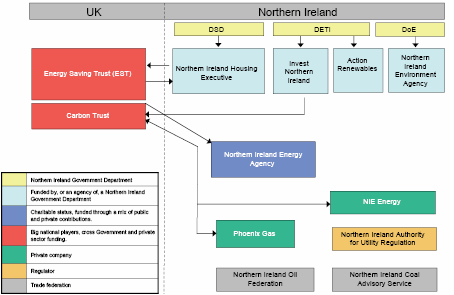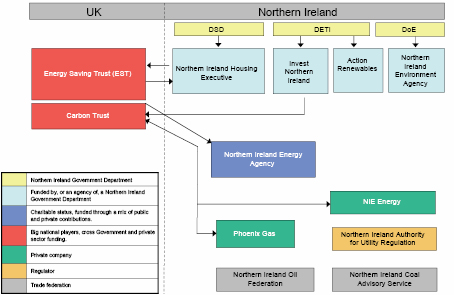Report on the Committee's Inquiry into Barriers to the Development of Renewable Energy Production and its Associated Contribution to the Northern Ireland Economy
Volume 2
Renewable Energy Production Report Volume 2.pdf (31.79 mb)
Committee for Enterprise, Trade and Investment
Report on the Committee's Inquiry into Barriers to the Development of Renewable Energy Production and its Associated Contribution to the Northern Ireland Economy - Volume 2
Together with the Minutes of Proceedings of the Committee
Relating to the Report and the Minutes of Evidence
Ordered by The Enterprise, Trade and Investment Committee to be printed 27 January 2011
Report: NIA 14/10/11R Enterprise, Trade and Investment Committee
Written Submissions
Session 2010/2011
Third Report
Table of Contents
Volume 2
3. Written Submissions to the Committee
Written Submissions
Appendix 3 – Written Submissions
1. Action Renewables
2. Armagh City and District Council
3. B9 Energy
4. Belfast City Council
5. Biomass Energy NI
6. Carbon Trust NI
7. Committee for Regional Development
8. Department of Agriculture and Rural Development
9. Department for Employment and Learning
10. Department of Enterprise, Trade and Investment
11. Department for the Environment
12. Department for Regional Development
13. ESB Wind Development UK Ltd.
14. ESBI Ocean Energy, ESB International
15. Farm Woodlands Ltd.
16. Fasttrack to IT
17. Fermanagh District Council
18. Glen Dimplex
19. Green Energy 4 U
20. Green Party
21. GT Energy
22. IBEC-CBI Joint Business Council
23. Invest Northern Ireland
24. John Simpson
25. Lisburn City Council
26. Michael Coyle
27. Northern Ireland Authority for Utility Regulation
28. Northern Ireland Energy Agency
29. Northern Ireland Environment Link
30. Northern Ireland Renewables Industry Group
31. Northern Ireland Electricity (NIE) Energy Supply
32. Northern Ireland Electricity (NIE)
33. Northern Ireland Manufacturing
34. NPP MicrE and NPP Smallest Projects
35. Office of First Minister deputy First Minister
36. Omagh District Council
37. Phoenix
38. Renewable Energy Systems Ltd
39. RSPB Northern Ireland
40. Rural Generation Ltd
41. SmartGridIreland
42. Ulster Farmers Union
43. University of Ulster
44. WWF Northern Ireland
Response from Action Renewables
| Northern Ireland Assembly Committee for Enterprise, Trade & Investment Inquiry into Barriers to the Development of Renewable Energy Production and its Associated contribution to the Northern Ireland Economy | ||||
| Section 1 Company Details | ||||
| Company Name | Telephone Number | |||
| Action Renewables | 028 90737856 | |||
| Company Address | Company Type (Include one or more X) | |||
| The Innovation Centre NI Science Park Queens Road Belfast BT3 9DT |
Supply | Install | ||
| Design | Manufacture | |||
| Maintenance | R&D | |||
| Other (Please Specify) | X | |||
| NGO | ||||
Please provide some background information on the company
Action Renewables is the leading organisation in Northern Ireland in the promotion and development of renewable energy. Action Renewables delivers a large portfolio of programmes including: general awareness raising; seminars; performance monitoring of technologies; research and evaluation and policy development.
Action Renewables was set up in 2003, as a partnership between Department of Enterprise and Investment (DETI) and Viridian Group.
Our objectives are to significantly raise awareness of the impending threat from climate change, understanding of the issues associated with conventional energy use and to help facilitate the development and use of low carbon energy across Northern Ireland.
Section 2 Government Strategy for Renewable Energy
2.1 Please provide information on your level of awareness of current Government Strategy for Renewable Energy and how that strategy assists the renewable energy sector
Action Renewables is the leading organisation in Northern Ireland in the promotion and development of renewable energy. Action Renewables delivers a large portfolio of programmes including: general awareness raising; seminars; performance monitoring of technologies; research and evaluation and policy development.
Our principal aim is to promote Northern Ireland Government policy in respect of renewable energy. This includes raising awareness about climate change and its impact on Northern Ireland and how sustainable energy can provide solutions.
To meet the set targets and assist the sector, the strategy needs to ensure that:
- Continuing to examine and remove barriers to the more widespread deployment of renewable technologies;
- Making the planning system more responsive, while increasing the benefits going to local communities;
- Using more energy from waste and biomass;
- Stimulating innovation and the supply chain.
- Appropriate financial incentives for renewable electricity;
- Appropriate financial incentives for renewable heat;
2.2 Please provide information on any Government support that your company has received in the past that is specifically related to renewable energy
Action Renewables was set up in 2003, as a partnership between Department of Enterprise and Investment (DETI) and Viridian Group.
For the first four years of our existence we were fully funded by DETI, whereas for the last three years our funding has been gradually reduced, and from the 1st April 2011 we will no longer receive any funding from DETI.
2.3 Please provide information on any Government support that your company has applied for or is planning to apply for in the future that is specifically related to renewable energy
N/A
2.4 Please provide information on the barriers within Government to developing the renewable energy sector in Northern Ireland
Northern Ireland is a small economic unit, with a population of approximately 1.7 Million. Perhaps a better approach for renewable energy technologies to grow and develop, in what is still an emerging market, is to have an overall strategic policy that is applied in a UK wide context, with local administrations applying a 'local context' implementation plan. Thus we would have an overall policy with local factors taken into consideration. In addition, SME's could base business cases on long term strategies, but still be able to lobby for local conditions to be taken into consideration.
2.5 Please provide suggestions on how Government can better support the renewable energy sector in the future in order to grow and develop the sector (suggestions should be specific to the renewable energy sector)
- Creation of a 'Centre of Excellence' for renewable energies. This would bring together a pool of public sector, academic and business minds to manage the research, development, design, and engineering aspects of innovative renewable energy technologies and projects. Currently there would appear to be a lack of coordination between government, universities, and the renewable energy industry.
- The current climate would indicate that more innovative ways be examined to stimulate the market, including a robust 'Communications Initiative'. This is illustrated by a recent Energy Saving Trust (EST) report 'Into the West', 2010 who surveyed 500 consumers in Northern Ireland, has highlighted a significant lack of awareness regarding renewable energy. When asked which renewable heat technologies, if any, they were aware of; 41% answered they were not aware of any.
Section 3 Government Strategy for Economic Development and its Application to the Renewable Energy Sector
3.1 Please provide information on your level of awareness of current Government Strategy for Economic Development and how that strategy assists businesses
A number of Government bodies and agencies contribute to a strategy for economic development, many of which have produced reports and policy on economic development:
- OFMDFM (Sustainable Development Strategy)
- DETI (The future of manufacturing in NI)
- DRD (Regional Development Strategy)
- DEL
- Invest Northern Ireland (INI)
SME's and Businesses will generally welcome the reports and policies but will usually argue that it can be difficult to access the correct information, speak to the appropriate person or just find it complicated to be signposted in the right direction.
Therefore the strategy that assists best is one of 'joined up government'.
3.2 Please provide details of any Government support for economic development (at any level) that your company has had in the past
See answer to 2.2 above.
3.3 Please provide information on any Government support for economic development that your company has applied for or is planning to apply for in the future
N/A
3.4 Please provide information on the barriers within Government to developing the indigenous businesses in Northern Ireland
Recent Government announcements have strongly indicated the dissolution of the Carbon Trust (along with other similar Government funded organizations like the Energy Saving Trust, Technology Strategy Board and Sustainable Development Commission).
The aim is that the monies saved would be put into a 'Green Investment Bank' in order to provide finance for sustainable projects. If however the bank is based in GB, without a Northern Ireland branch, it is likely that this arrangement will mitigate against Northern Ireland Projects, which tend to be smaller. Similarly, Venture capital companies tend to finance larger projects for an overall better return, once again NI is not likely to benefit. Government action should ensure this does not become a barrier to further development for NI companies.
3.5 Please provide suggestions on how Government can better support indigenous SME businesses in the future in order to assist them to grow and development
Invest Northern Ireland (INI), has a three stranded approach to growing the economy, namely 1 - Exports, 2 - Inward investment and 3 - Support for commercialisation of R&D. However there is little or no support available to local SME's which service the Northern Ireland renewable energy market. Specifically, there would appear to be a lack of a specialised technical resource, within INI, to assist SME's to grow and develop their renewable energy technologies. This needs to be addressed. Further we would envisaged a coordination role for INI in the proposed 'Centre of Excellence' (see 2.5)
Section 4 Communication, Sharing Information, Raising Awareness
4.1 How well do you think Government departments communicate and share information with each other in relation to renewable energy and how can this be improved?
It appears that Government departments find it difficult to successfully ensure that other departments are aware of the renewable energy research and projects they undertake. The cross–departmental working group set up to discuss renewable energy should ensure that at meetings, each department is represented and clearly highlights current or upcoming legislation and projects they are involved in relating to renewable energy. The group should then be asked to ascertain ways to support such projects across departments and/or develop projects which follow-on from those delivered by another department.
4.2 How well do you think the Government departments and local Government communicate and share information with each other in relation to renewable energy and how can this be improved?
It would perhaps be beneficial to set up an additional renewable energy working group which contains a number of representatives from the cross-departmental working group as well as representatives from local Government. The cross-departmental representatives could relay information arising at departmental level to those at local level so that they are aware of current and upcoming legislation, research and projects and vice versa. Such a working group would serve to improve communication, information sharing and perhaps even allow for projects to be jointly developed between Government departments and local Government.
4.3 How well do you think the Government departments and the EU communicate and share information with each other in relation to renewable energy and how can this be improved?
The EU focuses heavily upon the promotion of renewable energy and it would be therefore beneficial to establish good working relationships at this level. Representatives from the cross-departmental renewable energy working group should be appointed to monitor relevant information coming from the EU and pass this on to other members of the group. If feasible, a member of the working group should be appointed as the official liaison person for Northern Ireland Government departments and travel to Brussels to meet with and establish contacts in the EU. This relationship could allow Government departments to gain inspiration and ideas from Europe and give the EU the opportunity to learn more about how renewable energy is being developed in Northern Ireland.
4.4 How well do you think the Government departments and businesses communicate and share information with each other in relation to renewable energy and how can this be improved?
Businesses can often find it difficult to liaise with Government departments and it can be hard for them to access the relevant people they need to talk to. Working closely with businesses to share information will help Government develop a strong renewable energy industry in Northern Ireland. This will not only ensure long term sustainable energy security but also help develop new economic opportunities in this sector.
It could perhaps be beneficial for Government departments to offer appointment based surgeries whereby they set time aside once a fortnight to meet with businesses to discuss renewable energy issues, thus improving communication relations. Businesses could call or email to arrange an appointment, outline what they wished to discuss and it would then be arranged for them to meet with the appropriate person they need to speak to.
4.5 How well do you think the Government departments and other regions and EU Member States communicate and share information with each other in relation to renewable energy and how can this be improved?
A vast level of information regarding renewable energy is shared by EU members, normally via EU projects, it is important that Government departments in Northern Ireland participate in this knowledge sharing in order to facilitate the successful development of renewable energy in Northern Ireland. Many countries in Europe have well established renewable energy industries and Government departments in Northern Ireland could learn a lot from these regions. The cross-departmental working group should appoint a number of representatives to liaise with other regions and EU members and feed this information back to the group, giving updates on legislation and ideas developed at regional and European level.
4.6 How well do you think businesses in the renewable energy sector communicate and share information with each other in relation to renewable energy and how can this be improved?
The development of the renewable energy sector has slowed as a result of the financial crisis (and subsequent slow down of the construction industry). Businesses in the renewable energy sector now face even more direct competition from each other to secure work and for this reason, they tend to be less willing to communicate and share information with each other unless it is of mutual benefit. It is unlikely that this situation could be improved in the short term unless financial benefits were perceived to be gained from the interaction.
4.7 How well do you think Government departments communicate and share information with the public in relation to renewable energy and how can this be improved?
Government departments appear to find it difficult to communicate directly with the public and interaction tends to be largely limited to press releases and consultations. Government have in the past used Third Party Organisations (TPO's) as intermediaries. Action Renewables was the main organisation in Northern Ireland to provide free, independent advice and information on renewable energy to the general public. Cuts in Government spending have resulted in funding being withdrawn and this information service is no longer available.
It's important that Government understand that as renewable energy is still a relatively new industry, promoting education and understanding amongst the public remains paramount to its success and development. A number of advisory agencies in Northern Ireland do still remain although they do not provide advice specifically on renewable energy. The Energy Saving Trust specialises in energy efficiency information, while the carbon trust focus their information and advice service on businesses.
An apparent gap therefore currently exists in relation to government departments communicating and sharing information on renewable energy with the public. To fill this gap Government should try to either develop their relationship with the general public or continue to fund an established TPO with renewable energy expertise to act as a liaison.
4.8 How well do you think renewable energy businesses communicate and share information with the public in relation to renewable energy and how can this be improved?
Renewable energy businesses are keen to communicate and share information with the public however as they are trying to sell goods and services, the information they provide tends to favour the products they wish to sell. This means that this information can often be of limited value as it is neither independent nor impartial. As renewable energy businesses will always be primarily focused upon promoting their products, securing a sale and making a profit, it is difficult to ascertain how this situation could be improved upon.
4.9 What other support organisations are you aware of that exist to support the renewable energy sector?
A number of advisory agencies in Northern Ireland indirectly support the renewable energy sector. The Energy Saving Trust for example specialises in providing energy efficiency information (improving the energy efficiency of a building is an important precursor to any renewable energy installation) while the carbon trust focus their information and advice service on businesses and carbon reduction. The Northern Ireland Energy Agency was administering the Low Carbon Buildings Programme Householder Grant but this UK-wide scheme closed in May 2010.
A number of other organisations such as Northern Ireland Environment Link, Bio Energy Northern Ireland (BENI), the Sustainable Energy Association and the Wood Fuel Quality Assurance Scheme are not-for profit organisations which have been established to support the renewable energy sector in Northern Ireland. Through carrying out research, writing reports and lobbying Government they try to promote the successful development of the industry.
4.10 How well do you think Government departments and renewable energy support organisations communicate and share information with each other in relation to renewable energy and how can this be improved?
When Action Renewables, as a support organisation, was fully funded by DETI an 'Implementation Plan' was agreed between the parties which would detail the work programme to be carried out in any particular year. The implementation plan would reflect bodies of work considered important by DETI e.g. awareness raising, research and reports and incorporate ideas from Action Renewables including monitoring and training for installers. Communication and sharing of information was achieved by regular update meetings between the parties.
However, in the current situation where the funding levels are decreasing, communication between the parties is limited to bodies of work directly funded by the department.
Therefore it is suggested that any Communications Initiative (see answer in 2.5) should not be limited to the 'wider community' but continue in a meaningful way between support organisations and government, so that engagement continues on issues surrounding the level of awareness and understanding of the wider issues surrounding the main drivers for renewable energy.
4.11 How well do you think renewable energy businesses and support organisations communicate and share information with each other in relation to renewable energy and how can this be improved?
Action Renewables as a support organisation, has both formal and informal links with renewable energy businesses. Formal links include:
- Managed the 'Reconnect' grant programme which funded household renewable energy installations, this ended in 2008
- Managed the 'Renewable Energy Installers Academy' which trained up to 800 installers.
- Accreditation as an MCS (Microgeneration Certification Scheme) awarding body.
Other links would include accessing the AR website, informal meetings and telephone calls requesting information on a wide range of renewable energy policy.
The situation could be improved and enhanced by an industry led 'forum' or 'body' which would have regular update meetings with support organisations and other interested parties.
4.12 How well do you think renewable energy support organisations communicate and share information with the public in relation to renewable energy and how can this be improved?
When Action Renewables, as a support organisation, was fully funded by DETI, a significant part of the agreed 'Implementation Plan' was initiatives to raise awareness educate and inform the public in relation to renewable energy.
However the Energy Saving Trust report, referred to in 2.5, also highlighted the following:
While those who were aware of some renewable energy technologies, 49% of approx 500 people, only 6% were aware of either Biomass Boilers or Air Source Heat Pumps. This data illustrates that previous awareness raising plans were not as effective as envisaged or were discontinued too early.
Action Renewables was an important information source for the public, however our current status of attracting other sources of funding, as public funding is reduced, means we are no longer in a position to maintain this vital function. Unless the public are able to make an informed decision regarding choices on renewable energy requirements it is difficult to be optimistic regarding how awareness can be improved.
Section 5 Additional Information
5.1 Please provide any additional information which you believe will be of assistance to the Committee during the course of the Inquiry
- As an example of a 'Centre for Excellence' Scottish and Southern Energy plc (SSE) has selected Glasgow as the location for its new Centre of Engineering Excellence for Renewable Energy (CEERE) in partnership with the University of Strathclyde. SSE and the University of Strathclyde are already partners in the Sustainable Glasgow consortium, which aims to help Glasgow City Council realise its vision to make Glasgow Europe's most sustainable city within 10 years. This approach or similar should be replicated within NI.
- It is well established that the maximum benefit from the installation of renewable energy technologies will be gained when energy efficiency measures have been maximised. Therefore based on the fact that currently around 94% of the existing housing stock in NI is below the current building regulations standards for insulation levels, an opportunity exists for Retrofitting. This could involve a extensive campaign targeted at existing householders, within the 94%, to install suitable levels of energy efficiency measures, double glazing and loft insulation being the most obvious, along with an informed decision on appropriate renewable energy technologies for either heating or electricity production.
- It would therefore be necessary to devise some form of incentive scheme to encourage householders and others to consider the measures required to maximise energy efficiency and appropriate renewable energy technologies. It is suggested that a range of measures could be considered including but not limited to; a reduction in rates, tax incentives or low interest loans.
- The EU focuses heavily upon the promotion of renewable energy and it would be therefore beneficial for NI to exploit the available grant funding (Interreg etc) that is available from Europe. Government should use its influence and lobbying mechanisms to maximise available monies up to April 2011, for projects running until 2013. This should be a priority on-going exercise and the model could be a single government point of contact (dealing with the EU) to which all departments would lobby to, and if successful then this funding be provided for preferred projects.
Section 6 Contact Details
All written responses should be sent to:
Jim McManus
Committee Clerk
Room 424, Parliament Buildings, Belfast BT4 3XX
Tel: 028 9052 1574 · Fax. 028 9052 1355 · Email: committee.eti@niassembly.gov.uk
Response from Armagh District Council
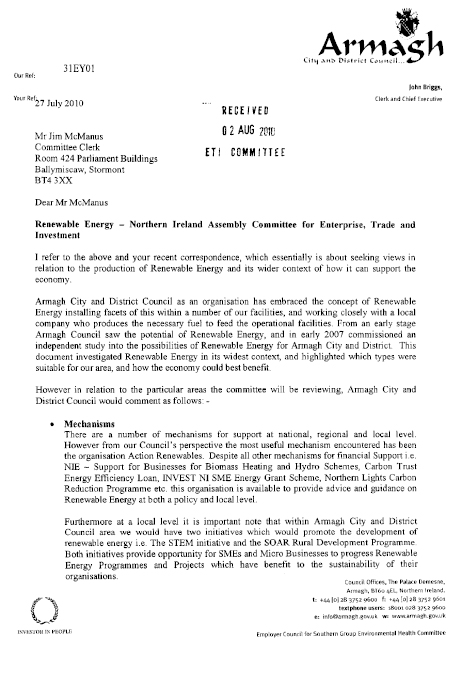
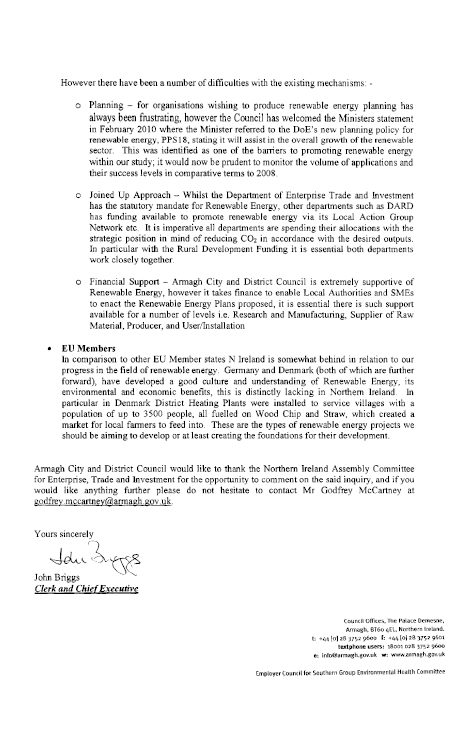
Response from B9 Energy
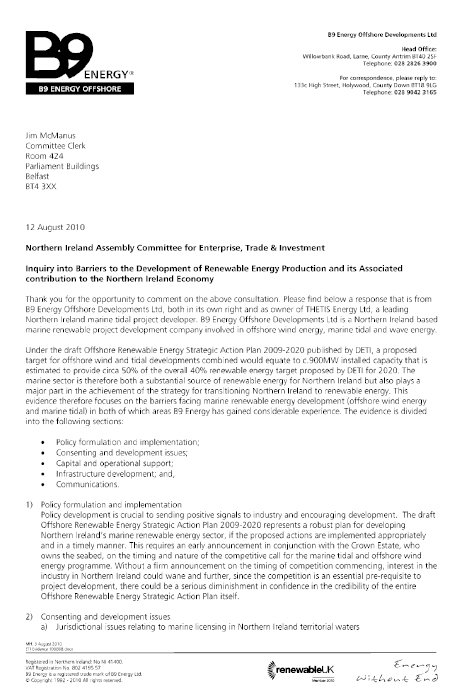
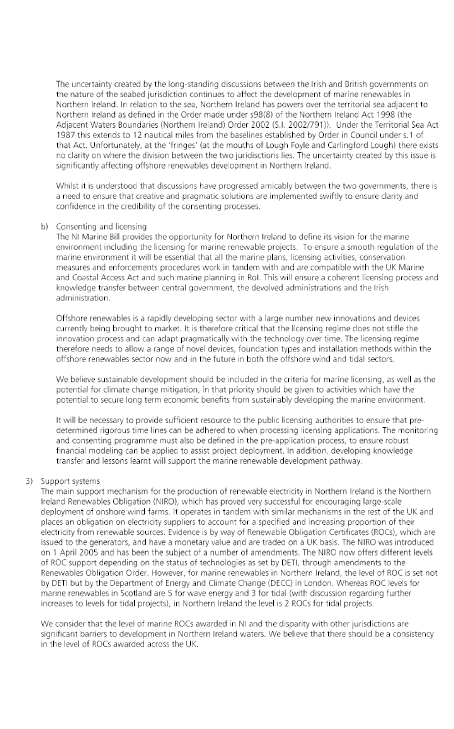
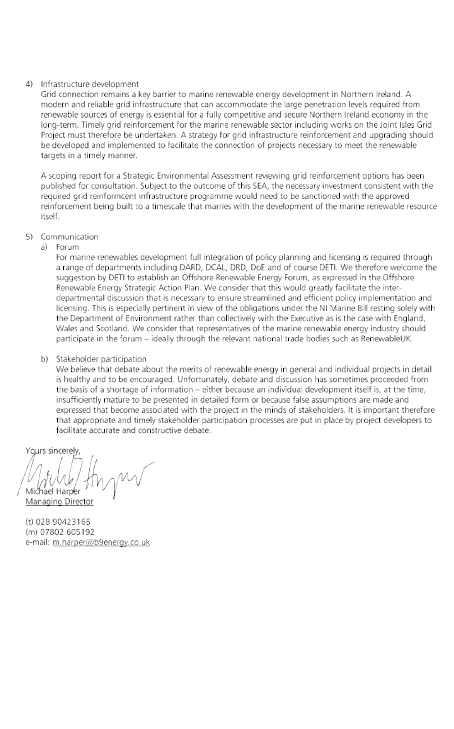
Response from Belfast City Council
Development Department
Your reference:
Our reference: #110174 Being dealt with by: David Purchase
Tel: 02890 320202 ext 3792
Jim McManus, Committee Clerk
424, Paliment Buildings
Ballymiscaw,
Stormont
Belfast
BT4 3XX Date 29th July 2010
Dear Mr McManus,
Re. Barriers to Renewable Energy Production – NI Assembly Task Force Consultation
Please find below our comments in response to your invitation to discuss barriers to renewable energy production. Most of the information in this response has come from our North Foreshore Project Manager (who is responsible for the Council's existing renewable electricity facilities) and our Planning team. Reference has also been made to an early consultation response to the Department of Environment Consultation on Permitted Development Rights, which included a section on Microgeneration (e.g. wind turbines, solar panels). That response was informed by our Environmental Services Department and was approved by the Council's Town Planning Committee on 3rd December 2009. It is available online if required.
Please also note that the views expressed in this response are pending ratification by the Development Committee on the 11th August 2010. Unfortunately, the timescales and the timing of this consultation have made it impossible to submit a ratified response.
Provisional Response
Belfast City Council is making a significant contribution to non-wind renewable energy production. The Council developed the Landfill Gas Electricity Power Plant to utilise the methane gas at the North Foreshore Giant's Park, the former Dargan Road Waste Landfill site. Our landfill gas powered generating facility produces 5 megawatts of green electricity per hour sufficient to power 6,000 homes. However landfill gas is not sustainable, as the methane gas supply will progressively decline over a 15 – 20 year period. Alternative sources of renewable energy must be found.
Anaerobic digestion (AD) is the solution but this is new to NI and as yet there are no commercial facilities in operation. The AD process produces methane gas which can be used for the production of renewable energy and heat. Questor and others have carried out extensive research into A.D. technology and this is an opportune time to develop AD facilities in NI.
A major difficulty for potential operators is the identification of suitable sites and obtaining satisfactory planning consent for AD and other forms of renewable energy production, such as Energy from Waste. As shown at the end of this paper, the Council's own planning unit and committee have concerns about the potential noise, vibration and visual impact of renewable technologies when they are sited near domestic areas.
The B9 a private sector company has spent 2/3 years in the planning process to secure planning consent for a proposed AD facility in Dungannon. If the Assembly Committee is to encourage renewable energy generation, planning consent must be made easier to obtain and the planning process speeded up. Delays of 2/3 years are not acceptable or economically attractive to commercial operators or their funders.
Therefore there is a need to change the perception of renewable energy production facilities and educate those involved in the decision making and development process, not least the Planning Service and NIEA. Also there is a need to educate the public about modern renewable energy facilities, and the importance of guaranteeing energy security for NI. We encourage visitors to our North Foreshore facilities to help this education process.
The North Foreshore Giant's Park site is unique as the only site in Draft Belfast Metropolitan Area Plan with a statutory waste management zoning. This should help to make it easier to secure planning consent for AD and EfW Facilities. Currently we are investigating the potential of promoting a site for a commercially operated AD facility at the North Foreshore Giant's Park. The project would have synergies for the Council's Landfill Gas Electricity Generation Power Plant as we have the generation capacity and the electrical infrastructure to export renewable energy from the site.
It is suggested that future statutory local area development plans should designate suitable sites for renewable energy generation. This would help to speed up the development of renewable energy facilities in NI, assisting commercial decision making and investment.
ROCs and LECs are available for AD biogas powered electricity generation and are currently at 2 ROCs per MWhr of electricity generated. The Committee will need to determine if this level of support is sufficient to encourage biogas production for electricity generation.
Connection to the local electricity grid is another major barrier due to the significant set up costs involved. Electrical infrastructure to export the renewable energy at the North Foreshore Giant's Park cost the Council circa £2.5 million. Are there ways in which this could be reduced e.g. capping the NIE connection fee?
It is suggested that clustering renewable energy facilities would maximise the use and efficiency of electrical infrastructure. In particular the new non wind renewable energy facilities such as AD and EfW are clean processes that could be located within settlement areas on brownfield industrial sites.
Electricity generation facilities also usually produce large quantities of heat, which can be captured and used in production processes or for a district heating facility. The Committee should consider the introduction of Renewable Heat Incentives to NI to encourage operators to install heat exchangers and pipe network to make productive use of the waste heat. Again consideration needs to be given to clustering businesses / houses close to renewable energy facilities to minimise the cost of the pipe network.
Summary of our previous Comments regarding planning permission
In terms of planning permission for non-domestic microgeneration facilities they need to be considered in terms of the impacts they may have on adjacent properties, particularly residential properties. The Council views issues around noise, vibration and visual impacts as key considerations.
The Council is concerned that the risk of adverse impacts from renewable energy technologies such as wind turbines is too great, in some instances, to allow for no consideration in the form of a planning application. The Council would encourage increased usage of such technology but a full assessment of impacts is necessary. The baseline taken is that non-domestic microgeneration PD will be at least on a par with the provisions for dwelling houses.
The proposed changes will bring Northern Ireland permitted development rights closer in line with those in other UK jurisdictions.
Yours sincerely
David
Dr David Purchase
Policy & Business Development
Development Dept.
Belfast City Council
The Cecil Ward Building
4-10 Linenhall Street
Belfast
BT2 8BP
Tel: 02890 320202 ext 3792
Mobile: 07775 868448
Response from Biomass Energy NI
Response from Biomass Energy Northern Ireland to the request for submission of evidence to the Northern Ireland Assembly Committee for Enterprise, Trade and Investment to inform it's enquiry into "renewable energy and the barriers to its development and contribution to the Northern Ireland economy".
1. Introduction to Biomass Energy – Northern Ireland
1.1 Biomass Energy – Northern Ireland (BENI) was established in 2008 as a co-ordinating body for biomass producers and processors. Its aim is to facilitate the establishment of a sustainable supply chain from producer to end user. In doing so it aims to establish benchmarks and quality standards in the production and utilisation of energy from biomass crops.
1.2. Membership is open to anyone who supports our aims and objectives. Members have a large reservoir of knowledge and practical experience in the production and processing of biomass fuel. The membership currently includes a large proportion of the farmers who produce the approximately 1000 hectares of Short Rotation Coppice Willow which is grown and used in Northern Ireland for energy production; as well as suppliers of boilers and other equipment required to service this sector.
2. Biomass as a renewable energy source.
2.1. BIOMASS –definition within the EU Renewables Directive:
'the biodegradable fraction of products, waste and residues from agriculture (including vegetable and animal substances) forestry and related industries, as well as the biodegradable fraction of industrial and food waste'
A more practical definition has been provided by the Alternative Energy Association (AEA) and is used by DETI:
- Biomass is an organic based resource that is grown or collected.
- Biofuel is a fuel manufactured from biomass (chips, pellets, biodiesel etc.)
- Bioenergy is the use of the fuel to supply energy – be it heat, transport or electricity.
2.2. At present BENI's activities are focussed primarily on heat energy and developing a market for woodchip mainly derived from SRC willow. This is currently the most readily available and easily grown source of biomass in Northern Ireland, but it is certainly not the only one. Other sources of biomass comprise forestry and its wastes, sawmill residues and clean waste wood. In the future it may include miscanthus (elephant grass) and fast-growing hardwoods. BENI supports research into all forms of biomass which may be grown in Northern Ireland. The Agri Foodand Biosciences Institute (AFBI) has been a world leader in willow biomass for many years, and provides invaluable research support to the sector. We have very real concerns that the suggested closure of the AFBI Loughgall research facility will seriously disadvantage the renewable energy sector as long term trials cannot simply be moved to another AFBI site. This is the very time when the research is needed to help Northern Ireland achieve government targets for renewable heat.
2.3. There are many advantages to the use of biomass as a source of renewable energy in NI, including –
- Biomass is a virtually carbon neutral fuel since the CO2 emitted during combustion has recently been absorbed from the atmosphere during the growth period.
- One of the key features of Short Rotation Coppice (SRC) willow is that once planted, the crop will produce woodchips for over 20 years. This provides a security of supply that cannot be matched by imported energy sources.
- The current level of use of fossil fuels for heat in NI makes the area particularly dependant on oil (76%) and natural gas (17%) and thus vulnerable to fluctuations in world price and availability.
- The production of biomass from energy crops presents substantial opportunities to generate income to support the local economy and help sustain rural communities.
- Northern Ireland is a net food exporter ( approx 80% of food produced is exported) but energy importer (98%) so there would be no impact on local food supply and there will be a multiplying effect in terms of carbon footprint through a shift from food to energy crops.
- Energy crops can provide other benefits such as bioremediation of waste materials, and do so in a way which is much less capital and energy intensive than conventional waste treatment methods.
2.4. The Report of the Agricultural Stakeholder Forum on Renewable Energy "Renewable Energy in the Land Based Sector – A Way Forward 2009" identified a heat energy requirement in Northern Ireland of some 25,000 GWh/year, which represents some 52% of the total energy demand. Even though other studies suggest this is an overestimate, the figure is of this order. Through effective incentives applied to the renewable electricity sector ( Renewable Obligation Certificates ) DETI is on target to achieve the target of 12% on Northern Ireland's electricity to be supplied from indigenous renewable sources by 2012. On the other hand renewable heat is still very low at only 0.6 % of the UK heat demand –(DETI Consultation on the Bioenergy Action Plan for NI 2009 – 2014). This same document suggests the potential available to NI is up to 6.4% of heat demand. The potential for increased use of renewable heat energy is therefore considerable, while the technology is by and large simple, and requiring minimal development. What is required is the sustained political commitment and commercial incentive to make it happen.
3. Developing a Biomass Energy industry in Northern Ireland.
3.1. "It's a chicken and egg problem"-
Biomass production is a fledgling industry in Northern Ireland. Members of BENI have visited and studied developed biomass markets, principally in Sweden and Austria, and believe strongly that, if we can make the same thing happen here, there will be immense benefit to individual businesses in the supply chain and the whole NI economy, as well as economic benefits to individual consumers.
3.2. The problem in a nutshell is that farmers are unwilling to plant biomass crops unless they can be sure of having a long term market at a price which makes the enterprise viable, whilst heat users are reluctant to convert to biomass-fuelled systems unless they can be confident of reliable long term supply at attractive prices,
3.3. Overcoming the barriers to the development of a sustainable biomass energy sector in NI depends on successfully bridging that gap between producers and consumers. BENI is working with other organisations to achieve this, but lessons from elsewhere in Europe indicate that Government has a critical role to play in stimulating private sector involvement; supporting innovation; generating the confidence required to encourage the long term investment necessary and showing strong and committed leadership to the concept, through sustained action over a long timescale .
Energy Service Companies
3.4. BENI believes that the best long-term solution to supply management will be the creation of Energy Service Companies (ESCOs). ESCO's finance, design, build/install, operate and maintain agreed energy services equipment and undertake energy efficiency measures and savings under long term contractual arrangements.
Usually an ESCO contracts to supply heat rather than fuel. Thus the ESCO takes responsibility for installing, running and maintaining the heating equipment. The customer pays for the provision of heat and does not have to manage the system and its fuel supply.
The willow grower could sell his crop to the ESCO, which takes responsibility for supplying their boilers, while some growers may also be investors and partners in their ESCO.
4. Current Support Available in Northern Ireland.
4.1. DARD has been proactive in developing support mechanisms and funding which falls within its terms of reference, including --
- World class research on willow production at AFBI Loughgall.
- Establishment and resourcing the Renewable Energy Centre at AFBI Hillsborough.
- Education programmes and workshops at CAFRE, Antrim.
- Planting Grants for SRC Willow since 2005.
- Energy Biomass Infrastructure Development Scheme to encourage on-farm storage and harvesting Investment, funded through the EU Building Sustainable Prosperity programme.
- Biomass Processing Challenge Fund funded through the European Fund for Sustainable Competitiveness for NI.
- Supporting Supply Chain Development initiatives
4.2. There is also excellent advice and documentation available through the Carbon Trust – e.g. "Biomass Heating – a practical guide for potential users"; as well as helpful zero interest loans.
4.3. Currently the support available in Northern Ireland to SRC willow producers and users is –
- Short Rotation Coppice Scheme 2007; planting grant of up to 40% ( 50% in LFA ) of establishment costs, up to a maximum of £1000. A similar scheme operates in the Republic of Ireland.
- Biomass Processing Challenge Fund. Where the majority of the energy produced is used for farm business purposes, grants of up to 40% of eligible costs (max 400,000 euro) associated with biomass boilers over 30 kw thermal output, are available.
- 0% business loans of £3,000 - £100,000 are available from the Carbon Trust to help organisations finance and invest in energy saving projects.
- The following grants are available from the NIE SMART programme which is managed by NIE Energy on behalf of NIE:
- Boilers up to and including 150kW will be eligible for 15% of installed cost up to a maximum of £10,000.
- Boilers over 150kW up to 320kW will be eligible for 10% of installed cost up to a maximum of £12,000.
- Stoves will be eligible for £850 regardless of the size of the installation.
- Funding support can be claimed by businesses for the cost of the boiler, the installation of the boiler and the fuel store but not for radiators or thermal stores.
5. Barriers to the development of renewable energy production and its associated contribution to the NI economy.
5.1. This is the fundamental question which this important inquiry has defined as its overall objective and one which we would like to address before commenting from our perspective on some of the specific issues raised by the Committee.
The NI business owner – and that includes farmers – has a track record of rapid adoption of new technology where this has clear commercial advantages which compensates for the risk involved. We must therefore ask ourselves why any action needs to be taken by Government to stimulate the adoption of biomass energy – or in economic terms why there is a need to take action to overcome "market failure".
5.2. To take SRC willow in particular, the vast majority of the 1000 ha now producing energy crops was planted when the rate of grant was approximately double the £1000 hectare available today. In other words the risk of producing this "new" crop was much lower than it is today, when the new area planted each year is minimal. DARD in its Renewable Energy Action Plan 2010 has committed to continue this planting grant until 2013 but has stated that, despite an increase to 75% being recommended by the report on "Renewable Energy in the Land Based Sector – 2009" produced by the Agriculture Stakeholder Forum on Renewable Energy, it would not be appropriate to increase it. In DARD's view the current rate is the maximum allowed by regulation.
The difficulty potential growers face is a high, up-front planting cost in excess of £2,000 / hectare, and a delay of 3 -4 years before the first harvest, and any return on their investment of land and capital.
5.3. However the planting grant is only one way of "funding" the risk – the other is to provide confidence that a high enough income can be sustained to balance the risk taken in planting the crop – which it must be remembered does not generate income for 3 years after planting and produces for at least 20 years thereafter.
5.4. The current difficulty is that for the business / public authority investing in the biomass boiler to justify the higher capital investment required (for both the boiler, storage and fuel delivery systems) and to achieve an acceptable return on its investment, the payment made for the biomass fuel is at a rate which makes production of very limited profitability at present fossil fuel prices.
This is producing a situation whereby demand is starting to outstrip supply and this will worsen unless action is taken to increase income to producers. The alternative is to import biofuels, thereby losing the potential benefits to the local economy and adding to the use of fossil fuels in transporting the material.
5.5. This problem is by no means unique to Northern Ireland and the lessons from elsewhere in Europe are equally applicable here. The key messages are –
- To achieve the level of increase envisaged in Government targets (e.g. 10% Renewable Heat) will require a long term strategic vision backed by strong political commitment to provide the confidence to stimulate investment. Long term commitment provides a much higher chance of success as demonstrated by the development of district heating systems in Denmark and Sweden. Short term incentives have limited effect in a sector which requires long term investment.
- Incentives such as the proposed GB Renewable Heat Incentive scheme to top up the income available for the market, are essential . There is a direct parallel to the incentives (ROCs) without which renewable electricity generation would be uneconomic.
- There must be parallel measures in place to ensure that fuel availability increases in line with the market need. The "push" and "pull" effects needs to be balanced within the supply chain
5.6. The omission of Northern Ireland from the Energy Act 2008 deprives us from the legislative basis for any Renewable Heat Incentive Scheme. This places Northern Ireland at a very significant disadvantage and puts the development of the renewable heat sector in serious danger of decline before it can even get off the ground.
It is imperative that the Northern Ireland Executive in general and DETI in particular takes urgent action to rectify this situation. The sector requires confident and committed leadership to maximize opportunities which exist. BENI recognises that DETI has identified the need to provide a co-ordinated approach to this issue and has established a Bioenergy Interdepartmental Group with this objective. There does not however seem to be a single "renewable energy champion" to both lead and be accountable for the development of the sector.
5.7. We are aware that a study has been commissioned to consider what needs to be done to stimulate renewable heat in Northern Ireland but are becoming increasingly concerned at the plethora of studies, strategies and action plans being produced by Government. All of these seem to recommend further work and are being seen by some as a means of postponing difficult decisions and financial commitment. They contrast markedly with the limited financial support for those trying to make it happen and sustain their businesses in the real world.
5.8. There seems to be an unrealistic quest in policy makers to achieve certainty where certainty cannot be found. Predicting the future is a risky business. Real progress will require leadership and judgement based on the best information available rather than continuing analysis and research in search of the optimum no-risk solution. One thing is clear – without long term heat incentives in the immediate future renewable heat in Northern Ireland will stagnate and cease to grow to achieve its potential.
To avoid situations in which you might make mistakes may be the biggest mistake of all.
- Peter McWilliams
5.9. The level of support required does not require huge research – the figures are already available from both research papers and commercial growers. BENI would be very willing to assist in this analysis if necessary.
By way of example one member and local grower provided the following figures for SRC willow production in 2009.
- Harvest cost -- £15 per tonne
- Drying cost £35 per tonne
- Total variable cost of producing chip at 15% MC is £50 per tonne.
Assuming an ex-farm sale price of £80 per tonne leaves a margin of £30 per tonne to cover land, planting costs, drying store investment ( at least £1850 per hectare )and the farmers managerial input.
Typically 10 – 12 tonne chip is sold per hectare per year which leaves a gross margin of £300 to £360 per hectare per year. Some figures from the 2010 DARD Farm Business Data report provide interesting comparisons –
- Summer grazing of store cattle £938 per ha.
- Lowland Breeding Sheep £461 to 479 per ha
- Lowland suckler sow cows (spring calving) £195 per ha.
- Letting the land in conacre for grass would have yielded on average £193 per ha.
5.10. At the other end of the supply chain if we allow for transport cost the wood chip can be supplied to the user at around £100 per tonne. This contains in the region of 3,500 kWh of energy per tone, so if compared to heating oil, its heat content is worth about £120 per tonne ( assuming 40 p per litre).
5.11. In short, current returns are insufficient to stimulate large numbers of farmers to change from traditional enterprises, with which they are familiar and have the required skill sets, to invest in biomass energy production. At the same time the cost savings compared to oil are probably marginal in justifying large scale investment, unless the material can be sourced at prices which do not provide adequate return to local farmers. The commercial pressure driving the change to renewable energy is therefore minimal.
It is very apparent to us that, in addition to the excellent research, advice and education services provided, if society wishes to stimulate the use of renewable heat with the resulting benefits to the local economy and the world climate, some form of additional financial incentive is essential. The fact that Great Britain is moving towards that goal through a Renewable Heat Incentive, while Northern Ireland does not even have the legislative cover, let alone the methodology to do so, is a matter of grave concern.
6. Best Practice Elsewhere.
When looking for best practice and learning from the experience of other countries we would suggest that the Committee review the successful actions taken in Austria, and Sweden.
6.1. In Sweden some 18,000 ha of willow is grown by around 1250 farmers. All this material, is burnt as harvested, without any artificial drying.
A high proportion of the salix (willow) crop in Sweden is treated with sewage sludge from local authority treatment works – this provides significant savings over conventional waste water treatment, and additional income to the farmer through payment of a gate fee. The resulting product (wood chip) is then sold back to the municipality for use in district heating systems. These District Heating Systems provide over 50% of all heat use in Sweden and 23% of all Sweden's heat requirements come for bioenergy sources, including sawdust, bark, forest thinning / waste and willow chip.
This development was driven by a Government vision supported by strategies including sustained financial incentives.
6.2. In the case of Austria, almost half (47%) of which is covered in trees, so this central European nation has capitalised on these forest resources, to build a sizeable industry in micro scale biomass heating.
The Austrian Government has a target of 25% of its primary energy supplies from renewables by 2010 and 45% by 2020. Some regions, such as Upper Austria, are aiming to generate all electricity and heat from renewables by 2030.
The International Energy Agency (IEA) attributed the success of biomass in the country to a number of factors, including stable financial incentives, a wide portfolio of proven technologies and a long tradition of using biomass.
Research and development in energy technology has a long and strong tradition in Austria, and has been successful in creating world class industries, e.g. for small-scale biomass boilers.
Within Austria, the Government has supported biomass systems through subsidies – homeowners can get €800 from the national Government if they opt for biomass heating, or up to €4,500, or 30% of system cost, in some federal states. There are also subsidies for replacing old oil-fired systems with biomass, and large incentives for commercial installations.
Pellet systems are rapidly replacing conventional oil heating systems. Pellet systems jumped from 32% of the new installations in 1999 to 76% in 2007.This is partly due to the price of fuel. In September 2008, pellets cost around 3.5 cents/kWh, compared to 6.3 cents for gas and 9.1 cents for heating oil.
7. Conclusion.
We hope this information will be helpful to the Committee in considering this important topic. BENI is committed to furthering the development of Biomass Energy in Northern Ireland and sees renewable heat as the simplest and most realistic method of delivering this renewable energy in practice.
There is also much focus on extending the gas distribution network within
Northern Ireland as a means of developing low carbon heating systems. We would refer to the recently published "Into the West" report from the Energy Saving Trust. The broad conclusions show that there would be significant investment of public funds required with very limited benefit, giving poor value for money.
If a fraction of this money was instead used to encourage adoption of renewable heat technologies as well as microgeneration, there would be significant progress towards meeting Northern Ireland's 2020 renewable heat target, as well as helping to address fuel poverty.
We will be pleased to provide further assistance if the Committee feels this would be helpful. This includes the opportunity to visit SRC willow crops and processing facilities, as well as renewable heating systems already in operation using locally grown woodchip fuel.
John C Martin
Chairman
Tel: 07808 060037
Email: jcmfarms@aol.com
Biomass Energy Northern Ireland Limited
c/o Countryside Services LTD
97 Moy Road
Dungannon
Co Tyrone
BT71 7DX
Response from Carbon Trust NI No.1
| THE CARBON TRUST The Concourse Northern Ireland Science Park Queen's Road, Queen's Island Belfast, BT3 9DT |
T: +44 (0)2890 734390 Email:CTNI@carbontrust.co.uk www.carbontrust.co.uk |
The Carbon Trust is a company limited by guarantee. Registered in England and Wales Number 4190230. Registered at 6th Floor, 5 New Street Square, London EC4A 3BF |
Jim McManus,
ETI Committee Clerk
Room 424
Parliament Buildings
Stormont
Belfast
BT4 3XX
27 September 2010
Dear Jim,
Committee for Enterprise, Trade and Investment renewable energy inquiry
Thank you for the opportunity to comment on the above mentioned inquiry and to contribute to the debate on NI's renewable energy policy. Our submission reflects the experience gained by Carbon Trust working in NI since 2002 and I hope the Committee finds it helpful.
The Carbon Trust
The Carbon Trust is a not-for-profit company with the mission to accelerate the move to a low carbon economy. We provide specialist support to help business and the public sector cut carbon emissions, save energy and commercialise low carbon technologies. By stimulating low carbon action we contribute to key UK and NI goals of lower carbon emissions, the development of low carbon businesses, increased energy security and associated jobs. Our vision is the creation of a new, vibrant, low carbon economy – with jobs, wealth and competitive advantage for those that take the lead.
The Carbon Trust receives funding from Government including the Department of Energy and Climate Change, the Department of Transport, the Scottish Government, the Welsh Assembly Government and Invest Northern Ireland. In Northern Ireland Carbon Trust activities are part financed by the European Regional Development Fund under the European Sustainable Competitiveness Programme for Northern Ireland.
The funding we receive from Invest NI has enabled us to make substantial progress in improving the energy and carbon performance of local businesses as well as catalysing markets for low carbon technologies, products and services. Our key achievements in NI include:
- Helping our customers save over £70 million per annum off their energy costs;
- Reducing carbon emissions by over 685,000 tCO2 per annum;
- Stimulating over £100 million of capital investment in energy efficiency & low carbon technologies;
- Identifying a further £100+ million p.a. of energy savings with associated carbon savings of nearly 1 million tCO2;
- Awarding over £16 million in interest-free energy efficiency loans to 260 companies that will generate energy cost savings of £5 million p.a.
- Attracting over 7,000 delegates to over 120 low carbon skills and knowledge transfer seminars & workshops held throughout NI;
- Offering over £1.5 million in low carbon applied research grants to local innovators; and
- Investing £80,000 incubating two local renewable energy companies who went on to raise over £500,000 in private funding.
The need for a low carbon transition plan for NI
Northern Ireland is heavily dependent on imported fossil fuels for the vast majority of its energy requirements. This dependency poses a number of significant challenges vis-à-vis:
- Energy security;
- Management of energy costs; and
- The need for rapid and deep reduction in carbon emissions.
We believe that a rapid move to a low carbon economy must be a strategic imperative for the NI Executive. There are huge incentives for modern economies to decarbonise. For example, wealth generation from the development and supply of low carbon products, goods and services and attracting foreign direct investment into a low carbon region that can offer secure, affordable, indigenous energy supplies.
Accordingly, we would encourage the creation of a 'low carbon transition-plan' for NI that addresses all aspects of the move to a low carbon economy, including those relating to the production of renewable energy. Such an approach should facilitate the delivery of efficient and effective policies that currently cut across or impinge on multiple NI Departments. It is likely that the outworking of a 'low carbon transition-plan' will have a very significant impact on many aspects of the NI economy and society. It should therefore be led and promoted by the NI Executive, to ensure that such a plan sought and received the endorsement of key stakeholders, business and citizens.
National and international energy and climate change policies will likely result in higher energy and carbon prices in the years ahead and as a region so dependent on imported high-carbon energy supplies, it is imperative that NI quickly develops and implements a plan to mitigate these risks. We believe that such an approach is necessary to ensure that NI's move to a low carbon economy is achieved in the most rapid and cost-advantageous manner possible and in such a way as to maximise the wealth creation opportunities for NI plc through the creation, development and commercial exploitation of low carbon intellectual property and technologies. Targets and objectives set in various Government documents including, the NI Executive's Programme for Government, DETI's Strategic Energy Framework and the Sustainable Development Strategy provide the basis for an encouraging start to putting NI on the path to a low carbon economy.
Contribution of renewable energy to the NI economy
We are pleased that the Committee intends to look at the contribution that renewable energy technologies could make to the NI economy. The renewable energy sector - and the low carbon sector more broadly - has been identified as an important growth area by a number of UK and global regional development agencies and one which we believe offers a solid foundation for a forward looking, wealth creating, economic strategy for a region like NI.
Northern Ireland already has considerable capability and capacity in a number of key industry sectors which, if strategically managed, could transfer to the low carbon sector. Our natural resources (wind, land, marine) and strategically important infrastructure (e.g. deep-port and cranage facilities), aligned with the internationally recognised talent in low carbon research that resides in both our local Universities, provides the building blocks to enable Northern Ireland to become a significant player in the fast growing clean energy sector - both as a creator of products and services and as an exploiter of the available technologies. However, further work is required to fully understand what NI's distinctive, natural advantage in the low carbon space is and to develop business plans for commercialisation and exploitation.
The multi-billion pound investment outlined or implied in the Strategic Energy Framework, in order to meet the 2020 targets and objectives set within it, should be managed strategically to provide a platform for the development of the clean energy sector in NI. This scale of investment is unprecedented and represents a generational opportunity to create jobs and wealth in the clean/sustainable energy space. Accordingly, we believe a 'Legacy Action Plan' should accompany the Strategic Energy Framework detailing the long term imprint the multi-billion investment will leave in terms of wealth, job creation and societal impacts.
Renewable energy policy development
Acknowledging that energy generation from renewable technologies is generally more expensive than from fossil fuels, the Government has introduced a number of policy instruments to effectively incentivise and subsidise the deployment of renewables. In NI, the main mechanism is the NI Renewable Obligation (NIRO) which imposes a target on electricity suppliers to source from renewable generators. We understand that the NIRO has been designed and the profile set with the cost to the NI consumer as a key consideration. This is clearly important in order to protect business and citizens from even higher electricity prices; however it does limit the effectiveness of the NIRO in encouraging an indigenous renewable energy industry.
The absence of renewable energy feed-in-tariffs (FITs) and a Renewable Heat Incentive (RHI) in NI (compared to GB and elsewhere) could disadvantage some businesses that wish to deploy renewable energy technologies, however the overall cost of such schemes and their impact on energy costs to consumers must be taken into consideration. We believe that DETI's on-going efforts to ensure that NI consumers benefit from evidenced based policy that efficiently addresses market failures, is a prudent approach. We would further encourage the NI Executive to give consideration to the development of innovative policies that reward companies that deploy renewable energy technologies through, for example, a 'green business rates' mechanism.
The planning process is a key aspect to renewable energy development and can add substantial costs and time delays to technically viable projects. Designating geographic areas as 'pre-approved' renewable energy 'zones' could facilitate more rapid and cost effective deployment.
Ultimately, the development of renewable energy policy in NI comes down to 'political' will. If the NI Executive were to make the move to a low carbon economy a key strategic and economic priority – and we would encourage them to do so - then smart support measures can be developed that incentivise and reward innovation in this sector. However, low carbon technology development is a 'race' and other countries are working hard across all aspects of renewable energy technologies and some have indigenous markets of scale that allow alignment of policy and technology development. The NI (and indeed, the RoI) energy market is relatively small and efforts should be focussed on those technologies that allow wealth creation through export of skills, intellectual property and renewable technologies. Northern Ireland has some significant skills in off-shore wind, wave and tidal energy, the built environment and is also well placed to grow and exploit biomass energy.
We would strongly encourage that the development of renewable energy policies takes place within a wider context of moving NI to a low carbon economy. A sequential approach to decarbonising NI's energy supplies would ensure that cost effective energy reduction measures are implemented through improved energy management, conservation and efficiency thereby delivering savings that could help ease the burden of higher costs resulting from renewables.
Making sense of renewable energy technologies: Opportunities for businesses in NI
During 2008, in order to help local businesses better understand the opportunities provided by renewable energy technologies, we produced a comprehensive guide that explains the key technologies that are available and provides guidance on assessing the suitability of each technology for a particular site. Incorporating local case studies for businesses and organisations that have already chosen to install these technologies, the guide provides numerous real-life examples to help companies appreciate the economics of investing in renewable energy systems.
The guide also summarised the key carbon reduction and renewable energy targets that applied at the time of publication (some of which have been upgraded) and concluded that achievement of these targets in NI will be challenging and will require intelligent and effective policy making and regulation to create the right conditions for the significant investment in carbon abatement technologies required. It also reinforces a point made earlier that incorporating renewable energy targets into wider, more holistic carbon reduction efforts will help ensure that they are achieved in the most cost advantageous manner.
We attached a copy of the guide for your reference.
Renewable energy supply chain opportunities in NI
Also in 2008, we commissioned a piece of work to investigate the commercial opportunities for Northern Ireland businesses to supply a range of goods and services into the renewable energy supply-chain. Key findings from this study included:
- Meeting the European Union target of 20% of energy consumption to come from renewable energy sources (RES) would require a three fold increase in supply from renewables for the European Union as a whole;
- Application of the 15% target for UK and NI would mean that the RES capacity in the UK and NI would need to increase by around 7 times the 2008 capacity (around a 1,650MW increase in NI); and
- Deploying the portfolio renewable energy technologies necessary to achieve the EU targets could – under one scenario – create c.2 million jobs in the EU; c.560,000 jobs in the UK and c.16,000 jobs in NI.
However, the study makes clear that there is no guarantee that jobs resulting from the deployment of renewable energy technologies in any given geography will be created in that geography. Many will be created and sustained during the development phase of the technology and will therefore largely be located in the country/region development.
We attached a copy of the study report for your reference.
We hope you find this short submission helpful and we would of course be happy to elaborate on any of the points raised in our response.
Yours sincerely
Carbon Trust
Geoff Smyth
Manager - Northern Ireland
The Carbon Trust
Response from Carbon Trust NI No.2
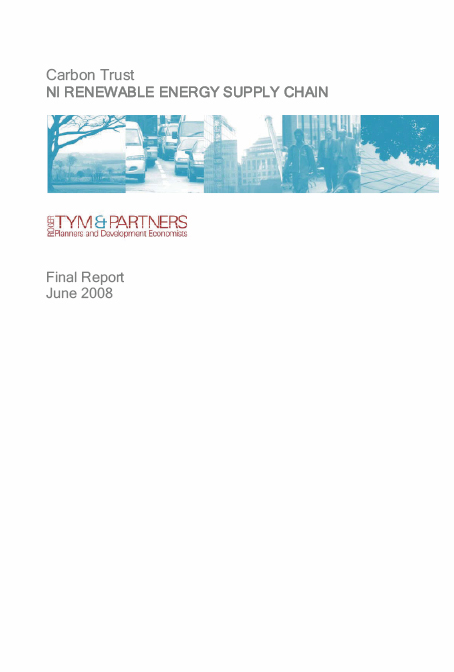


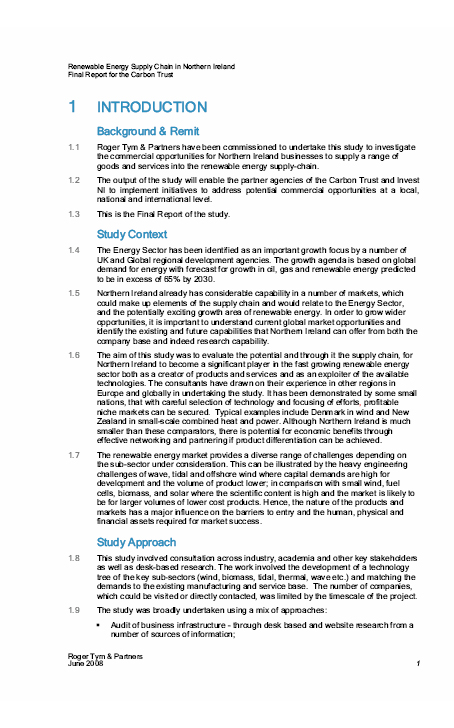
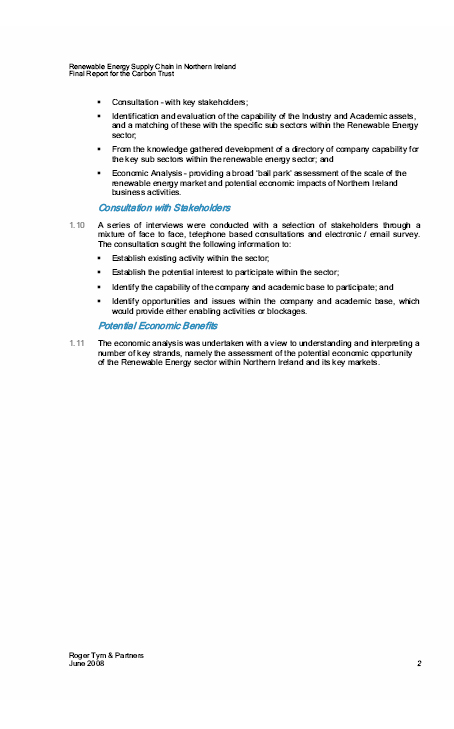
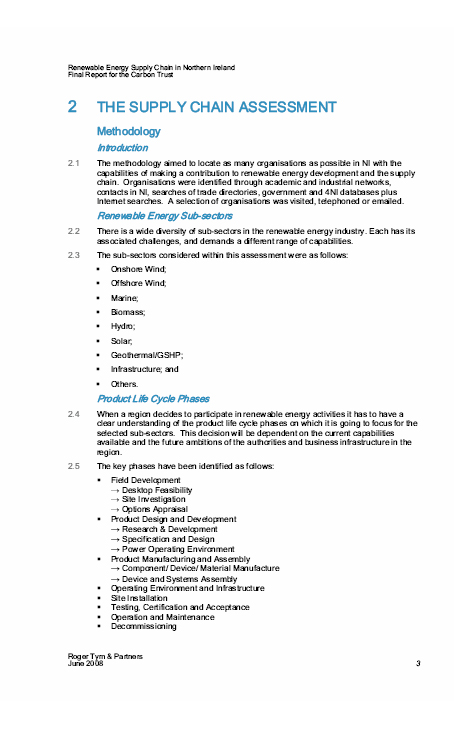
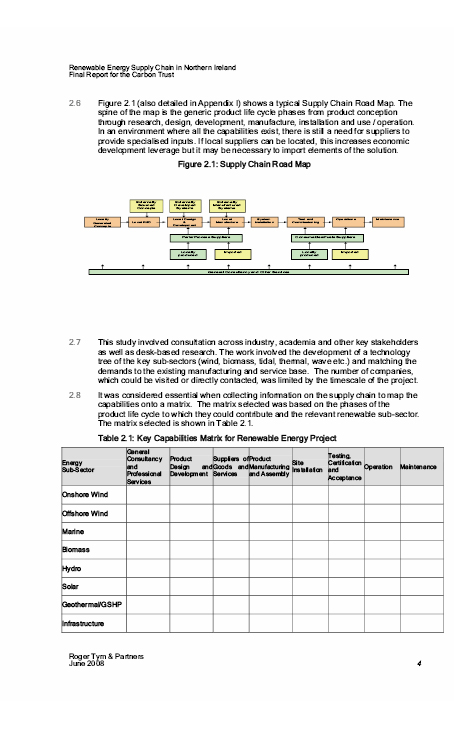
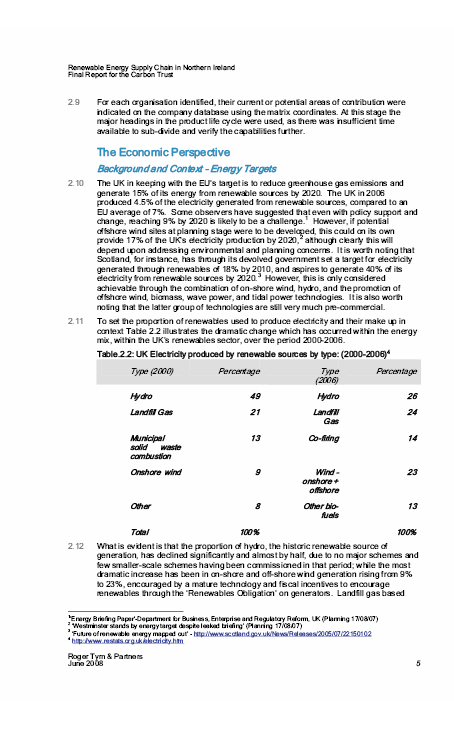
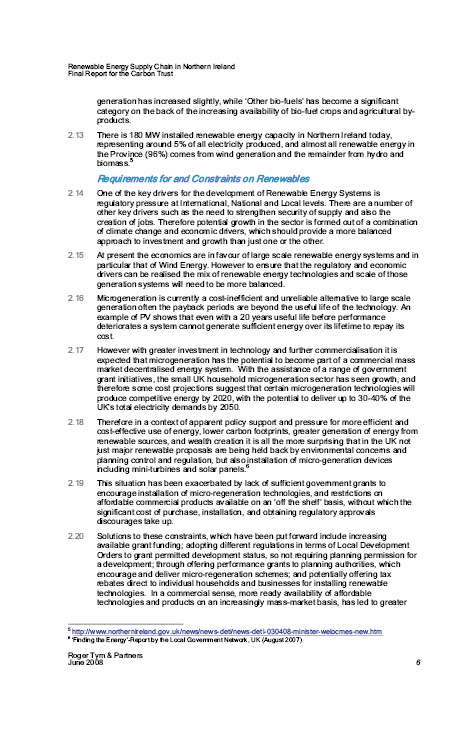
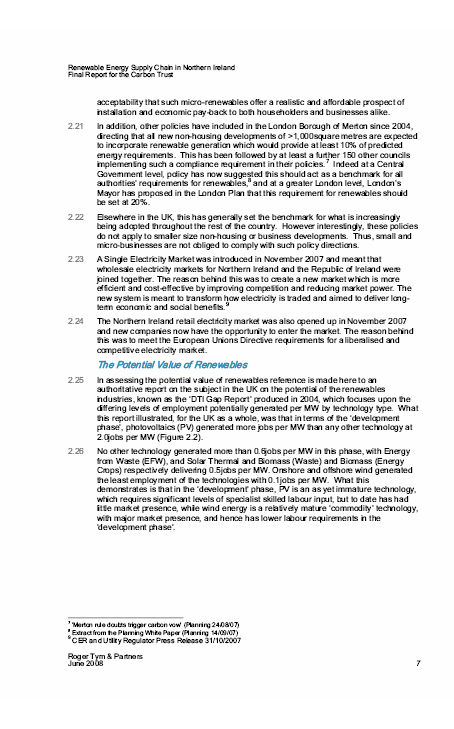
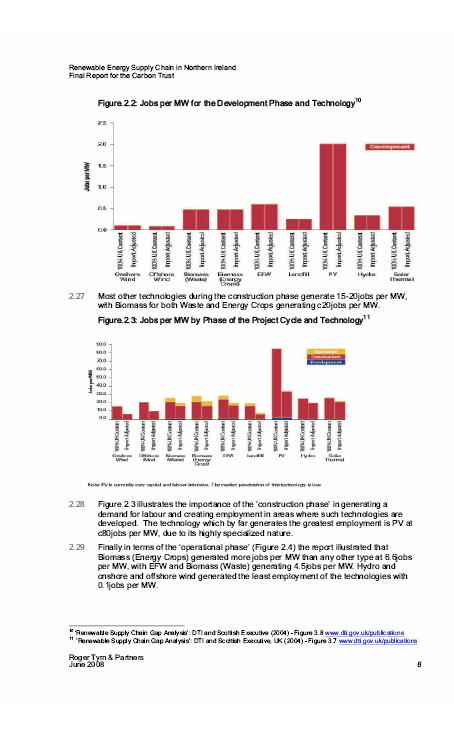
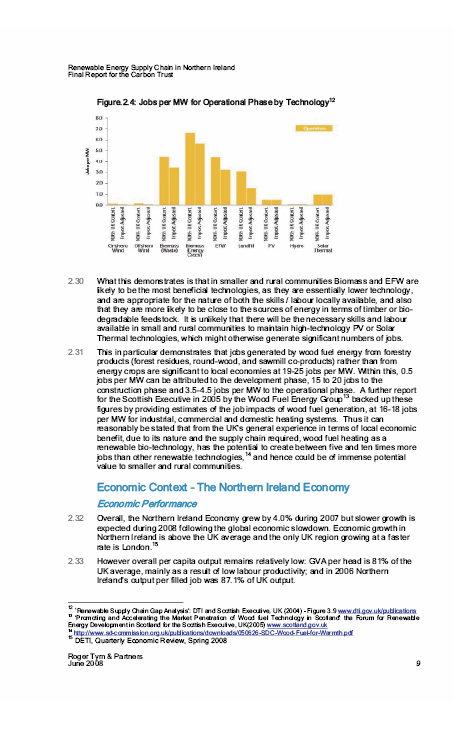
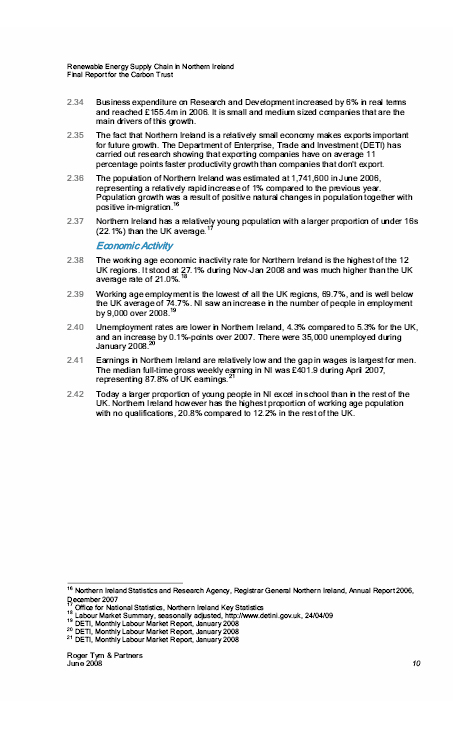
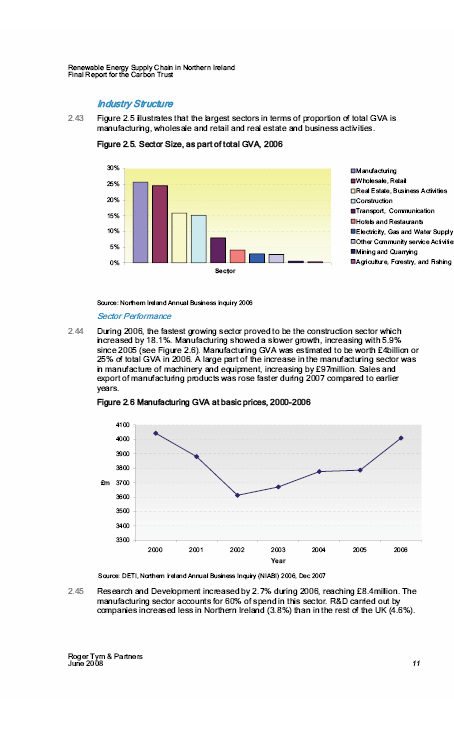
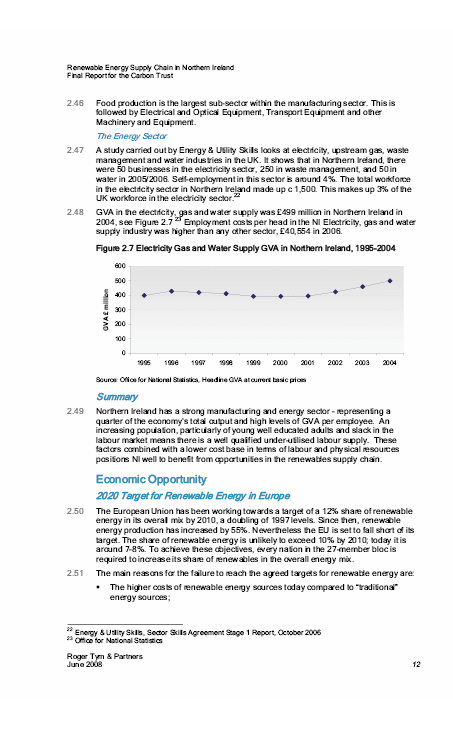
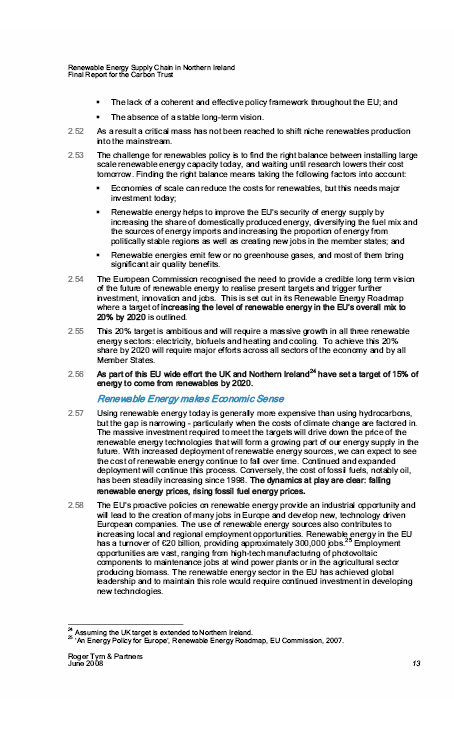
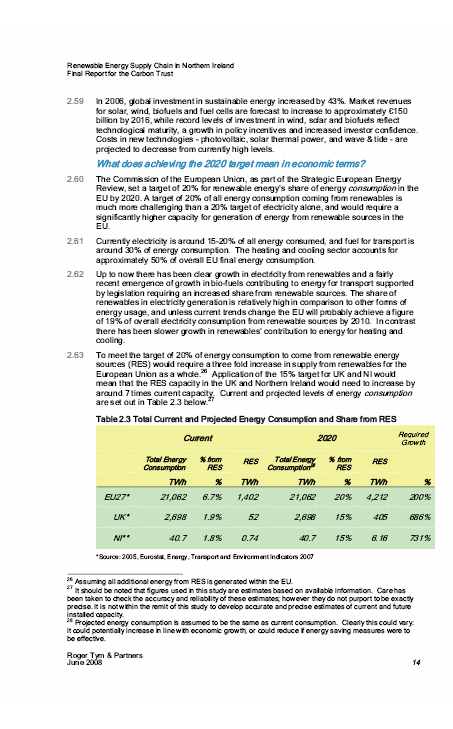
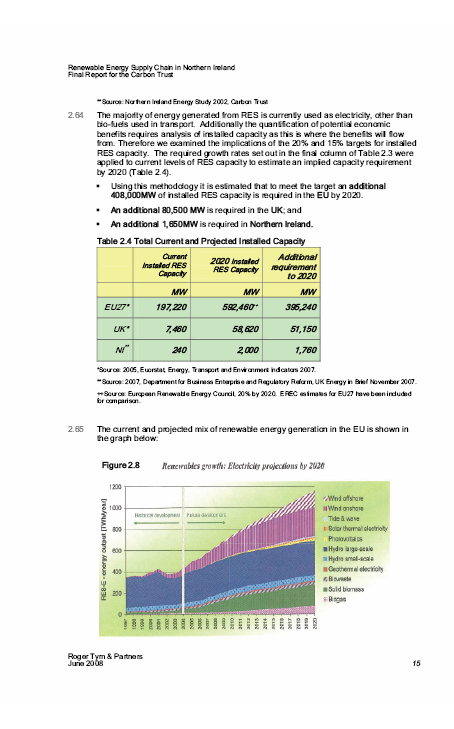
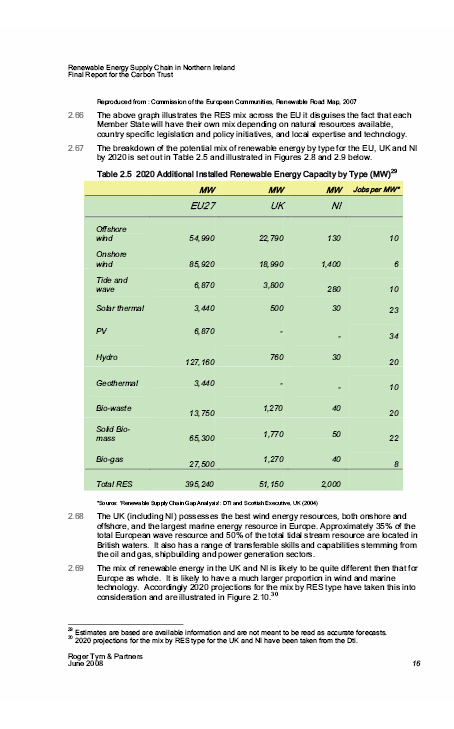
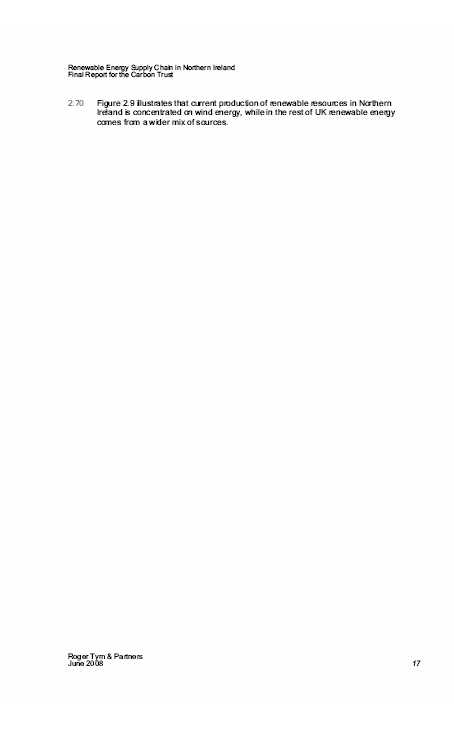
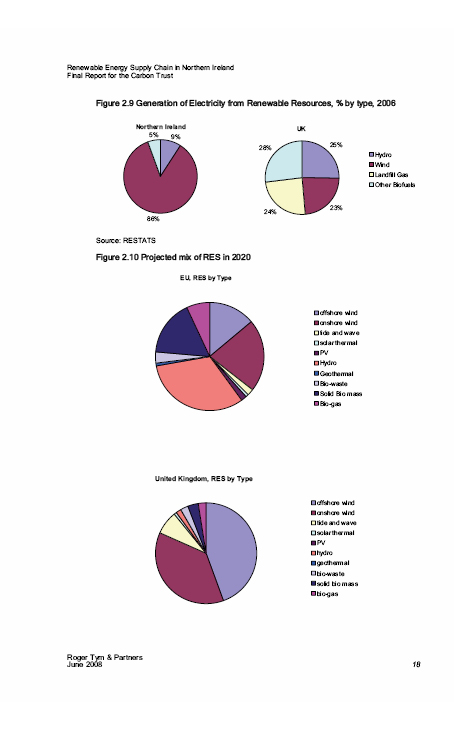
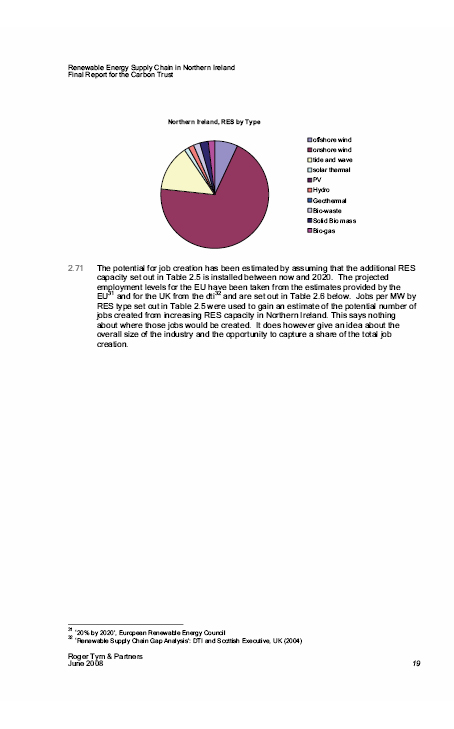
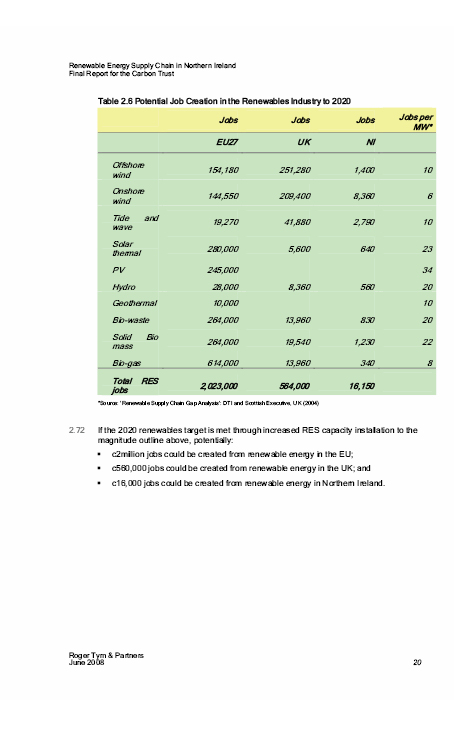
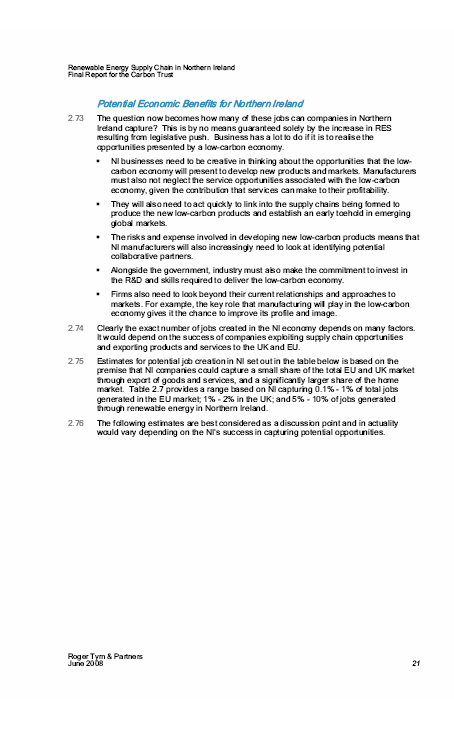
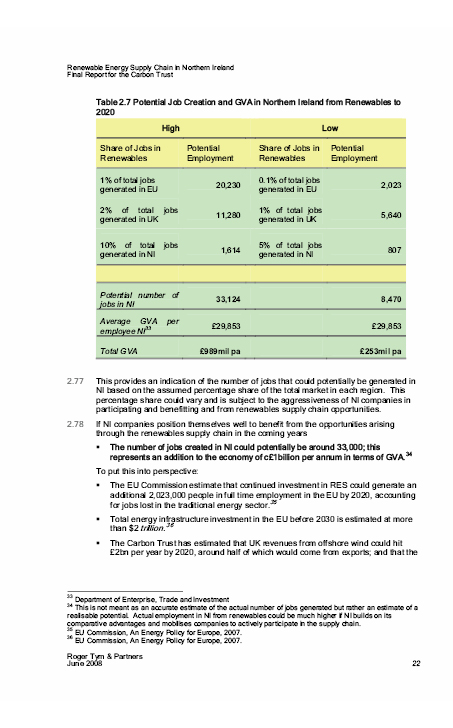
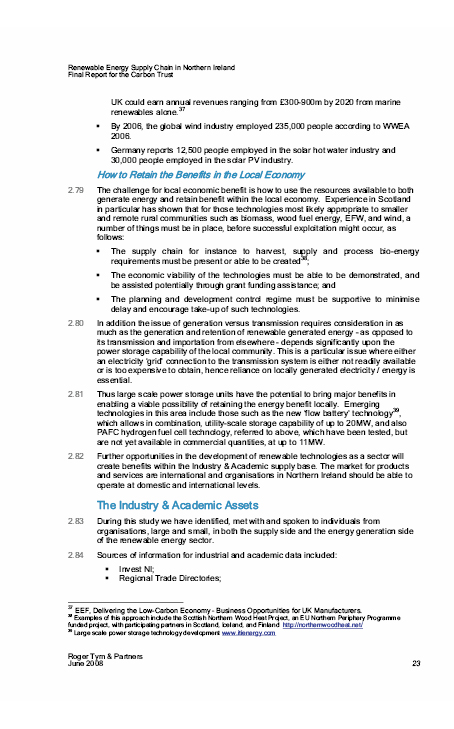
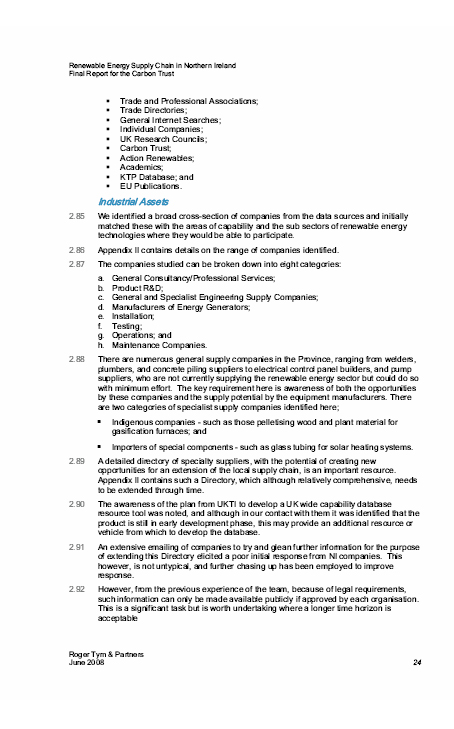
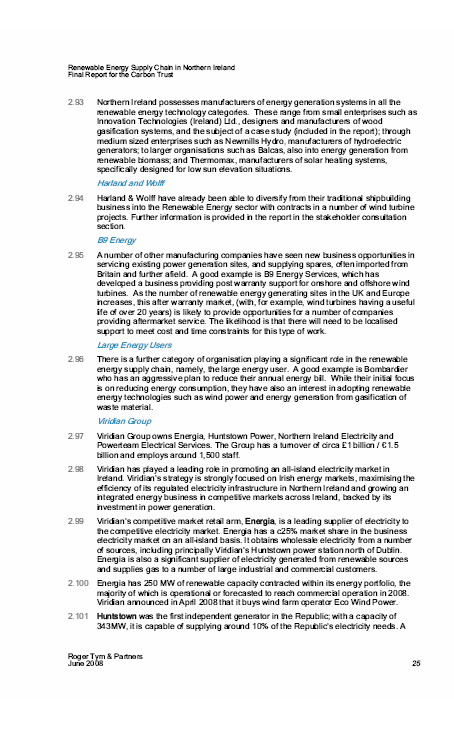
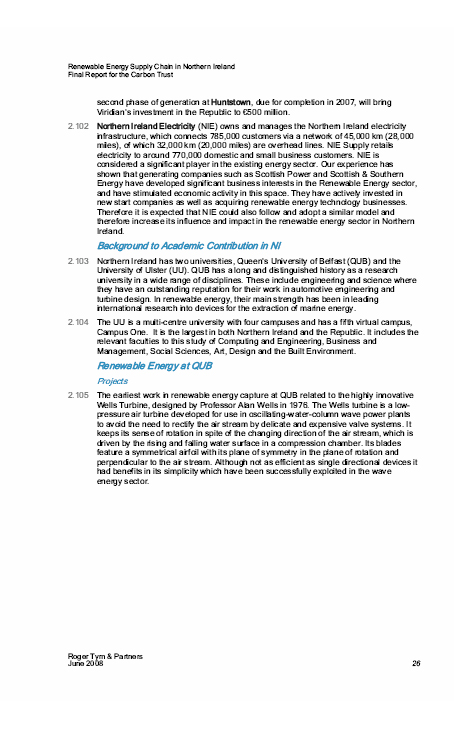
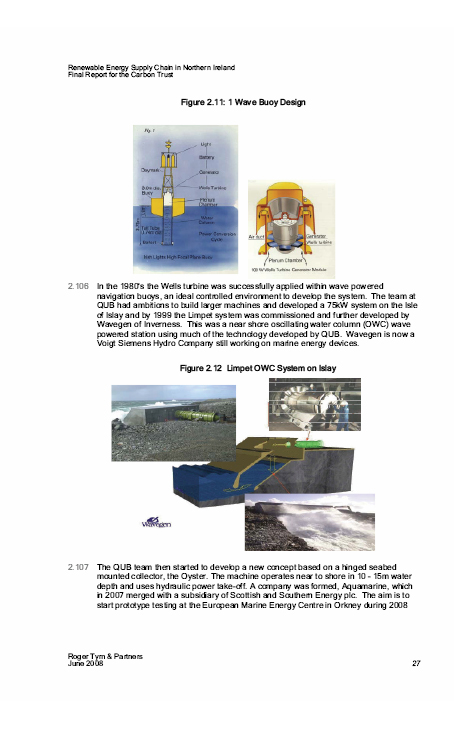
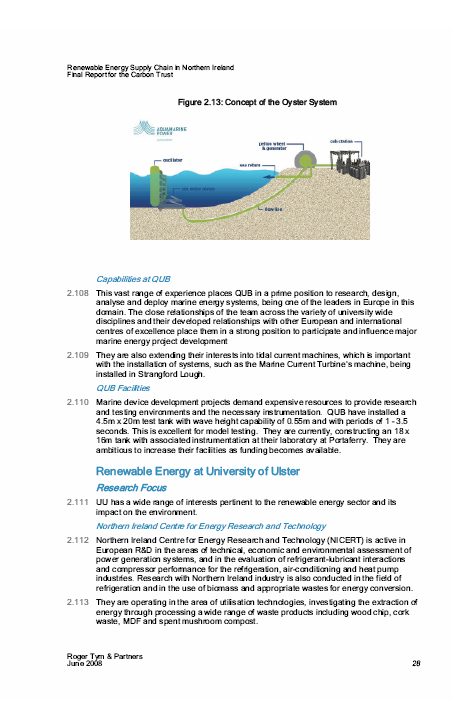
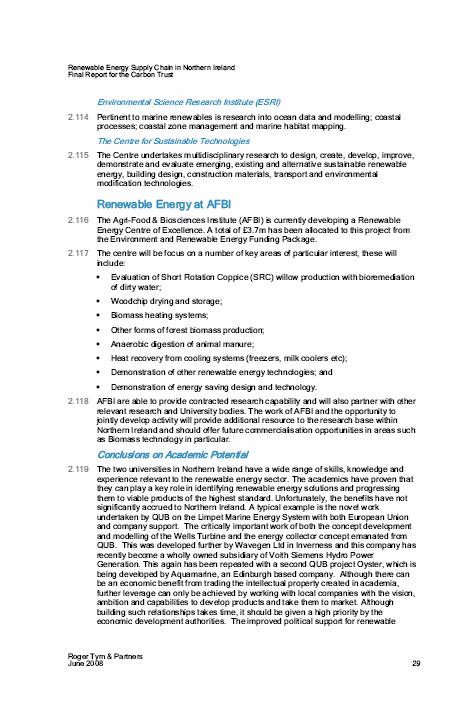
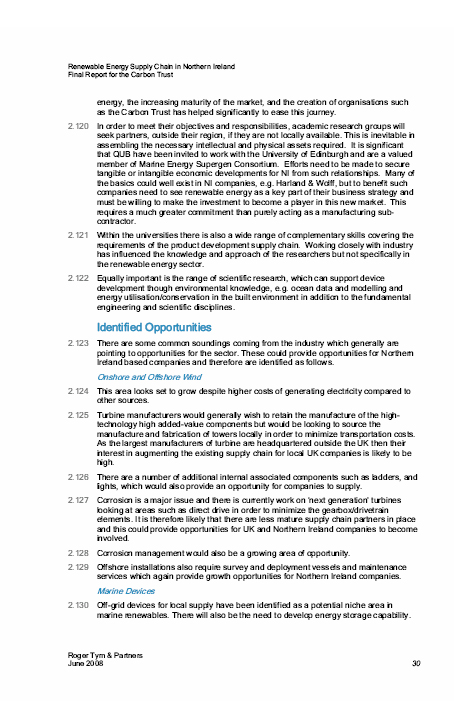
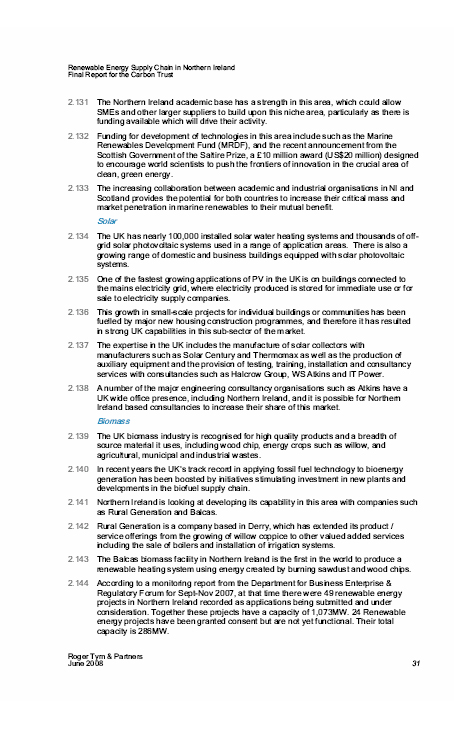
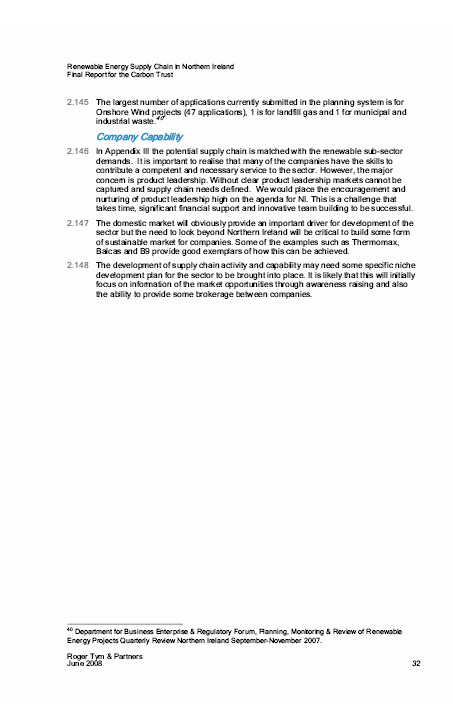
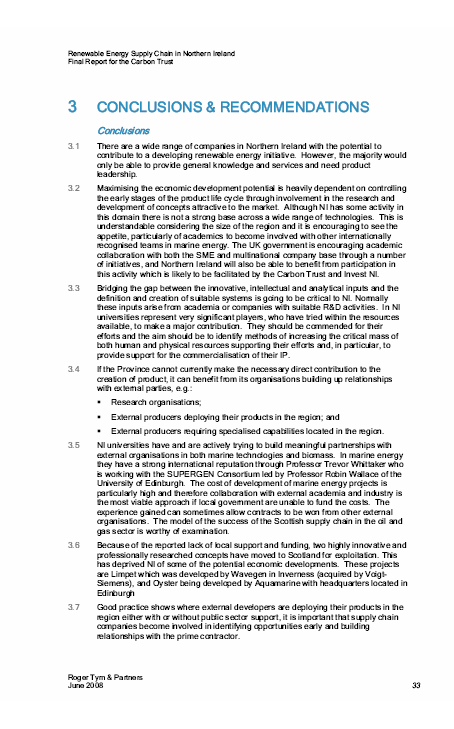
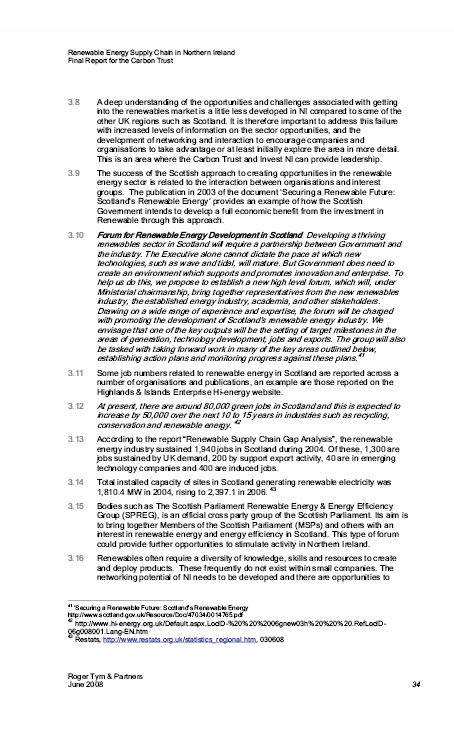
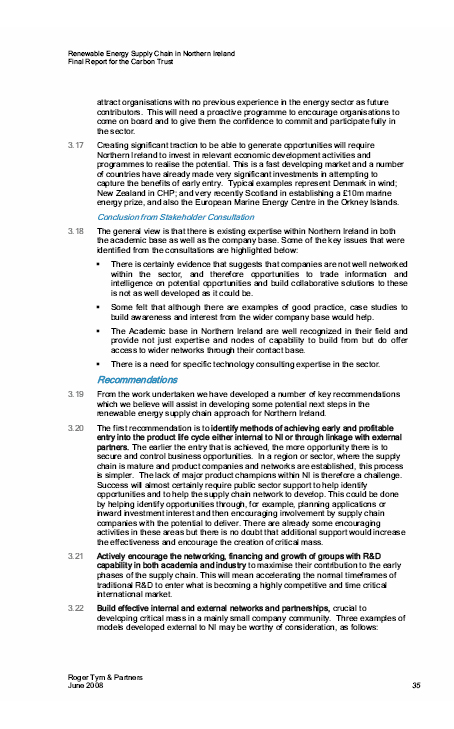
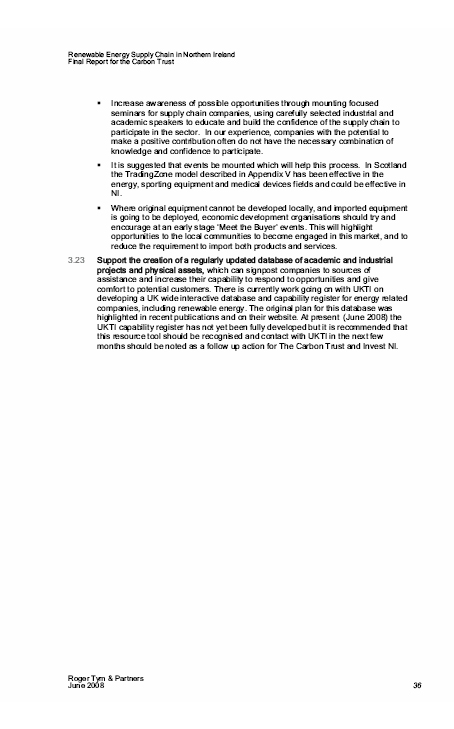
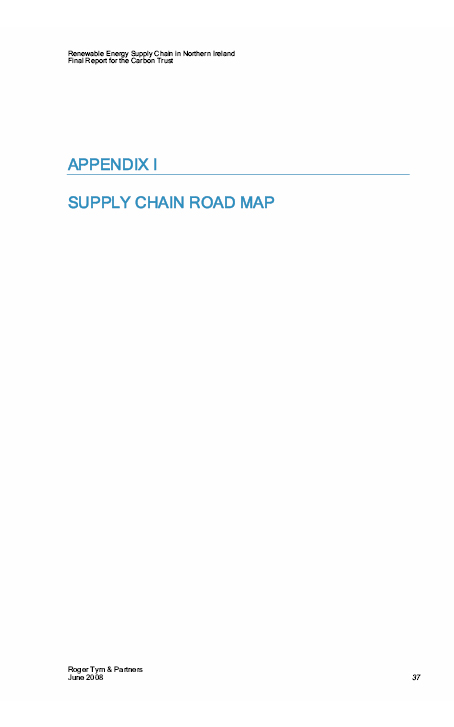
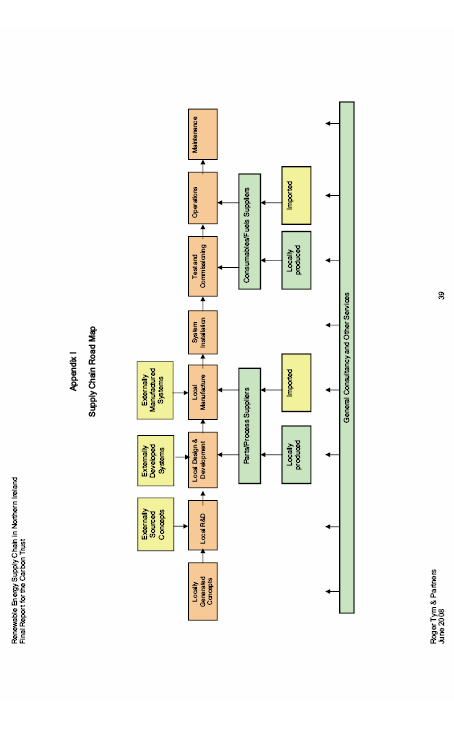
Response from Carbon Trust NI No.3
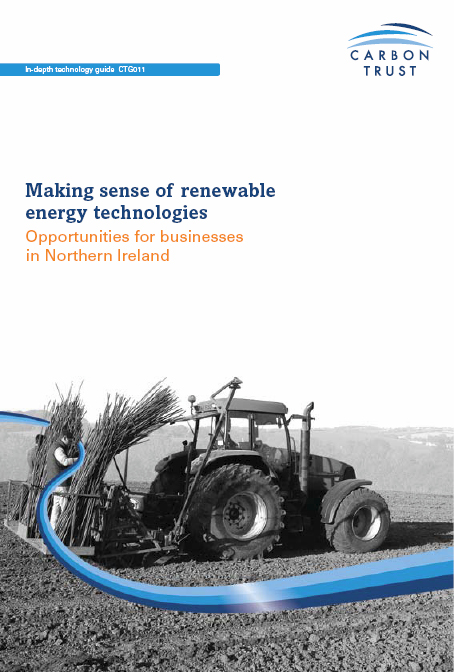
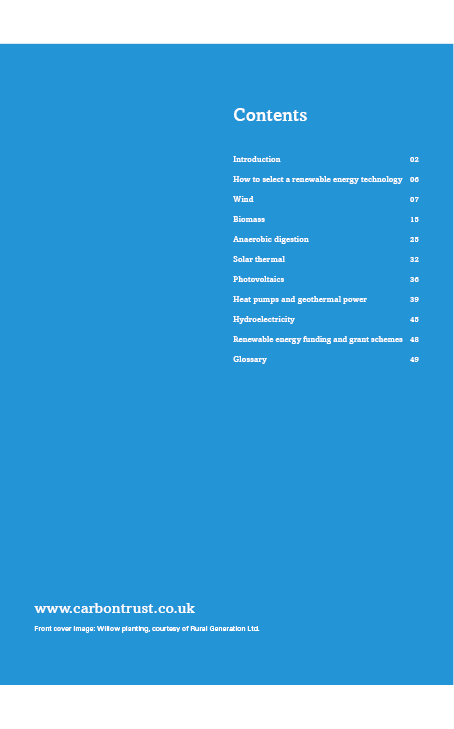
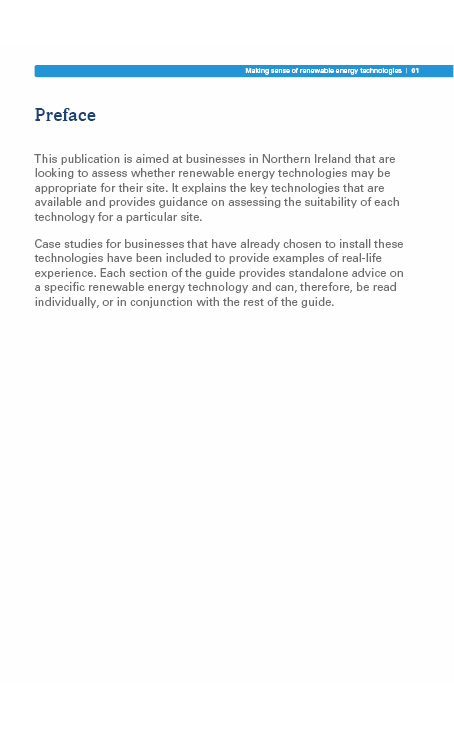
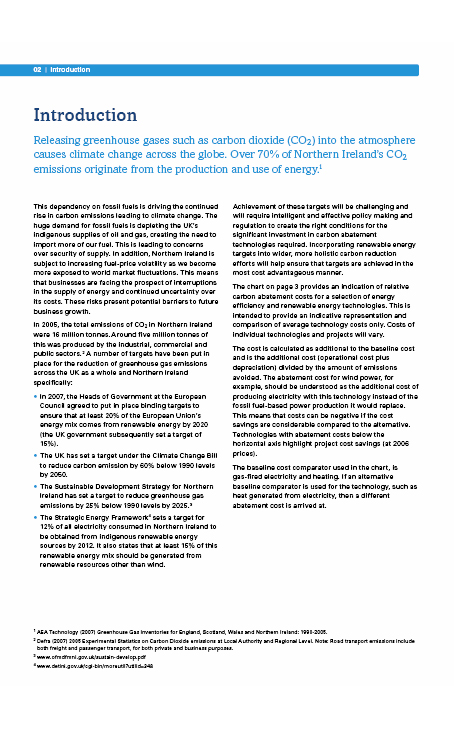
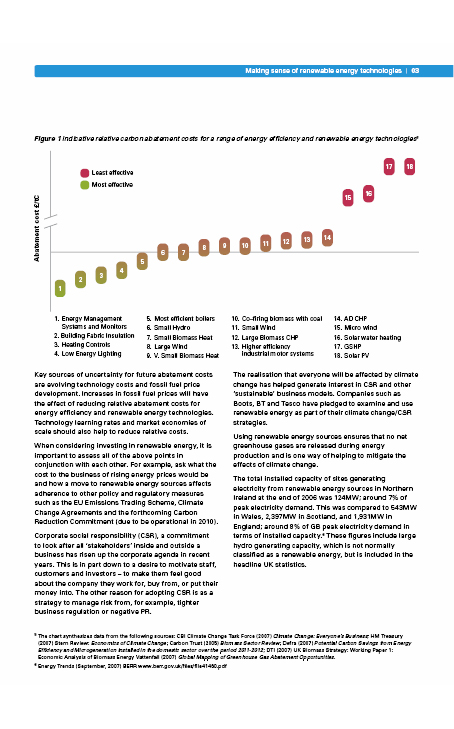
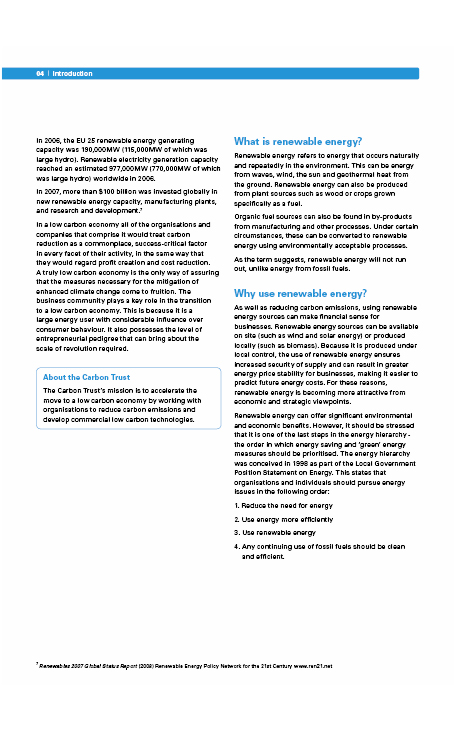
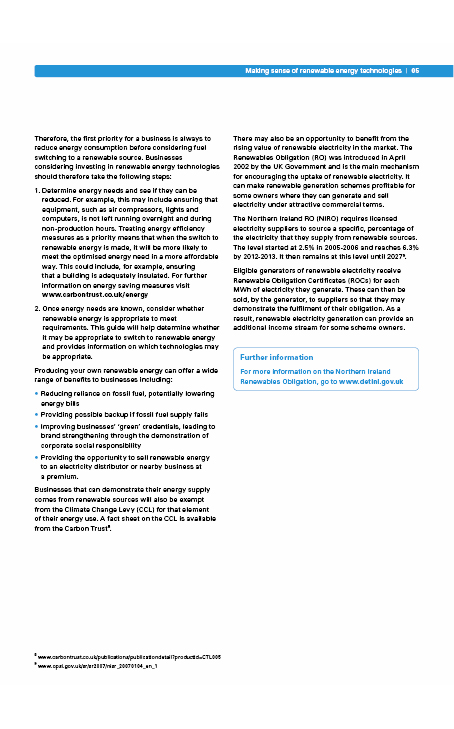
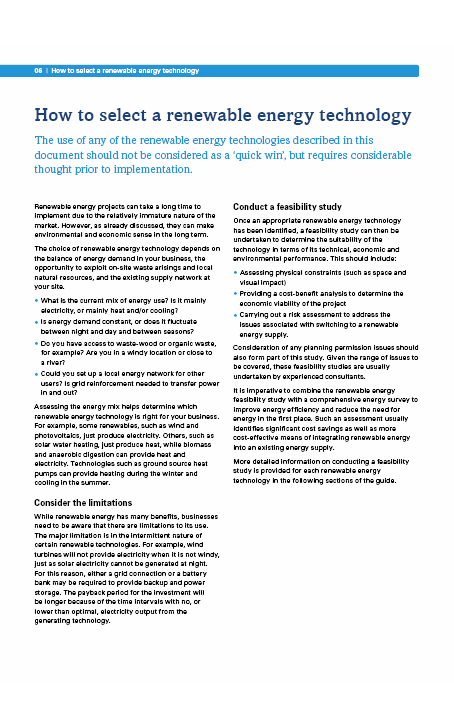
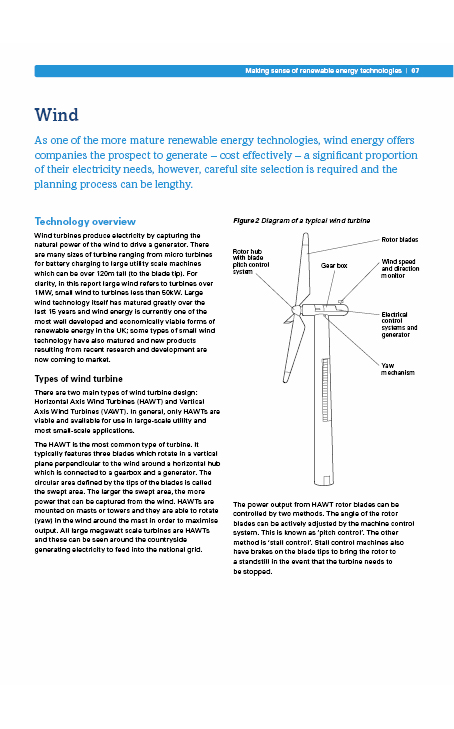
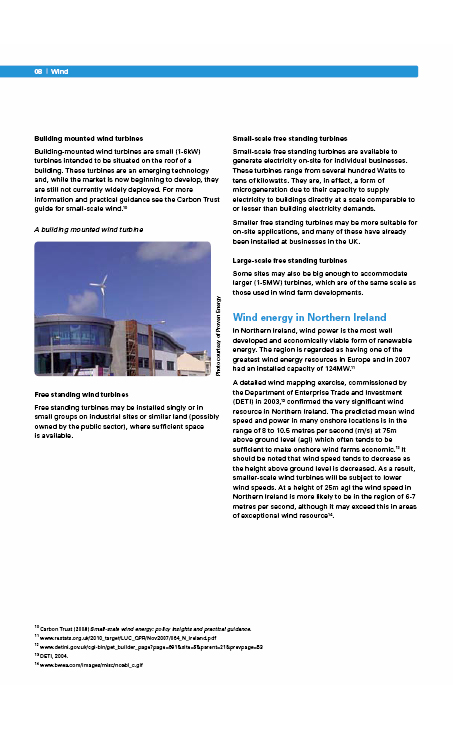
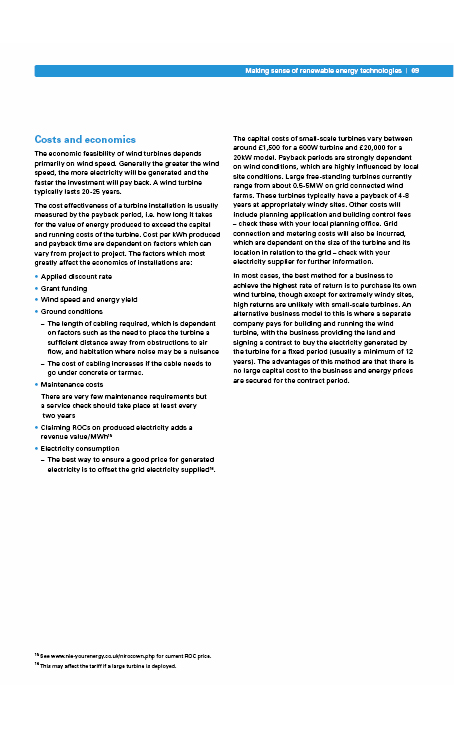
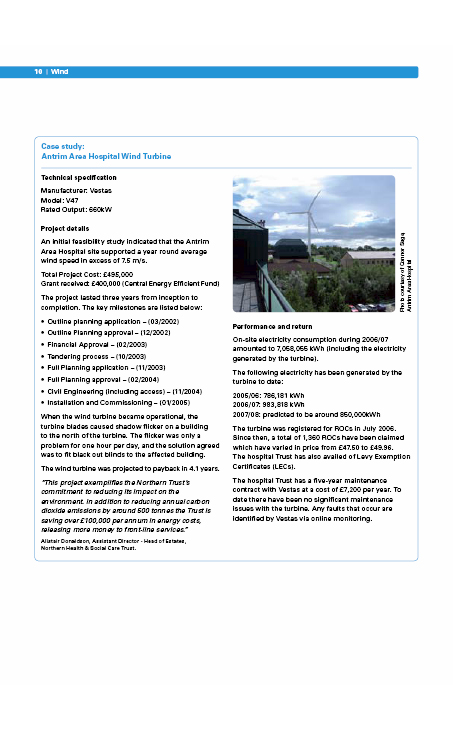
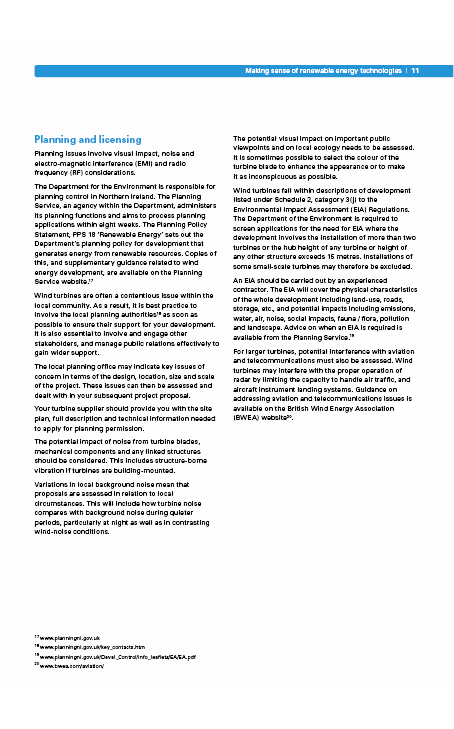
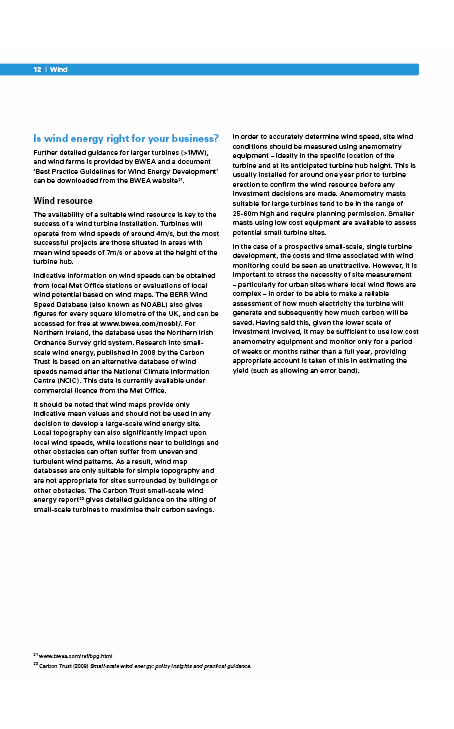
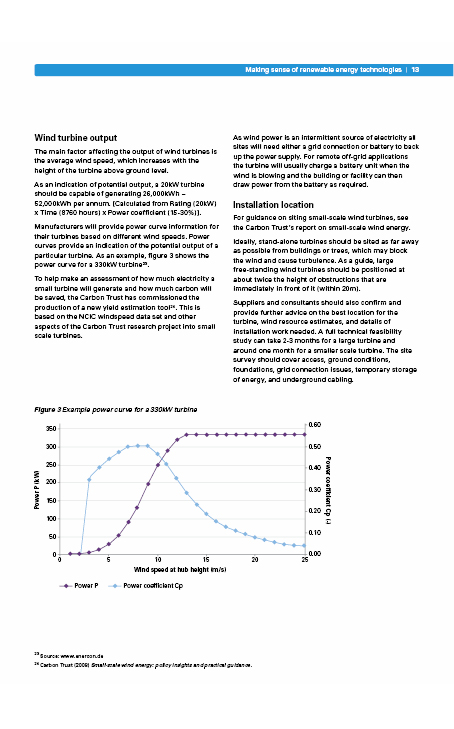

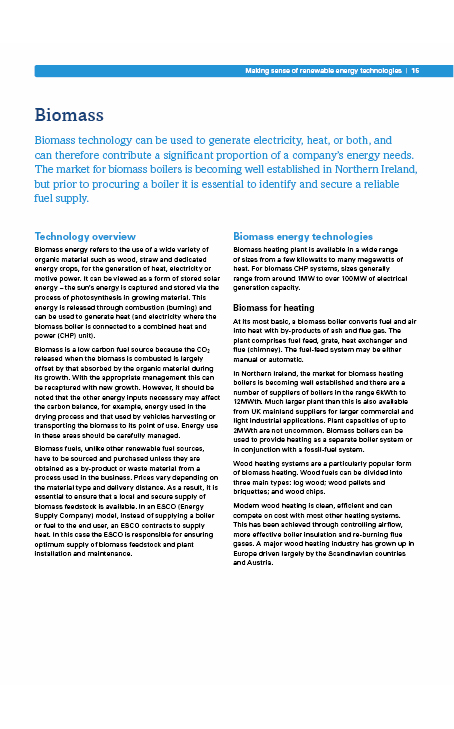
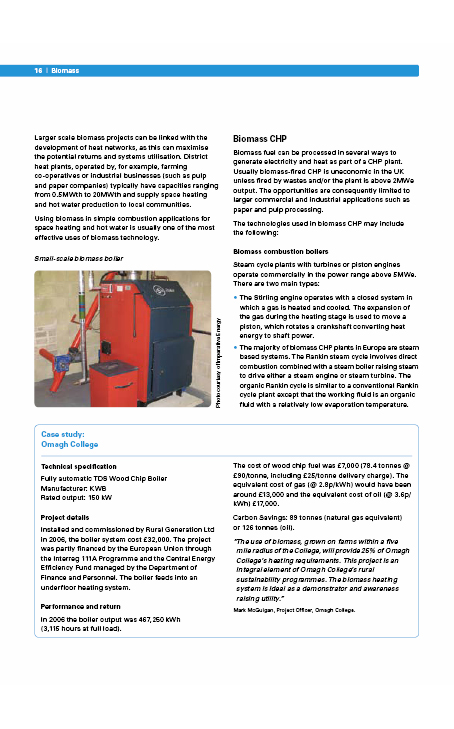
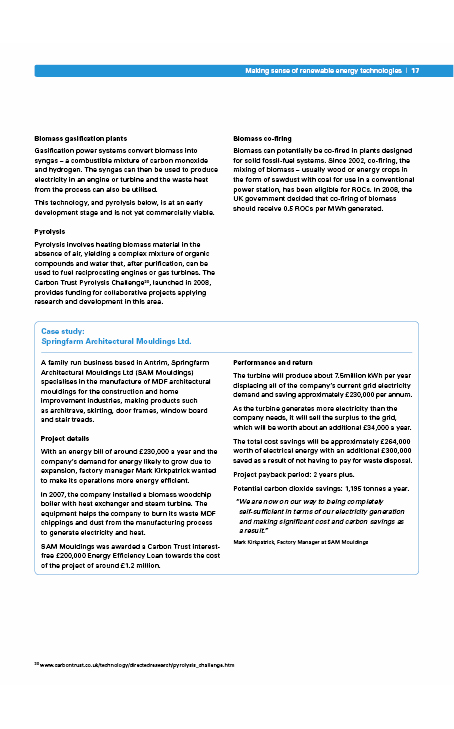

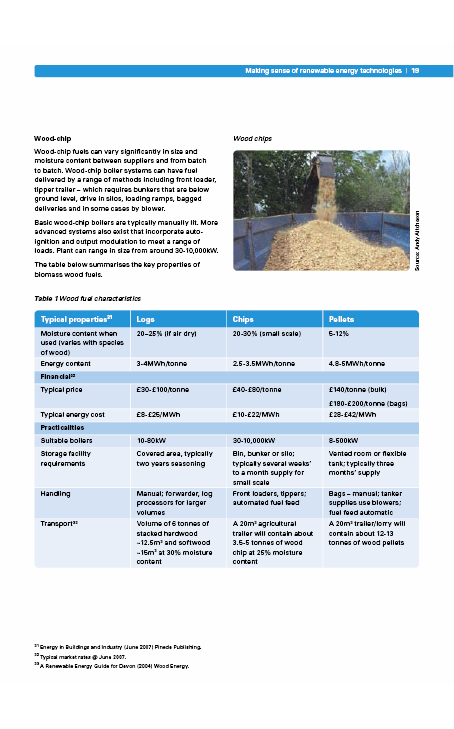
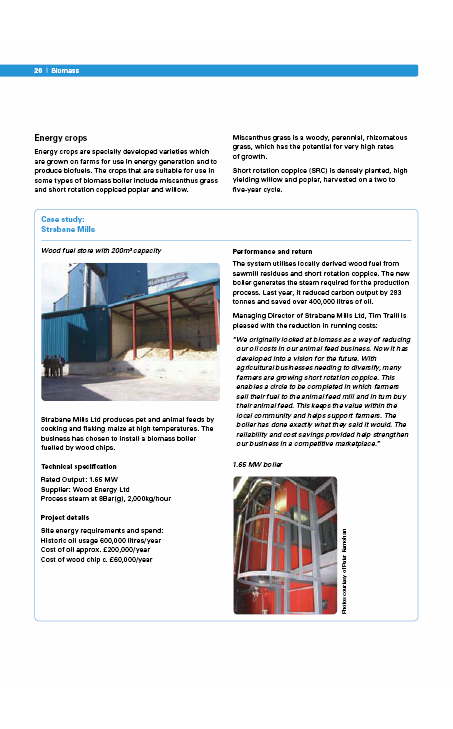
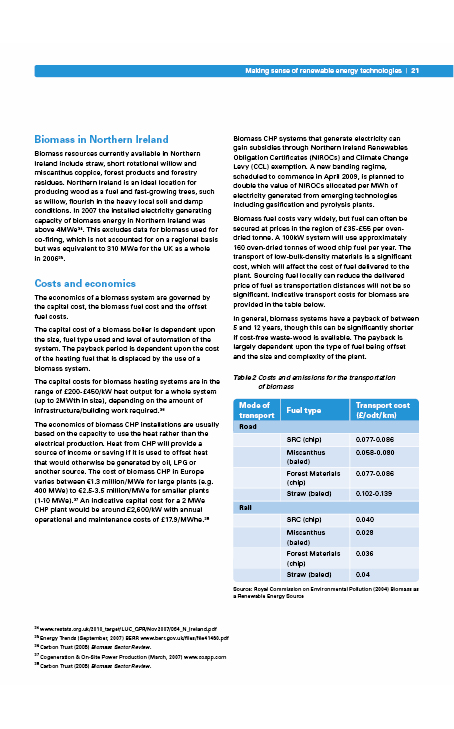
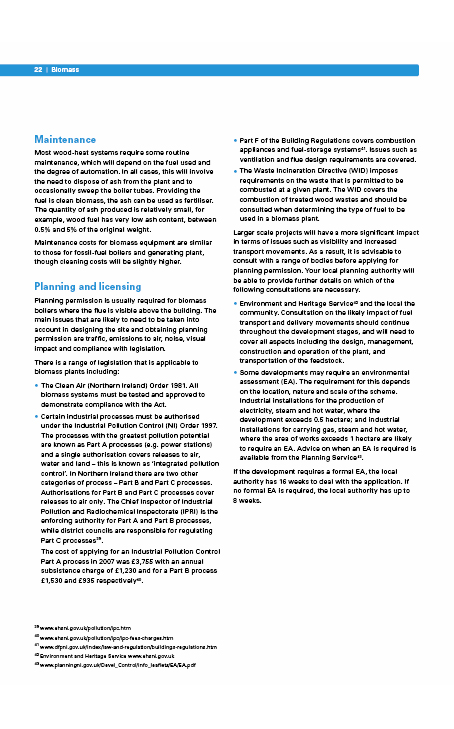
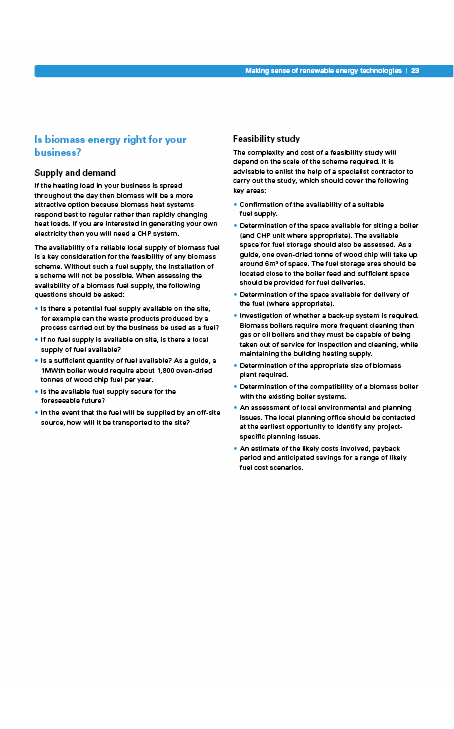
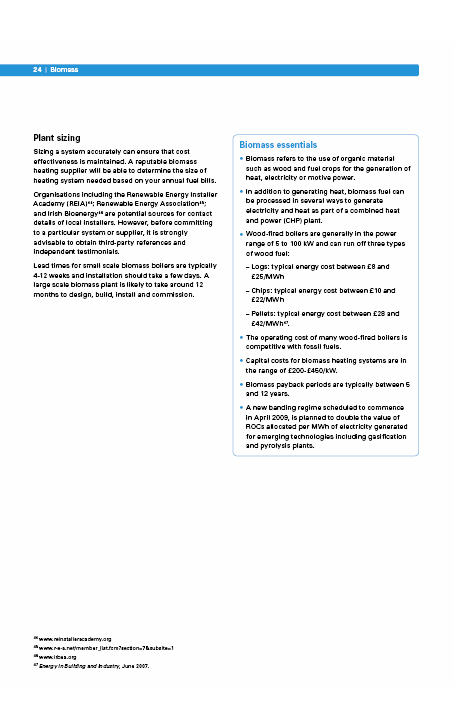
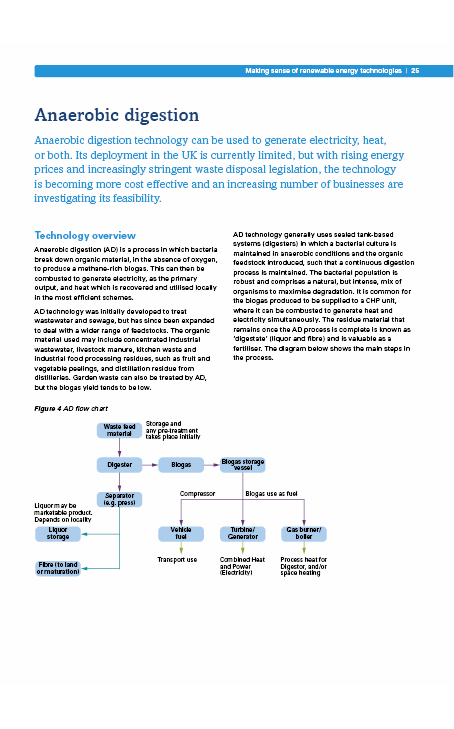
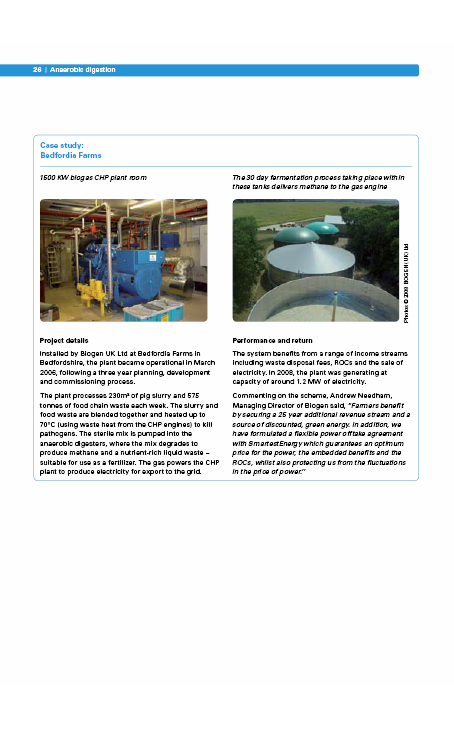
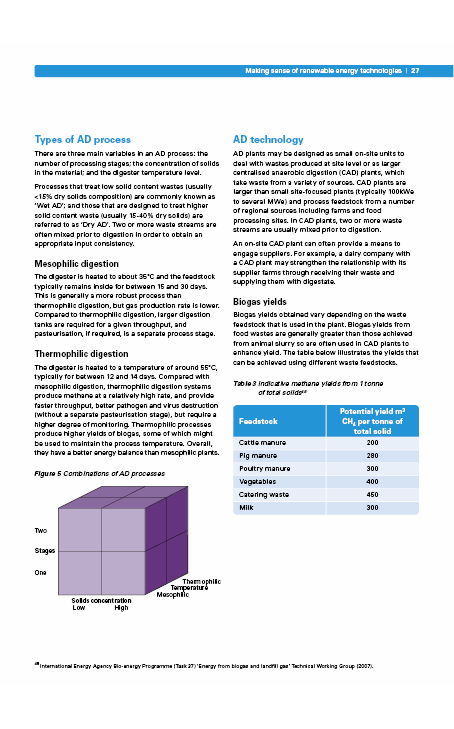
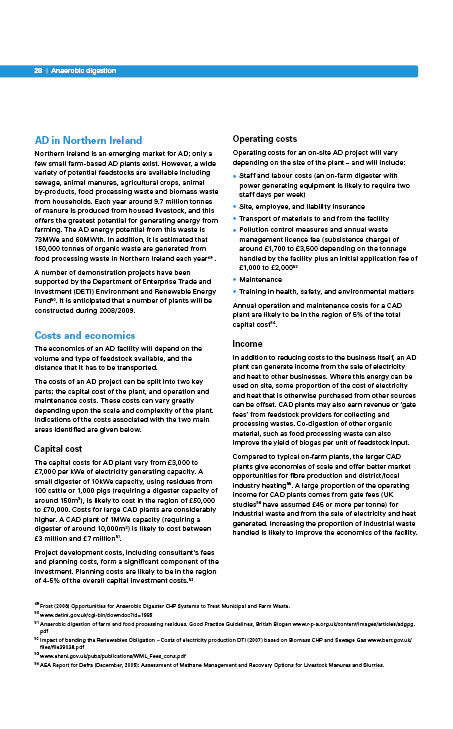
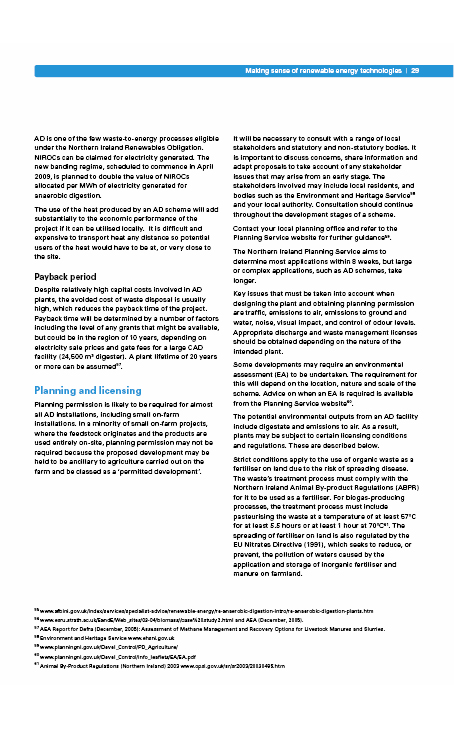

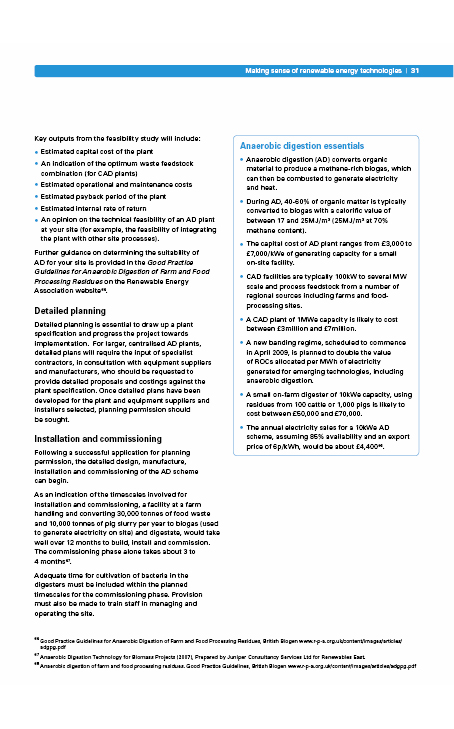
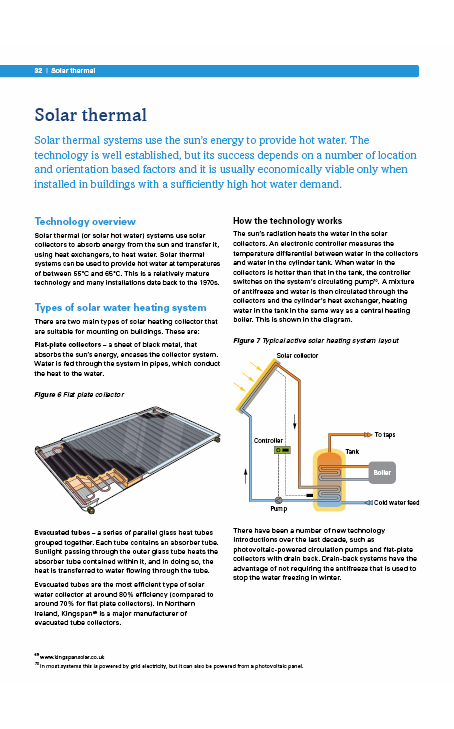
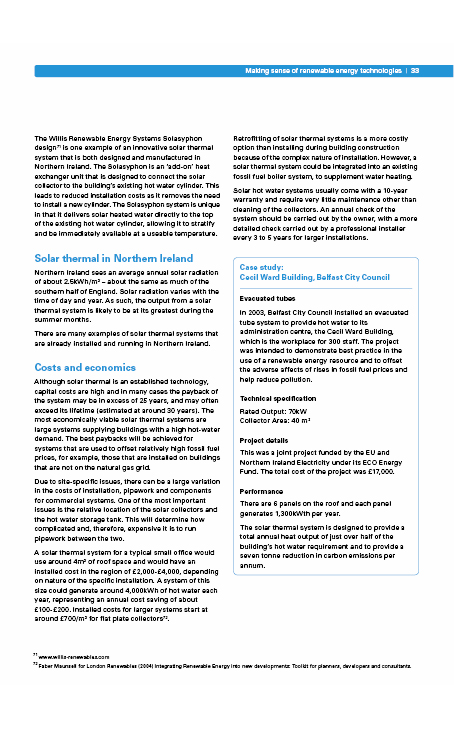
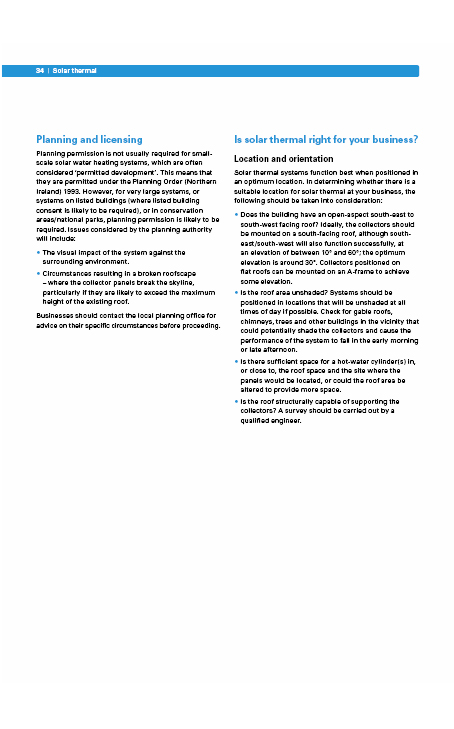
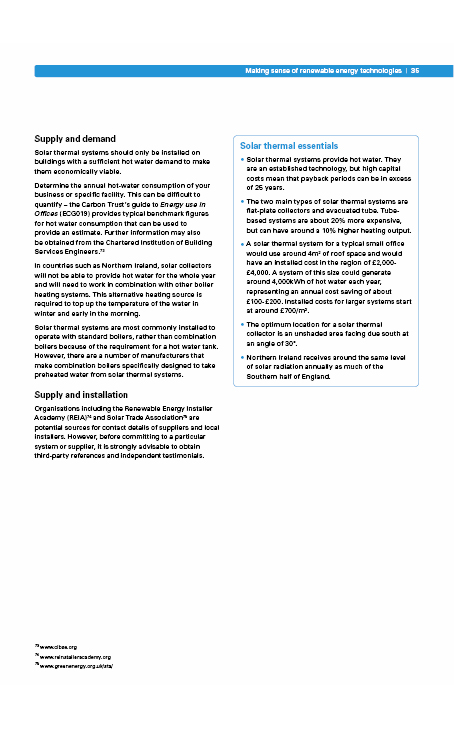
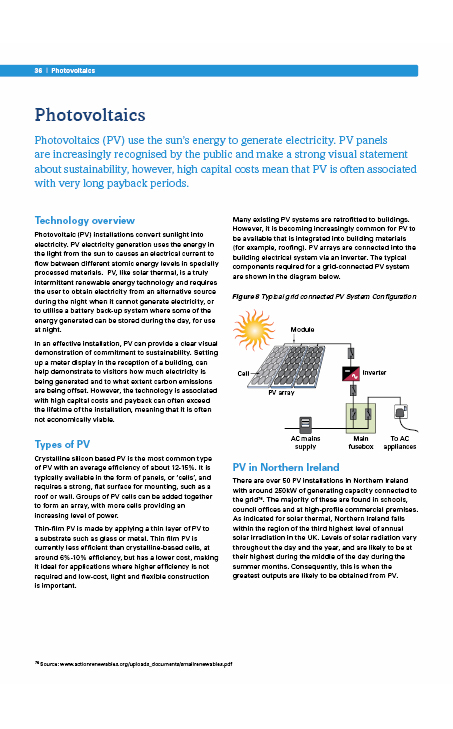
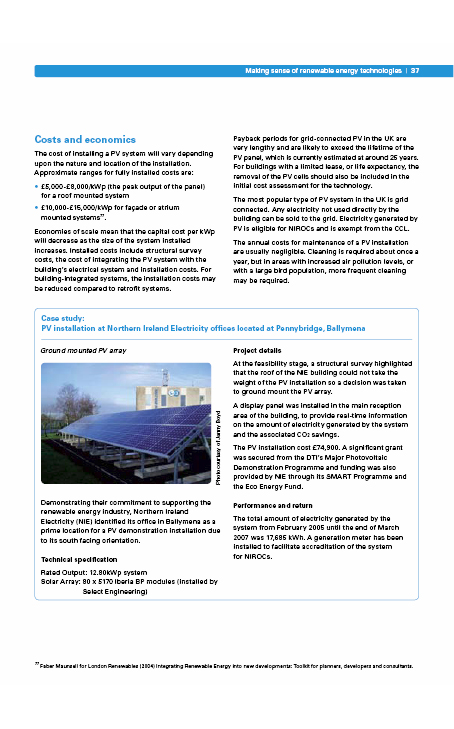
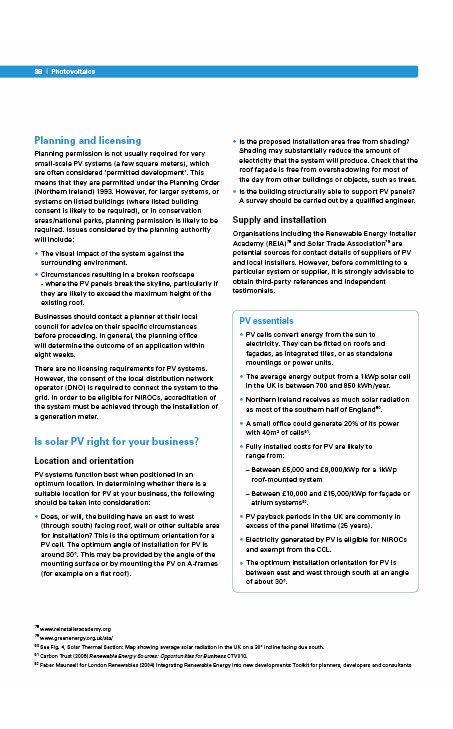
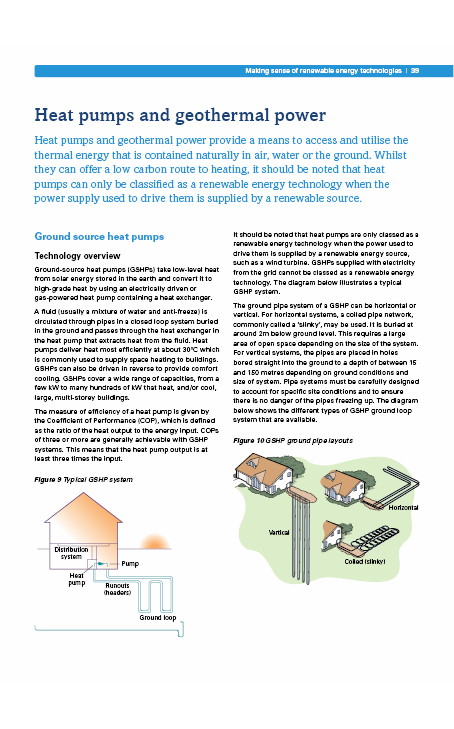
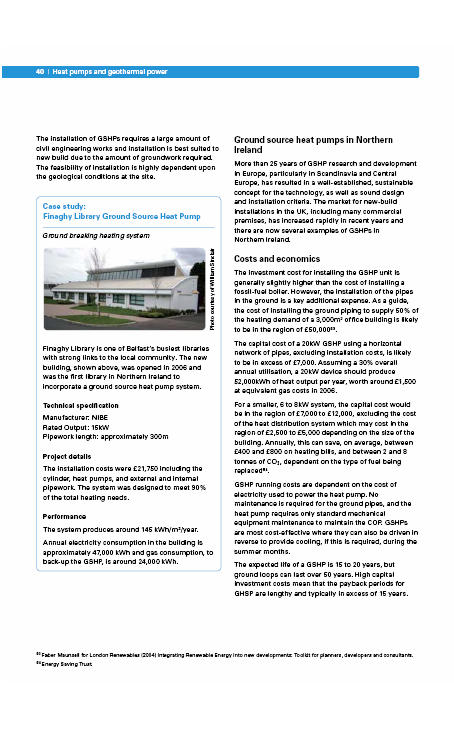

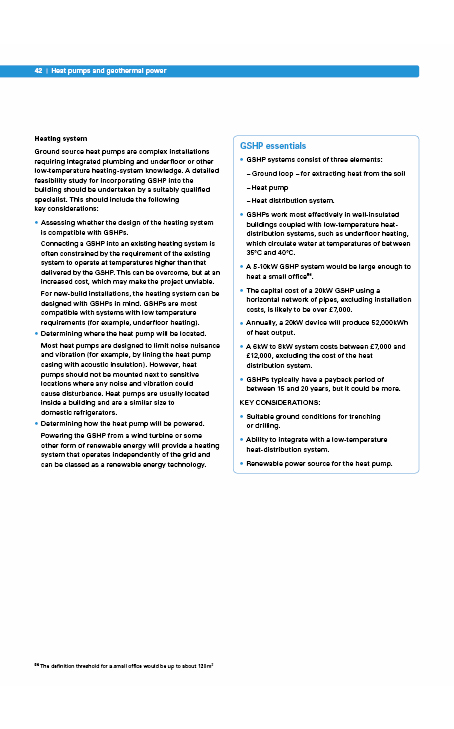
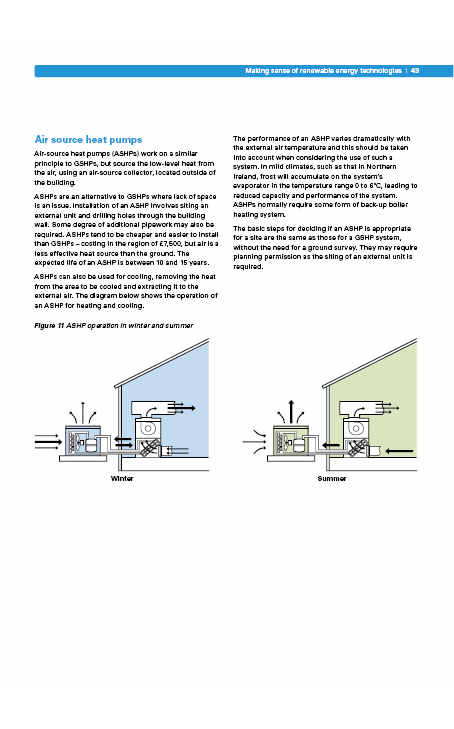

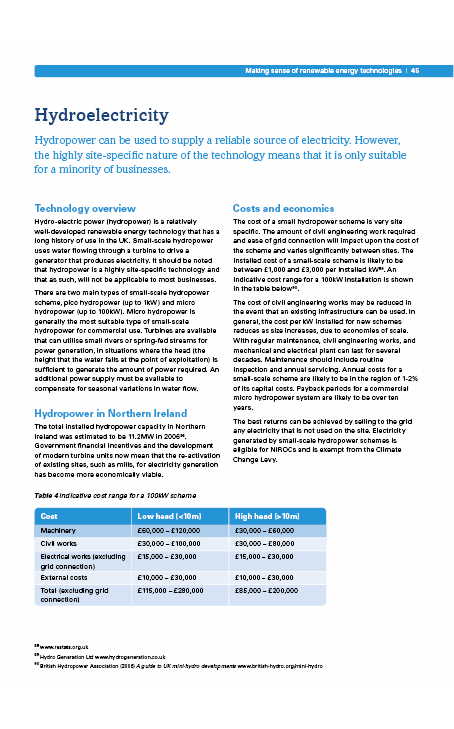
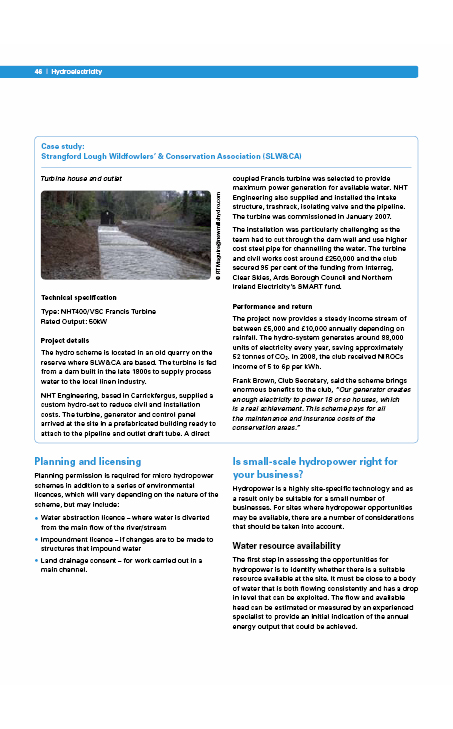
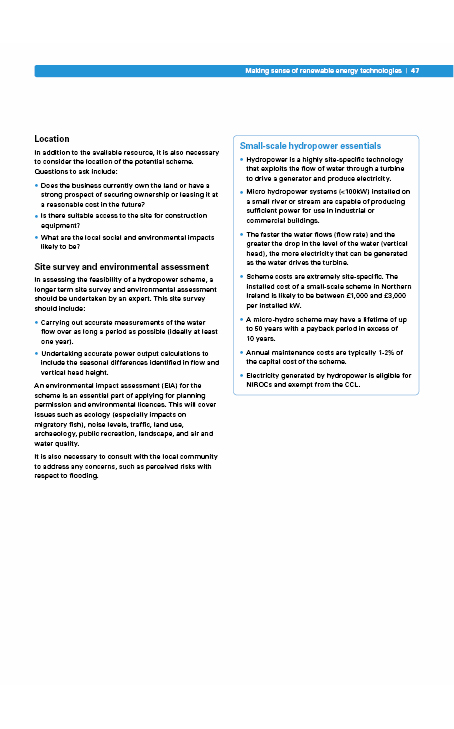
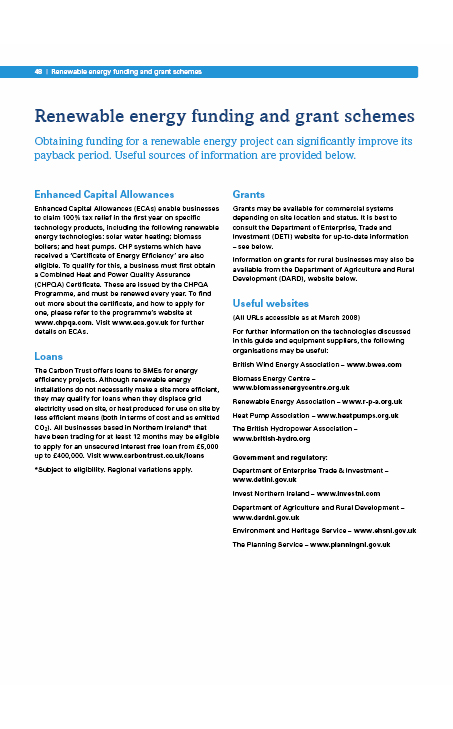
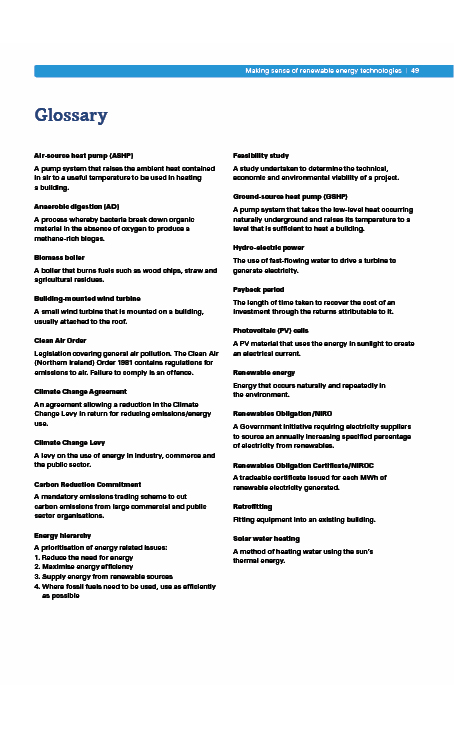



Response from Committee for Regional Development
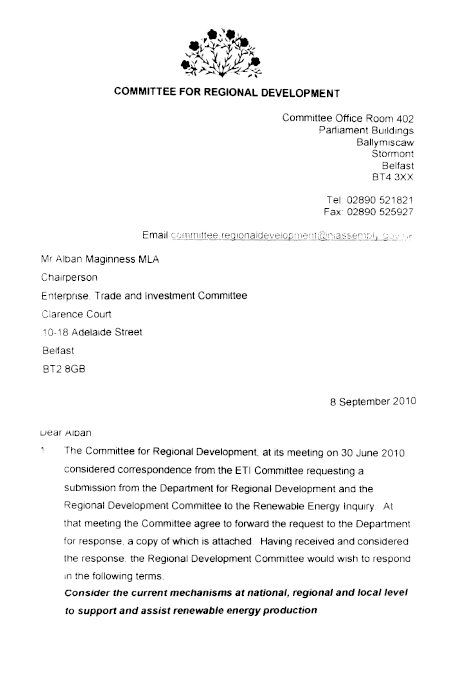
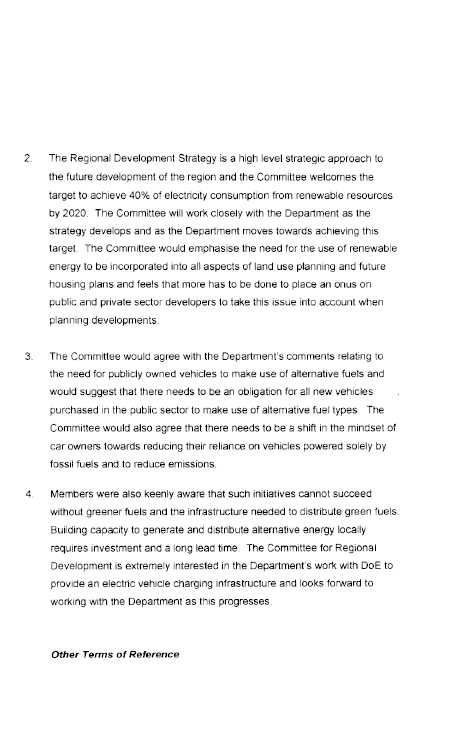
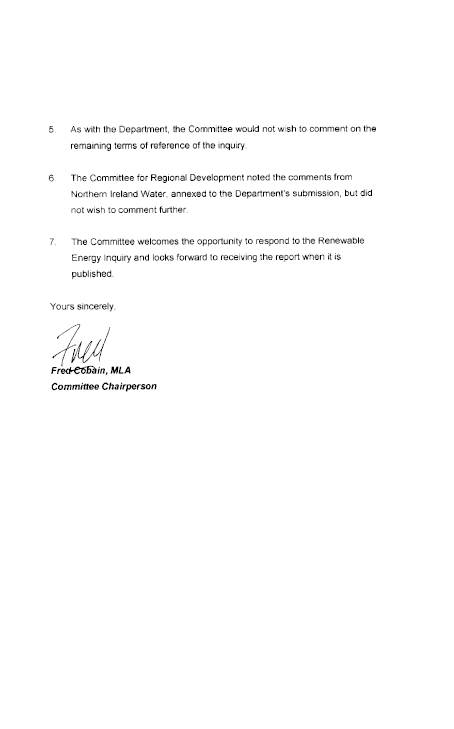
DRD Response re Inquiry Follow up Questions
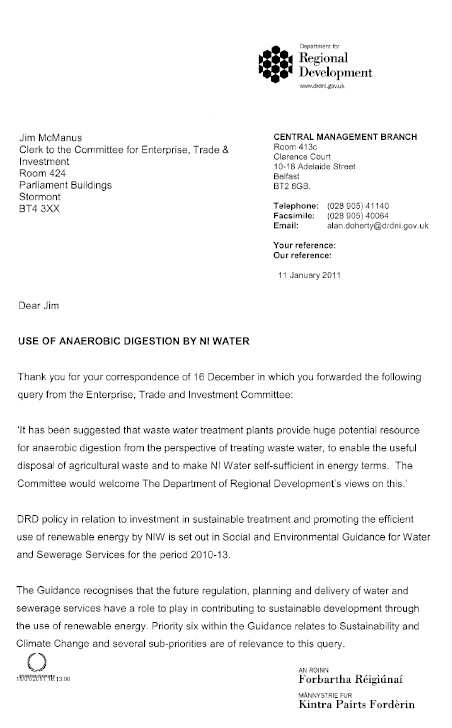
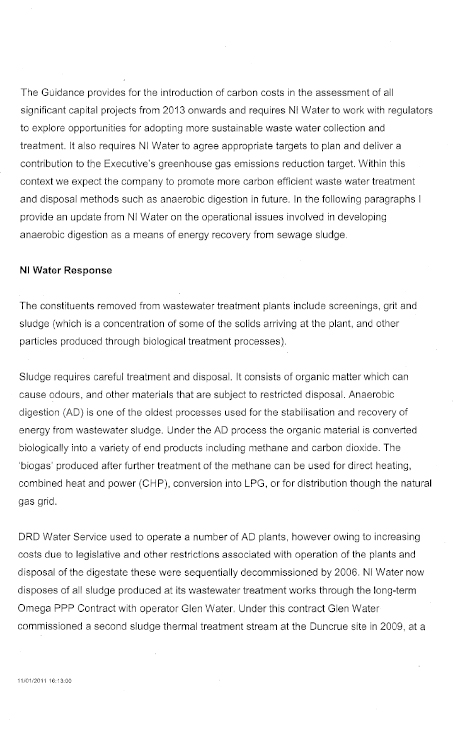
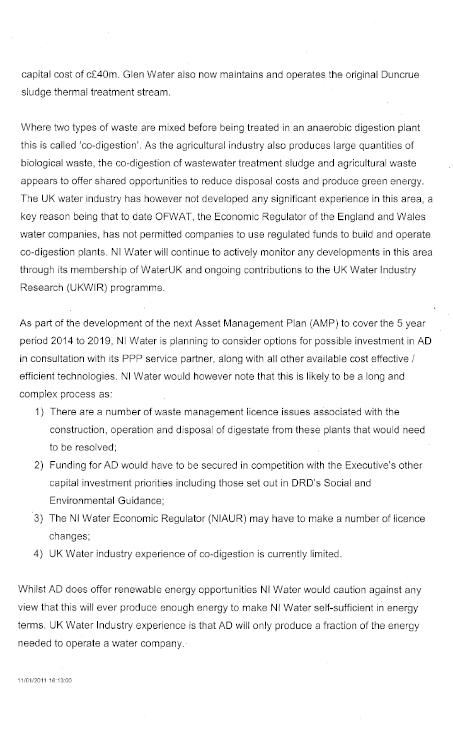

Response from Department of Agriculture and Rural Development
Peter Scott
Climate Change and Renewable Energy Branch
Department of Agriculture and Rural Development
Room 654
Dundonald House
Belfast
BT4 3SB
Department of Agriculture And Rural Development
Sohui Yim
Assistant Clerk to the Committee for
Enterprise, Trade and Investmentt
Room 375
Parliament Buildings
Ballymiscaw
Stormont
Belfast
BT4 3XX
17 Dec 2010
Dear Sohui
ETI Committee - Renewable Energy Inquiry
I refer to your correspondence of 6th Dec 2010 requesting additional information in respect of the recent ETI Committee Inquiry.
Thank you for this opportunity to provide additional information to support of our evidence. Please find our response attached.
Yours sincerely,
Peter Scott
Climate Change and Renewable Energy Branch
Department of Agriculture and Rural Development
DARD Response to ETI Committee Request for Additional Information
An indicative list of those farms/forestry enterprises meeting their own energy needs.
An assessment of interest questionnaire in renewable energy production and usage was commissioned by DARD in August 2008 in conjunction with UFU to ascertain the level of interest in renewable energy within the agricultural sector.
Three hundred members of the UFU were surveyed, it must be noted they were not totally representative of the total agricultural sector in NI. There were 85 returns to the survey, all agricultural sectors responded although the main participants in the survey were from the Beef and dairy sectors.
The survey revealed 56% of participants indicated a high level of interest in renewable energy production and usage; a further 41% had some interest in the sector. Participants were mainly interested in wind generation at 43% followed by the processing of livestock waste/organic material at 28%. 21% were interested in willow/wood.
Subsequently as part of the Renewable Energy Event held at Greenmount in November 2010 of the 700 visitors surveyed to indicate adoption of renewable energy technologies on farm, 50 responded and results are tabulated below
| Technology | Number of farms | % |
| Solar | 15 | 30 |
| Wind | 13 | 26 |
| Biomass | 8 | 16 |
| Hydro | 6 | 12 |
| Src production | 5 | 10 |
| Bioga | 2 | 4 |
| Wood Pellet | 1 | 2 |
Work will commence in the near future to obtain a wider knowledge of the level of uptake of renewable energy technologies within the land based sector. DARD wish to progress this work during the early part of 2011.
A list of any biomass schemes that are currently operational in Northern Ireland.
The Biomass Schemes that are operational in NI are mainly for heat purposes and are indicated in the diagram below.
The Anaerobic Digester installed at AFBI Hillsborough produces heat and electricity for the Hillsborough site. DARD are not aware of any other Anaerobic digesters currently operational in NI
Northern Ireland – Biomass for heat
1000 hectares of SRC willows (red dots), 10 ha miscanthus
400 hectares of forest harvested annually
55,000 t of wood pellets manufactured annually
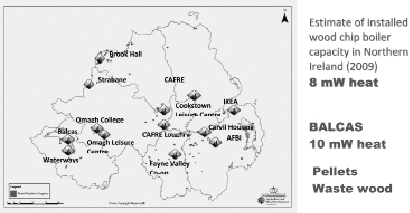
Thanks due to Rural Generation Ltd, Green Energy Ltd and others who supplied information on biomass installations in Northern Ireland
A list of those individuals/organisations that have received grants to develop an anaerobic digestion installation.
The Anaerobic Digester commissioned at Agri- Food Biosciences Institute, Hillsborough in 2008 received a grant from the Hain Fund 2006. The total amount of funding received by AFBI amounted to £4.2m, which covered the purchase and installation of an Anaerobic Digester and the building and establishment of the Renewable Energy Centre of Excellence at AFBI Hillsborough.
DARD have not provided funding for any Anaerobic Digesters to date, however out of 11 Letters of Offer made under the DARD Biomass Processing Challenge Fund, 4 were in respect of Anaerobic Digestion Projects. We have had one declaration of acceptance and are currently awaiting responses from the remaining 3 AD projects.
Response from Agriculture and Rural Development No.2
Jim McManus
Clerk to the Committee for
Enterprise, Trade and Investment
Room 424
Parliament Buildings
Stormont
Belfast
BT4 3XX
6 January 2011
Dear Jim
I refer to you letter of 16 December 2010, seeking DARD's views on a number of queries from the Committee for Enterprise, Trade and Investment in relation to their Inquiry into Barriers to the Development of Renewable Energy Production and its associated contribution to the Northern Ireland economy.
Our response is attached at Annex 1.
Please contact me should you have any further queries.
Yours sincerely,
Liam McKibben
Director of Fisheries and Climate Change Division
cc. Sohui Yim
David McKee
Michelle McDowell
Joe Cassels
Annex 1
Queries arising from DARD oral evidence to the Committee for Enterprise, Trade and Investment's inquiry into barriers to the development of renewable energy production and its associated contribution to the Northern Ireland economy.
Q1 Do officials see a role for DARD in supporting the development of a commercial market?
A1 DARD's policy is to assist the land based sector to maximise the benefits that exploiting the utilisation and production of renewable energy can offer. Key actions within the Department's 2010 renewable Energy Action Plan aim to encourage the land based sector to become active in commercial markets. As such therefore we see the DARD role as not being to directly support the development of a commercial market but rather to assist the land based sector to participate in that market.
Q2 Officials informed the Committee that incentives are provided to grow energy crops, particularly in relation to short-rotation coppice. The Committee would be grateful for full details of all incentives provided by DARD in relation to renewable energy.
A2 The following table details current and recent renewable energy incentives provided by the Department.
| Biomass Processing Challenge Fund (BPCF). | The BPCF aims to support the installation of biomass processing facilities to produce renewable energy on farms. It can provide capital grant support on eligible expenditure of up to 40% with a ceiling of €400,000 per project. The scheme is part financed by the European Regional Development Fund under the European Sustainable Competitiveness Programme for Northern Ireland. The Fund closed to new applications on 19 August 2010 and may re-open during 2011, subject to affordability considerations. Eleven offers of grant totalling almost £1.5m were made during the first tranche. |
| Short Rotation Coppice (SRC) Scheme. | The scheme aims to assist in developing the wider renewable energy market by increasing the amount of short rotation coppice grown for an energy use in Northern Ireland. The scheme is designed to contribute to the cost of establishing approved willow energy crops and can provide up to 50% of establishment costs (or up to 60% for young farmers) up to a maximum if £1000 per hectare |
| Farm Modernisation Programme (FMP). | The FMP aims to contribute to the competitiveness of agricultural and horticultural farm businesses in Northern Ireland. This will be achieved by providing financial support to existing farm businesses to improve the overall performance of their farm through modernisation under six key priority investment areas: Introduction of new technologies and innovation; Improved animal health and welfare; Increased hygiene control and product storage; Enhanced occupational safety and business efficiency; Increased energy efficiency; and Enhanced environmental status. Under 'Increased Energy Efficiency' tranche 2 of the FMP provided grant support for solar panel water heating systems up to a maximum of £1730. Tranche 2 of the FMP closed on the 26 November 2010. A third tranche is expected in 2011. |
DARD sponsor a programme of Renewable Energy Research which has been established at the Environmental Renewable Energy Centre at the Agri Food Bioscience Institute's (AFBI) Hillsborough site. The Department's College of Agriculture and Rural Enterprise deliver a programme of training and Knowledge Exchange on Renewable Energy in the land based sector.
Q3 Officials informed the Committee that DARD has strengthened its links with the NNFCC. The Committee would like to receive more details of this.
A3 As part of the ongoing implementation of the 2010 Renewable Energy Action Plan, DARD have forged links with the National Non Food Crops Centre (NNFCC). This includes working with the NNFCC to provide information specific to Northern Ireland agriculture on the Official Anaerobic Digestion Portal. The website acts as a gateway to a wide range of publically available information on anaerobic digestion from a wide range of sources. The portal can be viewed at www.biogas-info.co.uk .
Q4 The Committee would like to receive details of who will sit on the External Stakeholder Group to provide advice to the Department.
A4 Membership of the External Stakeholder Group has yet to be finalised. However, Ministerial approval has been agreed to approach 3 people with backgrounds in the land based sector, the renewable energy sector and from the business community from a selected list of knowledgeable and representative individual An informal approach will be made by officials, to confirm availability and willingness to participate. Once the individuals have confirmed agreement to participate we will provide further details to the Committee.
Q5 What level of anaerobic digestion will be required to enable Northern Ireland to fully meet its obligations under the Nitrates Directive in the long term?
A5 The total quantity of nitrogen that is in the input feedstock to an anaerobic digester is still in the output digestate. Therefore, the AD process has little direct impact on the 170kg total organic N/ha limit imposed by the Nitrates Directive. However, to ensure sustainability, AD must include management of the plant nutrients in digestate. This will involve ensuring that there are sufficient spread lands available for nutrient utilisation from digestate.
Please note that there are many positive advantages of AD that are not associated with the Nitrates Directive.
Response from Department for Employment and Learning No.1
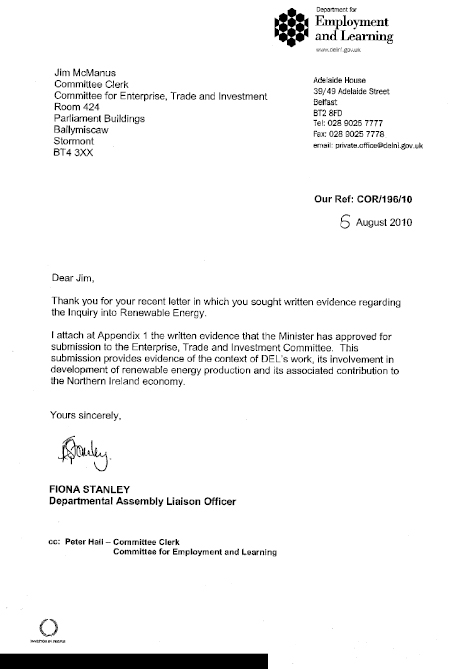
Response from DEL
Appendix 1
Enterprise, Trade and Investment Committee Inquiry into Renewable Energy
Evidence from the Department for Employment and Learning (DEL)
Contents
1. Summary of the Department's vision and values and key areas of activity
2. The context of the Department's work
3. The relevance of DEL work by business area to the development of renewable energy production and associated contribution to the Northern Ireland economy
Department for Employment and Learning (DEL)
1 Vision and Values
DEL's vision is: A dynamic, innovative and sustainable economy where everyone achieves their full potential.
DEL's aim is: To promote learning and skills, prepare people for work and to support the economy.
DEL's purpose is: To unlock the talent inherent in the people in our community and enable them to make the most of their potential.
By helping people to find work, upskilling the workforce, supporting employment rights, innovation and creativity and making education and training accessible, DEL can create the dynamic and innovative economy that lies at the heart of the aims of the Programme for Government.
The Department bases its work on a number of key values, which underpin the delivery of its commitments. The Department will seek to provide a professional and responsive service to its customers in an equitable way. It will strive to be innovative and dynamic and to improve continually as an organisation whilst motivating, developing and valuing its staff. Underpinning the work of the Department is its commitment to develop and manage a framework of employment rights, remedies and responsibilities to ensure that those in work are adequately protected.
Context
The Department's key areas of activity include:
- Enhancing the provision of learning and skills, including entrepreneurship, enterprise, management and leadership.
- Increasing the level of research and development, creativity and innovation in the Northern Ireland Economy.
- Helping individuals to acquire jobs, including self employment, and improving the linkages between employment programmes and skills development; an
- The development and maintenance of the framework of employment rights and responsibilities.
These areas of activity are relevant to the renewable energy sector as described below
3. DEL and Renewable Energy activity
3.1 Support for Skills Development in the Renewable Energy Sector
Skills are an essential element in the combination of actions required to improve productivity and enhance our economy. Renewable energy is increasingly considered to be an area which could contribute to economic growth. It is therefore important that the right skills are developed to support this growth.
3.2 Funding of Sector Skills Council (SSC) projects.
It is the role of SSCs to work with employers to identify current and future skills needs, and to develop training solutions to meet those needs. A number of SSCs (including Energy & Utility Skills, Summit Skills, Construction Skills working with Action Renewables) involved in renewable energy activities have already grouped together in a Cross Sector Renewables Group to identify the training needs that will help companies accelerate their growth in this emerging industry. Funding has been provided for a range of projects including: developing labour market intelligence in respect of wind energy; review of existing training material being used to deliver installer training for solar, wind, biomass and heat pumps; and the development of a qualification for architects, designers and specifiers of renewable energy technologies. As a result of the work of the group, both plumbing and electrical apprenticeship frameworks in Northern Ireland now incorporate renewable technologies.
3.3 Further Education
The Department does not provide direct or specific assistance to businesses in relation to renewable energy but Further Education (FE) Colleges offer a range of provision and support that may assist businesses in this area:
Further Education Courses
Further Education (FE) Colleges provide a range of courses in support of the green economy, and which may assist SMEs in developing renewable energy production/technologies, equipping them with the skills required. Courses cover topics such as solar energy, sustainable business practices, responsible sourcing of materials, biomass heating systems, and wind turbine specification and installation.
Carbon Zero NI
The Department has provided time -limited funding for the development of an FE Sector-wide approach to sustainability, led by South West College. The Carbon Zero NI project aims to:
- Position the NI FE Sector as an engine for the development of smart, innovative sustainable technologies in the areas of clean energy.
- Identify international market opportunities in the areas of sustainable development and clean energy and assist NI companies to exploit these opportunities.
- Develop a model of high impact 'clean and green' regional capacity building and business development programmes throughout the NI FE Sector.
InnoTech Centre
South West College's InnoTech Centre, is a business and mentoring support hub providing a range of services in sustainability, design, electronics and software. The overall aims of the InnoTech project are to:
- Broaden the international reach of the College through the development of new collaborative partnerships with the Institutes of Technology in Ireland and International Colleges, Research Institutes and Industry.
- Develop capacity within South West College to deliver high quality industrial knowledge transfer and technology development in partnership with local industry.
- Extend the capability and capacity of the College to deliver bespoke training and technical mentoring to industry in priority skills areas.
- Increase the number of students in South West College who are studying courses in the area of Science, Technology, Engineering and Mathematics through the design and development of innovative awareness raising activities aimed at schools.
In years 1 and 2 of the project (2008-2010), the InnoTech Centre provided support for a wide range of businesses involved in renewable energy, with a focus on providing bespoke support, including: advice on wind turbine systems; anaerobic digestion and heat exchanger design; and the development of a bioethanol fuel project.
Guidance to Colleges from the Department
The Department issued guidance to the FE Sector on promoting Sustainable Development in January 2009. This guidance encouraged FE Colleges to develop curricula that enabled students to develop the skills and knowledge which would contribute to sustainable development.
Colleges were required to put in place Sustainable Development Action Plans/Strategies in order to assess their current sustainable development status and establish ways to further improve performance in this area.
3.4 Higher Education
Funding to support renewable energy research projects in Northern Ireland universities fall within 4 broader funding streams:
Quality-related Research Funding
At the request of the Minister, the Department has directed some £2m (5%) of Quality-related Research (QR) funding to the local universities, in both the 2009/10 and 2010/11 academic years, to focus on new projects which encompass the theme of sustainability and align towards research which relates to alternative/renewable energy sources or green technology. QR funding, which is paid by way of block grant, is used to support the research infrastructure necessary for the Northern Ireland universities to conduct research.
Queen's University Belfast (QUB) has allocated the sum of £1.27m from this funding towards a project entitled "Clean Energies" where the research focuses on improving energy efficiency, the development of new, renewable, energy sources and integrating them within a more flexible and efficient power distribution system.
Strengthening the all-Island Research Base initiative
As part of its "Strengthening the all-Island Research Base" initiative, a programme aimed at developing and/or strengthening links with research groups in the Republic of Ireland through collaborative research which is socially and economically relevant to Northern Ireland and to the island as a whole, the Department is providing grant of £1.54m to the University of Ulster (UU), between 2008 and 2011, to support an "Energy Storage" project being undertaken in collaboration with University College Dublin, the National University of Ireland (Maynooth) and Dublin Institute of Technology. The project is concerned with demonstrating how energy storage can be incorporated within the built environment to reduce the use of fossil fuels.
Connected
The Department is also supporting the development of a number of strategically important "sector specific" projects from its "Connected" programme, an initiative which enables the HE and FE sectors to identify and meet, in a coordinated and holistic fashion, the knowledge transfer needs of businesses, in particular, and the wider community.
Two of these projects relate to the green economy arena: the Renewable Energies Foundation Degree programme at Belfast Metropolitan College (BMC) and UU, which aims to provide knowledge transfer and support to staff from BMC in the area of renewable energies; and the "Hydrogen Economy" programme, involving collaboration between UU and three regional colleges (South West, South Eastern and North West) in order to provide the latter with an opportunity to gain an insight into emerging technologies within the renewable energy sector.
Science Research Investment Fund
In addition, the Department has previously supported "green economy" research through its Science Research Investment Fund (SRIF) initiative, a funding stream set up to address a historic backlog of upgrading and updating of the physical university research infrastructure across the UK and to assist the Northern Ireland universities to operate on a sustainable basis.
As part of the funding available through Round 2 (2004-06) of this initiative, some £798k was allocated to QUB for the development of a Coastal Science & Engineering Centre to engage in research on wave energy and coastal engineering.
Current Position
The Department has recently decided to appoint a lead official to co-ordinate sustainable energy skills support activities, working with external bodies and key stakeholders. The first step in this process will be to commission a focused skills study on sustainable energy, assessing current provision, identifying gaps in provision and highlighting best practice in other regions / countries.
3.5. DEL's Commitment
The Committee will wish to be aware that the Department for Employment and Learning is fully committed, within the context of its core business, to support renewable energy through our support for skills development, education and research.
Response from Department of Employment and Learning No.2

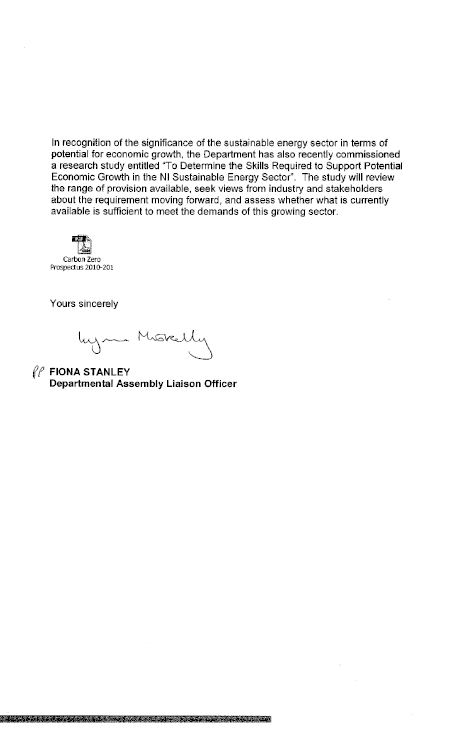
Letter from Minister re Sustainable Energy Communication in NI
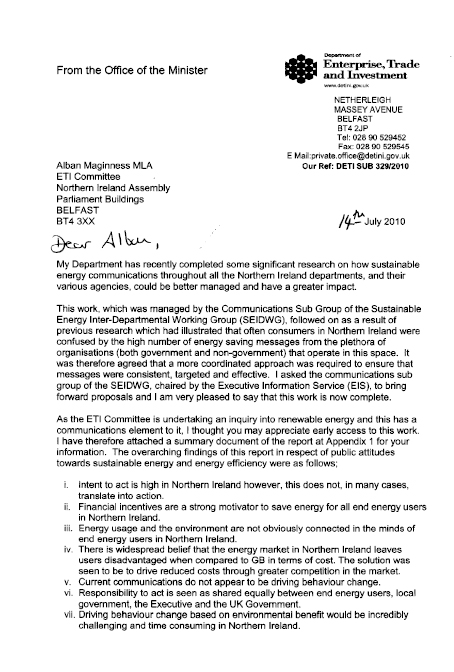
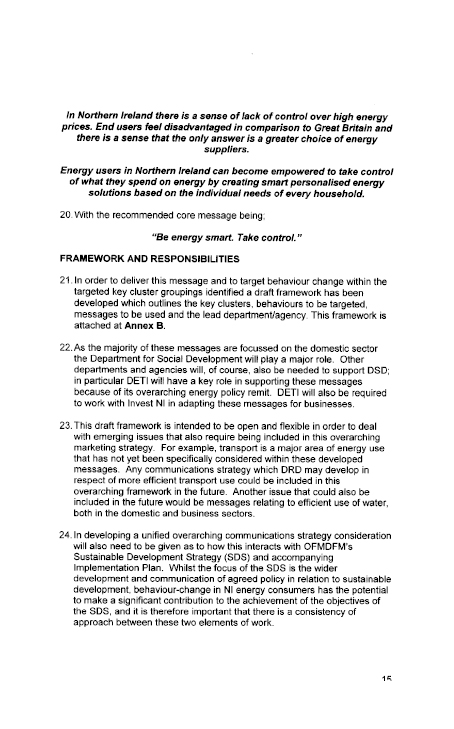
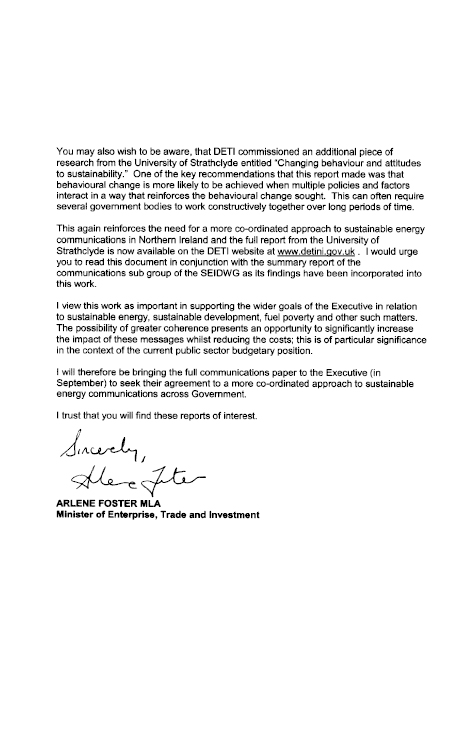
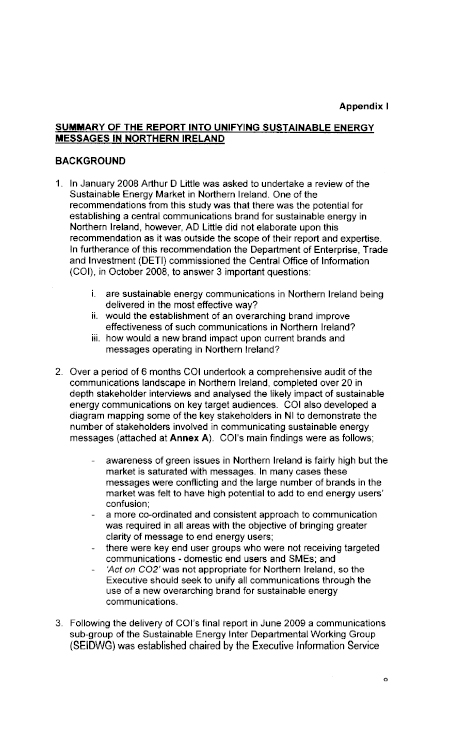
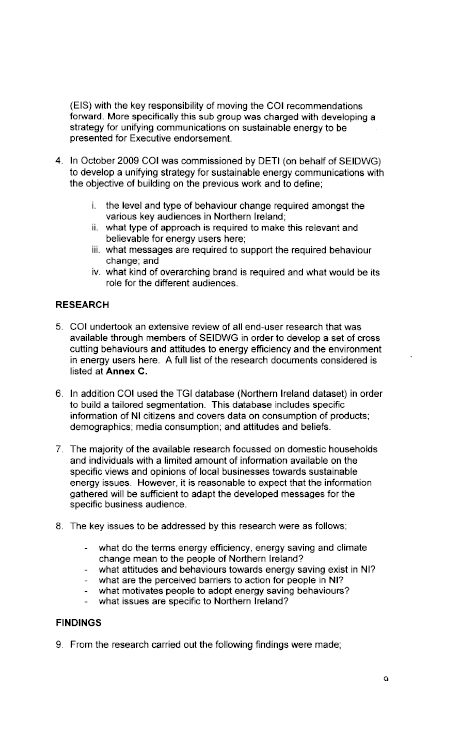
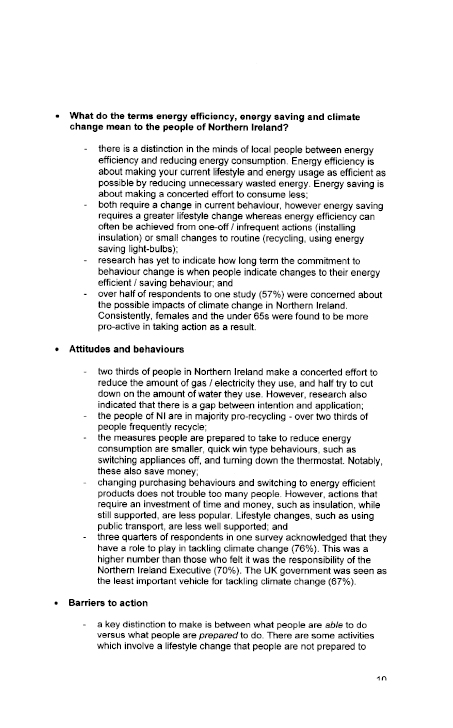
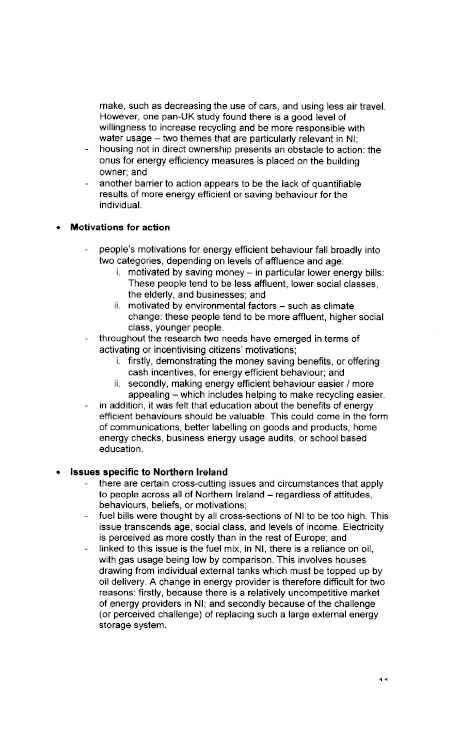
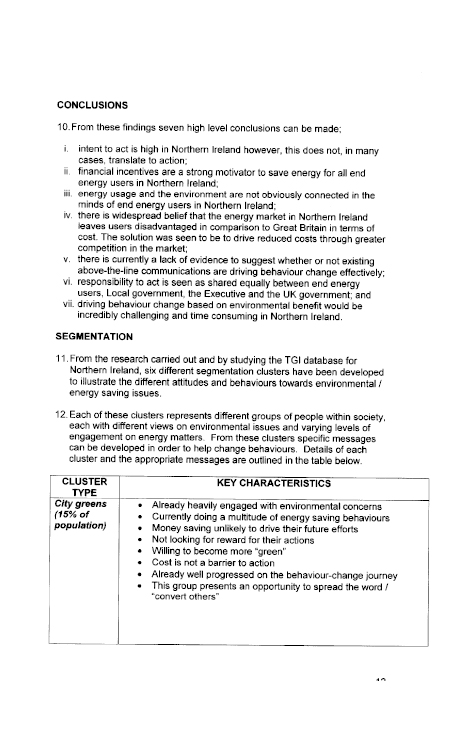
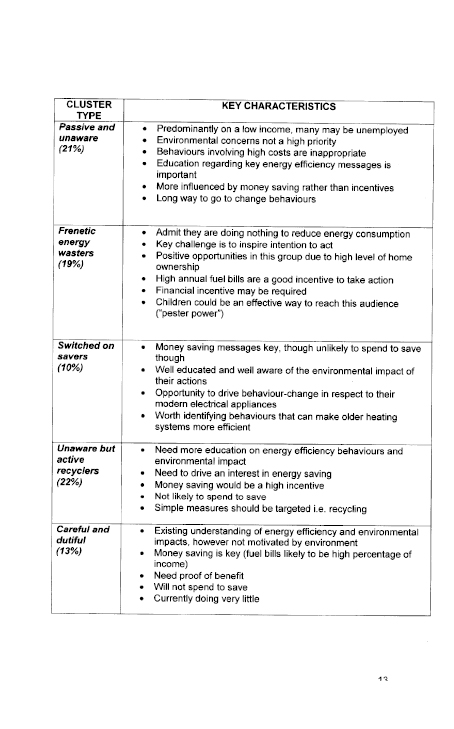
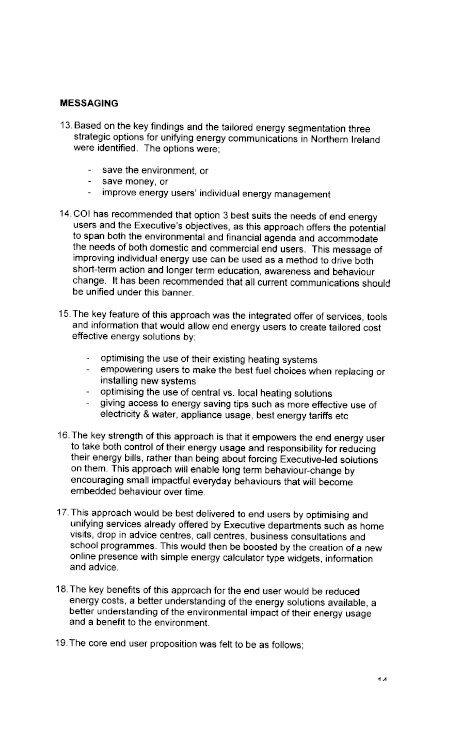
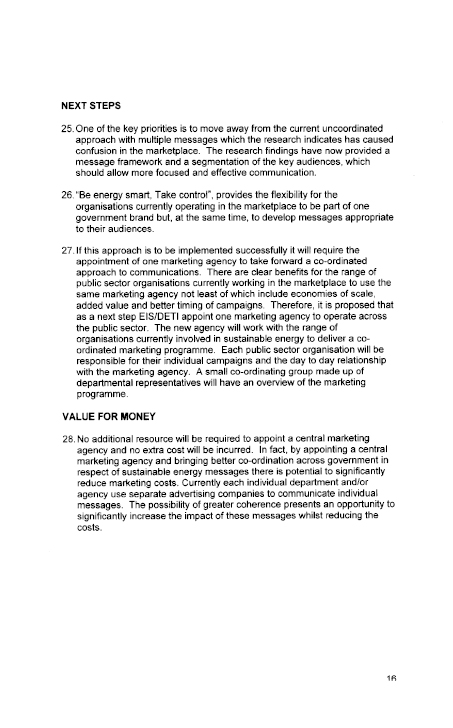
Annex A
Diagram mapping some of the key stakeholders involved in communication in NI
Annex B
Draft Communications Framework
| Cluster | Target Behaviour | Direction for key message | Tools to use (existing and new) | targeted messages |
Likely lead Department |
| City Greens (15% of population) |
Spreading the word about taking positive action | Help your friends and family to take control of their energy usage | Internet site | "Smart energy use saves the environment and saves you, your friends and your family money." | DSD and DETI |
| Passive and unaware (21%) |
Learning to use what they have better rather than "switching off and freezing" | Smart energy use can save you money | Home visits, call centres, drop in centres | "Take control of your boiler. Turn it down not off. That's saving you money and being energy smart." "Take control of your heating. If you're out, turn if off. That's saving you money and being energy smart." | NI Housing Executive |
| Frenetic energy wasters (19%) |
Getting children to help engage parents in energy saving activities/ engaging the family unit in undertaking energy saving activities together. | Encouraging families to engage in energy saving behaviours together | Schools programmes, internet site | "Energy smart families take control together. The less energy you use the more money you save." | DSD and DETI |
| Switched on savers (10%) |
Action to reduce energy wastage from modern appliances | New technology can be a wasteful as traditional appliances | Internet site | "Take control of the hidden costs of new technology. If the red light is on – it's costing you money." | DSD and DETI |
| Unaware but active recyclers (22%) |
Learning how to maximise usage of central and local heating solutions | Need to create a mental link between saving money and energy use in order to drive behaviour change | Call centres and drop in centres | "Taking control of all the energy you use in your home can save you money. That's being energy smart." | DSD |
| Careful and dutiful (13%) |
Learning to use what they have better rather than "switching off and freezing" | Informing this cluster that there are choices beyond on and off; smart choices | Call centres and drop in centres | "Take control. Find the best heating solutions for your budget and your health. Be energy smart." | DSD |
Annex C
Research Sources
COI research was gathered from the following sources:
- TGI Data, Northern Ireland, 2009
- TGI Data, Great Britain, 2009
- The Consumer Council – Fuel Usage Survey, Millward Brown Ulster, 2009
- Attitudes to Energy Efficiency Survey 2006 - RPS Consulting Engineers for NIHE Housing Executive, 2007
- Attitudes to Renewable Energy – Northern Ireland COI, 2003
- Sustainable energy communications in Northern Ireland, 2009
- Findings of attitudes to sustainable energy workshop for Northern Ireland: Draft. University of Strathclyde
- A Framework For Pro-Environmental Behaviours: DEFRA, 2008
- WRAP Consumer Behaviour Change Key Findings, Ipsos MORI, 2010
- The Carbon Trust support for SMEs: Your partner in the low-carbon world
- Effectiveness of Energy Performance Certificates in Belfast, Northern Ireland: Msc Thesis, Michelle McAteer, 2009
- Public perceptions on climate change in NI – Omnibus Survey 2009
- Valuing Our Environment – The Economic Impact of the Environment in Northern Ireland
Other sources were reviewed but information was not extracted for analysis at this stage due to lack of relevance to the research objectives.
Onshore Renewables - SEA Scoping Report
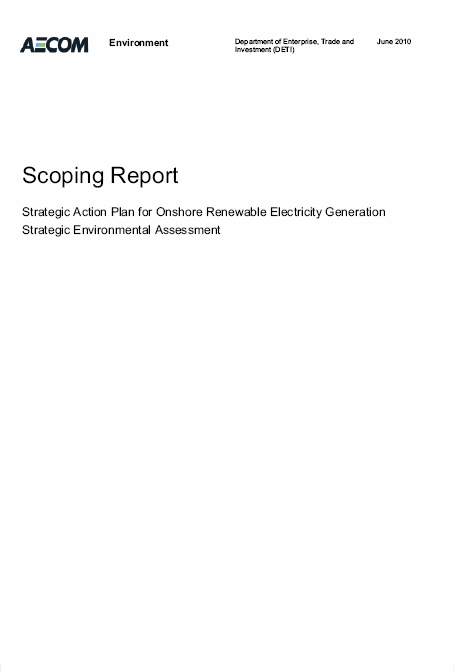
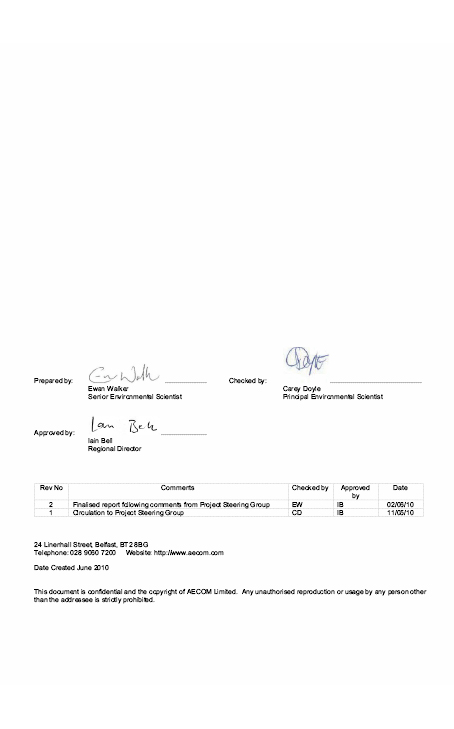
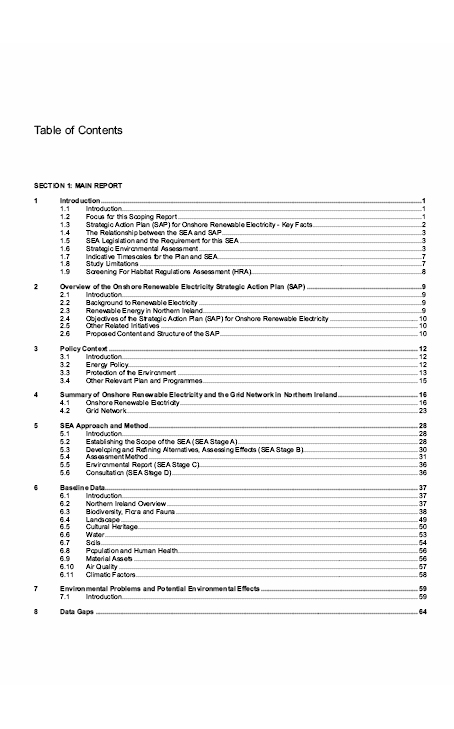
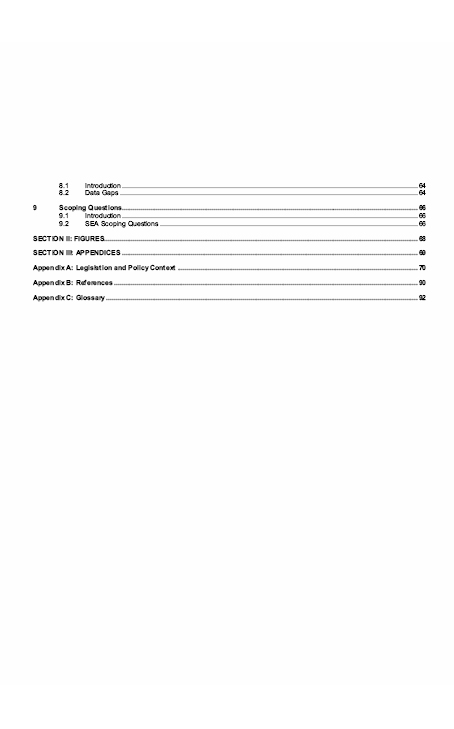

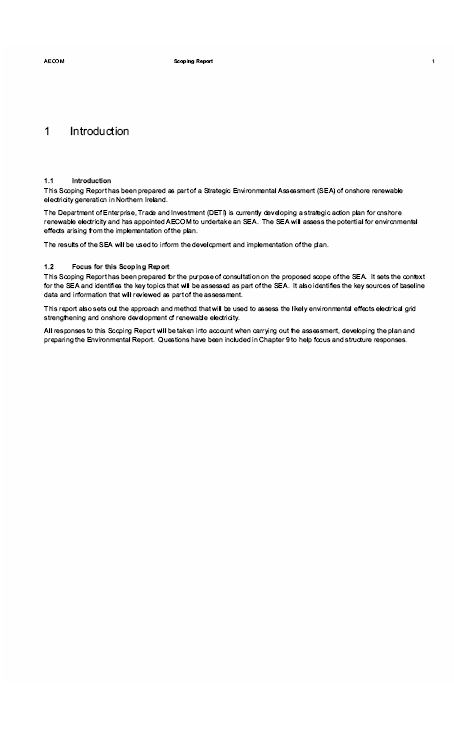
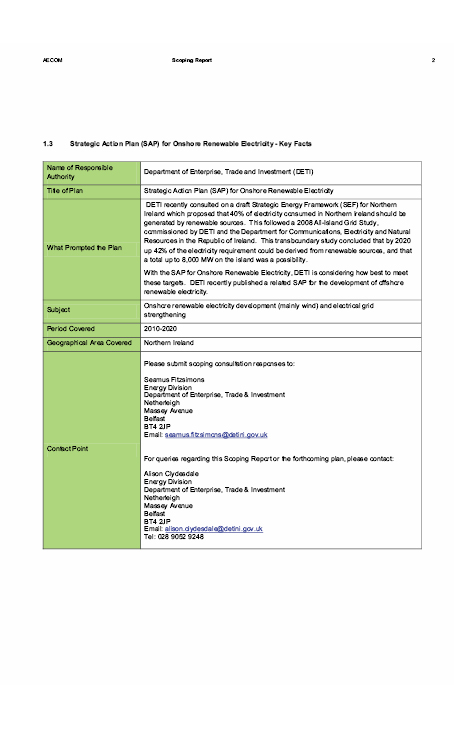
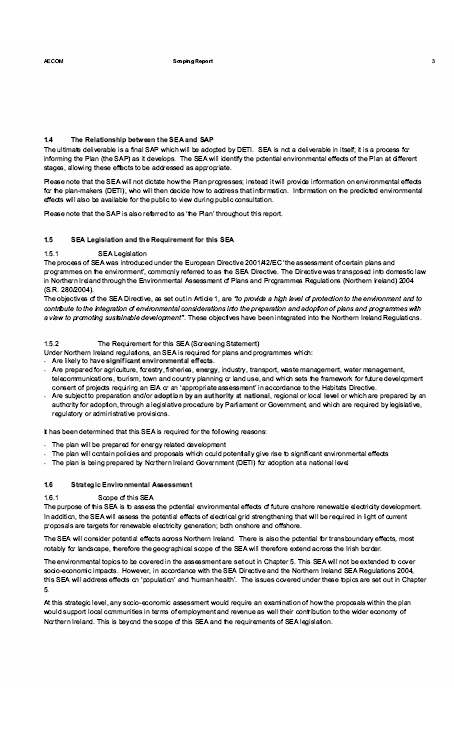
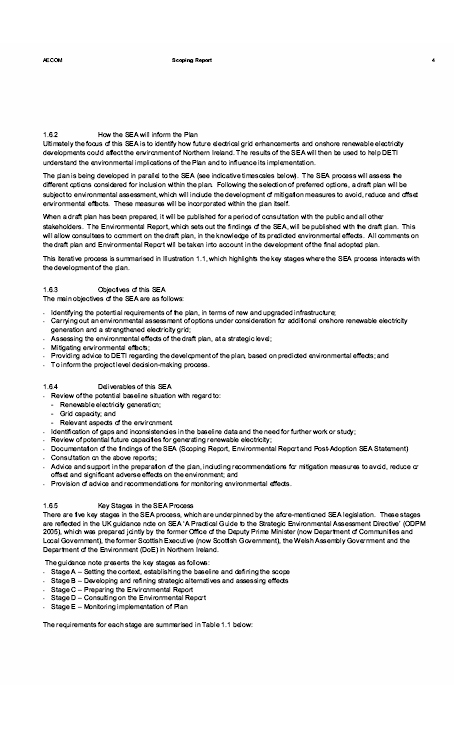
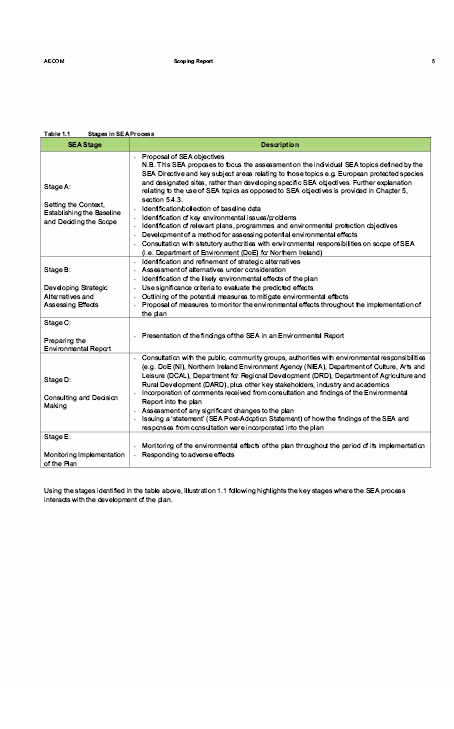
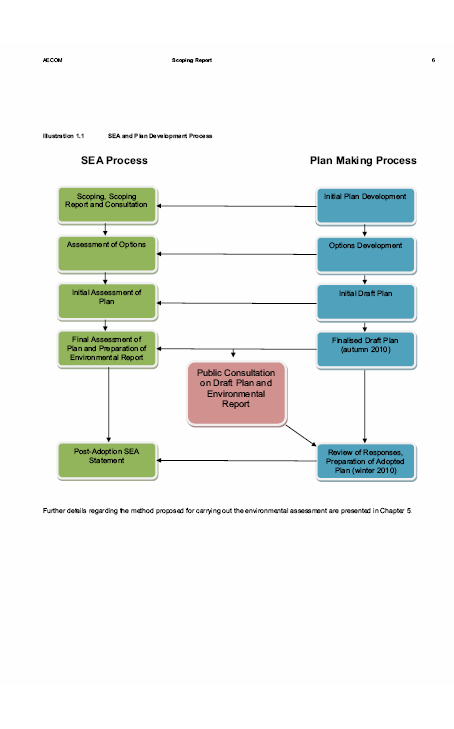
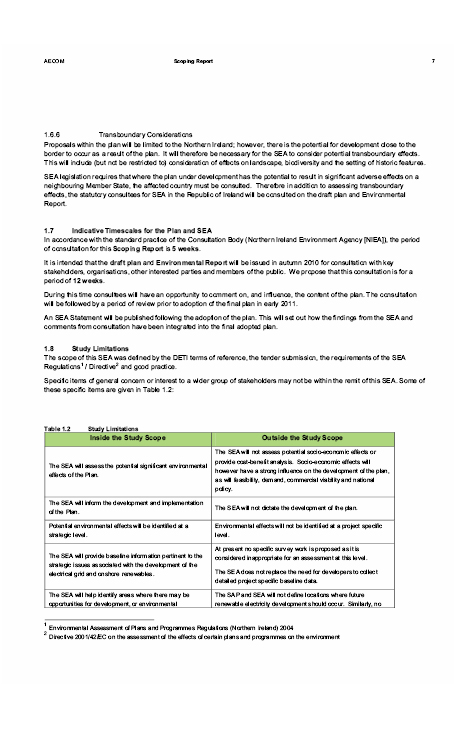
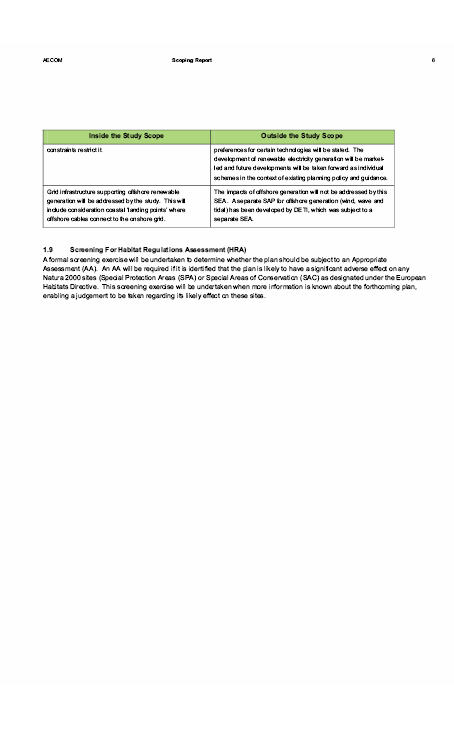
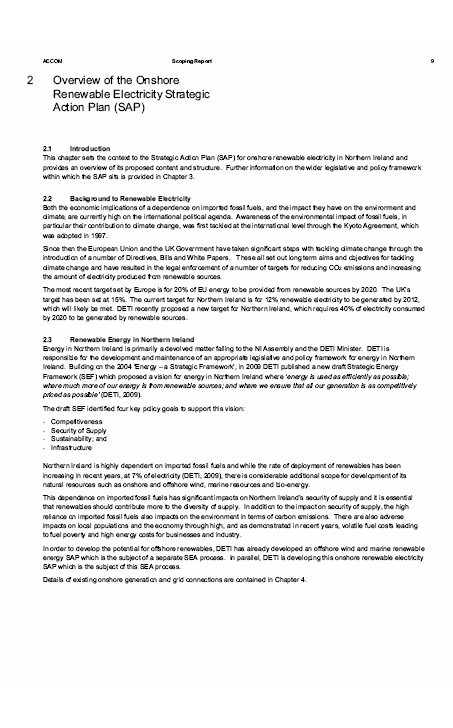
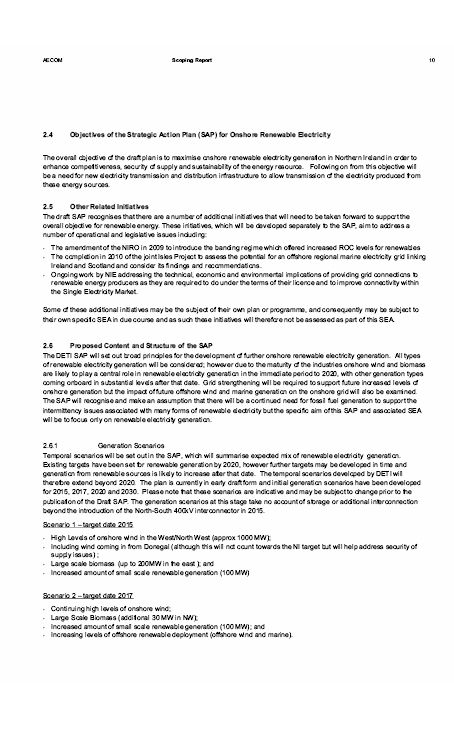
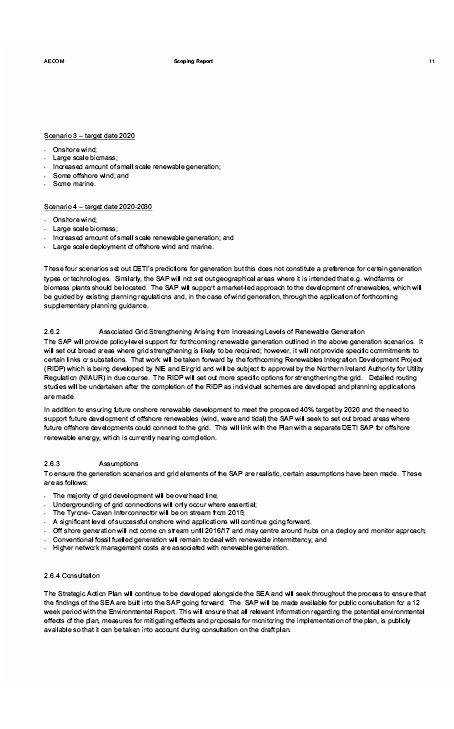
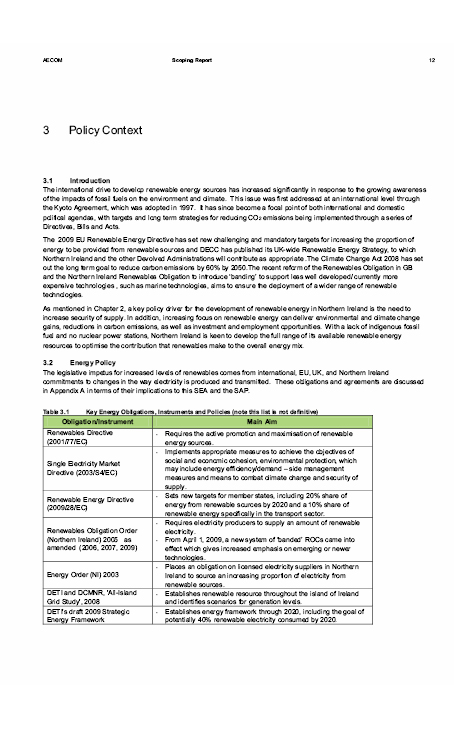
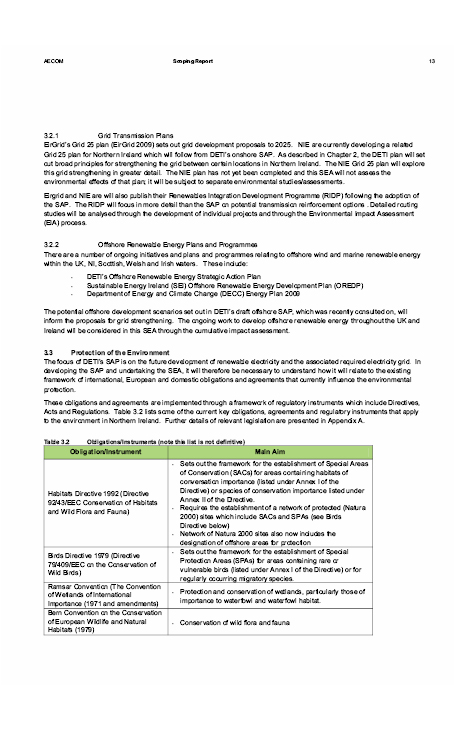
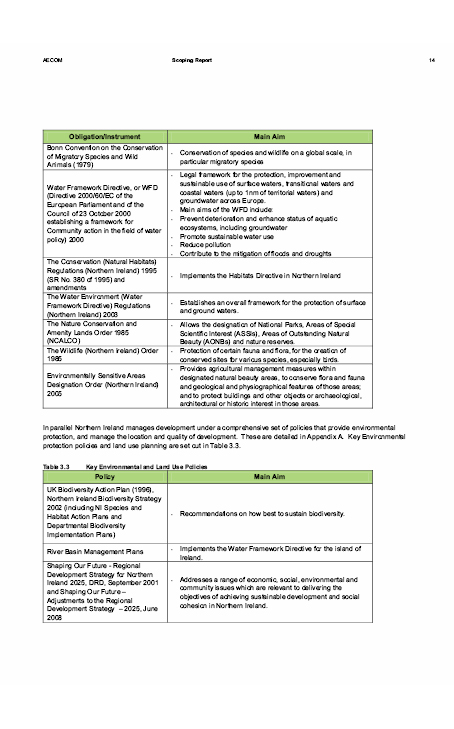

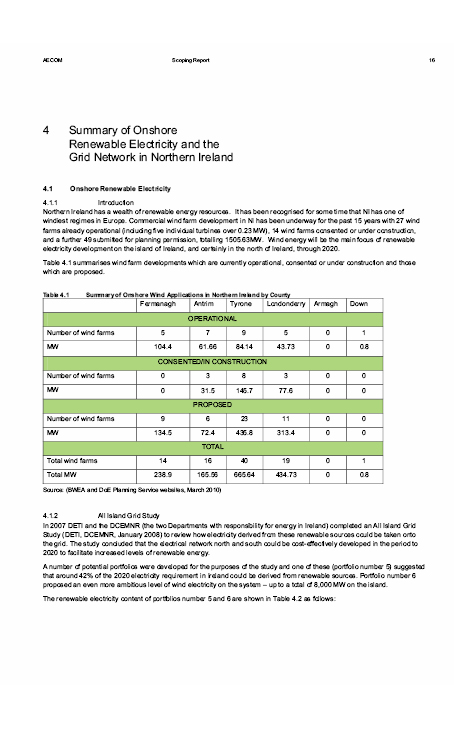
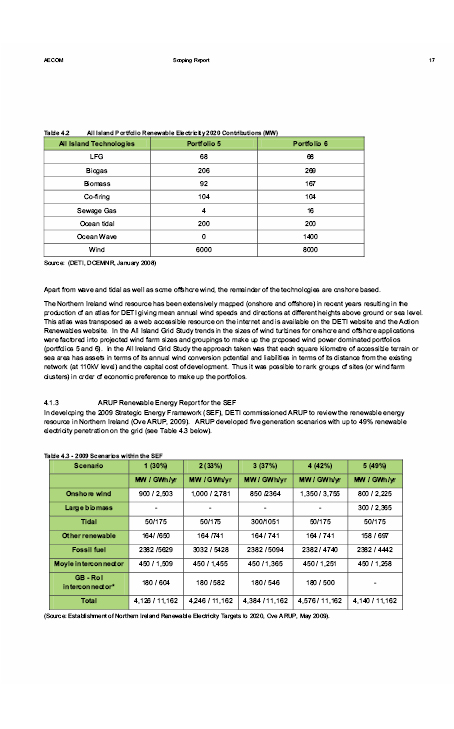
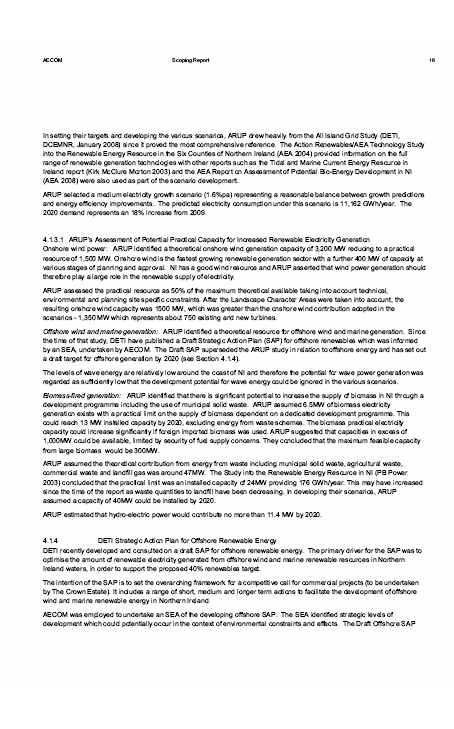
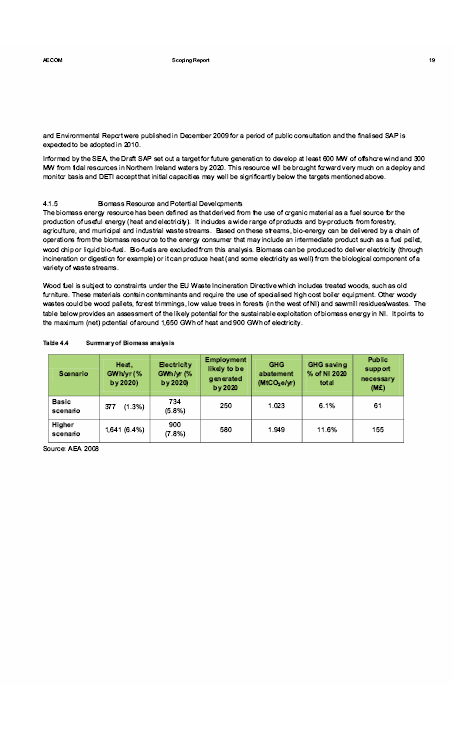
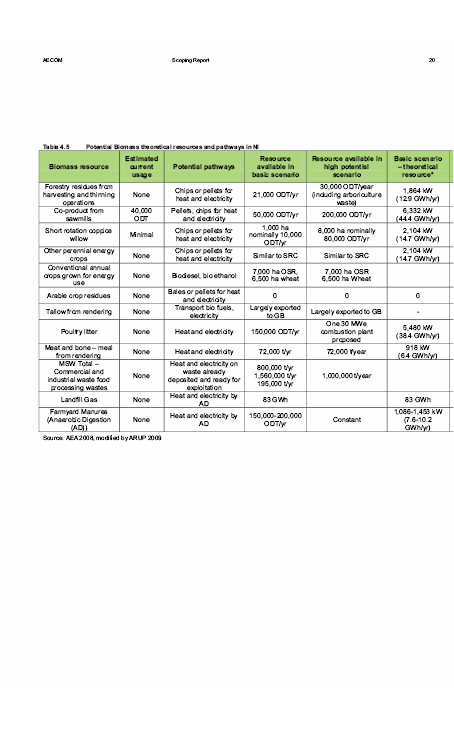
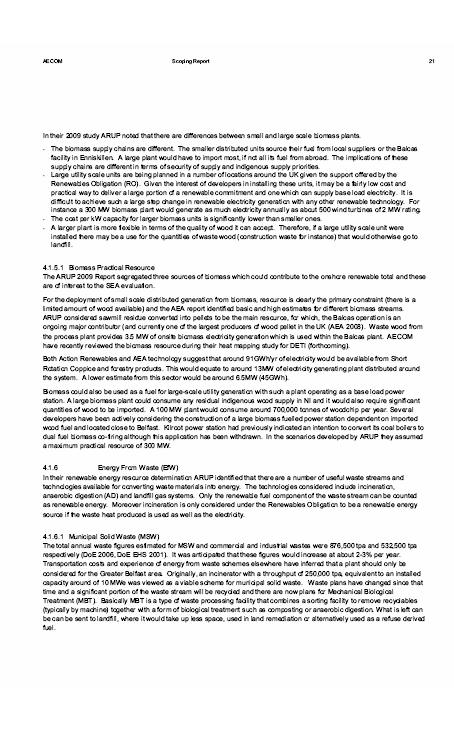
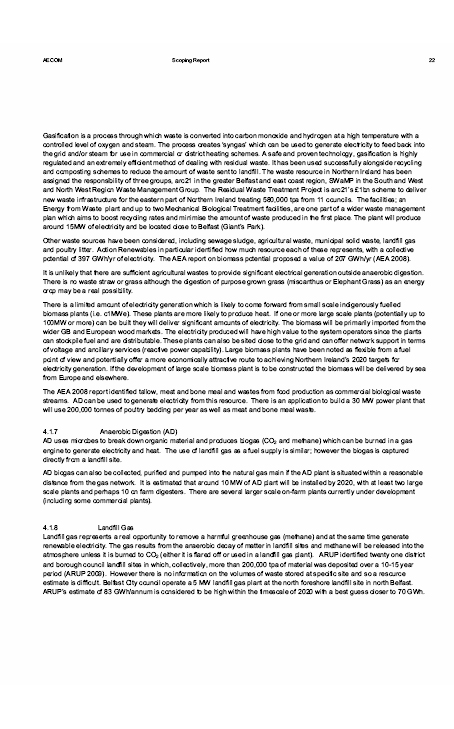
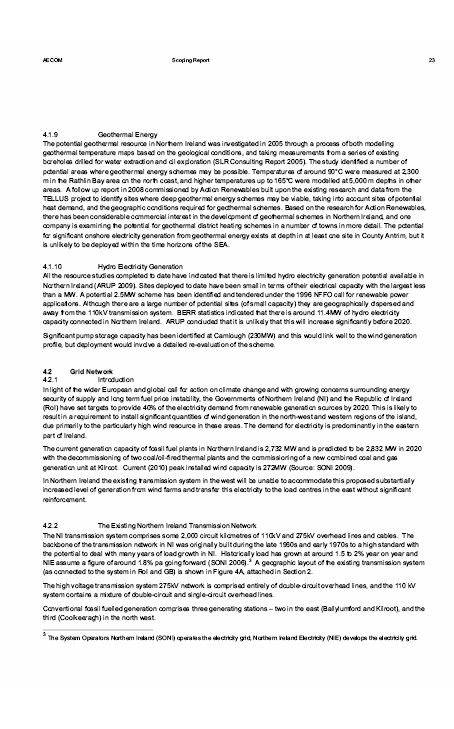
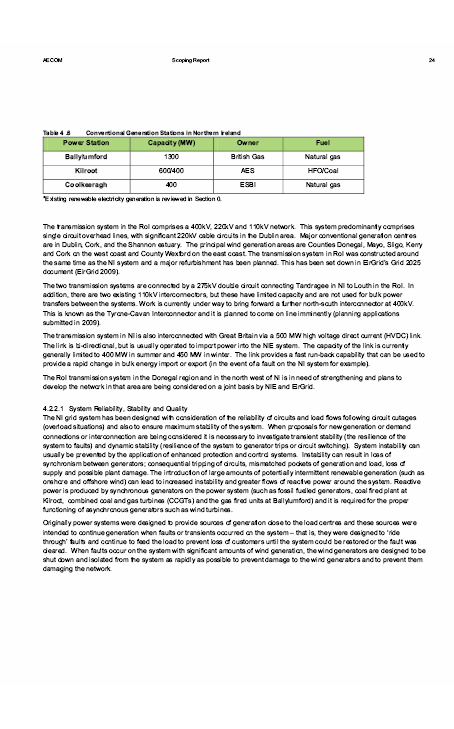
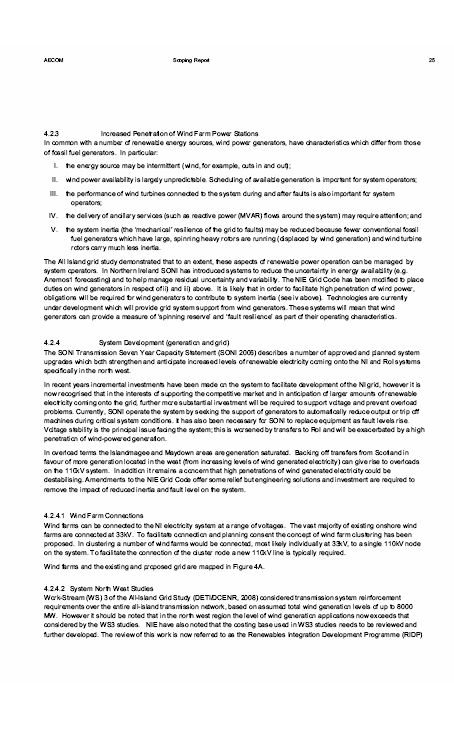
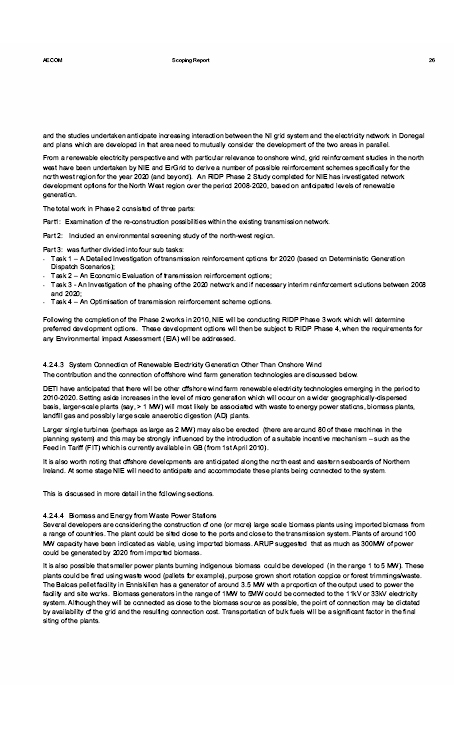
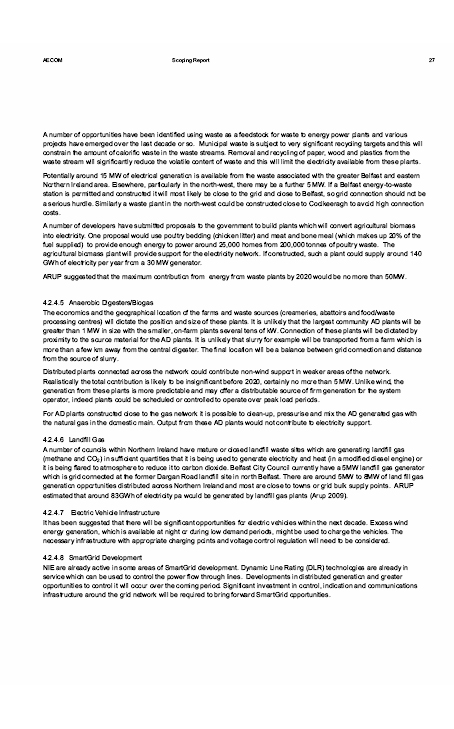
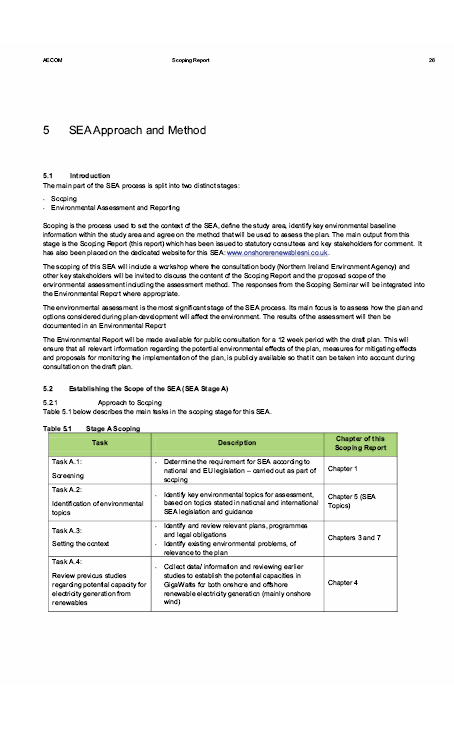
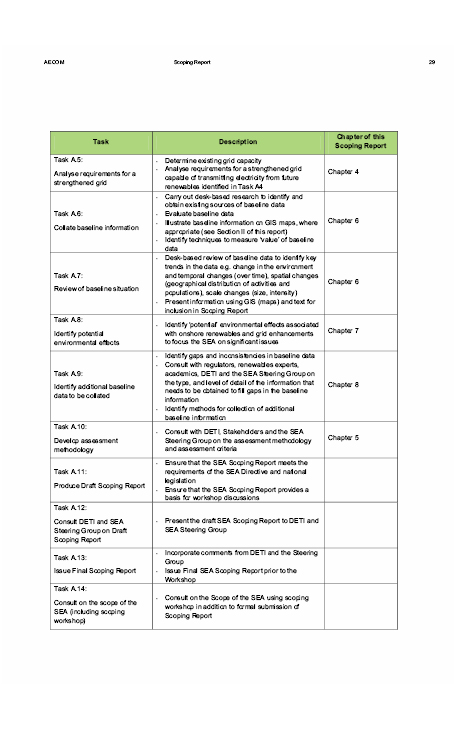
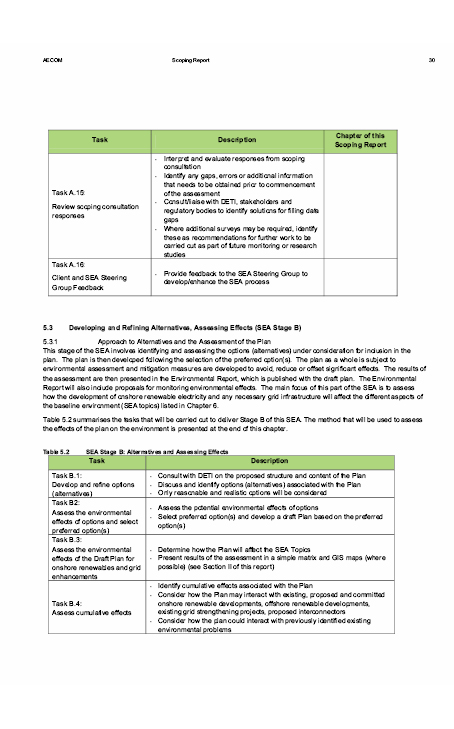
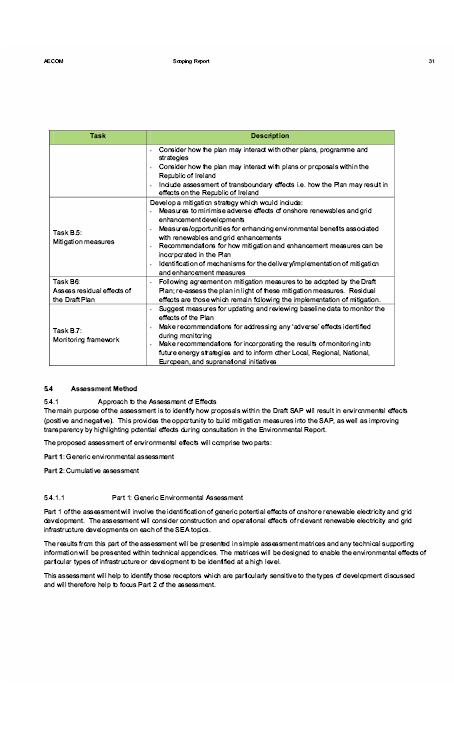
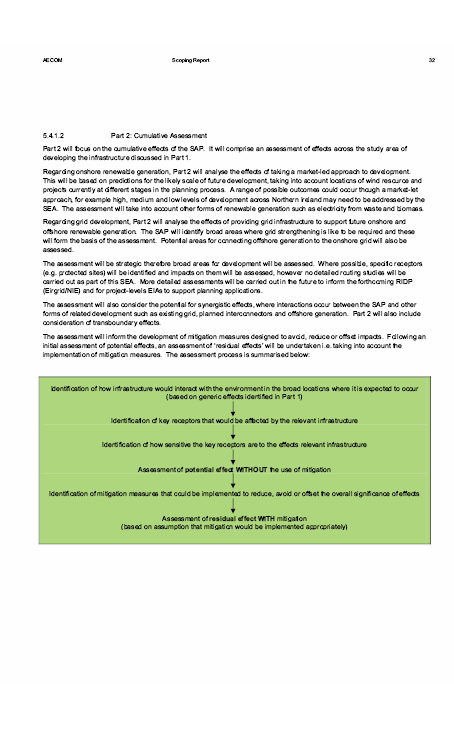
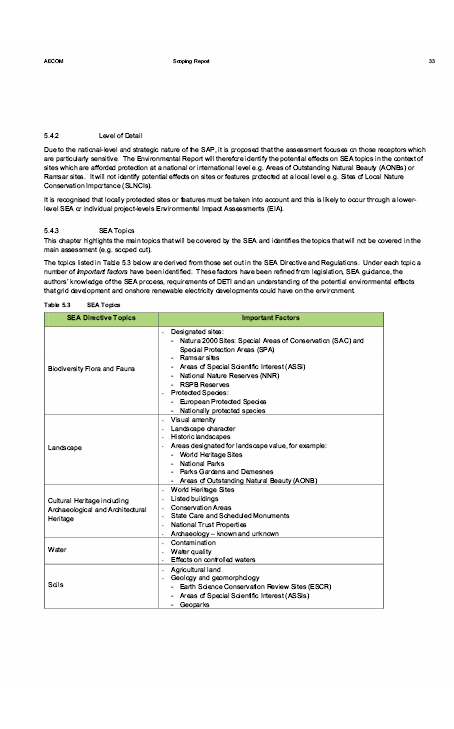
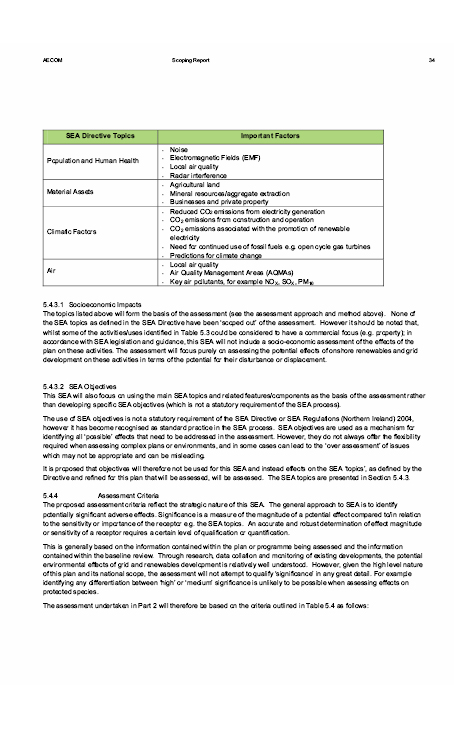
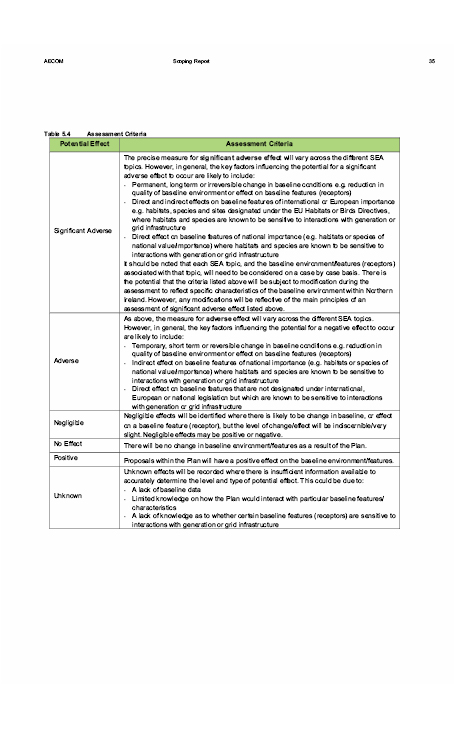
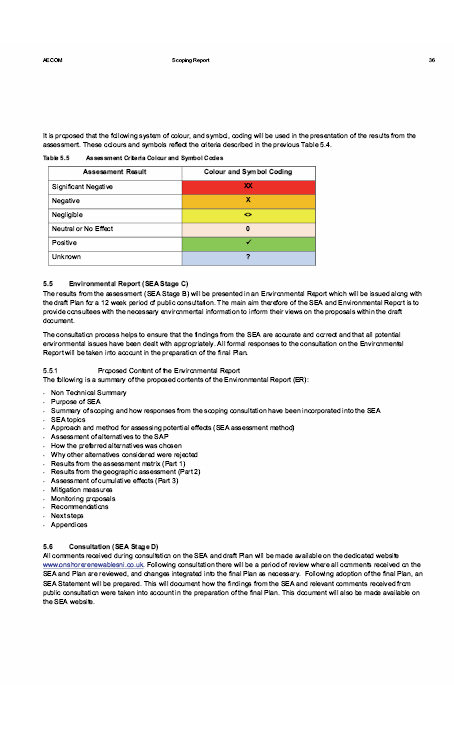
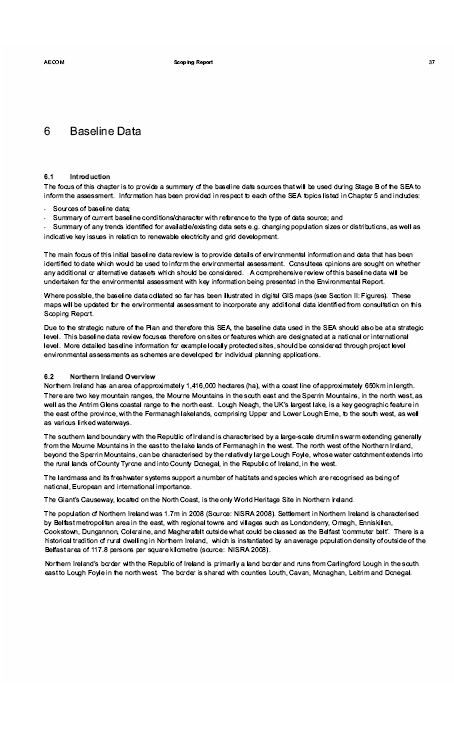
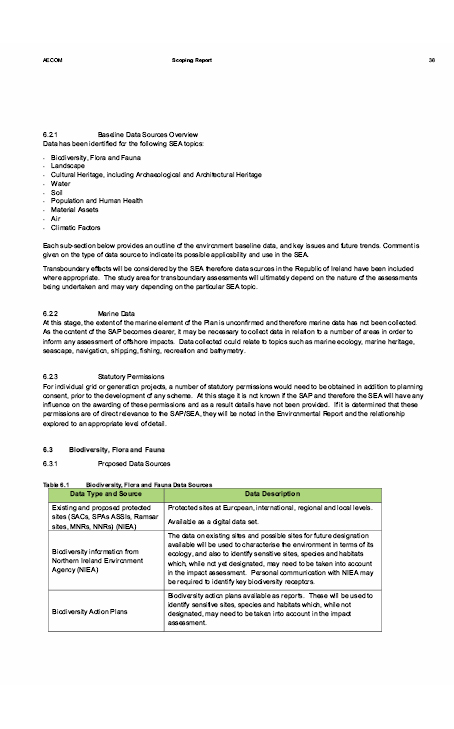
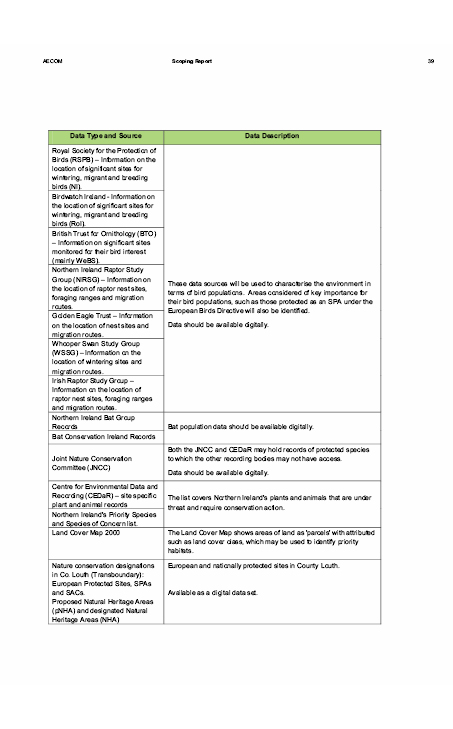
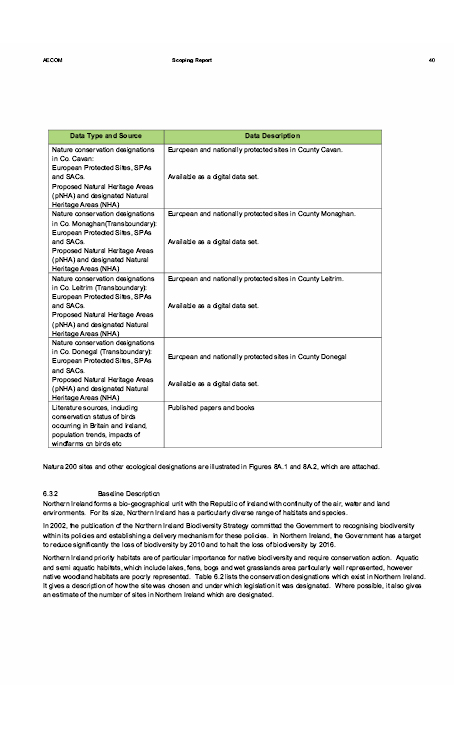
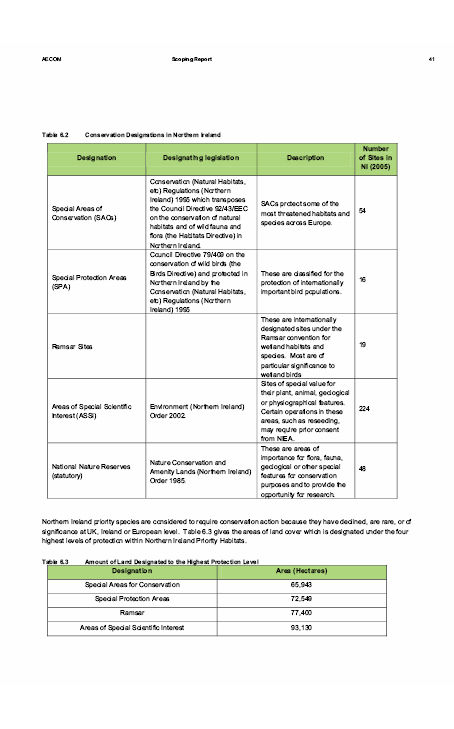
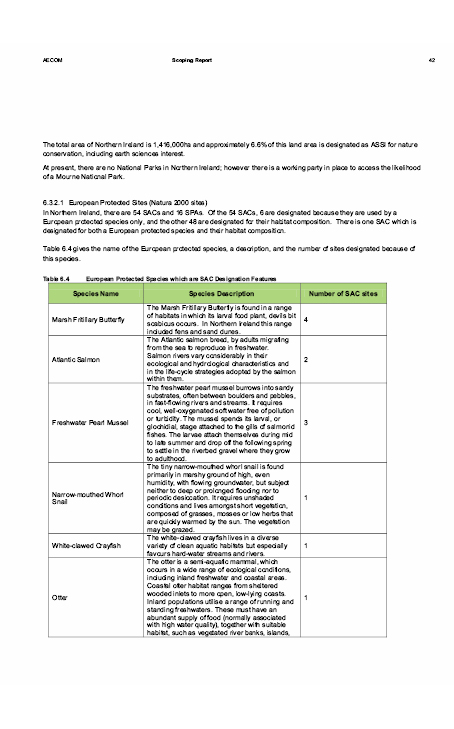
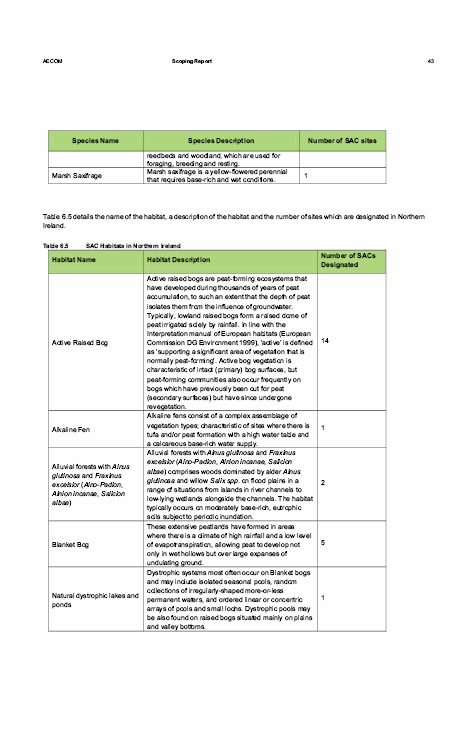
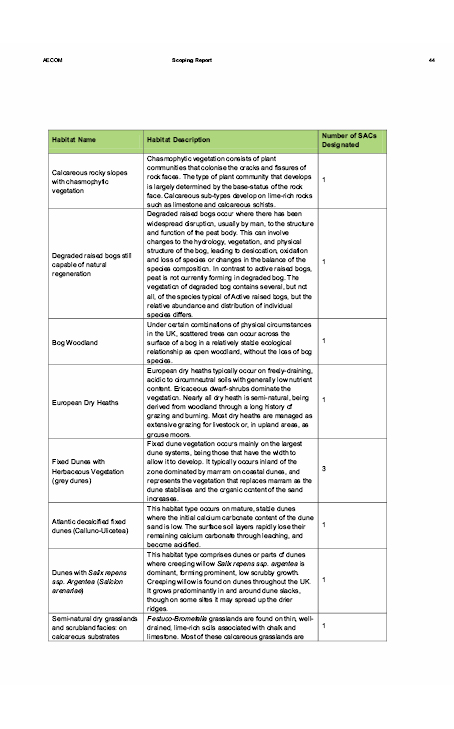
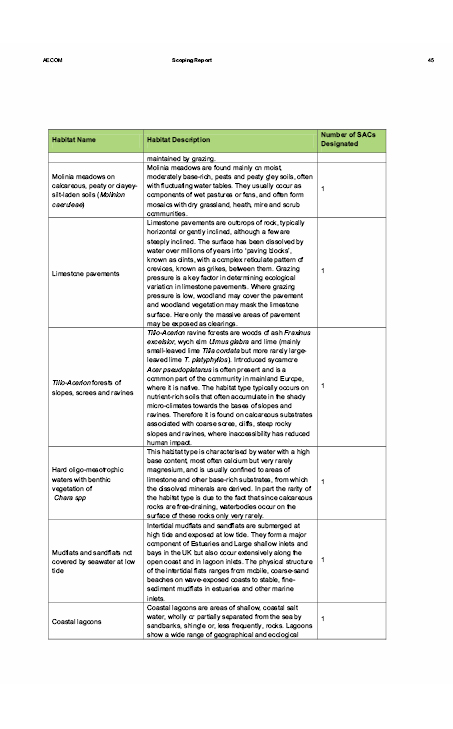
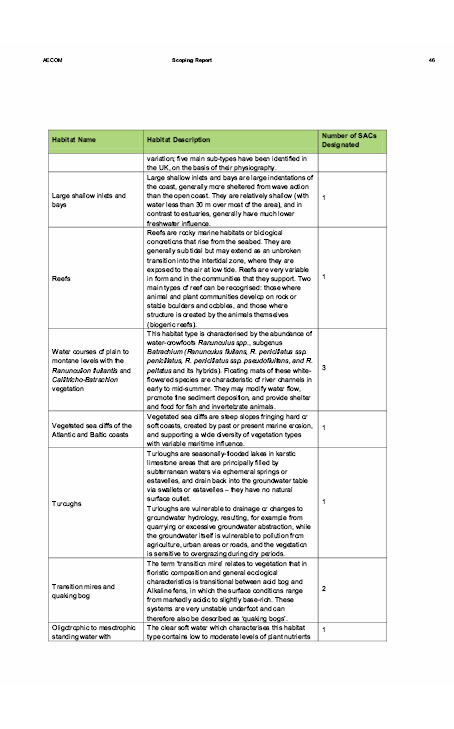
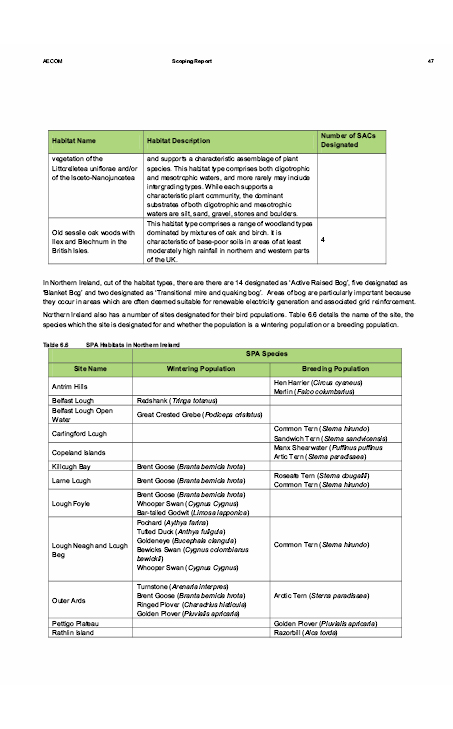
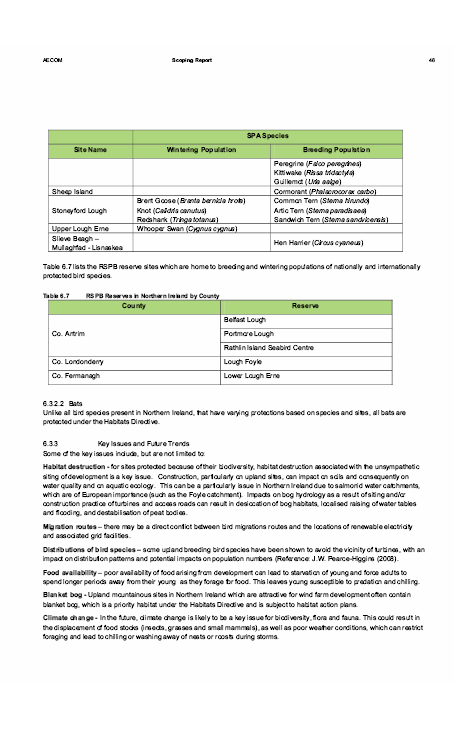
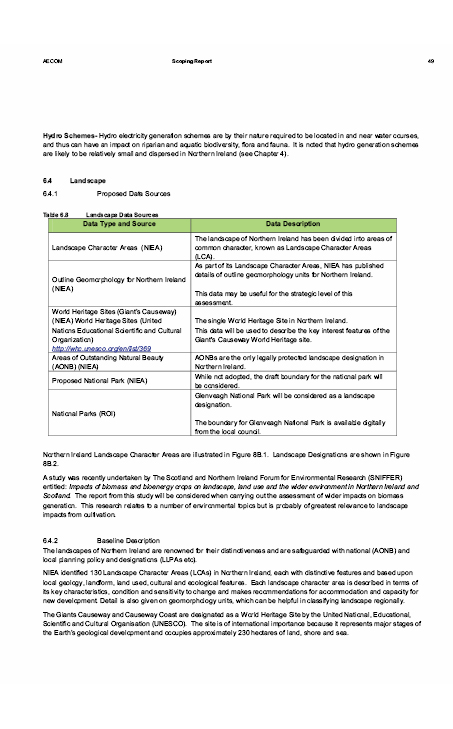
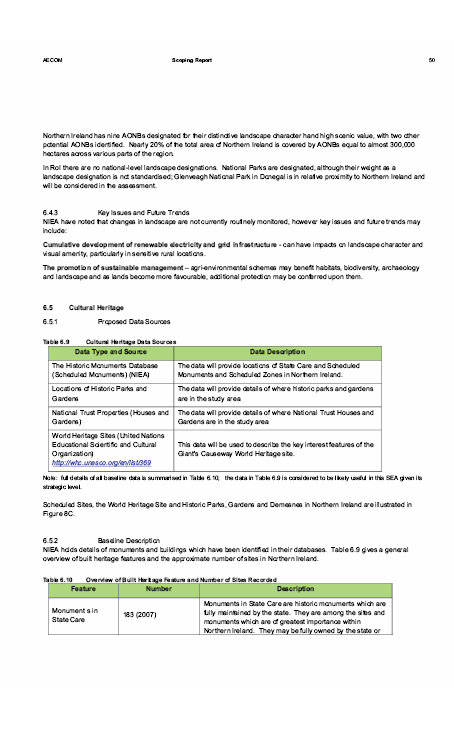
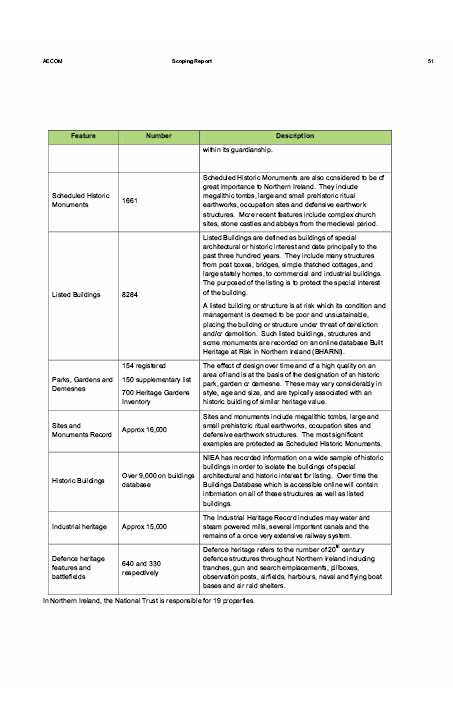
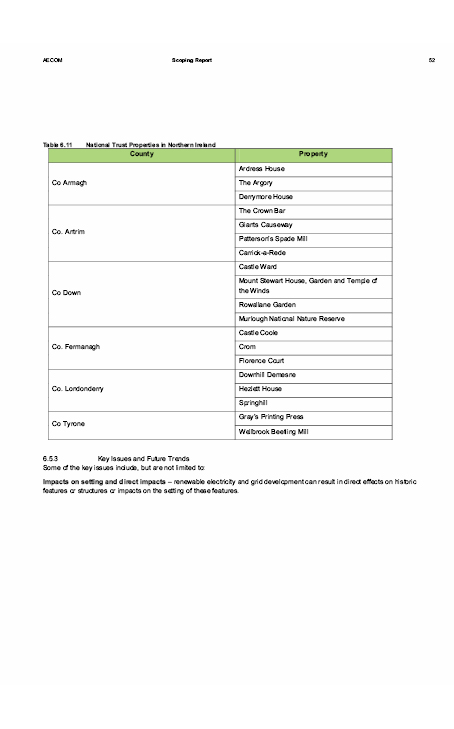
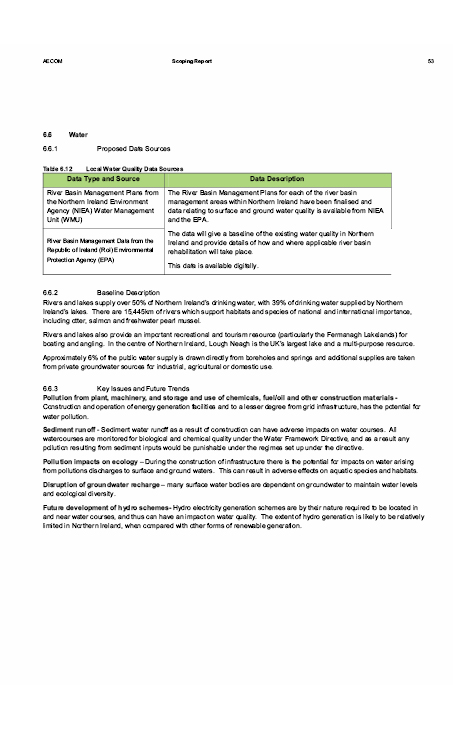
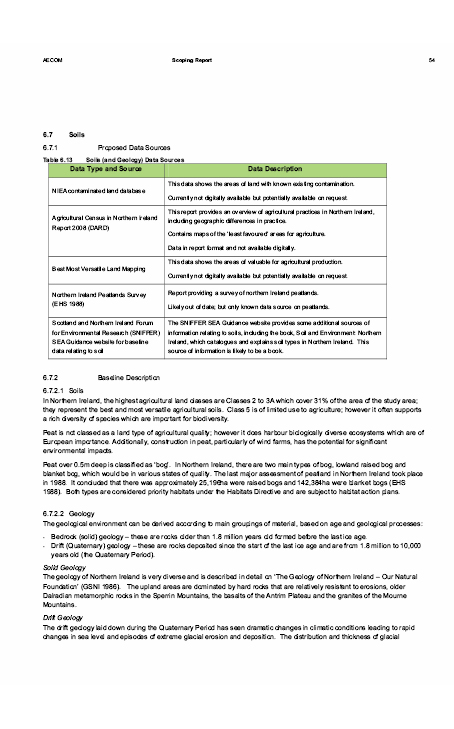
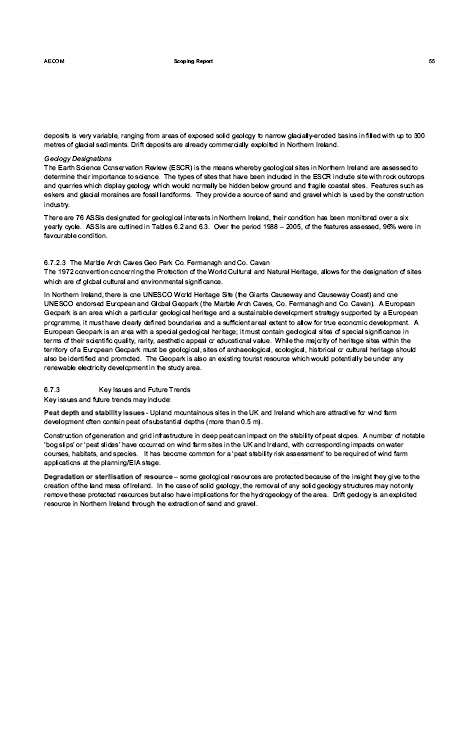
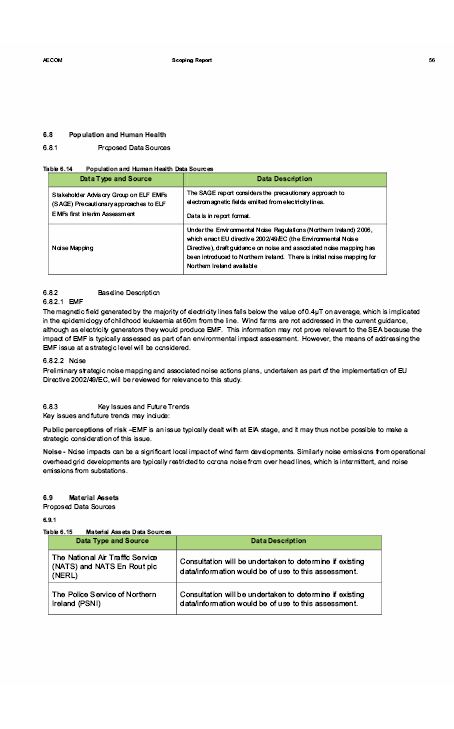
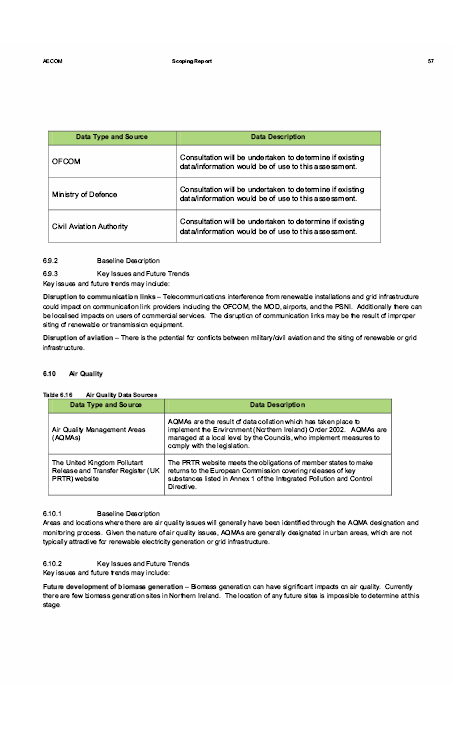
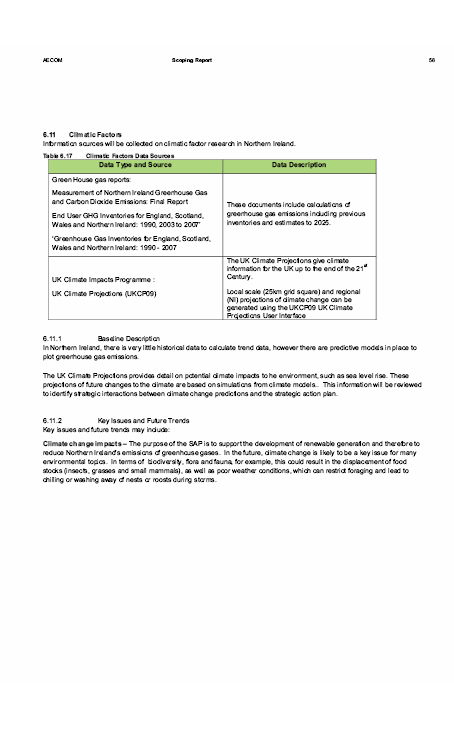
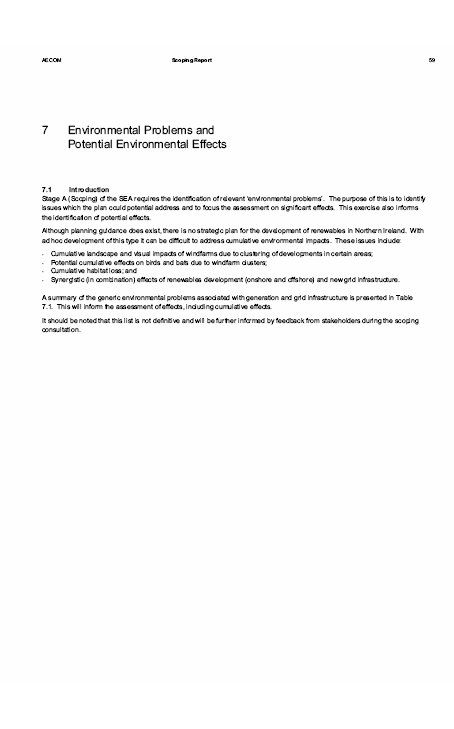
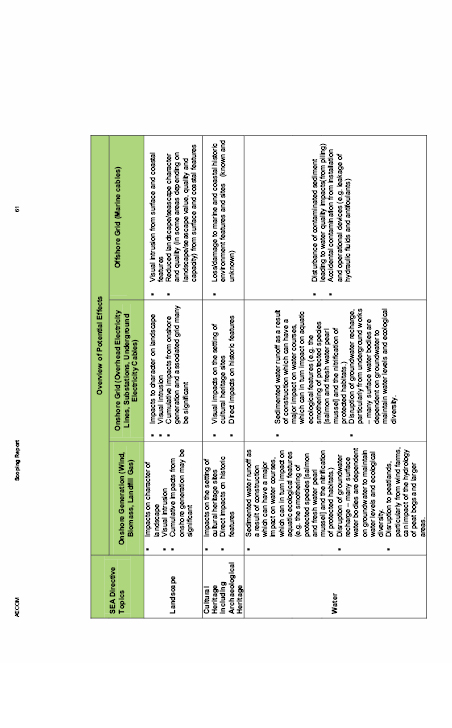
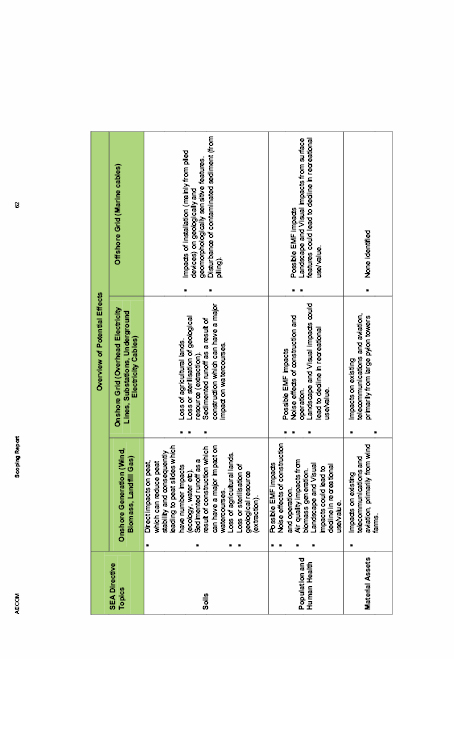
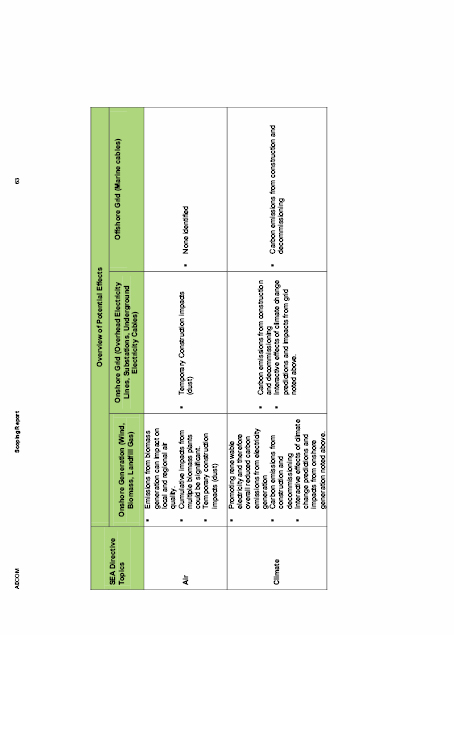
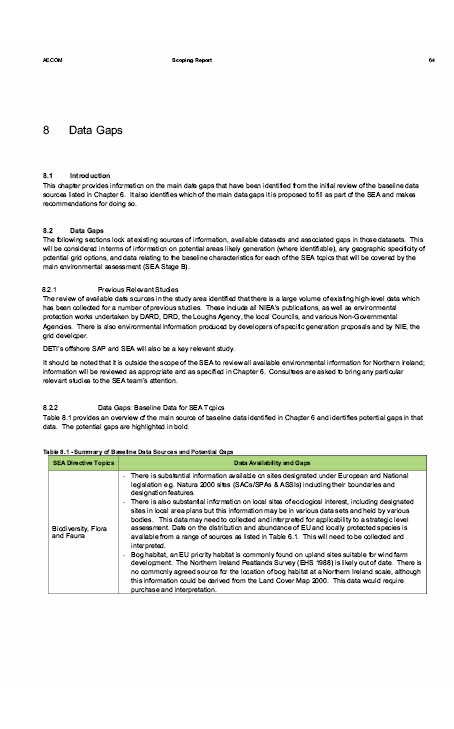
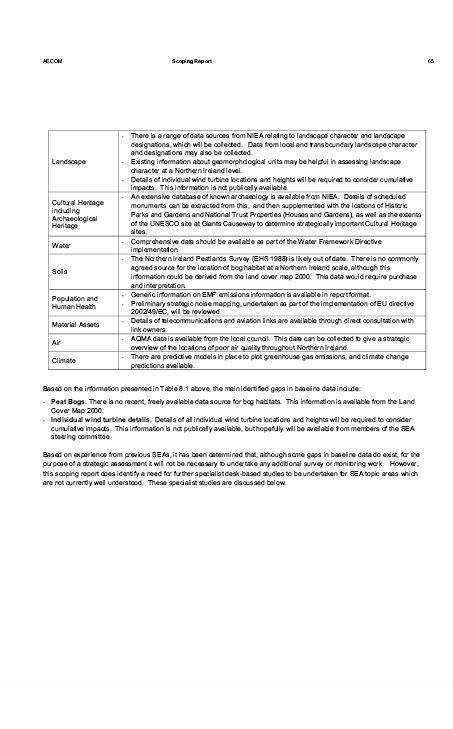
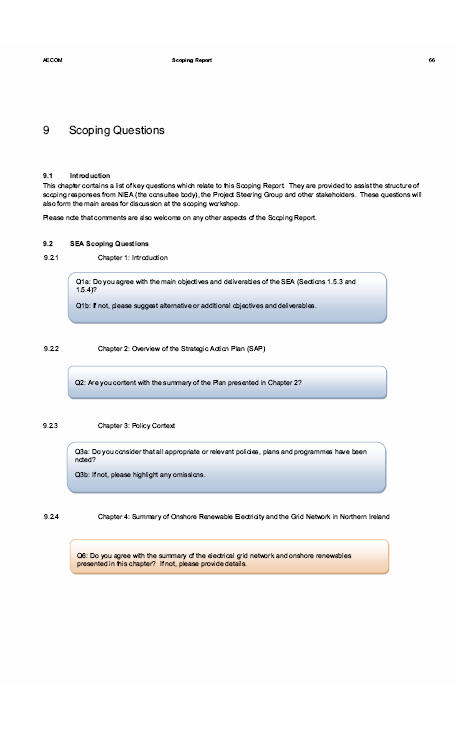


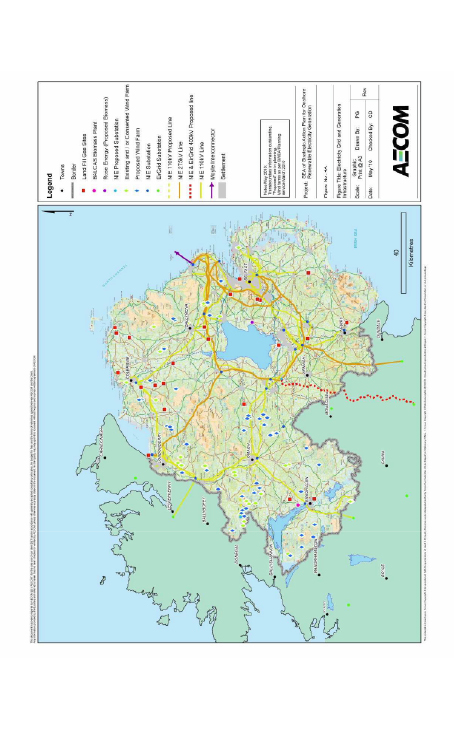
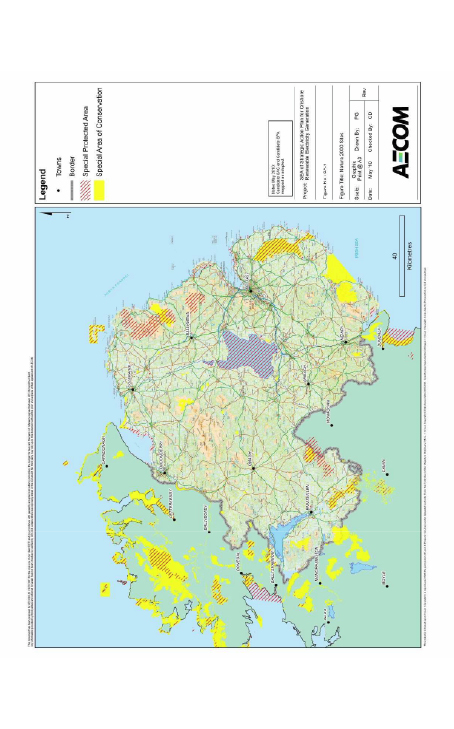
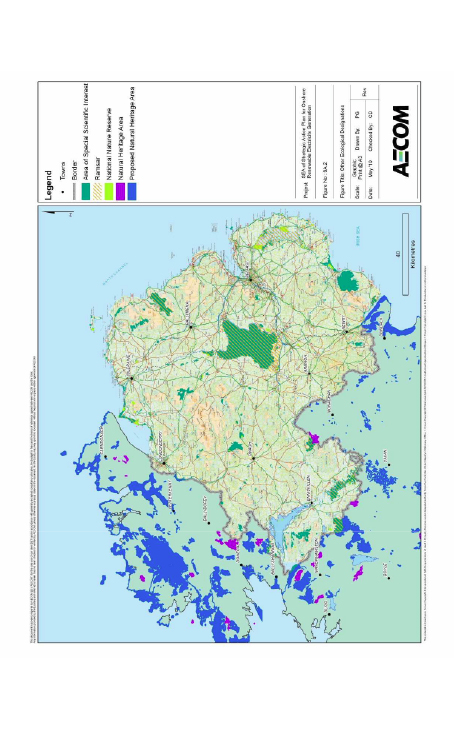
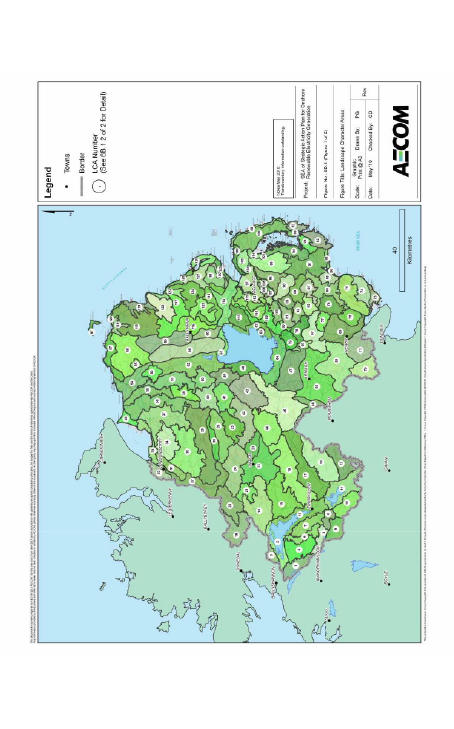
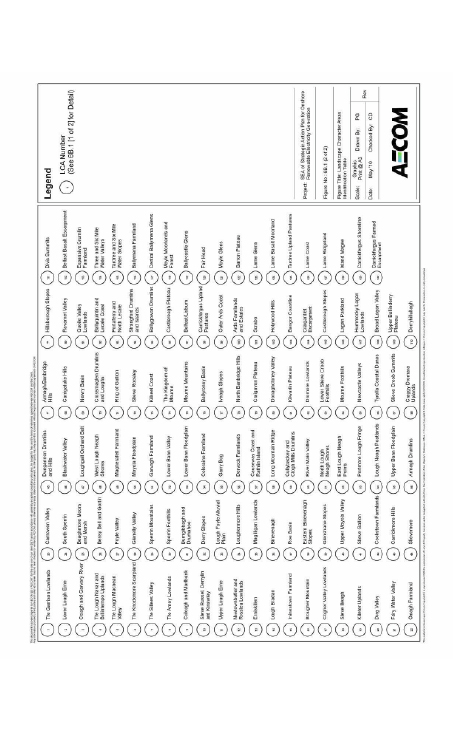
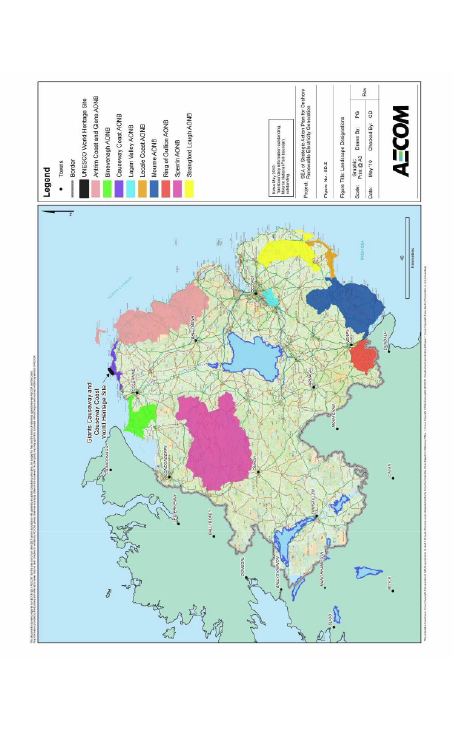
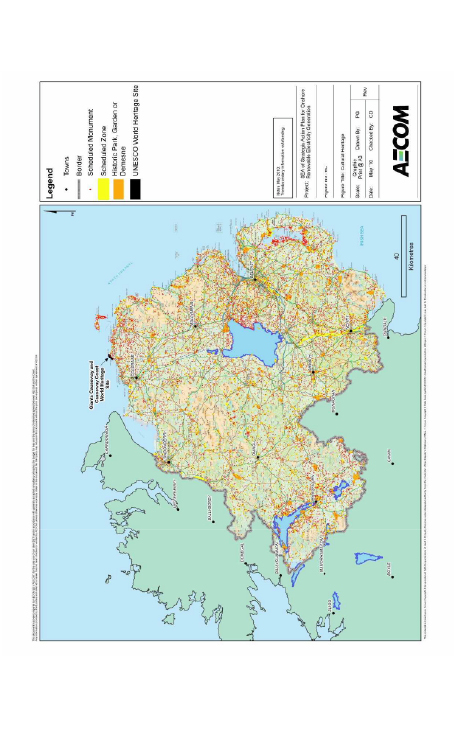
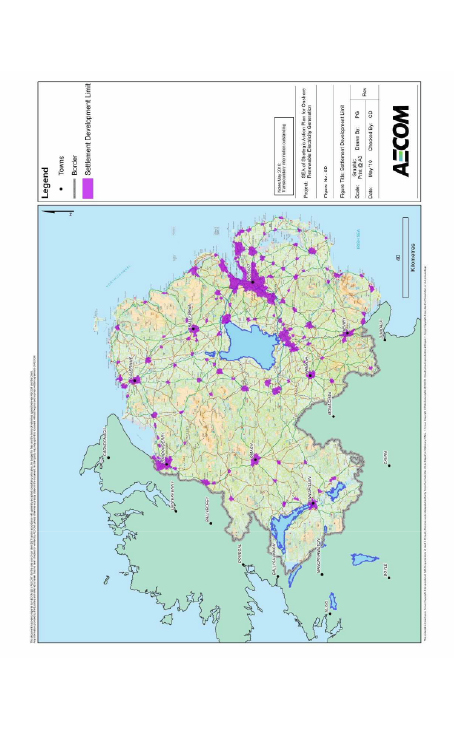


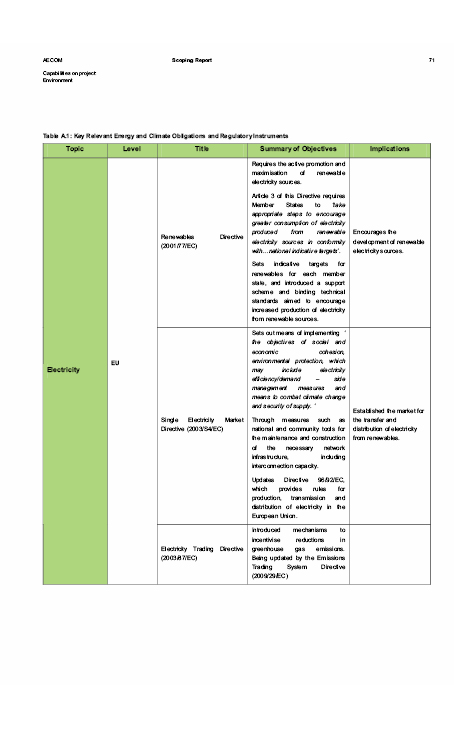
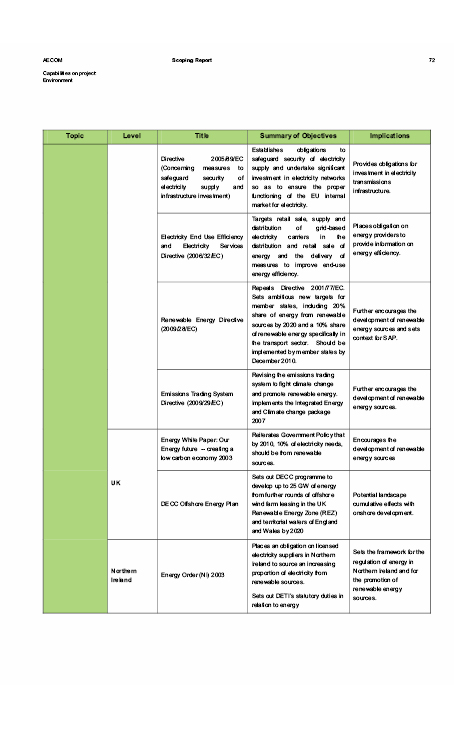
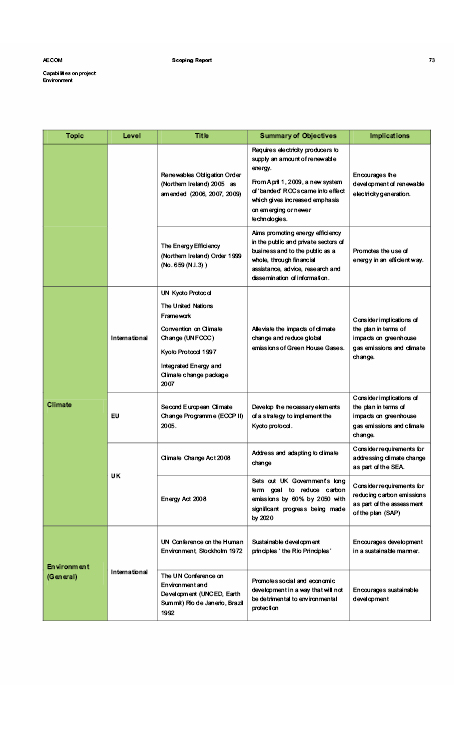
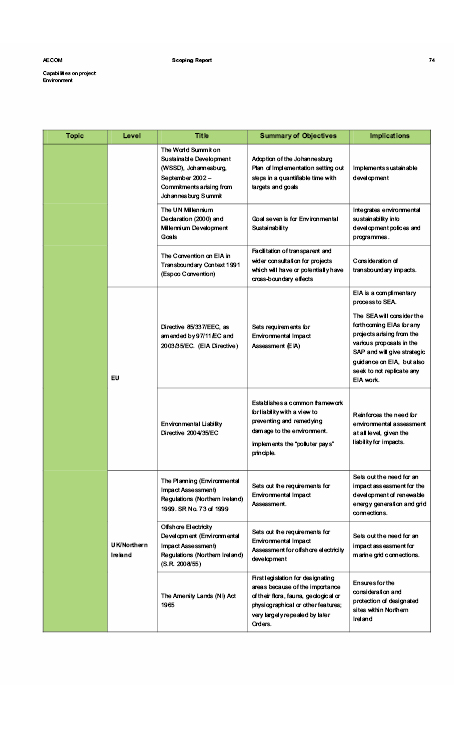
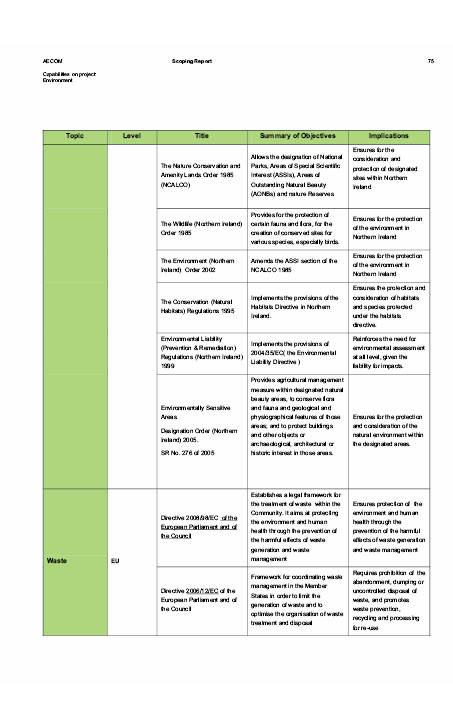
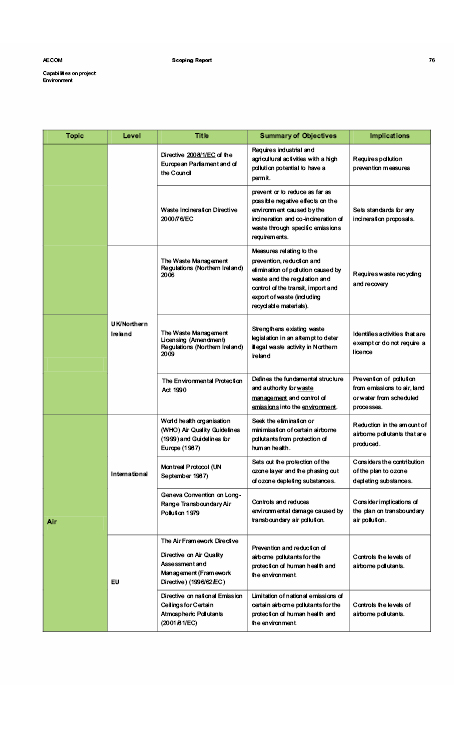
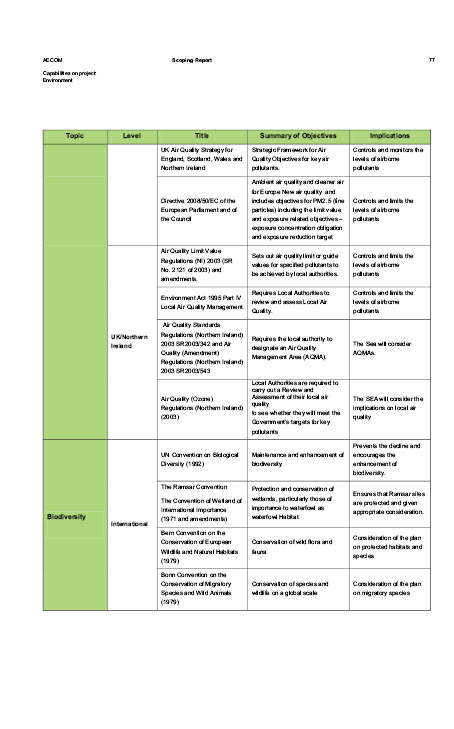
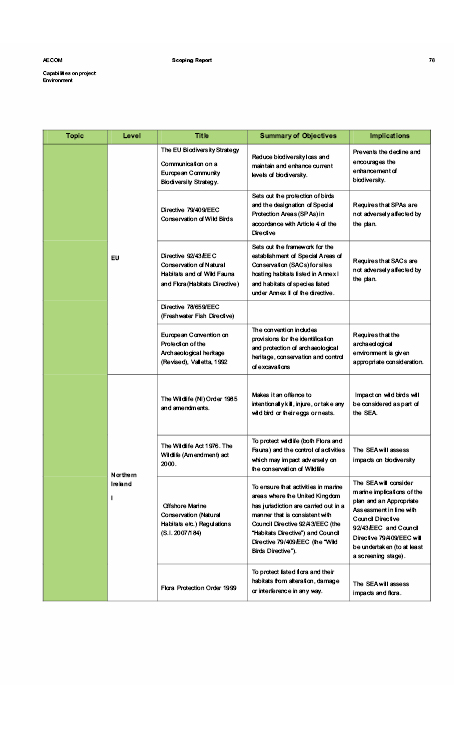
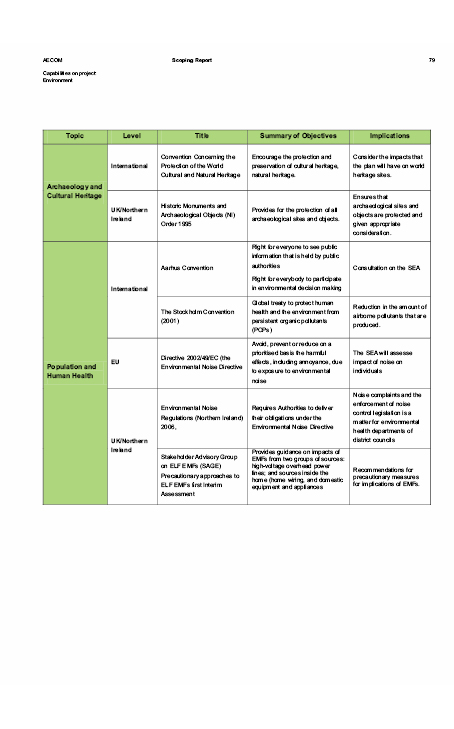
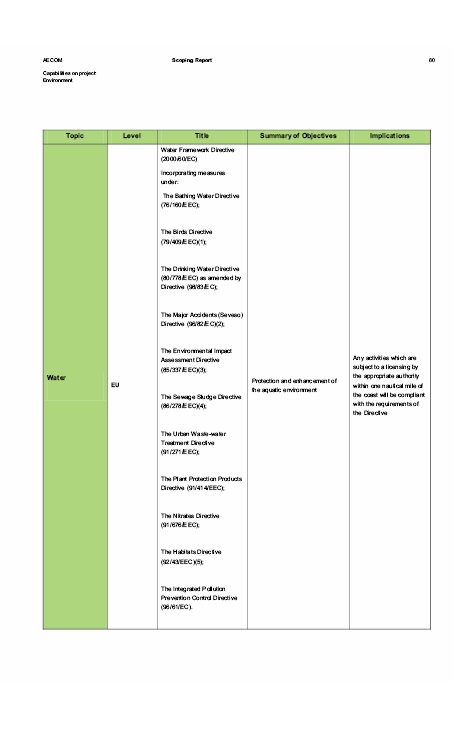
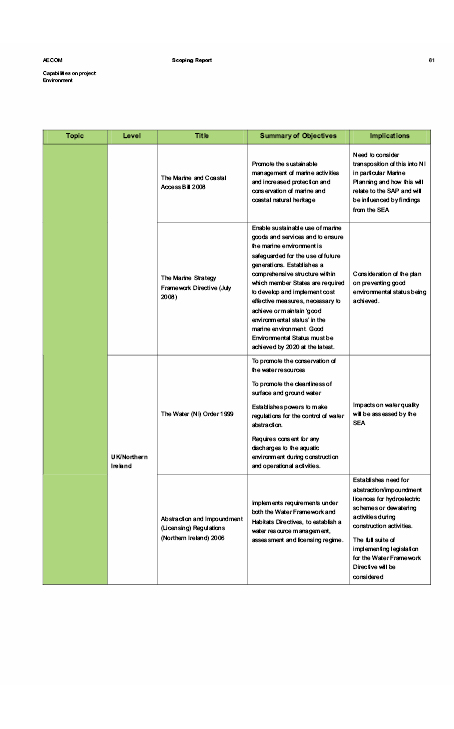
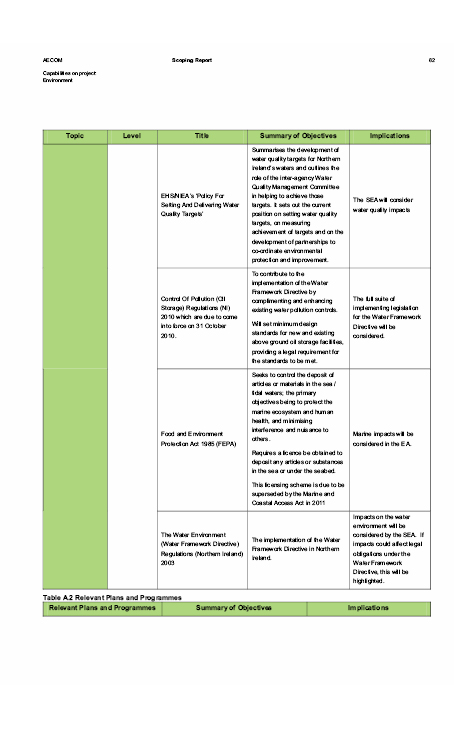
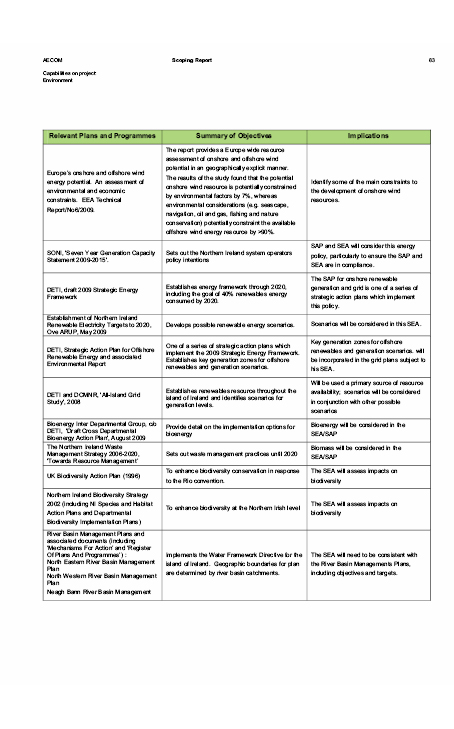
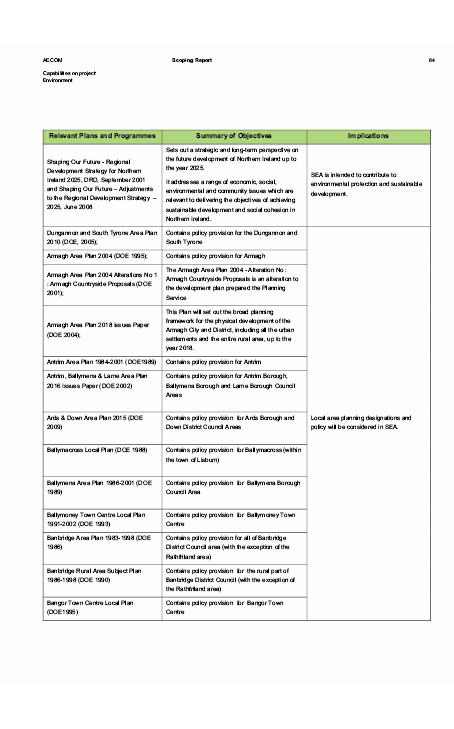
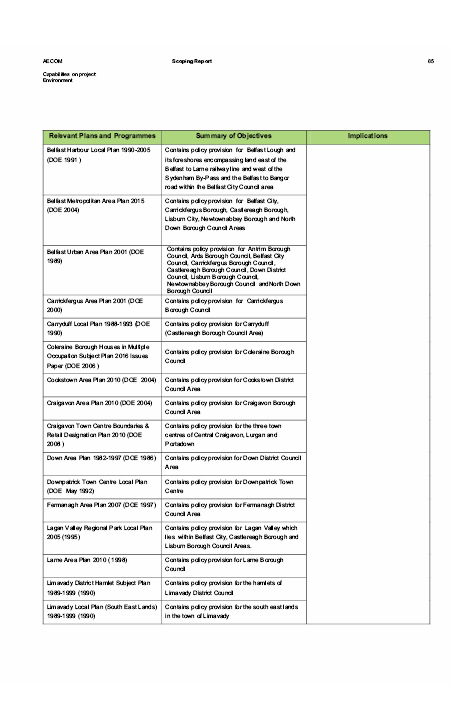
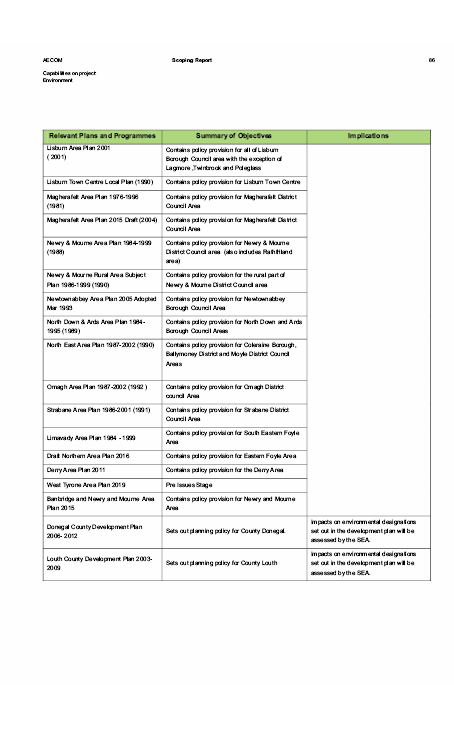
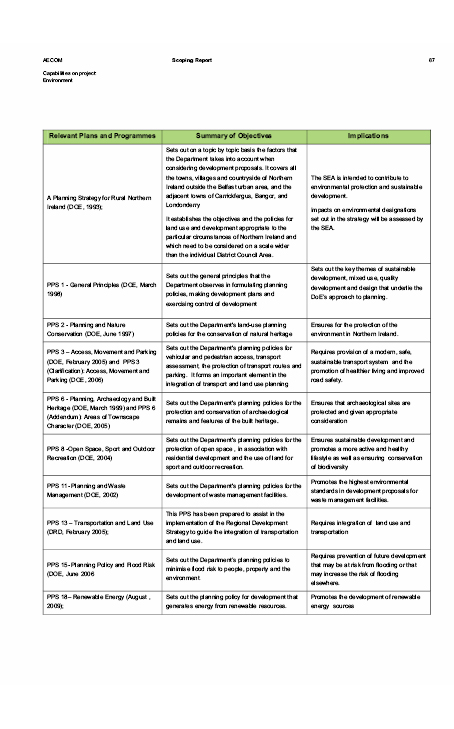
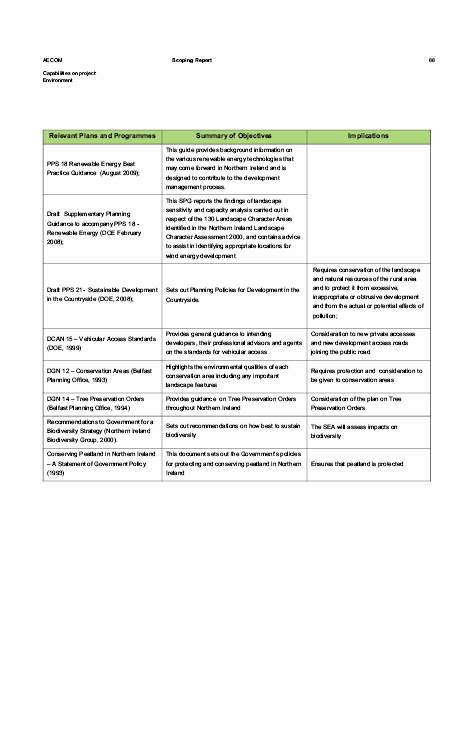
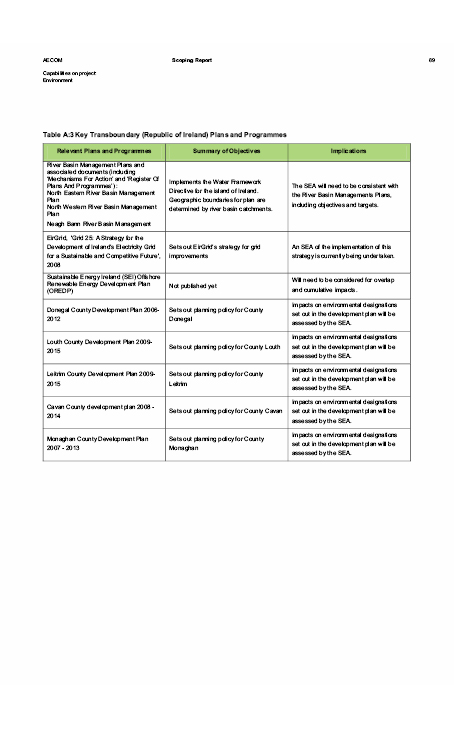
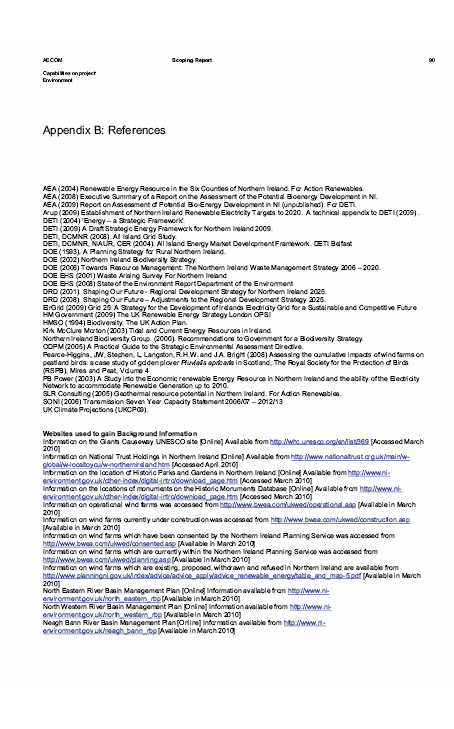

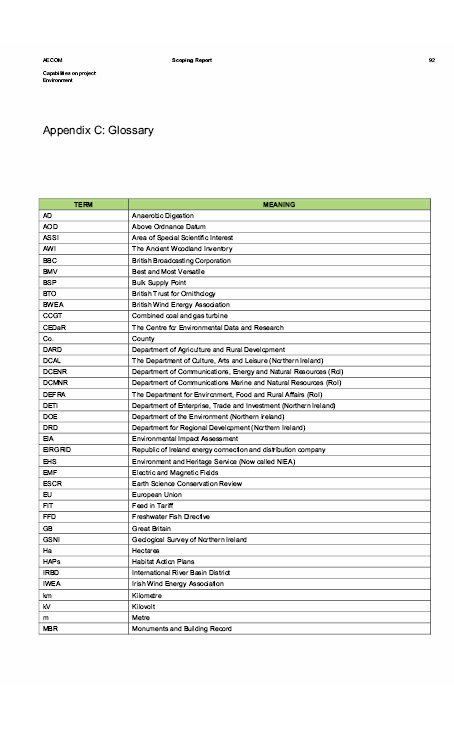
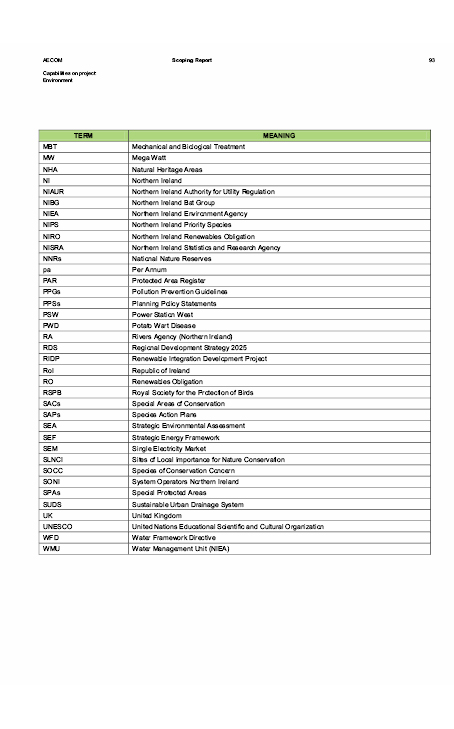
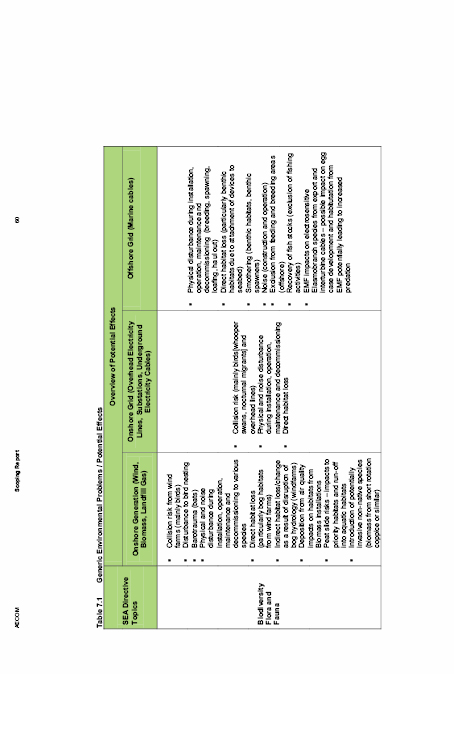
DETI Submission
Department of Enterprise, Trade and Investment
Statutory Consultation on a Bioenergy Action Plan for Northern Ireland 2009-2014
Energy Division
Written Evidence to the ETI Committee
Renewable Energy Inquiry
Stimulating
Innovation
Enterprise and
Competitiveness
Table of Contents
| Section | Title | Page number |
| A. | Government Strategy for Renewable Energy | |
| 1. | Strategic Context | |
| 2. | Energy supply in Northern Ireland
|
|
| 3. | Renewable energy
|
|
| 4. | Renewable electricity
|
|
| 5. | Heat/renewable heat
|
|
| 6. | Heat and electricity
|
|
| 7. | Renewable electricity incentivisation
|
|
| B. | Economic Development Opportunities from Renewable Energy | |
| 8. | Economic development opportunities from renewable energy
|
|
| C. | Communications | |
Communications
|
||
| Annex A | Relevant PFA/PSA targets and corporate plan targets | |
| Annex B | Executive Summary of work to establish renewable electricity targets | |
| Annex C | Executive Summary of work on heat and renewable heat | |
| Annex D | Summary of energy responsibilities of other departments | |
| Annex E | Onshore SEA scoping report | |
| Annex F | Draft Offshore Renewable Energy Strategic Action Plan | |
| Annex G | Draft Bioenergy Action Plan | |
| Annex H | Geothermal: summary of barriers | |
| Annex I | Current banding levels under the NIRO | |
| Annex J | Communications summary paper |
A. Government Strategy for Renewable Energy
1. Strategic context
1.1 The Department of Enterprise, Trade and Investment (DETI) is responsible for over-arching energy policy in Northern Ireland[1]. This overarching energy policy was first determined through the Strategic Energy Framework of 2004. In the light of the changing world focus on tackling climate change, as well as the need to address concerns around security of energy supply and wider economic development, DETI has been developing a new energy framework for Northern Ireland in collaboration with internal and external stakeholders, and after full consultation.
1.2 DETI's aim is to achieve a competitive, sustainable, long-term future for energy in Northern Ireland. We face many challenges in creating a sustainable energy infrastructure that will support economic growth and provide for reliable and competitive energy for Northern Ireland. While fossil fuels continue to dominate local power production and transport, Northern Ireland will continue to suffer from the uncertainty of worldwide shifts in the cost of oil, gas and coal. It is therefore imperative to increase the levels of power generation from renewable sources.
1.3 The new Strategic Energy Framework 2010 (SEF), currently with the NI Executive for final approval, sets out a policy framework for Northern Ireland's energy future over the next ten years and illustrates the key energy goals in terms of competitiveness, security of energy supply, sustainability, and infrastructure. To realise these goals for the benefit of Northern Ireland industry and businesses and for the protection of all energy consumers, will require collaboration across all departments and private sector investment.
1.4 The SEF sets out the strategic position on renewable energy for Northern Ireland, lead by challenging new renewable energy targets. The overarching SEF will be delivered through a number of key action plans which are currently at various stages of development, consultation and implementation – these action plans are outlined below. In addition, the SEF contains a commitment to bringing all these actions together through the development of a Northern Ireland Sustainable Energy Action Plan, which will be another important step in the delivery process.
1.5 The challenge for DETI is to spur the capital investment required for all forms of new energy infrastructure. Northern Ireland must meet the challenges of a volatile oil market and increased energy imports - increasing the amount of generation from renewable sources is pivotal to address not only our future security of supply but also to underpin our economy.
2. Energy[2] Supply in Northern Ireland
Electricity
2.1 In Northern Ireland, electricity is primarily supplied by the three main power stations Coolkeeragh (gas fired 414 MW), Ballylumford (gas fired 780 MW) and Kilroot (coal fired 440MW) to around 725,000 domestic electricity customers and 65,000 business electricity customers. All three power stations have additional (small) levels of oil fired plant.
2.2 Northern Ireland's total electricity generation capacity is around 2.75 GW (including renewables), with peak load in 07/08 recorded as 1.76GW, although evidence suggests that current demand is falling due to the current economic climate. For 2008/09 actual consumption was 8221GWh, a drop of 6.3% from 07/08 figures.
2.3 In the financial year ending 31 March 2010, NI generated around 9.25% of its electricity from renewable sources[3]. Wind continued to be the leading technology for the generation of electricity from renewable sources during 2009. Currently NI has 335MW of installed renewable electricity generating capacity; just over 4% of the UK renewable electricity installed capacity which reached 8 GW at the end of 2009[4]. As a point of comparison, the UK as a whole generated around 6.7% of its electricity from renewable sources in 2009[5].
Heat
2.4 Heat demand in NI has been estimated at 17,362 GWh a year. The majority (77%) of heat energy is currently supplied through oil, with gas, coal and Economy 7 making up the bulk of the remainder. Renewable heat is currently at around 1.7% of heat supply, with biomass making up the vast majority of renewable heat supply. In comparison, the figure in GB is around 1% renewable heat.
Energy efficiency
2.5 The cheapest way of closing the gap between energy demand and supply is to cut energy use. Ensuring efficient use of any form of energy means that less energy needs to be produced. Maximising the highest possible levels of energy efficiency across Northern Ireland is essential and should always be considered as the first step before deploying renewables.
3. Renewable Energy
3.1 Much policy in the field of renewable energy is driven by Directives agreed by Member States at EU level. Most recently, the Renewable Energy Directive (2009/28/EC) requires Member States to ensure that they meet mandatory national targets for energy from renewable sources by 2020. DETI is responsible for ensuring the transposition of this Directive in Northern Ireland.
3.2 The Directive sets the UK target at 15% renewable energy, which includes renewable heat, transport and electricity. The UK has not set separate targets for each sector as drivers for investment, supply chain and non-financial barriers will all impact on the eventual energy mix. However, a lead scenario set out within the UK Renewable Energy Strategy published in July 2009, indicates a possible split in the region of 30% renewable electricity, 12% heat and 10% transport.
3.3 Within the SEF, DETI has set out the important role that renewable energy can play in order to help meet the strategic goals around energy security and sustainability. It is proposing ambitious targets of 40% of electricity consumption to be from renewable electricity and 10% from renewable heat by 2020.
3.4 These stretching targets are evidence based and are towards the upper limit of what is achievable in the time-frame, given the constraints of grid and other factors. The targets are based on estimates of future demand projections and assume that demand will continue to grow, albeit in a way modified by the effect of further energy efficiency. Executive summaries of the work which underpins these targets are attached at Annexes B and C.
3.5 In order to achieve the ambitious renewable energy targets set at EU, UK and local level, the Department ensures that strategy, policy and appropriate regulation is in place so that those technologies most able to deliver the targets, increase security of supply and reduce carbon emissions from electricity can do so.
3.6 DETI's Sustainable Energy Branch focuses the greater part of its staff and budget in providing appropriate policy and legislative framework (as well as financial support for renewable electricity production through the Northern Ireland Renewables Obligation(NIRO)) to assist those technologies which are most likely to be able to deliver the targets at greatest benefit to the NI economy.
3.7 In reality, it is likely that the targets can be met only by ensuring the development of relatively large-scale renewable installations. That is why, with limited resources at its disposal, DETI has concentrated on supporting the development of larger-scale commercial renewable electricity installations, although it has supported the development of microgeneration and smaller-scale installations through its renewable electricity support mechanism, the NIRO (see relevant section below).
Cross Cutting Issues
3.8 Although DETI is responsible for over-arching energy policy, the policies and programmes of many other NI departments directly or indirectly influence the deployment of renewable energy in the longer term. The need for energy to be considered on a cross-departmental basis cannot be stressed enough, and this is an area that DETI has spearheaded through the establishment of the Sustainable Energy Interdepartmental Working Group (SEIDWG), which is chaired by the DETI Minister. Annex D indicates the responsibilities of other departments as they touch on energy issues.
3.9 When the Executive agreed to the creation of the SE IDWG, it recognised the importance of joined up government in delivering the energy security and carbon reduction benefits of sustainable energy. The aims of the IDWG, are primarily that the "IDWG shall ensure a co-ordinated approach across Government to the promotion of sustainable energy…" and that "The IDWG shall ensure that all Government Departments work together to ensure that policies and practices are in concert with each other and with the aim of maximising use of public funding and delivering value for money in the support of sustainable energy initiatives in Northern Ireland."
3.10 The key output of the IDWG is the development of a report of recommendations in respect of co-ordinated sustainable energy activity, including appropriate structure(s) to continue joined up delivery. This work is nearing completion and it is planned to submit an Executive paper in the autumn outlining the main findings of the SEIDWG.
3.11 The group has four sub-groups to look at in more detail bioenergy, energy efficiency, communications and economic opportunities and skills development. The work of these sub groups is discussed through the document.
4. Renewable Electricity
4.1 The current renewable electricity target for Northern Ireland, set out in the Strategic Energy Framework published in 2004, is 12% by 2012, of which 15% should be from non-wind sources.
4.2 The current draft SEF proposes a target of 40% of electricity to be from renewable sources by 2020. This is an ambitious target and one which presents a step change in terms of renewable generating capacity in a relatively short time scale.
4.3 The scale of the task must not be underestimated. The renewable energy resource has been identified through the detailed all island grid study – the longer term challenge is adapting our energy infrastructure to maximise the input from renewables in a cost effective manner.
4.4 The table below shows how the development of renewable energy has progressed over the last three years: onshore wind development accounts for the majority of the renewable energy generation at present. At March 2010, non-wind renewable generation made up almost 6% of total renewable electricity generation.
| For the 12 months ending | % Renewable electricity |
| March 2006 | 3.4 |
| March 2007 | 3.8 |
| March 2008 | 5.0 |
| March 2009 | 7.26 |
| March 2010 | 9.25 |
4.5 It is expected that the current renewable electricity target of 12% by 2012 will be met – mainly from onshore wind. Information from DOE Planning shows that DOE has to date approved 41 wind farms totalling 585 MW. A further 46 applications totalling 749MW are currently in the planning process.
Onshore Renewables (Wind)
4.6 Large-scale onshore wind is currently the main source of renewable electricity in Northern Ireland because of Northern Ireland's plentiful resource and because of the well-developed nature of the technology. It is highly likely that large-scale wind installations will continue to provide a very significant portion of the renewable electricity in the region in the period to 2020.
4.7 The further development of large-scale wind will also require increased public understanding of the need for this scale of grid development as well as the increasing number of wind installations and pylons that will be required. DETI are aware of this and will work with SONI and NIE on the communication of their grid strategy.
4.8 The Department is currently developing a Strategic Action Plan for onshore renewable electricity (wind and all other onshore technologies), in light of the proposed generation target of 40% of electricity from renewable sources by 2020. This Action Plan will examine various generation mixes to meet this target and will include all technologies. It is likely that a substantial proportion of renewable electricity will come from onshore wind, based on current planning applications, however the Plan will look at the role of other technologies, such as biomass, hydro and microgeneration.
4.9 The Plan will also consider the need for strengthening of the electricity grid to support the increase in renewable electricity and cope with intermittency issues linked to onshore wind in particular. The Plan will also look at the impact on the grid of increasing levels of offshore renewable energy and will look to identify potential landing hubs to connect offshore renewable energy with the grid.
4.10 It is important to consider the possible environmental impact of these developments. In November 2009, the Department commissioned Aecom to complete a Strategic Environmental Assessment (SEA) for Onshore Renewable Electricity alongside the development of the Action Plan. The SEA process will assess the different options considered for inclusion within the plan. Following the selection of preferred options, a draft plan will be subject to environmental assessment, which will include the development of mitigation measures to avoid, reduce and offset environmental effects. These measures will be incorporated within the plan itself. The Department is also considering economic impacts and therefore will complete a regulatory impact assessment to assist in development of the Action Plan.
4.11 The SEA is progressing well with the first stage now almost completed. We have developed a draft scoping report (copy attached at Annex E) which lays out what will be examined in the assessment. This has been subject to consultation with the Northern Ireland Environment Agency as well as with other stakeholders and comments received will now be incorporated into actual assessment of options. It is anticipated that the Strategic Action Plan will be open to public consultation along with the Environmental Report and the Regulatory Impact Assessment in late autumn with the Plan finalised in early spring 2011.
Tourism
4.12 Within the DETI family the Department accepts that a balance must be found between energy needs and the protection of the tourism opportunity afforded by our designated landscapes. The Northern Ireland countryside is an important asset, and NITB advises DETI on the development and implementation of tourism policy, including the potential impact of renewable energy infrastructure on tourism.
Planning
4.13 The Planning System plays a central role in ensuring the delivery of the necessary infrastructure and installations to meet renewable targets, ensure continued energy security and reduce carbon emissions. The planning system helps to safeguard Northern Ireland's landscape, natural heritage and communities while at the same time allowing development where needed. It is therefore essential that the planning system reflects the range of interests and applies necessary safeguards where developments may not be appropriate or require specific adjustments, but delivers timely and consistent decisions where development is appropriate in order to help Northern Ireland meet the renewable energy targets set out in the new Strategic Energy Framework.
4.14 While the need to move away from the current high fossil fuel dependency to low carbon energy sources is well accepted at a strategic level, members of the public and elected representatives continue to have concerns about the location and operation of renewable energy projects within their areas. These concerns need to be effectively addressed if renewable businesses are going to be able to secure planning approval for the projects which will contribute to our renewable targets. The planned increase in renewable electricity will require a significant increase in the number and types of renewable generation across the region, as well as the necessary grid infrastructure to support this generation.
Implications for the Grid and back-up generation
4.15 The current number of planning applications lodged for onshore wind installations indicates that developers remain willing to invest in this technology. However, one limiting factor in determining how many wind farms actually built is the current capacity of the electricity grid.
4.16 The majority of the applications for onshore wind farms are in the West/North West of Northern Ireland, where the grid is at its weakest and needs significant reinforcement to be able to cope with larger amounts of on shore wind. As more and more wind comes onto the system, this is likely to lead to potential curtailment of the wind farms and hence this may influence investment decision for developers.
4.17 Managing the intermittency of wind can also increase network management costs. When there are large amounts of wind generation in electricity markets, the management of the intermittency to maintain the stability and integrity of the network causes an almost equal and opposite intermittent requirement for back-up plant and the response times of conventional generation mean that the dispatch of renewable generation needs careful planning.
4.18 Increasing renewable electricity has the potential to impact on the management of the Single Electricity Market (SEM). The Renewable Energy Directive[6] requires that renewable energy receives priority dispatch on to the electricity transmission system. The Regulatory Authorities (in both Northern Ireland and the Republic of Ireland) have carried out two joint consultations examining dispatch principles and associated Trading and Settlement Code matters in the SEM to deal with priority dispatch requirement. They continue to examine a number of associated relevant issues including curtailment, deemed firm access, and allocation of infra-marginal rents.
Offshore renewables
4.19 Northern Ireland is fortunate to have considerable offshore renewable energy resources (mainly from offshore wind and tidal stream energy, with a very limited capacity for wave energy), a strong engineering and manufacturing base and significant port and harbour facilities to enable the successful development of an offshore renewable energy sector. The world's first commercial scale, grid connected 1.2MW tidal stream demonstration device, Sea Gen, is successfully operating in Strangford Lough. The successful development of this unique device over the last couple of years has significantly increased operational knowledge of tidal devices and has also drawn international attention to Northern Ireland's resources.
4.20 In 2008, DETI began a major work programme to develop Northern Ireland's offshore renewable energy sector. The marine environment, however, is not empty –the coast and sea are home to many important plant and animal species and also contribute to the economy through fishing, tourism /recreation and ports and harbour activity. A multi agency Project Steering Group, led by DETI and involving DOE, NIEA, DARD, AFBI, DCAL, DRD, the Crown Estate (as owners of the seabed) and the Maritime and Coastguard Agency has overseen this work.
4.21 In order to address the potential impacts of offshore renewable energy on the environment and other marine users and a pre-requisite to any Crown Estate leases of the seabed, DETI has, with support from the EU Competitiveness Programme, undertaken a Strategic Environmental Assessment (SEA) of the draft Offshore Renewable Energy Strategic Action Plan 2009-2020 (ORESAP – attached at Annex F). The SEA and the draft ORESAP were the subject of a public consultation from December 2009 to March 2010. The overall aim of the ORESAP is:
To optimise the amount of electricity generated from offshore renewables to enhance diversity and security of supply, reduce carbon emissions, contribute to the proposed renewable electricity targets for 2020 and beyond and develop business and employment opportunities for NI companies.
4.22 On the basis of the SEA Environmental Report, it is considered that the proposed ORESAP targets of at least 600MW of offshore wind and 300MW from tidal resources in Northern Ireland waters by 2020 could be achieved without a significant adverse impact on the environment and other marine users. The main tidal resource is located off the North Coast and the main offshore wind down the East Coast. A further 300 MW of offshore wind may be possible off the North Coast.
4.23 In order to achieve the overall objective, the draft ORESAP set out a range of policy, legislative and operational actions required to put in place the right environment for private sector investment in offshore renewables in Northern Ireland. These actions include the strengthening of the grid to handle offshore renewables; working with Invest NI to promote opportunities for local companies within the overall offshore renewable supply chain; developing a practical approach with the Republic of Ireland to marine boundaries; working with DOE to ensure DETI's economic marine interest is represented in marine legislation; the ongoing development of the NIRO to support offshore generation and ensuring that NI benefits from the range of UK-wide regimes supporting research, development and deployment of offshore renewables at this early stage of development[7].
4.24 The SEA process has been ongoing throughout 2009 and 2010 and will be completed this autumn. The process has involved considerable consultation and engagement with stakeholders to ensure that key issues have been identified and addressed. DETI will shortly publish a Post Consultation Report and a revised ORESAP will be submitted to the Executive for adoption in the autumn. It is also planned that the existing Project Steering Group will, with the addition of a number of key external stakeholders such as the renewable development, the fishing, navigation and environmental sectors, become the Offshore Renewable Energy Forum. This Forum will advise DETI on the ongoing implementation of the ORESAP.
4.25 The completion of the SEA and finalisation of the ORESAP will form the necessary framework within which the Crown Estate can launch the planned Offshore Renewable Energy Leasing Round in NI waters later in 2010-2011. In preparation for the Leasing Round, DETI will shortly develop Regional Locational Guidance to help identify potential sites for commercial, pre-commercial / demonstration /testing opportunities and ways of handling possible competing interests.
4.26 It is hoped that agreements for lease would be made by the Crown Estate by Spring 2011. Following the consenting and licensing processes, the Crown Estate could be able to offer full leases by Spring 2013 leading to initiation stages for projects leading to subsequent deployment from 2014-2015 onwards, contributing to the 2020 targets and beyond.
4.27 The deployment of offshore renewables, being pursued across the British Isles, presents technological, economic and financial challenges, with marine renewables still at a very early stage of development. Because of this early stage of development and the more challenging environment in which they operate, marine renewables are currently more expensive than some onshore renewable technologies. This means that higher levels of support through UK-wide research funding, the Renewables Obligation, and increasing deployment over the next few years is expected to assist in moving the sector from demonstration to commercial scale production with associated economies of scale and reducing costs.
4.28 The targets and wide-ranging supporting actions in the ORESAP, which represent a significant and resource intensive work programme, have been developed to send a strong signal to the private sector to encourage and facilitate its investment in Northern Ireland. This investment will not only support offshore renewable projects generating in NI waters, but also the economic development opportunities that NI offers as a base for projects in British and Irish waters.
5. Heat/Renewable Heat
5.1 The EU Renewable Energy Directive's requirement for the UK to ensure that 15% of its energy consumption comes from renewable sources, including heating and cooling, has meant that it is necessary to set a policy framework that will ensure development of a heat market. Northern Ireland is expected to contribute to the United Kingdom's share of this target and in October 2009 DETI commissioned a study into the potential for deploying renewable heat in Northern Ireland[8]. A key part of the study involved complex data gathering and modelling and the study showed that the indicative 10% target for renewable heat by 2020 proposed in the draft Strategic Energy Framework is possible, but will require significant government intervention.
5.2 The study also concluded that the achievement of a 10% renewable heat target cannot be reached by DETI alone. This is due to the cross-cutting nature of this work: there are a number of issues that require other government departments such as DSD, DOE, DARD etc. to take the lead. In order to address this DETI plans to set up a cross departmental Renewable Heat Strategy Group to include government representatives as well as others to look at issues that, while outside DETI's remit, are crucial to a 10% renewable heat target being achieved. For example, the group will wish to give consideration as to how indigenous resources can be maximised and utilised effectively. A mix of technologies and fuel types will be required to reach a future 10% renewable heat target. Biomass, in its many forms, is available to a certain extent and is already present in the heat market, but competing demands for it in the future may affect the amount of renewable heat that can be delivered unless there is a significant expansion in energy crops.
5.3 Similarly biogas generated from food and farm wastes: grass can be used to generate heat directly, or can be injected into the gas network. The high proportion of grassland in Northern Ireland means that this technology could have significant potential. DETI already incentivises the production of electricity from biogas and anaerobic digestion, but both technologies also offer potential for heat generation.
Renewable Heat Incentive
5.4 Importantly, this study showed that the GB Renewable Heat Incentive scheme appears to be inefficient for Northern Ireland, by over-incentivising some technologies and not encouraging the most cost-effective options. Northern Ireland may therefore need to develop its own RHI scheme. However, further economic assessment is required to assess the actual incentivisation levels required and, in due course, legislation would be required. The economic work will be undertaken this year. Once the economic analysis is complete and the conclusions drawn, if appropriate, DETI will commence drafting legislation. This legislation will require consultation in the normal manner. The current Energy Bill, which the Committee is considering, cannot be amended to include provisions on renewable heat and specifically a renewable heat incentive[9].
5.5 The key determinant in moving forward with a RHI is the funding mechanism. DETI is committed to developing a heat market, but this is subject to a suitable funding mechanism being established. If the RHI is funded through a UK wide tax, then Northern Ireland should be entitled to a share through the Barnett Formula in the normal way. However, if a UK funding mechanism is not forthcoming then it would fall to the Northern Ireland Executive to decide where funding for an RHI might come from.
5.6 To set the context further, it should be noted that the scale of the cost of a RHI is dependent on the types and rates of incentives agreed. Initial analysis has shown that 10% renewable heat could be achievable at a cost of £2.5m per annum per % point up to 10% and then £8.8m per annum per % point after that. This cost would be the equivalent of around £25 on the average annual heating bill per annum. At this stage this is just an estimate based on initial renewable heat curve analysis; the implementation of a RHI may indeed have a higher or lower cost ranging anywhere from £5 per bill to £95 per bill depending on the tariffs set.
Reaching a 10% target
5.7 The current heat demand in Northern Ireland is estimated at 17,362 GWh per year, and approximately 1.7% of this currently comes from renewable sources. The study we have undertaken has also shown that the majority of NI heat use is in the domestic sector, at 61% of the total heat demand or 10,644 GWh. This is followed by the large industrial sector at 22%, the commercial sector at 12% and finally the public sector at 4%. This means that for the 10% to be met solely though domestic housing it would require 16% of the existing stock to be entirely heated by renewable technologies. This equates to modifying 11,800 homes (1.6%) per year. Renewable heat could also have a significant role in tackling fuel poverty, either through localised district heating schemes in new housing developments or through supporting the installation of renewable heat technologies in households suffering from fuel poverty.
5.8 There are three possible options to encourage renewable heat in order to reach a 10% target by 2020:
i) Large Industrial Sites – The 17 large industrial sites identified in the study account for 22% of Northern Ireland's heat demand. There is significant potential for developing renewable heat in this sector as by moving only a few sites over to renewable heat would go a long way in reaching a 10% target. A detailed study would be required for each site to determine the technical and economic viability. However achieving the target solely by this method does pose a risk due to the longer term uncertainties for each site.
ii) Domestic and Commercial Market – Analysis has indicated that renewable heat is already cost effective for a number of these consumers. In order to encourage the roll out of renewable heat technologies in these markets a specific RHI for Northern Ireland would need to be developed. This would give confidence to the market and could be targeted to ensure appropriate technologies were installed where most cost-effective. All forms of renewable heat such as biomass, deep geothermal, solar thermal panels, bio fuels and air and ground source heat pumps will also need to be encouraged if a 10% target is to be reached.
iii) Community based schemes – Around one third of housing stock in Northern Ireland lies in areas where community based schemes such as district heating could be viable due to the high correlation between housing density and heat demand. The development of these schemes face a number of financial and non-financial barriers however should be considered as part of a long term strategy.
Renewable Heat and Natural Gas Markets
5.9 Experience from DETI's Reconnect grant scheme would suggest that the greatest uptake of domestic renewable heat technologies will be in rural off-gas grid areas. An extension of the natural gas network into the West/ North West of Northern Ireland has the potential to adversely affect the take up of renewable heat in areas that may have previously been likely to convert to renewable heat.
5.10 DETI will consider how to ensure that the two markets can develop alongside each other without one adversely affecting the other. This will be a key element of a renewable heat road map that DETI will develop later this year.
6. Renewable heat and electricity
Bioenergy
6.1 In 2007, DETI formed the Bioenergy Inter-Departmental Group (IDG) to co-ordinate and deliver a more integrated approach to the sustainable development of bioenergy across the Northern Ireland departments. The IDG includes representatives from DARD, DOE, DFP, DRD and Invest NI. Having commissioned an independent study into the potential for the bioenergy sector, the IDG published in August 2009 the first draft Bioenergy Action Plan 2009-2014 (attached at Annex G).
Draft Bioenergy Action Plan
6.2 The overall aim of the draft Bioenergy Plan is:
To increase the sustainable deployment of bioenergy to contribute to security of energy supply, deliver carbon emission reductions, produce economic and environmental benefits and contribute to Northern Ireland's renewable energy targets, in particular renewable heat and electricity.
6.3 While Bioenergy can be used for electricity, heat and transport, the IDG proposed, and was supported by the vast majority of consultees, that the focus should be on electricity and heat. A wide range of potential bioenergy feed-stocks were identified including energy crops, forestry /forestry residues, poultry litter, Municipal Solid Waste, commercial and industrial food processing waste, landfill gas, grass and farmyard wastes. Market opportunities across the domestic, commercial and industrial sectors were also identified.
6.4 The draft Plan proposed four key objectives - to raise awareness and understanding of bioenergy; to create and maintain a supportive and encouraging policy and regulatory framework; to encourage and support targeted investment in key areas of the supply chain; and to continue to undertake focussed and NI relevant R&D activity. A series of time-bound actions by Departments were proposed to help deliver the four objectives and address the overall aim.
6.5 The draft Plan was widely welcomed by stakeholders: the overall co-ordinated IDG approach was welcomed, as were the four objectives. As noted above, the vast majority of consultees supported the use of bioenergy for renewable heat and electricity rather than transport; there was strong support for the ongoing renewable heat work and possible consideration of a Renewable Heat Incentive; issues were raised in relation to the NIRO and the GB Feed-in-Tariff and how to ensure that NI support levels encouraged the development of the bioenergy sector; some considered there were significant opportunities for Anaerobic Digestion; others identified public procurement as a key driver and a number identified access and the cost of access to the Grid as an issue.
6.6 The IDG has reviewed the Draft Plan, in light of both the consultation responses and the initiatives being taken forward in DARD's recent Renewable Energy Action Plan 2010-2013, published in June 2010. A number of further actions are being proposed to help address the key issues identified by consultees. Given its cross cutting nature, a finalised Action Plan will be submitted to the Executive for adoption in the autumn and subsequent implementation by the relevant Departments.
Supporting Bioenergy
6.7 While the independent study which informed the draft plan identified the potential for bioenergy to contribute up to 6.4% renewable heat and 7.8% renewable electricity by 2020, it noted that this would require very significant levels of public funding. The draft Plan stated that such levels of funding were not available but did identify where Departments could consider targeted investment to support the development of bioenergy.
6.8 The NIRO is the main support mechanism to encourage greater deployment of renewable electricity (see section 7) and support levels have continues to be increased over the last couple of years for a number of bioenergy technologies. The potential for a possible Renewable Heat Incentive is discussed earlier.
6.9 DARD is a key player in the development of bioenergy within the land based sector and a range of further targeted actions have been announced by DARD in its Renewable Energy Action Plan in June 2010 to support the supply chain, increase market understanding, develop capability and promote research and innovation. One of these actions included the launch of a new Biomass Processing Challenge Fund which will help improve business efficiency and sustainability at farm level processing agricultural wastes and other appropriate biomass material to generate renewable energy.
6.10 The thrust of the draft Plan is towards increased understanding of bioenergy and a conducive and facilitative policy and regulatory regime with modest and targeted levels of direct financial support. As the IDG finalises and carries forward the Action Plan, it will also monitor developments across the UK and elsewhere which could influence the implementation of the Plan.
Microgeneration and small-scale generation
6.11 Section 82 of the Energy Act 2004 defines microgeneration as the small-scale production of heat and/or electricity from (primarily) renewable sources. Micro-generation is defined as up to 50 kW for electricity generating technologies and up to 45 kW for heat generating technologies. Although this section of the Act does not apply to Northern Ireland, DETI used the same definitions for microgeneration. The definition of small-scale generation is less precise, but while GB has defined it as under 5MW for the purposes of their feed-in tariff, it is likely that the limit would be considered to be lower in Northern Ireland where 5MW would represent a substantial installation.
6.12 Currently, NI small generators make up 88% of all renewable generators in NI and provide 0.9% of total renewable electricity generating capacity, compared to 0.2% in the UK as a whole. It is important to note that, for some technologies, smaller-scale developments are less efficient. For example, in onshore wind, small-scale developments tend to have lower capacity/load factors than large-scale wind-farms (around 15% compared to around 35% for larger scale wind-farms). This lower capacity factor has the consequence that microgeneration and small-scale installations tend to be more expensive ways of producing renewable electricity.
6.13 DETI has focused on encouraging those technologies which can make the greatest contribution to meeting current and future renewable electricity targets. It therefore does not have a specific microgeneration/small-scale strategy, although it has undertaken a number of specific actions in order to encourage this sector and these are touched on below.
Financial support for microgeneration and small-scale generation
6.14 DETI has previously provided microgeneration with 50% grant support through the Reconnect scheme. More recently a similar grant scheme was available through the UK-wide Low Carbon Buildings Programme which closed earlier this year.
6.15 Reconnect supported just over 4000 applications at a cost of £12m over two years. The scheme displaced 52 MW of fossil fuel derived energy with 50MW being attributed to heat technologies and only 2 MW to electricity-producing technologies, even with the additional support of the NIRO in place. Reconnect was mainly taken up by more affluent rural households, and therefore did little to help those in fuel poverty.
6.16 The goal of Reconnect was to stimulate that market. However, feedback from the installers operating in this market was that grant support is not a favoured option. The uncertainty about the longevity of funding is difficult to manage, a much more preferable form of support would be a longer term incentivistion approach such as an RHI or NIRO approach.
6.17 DETI sees the NIRO and ultimately the RHI, should it be taken forward, as providing a long term support mechanism for those wishing to install microgeneration. As part of this approach, DETI recently legislated to provide increased financial support under the NIRO for certain small-scale technologies (wind, PV and hydro) and early evidence appears to show that this is incentivising uptake at this scale. In addition, DETI is currently consulting on proposals to increase the NIROCs available for AD, including a proposal for 4 ROCs for smaller-scale (under 500kW) AD installations.
Quality and Certification
6.18 DETI has sought to encourage the micro-generation industry to introduce a form of self regulation and strongly supports the UK-wide Microgeneration Certification Scheme (MCS). DETI has already funded a Northern Ireland accreditation body and has for some time been trying to persuade installers here to become accredited so that microgeneration installers can sit on a par with long established schemes like Gas Safe. Research has shown that these types of reputable schemes build customer confidence and investment grows as confidence in the products and the installers' increases.
6.19 In addition, DETI's ongoing consultation on changes to the NIRO in 2011 proposes that microgenerators receiving full accreditation under the NIRO on or after 1 April 2011 should use MCS certified products installed by MCS accredited installers. The consultation also looks to see if this requirement can be administered outside of legislation.
Advice
6.20 The market itself is already offering some level of support in relation to microgeneration technologies. For example, Action Renewables, Energy Saving Trust, NIE and Northern Ireland Energy Agency all provide advice in relation to these technologies.
Grid Connection
6.21 DETI recognises that a number of stakeholders have raised concerns about grid connection policy and charging for small-scale renewable electricity installations. The Utility Regulator plans to consult on this issue in the autumn and this will provide an opportunity for further consideration of the potential for improving the way in which connection pricing is structured for small-scale renewable energy generators.
Community Renewables
6.22 DETI has recently partnered with DECC in the UK wide Low Carbon Communities Challenge (LCCC). The LCCC is a two-year programme with the aim of providing financial and advisory support to 20 'test-bed' communities in England, Wales and Northern Ireland that are seeking to develop community based sustainable energy solutions. Successful projects are provided with expert advice and guidance as well as up to £500,000 in capital support.
6.23 The LCCC is a programme to help government understand the potential role of communities in the transition to a low carbon future, and the systems, infrastructure and governance required to make this future a reality. It is envisioned that LCCC projects will provide positive models for community action, and enable the sharing of ideas, stories and information to inspire other communities to launch their own low carbon initiatives. The project goes beyond carbon-saving technologies, and looks at the broader socio-economic benefits/impacts of creating low-carbon communities.
6.24 Through the partnership with DECC, DETI was able to ensure two Northern Ireland applicants were successful in receiving funding. The two successful projects are:
- Camphill Community, Glencraig plans to install a biomass district heating system using locally sourced wood. This will help to reduce bills, lower the dependence on fossil fuels and save almost 800 tonnes of carbon. Camphill has been in discussions with neighbouring schools and amenities with a view to developing further partnerships and extending this current project.
- Ballymena District Council has received funding through the scheme to support the building of a district heating network which will be initially fuelled on biomass with the next phase moving to a deep geothermal energy source. The project, involving 26 houses and a number of public buildings, will cut carbon, save money on energy bills and address fuel poverty issues for the Ballymena community.
Geothermal
6.25 Northern Ireland has good geothermal energy resource potential which has been examined by the Geological Survey of Northern Ireland, part of the DETI family. Geothermal energy can be divided into two categories – shallow and deep - based on the depth of geothermal resource to be exploited. Some of the barriers to the development of geothermal energy resources in Northern Ireland are common to both categories but the degree to which they currently inhibit investment and development, and the mechanisms which could be used to address them, may be different. These barriers are explored further in Annex H.
7. Renewable electricity incentivisation
7.1 Renewable energy has a cost. However, determining the costs of renewables is complex. The recent UK Electricity Generation Cost Update[10], commissioned by DECC, provides a helpful summary of some of the issues involved in attempting to assess both present and future levelised costs of electricity generation technologies.
7.2 The cost of renewable electricity generation is usually, but not always, higher than that of conventional generation. However, the cost of renewables overall, and large-scale onshore wind in particular as one of the most economic forms of renewable electricity generation, will become more competitive as renewable technologies mature and the cost of carbon is increasingly factored into conventional generation.
7.3 That higher cost is why DETI provides extra support for the costs of renewable electricity generation through the Northern Ireland Renewables Obligation (NIRO). Costs of renewable generation vary according to technology – that is why banding was introduced into the NIRO.
7.4 The key for the Department is to ensure a balance between the need to incentivise renewable electricity generation, providing economic opportunities for local renewable businesses, against the need to keep electricity costs as low as possible. This is an important balance as it is inevitable that the additional cost of renewables will be passed on to both business and domestic consumers, including the fuel poor.
Northern Ireland Renewables Obligation (NIRO)
7.5 The Northern Ireland Renewables Obligation (NIRO) is the Department's main policy measure for supporting the development of renewable electricity in Northern Ireland. The NIRO was introduced on 1 April 2005 and has been the subject of a number of amendments, the most recent in April 2010: this was the Renewables Obligation (Amendment) Order (Northern Ireland) 2010).
7.6 The NIRO places a legal requirement on electricity suppliers to account for a specified (and increasing) proportion of their electricity as having been supplied from renewable sources or to pay a buy-out fee that is proportionate to any shortfall. Suppliers provide evidence of compliance by presenting Renewables Obligation Certificates (ROCs) which are issued to generators of renewable electricity for each unit of eligible output. The number of ROCs issued for each MWh unit varies depending on the technology involved and its generating capacity.
7.7 The NIRO operates in tandem with two similar Obligations in Great Britain – the 'RO' in England & Wales and the 'ROS' in Scotland. ROCs issued in Northern Ireland under the NIRO (NIROCs) are tradeable with those issued under the two GB Obligations (GBROCs) in a UK-wide market; both NIROCs and GBROCs are accepted as the necessary evidence under the Obligations. ROCs (both NIROCs and GBROCs) are issued by Ofgem[11], which, in the case of NIROCs, is acting on behalf of the Northern Ireland Authority for Utility Regulation (NIAUR).
7.8 The NIRO has been very successful in bringing forward the more economic renewable energy technologies, particularly onshore wind. Since its introduction in NI in 2005, the amount of electricity generated from renewable sources has almost trebled.
7.9 Banding was introduced in April 2009 to reflect the different stages of development and hurdles faced by emerging renewables technologies. Prior to April 2009, all generating stations received 1 ROC per megawatt hour (MWh) regardless of technology or capacity. The April 2009 changes saw emerging technologies such as AD, biomass and tidal receive 2 ROCs whilst established technologies such as onshore wind remained on 1 ROC (all microgenerators in all technologies i.e. up to 50kW capacity) were increased to 2 ROCs.
7.10 While wishing to maintain as far as possible the beneficial inter-operability of the NIRO with the other GB ROs, DETI has made a number of changes to ROC banding in NI to respond to local needs (see paras 7.11 to 7.13).
Landfill Gas
7.11 Following representations from industry, DETI successfully made the case to the European Commission for landfill gas support to be retained at 1 ROC per MWh when the support for landfill gas was banded down in the rest of the UK to ¼ ROC per MWh in 2009.
Small-scale Wind, PV and Hydro
7.12 The Department made significant changes to the support available to small-scale generation under amendments to the NIRO introduced from 1 April 2010. Specifically, the number of Renewables Obligation Certificates (ROCs) increased for wind, hydro and solar photovoltaic (pv) technologies. These ROC increases were introduced to ensure that renewables generation in NI remained competitive following the introduction of a Feed-In Tariff in GB but not in NI. These ROC increases have been well received and have resulted in a significant increase in wind turbine planning applications. Current banding levels are shown at Annex I.
Anaerobic Digestion (Biogas)
7.13 In April, DETI undertook a call for evidence regarding the costs associated with installing AD in NI. The call for evidence produced 20 responses, many of which contained detailed costings. The evidence provided supports an increase in ROC levels for AD. That is why the public consultation on changes to the NIRO in 2011 proposes that support for AD be significantly increased to 4 ROCs per MWh for those installations up to and including 500kW capacity, and to 3 ROCs per MWh for installations larger than 500kW. DETI believes that this higher rate, which remains subject to HMT and State Aid approval from the European Commission, as well as the approval of legislation in the Assembly, will be sufficient to stimulate investment in commercial AD in NI.
Banding Review
7.14 There are no immediate plans to further increase ROC support in the NIRO for 2011 (apart from the proposed changes for Anaerobic Digestion discussed above). However, a UK-wide banding review will commence in October 2010. This will consider if bandings need to be amended further with a view to any changes being introduced in April 2013.
GB Feed-In Tariff (FIT)
7.15 In April 2010, a Feed-In Tariff (FIT) form of support was introduced in Great Britain for renewables generation up to 5MW. The FIT does not extend to NI as DETI does not currently have the legislative powers in place to introduce such a scheme. The DETI Minister has already indicated that NI will not simply follow the rest of the UK in adopting a small-scale FIT without considering the consequences to Northern Ireland as a whole, including any impact on consumer bills[12]. The Minister has given an undertaking to announce her intentions with regard to future renewables incentivisation later this year.
7.16 The UK Coalition Government has indicated that it is considering extending the FIT to generating stations above 5MW whilst continuing to maintain the banded RO. The Department has not been formally informed of the Coalition Government's intentions but will keep an active watching brief on developments in GB to ensure that NI maintains the form of incentivisation best suited to the needs of Northern Ireland, both from a development perspective and from a cost perspective.
Future incentivisation
7.17 In the light of changes to renewable incentivisation in GB, the Department and Utility Regulator jointly commissioned a report looking at the best form of incentivising future renewable electricity generation in Northern Ireland. The draft report, which is currently with the Department and Regulator for consideration, looks at both the Renewables Obligation and Feed-in Tariff mechanisms and analyses, based on detailed modelling results and sensitivity analysis, what renewable incentive mechanism is best for Northern Ireland to 2020.
7.18 The emerging findings from the report show that:
- Adopting the REFIT scheme as currently operated in the Republic of Ireland would mean that the 40% target set for 2020 would not be achieved;
- Adopting the GB FIT and GB RO model in NI would meet the 40% target but would more than double the impact on household bills by 2020;
- The NIRO can enable the 40% target to be reached and, depending on maintaining the current concessionary obligation level of the NIRO, the NIRO remains the best value for electricity consumers in Northern Ireland.
7.19 DETI will provide a copy of the report to the Committee when it has been finalised and cleared by the Minister.
B. Economic Development Opportunities From Renewable Energy
8. Economic development
Invest NI role
8.1 The renewable energy industry offers significant economic opportunities both globally and locally and positioning Northern Ireland as a market leader in this field is a key role for Invest NI, within the policy context set by DETI. As noted in its evidence to the Committee, Invest NI has designed a strategic framework and action plan to maximise the economic opportunities for Northern Ireland.
8.2 Actions are focused on building on existing capabilities in business and academia covering the four areas of: bioenergy; offshore energy; integrated building technologies and the emerging technologies associated with energy storage. Invest NI's work on the first two sectors, bioenergy and offshore energy, is integrated into DETI's overarching work in these areas.
8.3 The Committee has highlighted its interest in supporting the SME[13] sector in renewable energy: it worth noting that SMEs[14] (99% of NI companies) are involved in all of the renewable energy sectors including large-scale wind and offshore renewables.
MATRIX led activity
8.4 MATRIX, the Northern Ireland Science Industry Panel, recommended that Northern Ireland's SMEs should lead the innovation agenda by forming strategic collaborative partnerships focused on accessing international markets. The model it has designed with Invest NI support is known as the "Industry-led Innovation Community" (IIC).
8.5 The Global Maritime Alliance (GMA) is the first such IIC and its focus is on exploitation of tidal and marine energy market opportunities. GMA aims to be the supplier of choice to marine energy technology developers by offering a "one stop shop" for consultancy and support services. It brings together a unique set of capabilities and skills through mainly NI companies and universities. The European marine market it aims to access is already valued in excess of £10million.
8.6 As there are no other networks or companies in Europe offering this range of support services to marine energy device developers GMA has created a "first mover" advantage. This greatly increases the likelihood of sustaining the network over the coming 5 to 10 years. The members of GMA are: CMS Global Ltd; Limavady Gear; McLaughlin & Harvey; B9; Harland & Wolff; Sea Power; Applied Renewables Research; BASE; Environmental Fabrications; South East Regional College; Queen's University Belfast; University of Ulster.
8.7 On MATRIX advice, DETI has made £450,000 available to Invest NI via the Innovation Fund – including part finance from the European Regional Development Fund (ERDF) – to support the creation of IICs. Invest NI has offered £246,530 of this to support the first stage of the Global Maritime Alliance. MATRIX will also conduct a detailed analysis of other market opportunities emerging from the wider renewable energies sectors during the coming year. This will help prime the development of further collaborative networks and IICs in this area.
Economic Opportunities and Skills Sub–group of the SEIDWG
8.8 The Sustainable Energy Inter-departmental Working Group (SEIDWG) set up a sub-group on economic opportunities and skills. The aim of the sub group is to bring together Departments who can contribute to ensuring that Northern Ireland maximises the opportunities presented by the ever growing field of sustainable energy, both in relation to the emerging technologies, supply chain and skills development necessary to become a world leader in this field.
8.9 The group's focus is on innovation, skills and economic opportunities, particularly in manufacturing, supply chain development, tradeable services and planning. The development of a successful indigenous sector would not only have a significant economic impact, but would also have an impact on the achievement of the proposed 40% renewable energy target.
8.10 The subcommittee on business opportunities and skills has met with the Strategic Investment Board, Central Procurement Directorate, Department of Finance and Personnel and representatives of the Green New Deal Group. Without exception, all of these interactions have produced a consensus that Northern Ireland has access to a potentially huge economic opportunity from the development of sustainable energy. However there is also strong agreement that concerted action to drive Sustainable Energy as a Government priority is crucial if the potential economic opportunity is to be achieved.
8.11 The findings of the economic opportunities and skills group will be presented to the Executive as part of a wider report on the SEIDWG in the autumn. Indicative recommendations are likely to be around the need for a robust government message; funding and stimulation of the market; ensuring sustainable energy infrastructure is at the heart of strategic development.
C. Communication
9.1 Effective communication in renewable energy is essential to ensure a wide spread deployment of renewable energy. Increasing amounts of renewable energy will require many more renewable energy installations and the grid infrastructure to support them. The process of building a new grid is a lengthy one and one which involves much consultation with the general public throughout the process; it is essential that the general public buys in to the concept of additional renewable energy and the associated infrastructure that will be required. If not, delays in consenting and planning could significantly slow down the any grid building programme and inevitably the integration of more renewables into our electricity system.
9.2 This work is important not only in supporting DETI's policies and priorities but also the wider goals of the Executive in relation to sustainable energy, sustainable development, fuel poverty and other such matters.
SEIDWG Communications Sub Group
9.3 DETI has recently completed significant research on how sustainable energy communications throughout all the Northern Ireland departments, and their various agencies, could be better managed and have a greater impact (see Annex J for a summary).
9.4 This work, which was managed by the Communications Sub Group of the Sustainable Energy Inter-Departmental Working Group (SEIDWG), followed on as a result of previous research which had illustrated that often consumers in Northern Ireland were confused by the high number of energy saving messages from the plethora of organisations (both government and non-government) that operate in this space. The communications sub group was set up in September 2009, and was charged with developing a strategy for unifying communications on sustainable energy. The Departments and other organisations represented on the Group were Executive Information Services (Chair), DETI (secretariat) DSD (including NI Housing Executive), DE, DFP, DOE, OFMDFM, Invest NI and NI Authority for Utility Regulation (NIAUR).
9.5 In parallel DETI commissioned an additional piece of research, funded by the European Union's ERDF, from the University of Strathclyde entitled "Changing behaviour and attitudes to sustainability." One of the key recommendations that this report made was that behavioural change is more likely to be achieved when multiple policies and factors interact in a way that reinforces the behavioural change sought. This can often require several government bodies to work constructively together over long periods of time.
Research Findings
9.6 An extensive review of all available end-user research has been undertaken by the Central Office of Information (COI) in order to identify and develop a set of cross cutting behaviours and attitudes to energy efficiency and the environment in local energy users that will lead to behaviour change. The research has indicated that
- intent to act is high in Northern Ireland however, this does not, in many cases, translate to action;
- financial incentives are a strong motivator to save energy for all end energy users in Northern Ireland;
- energy usage and the environment are not obviously connected in the minds of end energy users in Northern Ireland;
- there is widespread belief that the energy market in Northern Ireland leaves users disadvantaged in comparison to Great Britain in terms of cost. The solution was seen to be to drive reduced costs through greater competition in the market;
- there is currently a lack of evidence to suggest whether or not existing above-the-line communications are driving behaviour change effectively;
- responsibility to act is seen as shared equally between end energy users, Local government, the Executive and the UK government; and
- driving behaviour change based on environmental benefit would be incredibly challenging and time consuming in Northern Ireland.
9.7 From the research and the key findings a core proposition was reached that energy users in Northern Ireland can become empowered to take control of what they spend on energy by creating smart personalised energy solutions based on the individual needs of every household. This central proposition led to a recommended core message of "Be energy smart. Take control."
9.8 This message of improving individual energy use can be used as a method to drive both short-term action and longer term education, awareness and behaviour change. DETI is recommending that all current government communications should be unified under this banner.
Draft Framework for unified sustainable energy messaging in Northern Ireland
9.9 DETI has developed a draft framework which outlines the key clusters, behaviours to be targeted, messages to be used and the lead department/agency. The purpose of this approach is to target behaviour change within six key cluster groupings identified. The draft framework is intended to be open and flexible in order to deal with emerging issues that also require being included in this overarching marketing strategy.
9.10 The framework will be delivered to end users by optimising and unifying existing services already offered by NI Departments such as home visits, drop in advice centres, call centres, business consultations and school programmes. This could be boosted by the creation of a new online presence with simple energy calculators, information and advice.
9.11 In developing a unified overarching communications strategy consideration will also be given to how this interacts with OFMDFM's Sustainable Development Strategy (SDS) and accompanying Implementation Plan.
9.12 One of the priorities will be to move away from the current uncoordinated approach which involves several stakeholders disseminating multiple messages and therefore causing confusion in the marketplace. The research findings have now provided a message framework and a segmentation of the key audiences, which should allow more focused and effective communication. There are clear benefits for the range of public sector organisations currently working in the marketplace to use the same marketing agency not least of which include economies of scale, added value and better timing of campaigns. Therefore, it is proposed that DETI will seek Executive approval in the autumn for EIS/DETI to appoint one marketing agency to operate across the public sector. The new agency will work with the range of organisations currently involved in sustainable energy to deliver a co-ordinated marketing programme.
9.13 There will also be a role for NGOs and Private Sector energy companies who are already involved in communicating similar messages. The core message of "Be energy smart, Take control", provides the flexibility for these organisations to be part of one government brand but, at the same time, to develop messages appropriate to their audiences.
Annex A
DETI's relevant PSA and operating plan targets
1. Reduce energy costs relative to UK/EU regions by 2011.
2. As in PSA 22, secure 12% of electricity consumption in Northern Ireland from indigenous renewable sources by 2012.
DETI Operating Plan 2010/11 - excerpt of sustainable energy targets
| 2010/11 Activities | 2010/11 Outputs | 2010/11 Targets/ Milestones |
| Further specific studies (e.g. dynamic data, cost benefit analysis of options, grid design, impact of demand side management) to build on overall Grid Study report with the aim of increasing the contribution of renewables and enabling greater access to alternative energy sources. | Further all-island Grid Study work will develop baseline information on future generation options available to the Departments (DETI and DCENR) in order to develop and agree policy. Dialogue with NIE, NIAUR and DOE will be an essential aspect. | By 31 March 2011, ensure 11% of electricity consumption is from indigenous renewable sources. (Baseline: 2009/10 –9.7 % to end Feb 2010) By 31 March 2011, have secured Assembly approval for affirmative resolution NIRO Order. |
| Development of on shore renewable energy. | Completion of the Strategic Environmental Assessment (SEA) for on-shore renewables including consultation on the Strategic Action Plan. | By 31 March 2011, publish draft Environmental Report of the grid SEA and the draft Strategic Action Plan for on-shore renewable energy. |
| Implementation of EU Directives on renewable energy and wider sustainable energy issues. | Executive endorsement of action plans for implementation of the Renewable Energy Directive. | By 30 November 2010, ensure that DETI transposes the parts of the Renewable Energy Directive for which it is responsible. |
| Develop a renewable heat strategy for Northern Ireland. | Publish heat maps showing the potential for renewable heat in Northern Ireland and take forward consultation and draft legislation (if required). | By 31 December 2010, develop an action plan for renewable heat. |
| Development of non-wind renewable options – bioenergy and marine. | Secure Executive endorsement for the Offshore Renewable Energy Strategy Action Plan | By 30 September 2010, have secured Executive endorsement for a Cross-departmental Bioenergy Action Plan. By 31 March 2011, have facilitated a call by the Crown Estate (TCE) for leases of the Northern Ireland seabed for renewables generation. |
| General promotion of Renewable Energy and Energy Efficiency | Development of a sustainable energy Northern Ireland–wide cross departmental marketing strategy and delivery plan. | By 30 June 2010, have secured Executive endorsement for a cross departmental sustainable energy marketing plan. |
| Continue to implement Energy End Use Efficiency and Energy Services Directive. | Work with electricity and gas suppliers to ensure that the Electricity and Gas Billing Regulations are fully implemented and work with DECC to benchmark the Northern Ireland voluntary agreements. | By 31 December 2010, undertake an evaluation of the effectiveness of the voluntary agreements. |
Annex B
Executive Summary of Ove Arup Study on Establishment of Northern Ireland Renewable Electricity Targets to 2020
NB – readers should note that this work was carried out before the Strategic Environmental Assessment of offshore renewable electricity took place. The resource assessment of Northern Ireland's offshore resource should therefore be replaced by the resource assessment in that document.
This work was supported by the European Union's ERDF fund.
Objectives and scope
1. The Department of Enterprise, Trade and Investment (DETI) commissioned Ove Arup and Partners (Arup) to recommend targets for the amount of electricity that could be generated by renewable means in Northern Ireland (NI) by 2020. The targets were to be developed based on published evidence and the advice of key stakeholders and were to form part of the Strategic Energy Framework due to be issued shortly for consultation.
2. The scope of the study was to:
- predict electricity consumption in NI by 2020;
- identify scenarios for the renewable electricity mix in 2020 and the contribution of each renewable technology having regards for the available resource in NI;
- make recommendations as to the value of setting sub-targets for each renewable technology and for micro-generation as appropriate;
- estimate the cost to the consumer and the Government of meeting the renewable electricity generation targets in the most likely technologies
- make an evidence-based assessment of the cost and risks of the counter-factual case i.e. cost to energy consumers of continuing to rely on levels of 98% imported fossil fuels at 2020 as well as opportunity costs to the economy; and
- estimate the carbon dioxide/green house gas emissions' savings which would be achieved by the proposed renewable targets.
3. The Study was concerned with the generation of electricity only and not the supply of heat. It is recognized however that combined heat and power projects are an effective way to improve the efficiency of supplying energy.
4. The Study was to be based on published evidence, information provided by DETI and from Arup's own knowledge.
Methodology
5. Predictions for electricity consumption in NI by 2020 were made independently from the means of supply taking into account anticipated: economic growth, population growth and the effect of demand reduction policies.
6. In parallel the maximum theoretical electricity supply from each renewable technology was assessed together with the constraints which could reduce the penetration of a particular technology. These included physical, social, environmental and economic constraints. Three reference cases were also considered: the current (2009) situation; the counterfactual case where no renewable generation in addition to that already operating or planned was commissioned, and the maximum deployment of each renewable based only on the indigenous renewable resource.
7. The renewable scenarios for power generation were developed from other existing government targets for renewables, the framework of existing legislation on climate change and the recommendations of the Climate Change Committee.
8. The scenarios were then assessed to ensure that the targets were practical to achieve and to establish their net benefit to NI.
Electricity consumption to 2020
9. In 2006, 53% of electricity consumed in NI was in dwellings and a further 18% largely in other buildings; industry consumed 29% and transport none. Consumption in buildings is higher than the UK as a whole due to the later development of the natural gas grid. This pattern is expected to continue until 2020 though there is likely to be increased use of electricity in transport.
10. Electricity consumption in NI has been rising at a rate of about 1.5% per year, broadly the same as the UK as a whole though fluctuation in annual demand is more pronounced due to its smaller population.
11. The per capita consumption of electricity in NI is generally about 75% of the UK average and this is attributed to the consumption mix.
12. Assuming security of fuel supplies is maintained to meet demand, electricity consumption in 2020 will depend largely on 3 factors.
1. Economic growth
2. Population growth
3. Demand reduction measures
13. While the need for introducing demand reduction measures is urgent if the targets in the Climate Change Act (2008) are to be achieved, it is not expected that they will strongly influence electricity consumption levels by 2020. Their influence will be more significant in the 2020-2050 period.
14. Four consumption scenarios were developed:
A Low Forecast based on a 1.4% pa growth in electricity demand (the SONI lowest growth rate which accounts for economic and population growth) corrected for a reduction in demand of 29% through energy efficiency measures in the period 2002-2020 (as proposed by the Carbon Trust).
A Medium Minus Forecast based on 1.6% pa growth in electricity demand (the SONI medium growth rate which accounts for economic and population growth) corrected for a 1% pa reduction in electricity demand through energy efficiency measures as per the NI energy efficiency target.
A Medium Plus Forecast based on a 1.6% pa growth in electricity demand but assuming that no reduction in consumption through energy efficiency measures were realised.
A High Forecast based on 2.3% pa growth in electricity demand (the SONI highest growth rate which accounts for economic and population growth) and no improvement in energy efficiency.
15. The Medium Minus and Medium Plus Forecasts were selected as the most probable as they coincide with the views of the majority of studies in the area and also recognize that significant demand reduction through energy efficiency measures will be difficult to achieve in the short term. The predicted electricity consumption under these scenarios are 10,092 GWh/year and 11,272 GWh/year respectively. This represents an increase of between 7% and 19% compared to 2009 consumptions levels.
16. CO2 emissions from power generation have fallen by about 19% between 1990 and 2009. This is largely due to the commissioning of gas fired power plant as well as a contribution form renewable power generation (currently 7% of the total). It was assumed that renewable electricity generation targets would have to be set to take account of the increase in electricity consumption predicted in the Medium Minus and Medium Plus Forecasts and help to meet the emissions targets set for the power generation sector as a whole in the UK for 2020 and 2050.
Current installed generation capacity and potential practical capacity for renewable generation
Current capacity
17. The current generation capacity of fossil fuel plants in NI is 2732 MW and is predicted to be 2832 MW in 2020 with the decommissioning of two gas/heavy fuel oil-fired thermal plants and the commissioning of a new CCGT unit at Kilroot. The current (2009) installed renewable generation capacity in NI is 315 MW of which 297 MW is onshore wind power generation. About 7% of the electricity consumed currently in NI is from renewable sources.
Onshore wind power generation (theoretical maximum 3,203 MW, practical resource 1,500 MW)
18. Onshore wind is the fastest growing renewable generation sector. NI has a good wind resource and wind power generation should therefore play a large role in the renewable supply of electricity. In addition to the existing capacity of 283 MW, a further 391 MW of on-shore wind capacity had, by September 2008, been granted planning consent. In addition, at June 2008, proposals had been announced for around a further 1200 MW of capacity.
19. The 'Theoretical Maximum' capacity of onshore wind in NI and was determined taking into account the draft Supplementary Planning Guidance provided in PPS18. The methodology used was as follows:
- the maximum theoretical onshore wind resource was determined by identifying those areas with a long term average wind speed at 50 m above ground level in excess of 6.5 m/s. Areas where large scale wind farms would be incompatible with other considerations such as Areas of Outstanding Natural Beauty, Ramsar sites, Areas of Special Scientific Interest and areas within a 500 m 'buffer' zone of dwellings were then excluded.
- the potential for small scale wind farm developments within the constrained area was assessed and added back in to the total.
- The resulting Theoretical Maximum capacity for onshore wind in NI was 3,287 MW.
20. The 'Practical Resource' was assessed as follows:
- 50% of the Theoretical Maximum area was assumed before adjustment for 'Constrained Areas' and Landscape Character Areas. The reduction is based on experience and takes into account technical, environmental and planning site specific constraints;
- the 50% factor was also applied when adding back in small developments within Constrained Areas;
- the total was then reduced taking into account one area which may be designated as an Area of Outstanding natural Beauty and the Landscape Character Areas.
The resulting Practical Resource for onshore wind in NI was 1500 MW. This Practical Resource is greater than the largest onshore wind contribution adopted in the scenarios (1350 MW, see below) and represents about 750 existing and new turbines. However the Study has not attempted to assess the cumulative impact of such a large number of turbines across NI.
Offshore wind power generation (Theoretical Maximum resource 500 MW, Practical Resource 100 MW)
21. There is also a significant potential for offshore wind power generation. The practical constraints are water depth and distance from shore. The capital cost of offshore wind generation is currently over twice that of onshore. It is even more expensive in water depths greater than about 20 m (the majority of potential sites in NI are in water depths of more than 20 m) unless larger machines now under development are used (5 MW to 7.5 MW). There are a number of constraints which may impact on the practical resource. Taking these factors into account, the Theoretical Maximum resource for offshore wind was estimated to be 500MW. The Practical Resource adopted in the Scenarios was a maximum of 100 MW which reflects the state of development of large capacity offshore turbines in the time period up to 2020 and the continuing development of more economic solutions. DETI is currently undertaking a Strategic Environmental Assessment of offshore wind and marine renewables. The results of this work may well determine the practical offshore wind resource in NI.
Tidal energy (Theoretical Maximum resource 300 MW, Practical Resource 50 MW or more depending on rate of development of technology)
22. There is potential in NI for tidal stream energy but tidal barrage technology has not been proposed in a significant role. The best area for tidal stream devices at a large scale is the North Channel between NI and Scotland. There are a number of tidal stream devices under development across the world. Three have exported electricity to a grid system, one of which is the 1.2 MW twin turbine devices installed in Strangford Lough in 2008 by Marine Current Turbines.
23. However these 'First Generation' devices have proved expensive and this type of technology is unlikely to be deployed extensively. The more likely technologies now under development are bottom tethered to the sea bed or mounted on barges moored to the seabed. A number are being financially supported by the Carbon Trust under the Marine Accelerator programme.
24. The Theoretical maximum installed capacity for tidal turbine power generation has been estimated at 300 MW for devices in both shallow (<20 m) and deeper (> 20 m) water depths. The Practical resource installed by 2020 has been assumed at 50MW. However, ongoing work on DETI's current Strategic Environmental Assessment of offshore wind and marine renewables will provide further detail on the resource and constraints for marine renewables.
Wave power generation (Practical Resource nil – insufficient wave energy off coast of NI)
25. The levels of wave energy are relatively low around the coast of NI and therefore the potential for wave power generation is low. The development of economic wave technology has not proceeded as originally hoped and is in any case unlikely to be available before 2020. Therefore wave energy was not considered in any of the Scenarios.
Biomass-fired generation (Theoretical Maximum 13 MW, Practical Resource 13 MW)
26. The current installed capacity of biomass-fuelled power generation is 6.5MW. There is significant potential to increase the supply of biomass in NI through a development programme including the use of municipal solid waste. Further work is recommended to assess this potential in more detail.
27. The Theoretical Maximum and Practical Resource have each been set at 13 MW installed capacity excluding energy from waste schemes.
Energy from waste including landfill gas (Theoretical Maximum resource 58 MW, Practical Resource 58 MW)
28. This includes municipal solid waste, agricultural waste, commercial waste and landfill gas. No electricity is currently generated by this means in NI[15].
29. There is the potential for a MSW plant serving greater Belfast which would obviate the need for landfill. Its electricity capacity would be about 13 MW. There is also the potential for converting agricultural waste including animal manure into energy using anaerobic digestion. A scheme of 30MW capacity based on poultry bedding has been proposed. There is also the potential for capturing 15 MW of landfill gas from existing landfill sites.
30. Taking the various resources and proposals into account both the Theoretical Maximum and Practical Resources were set at 58 MW
Hydro-electric power (Theoretical Maximum resource depends on new sites, Practical Resource 11 MW)
31. The current installed capacity is 11.4 MW. No further 'live' schemes have been identified for large-scale direct generation. Therefore the practical resource set in the Scenarios is 11.4 MW.
Micro-generation (Theoretical Maximum resource 10 MW, Practical Resource nil)
32 Most micro-generation technologies including photovoltaic and micro-wind are not economic technologies for electricity generation in the meteorological conditions of NI. Solar thermal which can be an economic means of generating heat energy in NI should be encouraged but did not form part of this study.
33. The Theoretical Maximum micro-generation resource is likely to be less than 10 MW and the Practical resource assumed in this study has been assumed as zero.
Electricity interconnection
34. The following interconnection is operating or planned.
| Interconnector | Status | Capacity |
| Scotland to NI | Operating | 500 MW if transformers and switchgear upgraded |
| RoI to NI | Operating | 1,440 MW |
| Planned | 4,440 MW total capacity, operation 2,940 MW in n-1 scenario (see section 6.2.4.3) | |
| UK mainland to RoI | Construction | 500 MW in 2012 |
| Planned | 700 MW by 2012 | |
| France to RoI | Planned | Early stages; unlikely to be completed by 2020 |
35. Currently NI and the RoI share a common security of supply issue of imported fossil fuels. Both would like to reduce this risk by developing indigenous renewable energy. Both are considering the deployment of a large proportion of wind power in their supply mixes. Wind is an intermittent source of energy. Owing to the relatively small size of the island of Ireland, there is a high probability that the lack of wind will be replicated simultaneously in the two countries. It is therefore concluded that if the RoI does develop a large fleet of wind turbines, NI will be unable to rely on the RoI for electricity supplies.
36. The interconnector between the UK mainland and the island is of greater practical use in terms of generation because of the greater diversity of mix. However, there is doubt that even the UK is sufficiently large to produce large amounts of wind power when there is no wind on the island. Nevertheless, strengthening the interconnector with the UK mainland appears to be a good basis for increasing security of electricity supply.
Electricity supply scenarios
37. Five renewable electricity generation scenarios were developed ranging from 31% to 47% contribution to electricity consumption in 2020. The variables in the scenarios were the extent of onshore wind, the contribution of large scale biomass power generation and tidal power generation. The electricity received via the interconnectors was also varied.
38. The contribution of offshore wind, tidal power, small scale biomass, energy from waste and hydro-electric power was kept the same in each scenario.
39. The residual electricity was assumed supplied by the existing and planned fossil fuel stations. An increasing contribution of renewable power generation will displace fossil fuel plant when the renewable resource is available. However whether any fossil fuel plant can be retired depends on the scenario selected as intermittent renewable power generation cannot displace back up plant. It was assumed that the fossil fuel plant would be called upon based on price (starting with the lowest dispatch price, which by 2020 would include the cost of carbon).
40. The generation mix of the Scenarios is summarised below. It shows the installed capacity of each technology and the amount of electricity supplied per year to meet the annual demand of between 10,092 GWh/year and 11,272 GWh/year.
| Scenario | 1 - Low wind | 2 - Medium wind | 3 - High tidal | 4 – High wind | 5 - High biomass |
| Reneable electricity supplied % of total | 31% | 34% | 37% | 43% | 47% |
| MW / GWh/yr* |
MW / GWh/yr* |
MW / GWh/yr* |
MW / GWh/yr* |
MW / GWh/yr* |
|
| Onshore wind | 900 / 2,395 | 1,000 / 2661 | 850 /2308 | 1,350 / 3593 | 800 / 2129 |
| Large biomass | - | - | - | - | 300 / 1892 |
| Tidal | 50/138 | 50/138 | 300/972 | 50/138 | 50/138 |
| Other renewable | 182/ 813 | 182 /813 | 182 / 812 | 182 / 812 | 182 / 812 |
| Fossil fuel | 2562 /5169 to 6155 | 2562 / 4964 to 5949 | 2562 / 4743 to 5724 | 2562 / 4246 to 5226 | 2382 / 4625 to 5018 |
| Moyne interconnector | 450 / 1534 to 1771 | 450 / 1473 to 1711 | 450 / 1405 to 1647 | 450 / 1260 to 1503 | 450 / 452 to 1282 |
| GB-RoI interconnector | - | - | - | - | - |
| Total | 4144 / 10049 to 11272 | 4244 / 10049 to 11272 | 4344 / 10049 to 11272 | 4594 / 10049 to 11272 | 4164 / 10049 to 11272 |
* The first figure is under the Medium Minus consumption case and the second the Medium Plus consumption case
41. The means to achieve each scenario in practice and the main risk identified in this study are given below.
| Scenario | Renewable Electricity | How achieved | Main risks |
| 1. Low Wind | 31% | Small increase to existing/already consented onshore wind, 1-2 offshore wind farms, 1-2 tidal farms | Technical/commercial risk of tidal turbines by 2020 but small contribution. Cumulative visual impact of 450 turbines in NI |
| 2. Medium Wind | 34% | 300 MW increase to existing/already consented onshore wind, 1-2 offshore wind farms, 1-2 tidal farms | Technical/commercial risk of tidal turbines by 2020 but small overall contribution. Cumulative visual impact risk of 500 turbines in NI. |
| 3. High Tidal | 37% | 150 MW increase to existing/already consented onshore wind, 1-2 offshore wind farms, 300 MW tidal (6 farms) | Significant technical/commercial risk of installing up to 150 tidal turbines by 2020. Modest increase in onshore wind not considered risky |
| 4. High Wind | 43% | 650 MW increase to existing/already consented onshore wind, 1-2 offshore wind farms, 1-2 tidal farms | Technical/commercial risk of tidal turbines by 2020 but small overall contribution. Larger cumulative visual impact risk of 675 turbines in NI. |
| 5. High Biomass | 47% | Small increase to existing/already consented onshore wind, 300 MW biomass fuelled CHP plant in Belfast, 1-2 offshore wind farms, 1-2 tidal farms. | Security of imported fuel supply risk of large scale biomass plant. Technical/commercial risk of installing up to 150 tidal turbines by 2020. Modest increase in onshore wind not considered risky |
Economic analysis
42. An economic analysis of the five Scenarios was undertaken to establish:
- the costs to the consumer
- the benefits in terms of energy security, economic development and carbon savings.
Costs
43. The costs were evaluated in 2009 money (pence per kWh) over a 20 year period based on the cost of providing the new renewable generation plant required and associated infrastructure (most grid enhancement).
44. The additional costs to domestic customers by household and non-domestic customers per NI inhabitant over the counterfactual case measured in terms of the average annual electricity bill are shown below.
| Scenario Based on electricity consumption in 2020 | Average annual increase per domestic customer 53% of total (household) | Average annual cost to non-domestic customers 47% of total (inhabitant) | |
| £ | £ | ||
| Counterfactual | RE | - | - |
| 1. Low Wind | 31% | 36 | 14 |
| 2. Medium Wind | 34% | 39 | 15 |
| 3. High Tidal | 37% | 83 | 31 |
| 4. High Wind | 42% | 50 | 19 |
| 5. High Biomass | 48% | 49 | 18 |
45. The costs did not take into account:
- the additional operational costs of running the fossil fuel plants intermittently to compensate for periods when wind and tidal resource were not available;
- any future changes in fossil fuel prices relative to RPI;
- the benefits listed below.
46. Scenario 5 has a relatively low cost to consumer combined with a high penetration of renewables. This is because biomass power plants can be run on demand and therefore the installed capacity of the remaining fossil fuel plant can be reduced. By contrast, in the High Wind Scenario, the existing level of fossil fuel plant must remain available.
Benefits
47. The method of Awerbuch was used to establish the benefit of renewables in terms of enhanced security of supply. The benefits increase with increasing displacement of fossil fuels.
48. The economic development benefit was based on employment created and associated gross value added. Again, the trend follows the proportion of fossil fuel displaced.
49. The carbon savings were based on the Shadow Price of Carbon assumed at £34.28 for 2020 at 2009 prices.
Cost Benefit
50. The benefits cannot be directly compared to the costs as the benefits are not directly realisable in cash terms. Nevertheless one scenario, Scenario 5 showed a net benefit of between £9.5 and £24.8 million per year for the Medium Plus and Medium Minus consumption scenarios respectively compared to the Counterfactual Reference Case. Scenarios 1 to 4 will cost between £3 million and £69 million per year compared to the Counterfactual Reference Case.
Renewable electricity generation targets
51. The current targets for the proportion of electricity to be supplied in NI by renewable means are as follows:
- NI current target is 12% by 2012 (7% at 2009) of which at least 15% should come from non-wind sources
- Target 15% of energy used in the UK should come from renewable sources by 2020 (UK Renewable Energy Strategy)
- 40% of all electricity consumed in NI to come from indigenous renewable energy sources by 2025 (Sustainability Strategy for NI).
52. The CO2 emissions arising from electricity generation in Northern Ireland has fallen about 19% in the period 1990 to 2009. This is because of the commissioning of a number of gas-fired e plants as well as an increasing contribution form renewable power plants. If it is assumed that the contribution to meeting the UK Government's target reductions in CO2 by 2020 is to be shared equally over all consumption sectors, the target emissions from electricity generation in NI would have to reduce to 4.24 MtCO2/yr for the 26% target and to 3.46 MtCO2/yr for the 42% target.
53. The estimated carbon emissions from Scenarios 1 to 5 were compared to the CO2 reduction targets. All Scenarios meet the 42% reduction target. Because of the progress already made to decarbonise the Ni electricity grid, emissions' targets should not be considered the driver for selecting the level of electricity to be generated by renewable means in NI by 2020.
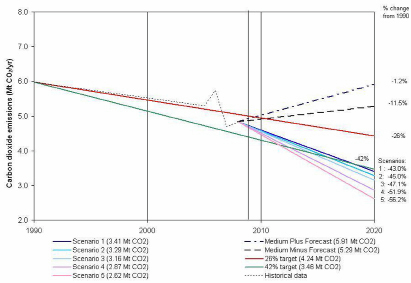
Conclusions
54. It has been assumed in this study that the savings in energy consumption by 2020 will be between 0% and 1% per year. The Committee on Climate Change recognises that in the UK, where a high proportion of electricity is used in buildings, there will be a long lead time between taking action to save energy and realising those savings. In the shorter term – up to 2020 – the main means to move towards a lower carbon economy is to supply electricity efficiently and to generate electricity by renewable means. For NI, this policy will realise the benefit of enhanced security of supply and, if the conclusions of the Stern Report are accepted, it will be more economic to adopt an aggressive, proactive policy of developing renewables now than paying the cost of mitigating the consequences later.
55. The choice of the renewables' target penetration by 2020 is unlikely to be determined by compliance with UK carbon emissions' targets as all the Scenarios studied meet the more onerous of the two overall targets – that of the Committee on Climate Change target at 42 % reduction. The choice is more likely to be driven by the cost and benefit of the technology, especially security of supply.
56. At higher levels of electricity generation by renewable means, Scenarios 3, 4 and 5 pose different problems in terms of implementation.
- Scenario 3 (High Wind) does not permit fossil fuel plant to be retired. The cost of maintaining the same capacity of fossil fuel plant at a lower capacity factor is a disadvantage offsetting the 'free' fuel cost of wind power. Wind therefore only partially solves the problem of security of supply. The real cost of running fossil fuel plants intermittently needs to be established.
- Scenario 4 (High Tidal) suffers in that the technology is not yet mature and its final costs less certain than wind of biomass. It too is 'free' fuel resource and is intermittent. Therefore it poses similar problems to the high wind Scenario and until technology can be better developed will be more costly
- Scenario 5 (High Biomass) has the advantage that additional fossil fuel plant could be retired, hence the costs are lower than Scenario 3 and 4. Its main disadvantage is that although the fuel could be grown sustainably, a large proportion would have to be imported giving rise to continued concerns of security of supply. based on studies of biomass supply chains undertaken in other parts of the UK, it may be that further study could confirm that a higher proportion of biomass could be cultivated in NI initially considered.
Recommendations
57. The following recommendations were made:
- Baseline data for electricity generation and green house gas emissions be established formally in NI for reference use in all future work in connection with climate change programmes
- Modelling of the grid generation scenarios is undertaken to determine the effect of intermittent operation of the fossil fuel plant on renewable generation and vice versa
- Modelling of the transmissions grid should be undertaken to determine for the scenarios considered the effect on the grid in terms of strengthening required and connection with renewable energy plant
- A sensitivity analysis should be undertaken to determine how the systems operation and cost to consumers is affected by such variables as the level energy consumption reduction achieved, future price of fossil fuels, electrification of the vehicle fleet and fuel poverty
- A study to determine how much biomass to be used for power generation could be grown in NI.
- An Implementation Plan is drawn up based on the results of the Consultation on renewable electricity targets and further consideration of the renewable power generation strategy to be adopted.
Annex C
Executive Summary of Renewable Heat Study
Introduction
This report provides a comprehensive view of heat demand and consumption in Northern Ireland, the renewable energy resources and technologies which can be used to provide renewable heat, and the potential for providing renewable heat with incentive mechanisms to meet a 2020 target, currently set at 10%.
The scope of this work requires a significant amount of data to be presented which is contained in the chapters and summaries throughout this work. Therefore this executive summary is used to present the high level conclusions and recommendations from the work and the reader should consult with the relevant chapters for more detail.
Northern Ireland's current heat demand and use of renewable heat.
Northern Ireland currently consumes 23.0 TWh of energy a year for producing heat to meet a heat demand of 17.4 TWh per year. This level of demand per person is comparable with other parts of the UK, and better than some other European countries surveyed. The majority of this energy comes from imported oil and imported gas, which poses future uncertainties around fuel security and cost for Northern Ireland.
The domestic sector is responsible for 61% of heat use in Northern Ireland and is therefore a key target for the development of renewable heat. The large industrial sector is responsible for 22% of the overall heat demand with a large fraction of this from two cement works. A small number of large scale installations in the industrial sector could therefore make a significant impact on renewable heat targets in Northern Ireland.
The heat demand has been mapped enabling locations of heat demand to be identified by sector and fuel type, and heat density analysis to be conducted for assessing the potential for district heating schemes. The maps below show the whole of Northern Ireland and then Belfast, with red areas showing high heat density, and green areas low heat density. The map clearly shows that most of the area of Northern Ireland, being rural, has very low heat demands, but that there are a significant number of urban areas with high density demands.
Overall, Northern Ireland's heat demand is predicted to drop from 17.4 TWh per year to 16.7 TWh per year with rises in demand from new development being outweighed by reductions in demand with efficiency improvements in the existing sector.
The level of renewable heat in Northern Ireland is currently relatively low at 1.7% of overall demand and this is mostly met by biomass, with a small amount from heat pumps and solar thermal systems.
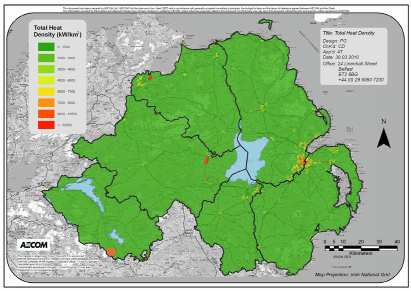
Figure 1: Heat density map of Northern Ireland.
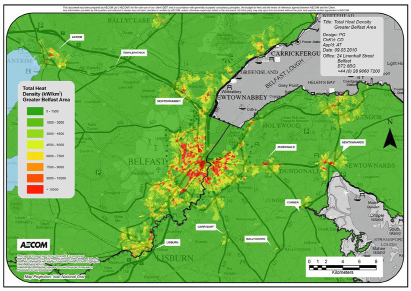
Figure 2: Close up showing heat density map of Belfast.
Renewable resource potential
Northern Ireland is one of the least forested countries in Europe and the current availability of home-grown biomass is therefore limited to around 4 – 5% of overall heat demand. An increase in potential from biomass would therefore require extensive growth of energy crops which could provide another 5% of heat by 2020 (assuming 2.5% of the agricultural land is used) or the import of biomass from the Republic of Ireland or overseas.
The extensive farming industry in Northern Ireland could be used to help develop a biogas industry with farm and animal wastes, and grass being digested in anaerobic digestion systems. In total there is a potential for around 2.9 TWh of biogas per year corresponding to about 15 – 16% of the 2020 heat demand.
There are a number of geothermal opportunities in Northern Ireland where heat can be extracted from 2,500 – 3,000 metres below the earth's surface providing a source of "free" heat. The use of geothermal energy requires the extensive development of district heating in a number of towns and this report makes recommendations on how this can be achieved and supported.
Renewable heat can also be obtained from heat pumps driven by electricity. These need to be carefully optimised to provide good efficiencies and the CO2 emissions associated with this method of delivering heat are closely linked to real efficiencies delivered and the grid electricity generation mix.
Overall, there is a significant potential for the generation of renewable heat in the short term, but in the longer term impacts in terms of renewable fuel import or indigenous expansion (in the case of biomass) and the support of heat infrastructure (district heating) is required to ensure these resources can be efficiently used.
Uptake and potential of renewable heat technologies and schemes
Building scale renewable heat generation
Analysis of the renewable heat supply curve for all domestic, commercial and public sector buildings (not large industrial users) shows that there are a number of potential applications which may be cost effective and which currently do not use renewable heat. These "low hanging fruit" should be targeted and mechanisms used to help overcome the non-financial barriers which may be preventing take-up of renewable heat.
The overall costs for providing renewable heat remain relatively low at around 5 p / kWh above the current heating costs up to a total of 6 TWh or about 40% of the 2020 demand. This suggests that this proportion could be met by renewable heat with a relatively low incentive. Beyond 6 TWh the costs become much greater due to a lack of suitable technologies and resource.
The net costs of providing renewable heat are predicted to be around £25 million per year for achieving the 10% target, and then about £8.8 million per year for each 1% above 10%.
Community scale district heating
The high level analysis in this report suggests that 30% of heat demand in Belfast and other towns could have potential for being met by district heating networks where heat is distributed via a system of insulated pipes from a central generator. This allows the use of much larger and more efficient renewable heat technologies such as biomass CHP and geothermal systems, and also enables the capture of waste heat from schemes that would otherwise just generate electricity.
The Belfast Urban Area represents the best technical opportunity for developing a heat network, with an overall demand of 2.4 TWh (or 13.6% of the current Northern Ireland heat demand). This could be met by the waste heat from a single large biomass power station if sufficient biomass can be obtained. A number of other smaller towns also show potential for district heating including those with geothermal resources.
The overall costs of heat from district heating systems is generally higher than for existing fuels and technologies, but similar or lower than for smaller building-scale renewable options. In addition it provides a method for maximising the efficiency of renewable resources and a long term strategy for the widespread adoption of low and zero carbon heat in towns and cities.
District heating is used extensively in some European countries. Due to rising imported energy costs and energy security issues, Denmark developed widespread schemes in the 1970s by regulating connections in district heating zones resulting in over 60% of homes in Denmark now connected to a scheme.
If further analysis shows that district heating schemes are a preferred option, the barriers and costs associated with developing large scale energy infrastructure will require financial and political support in Northern Ireland. Due to the longer term cost benefits and resource efficiency opportunities it is recommended that further detailed analysis is conducted into the potential for district heating.
Biogas
There is a considerable theoretical potential for the development of biogas schemes in Northern Ireland which needs to be exploited. However biogas technologies in the UK are currently in their infancy and this report assumes that ten 1MWe equivalent schemes could be developed by 2020, with a theoretical potential for around 100 such schemes in total.
The generation of biogas for injection into the gas grid appears to be the most resource and cost efficient means to generate renewable heat, but there is also potential for anaerobic digestion CHP schemes to be developed where there is a local demand for the waste heat.
The location of biogas schemes is critical to their success to ensure that feedstock can be locally and cheaply sourced, the digestate can be distributed for fertiliser, and there are opportunities for the export of heat or injection of biogas. The best option could be a series of community scale schemes which are large enough to be relatively economic, but local enough to minimise feedstock and digestate transportation.
Large industrial sites
The 17 large industrial sites which fall under the EU-ETS account for 22% of Northern Ireland's heat demand, with the two cement works accounting for over half of this. Further detailed analysis is required for all these sites to assess the potential for renewable heat, but a few major installations in this sector could have a large effect on the overall renewable heat take up in Northern Ireland.
New development
Efficiency levels and CO2 emissions from new development will be governed by future Building Regulations which are expected to be similar to those proposed for England, leading to 'zero carbon' homes and commercial buildings in the latter half of the 2010 – 2020 period.
The level of renewable heat in this sector will be largely driven by these Regulations, but could range from 0% (assuming high levels of energy efficiency and use of low carbon rather than renewable fuels) to 4.9% if all heat is met by renewable technologies. If all new dwellings were required to be fitted with solar water heating between now and 2020, then this would account for a 1% reduction in the 2020 demand.
Conclusions
A key aim of this report is to examine potential targets for renewable heat for 2020, and to identify methods of achieving these targets. However in the long term, a 2020 target will only ever form a stepping stone on to long term decarbonisation of heat and electricity in Northern Ireland. Therefore any target for 2020 should be compatible with longer term aspirations and solutions.
Out of the three options in this report, the generation of biogas is the most flexible – it does not rely on suitable heat demands, uses a long term resource, and produces a fuel which is flexible for grid injection, distribution via containers, or transportation applications (although this clearly does not contribute to heat targets). Therefore targets set for biogas generation are compatible with longer term aspirations.
This work demonstrates that a 10% target can be met relatively cost efficiently using building scale technologies alone. However further work is required to examine the potential for district heating in more detail and whether this could provide more cost effective savings in the higher density urban areas and open up access to additional resources such as geothermal. The following table shows a summary of the potential through each of the delivery mechanisms and the impact on net costs of providing the renewable heat.
Table 1: Summary of the potential and costs of delivering renewable heat through the various delivery mechanisms.
| Renewable heat delivery | Potential (% RH by 2020) |
Impact on targets. |
Annual incentive required (£million per 1% RH target) |
| Large industrial sector | Further analysis required but possible a significant potential. | The small number of applications and unknown viability means these applications should not be included in setting targets. | Unknown. Large scale energy consumers could mean that some of these applications are cost effective in the 2020 period. |
| Building scale | 10% or more. | The analysis demonstrates that a 10% RH target is achievable using building scale technologies. | £2.5 million per % to achieve 10%. £8.8 million per 1% above 10%. No cost below 6%. |
| District heating | Further analysis required but preliminary assessment suggests circa 30%. Potential by 2020 extremely limited unless significant shift in policy and regulation. | Potential for district heating should not contribute to setting a 2020 target due to long term development and barriers. | Up to £9.4 - £11.5 million Some areas may be cost effective if sufficient uptake can be achieved. |
| Biogas | 0.8% - 1.4% depending on biogas or CHP. Further potential in the longer term by approx 10 times. | Potential for circa 1% contribution to target setting depending on further analysis. | £8.2 million per 1% for biogas. £11.8 million per 1% for AD CHP. |
| New development | 0 – 4.9% | Other drivers will be more important in this sector. It is important that building regulations are consistent with other renewable heat policies. | Zero cost in terms of incentives if driven through regulation. |
There are a number of ways through which renewable heat targets can be achieved for Northern Ireland, some of which are additive and some of which are mutually exclusive. Most importantly, this report demonstrates that a 10% target should be achievable.
There are three main ways in which a 10% target for renewable heat can be met:
1. Large industrial / commercial sites. There are 17 sites in Northern Ireland involved in the European ETS scheme which account for 22% of Northern Ireland's heat demand. Due to the individual nature of these sites, renewable heat opportunities are not included in the targets, but they could have a significant potential. Provision of renewable heat in this sector requires further analysis of each site, and of the technical and financial viability of delivering renewable heat. There are also risks around the use of a small number of target sites, which may or may not exist in 2020.
2. Individual consumers market based. The renewable heat curve analysis for this work demonstrates that renewable heat is currently cost effective for a number of consumers, and can be achieved in many other applications at a net additional cost. This approach is market based and may require the use of incentives and support mechanisms to increase level of uptake. Further analysis is required on refining incentive options if this route is selected. In general, biomass options are currently cost effective in the larger commercial and public sector buildings, and air source heat pumps appear to have the lowest net resource cost for dwellings.
3. Community based schemes. This report identifies that many areas could be suitable for district heating schemes at a community level. In addition there is potential for the generation of heat and electricity, or biogas, from community biogas schemes. Community based schemes may have financial barriers and require some form of incentivisation, but there are many other non-financial barriers which may require public sector support. Further detailed analysis of the community options is required to examine the viability of this in more detail. Biogas might make a relatively modest (14%) contribution to meeting the 2020 target. Again, there may be competing uses for biogas which may limit this further - such as for renewable electricity generation near the feedstock location, or transportation.
The following table provides recommendations on how a 10% renewable heat market share can be achieved and how a support scheme can be developed. It also aims to identify which Government Department or agency should take the lead for each recommendation.
Table 2: Key recommendations.
| Targets and incentives | ||
| Conclusions | Recommendations | Lead Department(s) |
| Targets and incentives | ||
| 1. Achieving a 10% renewable heat share by 2020 is possible but will require Government intervention | Adopt a 10% target Develop a long term strategy for renewable and low carbon heat based on achieving a 10% renewable heat share by 2020, including options for incentivisation. This should include assessment of competition for resources and interaction with other energy sectors. Set up a cross departmental strategy group | DETI DETI DETI DOE DARD DSD DFP DRD OFMDFM |
| Developing a Northern Ireland Specific incentive scheme | ||
| 2. Develop a NI specific incentive scheme and Put in place interim measures. | Assess the potential for renewable heat provision, and develop options to most appropriately support large scale industrial schemes. Identify applications where renewable heat may currently be cost effective in the commercial sector, and assess current barriers and ways of overcoming these. Investigate in further detail and develop a renewable heat incentive (RHI) for small and medium scale projects in the domestic and commercial sectors where options currently are not cost effective. Conduct an Impact Assessment (IA) of potential options. Consider the appropriateness and the cost of allowing the retrospective payment of incentives to eligible installations . | DETI Invest NI DETI Invest NI DETI DSD DARD DETI DETI |
Discussion and further work
Beyond the 2020 targets, we suggest that the path of de-carbonisation in NI should be guided by the most economic use of limited resources across all sectors - and most importantly heat and electricity. Such a path might well involve a greater use of district heating, to distribute CHP heat from low- and/or zero-carbon electricity generation for example. This is an area for further study, but its impact upon the position prior to 2020 will be limited given the timescales necessary for the roll-out of district heating in built-up areas.
Potentially the most significant observation is that the renewable heat market requires long term support, both politically and financially. Options for incentivising the market and a methodology for reaching a 10% target are also included in this report. However, these will need to be carefully considered on a cross departmental basis to ensure a long term solution is agreed.
The key observations are as follows:
1. Renewable heat cannot be considered in isolation and other forms of low carbon heat, such as natural gas, and other energy sectors such as electricity generation and transportation all need to be considered to ensure that renewable heat plays the best part it can in the Northern Ireland energy mix. The draft SEF published in July 2009 gave an overview of energy policy in Northern Ireland and identified the need for a balanced energy portfolio going forward.
2. The SEF also recognised the potential benefits of further natural gas roll-out in both existing and potential licensed areas as a low carbon alternative to other fossil fuel sources. A strategy to increase the levels of renewable heat should be developed in tandem with a strategy to maximise natural gas uptake where appropriate.
3. Renewable resources (particularly biomass) are limited in Northern Ireland and the cost effectiveness of different resources and technology options varies. Northern Ireland therefore needs to consider how different resources and technologies are supported through policy and regulation to ensure maximum cost benefit and CO2 savings. One outcome of this may be a form of spatial energy planning.
From these three observations, a number of next steps are proposed. The following table shows the suggested next steps alongside appropriate delivery partners.
Table 3: Suggested next steps
| Conclusions | Next Steps | Lead Department(s) |
| Biogas | ||
| Develop a biogas road-map for Northern Ireland. Incentivisation of biogas requires further analysis of options and support mechanisms including economic and non-economic barriers. | Conduct a detailed assessment of the biogas potential leading to the development of a biogas roadmap. This should provide an economic assessment of biogas options and the level of incentivisation required. Geographic supply – demand analysis of feedstock distribution, digestate distribution potential, and heat demands and gas network location. Technical and economic assessment of biogas system chains to identify the most appropriate biogas system options for Northern Ireland. This should include non-heat uses such as transportation and electricity generation | DETI DARD DOE DETI DARD DOE DETI DARD DOE |
| Biomass | ||
| Develop a long term strategy for biomass to provide confidence to consumers, incentivise the uptake of renewable heat, maximise the resource availability and manage competition with other sectors. | Investigate the practical level to which home grown biomass could be developed. Examine the environmental impacts of increasing the use of energy crops including impact on other sectors such as food production. | DARD DOE |
| Conduct a resource and demand assessment which considers all other potential biomass applications, for example, electricity generation and transport fuels. | DARD DETI | |
| Investigate the potential for a public sector Biomass Agency to help coordinate biomass activities and provide long term support to markets and confidence in price. | DARD | |
| Develop a strategy / policy for the import of biomass fuel to ensure there is a cost-effective security of supply | DARD | |
| Technologies, resource, and strategy options | ||
| Community heating schemes could have a large potential for the distribution of low and zero carbon heat. | Conduct more detailed analysis of district heating options, including the costs associated with retrofit of DH schemes in Northern Ireland. This work should compare the costs of DH options with stand alone solutions to identify the most appropriate strategy in each area. | DETI DSD |
| Detailed assessment of district heating case study sites including Belfast Urban Area and geothermal areas | DETI DSD | |
| Spatial energy planning could provide an economic way forward for incentivising and support the most appropriate solutions. | Assess the potential for developing a spatial energy planning approach in Northern Ireland Review the approach taken in GB with the PPS 1 supplement, and in other European countries such as Denmark | DOE DRD DOE |
| Develop a strategy for implementing spatial energy planning in Northern Ireland if appropriate examining the planning framework and regional policy and regulation. | DOE DRD | |
| Biomass technologies are the most cost effective option in the commercial sector but there are concerns over air quality, and biomass pellet quality. | Assess the impact of biomass technologies on air quality in urban areas of Northern Ireland Develop a set of criteria which can be used to determine the type and scale of biomass technologies which can be used in Urban areas | DOE DOE |
| Examine current air quality standards to ensure these are appropriate and do not unnecessarily hinder the development of renewable heat in urban areas. | DOE | |
| Review standards from across Europe and adopt biomass pellet standards which will provide consumers with confidence in the quality of biomass pellet products. | DARD DETI | |
Annex D
Energy Responsibilities of Other Departments
Given the importance of the land based sector with regard to bioenergy, DARD has been a key player within the Bioenergy IDG and its recently published Renewable Energy Action Plan will be an important element in the revised cross Departmental Bioenergy Action Plan. Both DARD and AFBI are also members of the Offshore Project Steering Group representing respectively the interests of the commercial fishing community and providing access to marine data. DARD, through the Loughs Agency, also has a role in relation to the protection of inland waterways / fishing and its interaction with hydropower schemes.
DCAL is a member of the Offshore Project Steering Group given its role with regard to the protection of salmon fishing and has also been working with NIEA in relation to the guidance for hydropower and fishing projects.
DFP is responsible for energy on the government estate.
DOE and NIEA have a number of roles in relation to the development of renewables through the Planning Service, onshore and offshore environmental protection and conservation activities, waste management and climate change. On this latter point, DOE has recently set up a Cross Departmental Working Group on Greenhouse Gas Emissions. DOE is represented on both the Bioenergy and Offshore Renewable Energy Groups and NIEA contributes to the offshore renewable work and has been developing policy guidance for hydropower and fishing projects.
DRD represents the interests of the ports and harbours and general navigation issues and is also responsible for the Regional Development Strategy.
DSD has responsibility for energy efficiency in the housing sector.
DEL has a key role in the provision of training and skills and is currently working on draft Terms of Reference for a proposed Research Study into the skills needs of the Northern Ireland Sustainable Energy Sector. This study has been agreed by DEL's Departmental Board as a first step in terms of identifying and meeting the needs of this emerging and important sector.
OFMDFM has responsibility for the overarching Sustainable Development Strategy and its associated action plan.
Other Departments, such as Education and Health have large estates and sustainable energy is a key interest.
Annex E
Onshore Renewables Strategic Environmental Assessment Scoping Report
[see separate attachment]
Annex F
Draft Offshore Renewable Energy Action Plan
Contents
Ministerial Foreword
1 Introduction
- Strategic Energy Framework
- EU and UK Renewable Energy Policy
- Current and proposed NI Renewable Electricity Targets
2 The Productive and Sustainable use of the sea
- Economic benefits of offshore renewable energy
- Economic activities of other users of the sea
3 The Strategic Environmental Assessment (SEA) and the draft Strategic Action Plan
- Draft Strategic Action Plan
- Draft Environmental Report
- Results of the SEA
4 The Draft Strategic Action Plan 2009-2020
- Development of the Strategic Action Plan
- Its aim
- The Crown Estate and a competitive call
- Key actions
5 Reporting, Monitoring and Evaluation
6 Next Steps and how to respond to the Consultation
1. Introduction
Strategic Energy Framework 2009
1. The Department of Enterprise, Trade and Investment (DETI) recently consulted on a new Strategic Energy Framework (SEF) 2009 for Northern Ireland. It sets out a vision for a much more sustainable system where energy is used as efficiently as possible; where much more of Northern Ireland's energy is from renewable sources; and where Northern Ireland ensures that all generation is as competitively priced as possible.
2. Four key energy themes have been identified within the draft SEF 2009:
Competitiveness
Northern Ireland remains overly dependent on fossil fuels for power generation, heating and industrial use. Energy will become increasingly expensive as fossil fuel resources decline, along with increased costs from EU and UK requirements associated with climate change. These requirements do, however, offer an opportunity for economic development in the energy and energy technology supply markets created by the Low Carbon agenda. They also encourage improved competitiveness through the deployment of sustainable energy practices and technologies.
Accessing Northern Ireland's plentiful renewable energy resources and increasing levels of renewable energy generation remains the most viable option to reduce dependency and create greater price stability than is currently available.
Security of supply
Energy security is an issue of common European Union concern. With growing integration of regional energy markets and infrastructure, specific national and local solutions are often insufficient and DETI is working with counterparts in GB and ROI on complementary measures to strengthen both jurisdictions' security of energy supply policies and practices.
While previously seeking to ensure that power generation in Northern Ireland was not wholly reliant on one particular fossil fuel, DETI acknowledges the limitations of this approach and will ensure that renewable energy is an integral part of the future security of supply strategy, while maintaining action on security of fossil fuel supply.
Sustainability
The drivers for ensuring that Northern Ireland's energy supply is sustainable -by which, in this context, we mean, "to meet the needs of present without comprising the ability of future generations to meet their needs" have never been greater. DETI recognises the part that traditional energy generation has played in climate change. Acknowledging climate change as one of the drivers for sustainability, DETI will seek to achieve energy efficiency goals and increase the use of renewables used at an ambitious rate.
DETI has identified the need for a co-ordinated approach across Departments to deliver a programme of actions across the range of renewable energy technologies and has established the Sustainable Energy Inter Departmental Working Group, led by the DETI Minister.
Infrastructure
Significant electricity grid strengthening is planned throughout the UK and ROI to carry out modernisation work and manage increasingly higher levels of renewables, particularly onshore wind. In Northern Ireland, major grid strengthening and ongoing interconnection with neighbouring networks are being planned. In addition, consideration will be given to the further growth of the natural gas network and the development of gas storage.
3. The overall aim of SEF 2009 is to set out the direction of travel on energy policy for the energy industry and consumers, the key milestones and targets associated with this approach and to send clear signals of Government's priorities over the short to medium term. It provides the overarching framework for the range of actions to develop Northern Ireland's renewable resources, including offshore wind and marine renewables. Consultation on the draft SEF 2009 has recently closed and DETI is considering the responses and plans to issue a finalised SEF in early 2010.
EU and UK Renewable Energy Policy
4. In Spring 2007, EU leaders agreed to create a common European Energy Policy. This has resulted in the EU vision for energy in the period to 2020 based on three fundamental pillars of sustainability, security of supply and competitiveness.
5. The EU Renewable Energy Directive (RED) which was agreed and published in June 2009 has set an EU target of 20% renewable energy consumption i.e. across electricity, heat and transport, by 2020, including a specific 10% target for biofuels. As a Member State, the UK target has been set a target of 15% renewable energy by 2020 with a 10% biofuels target. In addition to these headline targets to be achieved by Member States, the RED also requires the development of a National Action Plan including a series of actions to be undertaken to facilitate this growth e.g. administration procedures, regulations and codes; information and training; access to the electricity grid and sustainability.
6. While energy policy is a transferred matter and therefore the responsibility of the NI Assembly, DETI continues to work closely with Department for Energy and Climate Change (DECC) on a wide range of UK wide activities, where it is appropriate and beneficial for Northern Ireland to do so.
7. Northern Ireland Departments contributed to the Low Carbon Transition Plan suite of documents published by DECC in July 2009, including the UK Renewable Energy Strategy (RES). The UK RES sets out the overall UK Plan on how it will achieve the EU target of 15% renewable energy by 2020. It contains a wide range of actions to facilitate, incentivise and support the increased use of renewables by Government, businesses, communities and individuals. Specific measures have been identified to encourage investment, remove barriers and bring forward the deployment of less well established technologies and currently more expensive, such as offshore wind and marine renewables.
8. The UK RES acknowledges that the Devolved Administrations are developing their own specific approaches to meet their particular circumstances. DETI will continue to work with DECC, its new Office for Renewable Energy Deployment and other relevant cross cutting groups as well as the other Devolved Administrations. Northern Ireland will contribute to and participate, as appropriate, in the UK wide policy areas relating to the overall UK 15% renewable energy targets.
9. Established in 1999, the British Irish Council (BIC) comprises representatives for the British and Irish Governments, the Devolved Administrations of Northern Ireland, Scotland and Wales with representatives from the Isle of Man, Guernsey and Jersey. BIC acts as a Forum within which members can consult and exchange information with a view to co-operating on areas of mutual interest. The BIC Marine Energy Workstream has identified opportunities for greater communication and collaboration on areas such as Strategic Environmental Assessments, academic strengths, operational issues and communication with the EU on support for and acknowledgement of the importance of marine developments. This workstream can offer added value to the wide range of ongoing work within each of the administrations.
Current and Proposed Northern Ireland Renewable Energy Targets
10. Northern Ireland's current renewable energy target is that by 2012, 12% of electricity consumption should be met from indigenous renewable sources and, of that 12%, 15% should come from non-wind resources. Renewable electricity currently stands at 8.5% of electricity consumption and DETI expects that the 2012 targets will be achieved, primarily from onshore wind. To date, there has been limited commercial scale development of non-wind renewable energy in Northern Ireland.
11. Onshore wind energy is currently the most readily available and affordable renewable energy for power generation and it is envisaged that it will continue to be the principal source of renewable electricity generation. The 2008 All Island Grid Study concluded that it was technically feasible for up to 42% of power generation to be from renewable sources, mainly from onshore wind. However, DETI is actively seeking to diversify Northern Ireland's renewable energy portfolio.
12. SEF 2009 has proposed a new strategic objective to increase the amount of electricity from renewable sources to 40% by 2020. This proposal is based on work to establish the evidence base for a number of possible scenarios for increased renewable deployment. No scenario will represent a firm prediction of what our energy mix will look like by 2020 – the market and investors will ultimately decide what will be built within the confines of appropriate market and environmental regulation - rather they represent realistic possibilities, given the renewable resources in Northern Ireland and the renewable technology development and possible deployment by 2020.
13. Technological, economic, environmental or other circumstances may change in respect of renewable energy and fossil fuel energies and DETI will keep the renewable electricity target under review during the period to 2020 with the aim of optimising the range of technologies capable of generating renewable electricity to meet SEF's overall vision.
The UK Marine Environment
14. "Our Seas – a shared resource ", published in April 2009, set out the UK High Level Marine Objectives which will form the basis of much of the work being undertaken both at the UK and NI level over the next few years to ensure the achievement of sustainable development in the UK marine area. The overall UK Government vision is for clean, healthy, safe, productive and biologically diverse oceans and seas.
15. The UK High Level Marine Objectives are
- Achieving a sustainable marine economy,
- Ensuring a strong, healthy and just society,
- Living within environmental limits,
- Promoting good governance and
- Using sound science responsibly.
16. The Northern Ireland Executive agreed to this vision and the High Level Marine Objectives. A number of Northern Ireland Departments eg the Department of the Environment (DOE), the Department for Regional Development (DRD), the Department of Enterprise, Trade and Investment (DETI), the Department of Culture, Arts and Leisure (DCAL) and the Department of Agriculture and Rural Development (DARD) have a key role to play in the sustainable development of the marine environment, which includes the development of its offshore renewable energy potential.
17. DETI has undertaken a Strategic Environmental Assessment of this draft Offshore Renewable Energy Plan to ensure that the potential impacts of such developments on the marine environment and other users are fully taken into account. This will not only inform the development of the draft plan but its subsequent implementation which will be taken forward within the principles of sustainable development.
Draft NI Sustainable Development Strategy
18. The Office of the First and deputy First Minister issued "Everyone's Involved "; Sustainable Development Strategy "in October 2009 for public consultation. DETI will contribute fully to the development of the Implementation Plan to emerge from this Strategy.
2. The productive and sustainable use of the sea
1. As noted in Chapter 1, Northern Ireland is likely to continue to meet a high level of its renewable electricity output from onshore wind. It is currently the most developed and cost effective renewable resource but its increasing deployment across Northern Ireland has to be carefully considered with regard to landscape and environmental issues. The recently published PPS18 supported the further development of renewables but noted key issues which had to be considered.
2. An increase in other technologies capable of contributing to the proposed 40% renewable electricity target would help diversify Northern Ireland's renewable portfolio and would reduce our reliance on onshore wind with a possible lower number of onshore wind turbines than may otherwise be the case. While offshore wind is more technologically challenging and currently more expensive than onshore wind, it does offer greater potential with stronger and more consistent wind which can provide higher power outputs and greater generating times.
3. Although earlier studies have confirmed offshore wind potential on the North and East Coasts of Northern Ireland, there are currently no offshore wind developments in Northern Ireland. The offshore wind sector has developed considerably over the last few years and this presents an opportunity for Northern Ireland to benefit from these developments in the rest of the UK, ROI and Europe which have already addressed a number of the technological and operational challenges and requirements facing the sector.
4. The technology to harness wave and tidal energy is at an earlier stage of development than offshore wind but has the potential to contribute a significant level of renewable electricity. As with offshore wind, it is currently a more expensive technology than onshore wind. However, marine renewables, in particular tidal, can, unlike wind, offer a much more predictable resource for grid management purposes. There has been promising progress in the last two/three years with the ongoing testing of technologies and different devices. The deployment of the 1.2 MW MCT Sea Gen tidal stream demonstration project in Strangford Lough in 2008 was the world's first commercial scale project to generate to a national grid. This innovative project has drawn international attention to the potential in Northern Ireland waters and a number of national and international companies have indicated their interest in investing in Northern Ireland and developing offshore renewable projects here.
Economic benefits of offshore renewables
5. In preparation for the SEF 2009, DETI commissioned work, in advance of this SEA work, to develop a range of possible scenarios for renewable electricity across all the renewable technologies. These scenarios included estimates for offshore wind and tidal ranging from 150 MW to 400MW by 2020 - wave was not included as its contribution by 2020 was considered by that study to be limited.[16] While DETI acknowledges that these figures reflect the significant challenges facing offshore renewables to be able to make a significant contribution by 2020, it considers that they are conservative and that higher levels could be achieved. In addition, it is also considered that greater offshore development would be seen in the post 2020 period as technology develops further.
6. Notwithstanding the reservations on these estimates, this work identified that such levels of offshore renewables could give rise to possible investment ranging from £330m to £880m by 2020, based on current investment costs of £2.2m per MW for offshore wind and tidal technologies.
7. In addition to such an investment, this same work considered the overall potential employment opportunities from renewables. With regard to offshore renewables, this is estimated to be 10 jobs per MW. The regional location of such jobs depends on the degree of maturity of the technology, the complexity of the supply chain and the proportion of jobs that flow abroad through the design and manufacture of machinery and technology. As the offshore sector is still relatively immature with only a few key companies, the potential Northern Ireland employment within this sector would be lower than this estimate but companies such as Harland & Wolff, B9 Offshore Developments and Deep Blue Renewables are already successfully working in this sector.
8. Additional income streams could also arise for ports with suitable infrastructure from the construction and maintenance of the wind, wave and tidal energy devices. For example, the study "UK Ports for the Offshore Wind Industry : Time to Act " (January 2009) identifies a potential market for UK ports totalling over £800m up to 2020, from the new offshore wind devices that will be required to be installed in UK waters to meet the UK Government's 2020 renewable energy targets. Some £110m additional income could be generated for ports by new wind farm developments in the Irish Sea alone.
9. DETI and Invest NI view renewable energy as an economic growth area and are currently undertaking work to quantify the benefits and supply chain potential of the offshore renewables sector through the DETI led Sustainable Energy Inter Departmental Working Group and through studies undertaken in collaboration with counterparts in the Republic of Ireland. Chapter 4 sets out further details on how Northern Ireland companies can be encouraged and supported to develop these new markets.
Economic Activity of other Users of the Sea.
10. Northern Ireland's waters are already productive and provide direct and indirect economic benefits from a number of other sectors and industries – for example tourism, recreational angling, the commercial fishing industry, the telecommunications sector and ports and harbours. The Environmental Report considers the potential impact, mainly in environmental terms, on other users of the marine environment and proposes mitigating actions, where appropriate, to avoid or lessen any potential adverse effect.
11. Consideration has also been given to the contributions which these other main sectors make to the Northern Ireland economy. This is not a detailed socio-economic analysis but acknowledges, at a strategic level and using information from existing published sources and studies, the contributions from these other sectors. This is set out at Annex A. A more detailed analysis of the impact of individual offshore renewable projects on other users would be required at site specific level to meet the Environmental Impact Assessment requirements.
12. By implementing the strategic level mitigating actions identified in the recommendations of the Environmental Report, which aim to avoid or reduce any adverse impacts on the environment and other users, DETI considers that any adverse socio-economic effects could also be avoided at a strategic level. DETI would plan to develop offshore renewable electricity in line with the overall principle of sustainable development and productive use of the seas. We will continue to actively engage with stakeholders and existing commercial businesses to ensure that other marine sectors and potential conflicts of interests are taken into account throughout the implementation of the Plan.
Question on Chapter 2
Do you consider that the strategic economic benefits of renewables and other user users have been identified? If not, please tell us what should also be considered within this Strategic Action Plan.
Section 3
1. In compliance with the EU Strategic Environmental Assessment Directive[17], this draft Strategic Action Plan (SAP) has been the subject of a Strategic Environmental Assessment (SEA). The purpose of the SEA is to integrate environmental considerations into the preparation and adoption of plans with a view to promoting sustainable development.
2. The SEA, which is being undertaken by AECOM consultants, has been managed by a DETI led Project Steering Group (PSG) comprising of other relevant NI Departments and key organisations i.e. DARD, the Agri-Food and Bio-sciences Institute, DoE, the Northern Ireland Environment Agency, DCAL, DRD, The Crown Estate and the Maritime and Coastguard Agency.
3. The SEA is a system of incorporating environmental consideration into strategic plans at an early stage of their development. There are a number of key stages within the SEA process - one of which was the development and public consultation in May 2009 of the Scoping Report. The Scoping Report set the context for the SEA, identified the topics to be considered, presented the baseline data and approach to be used to assess the effects which the development of offshore renewable energy might have on the environment and other users. The feedback on the Scoping Report from a wide range of key stakeholders who attended the seminar or commented on the report was very useful in developing the draft Environmental Report.
The draft Strategic Action Plan 2009-2020
4. The overall aim of the SAP is to optimise the amount of renewable electricity generated from offshore wind and marine renewable resources in Northern Ireland's waters (i.e. out to 12 nautical miles) in order to enhance diversity and security of supply, reduce carbon emissions, contribute to the proposed renewable electricity targets by 2020 and beyond and develop business and employment opportunities for NI companies. The development of this resource will take into account the protection of the environment and the needs and interests of other users of the sea.
5. It will provide the framework within which offshore renewable energy can be developed through a competitive call, to be undertaken by The Crown Estate, for commercial projects. The SAP identifies a programme of enabling actions which will be essential to the development of this resource. It also includes actions to maximise the market opportunities to Northern Ireland companies of the development of offshore renewables, not just in Northern Ireland waters but throughout the British Isles to ensure they are well placed to capture the associated economic gains in terms of new business and employment opportunities.
The draft Environmental Report
6. The draft Environmental Report (ER) reviewed the overall energy and renewable policy context at EU, UK and local level. It also considered the marine environment policies including the current work on the UK Marine and Coastal Access Bill and the proposed NI Marine Bill and the implementation of the Marine Strategy Framework Directive.
7. It addressed the following SEA topics which could be affected by the draft SAP:
- Water, soil, sediment,
- Biodiversity, flora and fauna including fish, birds, marine animals and mammals,
- Cultural heritage including archaeological heritage,
- Population and human health including commercial fisheries, ports and harbours, recreation and tourism,
- Material assets such as cables/ pipelines ,
- Landscape/seascape,
- Climactic factors.
8. Earlier studies had identified offshore wind resource off the North and East Coasts and tidal resource off the North Coast, around Rathlin, off the Copeland Islands and in Strangford Lough, where the MCT Sea Gen 1.2MW tidal stream demonstration project is currently operating. While more limited, wave resource had been noted off the North Coast. A review of the main characteristics of current offshore renewable energy devices was also undertaken as part of the ER.
9. For each of the SEA topics at 7 above, the ER undertook a generic assessment of offshore developments in Northern Ireland waters, considering the characteristics of the different technologies. This assessment was then refined to focus on the key resource zones which had been identified by earlier studies and developer interest.
10. The resource zones are set out in Annex B. Again each SEA topic was considered within each of the resource zones, but still at a strategic level. While the SEA focussed on these resource zones, this would not preclude development outside these zones as all Northern Ireland waters have been covered in the generic assessment. This was then followed by a cumulative assessment which considered a number of possible future development scenarios and reviewed the cumulative effects of different levels of development within each of the resource zones. The cumulative effects of other plans and programmes were also considered.
The results of the SEA
11. In light of these assessments, the ER has concluded that between 900MW and 1200MW of electricity could be generated by 2020 from offshore wind and marine renewables (tidal arrays) in Northern Ireland waters, without significant adverse effects on the environment.
12. In terms of offshore wind, there is the potential for between 600 MW and 900MW to be developed in two main zones –one off the North Coast and the other off the East Coast. The main factor influencing the possible amount that could occur is the potential for offshore wind farm developments to have an effect on the Giant's Causeway World Heritage Site and the Causeway Coast AONB. The level of likely effect would be influenced by the location, size and configuration of any offshore wind development, with potential effects reducing with distance offshore and to the west of the overall study area. The ER considered that any potential effects on seascape would need to be assessed in greater detail at the project design and development stage.
13. As regards tidal development, of the 5 resource zones noted in Annex B, the 3 smaller zones at Maiden Islands, the Copeland Islands and Strangford Lough have not been considered suitable for commercial scale development, due to potential significant adverse effects on the environment and other users. This leaves tidal resource zones on the North Coast and round Rathlin Island and Torr Head which could contribute 300 MW.
14. Given that there is limited potential in terms of wave resource, this technology has been excluded from the overall potential target setting. However, this does not preclude wave development from the SEA or inclusion within this overall Plan, should projects come forward.
15. The results above reflect the main findings of the SEA but the ER notes that there are still notable gaps in some baseline data, in particular relating to benthic ecology, seabirds, marine mammals and reptiles and commercial fisheries. The likely significance of effects will also be influenced by the particular characteristics of the projects being developed (including the effective use of mitigation measures identified for each resource zone) and the locations within the zones in which they are deployed.
16. The ER recommends that DETI should establish an Offshore Renewable Energy Forum, building on its existing cross departmental Project Steering Group, to engage with relevant external stakeholders. The Forum would help advise on the ongoing development of this draft Plan.
17. A fundamental element of the SEA process is mitigation to avoid or reduce the potential effects on the environment and other users. In this case, the ER has proposed measures, on which the Forum would advise DETI, at Strategic Action Plan and also project level as follows:
- Consider a cross departmental approach to filling strategic data and knowledge gaps and increasing the collection and availability and accessibility of current data sets.
- Promote proposals for the adoption of a "deploy and monitor "approach to the deployment of commercial scale development on a phased approach, to increase knowledge of possible impacts as well as building on information from other developments such as those being deployed in the Pentland Firth.
- Examine the opportunities of preparing locational guidance to assist developers, stakeholders and decision makers in the selection of specific sites for development.
- Develop a project level mitigation strategy to ensure that the necessary mitigating actions, as identified in the ER, are satisfactorily considered and addressed as individual projects come forward –e.g. that certain surveys/monitoring regimes would be a requirement for development consent .
18. Subject to the outcome of the public consultation process on the ER and the SAP, DETI would plan to include these mitigation measures as actions within a finalised SAP.
19. The above is a brief resume of the ER and its key findings and recommendations. The ER, which is an extensive and technical document along with a Non –Technical Summary and this draft Plan can be found on the dedicated SEA website www.offshorenergyni.co.uk
Questions on Chapter 3
On the basis of the assessments carried out in the ER, do you agree with the overall results and proposed mitigation measures (paragraphs 11 -18).
If not, please tell us why. Please note that the above is a resume of the extensive ER which contains the detailed analysis behind the overall results.
4. The Draft Strategic Action Plan 2009-2020– proposed aim, targets and key actions
The Development of the SAP
1. DETI has developed this draft SAP to set the overarching framework for a competitive call, to be undertaken by The Crown Estate for commercial projects. It includes a range of short, medium and longer term actions to facilitate the development of offshore wind and marine renewable energy in Northern Ireland.
Aim of the SAP
2. The overall aim of the SAP is;
to optimise the amount of renewable electricity generated from offshore wind and marine renewable resources in Northern Ireland's waters in order to enhance diversity and security of supply, reduce carbon emissions, contribute to the proposed renewable electricity targets by 2020 and beyond and develop business and employment opportunities for NI companies.
The development of this resource will take into account the protection of the environment and the needs and interests of other users of the sea.
3. The following overall target is proposed, subject to the outcome of this consultation:
To develop at least 600 MW of offshore wind and 300 MW from tidal resources in Northern Ireland waters by 2020.[18]
4 The draft SEF 2009 indicated a direction of travel for energy and renewable energy to 2020, but the detailed breakdown will depend on how investors respond to the market and overall investment and economic conditions. On the basis of the ER assessment, it is clear that offshore renewables have the potential to make a significant contribution to the proposed 2020 renewable electricity targets.
5 .The current global recession makes it more difficult to state how quickly these less commercially developed and currently more expensive technologies will be deployed , compared to ,e.g. onshore wind. We do, however, want to send a strong signal to the sector of our intention to move forward and optimise the contribution from offshore renewables and this draft Plan sets out the strategic framework for a range of actions to encourage and facilitate that deployment.
6. DETI will keep these MW targets under review in light of the ongoing development and deployment of offshore renewables and progress against the range of actions set out within this Plan over the next few years.
The Crown Estate and a competitive call
7. The Crown Estate (TCE) is one of the UK's largest property owners with significant urban, rural and marine estate. It is an independent organisation whose surplus revenue is paid to HM Treasury. TCE's marine estate includes over 55% of the UK's foreshore, the beds of tidal rivers and estuaries and almost all of the seabed out to the 12 nautical miles territorial limit around the UK. In recent years, TCE has worked with the offshore wind sector to develop these resources. On completion of the SEA of DECC's proposals to develop 25GW through nine zones in GB waters and the Renewable Energy Zone, TCE is now proceeding with a Round 3 offshore wind development. This Round does not include Northern Ireland waters.
8. Following the completion of an SEA assessing the potential for wave and tidal energy in Scotland by the Scottish Government in 2007, TCE announced in September 2008 an application process for commercial sea bed lease options in the Pentland Firth strategic area for marine energy devices. In response to the competitive call, 42 applications were received for wave and tidal deployment and TCE in May 2009. TCE is currently evaluating these applications and would plan to issue agreements for commercial leases in early 2010.
9. Through the GB Offshore Wind Rounds and the Pentland Firth development, TCE has built up significant expertise in working with Governments and the renewables sector to develop these offshore resources. Its stated policy is that, in addition to developments at Pentland, other areas with suitable resources will be offered to the market in due course taking into account a range of factors, including developer interest.
10. As regards offshore developments in Northern Ireland, DETI has actively engaged with TCE and will continue to work closely with them through the remaining stages of the SEA and post -SEA process to take forward a competitive call for commercial projects in Northern Ireland waters in 2010-2011. While each geographical location presents different circumstances and challenges, the experience gained to date throughout the rest of the UK can benefit developments in Northern Ireland waters and enable offshore renewable energy make its contribution to NI and overall UK renewable electricity targets for 2020 and beyond.
11. An estimated timeline, which would be subject to review as the SAP progresses, is as follows:
| Spring 2010 | Finalisation of the SAP post SEA |
| By end 2010-2011 | TCE competitive call for projects |
| By end 2011-2012 | Possible TCE agreements for lease |
| By end 2012-2013 | Consenting/licensing considerations, including EIA requirements. |
| 2014 -2015 onwards | Initiation stages for projects leading to subsequent deployment. |
Key actions
12. There are a number of critical actions which will need to be addressed to support the overall aim and which can be grouped as follows:
- the Electricity Grid;
- Infrastructure and Supply Chain;
- Regulatory and Legislative Framework and
- Support regime.
The Electricity Grid
12.1 Develop an appropriate reinforcement programme of the NI Grid, to be completed in time to handle efficiently the increasing renewable electricity generated offshore.
Electricity networks transport electricity from the point of generation to the point of use. Connection to a robust grid system within an appropriate timeframe is an essential enabler for all renewable technologies and will be a critical issue for offshore generation.
The All Island Grid Study, published in January 2008, concluded that it was technically feasible for up to 42% of power generation to be from renewable resources. This would, however, only be possible in the context of a significant grid strengthening programme. The Grid Study concluded that some 200km of new grid transmission and around 1500km of grid distribution network would be required to manage this higher level of renewable power generation. Irrespective of accommodating the higher levels of renewables, the grid is comparatively weak in the West of Northern Ireland, and this must be addressed to protect customers from unplanned power outages in that area.
NIE ( the Grid owner ) in co-operation with , SONI, ( the System Operator ) and through liaison with DETI and NIAUR ( the Northern Ireland Authority for Utilities Regulation) has been engaged in preparing options for grid strengthening through its Renewables Integration Development Project to address current weaknesses and manage the projected higher levels of renewables. Initial estimates suggest that this overall programme of improvements could cost around £1billion over the next ten years with an expected lifespan of 40 years. This would be the most significant upgrade of the electricity Grid in Northern Ireland since the 1960s and will mirror developments in the ROI where Eirgrid is planning some £4billion Euros investment to 2025 and across GB, where network upgrading to 2020 will cost over £4.5billion. This work will include consideration of the generation from offshore renewables. The draft ER proposes that consideration should be given the possibility of offshore hubs to serve a number of developments.
The plan to increase the level of renewables to the 40% proposed in the draft SEF and the associated Grid work to accommodate it is now the subject of a separate SEA which will take into account, as appropriate, the research and findings of the offshore renewables SEA. It is expected that the Grid SEA will be completed in early 2011.
As part of the development of the grid proposals there may be an opportunity to examine options for coordinating onshore and offshore development activities required to support offshore wind, wave or tidal development that may occur in a similar location. This could have a number of benefits in terms of reducing the potential environmental effects associated with cabling by coordinating and focusing the provision of specific infrastructure requirements e.g. onshore connections and reducing costs and increasing confidence amongst developers.
12.2 Complete work by 2010 with Scotland and the Republic of Ireland on the joint Isles Project to assess the potential for an offshore regional marine electricity grid linking Ireland and Scotland and consider its findings and recommendations.
In addition to the planned work to strengthen the onshore Grid and accommodate onshore and offshore renewables, DETI is working with the Republic of Ireland and Scotland on the potential for an offshore grid. The study will examine the feasibility of the construction of an offshore electricity transmission network linking potential offshore sites of the west coast of Scotland, the north and east coasts of Northern Ireland , the Irish Sea and the west coast of Ireland. The study is estimated to cost £1.6m and is being supported by the three Governments and the EU Interreg IVA programme. It will quantify the long-term strategic benefits that could arise from such a development and will propose a business case for the construction of the grid. Key issues for consideration will include technology and infrastructure, environment and planning, regulation, finance, construction and deployment.
Infrastructure and Supply Chain
12.3 Continue to work with Invest NI, The Crown Estate and others in promoting the opportunities for local manufacturing and service sectors to secure offshore energy supply chain business in relation to projects considering investment in NI waters and also in the wider international and national markets.
The growth of offshore renewables could lead to new infrastructure and supply chain opportunities not just for developments within Northern Ireland waters but for the wider national and international markets. Key areas of supply chain opportunity could include research and development; device manufacturing and assembly; installation and decommissioning engineering services and operation and maintenance services. In addition, ports with suitable enabling infrastructure – large areas of operational storage (i.e. greater than 8 ha.), high quay load bearing capacity and deep water access – could provide a focus for such activities.
This presents significant potential opportunity for Northern Ireland companies bringing additional economic benefits to Northern Ireland and creating skilled employment within the sustainable energy sector.
Invest NI has been actively developing this opportunity to assist Northern Ireland companies to supply into these markets. A formal association of Offshore Wind companies has been established and following a marketing exercise of local capabilities, orders are now being secured. A similar association for the marine sector is being considered.
Work commissioned by Invest NI and Sustainable Energy Ireland (SEI) considered the research, academic, engineering, maintenance and other support services required for the successful operation of an ocean energy sector. The Review of Engineering and Specialist Support Requirements for the Ocean Energy Sector has been completed and noted
- the long established marine research facilities at QUB;
- the key port facilities in Northern Ireland, in particular Belfast Harbour and Londonderry, with extensive quay facilities and support services; and
- the long engineering tradition with current expertise across the overall supply chain and the potential for its development to meet the markets needs.
Invest NI is also working with SEI on an Economic Study for Ocean Energy Development in Ireland which will consider further the economic impact of the sector. This work will feed into the SAP and its actions as it develops.
While many companies would have a general understanding of the market 's needs, Invest NI's actions to provide detailed information on the sectoral opportunities and increased networking aim to capitalise on this growing market.
In addition, through DECC and The Crown Estate programme to support the offshore wind supply chain, Invest NI will be hosting the Northern Ireland element of a UK wide campaign in March 2010. This series of regional briefings will act as a 'marketplace' for all those involved in the development of offshore wind sites over the next few years as well as an information sharing forum for other stakeholders who have an interest in offshore energy development.
Business and employment opportunities within the offshore renewable sector will form a key element of the ongoing work of the DETI led Sustainable Energy Inter Departmental Working Group's sub Group on Economic Opportunities (Green jobs).
Regulatory and Legislative Framework
12.4 Develop a practical way forward with the ROI for handling offshore renewable energy projects in waters in, around or adjacent to state boundaries near Loughs Foyle and Carlingford and agree appropriate operational arrangements.
The Northern Ireland Act 1998 defines Northern Ireland as including "so much of the internal waters and territorial sea of the UK as are adjacent to Northern Ireland." Under the Territorial Sea Act 1987, UK territorial waters extend to 12 nautical miles.
Marine boundaries at Carlingford Lough and Lough Foyle have not been formally de-limited. Both these areas have the potential to deliver offshore renewable electricity but this potential will not be able to be realised while there is a lack of clarity in relation to the operational regime e.g. the leasing , consenting and licensing and environmental monitoring requirements, which might pertain. Such uncertainty may deter developers. In addition, the ROI has recently commenced an SEA of offshore renewable energy within its waters.
DETI will therefore work with the relevant authorities in NI, ROI and UK to consider this issue and identify possible appropriate and practical operational arrangements to enable this renewable resource to be productively developed.
12.5 Continue to ensure that DETI's offshore energy interests are effectively represented within the development of policy and legislation for the forthcoming Northern Ireland Marine Bill and other marine related work e.g. the Marine Strategy Framework Directive.
Within Northern Ireland, DOE is leading on significant UK wide work to introduce a legislative framework for an integrated approach to the management of the marine environment, based on the principles of sustainable development.
For some of this work Northern Ireland is included within the UK Marine and Coastal Access Bill – e.g. the reform of marine licensing for activities currently covered by Part II of the Food and Environment protection Act 1985 and the development of a UK wide Marine Policy Statement (MPS). The MPS will set out a framework of high level objectives for the marine environment and how it should be managed in order to contribute to the achievement of sustainable development of the UK marine area. It will bring together the marine aspects of existing policies for different sectors and will articulate how they relate to each other. It is the intention that the MPS will be in place by mid 2011.
DOE is also leading on the development of a Northern Ireland Marine Bill which will address a number of areas which fall within Northern Ireland's devolved settlement arrangements. The development of marine plans will translate the policies of the MPS in more detail to the local level. Together the MPS and the associated marine plans will set the long term direction of the use of the marine environment; provide increased certainty for business and other users; promote the sustainable use of marine resources and help users of the sea and coastal communities understand what is happening in the marine environment.
In addition to marine planning, the Northern Ireland Marine Bill will also contain provisions for marine nature conservation, possible further streamlining of licensing of devolved activities and proposals for better integration of all functions within the marine environment. DOE intend to consult on proposals for this Bill in 2010, with the aim of introducing a draft Bill to the Northern Ireland Assembly in 2011.
The shared MPS and the marine plans will also play an important role in helping the UK to deliver its obligations within the Marine Strategy Framework Directive, to be transposed by July 2010, which sets the overall goal of achieving "Good Environmental Status"in European sea by 2020.
The SEA of this draft Plan has researched and co-ordinated a significant volume of spatial data on the Northern Ireland marine environment and the activities of other users of the sea. While this information will be very useful as DOE takes forward its marine planning work as indicated above, this draft Plan is not a marine plan and it is not the role of the SEA or this Plan to deliver marine spatial planning.
DETI is a member of the DOE led Marine Inter Departmental Group and will continue to work closely with DOE and other Departments to ensure that the potential for offshore renewable energy to contribute to climate change mitigation and sustainable development are fully acknowledged and recognised within the overall marine planning framework to be developed.
12.6 With The Crown Estate and the Northern Ireland Environment Agency, develop during 2010-2011 streamlined administrative guidance for developers and officials on the licensing and consenting regimes for offshore renewable energy projects.
In advance of the potential further streamlining of consenting regimes within a Northern Ireland Marine Bill, there is scope to consider more immediate actions to set out clearly for developers and regulators respective roles and responsibilities and timeframes for the licensing and consenting of offshore renewable energy projects.
The current offshore electricity licensing and consenting regime involves a lease from The Crown Estate, as owners of the seabed; a Food and Environmental Protection Act (FEPA) licence from the NIEA, required for placing anything on or removing material from the seabed, and an electricity generation consent from DETI under the Electricity Order 1992. Within their respective legislative frameworks, NIEA, DETI and DOE Planning Service (in respect of any land based development arising from the project) require three separate Environmental Impact Assessment (EIA) regulations to be met.
The development of a streamlined and timetabled procedural guide would provide clarity for all parties and would help create a smooth development pathway for future offshore renewable energy projects coming forward –e.g. the submission of one EIA document to meet the necessary requirements rather than three separate documents.
12.7 Work with DECC to put in place the necessary offshore energy production and decommissioning regime, similar to that in force in GB waters, for offshore renewable energy installations in NI waters.
The Energy Act of 2004 sets out a range of requirements in relation to the offshore production of energy , including the application of safety zones and statutory decommissioning regimes for offshore renewables energy (wind, wave and tidal) installations and related electricity lines. While these provisions in the Energy Act 2004 do extend to Northern Ireland, our territorial waters were not included in the definition of geographical coverage and therefore, these provisions (and the additional provisions introduced in the Energy Act 2008) have no practical effect.
This legislative gap means that Northern Ireland waters are not covered in relation to the safety zone or decommissioning regimes which are currently in place in GB waters. The Crown Estate's lease to the one operating offshore energy project in Northern Ireland waters, MCT's Sea Gen at Strangford Lough, addresses this issue. However, it will be important for Northern Ireland to have in place a regime consistent with the rest of the UK, in advance of any commercial developments entering NI waters.
DETI will therefore work with DECC in relation to the introduction, through primary legislation, of the necessary powers to develop this regime for Northern Ireland waters. DETI will develop proposals, based on those operating within GB, and will undertake a full public consultation on these proposals and draft legislation which will be considered in due course by the Northern Ireland Assembly.
Support Regime
12.8 Continue to develop the Northern Ireland Renewables Obligation (NIRO) to encourage the generation of electricity from offshore and marine renewables and to agree with DECC the transfer of the vires from DECC to DETI to issue offshore Renewable Obligation Certificates.
The main support mechanism for the production of renewable electricity in Northern Ireland is the NIRO. It operates in tandem with similar mechanisms in the rest of the UK and places an obligation on electricity suppliers to account for a specified and increasing proportion of their electricity from renewable sources. Evidence is by way of Renewable Obligation Certificates (ROCs), which are issued to the generators, and have a monetary value and are traded on a UK basis. To date, the NIRO has been very successful in bringing forward the more economic renewable technologies, particularly onshore wind.
However, as already noted, to meet longer term needs and ensure greater diversity and security of supply, it is critical to encourage the growth of other less well developed and currently more expensive technologies such as offshore wind and marine technologies.
Following revisions to all of the UK mechanisms from 1 April 2009, the NIRO now offers different levels of ROC support depending on the status of technologies. The current position is that offshore wind will receive 1.5 ROCs per MWh and marine technologies will receive 2 ROCs per MWh.
DECC expect offshore wind to make a significant contribution to the UK's 2020 renewable targets and is considering the current pressures faced by the offshore wind sector. Although the economic downturn and subsequent changes in the interest and exchange rates have had an effect on all renewable sectors, DECC considers that offshore wind has been particularly affected due to specific supply chain and market factors not faced by the other technologies. DECC is therefore currently consulting on proposals to increase the levels of ROCs for offshore wind for projects meeting certain conditions ie 2 ROCS for projects if they place orders in 2009-2010 and 1.75 ROCs for projects placing new orders in 2010-2011.
As currently framed, these proposals would not impact on Northern Ireland, as developments within Northern Ireland waters would not have reached that stage within the proposed timeframe for this enhanced support. Through a separate consultation[19], DETI is currently seeking views on a number of proposed amendments to the NIRO and this DECC offshore wind proposal is included within that consultation document.
While DETI can issue ROCs for renewable electricity generated onshore, the powers to issue ROCs in respect of offshore generation currently lie with DECC. This means that Northern Ireland, unlike Scotland, does not have the power to vary the ROC rates offered for offshore renewable electricity generation and the rates for England and Wales apply. Scotland can currently offer 5 ROCs for wave and 3 ROCs for tidal generation.
DETI has successfully used its NIRO powers onshore in relation to the extension of the higher rate of ROCs to encourage the deployment of landfill gas in Northern Ireland. As landfill gas had been extensively exploited in GB and had benefitted from I ROC per MWh, DECC has from April 2009 reduced the ROC level to 0.25 in GB. To date landfill gas has not been used here to generate electricity and with a much reduced level of ROC and higher operating costs, there was the risk that this resource would not be productively used in Northern Ireland. To ensure the use of this resource to generate renewable electricity, DETI recently secured EU agreement to continue to offer the higher rate of 1 ROC to reflect Northern Ireland's circumstances.
Research would need to be undertaken to identify whether higher ROC rates would be required to encourage investment in Northern Ireland waters. Such research would also need to consider the potential impact of higher support levels through the NIRO mechanism on consumer energy costs. DETI would, however, want to be able to consider the option of different levels of support and will therefore, as a priority, be seeking DECC's agreement, within the overall devolved settlement, to the transfer of the offshore ROC powers to Northern Ireland.
12.9 Ensure that Northern Ireland benefits from the range of NI and UK wide regimes supporting research, development and deployment of offshore renewable energy.
The Department for Employment and Learning (DEL) provides the two Northern Ireland Universities annually with Quality–related Research funding which enables them to conduct their own research, much of which is later supported by Research Councils and others. The total allocation for 2009-2010 academic year is just under £54m.
£2 m of the 2009-2010 allocation is being directed towards areas which encompass the theme of sustainability – this is in line with Research Council UK priorities. Within this framework Queen's University Belfast is undertaking work involving the commercialising of established technologies for renewable energy from wind, waves and tides and researching the potential for second generation technologies and devices.
A similar amount of funding will be available for suitable sustainability projects from 2010-2011. DEL recognises the need to support the renewables agenda and will consider further opportunities for research funding in the future.
At the UK level, there is a significant range of support for research and development and innovation for renewable energy, including offshore wind and marine technologies. Research Councils, the Technology Strategy Board, the Energy Technologies Institute, the Carbon Trust and the Environmental Transformation Fund all provide support at differing stages in the development of new technologies e.g. research, applied research and development, demonstration and pre-commercial deployment.
In the UK RES, DECC announced the development of a UK Marine Action Plan late this year and investment of some £ 60 M in UK marine energy infrastructure and technology, including wave and tidal energy testing centres. While much of this investment has been earmarked for specific GB locations, additional funding of £22M for a Marine Renewables Proving Fund for testing and demonstration of pre-commercial wave and tidal stream devices is available UK wide. Ongoing funding to support innovation and further development of offshore wind technology was also identified.
DETI and Invest NI will work with DECC to ensure that Northern Ireland and Northern Ireland companies and Universities are fully aware of these research funds and can, where appropriate, bid for UK wide resources which could enhance Northern Ireland's position as an offshore renewable energy investment location and also secure additional business for local manufacturing companies.
Questions on Chapter 4
Do you think that the proposed targets in paragraph 3 are appropriate? If not, what targets would be appropriate and why.
Do you agree with the range of actions identified to take forward within the SAP? If not, please state why and let us know how you would amend the actions or propose new, additional ones to help deliver the SAP.
5. Reporting, Monitoring and Evaluation
1. It will be important to be able to identify to what extent the Strategic Action Plan's objectives and actions are being achieved and what impact this Plan has had on the development of offshore renewables in NI waters. It will also be important to ensure that environmental and technological data within the ER is still relevant and appropriate as knowledge and experience of offshore renewables develop. To achieve this, a review of the Plan will be carried out in 2013-14 to inform decisions on future policy. The Plan would be subject to an overall evaluation post 2020.
2. In the interim and in order to feed into the review, DETI will produce an annual report on progress against the planned actions and any revised plans coming forward for the incoming year. This report will be considered by the Sustainable Energy Inter Departmental Working Group and the Offshore Renewable Energy Forum. It will also be forwarded to the ETI Committee and placed on the DETI website.
Question on Chapter 5
Do you agree with the reporting, monitoring and evaluation proposals? If not, please state why and what alternatives you would propose.
6. Next Steps and how to respond to the Consultation
1. DETI is seeking your comments on both the draft Environmental Report and the draft Offshore Renewable Strategic Action Plan and would welcome your views by 8 March 2010. We have posed a number of consultation questions, see Annex C, on which we would appreciate your views but would also welcome your comments on any other aspect of the draft SAP and the ER.
2. All the documentation has been placed on a dedicated website www.offshorenergyni.co.uk
3. You can upload comments on to this website or alternatively send them by post.
By e-mail to: www.offshorenergyni.co.uk
By post to:
Sandra McMillan,
Sustainable Energy,
Department of Enterprise, Trade and Investment,
Netherleigh, Massey Avenue, BELFAST BT4 2JP.
Confidentiality & Data Protection
4. Your response may be made public by DETI. If you do not want all or part of your response or name made public, please state this clearly in the response by marking your response as 'CONFIDENTIAL'. Any confidentiality disclaimer that may be generated by your organisation's IT system or included as a general statement in your fax cover sheet will be taken to apply only to information in your response for which confidentiality has been specifically requested.
5. Information provided in response to this consultation, including personal information, may be subject to publication or disclosure in accordance with the access to information regimes (these are primarily the Freedom of Information Act 2000 (FOIA) and the Data Protection Act 1998 (DPA)). If you want other information that you provide to be treated as confidential, please be aware that, under the FOIA, there is a statutory Code of Practice with which public authorities must comply and which deals, amongst other things, with obligations of confidence.
6. In view of this, it would be helpful if you could explain to us why you regard the information you have provided as confidential. If we receive a request for disclosure of the information we will take full account of your explanation, but we cannot give an assurance that confidentiality can be maintained in all circumstances. An automatic confidentiality disclaimer generated by your IT system will not, of itself, be regarded as binding on the Department.
Copies of the Consultation
7. The Consultation Documents are being produced primarily in electronic form and may be accessed on the dedicated website www.offshorenergyni.co.uk
8. Copies may also be obtained from the address above or by telephoning 028 9052 9574. If you require access to this Statutory Consultation document in a different format – eg Braille, disk, audio cassette – or in a minority ethnic language please contact the Department on 028 9052 9574 and appropriate arrangements will be made as soon as possible.
Post consultation
9. Consultation responses to the Environmental Report will be published in Spring 2010 in a Post consultation Report. A post Adoption Statement will also be published, which will summarise how the findings from the SEA and consultee responses have been used to inform the development of this Plan, which DETI will then finalise and publish.
Annex A
Resume of the Economic contribution of other users of Northern Ireland's waters
Tourism
1. Tourism makes an important contribution to the Northern Ireland economy and tourism spending helps to support wide range of sectors including the accommodation and hospitality sectors, visitor attractions and cultural events, leisure/recreational and transport sectors.
2. Most recent estimates of the economic value of tourism are from 2005 and indicate that the total economic activity supported by tourism was £1782m sales by Northern Ireland producers, 3.7% of GDP and employing some 41290 or 5.2% of posts in Northern Ireland. There are no available /consistent figures for Northern Ireland coastal areas. The North Coast, one of the key offshore renewable energy zones of interest, has particular tourist appeal with the Giant's Causeway attracting over 712,000 visitors in 2007 – the top Northern Ireland attraction.
Source; Tourism in the NI economy -updated estimates to 2005. NITB and DETI 2008.
Recreational Angling
3. Northern Ireland is well endowed with angling waters which are used by local residents and tourists. A 2007 study commissioned by DCAL, the Loughs Agency, Irish Lights Commission and the Northern Ireland Tourist Board considered the social and economic impact of recreational fishing (coarse, game and sea angling). Examining the impacts was a complex issue due to the lack of formalised information on participation levels, however, through interviews and surveys, the study estimated a value for this sector and possible future development scenarios.
4. Based on 2005 participation and expenditure figures, it was estimated that the overall net economic benefit of sea angling (including domestic and visitor angling) to the Northern Ireland economy was £9.5m supporting around 134 full time equivalent jobs. This could rise to between £13.3m and up to £30.1m by 2015, depending on market conditions and impact of policy interventions designed to boost the numbers of local and visiting anglers and the typical expenditure of these anglers. An associated employment impact could increase to between 188 to 424 full time equivalents.
Source; Salmon and Inland Fisheries Annual Report 2007 DCAL.
Social and Economic Impact to NI and areas within Loughs Agency, of recreational fisheries angling and angling resources. PWC and Indecon July 2007.
Fishing Industry
5. The primary focus of the Northern Ireland fishing fleet is nephrops (prawn) the most abundant and valuable single resource available to the fleet. Whitefish (cod, haddock, whiting and plaice) shellfish and mussels are also caught.
6. The number of licensed fishing vessels in Northern Ireland at December 2008 was 351, of which 147 were over 10 metres. The main home ports for these vessels were Kilkeel, Ardglass and Portavogie. There is also an expanding inshore sector catching e.g. crab, lobster and harvesting bivalve shellfish.
7. In 2007, the total amount of fish landed by Northern Ireland registered vessels in the UK and abroad was 39,000 tonnes with a value of £34.3m of which 17,790 tonnes of fish were landed in NI ports with a value of £19.3m. In 2007, the fish catching sector employed 658 of which 557 were employed full time. In recent years the numbers of part time employees has risen.
8. Most Northern Ireland processing businesses operate exclusively as either nephrops, demersal, shellfish or pelagic processors and most are based in the three South Down ports of Kilkeel, Ardglass and Portavogie. This sector had an estimated combined annual gross turnover in 2007 of £69.3m with GB market representing 40% of production, home market 24% and the remainder in other EU countries. In 2007, the fish processing and marketing sector employed 728 full time equivalents.
Source; DARD.
Telecommunications sector
9. Northern Ireland's telecommunications networks, whether fixed line (voice and broadband) or mobile rely on the submarine communication cables which provide links to the rest of the UK and the world. In addition to customers in Northern Ireland, the submarine cables and their corresponding terrestrial cables interconnect with the ROI telecommunications network.
10. There are currently seven submarine telecommunications cables serving Northern Ireland; Sirius North (Virgin Media from north shore of Belfast Lough to Scotland, two BT cables - one from near Donaghadee to Portpatrick, Scotland and the second from near Ardglass to the Peel Isle of Man, Lanis 2 and 3 (Cable & Wireless), from the County Antrim coast above Carrickefergus to Saltcoats Scotland and Ballywalter, County Down to Peel, Isle of Man and Kelvin (Hibernia Atlantic) from Portrush to an interconnection point on the Hibernia North cable (Nova scotia, Canada to Southport England . This latter project was installed in June 2009 and is scheduled to be operational by end of 2009. It is part of the Hibernia North cable network which provides connectivity from Northern Ireland to North America, the rest of the UK and Europe. This cable has been part funded by DETI and the Department of Communications, Energy and Natural resources in ROI. The total project cost was £27m
Source; DETI.
Ports and Harbours
11. As an island, and an open, trading economy, Northern Ireland is acutely dependent on the sea for our trade and our seaports as gateways to that trade. There are five commercial ports in Northern Ireland – the four Public Trust Ports of Belfast, Londonderry, Warrenpoint and Coleraine and one in private ownership (Larne).
12. All Northern Ireland's commercial ports play a crucial role in terms of the Northern Ireland economy, handling some 95% of Northern Ireland's external trade. They serve as vital gateways, not only for trade between the island of Ireland and Great Britain, mainland Europe and elsewhere but for passenger and tourist traffic as well. The quick, economic and reliable movement of goods to the marketplace is vital for our economic development. Modern commerce and industry increasingly depends on supply chains which deliver goods and services at the moment they are needed.
13. The main commercial ports at Belfast, Larne, Londonderry and Warrenpoint have been developing their capacity to ensure that future growth in trade can be handled efficiently, and to cater for the operational requirements resulting from changes in shipping technology. They have also been capitalising on their potential to act as economic drivers through developing logistics/distribution facilities, and diversifying into other value-added activities.
14. This role of the ports is illustrated by the Port of Belfast, which alone handles approximately 60% of Northern Ireland's trade. A report conducted by the Centre for Economics and Business Research (cebr) in 2007 concluded that 13% of NI's workforce are employed by businesses which trade through the Port or are based in the Harbour Estate. These businesses generate £3.8bn of Gross Value Added (or £4.2 billion worth of GDP) – 15.7% of the NI total.
Source; DRD.
Annex C
List of consultation questions and consultation criteria
Question on Chapter 2
Do you consider that the strategic economic benefits of renewables and other user users have been identified? If not, please tell us what should also be considered within this Strategic Action Plan.
Questions on Chapter 3
On the basis of the assessments carried out in the ER, do you agree with the overall results and proposed mitigation measures (paragraphs 11 -18).
If not, please tell us why Please note that the above is a resume of the extensive ER which contains the detailed analysis behind the overall results.
Questions on Chapter 4
Do you think that the proposed targets in paragraph 3 are appropriate? If not, what targets would be appropriate and why.
Do you agree with the range of actions identified to take forward within the SAP? If not, please state why and let us know how you would amend the actions or propose new, additional ones to help deliver the SAP.
Question on Chapter 5
Do you agree with the reporting, monitoring and evaluation proposals? If not, please state why and what alternatives you would propose.
Consultation Criteria
1. Formal consultation should take place at a stage when there is scope to influence the policy outcome.
2. Consultations should normally last for at least 12 weeks with consideration given to longer timescales where feasible and sensible.
3. Consultation documents should be clear about the consultation process, what is being proposed, the scope to influence and the expected costs and benefits of the proposals.
4. Consultation exercises should be designed to be accessible to, and clearly targeted at, those people the exercise is intended to reach.
5. Keeping the burden of consultation to a minimum is essential if consultations are to be effective and if consultees' buy-in to the process is to be obtained.
6. Consultation responses should be analysed carefully and clear feedback should be provided to participants following the consultation.
7. Officials running consultations should seek guidance in how to run an effective consultation exercise and share what they have learned from the experience.
The complete code is available on the Department for Business Innovation and Skills web site address;
http://www.berr.gov.uk/files/file47158.pdf
Annex G – Draft Bioenergy Action Plan
Consultation
Consultation on a Bioenergy Action Plan for Northern Ireland 2009-2014
1. Introduction
1.1 The drivers for ensuring that our energy supply is sustainable have never been greater. The Department of Enterprise, Trade and Investment (DETI), as the Department responsible for energy in Northern Ireland, recognises the unsustainable nature of traditional energy generation and its usage.
1.2 In order to address this, DETI will seek to achieve energy efficiency goals as well as to increase the amount of energy we use from renewable sources at an ambitious rate. The Department's current target is for 12% of Northern Ireland's electricity to be supplied from indigenous renewable sources by 2012 and for 15% of that 12% to be from non-wind sources. The current level of renewable electricity stands at 7% and it is expected that the 2012 targets will be met, primarily from onshore wind. It is important, however, that other renewable sources, e.g. bioenergy are developed and it is hoped that the current proposed Energy from Waste projects will contribute towards the non-wind element of the 2012 targets.
1.3 Bioenergy is one of a number of renewable energy sources that can be further developed in Northern Ireland to capitalise on the area's natural resources and contribute to the region's security of energy supply, help to create jobs and support businesses and lead to reductions in greenhouse gas emissions.
1.4 Bioenergy has the potential to make a contribution to all three areas of energy: heat, electricity and transport. To ensure the most cost-effective interventions by Government across the renewable energy sector it is important for Northern Ireland to consider the most suitable options given the structure of its economy and the energy market.
1.5 This document sets out, for the first time, a Cross Departmental Action Plan for the co-ordinated development of bioenergy in Northern Ireland.
Bioenergy Inter Departmental Group
1.6 In policy terms, biomass supply and bioenergy use impact across a range of key Executive subject areas including agriculture, environment, forestry, energy, industry, transport, rural development and climate change policy. Bioenergy can provide employment in these and other sectors such as waste management, manufacturing, building service installations and maintenance. Alongside these potential opportunities, there are also issues around bio-energy's own sustainability. Understanding and managing these risks is fundamental to maximising the benefits presented by bioenergy.
1.7 Recognising the need to address the development of bioenergy in a more strategic and co-ordinated manner than had been the case to date, DETI established a Bioenergy Inter Departmental Group (the IDG) in 2007 to pursue an integrated approach to the sustainable development of bioenergy in Northern Ireland. The IDG is comprised of representatives from DETI, the Department of Agriculture and Rural Development (DARD), Invest NI, the Department of Finance and Personnel (DFP), the Department of the Environment (DOE) and the Department for Regional Development (DRD).
Development of the Action Plan
1.8 The IDG recognised that policy makers and potential investors in bioenergy in Northern Ireland needed to understand the broad issues involved in this area and have an authoritative reference to support their proposed actions. AEA Energy and Environment was appointed to undertake a study to assess the current and future potential of bioenergy in Northern Ireland. The findings and recommendations of this study have been used by the IDG to inform the development of this plan.
1.9 The Action Plan has also been developed against the back-drop of a wide number of international, national and local policy drivers and strategies encouraging the increased use of renewables, including bioenergy. The main documents influencing the Action Plan are listed at Annex A.
How to respond to this consultation
1.10 The IDG is seeking your comments on the first cross Departmental Action Plan for the development of bioenergy in Northern Ireland and would welcome your views by 30 October 2009. In particular, we would welcome your comments in relation to the proposed aims, objectives and associated actions to deliver this Plan.
2. Aims and Objectives of the Action Plan
2.1 The overall aim of the five year plan is to increase the sustainable deployment of bioenergy in order to contribute to security of energy supply, deliver carbon emission reductions, produce economic and environmental benefits and contribute to NI's renewable energy targets, in particular on renewable heat and electricity.
2.2 The key objectives proposed by the IDG are as follows:
- To raise awareness and understanding of the benefits and opportunities of all forms of bioenergy within the public and private sector and the wider community;
- To create a supportive and encouraging policy and regulatory framework within which the bioenergy sector can develop and thrive;
- To encourage and support targeted investment in key areas of the overall bioenergy supply chain to stimulate growth; and
- To continue to undertake focussed and NI relevant research into bioenergy and further work to address gaps in knowledge and identify future research actions.
Chapter 6 sets out the range of proposed actions in support of these objectives.
Judging Success
2.3 Successful implementation of this Plan will result in:
- the greater recognition and understanding of bioenergy's distinct and valuable contribution to Northern Ireland's energy mix and its wider benefits to social, economic, environmental and rural development;
- the translation of current key research/demonstration projects into commercial operation;
- increased levels of farm diversification through bioenergy;
- appropriate use of wastes for energy production;
- the significant increase in the number of bioenergy projects and their contribution to energy security, levels of renewable energy and carbon reduction in Northern Ireland;
- an increase in new businesses and jobs created through bioenergy production and deployment; and
- a contribution to meeting Northern Ireland's future Renewable Energy Targets of 40% for electricity and 10% for heat, as set out for consultation in the revised Strategic Energy Framework.
2.4 A number of the above measures to be used to judge the success and progress in implementing this Plan will be contained in other Government Strategies or Plans – e.g. the forthcoming outcome of the work of the Agriculture Stakeholders Forum on Renewable Energy for a revised DARD Renewable Energy Action Plan and the planned work of the Sustainable Energy Inter Departmental Working Group on the opportunities for renewable jobs in Northern Ireland. In light of this ongoing developmental work, the IDG will identify relevant measureable high level targets for this five year Plan and report on them within its first annual report.
3. What is Bioenergy?
3.1 The following definitions are used in this Plan:
- Biomass is organic based resource that is grown or collected eg forestry/wood products, energy crops such as Short Rotation Coppice willow, poplar or miscanthus, agricultural wastes, food/food processing wastes and the bio-degradable portion of municipal and industrial wastes.
- Biofuel is a fuel manufactured from biomass e.g. chips, pellets, biodiesel.
- Bioenergy is the use of the fuel to supply energy e.g. for heat, electricity or for the transport of people or goods.
3.2 Biomass can therefore include a wide range of products and by-products from forestry and agriculture as well as municipal and industrial waste. Based on these different feedstock sources, bioenergy can then be delivered by a chain of operations, or pathways, from the biomass resource to the energy consumer and this could also include an intermediate biofuel product such as a fuel pellet or wood chip.
Who is engaged in the Bioenergy sector?
3.3 Those involved in the bioenergy sector come from a wide and varied background and are involved in a number of agricultural, manufacturing and service sectors. Those who supply the feedstock may include farmers; foresters; those engaged in waste management, agricultural and forestry contractors; food processing companies; sawmills; wood processors. They may also be involved in the energy production along with Energy Services/Supply Companies (ESCOs); power generators; engineering contractors, plumbers/heating engineers and traders, fuel merchants and hauliers.
3.4 Individuals/companies are therefore involved at various points within the differing bioenergy supply chains and can provide local employment, often in rural areas, generating income for local communities with locally available natural and renewable energy resources. These resources can in turn make a contribution to the diversity and security of Northern Ireland's energy supply while reducing its high carbon footprint. In addition, the use of by-products/waste products to generate renewable energy can address increasingly stringent environmental requirements.
3.5 Given the relatively low visibility of the bioenergy sector to date and its diversity, no detailed information is available on its size and scale. Invest NI[20] and Carbon Trust[21] have recently undertaken some work to identify those involved in the various stages of the differing supply chains and it will be important to build on this work to identify the existing strengths and also areas where action is needed to develop the supply chain. More detail on the proposed actions is set out in Chapter 6.
4. Key Findings of the AEA Bioenergy Study
4.1 The Executive Summary of the bioenergy study is available on the DETI website www.detini.gov.uk. It is not therefore intended to restate all of the analyses of the study here but the plan will draw on the study's findings, where appropriate, to set the context for proposed actions.
4.2 One of the major aims of this study was to understand and quantify how each of the forms of biomass could contribute to the heat, electricity and transport fuel markets and by how much. The approach taken included top-down supply and bottom-up demand analysis. The top-down analysis also defined the regional challenge in terms of the energy and greenhouse gas emission reduction targets. The bottom-up analysis stems from a detailed examination of the market and technology mixes best suited to the available biomass resources in Northern Ireland.
4.3 The study considered the current and future availability and possible use of a range of bioenergy feed stocks in the period to 2020. It also considered the value in terms of energy production, carbon reduction and associated benefits; supply chain issues; R & D activity; possible support levels and proposed a range of recommendations for IDG consideration.
4.4 The analyses provided by the study cannot offer a single definitive solution for bioenergy pathways in Northern Ireland but rather have identified potential opportunities which the IDG has considered further in the development of this Action Plan. Some of the key high-level findings from the study which are the basis for the development and direction of this Action Plan are as follows:
- The energy market in Northern Ireland is more favourable to the use of biomass than in many other areas of the UK due to the limited penetration of natural gas and the high proportion of users dependent on heating oil, electricity and coal.
- Biomass energy is delivered by a chain of operations or pathways from the biomass resource to the energy consumer. The optimum resource technology combinations indicate that the current focus should be on the use of biomass for renewable heat and electricity rather than for transport.
- Waste resources should be converted to bioenergy whenever practicable. Sustainable waste management within the agricultural sector is an urgent priority in Northern Ireland due to legislative pressure to address nitrate contamination of water courses. However, this can be turned to its advantage by increased deployment of anaerobic digestion and similar technologies generating combined heat and power as part of a more sustainable waste management process.
- Northern Ireland has sources of biomass such as forestry, residues and farm waste and has the potential to grow a larger area of crops that would support the production of additional sustainable bioenergy.
- Despite the favourable conditions the current level of bioenergy exploitation is low at less than 1% of renewable electricity.
- The largest and most economic bioenergy use is the process heat demand within the industrial sector and this should be further explored in the Northern Ireland context
- In the longer term the mail markets for bioenergy from wood and energy crops are likely to be commercial, domestic and process heating rather than electricity generation.
- Change will generate concerns for the public that can be expressed through opposition to developments, so efforts will be necessary to raise public awareness of the environmental, social and economic benefits of bioenergy.
- The study (see table below) ) points to the maximum potential of around 1,650 GWh hours of heat and 900 GWh hours of electricity from bioenergy sources; corresponding to around 6.4 % of heat and 7.8 % of electricity based on the predicted uses in 2020 but with significant Government funding required to reach this amount.
4.5 In arriving at these indicative estimates, the study considered potential feedstocks and markets and developed a number of scenarios. It also included consideration of whether grant support would be required as, in a number of cases, bioenergy is not currently competitive, in strict financial terms, under the current market conditions and increasing its exploitation would require public support.
| Heat GWh/year (% by 2020) |
Electricity GWh/year (% by 2020) | Employ-ment likely to be generated by 2020 | GHG Abate-ment million tonnes CO2 equivalent /year |
GHG saving % of Northern Ireland 2020 total | Public support necessary (£m) in period up to 2020 | |
| Basic scenario | 377 (1.3%) |
734 (5.8%) |
250 | 1.023 | 6.1% | 61 |
| Higher scenario | 1,641 (6.4%) |
900 (7.8%) |
580 | 1.949 | 11.6% | 155 |
Resources
4.6 This Plan will further the development of the bioenergy sector. However, resources of the indicative levels referred to below are not available at this stage. Proposals for new support mechanisms or other grant schemes will need to be appraised and approved in line with Government procedures and will be subject to competing bids in line with the annual Comprehensive Spending Review requirements. This Plan and the performance against its objectives will be evaluated in 2013-2014 to assess progress by that date to inform appropriate actions and any associated funding required to continue the further development of the sector to 2020 and beyond.
5. Current and Future Availability of Bioenergy Feedstocks and Market Opportunities
5.1 The bioenergy study assessed the range of potential feedstocks which could be developed further within a Northern Ireland context and explored two scenarios to consider how bioenergy could develop in the period up to 2020:
- "Business as usual" or basic scenario that investigated how much biomass energy the current environmental and commercial drivers, including the Northern Ireland Renewable Obligation (NIRO) would deliver; and
- A "Higher" biomass scenario that investigated what the impact could be if all the land based resources that were available, and not needed for other purposes, could be used for energy.
5.2 As part of the analysis, the study considered that the opportunities for large-scale transport biofuels production in Northern Ireland were limited due to a lack of appropriate biomass supply and the development of plants in GB by international/national companies which would service the NI market with pre-blended biofuels. Agriculture in Northern Ireland is predominantly grass-based with only a small percentage (circa 3% in 2006) devoted to cereal and oilseed crops. The area of wheat grown in Northern Ireland is relatively small, almost 9,000 ha in the June 2007 Agricultural Census. The fact that Northern Ireland is a grain deficient region and has to import large quantities of grains, as feedstuffs for the large local livestock sectors, makes it likely that there will be any significant scale manufacturing of bio-ethanol in the region.
5.3 In the absence of any significant change in land-use patterns, the quantities of cereals and oilseeds grown here could not support significant biodiesel/bio-ethanol production. The profit margin available for the production of bio-fuels from oilseeds and cereals is small and increases in the price of oilseeds and cereals makes the economic viability of them as an energy feedstock very marginal. Niche markets exist for higher value oil based products which may be of greater interest to the agricultural community. While small-scale production may continue this is unlikely to meet economic production requirements. There are also issues surrounding the overall sustainability of imported feedstocks for biofuels production. In addition, of the three possible end uses of biomass, transport fuel is the least carbon-efficient use of biomass.
5.4 The IDG has therefore agreed with the study's recommendation that the priority focus for the development of bioenergy in Northern Ireland should be on biomass for heating and electricity. This view is confirmed by other recent work including, importantly, the Agriculture and Rural Development Committee in its investigation in 2008 into alternative land use and renewable energy. 2nd/3rd generation biofuels may offer greater opportunities for Northern Ireland and appropriate research can continue to investigate this potential.
5.5 The table listed at Annex B summarises the potential biomass pathways and availability of resources that the AEA study estimated to be the maximum available in Northern Ireland from which the key feedstock opportunities have been identified by the Bioenergy IDG for further consideration within this Action Plan. As noted above, the optimum technology combinations indicate that the focus should be on biomass for renewable heat and electricity rather than for transport.
5.6 The potential development of a large scale biomass power generation plant was not included in the AEA study. Should such an opportunity arise, its needs would need to be met from imported biomass as well as any local supply.
Feedstock opportunities
5.7 The key feedstock opportunities identified from these scenarios are as follows:
- Northern Ireland derives a large proportion of its income from agriculture – relatively more than other parts of the UK. Environmental legislation and the pressure to deal with farm residues could be as important a driver as any potential additional income available to farmers to diversify into bioenergy. Anaerobic Digestion is still relatively limited within the UK and in Northern Ireland: e.g. it is at demonstration stage at the Agri-Food and Bio- Sciences Institute (AFBI). The deployment of Anaerobic Digestion in Northern Ireland could be an important part of the solution to addressing farm and other organic residues.
- Forestry – at between 5% and 6% coverage, Northern Ireland has well below average levels of dense forest coverage in European terms. The development of this resource could present a significant opportunity for forestry residues to be used for energy products. It is also considered that there could be a significant increase in the use of sawmill residues for energy purposes.
- Energy crops currently make a small contribution to the energy market, however, they have the potential to offer a step change in the amount of energy that could sustainably be produced from biomass in the medium and long term. They require a low energy input compared with annual arable crops, thus maximising the net energy output.
- Given the size of the food processing sector in Northern Ireland and the increasing EU restrictions on waste disposal, there is significant further potential for food wastes to be used for energy purposes.
- Landfill gas can be extracted from the waste already deposited at landfill sites. While this gas has been extensively exploited in other parts of the UK, this has, to date, not been the case in Northern Ireland. However, a number of the Waste Management Groups of Local Authorities are in the process of developing facilities to use this resource for electricity generation.
- The handling of Municipal Solid Waste (MSW) has been addressed through the Waste Management Strategy 2006 to meet the legal requirements of e.g. the EU Waste and Landfill Directives: the bio-degradable portion of MSW is considered as a potential bioenergy feedstock. Northern Ireland's Local Authorities are grouped into three main units for the purposes of planning and implementing the strategy – Arc 21, the South West and North West regions. All three Groups' plans allow for energy recovery facilities as part of the overall residual waste treatment.
- Poultry litter has traditionally been disposed of through land spreading and landfill. However, restrictions have been introduced to this practice under the Nitrates Directive to reduce and prevent water pollution. If a current proposal to develop an electricity generation plant, which will utilise chicken litter as a primary feedstock, proceeds it could effectively use all of this resource, thereby meeting disposal requirements and generating up to 30MW of despatchable renewable electricity.
Bioenergy Markets
5.8 Although the heat energy market in Northern Ireland is more favourable to the use of biomass than in many other areas of the UK (due to the limited penetration of natural gas and the high proportion of users dependent on heating oil, electricity and coal) deployment levels to date are very limited. While the ongoing rollout of natural gas in Northern Ireland, itself a lower carbon option than oil, will continue to reduce our reliance on heating oil, there are areas, mainly rural, which will remain off the gas grid and therefore represent an opportunity for increased bioenergy usage.
5.9 Within the domestic sector, the recent DETI-led Reconnect scheme stimulated market demand for biomass boilers. In addition, an increasing number of commercial scale premises e.g. hotels, schools and leisure centres have been installing biomass boilers thereby increasing control over their security of supply and their fuel bills. At an industrial level, the Balcas operation is an excellent example of the use of wood residues to generate heat and also the production of wood pellets as a fuel to service the commercial and domestic heating market.
Market opportunities
5.10 The key market opportunities identified from these scenarios are as follows;
Domestic
New build and, more significantly, existing homes installations. In addition there are opportunities for social housing and District Heating Networks.
Commercial/public sector
The introduction of the Carbon Reduction Commitment in 2010, which will require all organisations whose electricity consumption is 6000MWh or more, including public sector organisations (such as Government Departments, Universities, Local Authorities) to reduce emissions e.g. by saving energy deriving energy or heat from renewable energy sources, including bioenergy.
Industrial sector
The largest and most economic bioenergy use is in process heat across a number of sectors (in particular the food and drink sector), where further work would identify where suitable sites could be developed based on farm and also food processing residues.
In addition to the Carbon Reduction Commitment, the EU Emissions Trading Scheme and Climate Change Agreements will also be drivers for reduction in energy usage and increased use of renewables, including bioenergy.
Agricultural
Use of renewables on-farm to generate heat or electricity for use within farm buildings/processes or for external consumption.
6. Bioenergy Cross Departmental Action Plan 2009 - 2014
6.1 Four key strategic objectives are proposed to support the overall aim of increasing the sustainable deployment of bioenergy. They are:
- To raise awareness and understanding of the benefits and opportunities of all forms of bioenergy within the public and private sector and the wider community;
- To create a supportive and encouraging policy and regulatory framework within which the bioenergy sector can develop and thrive;
- To facilitate and support targeted investment in key areas of the overall bioenergy supply chain to stimulate growth ; and
- To continue to undertake focussed and NI relevant research into bioenergy and further work to address gaps in knowledge and identify future research actions.
6.2 For each objective, specific actions have been developed along with a proposed timescale for implementation and completion over the five year period of the Plan. For each action, the lead or co-ordinating department is identified along with relevant partners, if any. Many of the actions will involve increased interaction by the IDG with the various parts of the bioenergy sector in Northern Ireland to ensure effective and co-ordinated delivery of the Plan.
6.3 A number of actions represent ongoing work, the results of which will not be apparent until later in the Plan. Some actions will be dependent on actions taken forward at a national or international level e.g. the implementation of the EU Renewable Energy Directive over the next few years. It is therefore expected that these initial actions will be refined in light of ongoing work or research and additional actions may be undertaken during the life of the Plan and will be included within the annual reporting regime (see Chapter 7).
Objective 1
To raise awareness and understanding of the benefits and opportunities of all forms of bioenergy within the public and private sector and the wider community
1. In principle, the need to move away from our current high fossil fuel dependency to low carbon energy sources, as well as increasing levels of renewable energy in order to increase security and diversity of supply and reduce our carbon footprint is well accepted. There is relatively strong support for increasing levels of renewable energy but, moving beyond this high level acceptance, levels of knowledge and understanding of the various renewable technologies, in particular bioenergy, at operational level within the public sector, businesses, the rural community and the wider public needs to be improved.
2. Not all renewable technologies are equal in terms of economics, their energy value and operation: certain technologies are more suited than others to certain situations. A focus on capital costs alone may fail to identify more predictable and lower ongoing running costs. Decisions based on partial knowledge or poor advice can be costly, inefficient and can lead to poor publicity.
3. As regards bioenergy, its range of feedstocks and technologies is complex and often unfamiliar and the benefits it can offer may not be realised if low levels of knowledge and understanding continue. For example, this could lead to missed opportunities within the public sector to set an example and support the fledgling market; or businesses failing to address their energy costs and becoming uncompetitive. With the right information, more people could discover the benefits of biomass for heating as well as the market and employment opportunities within the supply chain for equipment and services. Architects, designers, bankers and other investors can all make a very positive contribution to the further deployment of bioenergy, if well-informed about the sector. The public may have its concerns with regard to certain technologies and the possible noise, increased traffic, visual impact, odours and emissions that they associate with them and these concerns need to be addressed.
4. In supporting the sustainable and appropriate expansion of bioenergy production and use, we need to ensure that a consistent evidence-based message, supported by a range of strong successful case studies, is available to help inform decisions at all stages. A number of organisations already provide advice on the range of renewables, including bioenergy, such as Action Renewables, the Carbon Trust, Invest Northern Ireland and the College for Agriculture and Rural Enterprise (CAFRE) - the IDG will wish to build on this existing work. For example, Invest NI has recently compiled a short DVD outlining the work done by Northern Ireland companies in the use of biomass as an energy supply.
5. The recently established Sustainable Energy Inter Departmental Working Group, led by the DETI Minister, will be developing a communications programme and this proposed bioenergy work will be integrated within that overall programme. A specific bioenergy communications programme might include customised or signposted advice packs for specific audiences, guidance leaflets/website materials relating to a series of issues, (constraints as well as opportunities) e.g. technical advice, planning, economic and financial considerations, environmental controls etc.
Action
| Action | By whom | By when |
| Develop and disseminate a targeted communications programme to raise awareness and understanding of bioenergy. | Integrated with the Sustainable Energy Communications Programme being developed by the Sustainable Energy Inter Departmental Working Group. | Programme to be operational by Spring 2010. |
Objective 2
To create a supportive and encouraging policy and regulatory framework within which the bioenergy sector can develop and thrive.
1. The bioenergy sector in Northern Ireland will not reach its potential if there are legal, regulatory, operational or administrative factors which may act as an obstacle to growth.
2. As noted in Chapter One, bioenergy is relevant to a number of policy areas e.g. agriculture and rural development, forestry, waste, environment as well as energy. Given the nature and complexity of the sector and the need to ensure that its development is sustainable, there is a wide range of regulations and standards which will apply – Annex A includes some of the key regulations and policies which impact to bioenergy projects. In promoting the increased use of bioenergy, the IDG recognises the need for the range of policies from different Departments to be properly aligned to facilitate its development in a sustainable manner.
3. In addition to ensuring that the framework within which bioenergy operates is supportive, is the need to ensure that those involved or wishing to become involved in the sector are aware of the relevant policies and legislation which would apply. This information should be readily available and easily accessible from knowledgeable sources – this could form part of the Communications Programme proposed at Objective One.
4. As regards the overall regulatory framework, there are a number of issues which are being or will be addressed through this Plan to support the growth of the sector.
Establishment of a renewable heat market
5. The present level of renewable heat in the UK as a whole is very low; only 0.6% of the UK heat demand. The heat market is more complex and decentralised than the market for electricity. It is unusual for households or businesses to buy or sell heat in the same way that electricity is bought or sold from the grid, and unlike electricity, heat cannot be transported for long distances easily without significant losses. As a result, heat consumers generally buy heating fuel (gas, oil, coal, wood or electricity) and convert this to heat on site in boilers or other forms of space and process heaters. At a UK level the heat demand is primarily met by gas piped directly to the customer and converted to heat on site. The majority, 81%, of household heat demand is met by gas with electricity providing 8% and heating oil 8%[22]. By contrast, Northern Ireland is heavily reliant on imported fossil fuels, e.g. figures for the domestic heat market are 70% oil, 15% gas, with coal and renewables making up the balance.
6. Action can be taken on two fronts to reduce Northern Ireland's reliance on imported fossil fuels for heating – increased efforts on energy efficiency measures to reduce consumption and actions to encourage the use of renewable energy, in particular biomass, which could deliver from industrial, through commercial to domestic heating markets.
7. Current statute limits DETI's and the Northern Ireland Authority for Utilities Regulator's (NIAUR) powers to the electricity and gas markets – the position is the same in the rest of the UK. In order to develop renewable heat, further work needs to take place to establish whether a regulatory framework for heat needs to be put in place to increase confidence in this emerging market.
8. Given the current status of renewable heat and the need to develop it as part of the overall energy mix for the future, it is likely that some forms of financial support e.g. grant support scheme, heat incentives or heat obligation would be required to pump prime it. The introduction of powers in the Energy Act 2008 to legislate for a Renewable Heat Incentive did not include Northern Ireland. DETI will undertake detailed work with stakeholders on renewable heat to identify what support mechanism would be best suited to Northern Ireland's heat markets, while monitoring the emerging development of the Renewable Heat Incentive in GB.
9. Initial action to scope and identify the key elements of this significant work programme to support the development of renewable heat is underway and further work will be taken forward during the life of this Action Plan. The establishment of renewable heat targets and an appropriate support structure will be an important driver to develop the market and bioenergy's contribution to it.
Planning
10. In November 2007, DOE consulted on the draft Planning and Policy Statement 18 Renewable Energy which acknowledges the importance of renewable energy in facilitating Government's commitments on both climate change and renewable energy. DOE will therefore support renewable energy proposals unless they would have adverse environmental effects which are not outweighed by the local and wider environmental, economic and social benefits of the development. This policy is intended to apply to all renewable energy technologies and the document includes sections on biomass and energy from waste. DOE plan to issue the final version of PPS 18 in Summer 2009.
Building Regulations
11. Current Building Regulations require designers to ensure that the carbon dioxide emissions from a proposed building do not exceed a target emissions level set for the building. The designer is free to meet the standards in a manner best suited to the specific circumstances of each building, which may include the use of low or zero carbon technologies, such as bioenergy. Although the regulations do not require renewable technologies in all new buildings, the targets set by these regulations, which are carbon based, are challenging and encourage the use of such technologies which are less carbon intensive than fossil fuels. The supporting documents to the regulations provide solutions that encourage and facilitate the integration of micro-generation technologies.
12. The UK Government issued a policy statement in 2007 – "Building a Greener Future" which advised of the aim to have all new buildings zero carbon. The statement also advised that the Building Regulations in England and Wales (E&W) would be amended on a regular basis towards that aim with the intention that all new homes would be zero carbon from 2016 and for other buildings as soon as possible thereafter. The Northern Ireland Minister for Finance and Personnel, in a speech in the Assembly in March 2009, advised that the Northern Ireland Building Regulations would keep pace with the E &W proposed changes and would be amended to the same standard in a similar timescale. With each successive amendment, more onerous emissions standards will be set, therefore the inclusion of micro-generation technologies will become necessary and more commonplace.
Public Procurement
13. Public procurement provides the opportunity for NI Departments, their Agencies, non-Departmental Public Bodies (NDPBs) and Public Corporations including, Local Authorities, Health Trusts and Education and Library Boards, to install renewable energy technologies to act as an exemplar to the wider community and to help drive the market for renewable energy, including bioenergy. DFP's Sustainable Procurement Action Plan 2008-2011 for Northern Ireland, as part of the Sustainable Development Strategy, (which sets a target of making the Government Estate carbon neutral by 2015), presents a number of overarching actions. These actions will assist in the delivery of the Programme for Government commitment to support the wider public sector in taking account of sustainable development principles when procuring works, supplies and services; one of these actions relates to Climate Change and Energy.
14. Central Procurement Directorate's (CPD) construction procurement practitioners are proactive in advising clients in the early stages of projects on the scope for incorporating low and zero carbon technologies (LZCT) which includes bio-energy. CPD subsequently include requirements in project briefs and technical specifications when initial appraisals have indicated that LZCT is economically and technically feasible.
15. CPD has introduced a proposal to the Sustainable Construction Group (SCG) for the issue of guidance on "sustainable design in the built environment" which is due to be published in the Autumn 2009. The guidance note will provide practical guidance to practitioners from the NI Centres of Procurement Expertise (CoPEs), which offer advice and guidance across the public sector, and will include a requirement to consider application of LZCT in projects. Some examples of CPD's construction projects incorporating bioenergy are the AFBI Renewable Energy Centre at Hillsborough for DARD and DFP Properties Division's on-going LZCT programme which includes installation of biomass heating boilers within the office estate. These latter systems are currently being trialled on a number of buildings in the Government estate to assess costs and other operational issues.
Air Quality Issues
16. It is important to ensure that increased use of biofuels to generate energy does not have a detrimental impact on air quality. Research is currently underway by DEFRA into the possible cumulative effect of high numbers of small scale biomass boilers, in restricted or built up urban areas, on levels of particulate emissions. Given that much of Northern Ireland could be described as rural or semi–rural, it is not considered that this issue would be of a similar scale as potentially in other parts of the UK. It will, however, be important to consider the results and recommendations of this DEFRA work, which showed that, where certain conditions are met, any impacts on air quality by increased uptake of biomass heat can be reduced to a manageable level to avoid any additional breaches of the EU Air Quality Directive.
Definitional Issues for Waste
17. In Northern Ireland, as in all other EU countries, the definition of waste is that applied by the Waste Framework Directive. One of the aims of the recently revised Directive is to encourage the creation of a Europe-wide recycling society. Indeed, some measures put in place via the revised Directive were designed to make it easier for energy produced from the incineration of municipal waste (where it reaches a high level of energy efficiency) to be classified as recovery. The revised Waste Framework Directive also recognises the potential value of using biowaste as an energy source and to this end the European Commission is carrying out an assessment on the management of biowaste, including examining the opportunity of setting minimum requirements for biowaste management and quality criteria for compost and digestate from bio-waste treatments.
Sustainability
18. Sustainability in relation to bioenergy, in particular biofuels, has received considerable coverage in recent months. Sustainability as regards bioenergy can encompass the consideration of life cycle Green House Gases compared to fossil fuels; impacts on air, land, water and biodiversity; social and economic impacts and indirect impacts although the latter is a complex matter.
19. At a UK wide level, the Renewable Transport Fuel Obligation already involves sustainability reporting on transport biofuels, which will become a statutory requirement by 2010 and similar reporting will become a requirement within the revised Renewables Obligations across the UK, including the NIRO in relation to renewable electricity generation.
20. Through the Scottish and Northern Ireland Forum for Environmental Research (SNIFFER) programme, DOE and the Scottish Executive have recently commissioned joint work on environmental issues for bioenergy within the two countries. This programme will consider land use, water and soil quality issues, biodiversity and advise on guidance/best practice.
21. The DARD-commissioned Renewables Research Programme, being delivered through AFBI at their Renewable Energy Centre of Excellence, addresses the sustainability issues associated with the rollout of each individual research project. Consequently, the sustainability issues are then appropriately covered in the Technology Transfer aspects when such projects are taken forward at farm level. Biodiversity issues are also handled in this manner.
Access to the Electricity Grid
22. Access to the electricity grid within a reasonable timeframe from application and at an appropriate cost is an essential element for the increased growth of renewables, including bioenergy. Used for electricity generation, bioenergy can provide a reliable and predictable renewable resource for grid management purposes. As distributed or decentralised energy, it can also reduce requirements on the grid; increase overall system efficiency as electricity consumed closer to the source of generation reduces losses in transmission; reduce a producer's electricity costs if consumed on site and can also provide limited financial return if excess is sold to the grid. Under the revised NIRO banding scheme (see Objective Three), microgeneration of all types is eligible for two ROCs per MWh.
23. A major programme is being planned to strengthen the Northern Ireland Electricity Grid which will also facilitate increased levels of renewable generation. In addition to this work, it may also be appropriate to consider current access, including costs to generators, to the grid for renewables such as bioenergy, both at large scale and decentralised levels and also the recompense for supplying to the Grid.
Carbon Reduction Commitment (CRC) and other drivers
24. The CRC is a proposed mandatory cap and trade scheme that will apply to large energy intensive business and public sector organisations. By putting a cost on their carbon emissions, organisations will be encouraged to reduce emissions by e.g. increasing their energy efficiency and deploying heat from renewable energy sources such as biomass. Similarly, the EU Emissions Trading Scheme and Climate Change Agreements will also be drivers for reduction in energy usage and increase use of renewables, including bioenergy.
EU Renewable Energy Directive
25. In addition to the headline targets for increased levels of renewables to be met by Member States, which in the case of the UK will be 15% renewable energy (ie electricity, heat and transport), the EU Renewable Energy Directive (EU RED) also requires a series of actions to be undertaken to facilitate this growth e.g.
Administration, procedures, regulations and codes
- consenting/licensing regimes should be proportionate and appropriate, with streamlining of administration procedures and clear guidelines for co-ordination between administrative bodies.
- Member States shall introduce in their building regulations and codes appropriate measures in order to increase the share of all kinds of energy from renewable sources in the building sector. In establishing such measures or in their regional support schemes, Members States may take into account national measures relating to substantial increases in energy efficiency and relating to cogeneration and to passive, low or zero-energy buildings. By December 2014, Member States shall, in their building regulations and codes or by other means with equivalent effect, where appropriate, require the use of minimum levels of energy from renewable sources in new buildings and in existing buildings that are subject to major renovation. Member States shall permit those minimum levels to be fulfilled ,inter alia, through district heating and cooling produced using a significant proportion of renewable energy sources.
Information and training
- Provision of information on support measures; certification schemes for installers of small scale domestic renewables and guidance for planners and architects to consider properly the use of renewables and district heating/cooling systems when planning.
Access to the electricity grid
- Member States shall take the necessary steps to develop grid infrastructure to accommodate further development of renewable electricity production.
Sustainability
- The development of a sustainability scheme for biofuels for transport and for bioliquids for heating and electricity. This scheme may also extend to other energy uses of biomass for heating and electricity. DEFRA and DECC are currently considering how sustainability standards for biomass, within an EU and international framework, could be developed and the IDG will feed into this work, as appropriate, and consider its applicability to Northern Ireland.
26. The transposition of these requirements at local level in Northern Ireland will result in key actions which will strengthen the existing measures to facilitate and support the increase of renewables, including bioenergy, in Northern Ireland.
Matrix
27. The Matrix, the NI Science Industry Panel, provides an opportunity for business to advise Government and academia on policies aimed at the development of NI R&D, innovations and the knowledge-based economy. To date the areas of research have been Advanced Engineering, Advanced Materials, Agri –Food, ICT and Life and Health Sciences. Energy, including bioenergy, may present an opportunity for future consideration by Matrix.
Actions
| Action | By whom | By when |
| Consult on renewable heat policy proposals, including possible support mechanism | DETI, Stakeholders group and relevant SE IDWG members | Spring 2010 |
| Issue Planning Policy Statement 18 | DOE | Summer 2009 |
| Building Regulations - amend conservation of fuel and power requirements | DFP | 2010, 2010, 2013 and 2016 |
| Monitor and assess Bioenergy usage at trialled Government estate sites | DFP | 2010-2011 |
| Issue guidance on "sustainable design in the built environment" | DFP/CPD | Autumn 2009 |
| Consider revising the Clean Air Order to provide greater consistency between current Air Quality Objectives and biomass combustion | DOE | Spring 2010 |
| Monitor progress of the European Commission's assessment into the management of biowaste | DOE | Ongoing |
| Complete and review the results of the SNIFFER work | DOE | Spring 2010 |
| Clarify access arrangements to grid under new EU RED. | DETI/NIAUR | Autumn 2010 |
| Introduce the Carbon Reduction Commitment within Northern Ireland | DOE | Spring 2010 |
| Ensure the appropriate implementation of the EU RED within Northern Ireland | Led by DETI but working with other NI Departments | Transposition is likely to be required by Autumn 2010 |
| Consider the opportunity for renewable energy, including bioenergy, for inclusion within the Matrix programme | DETI | Ongoing |
Objective 3
To encourage and support targeted investment in key areas of the overall bioenergy supply chain to stimulate growth.
1. The development of sustainably produced biomass resources is important for Northern Ireland and market stimulation through, e.g. the provision of loans and capital grant (where appropriate) could help create a demand for fuel. It is essential that there are no supply shortages as this could drive up prices and damage confidence. Therefore, there must be parallel measures in place to ensure that fuel availability increases in line with the market needs – i.e. the "push" and "pull" of supply and demand.
2. The production of bioenergy involves the interaction of different systems – a supply process that produces, collects and delivers a feedstock, a conversion process that turns the feedstock into a useful energy resource which is then delivered to the ultimate consumer. Each of these has a wide range of stakeholders with their own interests and supply chains.
Feedstock supply
Farmers, foresters, those engaged in waste management activities, those involved in the food industry, forestry contractors, tree surgeons, traders and merchants and sawmills etc.
Energy production
Power generators, engineering contractors, plumbers and heating engineers, traders and merchants.
Energy consumption
Industrial, commercial, agricultural and domestic level.
3. In some instances, the feedstock supplier and energy producer may be the same e.g. in the case of an Energy Supply/Services Company (ESCO). ESCOs can have a variety of forms and are more widely known in Austria and Scandinavian countries. ESCOs represent a culture change in the provision of heat, rather than a fuel, and there are already a few ESCOs operating within Northern Ireland. The IDG believes that development of more ESCOs within Northern Ireland could present an important opportunity to develop the renewable heat market.
4. From a rural perspective, this could offer added value to the farmer who would become a "Heat Entrepreneur" rather than simply supplying the feedstock to a third party. For such an arrangement, the farmer would need advice and support with business formation issues and contract negotiation skills. In other instances, the feedstock supplier, the energy producer and the energy customer may be the same business, primarily meeting its own needs but with the potential to sell unused supply within a locality. The concept of District Heating Systems, whether domestic or commercial, is more widespread in parts of Europe and, potentially operated by an ESCO, does present a further opportunity in Northern Ireland as work progresses to develop a renewable heat sector.
Current Bioenergy Supply Chain Support
5. Invest NI has been active in helping to establish a number of renewable energy supply chain clusters in Northern Ireland and in scoping what further assistance can be given to local companies to enter these supply chains. It has established a Biomass Action Group, involving biomass growers, machinery suppliers and installers, to facilitate the increased use of biomass and development of supply chains. Invest NI will assist collaborative networks who wish to develop businesses in this area. As an example of what can be achieved, Invest NI has facilitated the formation of a collaborative network for the wind energy supply chain. The group is pursuing alliances with major suppliers world-wide to strengthen its bid to secure business in wind energy technologies. At a recent wind energy fair in Chicago, over 140 expressions of interest from international companies were recorded. In the same way, a bioenergy-based group will be facilitated to pursue opportunities in bioenergy supply chains.
6. Invest NI has recently launched its report "Maximising Business Opportunities from Sustainable Energy" which highlights existing capabilities in the renewables sector and priorities areas for potential growth, including bioenergy. With the Carbon Trust, it has also supported the publication of a recent study on "NI Renewable Energy Supply Chain". These two studies identify those already engaged in the sector and could be used a basis for the development of a supply chain database of capabilities and capacities including ongoing feedstock usage/ market figures and generating capacity. Invest NI is currently investigating the possibility of extending its range of support programmes to encourage greater uptake and deployment of sustainable production/manufacturing technologies.
7. Under the sectoral element of the 2000-2006 Programme for Building Sustainable Prosperity (PBSP), DARD awarded significant funding for investment in the infrastructure associated with the processing of SRC Willow. Although this scheme is now ended, one important outcome was the establishment of Biomass Energy Northern Ireland (BENI) which was formed by farmers to promote the production and utilisation of biomass energy. The forestry processing and marketing grant scheme, administered by DARD through the NI Rural Development Plan provides support for capital investment to erect new buildings, refurbish old premises or buy new equipment for micro enterprises in the forestry sector in Northern Ireland.
8. CAFRE, working in collaboration AFBI, delivers training to raise awareness of the SRC willow supply chain from production through to processing for the agricultural community.
9. At a national level, the National Non Food Crops Centre (NNFCC) is a UK wide national centre for renewable fuels, materials and technologies which helps to introduce renewable fuels and materials into the marketplace and provides independent information and advice. Its work involves actions to build supply chains for products from growing the crops through manufacturing the products to selling them e.g. it recently published an economic assessment of Anaerobic Digestion and its suitability to UK farming and waste systems, including an interactive tool which can help determine the point at which an AD enterprise becomes profitable.
10. Funded by DEFRA and BERR, NNFCC has a UK wide remit and stronger, more visible and beneficial links with DARD should be developed to ensure that Northern Ireland benefits fully from this resource both in terms of the dissemination of its research and supply chain work and also in relation to possible NI based projects.
11. In addition, the web based Biomass Energy Centre ( BEC), operated by the UK Forestry Service draws together information from existing sources into a single site as a UK wide information service centre and offers a complementary service to NNFCC. As above there is an opportunity to develop closer links with BEC.
Specific Actions
12. In addition to the above activity to support the supply chain, a number of key areas have been identified where further action is underway or proposed to develop the sector, within the three main stages of the supply chain as noted above.
Feedstock supply
Forestry
13. A developing bioenergy sector has the potential to strengthen the economic viability of the forestry sector by providing a market for increased growth of virgin wood, forestry brash, residues and thinnings. The current production is estimated at 5,000 cubic metres per year. The market could also stimulate active management of neglected woodland which would bring environmental benefits through woodland generation. DARD's Forest Service has reviewed its Forestry Strategy and has identified a range of actions to increase significantly forestry/woodland levels both within the short, medium and longer term across the public sector and the private sector to increase availability of wood/wood residues for bioenergy.
Sawmill residues
14. Balcas is currently the main producer in Northern Ireland of wood pellets from sawmill residues. It is considered that there is scope to expand the use of sawmill residues such as wood chips and pellets for the commercial and domestic markets. Further engagement with the sawmill sector is envisaged to obtain a more detailed analysis of the current and future output, market conditions and actions needed to encourage residue use for energy purposes. The Invest NI Construction Team has details of wood residues available from major Northern Ireland sawmills and where these residues are currently used. As outlined above at 5, if a company or group of companies wishes to develop manufacturing or supply chain opportunities in this area, Invest NI will facilitate this.
Energy Crops
15. The main energy crop grown in Northern Ireland is Short Rotation Coppice (SRC) Willow, of which currently 650 hectares are grown per annum with the capacity to produce in the region of 6,500 tonnes of dry fibre annually. DARD continues to support increased growth through the SRC Scheme which offers up to a maximum rate of grant of £1,000 per hectare.
Farm and food processing residues
16. Sustainable waste management from the agricultural sector is an urgent priority in Northern Ireland due to legislative pressure to address nitrate contamination of water courses. The large food and drink sector also needs to meet increasingly stringent disposal regulations. These requirements can be viewed as an opportunity through the use of AD to treat these organic residues to produce a gas with a high methane content which can be used to deliver heat or electricity or a combination of both. In addition to the generation of renewable energy, the avoidance of methane emissions from livestock slurries from a wide-scale take-up of AD would deliver a reduction in GHG emissions in tonnes of CO2 equivalent that is well in excess of what would be achieved by the simple substitution of renewable for fossil energy, because of the higher global warming potential of methane.
17. The commercial deployment of AD, whether on-farm or centralised, in other parts of the UK is increasing. DEFRA has established an AD Task Force who are responsible for taking forward the "AD - Shared Goals Strategy" published in April 2009. DARD has engaged with the Task Force on its activities and will consider how best the Task Force proposals can be implemented/adapted for appropriate use. Within the Northern Ireland context AFBI has already established a pilot project on its Hillsborough site using mainly the manure from its own dairy herd. It is planned that this pilot project should identify the local issues/economics for AD and lessons learned will be of considerable benefit to AD's increased on farm usage within Northern Ireland.
18. DARD is also considering the potential for a Biomass Challenge Fund to encourage the uptake of biomass fuelled technologies at Farm Level to assist primarily with the enhanced management of livestock residues.
19. It is also possible to use a mix of livestock and food processing wastes which could help the viability of centralised AD plants by providing a diverse feedstock and an additional income for the plant operator, although the requirement to address additional environmental regulations would need to be considered. It was envisaged within the AEA study that, based on predicted resource outputs, up to 50 such plants could be developed over the period to 2020.
20. The IDG believe that further work is needed to identify and match the distribution across Northern Ireland of livestock farming with food processing sites and the potential demand for process heat. The increased environmental regulations which would need to be addressed when combining farm and food processing residues would need to be fully considered. This work would also need to address the necessary supply chain logistics in the collection, storage and distribution of feedstocks.
21. DARD and Invest NI will continue to facilitate joint agriculture and business investigation of AD projects e.g., joint visits to working technologies such as the May 2008 visit to an AD facility in Munich.
Landfill and Municipal Solid Waste
22. As noted in Chapter 4, arrangements for the recovery of renewable energy from Landfill and MSW are in the process of being developed by Local Authorities/ Waste Management Groups. Such technologies are well established elsewhere and there are few supply chain issues involved.
Energy Production
Northern Ireland Renewable Obligation (NIRO)
23. The main support mechanism for the production of renewable electricity in Northern Ireland is the NIRO. It operates in tandem with similar mechanisms in the rest of the UK and places an obligation on electricity suppliers to account for a specified and increasing proportion of their electricity from renewable sources. Evidence is by way of Renewable Obligation Certificates which are issued to the generators, and have a monetary value and are traded on a UK wide basis. The NIRO has been very successful in bringing forward the more economic renewable technologies, such as onshore wind.
24. However, to meet longer term needs and ensure greater diversity and security of electricity supply, it is critical to encourage the growth of other less well developed and currently more expensive technologies such tidal, offshore wind and some forms of bioenergy.
25. Following revisions to all the UK mechanisms from 1 April 2009, the NIRO now offers different levels of ROC support depending on the status of technologies. Microgeneration i.e. under 50kW, will receive 2 ROCs, regardless of technology. As regards bioenergy related feedstocks, the position is currently as set out overleaf. Landfill Gas is shown as 0.25 ROC pending the outcome of a request to the EU for State Aid approval to offer 1 ROC for Landfill Gas in Northern Ireland.
Renewable Heat Incentive
26. As noted above at Objective 2, DETI will be undertaking the necessary work on a renewable heat strategy including assessment of an appropriate support mechanism. Any support mechanism is likely to need new primary and subordinate legislation and the consent of the Northern Ireland Assembly.
Skills
27. The successful development of bioenergy will be dependent on the availability of the necessary knowledge and skills within the sector to advise potential customers of their needs with regard to the size of boiler, sources of feedstock, professional installation and ongoing maintenance requirements. Incorrect information, poor advice or quality of service will damage the sector.
28. The Cross border Renewable Energy Installers Academy, delivered by Action Renewables in NI and Sustainable Energy Ireland in RoI, has trained up several hundred installers of renewable energy systems. In addition, the UK wide Low Carbon Building Programme is open to NI applicants and installers wishing to work within this scheme and who can register with the Microgeneration Certification Scheme, the UK wide accreditation scheme, funded by the industry.
| Technologies | ROC level |
| Landfill Gas | 0.25 |
| Sewage Gas Co-firing of non energy crop (regular biomass) | 0.5 |
| Co-firing of energy crops Energy from Waste with CHP Co-firing of biomass with CHP | 1.0 |
| Dedicated regular biomass Co-firing of energy crops with CHP | 1.5 |
| Microgeneration Dedicated biomass with CHP Dedicated energy crops with CHP Advanced conversion technologies Dedicated biomass with energy crops. | 2 |
29. CAFRE's role in relation to renewable energy is that of education and knowledge transfer to the agricultural industry and wider rural community. Based on the work carried out by AFBI and other research findings, CAFRE deliver a tailored programme of training in both energy efficiency and renewable technologies. It will be important that this work can demonstrate the transition from increased knowledge of technological opportunities within the rural community to actual commercial uptake by farmers.
Energy Consumption
Reconnect
30. Reconnect, which was open between 2006 and 2008, provided financial support to householders to install a range of renewable energy devices. It exceeded its target of 4,000 installations and its budget was increased from £8m to £10.8m – around one third of applications were for wood fuel stoves and boilers. Decisions have not yet been taken on any possible future schemes.
Low Carbon Building Programme
31. This UK wide programme is managed by the Energy Savings Trust and provides grants for the installation of microgeneration technologies in a range of buildings to include households, community organisations, public, private and the non-profit sectors.
Invest NI /Carbon Trust support
32. Invest NI provides funding to the Carbon Trust in Northern Ireland to enable it to offer a wide programme of assistance to the business sector e.g. an Interest-free Loan Scheme which can provide up to £400,000 interest-free over four years for energy saving equipment; specific advice and help with feasibility studies; Technology Accelerator scheme, including biomass and technology reports on renewable energy technologies. In addition, Invest NI can assist with the development of renewable energy businesses which meet Invest NI client criteria in respect of job creation and export potential.
Central Energy Efficiency Fund
33. DFP manages an annual budget of £2m to promote energy efficiency measures in public sector buildings: this budget can also be used for renewable energy installations as appropriate. As demand for funding greatly exceeds the available budget, applications for funding are ranked on a cost benefit ratio. In the last 5 years DFP has contributed funding to 15 bio-energy schemes to the value of £1,317,700 saving an estimated 17,430.67 tonnes of carbon dioxide emissions to date.
| Action | By whom | By when |
| Facilitate a number of business led collaborative networks within the bioenergy sector, including ESCOs | Invest NI/DARD | Ongoing programme |
| Consider possible support programme to encourage greater uptake and deployment of sustainable energy within businesses | Invest NI | Spring 2010 |
| Engage with the UK AD Task Force and develop appropriate NI actions | DARD | Spring 2010 |
| Forge closer links with NNFFC and the Biomass Energy Centre | DARD/CAFRE | Spring 2010 |
| Consider the introduction of a Biomass Challenge Fund to encourage the uptake of biomass fuelled technologies at Farm Level. | DARD | Decisions to be taken by Spring 2010 |
| Continue to promote and implement the forestry processing and marketing grant scheme | DARD | 2006 -2011 |
| Continue to promote and implement the SRC Scheme | DARD | Ongoing |
| Consult on Renewable Heat Incentive for Northern Ireland | DETI | Spring 2010 |
| Deliver targeted training and technology transfer support for the agricultural community | CAFRE/AFBI | Ongoing Programme |
| Ensure the promotion of the UK Low Carbon Building Programme | DETI/DECC/ SE IDWG Sub group on communication | Ongoing |
| Continue to provide support to businesses for renewable energy actions | Invest NI /Carbon Trust | Ongoing |
| Continue management of the Central Energy Efficiency Fund, including bioenergy proposals | DFP | Ongoing |
Objective 4
To continue to undertake focussed and NI relevant research into bioenergy and further work to address gaps in knowledge and identify future research actions.
1. Decisions on increased bioenergy usage need to be based on sound evidence in terms of emissions, sustainability, economic return and environmental impact, relevant to Northern Ireland's climatic and agricultural situation.
2. A significant level of relevant R&D is currently underway in Northern Ireland with funding available from a range of sources both locally and across the UK. It will be important that funders and researchers are aware of what is happening and that funding for research is focussed and co-ordinated to ensure best use of resources/avoidance of duplication and the identification of areas which would benefit from further work.
3. Over the period of the Plan, it will be important for research and applied research work to demonstrate its impact in terms of increased knowledge within the sector and the presentation of viable opportunities for more investors, including the farming and rural community, to take the next step and actively implement bioenergy projects which best suit their individual needs.
DARD - AFBI and CAFRE
4. AFBI has a world renowned reputation for its research capability in agriculture, food, forestry and fisheries. It has recently opened an Environment and Renewable Energy Centre (EREC) at Hillsborough as a Centre for Excellence to provide a sound research base and knowledge resource for the ongoing development of the renewable sector in Northern Ireland. DARD has secured funding of £1.8m over the next three years to continue research into renewable technologies at AFBI by way of a dedicated Research Renewables Programme, including 2nd generation biofuels and bioremediation. A wide range of renewable energy schemes are incorporated into the infrastructure of the site providing facilities for an extensive research programme into aspects of renewable energy relevant to the agriculture industry including biomass heating and district heating system, an AD facility and ongoing evaluation of Short Rotation Coppice from research through to commercial development stages.
5. This research is designed not only to inform the wider agricultural sector on the potential of on-farm scale AD and other renewable technologies, but also to provide evidence to government for the development of policies to support the development and adoption of the most appropriate renewable energy technologies for the agricultural sector.
6. DARD has also secured a further £450,000 for CAFRE to deliver technology transfer activities linked to this research programme. This has been particularly evident on the SRC Willow supply chain activities. To ensure that AFBI – DARD activities are aligned and coordinated, a Research/Technology Link group has been established.
University of Ulster
7. The University has several centres that deal with R&D of bioenergy technologies e.g. the Built Environment Research Institute (BERI) that has research in areas of renewable energy, which includes biomass supply, bioenergy systems and sustainable energy systems; the Northern Ireland Centre for Energy Research and Technology (NICERT) undertakes R&D in the areas of technical, economic and environmental assessment of power generation systems, and is a partner in SUPERGEN Bioenergy Consortium funded by the Engineering and Physical Sciences Research Council. This consortium of a number of UK Universities carries out research into all steps in the bioenergy chain from production of biomass to delivery of power, heat, and transport fuels. Within the Centre for Sustainable Technologies work is underway on bioenergy topics that include the development of gasifier systems.
Queen's University Belfast
8. Queen's University established the Questor Centre in 1989 which is Europe's only Industry/ University Co-operative research centre. It provides members with a world class environmental research programme and also acts as a medium to transfer technology and knowledge to members. Of particular interest to bioenergy is their work on energy from waste, including particularly waste separation technologies and AD of wastes.
9. QUB and UU have recently announced their involvement with the Scottish Association for Marine Sciences and the Institutes of Technology in Dundalk and Sligo in a significant 4 year project called "Biomara" which will research the feasibility and viability of producing, within local seas, mari-fuels from marine biomass derived from seaweed plant sources (algae) as an alternative to agri-fuel production from land based plants.
Other Research Opportunities
10. In addition to locally based research, the work and funding regimes of national organisations such as the Technology Strategy Board, Technology Programme, Low Carbon Energy Technologies, Environmental Transformation Fund are important and should be considered to identify possible funding /support/research opportunities for Northern Ireland.
Actions
| Action | By whom | By when |
| Organise a NI Bioenergy Research Funders Forum to take stock of the range of research, funding sources and possible further work programme | Bioenergy IDG | Spring 2010 |
| Continue with the development of the Renewables Research Programme | DARD /AFBI /CAFRE | 2009-2011 |
| Participate in the Biomara research project, review findings on completion of the work and consider next steps with Scotland and ROI | DETI, ROI and Scotland | Completion of the Project by 2012 |
7. Reporting, Monitoring and Evaluation
1. It will be important to be able to identify to what extent the Action Plan's objectives and actions have been achieved and what impact this first plan has had on the Bioenergy sector. To achieve this, a review of the Plan will be carried out early in its final year 2013-2014 to inform decisions on future policy.
2. In the interim and in order to feed into the review, DETI will co-ordinate an annual report from Departments on progress against their agreed actions in the Plan and any revised proposals for the incoming year. This report will be considered by the Sustainable Energy Inter Departmental Working Group, chaired by the DETI Minister, and will be forwarded to the ETI Committee and the All Party Energy Group. It will also be placed on the DETI website.
8. Next Steps
1. Your comments are invited on the proposals set out in this consultation document, especially in relation to the aims, objectives and actions, (as set out in Chapters 2 and 6) which the IDG is proposing to support the development of a sustainable bioenergy sector.
2. The consultation will run until 30 October 2009 and your comments will help the IDG finalise the Action Plan and secure Executive approval for the range of cross cutting actions leading to finalisation and publication later in 2009-10.
Annex A
Key EU, national and local drivers for renewables, including bioenergy.
EU
EU Renewable Electricity Directive 2001 – to promote electricity from renewable energy sources with an overall EU target of 21% by 2010.
EU Biofuels Directive 2003 - to promote the increased use of biofuels or other renewable transport fuels to 5.75 % by 2010 and was followed by the EU Biofuels Strategy in 2006.
EU Biomass Action Plan 2005 - to increase the development of biomass energy from wood, wastes and agricultural crops by creating market based incentives to its use and removing barriers from it development.
EU Nitrates Directive 1991- to achieve improvements in water quality and introduced measures to restrict the amount of livestock manure to be applied to the land. Its implementation can be a driver for alternatives such as the use of manures for anaerobic digestion.
EU Water Framework Directive 2000– to develop an integrated approach to the protection and improvements of water quality - link to the EU Nitrates Directive above.
EU Air Quality Framework Directive– 1996 (and subsequent Directives) – to improve the quality of sir and reduce air pollution.
EU Waste Framework Directive 2006- to establish a network of disposal facilities and competent authorities with responsibility for issuing waste management and licences. It includes the definition of waste.
Integrated Pollution and Prevention Control Directive - to minimise the pollution to air, water and soil from various industrial sources throughout the EU
EU Landfill Directive 1999 - to reduce the amount of biodegradable municipal waste ( BMW) that can be sent to landfill and will be a driver for alternatives to landfill including Anaerobic Digestion or other forms of energy from waste treatment.
EU Renewable Energy Directive 2009 (EU RED) – to introduce a binding target of 20% renewable energy across EU by 2020, including 10% for biofuels and administrative actions to support renewables.
EU Emissions Trading Scheme 2003 – an EU wide scheme to help meet EU greenhouse gas emissions reduction target of 8% below 1990 levels.
EU Energy End-Use Efficiency and Energy Services Directive 2006 – integrates suppliers of renewables fuels into its actions such as: delivering on the UK Energy Efficiency Action Plan, Voluntary Agreements to promote energy efficiency and reporting of energy services.
UK
UK Biomass Strategy 2007– to realise the expansion in supply and use of biomass but with main focus on actions in England.
UK Renewable Energy Strategy (draft) 2008 - published in response to the EU RED and to address the UK target of 15% renewable energy by 2020. Finalised strategy (as part of the UK Low Carbon Transition Plan suite of documents) just published July 2009.
Climate Change Act 2008– to improve carbon management and help the transition towards a low carbon economy in the UK. It includes targets, new specific carbon budgeting provisions and the establishment of the UK Committee on Climate Change.
The Climate Change Levy (CCL) and the related Climate Change Agreements with energy intensive sectors. The CCL enforces a tax on every KWh of energy purchased by non-domestic customers. Energy intensive sectors can obtain an 80% discount in exchange for meeting emission reduction targets.
Renewables Obligation – UK wide support mechanism, including the Northern Ireland Renewables Obligation to increase levels of renewable electricity, which has recently been revised to increase support levels for certain technologies including some forms of bioenergy.
Renewable Transport Fuel Obligation – UK wide mechanism to increase the levels of renewable transport fuels supplied in the UK.
Carbon Reduction Commitment – to be introduced in 2010, it will complement the EU Trading Emissions Scheme, and will require large energy intensive businesses to reduce their carbon emissions.
NI
Strategic Energy Framework 2004–Current consultation on a revised overarching energy strategy (Strategic Energy Framework 2009) which features a much enhanced role for renewables, including bioenergy.
NI Sustainable Development Strategy 2006 – overarching strategy to address sustainable development, including climate change and energy actions. It is currently being reviewed and will be issued for public consultation late in 2009.
Northern Ireland Renewables Obligation (NIRO) - As above reference to the Renewables Obligation, the NIRO has recently been revised to increase support to less well developed technologies such as bioenergy.
NI Waste Management Strategy 2005– to maximise waste prevention, increase recycling and recovery of waste. Energy from waste is a component of the strategy.
DARD Renewable Energy Action Plan 2007 – Currently being reviewed by the Agriculture Stakeholders Forum on Renewable Energy - a revised Plan will be published late 2009.
Agriculture and Rural Development Committee Inquiry 2008– the work and findings of the review into renewable energy and alternative land use.
Annex B
Potential Biomass resources and pathways in Northern Ireland by 2020
| Biomass resource | Estimated Current Usage | Potential pathways | Resource available in basic scenario | Resource Available in Higher Potential scenario |
| Forestry residues from harvesting and thinning operations | None | Chips or pellets for heat and electricity | 21,000 ODT/year | 30,000 ODT (including arboricultural waste) |
| Co-product from sawmills | 40,000 ODT | Pellets, chips for heat and electricity | 50,000 ODT/year | 200,000 ODT/year |
| Short rotation coppice willow | Minimal | Chips or pellets for heat and electricity | 1,000 ha nominally 10,000 ODT/year | 8,000 ha nominally 80,000 ODT/y |
| Other perennial energy crops | None | Chips or pellets for heat and electricity | Similar to SRC | Similar to SRC |
| Conventional annual crops grown for energy use | None | Biodiesel Bioethanol | 7,000 ha OSR* 6,500 ha wheat* | 7,000 ha OSR* 6,500 ha wheat* |
| Arable crop residues | None | Bales or pellets for heat and electricity | 0* | 0* |
| Tallow from rendering | None | Transport biofuels Electricity | Largely exported to GB (Category 3 Tallow) | Largely exported to GB (Category 3 Tallow) |
| Poultry litter | None | Heat and electricity | 150,000 ODT/year | One 30 Mwe combustion plant proposed |
| Meat and bone-meal from rendering | None | Heat and electricity | 72,000 t/year | 72,000 t/year |
| MSW total Commercial and industrial waste Food processing wastes | None | Heat and electricity by combustion and anaerobic digestion (AD) | 800,000 t/year 1,560,000 t/year 195,000 t/year | 1,000,000 t/year |
| Landfill gas | None | Mostly based on waste already deposited and ready for exploitation | 83 GWh | Reducing |
| Farmyard manures | None | Heat and electricity by AD | 150,000 – 200,000 ODT/year | Constant |
* Assuming all straw currently produced has existing uses. Some resource could become available if additional crops are grown for biofuels, but opportunities for biofuel production in Northern Ireland remain limited, as small-scale production is unlikely to meet economic production requirements.
ODT = Oven dry tonnes; OSR = Oil seed rape
AEA – The potential for Bioenergy in Northern Ireland (2008)
Annex C
Framework of objectives and actions
Objective 1
To raise awareness and understanding of the benefits and opportunities of all forms of bioenergy within the public and private sector and the wider community.
| Action | By whom | By when |
| Develop and disseminate a targeted communications programme to raise awareness and understanding of bioenergy | Integrated with the Sustainable Energy Communications Programme being developed by the Sustainable Energy Inter Departmental Working Group | Programme to be operational by Spring 2010 |
Objective 2
To create a supportive and encouraging policy and regulatory framework within which the bioenergy sector can develop and thrive.
| Action | By whom | By when |
| Consult on renewable heat policy proposals, including possible support mechanism | DETI ,Stakeholders group and relevant SE IDWG members | Spring 2010 |
| Issue Planning Policy Statement 18 | DOE | Summer 2009 |
| Building Regulations – amend conservation of fuel and power requirements | DFP | 2010, 2013 and 2016 |
| Issue guidance on "sustainable design in the built environment" | DFP/CPD | Autumn 2009 |
| Monitor and assess Bioenergy usage at trialled Government estate sites | DFP | 2010-2011 |
| Consider revising the Clean Air Order to provide greater consistency between current Air Quality Objectives and biomass combustion | DOE | Spring 2010 |
| Monitor progress of the European Commission's assessment into the management of biowaste | DOE | Ongoing |
| Complete and review the results of the SNIFFER work | DOE | Spring 2010 |
| Clarify access arrangements to grid under EU RED | DETI/NIAUR | Autumn 2010 |
| Introduce the Carbon Reduction Commitment within Northern Ireland | DOE | Spring 2010 |
| Ensure the appropriate implementation of the EU RED within Northern Ireland | Led by DETI but working with other NI Departments | Transposition is likely to be required by Autumn 2010 |
| Consider the opportunity for renewable energy, including bioenergy for inclusion within the Matrix programme | DETI | Ongoing |
Objective 3
To encourage and support targeted investment in key areas of the overall bioenergy supply chain to stimulate growth.
| Action | By whom | By when |
| Facilitate a number of business led collaborative networks within the bioenergy sector, including ESCOs | Invest NI/DARD | Ongoing programme |
| Consider possible support programme to encourage greater uptake and deployment of sustainable energy within businesses | Invest NI | Spring 2010 |
| Engage with the UK AD Task Force and develop appropriate NI actions | DARD | Spring 2010 |
| Forge closer links with NNFFC and the Biomass Energy Centre | DARD/CAFRE | Spring 2010 |
| Consider the introduction of a Biomass Challenge Fund to encourage the uptake of biomass fuelled technologies at Farm Level | DARD | Decisions to be taken by Spring 2010 |
| Continue to promote and implement the forestry processing and marketing grant scheme | DARD | 2006 -2011 |
| Continue to promote and implement the SRC Scheme | DARD | Ongoing |
| Consult on a Renewable Heat Incentive for Northern Ireland | DETI | Spring 2010 |
| Deliver targeted training and technology transfer support for the agricultural community | CAFRE/AFBI | Ongoing Programme |
| Ensure the promotion of the UK Low Carbon Building Programme | DETI/DECC/ SE IDWG Sub group on communication | Ongoing |
| Continue to provide support to businesses for renewable energy actions | Invest NI /Carbon Trust | Ongoing |
| Continue management of the Central Energy Efficiency Fund, including bioenergy proposals | DFP | Ongoing |
Objective 4
To continue to undertake focussed and NI relevant research into bioenergy and further work to address gaps in knowledge and identify future research actions.
| Action | By whom | By when |
| Organise a NI Bioenergy Research Funders Forum to take stock of the range of research, funding sources and possible further work programme | Bioenergy IDG | Spring 2010 |
| Continue with the development of the Renewables Research Programme | DARD /AFBI/CAFRE | 2009-2011 |
| Participate in the Biomara research project, review findings on completion of the work and consider next steps with Scotland and ROI | DETI, ROI and Scotland | Completion of the Project by 2012 |
Annex H
Summary of barriers to Geothermal energy by GSNI
A recent project funded by EU ALTENER, GTR-H (Geothermal Regulations – Heating), looked at the barriers to the development of geothermal energy in several EU Member States, including Northern Ireland/UK, as well as mechanisms that had been used to successfully overcome these in other Member States. A series of reports on the GTR-H Project website provide useful reference material for the current inquiry ( www.gtrh.eu ). The Geological Survey of Northern Ireland, an office of DETI, was a partner in this project.
2.3.1 Shallow geothermal energy
For practical purposes, shallow geothermal energy usually refers to the extraction of heat from the ground at depths ranging from 1 – 2 metres down to approximately 500 metres. Collector systems are installed either as horizontal coiled tubing (buried in trenches at depths of 1.5 – 2 metres) or vertical tubing in boreholes (usually ~100 metres deep but can be deeper) to get the heat out of the ground. Ground source heat pumps (GSHPs) are then used to raise the ambient temperatures (10O – 14OC) in the collector systems to the required temperature (~55OC). Although electricity is needed to power the heat pump the heat energy output is usually three to four times greater then the input (a Coefficient Of Performance, or COP, of 3 to 4). Shallow heat pump systems can be used to provide heating for single domestic buildings or heat pump arrays can be used for much larger public or commercial buildings. The system efficiency can be increased by using the heat pumps to provide both heating and cooling, depending on the season, and such systems are widespread in the USA and throughout Europe most notably in Sweden, Germany, France and Austria.
Shallow geothermal energy could be exploited throughout much of Northern Ireland although it becomes much more competitive in locations not connected to the gas distribution network.
Even in those areas where gas is available for heating it can be competitive and, of course, energy policy may favour substitution of fossil fuel heating by renewable heat sources such as geothermal energy. It is more suitable for 'new build' rather than 'retrofit' situations although the application of GSHP technologies to retrofit heating systems is an area under development in other countries.
In many countries the design, manufacture, installation and maintenance of the heat pump systems must conform to regulations and meet prescribed standards. In Northern Ireland some of these aspects are covered by water regulations and guidance, although there is scope to improve quality control by refining the regulatory system and extending the scope of building regulations and control to cover GSHPs more fully.
Both financial support and favourable government policies have been instrumental in the development of the GSHP market in countries such as Germany and Sweden, although financial support can often be reduced as the market sector matures.
2.3.2 Barriers to the development of shallow geothermal energy in Northern Ireland
- Deficiencies in the Regulatory System: shallow geothermal energy is regulated only in respect to abstraction and discharge of water, and its potential for pollution. There is no comprehensive/systematic approach to the regulation of shallow geothermal energy systems, and little integration across Government departments. The lack of any licensing (or less onerous reporting) system prevents the collection and analysis of any meaningful statistics about the use and performance of GSHP systems which could be used to raise public awareness.
- Lack of information about geothermal energy resources and technologies: the public in Northern Ireland have little awareness of shallow geothermal energy relative to other small-scale renewable technologies such as solar thermal.
- Quality and standards: Non-statutory guidelines are the main mechanism for maintaining standards and these do not cover the whole 'life-cycle' of GSHP systems. A similar approach in Germany in the 1980s led to sub-standard installations and negative public perception of GSHPs leading to stagnation of the sector. The more recent substantial growth of the GSHP market in Germany has been underpinned by a comprehensive set of regulatory standards. Such standards could be introduced in NI by means of the Building Regulations, and Building Control could inspect installations in the course of their normal site inspections.
- Economic factors: In many European countries where shallow geothermal energy is well developed there have been extensive, and long-lived, state support mechanisms for these systems. Grants which are available for short periods are not efficient mechanisms for promoting the development of new renewable energy technologies. Continuing financial support is needed until the market sector has attained a critical mass, after which it can be reduced or withdrawn altogether. Financial support systems should also be easy for both the administrative authority and the end-user.
2.3.3 Deep geothermal energy
Ground temperatures increase with depth, usually at a rate of 25-45OC per kilometre in much of NW Europe, and deep boreholes and heat exchangers can be used to extract some of the heat energy at temperatures suitable for direct heating in district heating schemes or high enough for the generation of electricity as well as heat. These larger geothermal energy systems have far higher COPs than shallow geothermal systems but the initial capital costs are also much higher. However, with modest state financial support, direct geothermal energy heating systems have been used for almost thirty years in the Paris Basin to provide district heating to over 100,000 dwelling units in the Greater Paris region. In Northern Ireland there are several areas where deep geothermal aquifers could be used for district heating and, in the most favourable locations, for co-generation of heat and electrical power. Many of the barriers are the same as for shallow geothermal energy but their impact and the possible solutions can be quite different:
2.3.4 Barriers to the development of deep geothermal energy
- Deficiencies in the Regulatory System: with the exception of some water regulations, which were not designed for the purpose, there is no legislation to regulate the exploration for, and exploitation of, deep geothermal energy resources. This is a major barrier to investment in this sector because of the large capital costs associated with exploration, particularly deep drilling, and the obvious deterrent effect of the absence of a legally defined right to explore for and exploit the resource. In most countries where deep geothermal energy is exploited there is appropriate legislation either as part of existing mineral, mining or petroleum legislation (France, Netherlands, Germany), or as specific geothermal legislation (Australia, Canada). In the UK developments can occur where the geothermal company is dealing with a single landowner but, in areas where significant exploration is needed before a drilling location is identified this is not a realistic option.
- Lack of information about geothermal energy resources and technologies: because of the high cost of drilling a borehole to depths of several kilometres (up to £5 million) the risk of not finding an adequate geothermal energy resource must be minimised. In some countries this risk can be substantially reduced because extensive oil and gas exploration provides detailed information about the target aquifers. However, even here (France, Germany, Netherlands) state insurance schemes have been established to cover a substantial proportion of the drilling cost in the event that the well is unsuccessful. In Northern Ireland the subsurface geology is relatively poorly understood because there are few deep boreholes although recent research has been designed to improve our knowledge of the deep geology and reduce the drilling risk in some of the most prospective areas for deep geothermal energy.
- Quality and standards: Deep drilling can be regulated by means of the application of existing standards used in petroleum exploration, but these do need to be specifically extended to cover the particular circumstances of deep geothermal energy exploration.
- Economic factors: Because of the front loading of capital expenditure in deep geothermal exploration and development projects some form of state support is usually needed. In addition, because the payback can be in excess of 10 years, long-term contracts are needed for the heat and power produced. Several states provide both capital grants for geothermal energy development and feed-in tariffs for power and heat produced from the geothermal energy resources.
Some technologies will obviously provide the vast majority of our renewable energy but geothermal energy's unique characteristic as a source of consistent baseload renewable energy supply should not be underestimated.
Annex I
Northern Ireland Renewables Obligation (Niro) - Banding Table
| Generation type | Existing Generators ROC/MWh23 | New Generators Accredited from 1 April 2010 ROCs/MWh24 |
| Hydro-electric | ||
| <= 20kW | 2 | 4 |
| > 20kW – <= 50kW | 2 | 3 |
| > 50kW – <= 250kW | 1 | 3 |
| > 250kW – <= 1MW | 1 | 2 |
| > 1MW | 1 | 1 |
| Onshore Wind | ||
| - up to 50kW | 2 | 4 |
| - 50kW – 250kW | 1 | 4 |
| - 250kW + | 1 | 1 |
| Solar Photovoltaic | ||
| - up to 50kW | 2 | 4 |
| - 50kW + | 2 | 2 |
| Offshore Wind | 1.5 | |
| Wave | 2 | 2 |
| Tidal Stream | 2 | 2 |
| Tidal Impoundment – Tidal Barrage | 2 | 2 |
| Tidal Impoundment - Tidal Lagoon | 2 | 2 |
| Geothermal | 2 | 2 |
| Geopressure | 1 | 1 |
| Landfill Gas | 0.25 | 1 |
| Sewage Gas | 0.5 | 0.5 |
| Energy from Waste with CHP | 1 | 1 |
| Standard gasification | 1 | 1 |
| Standard pyrolysis | 1 | 1 |
| Advanced gasification | 2 | 2 |
| Advanced pyrolysis | 2 | 2 |
| Anaerobic Digestion | 2 | 2 |
| Co-firing of Biomass | 0.5 | 0.5 |
| Co-firing of Energy Crops | 1 | 1 |
| Co-firing of Biomass with CHP | 1 | 1 |
| Co-firing of Energy Crops with CHP | 1.5 | 1.5 |
| Dedicated Biomass | 1.5 | 1.5 |
| Dedicated Energy Crops | 2 | 2 |
| Dedicated Biomass with CHP | 2 | 2 |
| Dedicated Energy Crops with CHP | 2 | 2 |
Annex J
Summary of the Report into Unifying Sustainable Energy Messages in Northern Ireland
Background
1. In January 2008 Arthur D Little was asked to undertake a review of the Sustainable Energy Market in Northern Ireland. One of the recommendations from this study was that there was the potential for establishing a central communications brand for sustainable energy in Northern Ireland, however, AD Little did not elaborate upon this recommendation as it was outside the scope of their report and expertise. In furtherance of this recommendation the Department of Enterprise, Trade and Investment (DETI) commissioned the Central Office of Information (COI), in October 2008, to answer 3 important questions:
i. are sustainable energy communications in Northern Ireland being delivered in the most effective way?
ii. would the establishment of an overarching brand improve effectiveness of such communications in Northern Ireland?
iii. how would a new brand impact upon current brands and messages operating in Northern Ireland?
2. Over a period of 6 months COI undertook a comprehensive audit of the communications landscape in Northern Ireland, completed over 20 in depth stakeholder interviews and analysed the likely impact of sustainable energy communications on key target audiences. COI also developed a diagram mapping some of the key stakeholders in NI to demonstrate the number of stakeholders involved in communicating sustainable energy messages (attached at Annex A). COI's main findings were as follows;
- awareness of green issues in Northern Ireland is fairly high but the market is saturated with messages. In many cases these messages were conflicting and the large number of brands in the market was felt to have high potential to add to end energy users' confusion;
- a more co-ordinated and consistent approach to communication was required in all areas with the objective of bringing greater clarity of message to end energy users;
- there were key end user groups who were not receiving targeted communications - domestic end users and SMEs; and
- 'Act on CO2' was not appropriate for Northern Ireland, so the Executive should seek to unify all communications through the use of a new overarching brand for sustainable energy communications.
3. Following the delivery of COI's final report in June 2009 a communications sub-group of the Sustainable Energy Inter Departmental Working Group (SEIDWG) was established chaired by the Executive Information Service (EIS) with the key responsibility of moving the COI recommendations forward. More specifically this sub group was charged with developing a strategy for unifying communications on sustainable energy to be presented for Executive endorsement.
4. In October 2009 COI was commissioned by DETI (on behalf of SEIDWG) to develop a unifying strategy for sustainable energy communications with the objective of building on the previous work and to define;
i. the level and type of behaviour change required amongst the various key audiences in Northern Ireland;
ii. what type of approach is required to make this relevant and believable for energy users here;
iii. what messages are required to support the required behaviour change; and
iv. what kind of overarching brand is required and what would be its role for the different audiences.
Research
5. COI undertook an extensive review of all end-user research that was available through members of SEIDWG in order to develop a set of cross cutting behaviours and attitudes to energy efficiency and the environment in energy users here. A full list of the research documents considered is listed at Annex C.
6. In addition COI used the TGI database (Northern Ireland dataset) in order to build a tailored segmentation. This database includes specific information of NI citizens and covers data on consumption of products; demographics; media consumption; and attitudes and beliefs.
7. The majority of the available research focussed on domestic households and individuals with a limited amount of information available on the specific views and opinions of local businesses towards sustainable energy issues. However, it is reasonable to expect that the information gathered will be sufficient to adapt the developed messages for the specific business audience.
8. The key issues to be addressed by this research were as follows;
- what do the terms energy efficiency, energy saving and climate change mean to the people of Northern Ireland?
- what attitudes and behaviours towards energy saving exist in NI?
- what are the perceived barriers to action for people in NI?
- what motivates people to adopt energy saving behaviours?
- what issues are specific to Northern Ireland?
Findings
9. From the research carried out the following findings were made;
What do the terms energy efficiency, energy saving and climate change mean to the people of Northern Ireland?
- there is a distinction in the minds of local people between energy efficiency and reducing energy consumption. Energy efficiency is about making your current lifestyle and energy usage as efficient as possible by reducing unnecessary wasted energy. Energy saving is about making a concerted effort to consume less;
- both require a change in current behaviour, however energy saving requires a greater lifestyle change whereas energy efficiency can often be achieved from one-off / infrequent actions (installing insulation) or small changes to routine (recycling, using energy saving light-bulbs);
- research has yet to indicate how long term the commitment to behaviour change is when people indicate changes to their energy efficient / saving behaviour; and
- over half of respondents to one study (57%) were concerned about the possible impacts of climate change in Northern Ireland. Consistently, females and the under 65s were found to be more pro-active in taking action as a result.
Attitudes and behaviours
- two thirds of people in Northern Ireland make a concerted effort to reduce the amount of gas / electricity they use, and half try to cut down on the amount of water they use. However, research also indicated that there is a gap between intention and application;
- the people of NI are in majority pro-recycling - over two thirds of people frequently recycle;
- the measures people are prepared to take to reduce energy consumption are smaller, quick win type behaviours, such as switching appliances off, and turning down the thermostat. Notably, these also save money;
- changing purchasing behaviours and switching to energy efficient products does not trouble too many people. However, actions that require an investment of time and money, such as insulation, while still supported, are less popular. Lifestyle changes, such as using public transport, are less well supported; and
- three quarters of respondents in one survey acknowledged that they have a role to play in tackling climate change (76%). This was a higher number than those who felt it was the responsibility of the Northern Ireland Executive (70%). The UK government was seen as the least important vehicle for tackling climate change (67%).
Barriers to action
- a key distinction to make is between what people are able to do versus what people are prepared to do. There are some activities which involve a lifestyle change that people are not prepared to make, such as decreasing the use of cars, and using less air travel. However, one pan-UK study found there is a good level of willingness to increase recycling and be more responsible with water usage – two themes that are particularly relevant in NI;
- housing not in direct ownership presents an obstacle to action: the onus for energy efficiency measures is placed on the building owner; and
- another barrier to action appears to be the lack of quantifiable results of more energy efficient or saving behaviour for the individual.
Motivations for action
- people's motivations for energy efficient behaviour fall broadly into two categories, depending on levels of affluence and age:
i. motivated by saving money – in particular lower energy bills: These people tend to be less affluent, lower social classes, the elderly, and businesses; and
ii. motivated by environmental factors – such as climate change: these people tend to be more affluent, higher social class, younger people.
- throughout the research two needs have emerged in terms of activating or incentivising citizens' motivations;
i. firstly, demonstrating the money saving benefits, or offering cash incentives, for energy efficient behaviour; and
ii. secondly, making energy efficient behaviour easier / more appealing – which includes helping to make recycling easier.
- in addition, it was felt that education about the benefits of energy efficient behaviours should be valuable. This could come in the form of communications, better labelling on goods and products, home energy checks, business energy usage audits, or school based education.
Issues specific to Northern Ireland
- there are certain cross-cutting issues and circumstances that apply to people across all of Northern Ireland – regardless of attitudes, behaviours, beliefs, or motivations;
- fuel bills were thought by all cross-sections of NI to be too high. This issue transcends age, social class, and levels of income. Electricity is perceived as more costly than in the rest of Europe; and
- linked to this issue is the fuel mix, in NI, there is a reliance on oil, with gas usage being low by comparison. This involves houses drawing from individual external tanks which must be topped up by oil delivery. A change in energy provider is therefore difficult for two reasons: firstly, because there is a relatively uncompetitive market of energy providers in NI; and secondly because of the challenge (or perceived challenge) of replacing such a large external energy storage system.
Conclusions
10. From these findings seven high level conclusions can be made;
i. intent to act is high in Northern Ireland however, this does not, in many cases, translate to action;
ii. financial incentives are a strong motivator to save energy for all end energy users in Northern Ireland;
iii. energy usage and the environment are not obviously connected in the minds of end energy users in Northern Ireland;
iv. there is widespread belief that the energy market in Northern Ireland leaves users disadvantaged in comparison to Great Britain in terms of cost. The solution was seen to be to drive reduced costs through greater competition in the market;
v. there is currently a lack of evidence to suggest whether or not existing above-the-line communications are driving behaviour change effectively;
vi. responsibility to act is seen as shared equally between end energy users, Local government, the Executive and the UK government; and
vii. driving behaviour change based on environmental benefit would be incredibly challenging and time consuming in Northern Ireland.
Segmentation
11. From the research carried out and by studying the TGI database for Northern Ireland, six different segmentation clusters have been developed to illustrate the different attitudes and behaviours towards environmental / energy saving issues.
12. Each of these clusters represents different groups of people within society, each with different views on environmental issues and varying levels of engagement on energy matters. From these clusters specific messages can be developed in order to help change behaviours. Details of each cluster and the appropriate messages are outlined in the table below.
| Cluster Type | Key Characteristics |
| City greens (15% of population) |
|
| Passive and unaware (21%) |
|
| Frenetic energy wasters (19%) |
|
| Switched on savers (10%) |
|
| Unaware but active recyclers (22%) |
|
| Careful and dutiful (13%) |
|
Messaging
13. Based on the key findings and the tailored energy segmentation three strategic options for unifying energy communications in Northern Ireland were identified. The options were;
- save the environment, or
- save money, or
- improve energy users' individual energy management
14. COI has recommended that option 3 best suits the needs of end energy users and the Executive's objectives, as this approach offers the potential to span both the environmental and financial agenda and accommodate the needs of both domestic and commercial end users. This message of improving individual energy use can be used as a method to drive both short-term action and longer term education, awareness and behaviour change. It has been recommended that all current communications should be unified under this banner.
15. The key feature of this approach was the integrated offer of services, tools and information that would allow end energy users to create tailored cost effective energy solutions by;
- optimising the use of their existing heating systems
- empowering users to make the best fuel choices when replacing or installing new systems
- optimising the use of central vs. local heating solutions
- giving access to energy saving tips such as more effective use of electricity & water, appliance usage, best energy tariffs etc
16. The key strength of this approach is that it empowers the end energy user to take both control of their energy usage and responsibility for reducing their energy bills, rather than being about forcing Executive-led solutions on them. This approach will enable long term behaviour-change by encouraging small impactful everyday behaviours that will become embedded behaviour over time.
17. This approach would be best delivered to end users by optimising and unifying services already offered by Executive departments such as home visits, drop in advice centres, call centres, business consultations and school programmes. This would then be boosted by the creation of a new online presence with simple energy calculator type widgets, information and advice.
18. The key benefits of this approach for the end user would be reduced energy costs, a better understanding of the energy solutions available, a better understanding of the environmental impact of their energy usage and a benefit to the environment.
19. The core end user proposition was felt to be as follows;
In Northern Ireland there is a sense of lack of control over high energy prices. End users feel disadvantaged in comparison to Great Britain and there is a sense that the only answer is a greater choice of energy suppliers.
Energy users in Northern Ireland can become empowered to take control of what they spend on energy by creating smart personalised energy solutions based on the individual needs of every household.
20. With the recommended core message being;
"Be energy smart. Take control."
Framework and Responsibilities
21. In order to deliver this message and to target behaviour change within the targeted key cluster groupings identified a draft framework has been developed which outlines the key clusters, behaviours to be targeted, messages to be used and the lead department/agency. This framework is attached at Annex B.
22. As the majority of these messages are focussed on the domestic sector the Department for Social Development will play a major role. Other departments and agencies will, of course, also be needed to support DSD; in particular DETI will have a key role in supporting these messages because of its overarching energy policy remit. DETI will also be required to work with Invest NI in adapting these messages for businesses.
23. This draft framework is intended to be open and flexible in order to deal with emerging issues that also require being included in this overarching marketing strategy. For example, transport is a major area of energy use that has not yet been specifically considered within these developed messages. Any communications strategy which DRD may develop in respect of more efficient transport use could be included in this overarching framework. Another issue that could also be included in the future would be messages relating to efficient use of water, both in the domestic and business sectors.
24. In developing a unified overarching communications strategy consideration will also need to be given as to how this interacts with OFMDFM's Sustainable Development Strategy (SDS) and accompanying Implementation Plan. Whilst the focus of the SDS is the wider development and communication of agreed policy in relation to sustainable development, behaviour-change in NI energy consumers has the potential to make a significant contribution to the achievement of the objectives of the SDS, and it is therefore important that there is a consistency of approach between these two elements of work.
Next Steps
25. One of the key priorities is to move away from the current uncoordinated approach with multiple messages which the research indicates has caused confusion in the marketplace. The research findings have now provided a message framework and a segmentation of the key audiences, which should allow more focused and effective communication.
26. "Be energy smart, Take control", provides the flexibility for the organisations currently operating in the marketplace to be part of one government brand but, at the same time, to develop messages appropriate to their audiences.
27. If this approach is to be implemented successfully it will require the appointment of one marketing agency to take forward a co-ordinated approach to communications. There are clear benefits for the range of public sector organisations currently working in the marketplace to use the same marketing agency not least of which include economies of scale, added value and better timing of campaigns. Therefore, it is proposed that as a next step EIS/DETI appoint one marketing agency to operate across the public sector. The new agency will work with the range of organisations currently involved in sustainable energy to deliver a co-ordinated marketing programme. Each public sector organisation will be responsible for their individual campaigns and the day to day relationship with the marketing agency. A small co-ordinating group made up of departmental representatives will have an overview of the marketing programme.
Value for Money
28. No additional resource will be required to appoint a central marketing agency and no extra cost will be incurred. In fact, by appointing a central marketing agency and bringing better co-ordination across government in respect of sustainable energy messages there is potential to significantly reduce marketing costs. Currently each individual department and/or agency use separate advertising companies to communicate individual messages. The possibility of greater coherence presents an opportunity to significantly increase the impact of these messages whilst reducing the costs.
Annex A
Diagram mapping some of the key stakeholders involved in communication in NI
Annex B
Draft Communications Framework
| Cluster | Target Behaviour | Direction for key message | Tools to use (existing and new) | targeted messages |
Likely lead Department |
| City Greens (15% of population) |
Spreading the word about taking positive action | Help your friends and family to take control of their energy usage | Internet site | "Smart energy use saves the environment and saves you, your friends and your family money." | DSD and DETI |
| Passive and unaware (21%) |
Learning to use what they have better rather than "switching off and freezing" | Smart energy use can save you money | Home visits, call centres, drop in centres | "Take control of your boiler. Turn it down not off. That's saving you money and being energy smart." "Take control of your heating. If you're out, turn if off. That's saving you money and being energy smart." | NI Housing Executive |
| Frenetic energy wasters (19%) |
Getting children to help engage parents in energy saving activities/ engaging the family unit in undertaking energy saving activities together. | Encouraging families to engage in energy saving behaviours together | Schools programmes, internet site | "Energy smart families take control together. The less energy you use the more money you save." | DSD and DETI |
| Switched on savers (10%) |
Action to reduce energy wastage from modern appliances | New technology can be a wasteful as traditional appliances | Internet site | "Take control of the hidden costs of new technology. If the red light is on – it's costing you money." | DSD and DETI |
| Unaware but active recyclers (22%) |
Learning how to maximise usage of central and local heating solutions | Need to create a mental link between saving money and energy use in order to drive behaviour change | Call centres and drop in centres | "Taking control of all the energy you use in your home can save you money. That's being energy smart." | DSD |
| Careful and dutiful (13%) |
Learning to use what they have better rather than "switching off and freezing" | Informing this cluster that there are choices beyond on and off; smart choices | Call centres and drop in centres | "Take control. Find the best heating solutions for your budget and your health. Be energy smart." | DSD |
Annex C
Research Sources
COI research was gathered from the following sources:
- TGI Data, Northern Ireland, 2009
- TGI Data, Great Britain, 2009
- The Consumer Council – Fuel Usage Survey, Millward Brown Ulster, 2009
- Attitudes to Energy Efficiency Survey 2006 - RPS Consulting Engineers for NIHE Housing Executive, 2007
- Attitudes to Renewable Energy – Northern Ireland COI, 2003
- Sustainable energy communications in Northern Ireland, 2009
- Findings of attitudes to sustainable energy workshop for Northern Ireland: Draft. University of Strathclyde
- A Framework For Pro-Environmental Behaviours: DEFRA, 2008
- WRAP Consumer Behaviour Change Key Findings, Ipsos MORI, 2010
- The Carbon Trust support for SMEs: Your partner in the low-carbon world
- Effectiveness of Energy Performance Certificates in Belfast, Northern Ireland: Msc Thesis, Michelle McAteer, 2009
- Public perceptions on climate change in NI – Omnibus Survey 2009
- Valuing Our Environment – The Economic Impact of the Environment in Northern Ireland
Other sources were reviewed but information was not extracted for analysis at this stage due to lack of relevance to the research objectives.
[1] Under the Northern Ireland Act 1998, nuclear energy is not a transferred matter.
[2] DETI is responsible for electricity and gas policy currently. It is not responsible for transport.
[3] Figures supplied by NIE on a voluntary basis
[4]Energy Trends and Quarterly Energy Prices publications are published by the Department of Energy and Climate Change.
[5] DECC RESTATs
[6] Article 16 of 2009/28/EC
[7] MCT's Seagen in Strangford Lough has been the recipient of this UK support.
[8] Executive Summary of this study attached at Annex C.
[9] Because the Bill is principally about the gas industry, with a very limited application to the electricity sector, a provision for renewable energy is outside the scope of the Bill (per OLC advice)
[10] UK Electricity Generation Costs Update, June 2010, Mott McDonald for DECC. The report provides a summary and supporting documentation for an assessment of current and forward power generation costs for the main large scale technologies applicable in the UK.
[11] Ofgem is the Office of the Gas and Electricity Markets in GB, it is the GB energy equivalent of the Northern Ireland Authority for Utility Regulation.
[12] It is worth noting the assessed costs of the GB FIT are stated by DECC to be £8.6bn over 20 years.
[13] DETI uses the EU definition of an SME i.e. a business employing fewer than 250 people with a turnover of up to €50 million or balance sheet total of up to €43 million. Further detail is available at http://ec.europa.eu/enterprise/policies/sme/facts-figures-analysis/sme-definition/index_en.htm
[14] 99.7% of companies in NI employ fewer than 250 employees - http://www.detini.gov.uk/facts_and_figures_edition_12_dec_2009_link.pdf.
[15] This has changed since the report was written.
[16] This would equate to a contribution of between 9% and 25% to the proposed 40% renewable electricity target for 2020. Based on an estimated electricity demand of approximately 11,000 GWh in 2020 with an installed capacity of 4000MW, a 40% renewable electricity target would be in the region of 1,600MW depending on the technologies used.
[17] EU Directive 2001/42/EC on the assessment of the effects of certain Plans and Programmes on the Environment and The Environmental Assessment of Plans and Programmes Regulations (NI) 2004.
[18] This installed capacity could equate to a contribution of over 50% towards the proposed 40% renewable electricity target for 2020 This is based on an estimated electricity demand of approximately 11,000 GWh in 2020 with an installed capacity of around 4000MW, A 40% renewable electricity target would be in the region of 1,600MW depending on the technologies used.
[19] Proposed Changes to the Northern Ireland Renewables Obligation - DETI October 2009
[20] Maximising business opportunities from Sustainable Energy - Invest NI 2008
[21] NI Renewable Energy Supply Chain - Tym & Partners for Carbon Trust 2008
[22] BERR draft UK Renewable Energy Strategy 2008
[23] All microgeneration i.e. up to 50kW receives 2 ROCs/MWh regardless of technology. Exceptions are the changes made to wind, hydro and solar photovoltaic introduced on 1 April 2010
[24] These amendments were introduced in the Renewables Obligation (Amendment) Order (Northern Ireland) 2010 on 1 April 2010.
Further inquiry submission from DETI
Mr Jim McManus
Clerk to the Committee of Enterprise, Trade and Investment
Room 424
Parliament Buildings
Stormont
BELFAST
BT4 3XX
17 January 2011
Dear Jim
I refer to your letter of 16 December 2010, enclosing follow-up questions from the Committee arising from its inquiry into renewable energy.
You have already received a response to the energy related questions from Fiona Hepper, Energy Division.
Please find attached the response to the Committee's economic related questions. I would be happy to clarify any of the issues outlined in this response.
Yours sincerely
Graeme Hutchinson
Strategic Planning, Economics and Statistics Division
TI Committee Renewable Energy Inquiry –
Follow up Questions
Economic Related Questions
Question
How does the area of renewable energy development fit into the DETI Enterprise Strategy?
Attached, for the Committee's information, is the draft strategic framework for the Northern Ireland Economic Strategy (Annex B). This framework has been developed by the Executive Sub-committee on the economy and is to issue for consultation as part of the process of developing the Executive's economic strategy for Northern Ireland.
The strategic framework specifically highlights the development of Northern Ireland's energy infrastructure under the theme of 'developing economic infrastructure'. Energy related activity is also covered under the theme of 'Encouraging Business Growth', which addresses initiatives aimed at exploiting market opportunities in emerging sectors such as the low carbon and green economy in order to meet key global challenges such as climate change and waste management.
The strategic framework also recognises, through it cross-cutting theme of 'sustainable development', that Northern Ireland must become more sustainable economically, environmentally and socially.
The new Northern Ireland Economic Strategy will seek to bring together those strategies and policy documents across all Executive Departments which are considered to have a material impact on economic growth. This will include the Strategic Energy Framework for Northern Ireland 2010.
Question
Invest NI focuses its attention on companies that export, thus renewable energy companies that do not export, but create energy for the local market do not receive support. What is the Department doing to ensure these producers receive support? Can Invest NI change its policy to give support to these indigenous renewable energy producers also?
To become an Invest NI client, a manufacturing business must show a willingness to work with Invest NI and will need to demonstrate that now, or over the next three years, the business will have:
- total sales of over £100,000 per year; and
- sales outside Northern Ireland greater than 25 per cent of turnover, or greater than £250,000 a year.
These criteria do not preclude support being provided by Invest NI to local companies developing or providing goods or services for the Northern Ireland market whether in the renewable energy sector or not.
The local market created by Northern Ireland renewable energy targets is considered by Invest NI to be an ideal opportunity for local technology providers to demonstrate their expertise to potential customers outside Northern Ireland.
Whilst the thrust of Invest NI's work accelerates export-driven growth in the local economy, it continues to work with the broader business base. Businesses with a desire to explore development opportunities within the industrial renewable energy technology supply chain have, for example, the opportunity to take part in Invest NI's renewable energy technology focused trade missions. They can also access technical advice and information, as well as the development support through Invest NI's Innovation Voucher Scheme.
Of the 400 companies that have nominated themselves and expressed an interest in joining Invest NI's database of Northern Ireland's renewable energy supply chain capability, approximately one third are not Invest NI clients.
Question
The Utility Regulator has said in its written submission and that, in line with wider Government Economic Policy, there should be a focus on R&D in RE technologies and the development and manufacture of renewable technologies and equipment for export. What is DETI doing to ensure these technologies, and their potential for export, is supported?
A full range of financial and capability support is available for those companies developing, manufacturing or supplying goods and services into renewable energy technology supply chains. Any renewable energy technology company that meets Invest NI's client recruitment criteria can potentially access any of Invest NI's mainstream support including, for example, Selective Financial Assistance and other grants targeted toward training and R&D / Innovation.
Technical experts within Invest NI can provide advice on industrial scale manufacture or supply of renewable energy technologies to any company in Northern Ireland. Invest NI's Sustainable Development team has been established to provide advice on technical issues relating to industrial scale renewable energy. This team remains the first port of call for any company interested in the industrial renewable energy sector.
Specialist advice and information on International Standards and Intellectual Property related to renewable energy can also be provided by Invest NI's Technical Advisory Unit and a range of funding mechanisms (Grant for R&D, Innovation Vouchers, Technology Development Incentive) are in place for clients or companies wishing to embark on specific projects in which technical issues can be addressed and resolved.
Question
What is the Department doing to support SMEs in the renewable energy industry in Northern Ireland to attract investment?
Invest NI has hosted a series of major events to promote and raise awareness of opportunities for local companies to enter renewable energy technology supply chains.
As a result of these events, Invest NI has compiled a large database of self-nominated local companies that deliver (or have the prospect of delivering) goods/services into renewable energy supply chains. The database remains under review and Invest NI is currently profiling the capability of these companies with a view to seek to exploit further market opportunities in the sector.
Invest NI's Energy & Environment conference in October 2009 attracted more than 650 attendees. In addition, an offshore wind supply chain event co-hosted with the Crown Estate in March 2010 attracted more than 250 attendees. As a result these and other initiatives, the capacity and capability of local SMEs in the renewable sector have been increased.
Invest NI has also hosted a series of regional events in conjunction with District Councils throughout Northern Ireland during 09/10 and 10/11 to raise awareness of Invest NI's work in resource efficiency and business development in renewable energy. Events have, to date, been held in Craigavon, Londonderry, Enniskillen, Magherafelt, Newtownabbey, Ballymoney, Carrickfergus, Ballymena, Coleraine, Lisburn and Newtownards. Further events in 2011 are planned for Omagh, Newry and Banbridge.
Annex B
Draft Strategic Framework for NI Executive Economic Strategy
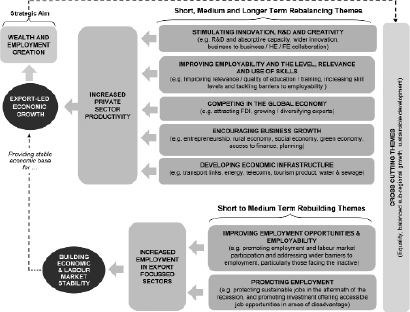
Response from the Department of Enterprise, Trade and Investment No.4
Mr Jim McManus
Clerk
Jim McManus
Clerk
Committee for Enterprise, Trade & Investment
Room 424
Parliament Buildings
Stormont
Belfast
BT4 3XX
10 January 2011
Dear Jim
I refer to your letter of 16 December 2010 enclosing follow-up questions from the Committee arising from its inquiry into renewable energy.
Please find attached Energy Division's response to the Committee's questions. I would be happy to clarify any issues arising.
A separate response on the economy-related questions will be provided by Strategic Planning, Economics and Statistics Division.
Yours sincerely
(signed)
Fiona Hepper
Energy Division
ETI Committee Renewable Energy Inquiry –
Follow up questions
Energy Related Questions
Question
Some respondents to the inquiry informed the Committee that, especially for smaller scale generation, FITs provide more security and are therefore preferable for banks lending to investors. In reality, what is the potential for ROCs to fall (or indeed rise) in price over the next twenty years or so (which may reflect the loan period which a developer may seek)?
Answer
As can be seen from the table provided to the following question, ROC prices are variable and it is therefore difficult to forecast future ROC prices. However, in order to avoid the price of a ROC crashing, the obligation level imposed on suppliers will always be higher than the anticipated number of available ROCs to ensure demand is greater than supply. This is called the 'headroom' mechanism.
Headroom is designed to ensure that there is always a positive gap of on average 10% between generation and the size of the Obligation. This protects investor confidence by ensuring there is always a market for ROCs and also helps protect consumers by guarding against an inflated ROC price (because of too few ROCs in the market) if deployment falls behind expected levels.
Question
What has the average value of ROCs been, year on year since they were first introduced and the average buy out fee?
Answer
| Year | Average ROC price (£) | Buy-Out Fund (£) |
| 2005/06 | 46.07 | 32.33 |
| 2006/07 | 40.65 | 33.24 |
| 2007/08 | 47.51 | 34.30 |
| 2008/09 | 51.39 | 35.76 |
| 2009/10 | 52.65 | 37.19 |
| 2010/11 | 49.24 | 36.99 |
Notes
- Figures are provided since introduction of the NIRO in 2005
- The buy-out price per MWh of electricity is calculated by Ofgem each year by adjustment to reflect changes in the Retail Prices Index. It was £30 per MWh in the base year, 2002-03, when the ROs for Scotland and England & Wales were introduced.
- The buy-out fund price is set in the February preceding the next financial year.
- Average ROC prices are those at April of each year e.g. 2005/06 price is for April 2005. Prices refer to auction prices listed on the e-ROC website (www.e-roc.co.uk) where the majority of ROCs are traded.
- Small-scale generators who wish to export electricity to NIE are contractually obliged to sell their ROCs to NIE Energy for £42.30 (current price).
Question
Under the GB RHI can heat producers obtain ROCs in addition to the RHI for heat produced and is it likely that similar provisions would be made in Northern Ireland if a RHI were to be introduced?
Answer
The final design of the GB RHI will not be known until early in the New Year. The initial consultation on the draft design and implementation of the GB RHI (February 2010) proposed that a renewable CHP generator could receive support for renewable electricity under the RO (or FITs where appropriate) and would have a choice between receiving support for heat under the RHI or the RO uplift, but not both. Any heat supported through the RHI could not be used in the process of creating electricity (process heat), only useful heat output would be eligible.
DETI will shortly carry out an Economic Appraisal of a RHI for NI. This work will consider issues such as tariffs, eligibility and standards. In advance of a RHI coming into effect in Northern Ireland there will be a full public consultation on its design and implementation.
Question
DETI officials informed the Committee that investors in renewable energy need long-term signals and that chopping and changing will lead to uncertainty. There is however a level of uncertainty in the Department's statement that it will keep the situation under active review and, should the need arise, will not preclude moving away from the NIRO to a different form of incentive. The Joint Business Council, on the other hand, suggested to the Committee that the NIRO should be extended until 2037 in order to be consistent with other parts of the UK. Committing to the NIRO until 2037 may increase certainty in the market but what does the Department consider to be the advantages and disadvantages of making a long-term commitment to a particular form of incentive?
Answer
The study undertaken by Cambridge Economic Policy Associates (CEPA) on future incentivisation in Northern Ireland suggests that the NIRO offers the best combination of meeting our 2020 target at least cost to the consumer. However, the report also suggested that this was only the case so long as Northern Ireland was able to retain its lower Obligation level.
The Department is currently considering the UK Government's Electricity Market Reform consultation (which includes a proposal to move away from the Renewables Obligation) and what this means for Northern Ireland. Maintaining investor confidence is vital. Therefore it is important that any future changes protect those who have already made investments by grandfathering support.
Question
What is being done to incentivise investment in RE, for example, business angel investment?
Answer
See Invest NI response.
Question
The grid is the weakest in the West, where the best renewable resources are located. What plans are there to prioritise work and renovation in certain areas of the grid?
Answer
Northern Ireland Electricity (NIE), as grid owner, is in the process of developing plans to significantly strengthen the electricity grid to allow connection of a much higher level of renewable generation. This plan will be subject to approval by the Utility Regulator as part of the price control process.
Question
The Strategic Action Plan for onshore renewable electricity will consider the need for strengthening of the electricity grid and will look to identify potential landing hubs to connect offshore renewable energy with the grid. What is the status of this plan and to what level of detail will the plan look at the grid?
Answer
The Onshore Renewable Electricity Strategic Action Plan (OREAP) is currently being developed in parallel with the Strategic Environmental Assessment (SEA) of onshore renewable energy in Northern Ireland. The need for an SEA is mandated by an EU Directive and the two key outputs of the process will be a Strategic Action Plan and an Environmental report.
The OREAP is currently being developed and its focus is onshore renewable electricity generation and the implications this will have for the electrical transmission and distribution grid which will require strengthening in order to accommodate future renewable generation. The Strategic Environmental Assessment refers to the in-combination effects of future generation, including offshore renewable energy, with the potential associated grid upgrades. The OREAP will not however look at specific route corridors.
This is something that NIE is currently developing with both a Grid 25 plan and the Renewables Integration Development Programme (RIDP) (in conjunction with Eirgrid). The RIDP in particular will focus in more detail on potential transmission reinforcement route options, with each route likely to be subject to separate environmental studies/assessments to meet the requirements of the planning process.
An initial scoping consultation workshop for the OREAP was held in June 2010 and this scoping report and consultation responses are available on the SEA website at www.onshorerenewablesni.co.uk.
It is anticipated that the draft Strategic Action Plan and Environmental Report will be completed by the end of March 2011. Executive endorsement will be required prior to a public consultation in Spring 2011.
Question
The draft offshore renewable energy strategic action plan (ORESAP) will also include strengthening of the grid to handle offshore renewables. What is the status of this plan and to what level of detail will the plan look at the grid?
Answer
The draft Offshore Renewable Energy Strategic Action Plan (ORESAP) includes the action point (12.1) which notes the need for the grid reinforcement programme, as set out above, to be completed in time to handle efficiently the increasing renewable electricity generated from offshore renewables. The ORESAP is not taking forward separate Grid work but offshore renewable issues will continue to be taken into account in the DETI onshore grid work and the NIE plans.
It is planned that the draft ORESAP will be finalised for Executive approval in Spring 2011, in advance of The Crown Estate launch of its Leasing Round in NI waters later in 2010-2011.
Question
Is a grid infrastructure development policy being developed? If so, by whom? When will it be completed? What is DETI's input?
Answer
DETI's Strategic Energy Framework has set a target of 40% renewable electricity by 2020. Meeting this target will require investment in additional renewable power generation, and significant upgrading of the electricity grid. NIE, as grid owner, has been developing plans for strengthening of the electricity, and this is likely to occur in the West and North-West where the majority of new renewable generation is expected to be located.
Upgrading of the electricity grid is likely to be carried out over a number of years to 2020 and beyond on a phased basis, subject to the conclusion of the current price control process that is undertaken by the Utility Regulator. It is planned that initial work is likely to be undertaken to maximise the potential of the existing electricity networks to transmit higher levels of renewable generation, followed by more significant works to upgrade the network. Grid strengthening plans will require the necessary approvals, including environmental consideration, and planning consent. Communication with stakeholders will be a key part of any grid strategy and DETI are working closely with NIE to ensure that a robust communications plan is put in place.
DETI is currently carrying out a Strategic Environmental Assessment of the cumulative impact of additional renewable electricity generation, and the corresponding impact on the electricity grid to accommodate much higher levels of renewable power generation.
Question
What exactly is a smart gird and what is needed for a smart grid system? Will a "smart grid" concept to incorporated into the grid development and upgrading?
Answer
Smart Grid is where digital technology is applied to the electricity network to enhance its operation. Combined with Smart Meters it can provide digital communications between electricity consumers and suppliers, thus helping to save energy and increase reliability of electricity supply.
A Smart Grid applies sensing, measurement, and control equipment along with digital communications technology thus linking the constituent elements of electricity generation, transmission, distribution, supply and consumption. This system of enhanced communication and control allows for faster responses to changes in the technical demands and operation of the grid, and to the supply of electricity to consumers, eg. when power is least expensive Smart Grid technology can be utilised to switch on domestic appliances or factory production operations, thus reducing peak load electricity demands and reducing energy costs for consumers. Smart Grid can also mean that network faults and overall reliability are more effectively managed.
As the Northern Ireland electricity grid is strengthened and improved, opportunities will be taken to consider where Smart Grid technology can enhance grid operation and provide economic benefits to consumers.
Question
How is DETI educating and liaising with the public to ensure that it understands the importance of the N/S Interconnector?
Answer
DETI continues to work with the Utility Regulator and with NIE to communicate to the public the strategic reasons why the second N/S Interconnector is required, including the need to provide the infrastructure to support sustainable economic growth. This has included briefing NI Assembly Environment Committee in public session. NIE, as the constructor and asset owner, has prime responsibility for informing relevant parties of the need for the interconnector and the reasons why the route selected was chosen.
Question
How is DETI working with DOE to ensure that the Interconnector is given priority?
Answer
DETI officials are in contact with DOE and Planning Service on the strategic rationale for the new line and its importance for economic growth, renewable generation and competition in the wholesale electricity market. This includes discussions on the timetable for the public local inquiry to ensure that timely action is taken. This work needs to be managed in conjunction with the planning process for the RoI section of the new line which is subject to RoI strategic planning legislation
Question
Can you detail the four subgroups of the SEIDWG and what work they are currently undertaken?
Answer
DETI provided the ETI committee with the terms of reference for all four subgroups in November 2010. Currently the economic opportunities and skills sub-group and the energy efficiency sub group have completed their work programmes. The communications sub group will oversee the appointment of a marketing agency following Executive approval of the communications sub group executive paper.
DETI's written evidence to the ETI Committee set out in paras 3.8 to 3.11 the rationale and work of the SEIDWG which has four sub-groups addressing bioenergy, energy efficiency, communications and economic opportunities and skills development.
Actions relating to these sub -groups are covered in different sections of the written evidence e.g 8.8-8.11 refers to the economic opportunities; 6.1 to bioenergy; 9.3 to the Communications Strategy, including energy efficiency, which is also addressed throughout the evidence, where relevant.
Question
SEIDWG were undertaking the development of a report of recommendations in respect of co-ordinated sustainable energy activity, including appropriate structure(s) to continue joined up delivery. Can you advise of the progress on this report and provide details of the possible recommendations?
Answer
The main SEIDWG group has considered all of the reports from the sub groups and has finalised a paper of recommendations which will be subject to Executive approval. The main paper of recommendations does propose further emerging work steams, but these will be subject to Executive approval, budget availability and resource availability across all Departments to undertake the proposed workstreams.
Given the cross cutting nature of this work, the report of recommendations is scheduled to be submitted to the Executive for its consideration and approval at its meeting in early February.
Response from the Department of Environment
|
Mr Jim McManus |
Private Office Assembly Unit Telephone:028 90 5 40855 |
Date: 11 January 2011
Dear Jim
I refer to the request from the Committee for Enterprise, Trade and Investment for further information on a number of queries following an oral evidence session on 11 November 2010 by the DOE into barriers to the development of renewable energy production and its associated contribution to the Northern Ireland economy.
The Department has commented on each of the questions asked and included these responses in Annex 1. The bullet points have been numbered to assist the reader.
I trust this information is of assistance, should you require anything further please contact me directly.
Yours sincerely,
Úna Downey
DALO
[by email]
cc. Alex McGarel, Clerk to the Environment Committee
.
1. Is it possible for the Planning Appeals Commission to prioritise public inquiries so as to ensure that significant strategic projects with Northern Ireland and international impacts can be dealt with urgently?
2. If so, what, if anything, can the Committee do to influence it?
The Planning Appeals Commission has published its criteria for prioritising its normal casework on its website. This confirms that the Commission gives priority to Article 31 casework referred to it by the Planning Service. The Commission takes account of the following factors in determining the extent to which a case will be prioritised:
I. The public significance of the development, including
- economic implications;
- social implications;
- employment generation; and
- the justification for the development, including dependence upon grant aid.
II. The scale of the development.
III. The environmental consequences of delaying the development, including environmental pollution, the likelihood of infraction proceedings and the importance of the site in environmental terms.
IV. Delays in the determination of the planning application including the appellant's use of Article 33 rights of appeal.
Where a case is referred by the Department to the Commission for a public inquiry, the Commission requests that the Department indicates the priority rating that it considers should be attached to that case.
The extent to which a case may be prioritised will depend on the availability of Commissioner resources.
3. UFU, in their oral evidence, stated, "...environmental impact assessments are being carried out on smaller turbines and the targets that people must jump through, such as those on fees and visual impairment, are exactly the same as those for the larger wind turbines", why is this the case and what can be done to ease the process?
The planning application fee is always calculated on the extent of the application site submitted. The access to the site should only be included where this necessitates the creation of a new access or if alteration or improvements to the existing access is required.
Wind turbines fall within descriptions of development listed under Schedule 2. category 3(j) to the Planning (Environmental Impact Assessment) Regulations (Northern Ireland) 1999 as amended. The Department is required to screen applications for the need for an Environmental Impact Assessment where the development involves the installation of more than 2 turbines or the hub height of any turbine or height or any other structure exceeds 15 metres.
For smaller developments that do not require a full Environmental Impact Assessment, the Department will often still require some or all of the issues to be addressed through an environmental report to accompany the planning application. The information required will depend on the individual circumstances of the case and the applicant should enter into pre-application application discussions with the local divisional office.
All applications for wind turbines must be assessed against the criteria listed in Policy RE1 of Planning Policy Statement 18 'Renewable Energy'. The supplementary planning guidance 'Wind Energy Development in Northern Ireland's Landscapes' will be taken into account in assessing wind turbine proposals. This document provides guidance on the landscape and visual analysis process.
4. What progress has been made on the consultation on proposals to provide permitted development rights to small-scale solar, wind, hydro, biomass, combined heat and power, and heat pump generation and when can we expect to see the outcomes of this consultation?
A public consultation on the Department's proposals for domestic microgeneration permitted development rights took place in 2007. This was later subsumed in a further general consultation, dealing principally with non-domestic microgeneration, which began on 22 October 2009 and ended on 22 January 2010. The technologies considered as part of this work were solar panels, biomass fuel, hydro, wind turbines, flues and heat pumps. Copies of the consultation responses have now been published on the Department's website. The Department intends to shortly bring forward new permitted development rights for domestic microgeneration technologies including solar panels, ground and water source heat pumps, solid biomass fuel containers and flues. Domestic wind turbines and air source heat pumps are not included in the Department's proposals for legislative change during the administration of the present Assembly but these matters will be further considered along with non-domestic microgeneration PD proposals later in 2011 after standards and safeguards in relation to noise, vibration and air navigation interference have been further considered.
5. What benefits DoE believe permitted development rights would bring to the domestic renewable energy sector in Northern Ireland?
The Department considers that the direct impact of domestic PD rights for microgeneration development will principally be upon householders. The provision of PD rights that allow microgeneration development which previously would have required a planning application is beneficial to householders by removing the costs associated with submission of a planning application and the fees which would be charged by the Department to process that application. It is not possible to quantify those cost benefits since the extent to which they accrue is dependent upon the choices of individuals and the circumstances of each case. There should also be indirect, but unquantifiable benefits to manufacturers, suppliers and installers of the panels and other equipment associated with microgeneration due to the removal by PD rights of the time which would otherwise arise from the need to apply for and get planning permission.
6. The Republic of Ireland has granted permitted development rights in the agriculture, business and commercial settings. What, if any, consideration has DoE given to permitted development rights for these sectors in Northern Ireland also?
In 2008, the Department commissioned Entec UK Ltd to review and identify impact criteria for extending microgeneration permitted development rights to all Northern Ireland non-domestic land uses, i.e. for all land uses except residential housing. The consultants, as part of that review, considered the non-domestic permitted development provisions in the Republic of Ireland as it applied to industrial, business and agricultural land uses. The Department's subsequent consultation paper then outlined the proposals for change that Entec identified during the review and included recommendations as to how permitted development rights in Northern Ireland might be revised to facilitate the take-up of these technologies.
7. What benefits DoE believe permitted development rights would bring to the domestic renewable energy sector in Northern Ireland?
See question 5.
8. What does DoE consider to be the barriers to bringing permitted development to the agriculture, business and domestic sectors?
It is acknowledged that clearer standards will need to be set for permitted development rights for certain microgeneration technologies including wind turbines and air source heat pumps as regards issues such as noise to ensure neighbours are not disturbed by such development. These points were raised by a number of respondents to the consultation including district councils and the Chief Environmental Health Officers Group. Elsewhere, this is being dealt with principally through work undertaken by The Department of Energy and Climate Change (DECC) which alongside the microgeneration industry has developed a UK-wide accreditation and certification scheme that covers both standards for products and their installation. Concerns have also been raised on the potential for wind turbines and non-domestic solar panels to create adverse impact on air navigation and again work is underway in other UK jurisdictions to tackle this issue. The Department intends to monitor this work and to consider air source heat pump, wind turbine and non-domestic microgeneration PD proposals later in 2011 after standards and safeguards have been agreed and tested.
9. What is the Northern Ireland potential for energy from waste and how will this impact on Landfill tax and the ability of Northern Ireland to meet its obligations under the Landfill Directive.
The NI Waste Strategy 2006-2020 acknowledges energy from waste as an integral element of NI's waste strategy, and that remains the position. Each of the three procurements being taken forward by the regional Waste Management Groups on behalf of local government has been subject to rigorous technical, economic and environmental analysis, and each has identified a range of technologies to comply with the EU Landfill Directive targets for the diversion of waste from landfill. These technologies include Mechanical Biological Treatment (MBT) plants to recycle additional materials and Energy Recovery Facilities to recover the energy value from the residual waste left by the MBT process which would otherwise be sent to landfill and incur landfill tax obligations. With Northern Ireland Landfill Allowance Scheme fines of £150 per tonne and Landfill Tax rising to £72 per tonne from 2013, the cost of inaction to ratepayers is very significant. Continuing to landfill our waste would cost ratepayers significantly more than delivering and operating the new waste management facilities.
The application of renewable energy technologies in Northern Ireland also has the potential to contribute to meeting EU obligations in relation to water quality. For example energy can be derived from livestock manures which may oversupply nutrients when applied to land or biomass systems can provide innovative solutions for the treatment of waste water discharges. Such technologies however may also have an impact on the state of the water environment and therefore they must be subject to proper regulatory controls.
10. Is the North/South Interconnector a priority for the Department?
Yes. The Department will be asking the Planning Appeals Commission to carry out a Public Inquiry and to treat it as a priority.
11. The supplementary planning guidance was published following the end of the Committee's public consultation on the Inquiry. Has DOE had any feedback on the guidance either from planners or applicants?
The Supplementary Planning Guidance was published in August 2010. DOE has not received any further feedback from applicants since we last briefed the Committee and no review by planners has taken place to date. The Department is not currently aware of any problems or negative issues that have been raised following the publication of the SPG. It is worth noting in this regard that the Northern Ireland Renewable Industry Group (NIRIG) has written to the Minister of the Environment welcoming the publication of the SPG stating that it believes it rightly reflects the pro-renewables position of PPS 18.
12. Do planners receive any kind of special training specific to understanding the nature of renewable energy installations? Is there different training to regional offices?
There is a specialist team at Planning Service headquarters which processes large scale renewable energy planning applications. There is no specific training for staff in Divisional Offices, but they do seek advice from the specialist headquarters staff as necessary.
13. Are there any plans to introduce mandatory microgeneration in building regulations?
The Committee may wish to address this question to the Department of Finance and Personnel who have functional responsibility for building regulations.
Response from the Department for Regional Development
Committee for Regional Development
Room 402
Parliament Buildings
Tel: +44 (0)28 9052 1970
Fax: +44 (0)28 9052 5917
To: Jim McManus
Enterprise, Trade and Investment Committee Clerk
From: Roisin Kelly
Regional Development Committee Clerk
Date: 29 July 2010
Subject: Renewable Energy Inquiry
At the Committee for Regional Development meeting 30 June 2010, the Committee noted your correspondence regarding the Committee for Enterprise, Trade and Investment inquiry into barriers to the development of renewable energy production and its associated contribution to the Northern Ireland economy, dated 24 June 2010.
The Committee agreed to forward your correspondence to the Department for Regional Development. Please find enclosed the Department's response to your request.
Response from the Department of Regional Development No.1
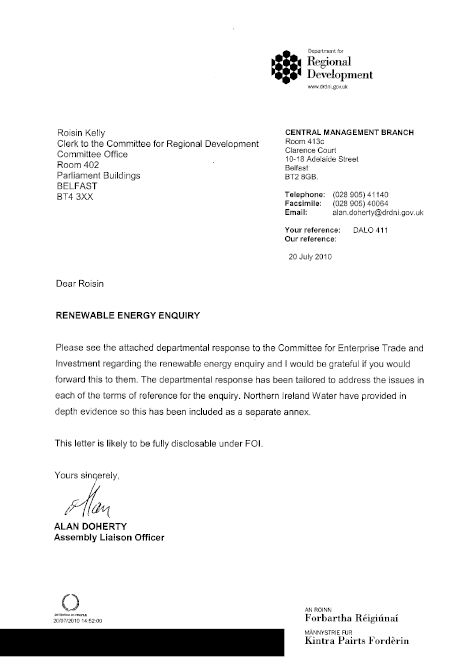
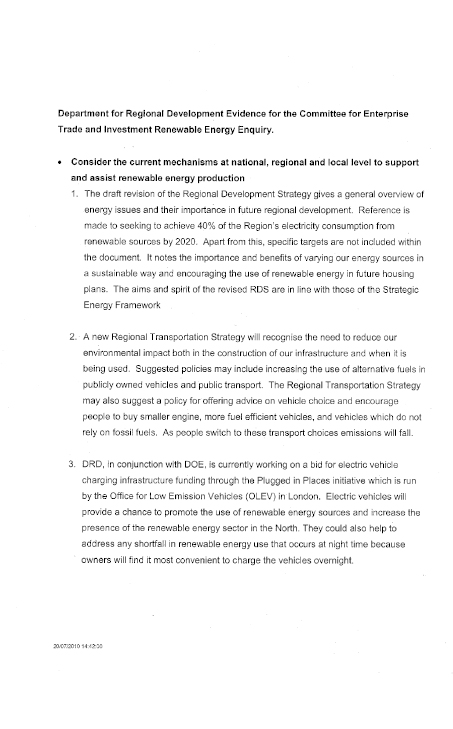
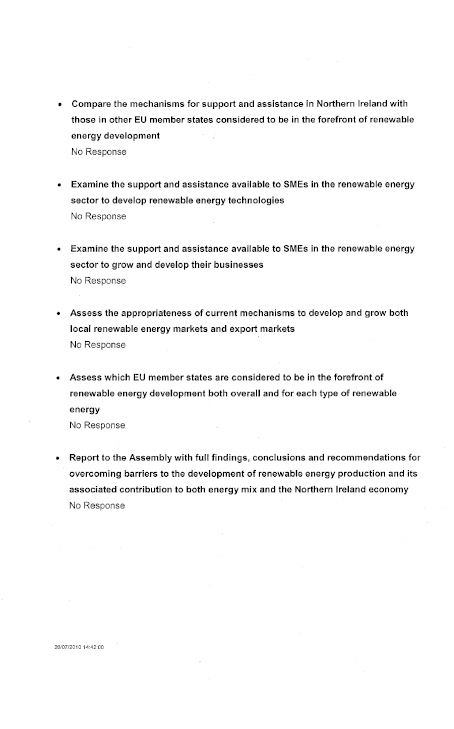
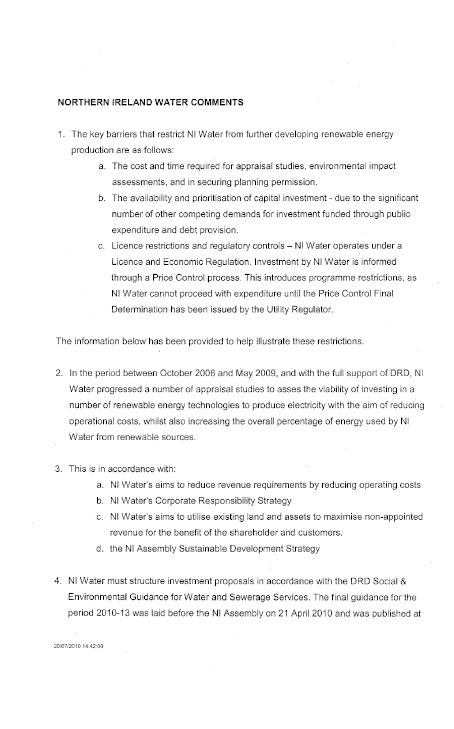
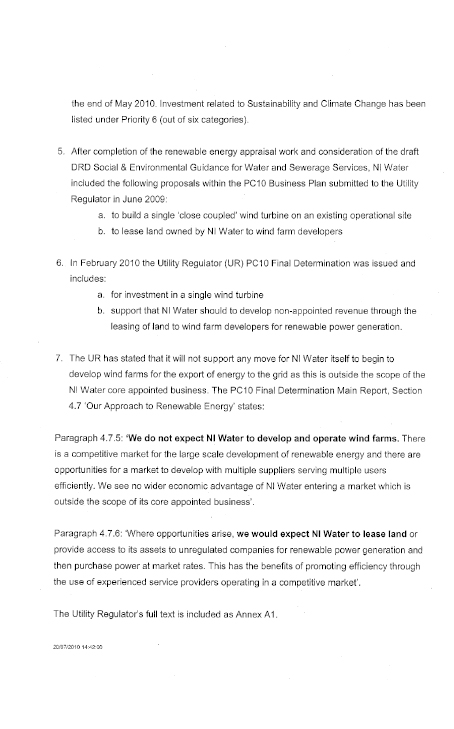
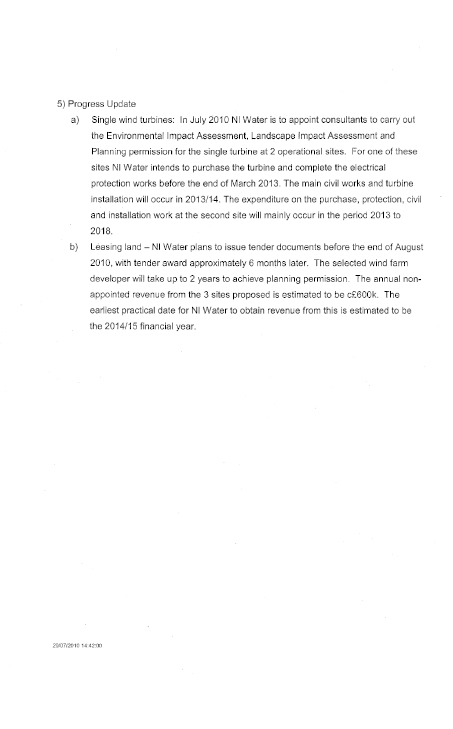
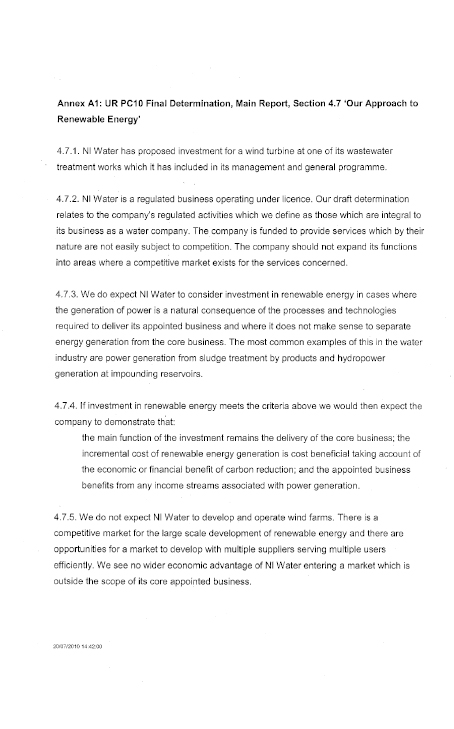
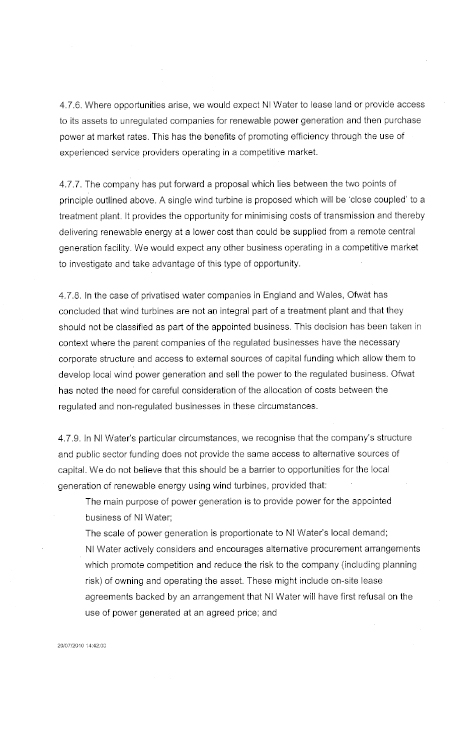
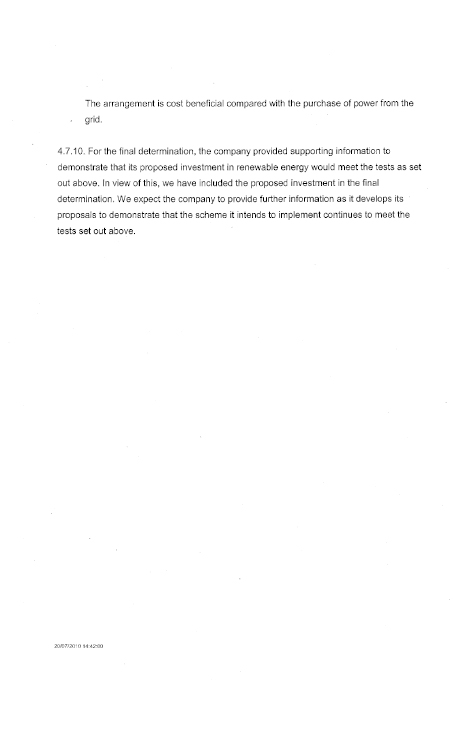
Response from ESB Wind Development UK
| Northern Ireland Assembly Committee for Enterprise, Trade & Investment Inquiry into Barriers to the Development of Renewable Energy Production and its Associated contribution to the Northern Ireland Economy | ||||
| Section 1 Company Details | ||||
| Company Name | Telephone Number | |||
| ESB Wind Development UK Ltd | 028 8225 0598 | |||
| Company Address | Company Type (Include one or more X) | |||
| Omagh Business Complex Great Northern Road Omagh BT78 5LU |
Supply | Install | ||
| Design | Manufacture | |||
| Maintenance | R&D | |||
| Other (Please Specify) | X | |||
| Development company | ||||
Please provide some background information on the company
ESB Wind Development is a subsidiary of ESB Group and is one of the leading developers of onshore wind generation across the island of Ireland. Within Northern Ireland, ESB Wind Development has a portfolio of 20MW operational, 52.5MW in construction and approximately 115MW in development. In addition, ESB Group, through ESB International, has significant interests in Northern Ireland in other forms of renewable electricity generation e.g. tidal, conventional generation (Coolkeeragh ESB) and energy supply (ESB Independent Energy). It has recently been announced that conditional agreement has been reached for ESB Group to acquire NIE, the Northern Ireland electricity networks business, from Viridian Group.
Section 2 Government Strategy for Renewable Energy
2.1 Please provide information on your level of awareness of current Government Strategy for Renewable Energy and how that strategy assists the renewable energy sector
The current strategy, "First Steps towards Sustainability – A sustainable development strategy for Northern Ireland" (2006) identified a target of 12% of electricity consumed in NI to be generated from renewable sources. The policy includes an aspiration that 15% of this renewable generation should be from non-wind sources. Given the number of wind farms operational, in construction or with planning approval, it is believed that the target of 12% by 2012 will be reached, assuming the necessary grid infrastructure is completed to facilitate the connection of approved wind farms.
The existing Northern Ireland Renewable Obligation (NIRO) has been successful in encouraging companies to develop a range of renewable generation sources. In particular, the banding of the NIRO has encouraged companies to consider a range of generation options such as biomass, anaerobic digestion, marine and others while maintaining support for more established and cost effective technologies such as onshore wind. It is essential to the continued development of renewable generation in NI that the NIRO continues to provide long term and stable support to projects so that developers retain the confidence to make what are very significant investment decisions.
The draft Strategic Energy Framework (SEF) identifies a target of 40% of electricity consumed within NI to be generated from renewable sources by 2020, a target which is amongst the most ambitious anywhere in Europe. There are no sub targets associated with individual technologies. It is recognised by policymakers and the wider industry that onshore wind remains the most cost effective method of renewable electricity generation going towards 2020 and that as such it will contribute the lion's share of the 2020 target. Meeting the 2020 target will require an integrated approach by all government departments to ensure that appropriate policies are devised and implemented to facilitate the ambitious target.
2.2 Please provide information on any Government support that your company has received in the past that is specifically related to renewable energy
N/A
2.3 Please provide information on any Government support that your company has applied for or is planning to apply for in the future that is specifically related to renewable energy
N/A
2.4 Please provide information on the barriers within Government to developing the renewable energy sector in Northern Ireland
The following comments are specific to the development of onshore wind.
The recent planning policy statement PPS18 has been, in general terms, welcomed by the industry. There are, within the policy, a number of ambiguous issues e.g. the definition of active peat, the separation of turbines from houses etc. and it will be increasingly important that clarification of the policy will be issued where necessary to ensure that developments are progressed in a timely and consistent manner. The draft Supplementary Planning Guidelines associated with PPS18 caused much consternation within the industry when first published. Industry has worked hard with government on the refinement of these guidelines and it is believed that the final version will be less restrictive, however there remains the potential for the guidelines to be a very significant barrier to the development of new projects, depending on the interpretation of the guidelines by planners and others.
The strategic development of the grid infrastructure will be crucial to the delivery of all forms of renewable electricity generation. The lack of a published grid infrastructure development plan is a significant barrier to the timely deployment of renewable generation projects including onshore wind farms.
2.5 Please provide suggestions on how Government can better support the renewable energy sector in the future in order to grow and develop the sector (suggestions should be specific to the renewable energy sector)
In the context of onshore wind, Government can provide improved support as follows;
- preparation and implementation of planning policy and guidance which will facilitate the delivery of the draft SEF targets
- ensuring the consistent application of planning policy by operational planners
- ensuring that timely planning decisions are made
- publishing a grid development policy and associated roadmap
- devising a strategy for public messaging regarding the importance of renewable electricity and the need to develop cost effective grid infrastructure
- development of generation on the public estate e.g. wind farms on forestry land
Section 3 Government Strategy for Economic Development and its Application to the Renewable Energy Sector
3.1 Please provide information on your level of awareness of current Government Strategy for Economic Development and how that strategy assists businesses
N/A
3.2 Please provide details of any Government support for economic development (at any level) that your company has had in the past
N/A
3.3 Please provide information on any Government support for economic development that your company has applied for or is planning to apply for in the future
N/A
3.4 Please provide information on the barriers within Government to developing the indigenous businesses in Northern Ireland
No comment.
3.5 Please provide suggestions on how Government can better support indigenous SME businesses in the future in order to assist them to grow and development
No comment.
Section 4 Communication, Sharing Information, Raising Awareness
4.1 How well do you think Government departments communicate and share information with each other in relation to renewable energy and how can this be improved?
There are a number of key points
- Renewable electricity generation is a sector which is the responsibility of a number of Departments. It is therefore important that Departments work together to improve co-ordination with regard to policy development and implementation.
- The forthcoming Strategic Energy Framework should be adopted as the primary policy by the NI Executive and all Departments should ensure that individual policies will facilitate the delivery of the SEF targets.
- All Departments need to recognise the barriers to delivery of generation and work collectively to ensure that these barriers can be overcome e.g. policy interpretation, policy conflicts between Departments
- There needs to be realism within all Departments regarding the delivery of the SEF targets i.e. onshore wind will deliver the most significant proportion of renewable electricity by 2020
4.2 How well do you think the Government departments and local Government communicate and share information with each other in relation to renewable energy and how can this be improved?
To date, there has been good interaction between Departments and local government and this has been reflected in the deployment of renewable generation. There is no doubt however that, in order to reach the ambitious SEF targets, the two government sectors will have to work closely to ensure delivery. Development of grid infrastructure will become the most significant challenge for all concerned. Given that the impact of grid development will be most apparent at a local level, it will be critical that local government buys into the infrastructure development programme.
4.3 How well do you think the Government departments and the EU communicate and share information with each other in relation to renewable energy and how can this be improved?
No comment.
4.4 How well do you think the Government departments and businesses communicate and share information with each other in relation to renewable energy and how can this be improved?
ESB Wind Development is an active member of the Northern Ireland Renewables Industry Group (NIRIG), the body which jointly represents the interests of the Irish Wind Energy Association and RenewableUK. Relations are good between NIRIG and the relevant Departments and meetings have proven to be beneficial to both parties.
4.5 How well do you think the Government departments and other regions and EU Member States communicate and share information with each other in relation to renewable energy and how can this be improved?
No comment.
4.6 How well do you think businesses in the renewable energy sector communicate and share information with each other in relation to renewable energy and how can this be improved?
The Northern Ireland Renewables Industry Group (NIRIG) has proved to be a useful forum for member companies of the Irish Wind Energy Association and/or RenewableUK.
4.7 How well do you think Government departments communicate and share information with the public in relation to renewable energy and how can this be improved?
Thus far, Government communication with the public has appeared to focus on energy efficiency. Energy efficiency is an important part of overall energy management and this communication process should be continued, however there is a need to educate and inform the general public as to the importance of renewable electricity and the steps necessary to incorporate a greater proportion of renewable generators into the generation mix. Key messages that the Government should consider are as follows;
- Renewable electricity generation will improve security of supply through decreased reliance on imported fossil fuels, increase economic competitiveness through helping to reduce the market price of electricity and reduce carbon consumption through reducing the amount of fossil fuels combusted.
- Significant additional grid infrastructure will be needed to maintain a stable electricity system (e.g. avoidance of power cuts) and to make most gain from a clean, indigenous resource.
- Overhead lines are the most cost effective method of developing transmission infrastructure and will be a necessary evil in many parts of the NI countryside.
4.8 How well do you think renewable energy businesses communicate and share information with the public in relation to renewable energy and how can this be improved?
In the context of onshore wind farms, ESB Wind Development completes a significant amount of communication with local stakeholders prior to submitting a project for planning approval. A pre-submission consultation takes place with all interested organisations and authorities to ascertain their opinion to the proposed development. Once feedback has been received and the initial design of the project has been formulated, consultation takes place with those impacted locally. Information leaflets are produced to provide the background information and these are distributed to local households and businesses. An information evening is organised at a local venue where details of the project are exhibited. Feedback from those attending is recorded and suggestions are incorporated where possible. Once the design of the project has been finalised the Environmental Impact
Statement is finalised and submitted to the planners. Again, these documents are made available for local stakeholders to view and obtain if desired.
4.9 What other support organisations are you aware of that exist to support the renewable energy sector?
No comment.
4.10 How well do you think Government departments and renewable energy support organisations communicate and share information with each other in relation to renewable energy and how can this be improved?
No comment.
4.11 How well do you think renewable energy businesses and support organisations communicate and share information with each other in relation to renewable energy and how can this be improved?
No comment.
4.12 How well do you think renewable energy support organisations communicate and share information with the public in relation to renewable energy and how can this be improved?
No comment.
Section 5 Additional Information
5.1 Please provide any additional information which you believe will be of assistance to the Committee during the course of the Inquiry
Renewable electricity generation has the potential to be a mainstay of the Northern Ireland economy to 2020 and beyond. Examples of its potential contribution include;
- reduced energy prices thereby improving the competitiveness of local companies
- potential to export energy assuming the existence of the necessary infrastructure
- a cheap energy source which can displace other traditional fossil fuels in other sectors e.g. electricallypowered cars, renewable heat
- a platform from which to establish ancillary and service sectors e.g. manufacturing, construction, operation and maintenance, research and development.
Scotland for example has already realised the potential contribution of renewable electricity to its economic, particularly in the context of a potential replacement for depleting North Sea oil and gas fields.
Onshore wind farm generation has become increasingly important to Northern Ireland since the mid-nineties. As a mature technology it can deliver cost effective electricity production to 2020 and beyond. There is a risk that, given the fact that it is a mature sector, government and others will focus on newer technologies and their potential contribution to the exclusion of onshore wind. This would be unwise. While other technologies will make an important and increasing contribution to the generation mix approaching 2020, it has been acknowledged by all concerned that, in a Northern Ireland context, onshore wind will be the most significant contributor of cost effective renewable electricity to 2020 and beyond. This contribution will only occur if onshore wind farms continue to be approved and constructed and there is an appropriate grid network to facilitate the export of energy from the sites. Should this not happen, many of the benefits identified above will fail to be realised.
Section 6 Contact Details
All written responses should be sent to:
Jim McManus
Committee Clerk
Room 424, Parliament Buildings, Belfast BT4 3XX
Tel: 028 9052 1574 · Fax. 028 9052 1355 · Email: committee.eti@niassembly.gov.uk
Response from ESBI Ocean Energy ESB International
| Northern Ireland Assembly Committee for Enterprise, Trade & Investment Inquiry into Barriers to the Development of Renewable Energy Production and its Associated contribution to the Northern Ireland Economy | ||||
| Section 1 Company Details | ||||
| Company Name | Telephone Number | |||
| ESBI Ocean Energy, ESB International | +353 (1) 703800 | |||
| Company Address | Company Type (Include one or more X) | |||
| Stephen Court, 18-21 St. Stephen's Green, Dublin 2, Ireland |
Supply | Install | ||
| Design | Manufacture | |||
| Maintenance | R&D | |||
| Other (Please Specify) | X | |||
| Project Developer, Project Owner, Operations and Maintenance |
||||
Please provide some background information on the company
ESB International (ESBI) is an international energy company employing approximately 1,300 staff. ESBI build, own and operate power stations, as well as trade and supply electricity in competitive energy markets. In addition, ESBI provide engineering design, construction management and strategic consultancy services. ESBI is a wholly owned subsidiary of ESB group. (www.esb.ie)
ESBI first entered the Northern Ireland electricity market in 1999 with the electricity supply arm of ESBI (ESB Independent Energy). Since then ESBI has grown its business activities in the region to include the development of the 400MW CCGT power station at Coolkeeragh in 2005 and through the development of a portfolio of windfarms. Wind farms are developed by ESB Wind Development on behalf of Hibernian Wind Power, a wholly owned subsidiary of ESB. Note that ESB Wind Developments are also responding to this Inquiry.
ESBI Ocean Energy, within ESBI, is developing wave and tidal power stations to meet ESB's target of 150MW by 2020 on the island of Ireland. ESBI Ocean Energy is pursuing a commercial tidal energy development off the Antrim Coast in Northern Ireland and also commercial wave energy projects on the west coast of Ireland. DETI has also a suggested target of 300MW of tidal energy in Northern Ireland by 2020.
Tidal energy is an emerging technology and Northern Ireland has the first tidal energy device in the world that is generating electricity and being sold to a customer. The device, Seagen, was developed by Marine Current Turbines (MCT) and ESB Independent Energy is selling the power to a customer. ESB is also a shareholder in Marine Current Turbines (MCT)). Although this is a very significant development, the tidal industry is still in its infancy and is considered pre-commercial technology. Hence, prior to committing to a commercial development off the Antrim Coast, ESBI Ocean Energy is interested in developing a pre-commercial tidal development at Strangford Lough. ESBI Ocean Energy has discussed both projects in Northern Ireland with DETI and NIEA and other stakeholders.
Section 2 Government Strategy for Renewable Energy
2.1 Please provide information on your level of awareness of current Government Strategy for Renewable Energy and how that strategy assists the renewable energy sector
The draft Strategic Energy Framework commits to 40% of renewable energy by 2020 in Northern Ireland. Tidal energy has a part to play in achieving this target. In particular tidal energy is very predictable and will assist in enhancing Northern Ireland's security of supply issue. This is recognised in the Strategic Environmental Assessment for Offshore Wind and Renewable Energy and ESBI Ocean Energy has responded to consultations on the draft Offshore Renewable Energy Strategic Action Plan 2009-2020. ESBI Ocean Energy has also taken part in workshops on this topic.
As ESBI Ocean Energy are interested in developing a pre-commercial tidal project at Strangford Lough and a commercial project off the Antrim Coast, ESBI Ocean Energy are also participating in consultations relating to the Marine Bill for Northern Ireland. This will impact upon ocean energy developments. In 2010 this has included the Pre-consultation for Marine Policy Statement and also Marine Policy Proposals for Northern Ireland Consultations by the Department of Environment (DOE).
2.2 Please provide information on any Government support that your company has received in the past that is specifically related to renewable energy
ESBI Ocean Energy has not received any financial support from the Northern Ireland Government. To date ESBI Ocean Energy has met with the Northern Ireland Environment Agency (NIEA) and the Department of Enterprise, Trade and Investment (DETI) to discuss both tidal projects for Northern Ireland.
ESBI Ocean Energy also meets regularly with Invest NI to discuss ESBI Ocean Energy projects. ESBI Ocean Energy has applied to the Knowledge Transfer Partnership (KTP) scheme along with Queens University of Belfast to develop a 2 year program of modelling studies in relation to tidal arrays. However to date this application has been unsuccessful. Invest NI are a potential funder to the KTP scheme and recommended ESBI Ocean Energy apply to the scheme.
ESBI Ocean Energy has also met with the Global Maritime Alliance, who receives funding from Invest NI. ESBI Ocean Energy are keen to ensure that Invest NI continues to develop the infrastructure and services necessary to ensure the supply chain is in place to deliver commercial projects successfully.
2.3 Please provide information on any Government support that your company has applied for or is planning to apply for in the future that is specifically related to renewable energy
Tidal Energy projects require government funding at this stage as the technology is not advanced enough to be at a commercial scale.
Pre-commercial development at Strangford Lough will require capital grant support for the installation of a small array. There are no small arrays of tidal devices in the world and the success of the MCT tidal device at Strangford Lough is recognised world wide. ESBI Ocean Energy will apply for NER300 funding from the EU to assist in this development. ESBI Ocean Energy will also consider Interreg funding and also Marine Energy Accelerator Fund.
ESBI Ocean Energy is also aware of Carbon Trust funding, mentioned below in 2.4. However most capital grants are currently aimed at technology developers rather than project developers.
ESBI Ocean Energy is also pleased to note the DECC guidance notes on NER300 will focus on Ocean Energy.
2.4 Please provide information on the barriers within Government to developing the renewable energy sector in Northern Ireland
Consenting a Tidal Project in Northern Ireland
To develop a tidal energy development, the following consents are currently required:
- Lease from The Crown Estate (as owners of the seabed)
- Consent under Article 39 of the Electricity Order 1992 from the DETI.
- Licence under Section 5 of the Food & Environmental Protection Act 1985 (FEPA) from NIEA
- There is provision, legislation not yet enacted, for Deemed Planning Permission under Clause 3,
Schedule 8 of the Electricity Order 1992 to cover planning for land based substation etc to be attached to Article 39 consent. As this is not yet enacted the land based elements of any offshore renewables project must go through a parallel planning process.
The current system has the potential to demand a multiplicity of consents and licences, each with a cost in the preparation of applications. Streamlining these with designated leads who will consult with others and be empowered to issue consent and licence with associated deemed consents will improve the process.
Marine Scotland has been set up as a one stop shop for consents required for ocean energy. Northern Ireland should be considering a similar arrangement.
Also although FEPA is mentioned in the existing consents required, a new Northern Ireland bill may modify how ocean energy is dealt with in relation to the marine environment. This introduces further uncertainty into the consenting for a tidal energy development.
Support Mechanisms
Currently in Northern Ireland, for each MWh of electricity generated from tidal energy, only 2 Renewable Obligation Certificates (ROCs) are received. This does not compare well with Scotland where five ROCs are received for every MWh of electricity generated for wave power and tidal power receives three ROCs. However it is hoped that Tidal power will also receive 5 ROCs in Scotland. ESBI Ocean Energy believes that Northern Ireland should move to 5 ROCs for tidal in line with the expected support in Scotland.
As this is a new industry, incentives are essential to develop projects.
Capital Grants are also essential to develop the industry at this early stage. The majority of these grants are aimed at proving individual technology. ESBI Ocean Energy is interested in bringing this to the next level and moving beyond single devices to small arrays and ultimately commercial tidal projects. Currently grants available are primarily administered by the Carbon Trust although others are outlined below:
Carbon Trust
Marine Renewables Proving Fund
Marine Renewable Development Fund has been withdrawn and Marine Energy Accelerator Fund opened
Technology Strategy Board
Supports and invests in technology research, development and commercialisation.
Engineering & Physical Sciences Research Council
European Support
NER300 European renewables demonstration support programme.
European Regional Development Fund
ESBI Ocean Energy is investigating application to Interreg IVA funding along with Invest NI.
The Welsh and Scottish Governments also have specific programs related to supporting the demonstration of ocean energy such as the WATERS Program - Wave and Tidal Energy: Research, Development and Demonstration Support program and the Salter Prize, both in Scotland.
Regional Development Agencies, such as South West RDA, also award funding.
ESBI Ocean Energy contributed to the SQW Economic Study for Ocean Energy Development in Ireland commissioned jointly by Invest NI and Sustainable Energy Authority Ireland. In this economic study, the level of government support required both in terms of tariff and capital grants are outlined. These will reduce as the industry develops and is suggested from the years 2010, 2015, 2020, 2030. ESBI Ocean Energy's contribution to the report is available on request. The final SQW report should be issued in the near future.
Grid Development
To develop offshore renewables including tidal energy, significant modifications and upgrades to the transmission system are required. This could cost in the region of £1billion to allow significant upgrades to the transmission and network systems for accommodating renewables both on-shore and off-shore. To invest in the grid, approval from the regulator is essential. There is no published grid infrastructure development plan for Northern Ireland.
2.5 Please provide suggestions on how Government can better support the renewable energy sector in the future in order to grow and develop the sector (suggestions should be specific to the renewable energy sector)
As 2.4.
In summary:
- 5 ROCs for tidal energy
- Support for NER 300 pre-commercial tidal energy
- In addition ESBI Ocean Energy consider more focus could be given to EU funding that differentiates Northern Ireland from rest of UK, such as Interreg
- Simplified consenting process for tidal energy developments
- Capital grant support for pre-commercial tidal energy developments
- Development of grid development plan to facilities renewables to meet 40% target from draft SEF and 300MW target of off-shore tidal energy development by 2020.
Section 3 Government Strategy for Economic Development and its Application to the Renewable Energy Sector
3.1 Please provide information on your level of awareness of current Government Strategy for Economic Development and how that strategy assists businesses
In relation to ocean energy, ESBI Ocean Energy is unaware of specific developments to assist business, such as ESBI Ocean Energy, to develop tidal projects.
3.2 Please provide details of any Government support for economic development (at any level) that your company has had in the past
None.
3.3 Please provide information on any Government support for economic development that your company has applied for or is planning to apply for in the future
ESBI Ocean Energy would be very interested to discuss possible support mechanisms for economic development that tidal energy developments will bring to Northern Ireland.
3.4 Please provide information on the barriers within Government to developing the indigenous businesses in Northern Ireland
Key issues are outlined in 2.4.
3.5 Please provide suggestions on how Government can better support indigenous SME businesses in the future in order to assist them to grow and development
Most ocean technology developers are in this category and would be best placed to respond to this query.
Section 4 Communication, Sharing Information, Raising Awareness
4.1 How well do you think Government departments communicate and share information with each other in relation to renewable energy and how can this be improved?
ESBI Ocean Energy understands that there is an interdepartmental working group led by DETI across departments associated with renewable energy technologies. It is essential when developing ocean energy projects that those responsible for issuing the consents outlined in 2.4 work very closely in developing strategies and ensure they are coherent. As noted marine Scotland has a one stop shop for dealing with consenting.
Ocean energy differs from other energy projects in that it has a very large marine component and also a very significant terrestrial component.
There are on-going plans being developed in relation to the marine environment, the on-shore grid and also offshore energy. These all need to be interlinked to achieve the ocean energy targets proposed by DETI of 300MW of tidal energy by 2020.
4.2 How well do you think the Government departments and local Government communicate and share information with each other in relation to renewable energy and how can this be improved?
It would be useful if local development plans at local government level specified their plans for renewable energy or at least made reference to government plans.
Again the positives to be achieved from renewable energy should be promoted and also deal with the required grid infrastructure to support renewable energy.
4.3 How well do you think the Government departments and the EU communicate and share information with each other in relation to renewable energy and how can this be improved?
No comment.
4.4 How well do you think the Government departments and businesses communicate and share information with each other in relation to renewable energy and how can this be improved?
DETI has kept businesses informed in relation to the OFF-shore renewables strategic environmental assessment and draft strategic action plan. Use of websites are good but could be updated more frequently.
4.5 How well do you think the Government departments and other regions and EU Member States communicate and share information with each other in relation to renewable energy and how can this be improved?
In relation to Ocean energy, good co-operation is observed between the Governments of Northern Ireland and Republic of Ireland. Both are represented through DETI and Sustainable Energy Authority of Ireland (SEAI) on the Marine Renewables Industry Association (MRIA). This is a very important forum for developing ocean energy in Ireland and it is crucial that both Northern Ireland and Republic of Ireland work closely on developing the industry and attracting project developers.
4.6 How well do you think businesses in the renewable energy sector communicate and share information with each other in relation to renewable energy and how can this be improved?
Also in relation to the ocean energy, the MRIA is a very useful tool for sharing of information. Action Renewables has published some documentation on renewables in Northern Ireland.
4.7 How well do you think Government departments communicate and share information with the public in relation to renewable energy and how can this be improved?
More positive communication in relation to renewable energy should be promoted. In particular Northern Ireland's reliance on imported fuel and subsequent risk to security of supply. In addition, the inevitable grid infrastructure to support the renewable energy should be addressed with the public at as early a stage as possible.
4.8 How well do you think renewable energy businesses communicate and share information with the public in relation to renewable energy and how can this be improved?
In the case of ocean energy, there is a reluctance to share technical information as the technologies are still developing to commercial scale. Unless companies in the market place merge,
4.9 What other support organisations are you aware of that exist to support the renewable energy sector?
No comment.
4.10 How well do you think Government departments and renewable energy support organisations communicate and share information with each other in relation to renewable energy and how can this be improved?
No comment.
4.11 How well do you think renewable energy businesses and support organisations communicate and share information with each other in relation to renewable energy and how can this be improved?
No comment.
4.12 How well do you think renewable energy support organisations communicate and share information with the public in relation to renewable energy and how can this be improved?
No comment.
Section 5 Additional Information
5.1 Please provide any additional information which you believe will be of assistance to the Committee during the course of the Inquiry
This response has been made by ESBI Ocean Energy with a focus on tidal energy projects in Northern Ireland. The industry is in its infancy and requires support from government. The potential benefits to the Northern Ireland economy have been investigated by SQW and will be reported upon in the near future in "Economic Study for Ocean Energy Development in Ireland".
Northern Ireland has the advantage of a very good tidal resource off the Antrim Coast as well as the world leading technology installed, MCT's Seagen device, at Strangford Lough.
ESBI Ocean Energy is a project developer looking to bring the industry from single demonstration devices to precommercial and ultimately commercial projects. The majority of UK funding has been directed at UK companies through the Carbon Trust or particular Scottish or Welsh Initiatives. Northern Ireland needs to focus on EU and UK funding that can be directed specifically to Northern Ireland for renewable projects.
There are many policies being developed that will impact upon tidal energy development and close co-operation between departments and agencies is essential. Simplification and clarity on the consenting regime, both for the marine environment and terrestrial components, is also necessary.
Ultimately the grid infrastructure has to be developed to accommodate ocean energy. Given the long lead time in the design and installation of the transmission and network systems, plans need to be put in place for grid development to achieve 2020 targets.
ESBI Ocean Energy looks forward to contributing to meeting the 40% renewable target by 2020.
Section 6 Contact Details
All written responses should be sent to:
Jim McManus
Committee Clerk
Room 424, Parliament Buildings, Belfast BT4 3XX
Tel: 028 9052 1574 · Fax. 028 9052 1355 · Email: committee.eti@niassembly.gov.uk
Response from Farm Woodlands
Farm Woodlands Ltd (www.farmwoodlands.co.uk)
59 Main Street, Augher, Co. Tyrone. BT77 0BG. Tel/Fax: (028) 85549920
Committee Clerk
Committee for Enterprise, Trade & Investment
Room 424
Parliament Buildings
Ballymiscaw
Belfast.
BT4 3XX. 5th August 2010
RE: Inquiry into Barriers to the Development of Renewable Energy Production and its Contribution to the Northern Ireland Economy
1. Introduction
1.1. Since inception in 1992, our company Farm Woodlands Ltd has been involved in the establishment and management of private woodlands for farmers and landowners throughout Northern Ireland.
1.2. We plant on average approximately ? of the total new woodland created in Northern Ireland each year, under the various grant schemes funded by the Department of Agriculture and Rural Development (DARD).
1.3. Given the extent of our experience in the private forestry sector, we welcome the opportunity to respond to this inquiry. Our response will therefore, focus on energy production from woodchip derived from clean, virgin timber and forestry by-products.
1.4. We are also members of the Biomass Energy Northern Ireland (BENI) group, whose emphasis is on the development of the market for woodchip derived predominantly, from Short Rotation Willow. However, we believe that energy production from woodchip grown in Northern Ireland, irrespective of whether it's from forestry or Willow, has a major role to play in our climate change strategy and in the creation of sustainable employment.
2. Biomass in Northern Ireland
2.1. The advantages of using biomass to the Northern Ireland economy have been well documented. One only has to look at what is happening in this sector in the Republic of Ireland, the UK and Europe. These regions are at the forefront of actually using biomass. It is therefore, unnecessary to re-invent the wheel with endless consultation exercises and research projects. A better use of this funding would be to stimulate the market in NI.
2.2. The NI Executive needs to support the establishment of supply chains between fuel suppliers and end-users, in the setting up of local biomass schemes. This will enhance public awareness and it will create confidence in the market.
2.3. Special attention needs to be given to creating awareness among potential end-users of large quantities of heat in both the public and private sectors e.g. hospitals, hotels, leisure complexes, schools, etc. The decision makers such as architects, planners and developers also need to be targeted. Our Government must adopt a meaningful national development plan that is committed to this new wood energy market, assisted by financial incentives to stimulate it.
3. Wood Energy & Private Woodlands
3.1. As mentioned previously, our response focuses on energy from woodchip produced from forestry. In 1978 Forest Service estimated that there was approximately 20, 500 Hectares (Ha) of privately owned woodlands in NI. Since then an additional 6,000 Ha new private woodlands have been planted, many of these are hardwood plantations.
3.2. We strongly believe that woodchip sourced from these plantations in addition to that from the Forest estates, will be the main driver of the wood energy market in NI, simply due to the volumes of material that is already available.
4. Current Funding for Private Woodlands
4.1. Since 2005 and the introduction of the Single Farm Payment, landowners in NI have been keen to embrace the new opportunities being presented, particularly in relation to timber production and the wood energy market. Whilst there is funding available to landowners, the level of support does not reflect the long-term commitment that owners make, when they plant trees on their land.
4.2. In addition, since 2007 the current policy makers in DARD, have been the single biggest obstacle to the expansion of private forestry, ironically at a time when tree planting has never been more popular. Since 2007, landowners have been divided into "farmers" and "non-farmers".
4.3. A "non-farmer", defined as a landowner who earns less than 25% of their income from farming, receives less than half of the Annual Payments available to their "farmer" counterparts. This two-tiered system has decimated new planting rates in NI. As far as we are aware, this definition of a "non-farmer" does not apply to any other sector of the agricultural industry.
4.4. This dip in new woodland planting could have serious consequences in the long-term unless it is urgently addressed. In theory, Short Rotation Coppice (SRC) plantations such as Willow could quickly supplement the shortfall in woodchip production. However, Willow production is best suited to the farmland areas under 100 metres ASL (above sea level), where it can be safely harvested with heavy machinery. This results in much of NI farmland being unsuitable for Willow production.
4.5. In the heavier soils and in the hilly areas, tree planting is the only viable alternative land use, yet the non-farmer issue is preventing these landowners who are most keen to plant trees, from doing so. This issue needs to be addressed as a priority, as it is a barrier to the expansion of our woodland cover. Increased woodland cover in turn leads to further confidence in the market and subsequent development of the wood energy sector. The immense potential, economically and environmentally, of private plantations needs to be properly recognised. At present the expansion of private forestry is severely restricted by administrative obstacles and lack of vision.
4.6. Perhaps DETI either alone, or in conjunction with DARD could develop a radical new approach or grant structure which would enhance tree planting rates. For example, all landowners who plant trees could be paid for the carbon sequestration of their plantations. This could be a guaranteed annual payment, while the trees are growing.
5. The Future
5.1. In addition, DETI needs to address the exclusion of NI from the Renewable Heat Incentive Scheme. At present we are at a significant disadvantage, which is stifling the wood energy sector at this crucial time.
5.2. In the Republic of Ireland, the introduction of incentives such as the REHEAT Scheme and Greener Homes Scheme has seen the wood energy sector increase rapidly over the past five years. The recent announcement of the subsidised biomass electricity and heat production tariffs, guaranteed to producers for 15 years under the REFIT Scheme, will further cement the demand for wood fuel. Much of the wood fuel grown in NI is now heading across the border, to help the Republic of Ireland meet their renewable energy targets.
5.3. In these financially challenging times, similar schemes need to be introduced to NI without delay, to prime the market, to give greater investor confidence and for delivering security of supply. Such announcements would be the first vital steps in creating a viable biomass industry here.
At Farm Woodlands, we are willing to explore our opinions and discuss the points expressed in this submission further, if invited to do so.
Yours Faithfully
Willie Mc Kenna BSc
Cathal Woods BSc
Kathleen Mc Kenna BSC, PhD
Response from Fastrack to IT FIT
Response To Skills Supply for Wind Turbine Maintenance To Ensure Competitiveness and Address Long-Term Unemployment and Economic Inactivity
1. Background
This response is being submitted by FITNI the Northern Ireland arm of an all-island initiative FIT (Fastrack to IT).
FIT is an industry led initiative that are focused on developing and delivering market led curricula to those at risk of unemployment long term. The submission aims to highlight FIT's evolution toward responding to the demands of the "smart economy" and its capacity to identify areas where skills shortages emerge.
The response will seek to highlight that despite the major opportunities which appear to be clearly recognised within Government there are potential barriers to both competitiveness and productivity, barriers which FIT has a distinguished history in over-coming. In particular, given the very high levels of economic inactivity, long-term unemployment and the stated desire to promote entrepreneurship there appears to be the risk of missing a major opportunity to tie in efforts to meet the needs of a rapidly growing sector with efforts to address under-employment and unemployment. FIT already occupy a prime location within the market as they provide key links between industry, education and marginalised job-seekers. FIT have found that this network of links is key to the provision of up to the minute education opportunities that benefit all involved.
1.1 History of FIT
FIT is a registered charity and not for profit organisation and was established in 1999 with the backing of Department of An Taoiseach, Department of Enterprise, Trade and Employment and a number of companies. FIT is a unique industry initiative involving major indigenous and international companies (AIB, Accenture, Alchemy, AOL, DELL, Eircom, IBM, Microsoft, NTR, Oracle, Siemens, Skillsoft and Symantec) who are actively committed to the integration of marginalised job seekers into the workforce through the acquisition of marketable technology skills.
FIT NI was established in 2004 by FIT Ireland with the objective to develop programmes for marginalised job seekers in Northern Ireland and provide them with marketable technology skills to effectively compete in the labour market. The aim was to follow in the footsteps of FIT in the Republic of Ireland, which has helped over 8,500 people successfully access training and employment since it was founded in 1999. 5,000 people progressed into employment on completion of the programme.
FIT Programmes are developed in collaboration with industry and cover technical skills and personal / professional development in order to ensure the successful progression of participants on completion of a course with the assistance of FIT Staff.
While FIT NI has seen some success to date, it has become apparent that there are weaknesses in the publicly funded training and employment systems / programmes in Northern Ireland that seem to be inhibiting unemployed people from gaining the appropriate and necessary skills to obtain employment in an increasingly knowledge based economy.
According to the latest statistics published by the Department of Enterprise, Trade and Investment, unemployment in Northern Ireland has risen to 6.7% for January – March 2010 (up 0.7 percentage points over the quarter and 0.5 percentage points over the year). This represents some 55,000 people - a rise of over 6,000 people on the previous year. The unemployment rate for 18-24 year olds is estimated at 16.1% and 37.9% of people have been unemployed for 1 year or more i.e. long-term unemployed
Also of concern is the fact that Northern Ireland has proportionally the highest number of economically inactive people at 27.1%, in comparison to the UK average rate of 21.5%. This means that Northern Ireland has the highest rate of economic inactive persons of twelve UK regions (See Appendix One).
It is clear from this information that there are a number of issues which need to be addressed if Northern Ireland is to make any significant progress in decreasing the high proportion of unemployed and economically inactive people, and encourage people back to enter into the workplace.
1.2 The Smart Economy
The original focus of the FIT Initiative was ICT skills and further growth in this sector is predicted. The International Data Corporation study forecasts that the IT Industry will create 5.8 million new jobs and more than 75,000 new businesses over the next four years – three times the rate of employment in other industries. We are committed to providing learners with the skills necessary to compete more effectively within the labour market. Our comprehensive training for employment programmes incorporate both practical modules and soft skills to ensure that graduates are prepared both personally and professionally to progress into the employment market or into further education. FIT also run a large number of digital inclusion programmes; these programmes aim to promote the use of IT and bridge the digital divide and focus on groups and individuals at risk of marginalisation.
Building on its success FIT has broadened its remit in recent years to promote training in technologies required in a number of areas in the emerging Smart Economy – green energy, mobile technology, smart grid, medical devices and cloud computing.
Both FIT and FIT NI work in unison to investigate possible skills needs, promote collaboration and communication between industry and education and foster an environment that is conducive to building strong, multi-dimensional working relationships.
The FIT Eco Initiative
The FIT Eco Initiative has been developed in response to demand from wind turbine manufacturers who wish to ensure effective and appropriate skills supply in relation to the manufacture and maintenance of wind turbines. Their engagement with FIT is part of an effort to tie in these employment opportunities with a desire to ensure potential access for the long-term unemployed and otherwise disadvantaged.
Mission:
To meet the Skill and Competitive needs of the "Green Economy" through upskilling in Disadvantaged / Rural Communities demonstrating that the "Smart Economy" is socially inclusive.
Aims:
Ensure the expanding Green Economy is competitive within the Irish energy sector and internationally by providing skilled workers in an area where there is a notable shortage. (For example two thirds of all wind turbines are currently behind on maintenance schedules due to a lack of qualified maintenance personnel)
Life-long Learning in Practice' - facilitating upskilling / skills transference across sectors. Provide recognised qualifications in the Renewable Energy Sector for those who may have been previously distant from education and/or the workforce.
Support the Renewable Energy sector through the promotion of renewable resources and education and training within the sector
Address rural disadvantage through combining the employment needs of expanding renewable energies sector with the upskilling needs of those currently distant from the workforce.
Further development of the FIT Model to harness the significant skills development / employment opportunities emerging in Northern Ireland.
Industry Partners include:
Siemens, NTR, Rockall Group, Cronalaght Wind Farm, Version1, Green Dale Technologies, Airtricity, Gamesa.
In the Republic of Ireland we are working with the following:
Vocation Education Colleges (VECS):
Co. Wicklow, Co. Waterford, Co. Kerry, Cork, Co. Sligo, City of Dublin, County Dublin, Co. Donegal VEC and Meath VEC.
Higher Education Institutes (HEIs):
Sligo IT, Dundalk IT.
And have garnered information and support from:
Galetech, Bord na Mona, Donegal CDB, IWCM, SEI, IWEA, ESB International, Vestas, Danish Wind Energy Academy, B9, Udaras na Gaeltachta, Dept Enterprise, Trade and Employment, FAS and Dept Taoiseach.
In Northern Ireland
We have made initial contact with the Sector Skills Council and have been invited to present to five of them on the 11th August. We are seeking contact with DEL. We have had initial discussion with Invest NI who have responded positively and have a meeting scheduled to discuss the potential for FIT NI to support efforts to promote SMEs wishing to become part of the Supply Chain.
The FIT Eco Initiative is unique in that it provides learners with the opportunity to attain in demand skills, as dictated by industry, over the course of an academic year. FIT are also implementing their proven strategy with regards to linking our students/graduates, educational institutes and industry to ensure the needs of all are met.
We are also aware that Renewables UK have developed a City & Guilds qualification currently being piloted in an FE College in Scotland. We are again seeking a link up in relation to Northern Ireland and so are in discussion with the Energy & Utilities Sector Skills Council in Northern Ireland.
2. The Scale of the Opportunity and the Inhibitors
Northern Ireland has significant unemployment, under-employment and economic inactivity. Wind Turbine Manufacture and maintenance will create very significant employment opportunity in the next two years. A speedy response is required in order to ensure the availability of appropriately skilled labour and a major opportunity exists to link this in with a major initiative to link efforts to tackle long-term unemployment and economic inactivity with identified employment opportunity. At present in Europe over two thirds of all wind turbines are behind on their maintenance schedules – this leads to a wide range of both productivity and safety concerns. The need for qualified personnel to meet the skills requirements of this expanding area is crucial to its success.
Despite representing wind turbine manufacturers we have found that we are having to talk individually to a myriad of people who appear disconnected from each other and there appears to be no identified lead in relation to ensuring an effective match in terms of skills supply and identified employment opportunity. This is even more particularly felt in terms of our interest in ensuring the skills and employment needs of the disadvantaged are addressed.
We need only look at our neighbour in the Republic of Ireland to see the scale of the opportunity:
- 1,500 direct jobs so far (EWEA – 2008 Survey)
- Up to 3,500 turbines planned for Ireland
- 3 turbines = 1 general maintenance person
- Minimum 1,000+ jobs in maintenance
- Additional employment:
- +Maintenance Supervisors
- +Ancillary Staff (15.1 jobs per MW Installed EWEA)
- +Scotland / Wales / UK / Europe
- +Domestic Turbine Maintenance
- Recent expansion in Ireland
- West Clare Renewable Energy - €200mil.
- Ireland Overall – 7,800MW, 1MW = 1.5 Jobs
- Potential Total Employment in Sector by 2020 – 10,760 jobs
(Source: Jobs and Investment in Wind Energy, Powering Irelands Economy, IWEA and Deloitte Touch, June 2009)
Not only does this provide Northern Ireland with a strong indication of the likely demand for skills and employment in the region it also represents a significant market opportunity for Northern Ireland based firms to exploit opportunities in the Republic of Ireland.
Our discussions with Invest NI indicate that there are some 121 micro-enterprises in Northern Ireland with the skills to supply the major manufacturers and who are actively seeking to engage with the major manufacturers (many of whom are FIT supporting companies) in terms of assisting SMEs to engage with our industry partners to become a part of the Supply Chain. Many companies within the sector have also indicated that there are substantial costs incurred in the training of personnel with basic skills to work in the industry or assist them in adapting their skills for the sector – a cost which many companies cannot afford to incur.
These SMEs in turn will create employment which with effective targeting of resources has significant potential in terms of providing major employment opportunity for the long-term unemployed.
In terms of seeking to meet the needs of the long-term unemployed we have run up against the following issues that our experience shows are preventing people from developing the right skills and finding employment:
Dependency on the welfare system – the poverty trap.
Dependency on the benefits system has been an on-going problem and it does nothing to encourage more people to look for work. This point has been raised recently in the news. For example, in an article in the Belfast Telegraph dated the 27th of May 2010, Mr Ian Duncan Smith Work and Pensions Secretary was quoted as saying at a speech in London: "A system that was originally designed to help support the poorest in society is now trapping them in the very condition it was supposed to alleviate. Instead of helping (them), a deeply unfair benefits system too often writes people off."
"The proportion of people parked on inactive benefits has almost tripled in the past 30 years to 41% of the inactive working age population. That is a tragedy. We must be here to help people improve their lives - not just park them on long-term benefits."
"We must not underestimate the challenge ahead. One of the biggest problems is that for too many people work simply does not pay."
"For many people, the move from welfare into work means they face losing more than 95 pence for every additional £1 they earn. As a result, the poor are being taxed at an effective tax rate that far exceeds the wealthy. We have in effect taken away the reward and left people with the risk. That must and will change."
Over the years FIT have developed a number of programmes that ensure that learners on FIT Programmes attain the personal development skills to actively pursue employment and be prepared for some of the challenges that they may face starting a new job. This is one of many unique supports offered by FIT.
Lack of substantive training/skills development programmes in key priority industry sectors.
While a number of training and development programmes have been initiated to get the unemployed back into work, many of these have provided only short term training and do not provide substantive skills required for job seekers to compete effectively in the labour market. Hence, many unemployed people have been on the merry-go-round cycle of training, failing to gain employment and then returning to another short-term training programme in order to protect benefits.
FIT has developed a curriculum that is informed by the sector itself, whilst there is work ongoing within RenewablesUK and the Sector Skills Council the only vocational qualification in Northern Ireland has been developed by South West College and has not been informed by the industry itself.
Further, the qualification is not available to other providers. FIT has developed industry-lead certification and is now actively seeking to engage with F&HE and others.
Work is ongoing to develop progression into University provision and although at an early stage the response so far has been positive.
Current Training and Development Programmes not making the impact they should.
There are a number of training and development programmes offered by the Department of Employment and Learning (DEL) which are aimed at providing relevant skills development and tackling unemployment such as:
- Learner Access and Engagement Pilot
- Steps to Work
However, there are inherent weaknesses in these programmes which limit their potential in meeting the needs of the unemployed and economically inactive.
In the Learner Access and Engagement Programme, which is aimed at the 'hardest to reach' in the community, FIT NI has had some degree of success in attracting over 1,200 learners over the past year. However, due to the very strict criteria for eligibility, there are many more disadvantaged job seekers being excluded that would wish to take advantage of this programme. For example:
- Participants must not have a level 2 qualification - which means someone with just one GCSE is ruled out of the programme even though the GCSE may be more than 10 years old and in a non-relevant subject for employment.
- Participants must be unemployed. Part-time workers (even though you can claim Job-Seekers Allowance with up to 16 hours part-time work) cannot avail of the programme to improve their skill sets and increase their potential job prospects
In the Steps to Work programme, within the Step Two element, there is opportunity to provide more substantive training and development for up to one year to gain employment skills. However, the number of participants in the Step Two element is low. The main reason for this low up-take is that participants need to be advised and referred to this programme by DEL Job Centre staff. Unfortunately, the Job Centre staff do not have a strong awareness of the needs of industry or of job roles / vacancies. Accordingly they do not encourage / refer potential job seekers onto appropriate Steps to Work Programme.
Few interventions within the local community
Most unemployed people have to travel out of their local community to access training and development provision. The further education colleges are seen as the strategic provider of courses for those who are unemployed and they have a few out centres in local areas. However, investment in community education has diminished in recent years and the FE colleges are also cutting back on this.
Impact of Structural Unemployment.
Disadvantaged communities both nationalist and loyalist have experience years of unemployment and deprivation and do not believe, particularly in current climate, that a job is an achievable goal. Accordingly they will not jeopardise their welfare payments by engaging in any programme or activity which might put their payments under scrutiny.
From our experiences we at FIT have found that learners coming from long term unemployment attain more than just practical skills on introductory training programmes, they often gain self confidence, a greater appreciation of learning new skills and use these programmes as a stepping stone to further education and further up-skilling.
3. Remedies
A more joined up approach between industry, government and those in the education sector / curriculum development in tackling unemployment and economic inactivity.
There is a need for a more joined-up approach between government departments and industry in order to address the problems encountered by unemployed and economically inactive people. No one side can help resolve this alone.
The FIT experience would suggest that political champions at the highest level need identified to develop a radical strategy to address this socio-economic malaise within a short-to-medium term timeframe.
In 1999 FIT and the ICT industry allied with the then Taoiseach, who championed what now become the FIT Initiative, which is now recognised by industry as one of the effective interventions for addressing long-term unemployment.
The opportunities in relation to wind turbine manufacture and maintenance are coming fast and we must respond collaboratively, with clear leadership, if we are to be effective.
This model once established can be replicated as it has by FIT in relation to the ICT sector.
Establishment of Pilot Projects / Role Models
In FIT's experience the best way to mobilise and engage marginalised job seekers is to initiate pilot projects in the heart of disadvantaged communities. These projects should be well resourced and should focus on acquisition of technical skills but equally on personal and professional development. Through such initiatives 'role models' can be nurtured who through demonstration / achievement give confidence to the wider community that they are able to acquire the necessary skills and to compete effectively in the jobs market.
Training Programmes Responsive to Industry Needs / Standards.
To meet the demand for employment and skills in wind turbines there is a need for a co-ordinated approach to the delivery of targeted industry lead programmes that equip job seekers with the skills to compete in the labour market. The focus of which should not be training for training's sake but as a means to provide a job seeker with the necessary skills to pursue real job opportunities. FITNI is uniquely placed to take this forward given that, as an employer lead initiative, it is supported by the Wind Turbine Sector, has developed industry-lead certification and given its extensive track record.
FIT NI is not a training provider but takes a collaborative approach bringing together industry and its expressed need working in turn with government, education and training providers and communities to ensure resources are directed effectively at meeting the needs of industry and the needs of the economically inactive and disadvantaged. As such it is well placed to take a leadership role in this regard.
Ring-fencing of Resources & Specific Progression Targets for marginalised job seekers.
Training opportunities for the general population are wide and varied and for the most part of good quality. However this general pool attempts to address the needs of marginalised job seeker also. Accordingly the system is more readily accessible to those who are more confident and competent.
Particular funds and resources should be ring-fenced to cater solely for the need of marginalised job seekers with clear targets for progression and placement attached. If necessary such job seekers should receive additional incentives to participate. Issues such as travel, meals, childcare should be catered for to facilitate participation.
Contact:
Peter Davitt
Chief Executive
Head Office - Dublin
FIT Ltd. 22 Tolka Valley Business Park, Ballyboggan Road, Glasnevin, Dublin 11
Tel: +353 1 8825570
Fax: +353 1 8601006
Email: peterdavitt@fit.ie
Steve Pollard
FIT NI, 4th Floor, 40 Linenhall Street, Belfast, BT2 8BA
T: 02890326771
E: via katyslevin@fitni.org.uk
Appendix 1
Source: Monthly Labour Market Report, May 2010
Labour Market Summary (seasonally adjusted)
Seasonally adjusted Labour Force Survey (LFS) data for Northern Ireland for the period January - March 2010 estimated an increase over the quarter in the number of employed and unemployed persons, while there was a fall in the number of economically inactive. The seasonally adjusted claimant count in April 2010 decreased by 200 over the month to 55,400 and the Department was notified of 206 proposed redundancies in the latest reference period and 307 confirmed redundancies in April 2010.
Employment
The number of persons in employment in the period January - March 2010 was estimated at 774,000. This represented increases of 9,000 over the quarter and 19,000 over the year. The working age employment rate was estimated at 67.9%, up 0.6 percentage points over the quarter and 1.1 percentage points over the year. However, NI's working age employment rate remained well below the UK average (72.0%) and was the lowest of the twelve UK regions.
Unemployment
The unemployment rate for the period January -March 2010 was estimated at 6.7%, up 0.7 percentage points over the quarter and 0.5 percentage points over the year. The number of unemployed persons was estimated at 55,000, up 6,000 over both the quarter and the year. The male unemployment rate (9.0%) was over double the female rate (3.8%) in January - March 2010.
Unadjusted figures show that 37.9% of the unemployed have been unemployed for 1 year or more – up 8.1 percentage points over the year. They also estimate the unemployment rate for 18-24 year olds at 16.1% – up 1.3 percentage points over the year.
Economically Inactive
The seasonally adjusted number of economically inactive persons in the period January - March 2010 was estimated at 561,000. This figure has decreased by 12,000 over both the quarter and the year.
The working age economic inactivity rate for NI stands at 27.1%. This is significantly higher than the UK average rate (21.5%) and is the highest of the twelve UK regions.
Unadjusted figures show that while 92% of the inactive do not want work, the remaining 8% want employment but do not satisfy the full ILO job search criteria (by actively seeking work and being available to start a job). The number of economically inactive persons who want a job but are not seeking or available for work stood at 45,000 in the latest period.
Estimates from the LFS have an associated degree of statistical error as they are based on a sample of the population. None of the annual changes for the main economic categories (in employment, unemployment and economic inactivity) were sufficiently large to be considered statistically significant (see Section 9 of the Labour Market Report for further details).
Unemployment Regional Comparison
The seasonally adjusted unemployment rate in NI (6.7%) remained below the UK average rate (8.0%) and was the fourth lowest rate among the twelve UK regions. The NI rate also compared favourably to the European Union rate (9.6%) and the Republic of Ireland rate (13.2%) for February 2010. The annual increase in the NI unemployment rate (+0.5 percentage points) was lower than the increase in the UK rate (+0.9 percentage points).
Claimant Count
The more recent seasonally adjusted claimant count decreased by 200 over the month to April 2010 to 55,400 (6.2% of the workforce). This decrease represented the first monthly fall in unemployment benefit claimants for 27 months. However, over the year the claimant count increased by 9,000 (19.4%) and the workforce unemployment rate increased by 1.0 percentage points.
Claimant Count Regional Comparison
The seasonally adjusted claimant count rate in NI (6.2%) was higher than the UK average rate (4.7%) and was the second highest rate among the twelve UK regions. Over the month to April 2010 the NI Claimant Count level decreased by 0.4% (200 claimants), while the UK average decreased by 1.8%. NI showed the smallest percentage decrease of all the UK regions. Over the year the NI Claimant Count level increased by 19.4%, which was higher than the UK average (0.8%) and was the highest annual increase among the twelve UK regions.
Claimant count rates for District Council Areas
Unadjusted numbers as a percentage of the resident working age population) show that the highest rates at April 2010 were in Derry (7.2%), Limavady (7.0%) and Strabane (6.8%). Those that showed the highest percentage increase in levels over the year to April 2010 were Castlereagh (32.5%), Newry & Mourne (31.6%) and North Down (28.8%). For further District Council data please see section 3 of the Labour Market Report.
Employment and Training Measures
The Department for Employment and Learning (DEL) provides a number of services and programmes to help jobseekers find work. In September 2008 Steps to Work, the Department's new flexible approach to helping people to find work, was introduced in Northern Ireland and subsumes the main New Deal programmes. Overall, there has been an increase of 82.6% (4,888 persons) to 10,804 over the year to April 2010 in the number of those claimants who are eligible for mandatory participation on Steps to Work. However, anyone over 18 years old (or lone parents aged 16 years old or over) who is not working (or working less than 16 hours each week) is eligible. New Deal statistics are currently accessible via the DEL web link below - Steps to Work statistics will be published when data is available.
www.delni.gov.uk/index/statistics-and-research/labour-market/new-deal-statistics.htm
Redundancies
The Department was notified of 206 proposed redundancies over the period mid April 2010 to mid May 2010. This compares to 310 proposed redundancies notified to the Department in the previous monthly period.
There were 307 confirmed redundancies in the month of April. Over the latest twelve monthly period there were a total of 3,444 confirmed redundancies, a decrease of 19% from the previous year (4,269). The highest number of confirmed redundancies took place in Belfast District Council area which had 31.6% (1,090) of all redundancies over the year.
Over the latest twelve monthly period there were a total of 3,896 proposed redundancies, a decrease of 26% from the previous year (5,274). Currently there are 1,069 outstanding redundancies (that is, proposed but not confirmed), which is 50% lower than this time last year (2,152).
Note that since all proposed redundancies do not actually take place, the confirmed total provides a better indication of real job losses
Quarterly Employment Survey
The QES provides an estimate of the number of jobs (rather than persons in employment) and is the preferred measure of change in employee jobs. The estimated seasonally adjusted employee jobs total in Northern Ireland at December 2009 was 699,310. This represents a decrease of 2,890 over the quarter and a decrease of 20,840 over the year.
The seasonally adjusted quarterly change consisted of decreases in Manufacturing (-120), in the Service sector (-1,110) and in Construction (-1,700). Other industries increased over the quarter (+40).
Hours Worked
The total workforce hours worked per week in Northern Ireland in December 2009 was estimated at 25.5 million hours, representing a decrease of 2.7% over the year (compared with a decrease of 1.9% in GB). Between December 2004 and December 2009, NI's total workforce hours worked per week decreased by 1.9%, compared to a 2.4% fall in GB. In the three months to February 2010, the average actual weekly hours worked in NI was 32.3 hours, which was higher than the UK average (30.8).
Annual Survey of Hours and Earnings (ASHE)
Earning results for April 2009, which were released on 12th November 2009, show that yearly growth in median gross weekly earnings for all employees (i.e. both full- and part-time) in NI was 3.4% (to £356.7) compared to 2.2% in the UK (to £397.3). NI full-time employees' gross weekly earnings in April 2009 were £439.1, which was approximately 90% of the figure in the UK (£488.7). NI full-time earnings increased by 5.1% over the period, compared with an increase of 2.0% in the UK.
Full-time private sector median gross weekly earnings in NI increased at a marginally faster rate (1.6% to £383.0) than in the UK, where growth was 1.0% over the year (to £464.7). This represented little change in the NI/UK private sector pay gap, from 82.0% of the UK figure at April 2008 to 82.4% at April 2009.
http://www.detini.gov.uk/may_2010_deti_press_release_-2.pdf
References
Belfast Telegraph, 2010, "Welfare system faces radical reform", 27 May,
http://www.belfasttelegraph.co.uk/breaking-news/uk-ireland/welfare-system-faces-radical-reform-14820991.html#ixzz0pmHHDYWJ
Department of Enterprise Trade and Investment, 2010, Monthly Labour Market Report, May, Belfast: Statistics Research Branch.
Fergus, Lindsay, 2010, "An economic dream team", 1 June,
http://www.belfasttelegraph.co.uk/business/business-news/an-economic-dream-team-14827197.html#ixzz0pnjxzcUS
Response from Fermanagh District Council
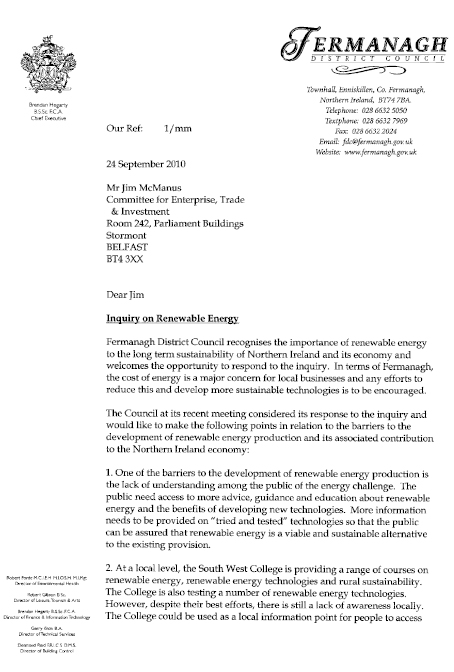
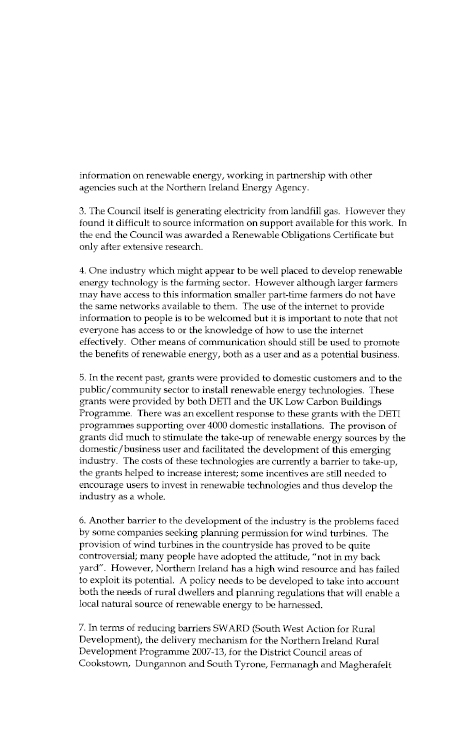

Response from Glen Dimplex
Glen Dimplex Response to Deti Inquiry into Barriers to the Development of Renewable Energy Production and its Associated Contribution to the Northern Ireland Economy 05/08/2010
Glen Dimplex employs around 500 people in Northern Ireland in the manufacture and distribution of electrical appliances. The manufacturing activity is based on 2 sites:
- Glen Electric in Newry manufactures electric panel heaters, portable convector heaters and oil filled radiators and bathroom fan heaters.
- Seagoe Technologies in Portadown manufactures electric storage heaters.
Glen Dimplex Northern Ireland is a distribution business, selling all of the Group's products into the Northern Ireland market. In recent years it has developed a market for renewable energy products including ground source heat pumps, air source heat pumps and solar thermal systems. To support this activity a brand new £3.5m facility was built in Craigavon in 2008, encompassing warehousing, commercial offices and a state of the art training centre for renewable technologies.
The development of renewable technologies is at the forefront of Glen Dimplex Group's strategic planning. As a key part of this strategy it is our intention to establish a new renewables business in Northern Ireland, encompassing an R&D Centre of Excellence and a manufacturing facility for Sustainable, Renewable products. As such an investment of £7m, is being made to take advantage of this market and to produce heat pumps in Newry and renewable energy highly efficient water storage tanks in Portadown. Production at both of these facilities will begin towards the end of 2010. This investment is being supported by InvestNI. The Group is already a leading player in the European renewables market and with this investment plans to be a leading player in the UK and Irish markets as well.
Our response to DETI's consultation is therefore based on our knowledge of the emerging energy markets in Europe, the UK and Ireland.
One of the early casualties of the new coalition government in London was the Low Carbon Buildings Programme (LCBP), which covered Northern Ireland as well as Great Britain. In Great Britain we now have the Feed-in Tariff for renewable generation schemes such as solar photo-voltaics and wind turbines which has been in operation since April 2010. From 2011 the government is also considering the introduction of a Renewable Heat Incentive to cover products such as heat pumps and solar thermal, which again is limited to Great Britain.
In Northern Ireland however the LCBP has been cancelled but there is no proposed replacement on the agenda. NIE has stepped into the breach with a limited range of capital grants and while these are very welcome they do not represent the same stimulus as the FIT or RHI have been designed to provide. This includes Solar Thermal, Wind, biomass and PV, with no current support for technologies such as Heat Pumps. Heat Pumps are one of the few renewable technologies that can generate energy 24 hours a day 365 days a year. They offer a clear alternative and a real solution to our CO2 reduction challenge in Northern Ireland. Glen Dimplex has committed to manufacture this technology in Newry on the back of 30 years experience from our heat pump business in Germany. There is a very strong case to argue for the inclusion of heat pump technology in any future programme, given the energy and CO2saving that can be delivered by such technology. In mature markets such as Germany, Austria and Sweden, Heat Pumps have been the renewable technology of choice for 30 years.
NIE offer key targeted programmes, such as the current solar thermal scheme for dairy farmers which is to be welcomed, however take up has been slow with the key reason being lack of awareness of the technology and the energy consumption currently used, as it is wrapped up in all other farm NIE bills.
NIE also recently launched a renewed capital grant on the 19th of July of £2000 per kWp, however at the time of writing (05/08/2010) this report we believe that there has been no expressed interest in this programme. This again highlights the short comming of the capital grant approach to stimulating the market, in stark contrast to what we see the FIT delivering in Great Britain.
For commercial organisations the Carbon Trust offers interest free loans, and there is an enhanced capital allowance scheme, which offers limited incentive in today's economic climate where it is a struggle for businesses to remain profitable.
In contrast to capital grants we believe Northern Ireland should be implementing schemes such as the FIT and RHI schemes in Great Britain. These are financed by a small levy on all consumers and remove the challenge of funding the initial capital investment, which tends to be a major hurdle to the development of renewable energy markets. Such mechanisms have proven to be effective and successful in other countries, and we see no reason for Northern Ireland to re-invent the wheel.
The benefit of such schemes is that they offer certainty of return at a time when we need it the most, both for the home owner and industry alike. It means we have stable demand with none of the boom and bust cycles associated with capital grants. This on a macro scale means that there is stability within the sector in terms of employment and growth. It is our assertion that the FIT implemented and the RHI planned would be the most stable and economic of solutions over the short and medium term for Northern Ireland. They also offer a smooth transition from an oil dependent economy to a renewable one as future energy prices inevitably rise, and oil and gas availability gradually declines. FIT and RHI are the proven mechanism of choice for economies such as Germany and Austria who have taken a clear lead in developing mature renewable energy markets.
As an example the investment required to convert a typical existing home to a heat pump system is around £8,000 to £10,000. A Renewable Heat Incentive could be used to fund the capital investment and generate a payback to the consumer on this investment.
From a running cost perspective, the Heat Pump is similar to oil or gas fired boilers at the standard electricity tariff. The RHI is therefore required to pay back the capital cost of the installation. A payback in the region of 5 – 8 years is recognised to be sufficiently attractive to encourage take-up of the technology. If a replacement heating system is required anyway then the payback on the incremental cost of a heat pump system would be considerably shorter.
The DECC proposal for Great Britain is that the RHI will be funded by a levy on suppliers of fossil fuels for heat. Obviously in Northern Ireland the funding of such a scheme needs to be tailored to the ability of consumers to pay a levy.
Invest NI provides very good support mechanisms for R&D activities in Northern Ireland and actively encourages collaboration between companies and with the universities.
In addition to the financial incentives for renewable technologies mentioned above, other mechanisms should be identified to encourage innovation and development of new energy technologies within Northern Ireland.
In the domestic housing sector, for example, focused financial support could be given to the deployment of new technologies to a fixed number of dwellings for each type of technology. Targets could be set on carbon reduction, energy efficiency and running costs. The projects should be linked to R&D activity based within Northern Ireland. By developing a vibrant home market and fostering a culture of innovation at home in Northern Ireland, an export market clearly follows, and Glen Dimplex who have a track record of exporting from Northern Ireland are leading the way in the manufacture and export of renewable technologies. But we must kick start our home market with mechanisms and leadership as seen in Great Britain with RHI and FIT.
The delivery mechanisms for renewable technologies are similar to existing heating systems, so a retraining and development of the existing installation base would make this possible. Many installers have already been trained in the installation of solar thermal systems and heat pumps. Further training and awareness is required and mechanisms that support training organisations should be considered.
The Building Regulations relate only to new buildings. However mechanisms should be considered to make key technologies mandatory. This has been successfully implemented in the Republic of Ireland. The gradual reduction in CO2 emissions towards the zero carbon targets is established in UK policy but it remains to be seen how it will be achieved in practice. Mandatory specification by building regulations would help accelerate this process.
Another area to consider is the energy performance of public buildings. A lot of discussion has taken place in this area but little action is apparent. Again there is scope to encourage Northern Ireland based R&D activity to look at larger buildings and offer mechanisms in this area, with local government taking the lead by example. Initially on a project basis but clearly with the potential for large scale roll-out within and beyond Northern Ireland.
In conclusion the two key mechanisms of RHI and FIT are essential if Northern Ireland is to be a seed-bed for businesses in the renewables field. Without them the logic for setting up such businesses in Northern Ireland is greatly reduced.
We would therefore strongly recommend that action be taken to bring Northern Ireland in line with the rest of the UK at the earliest possible opportunity.
Glen Dimplex contact for this response;
Jonathan Jennings,
Commercial Manager Renewables,
Glen Dimplex N.I. Limited,
5 Charlestown Avenue,
Charlestown Industrial Estate,
Craigavon,
Co. Armagh,
BT63 5ZF,
+ 353 86 0287828
+ 44 28 3833 7317
jonathan.jennings@dimplexrenewables.com
www.dimplexrenewables.com
Response from Green Energy 4 U
Contribution to: The inquiry into barriers to the development of renewable energy production and its associated contribution to the Northern Ireland economy
From: Greenenergy4u, 11 Dunturk Road, Castlewellan, BT31 9PF
As a major supplier and installer of renewable energy technologies throughout the island of Ireland and the UK I am pleased to have this opportunity to provide evidence of barriers to the development of renewable energy production, from my personal experience, to the Northern Ireland Assembly Committee for Enterprise, Trade and Investment.
One of the major barriers to the establishment of a successful renewable energy sector in Northern Ireland is the under-resourcing and under-training of the planning services, this issue still needs to be addressed - expecting the current planning regime to deliver on the future energy policy of NI is not a realistic situation, more needs to be done to support planners in their work.
As outlined in the UK legislation below, the planning service is a vital element in the development of a robust renewable energy production sector.
The UK Government's White Paper (2007) "Planning for a Sustainable Future" it states: "Planning is of fundamental importance to the quality of people's lives. When planning is done well it enables us to build thriving, healthy, sustainable communities where people want to work, shop, live or visit. It supports the economic development which is vital to create jobs."
Climate change is a key challenge facing our generation. As the Barker and Stern reports made clear, planning will be one of the elements required in a successful response to climate change and ensuring that the planning system plays its role in helping with mitigation and adaptation is therefore an important priority. Used positively planning has a significant contribution to make.
In 2009 the UK published its Renewable Energy Strategy, the strategy outlines how the UK intends to meet its legally-binding target of ensuing 15% of energy from renewable sources by 2020. There is a focus on the importance of: "Creating opportunities for individuals, communities and businesses to harness renewable energy." (www.decc.gov.uk)
According to UK government research, the benefits of meeting the proposed 15% renewables target include economic benefits which include business opportunities and the creation of up to 500,000 jobs. The Government has highlighted that a key issue in helping to hit the target will be reducing energy demand and the amount of energy required overall. It has suggested how much of the remaining energy might be generated from renewables sources such as electricity.
The following issues have been identified as vital to stimulate sufficient renewable electricity:
- Better planning
- Connecting to the grid
- Financial incentives
- Obligation to buy
The Northern Ireland Executive published its Programme for Government Document, "Building a Better Future", in 2007 (http://www.pfgbudgetni.gov.uk/finalpfg.pdf), which sets out the Executive's strategic priorities and key plans for 2008-2011. The document indicated where the Government's priorities lay when allocating their resources and capital investment. One of the main cross cutting themes was "Sustainability: building a sustainable future will be a key requirement for our economic, social and environmental policies and programmes."
With the impending Energy Strategy Framework in Northern Ireland looking to extend its present 2012 targets, it is vital that Local Government acknowledge that by 2012 Northern Ireland may not reach its initial target of 12% unless they ensure the smoother running of the planning application service for individuals and business.
In 2009, The Department of the Environment published the final version of Planning Policy Statement (PPS) 18 'Renewable Energy'. The aim of PPS 18 sets out planning policy for development that generates energy from renewable resources and that requires a submission of a planning application. (www.planningni.gov.uk)
On 12th February 2010 Enterprise Minister Arlene Foster published her response to the Statutory Consultation on the Northern Ireland Renewables Obligation. The consultation sought views on proposals to change the NI Renewables Obligations, (NIRO) 2010 and increase support for some small-scale generators.
The Minister said: "The Northern Ireland Renewables Obligation is the main support mechanism for incentivising renewable electricity generation, it will be essential if we are to meet our proposed 40% target by 2020."
The Minister concluded by referring to the Department of the Environment's new planning policy for renewable energy, PPS18. "The Planning Policy Statement (PPS)18 will assist the overall growth of the renewable sector in Northern Ireland. PPS18 aims to facilitate the siting of renewable energy generating facilities…this will help us to achieve the challenging targets for renewable energy as set out in the Strategic Energy Framework and to realise the benefits of renewable energy."
However lack of legislation for new and existing housing stock, the lack of regulation and the need for behavioural change are all barriers to the development of a Renewable Energy Sector in Northern Ireland.
In Northern Ireland almost half of the per capita carbon footprint is generated by the way buildings are used. Use of domestic energy accounts for a large proportion of Northern Ireland's use of fossil fuels - existing households are directly responsible for 31% of N.I's carbon emission. Some 75% of houses that will be lived in by 2050 are already built, if the government wants to achieve its ambitious climate change targets emissions from existing homes is a matter of priority.
Building regulations are responsible for improvements in the building standards of housing however most new developments build as required but not beyond. Energy Performance Certificates (EPCs) could be used to drive up the efficiency of existing houses as they come into the marketplace. Like the rising standards of new houses, regulations could be tightened to prevent the sale or let of houses in the bottom EPC bands. If regulation is one side of the coin then incentives are the other.
The new DFP Low Carbon Homes Scheme, which provides rates relief for new low carbon and zero carbon homes came into play in April 2010. The Energy Efficiency Homes Scheme, again which came into effect in April 2010, provides one off rates relief to people who install home insulation. Incentives such as these can be introductions for many home owners to a range of measures that they can take to make their homes more cost effective to maintain, and more attractive to potential buyers.
Ed Miliband's feed-in tariff is a policy mechanism designed to encourage the adoption of renewable energy sources and to help accelerate the move toward grid parity. It includes three key provisions: 1) guaranteed grid access, 2) long-term contracts for the electricity produced, and 3) purchase prices that are methodologically based on the cost of renewable energy generation [3] and tend towards grid parity. Under a feed-in tariff, an obligation is imposed on regional or national electric grid utilities to buy renewable electricity (electricity generated from renewable sources, such as solar power, wind power, wave and tidal power, biomass, hydropower and geothermal power), from all eligible participants.
The Northern Ireland Renewables Obligation is designed to incentivise renewable generation into the electricity generation market. These schemes were introduced by the Department of Trade and Industry, the Scottish Executive and the Department of Enterprise, Trade and Investment respectively and are administered by the Gas and Electricity Markets Authority.
Finally if government wants to stimulate behavioural change it is also important, that alongside a range of regulations and incentives sound and reliable advice is made available by a respected and known source, and most importantly from one central point.
Denmark is a classic example of how the development of an energy sector has demonstrated that through a persistent and active energy policy, sustainable growth is possible. Promotion of energy efficiency and renewable energy is fuelling sustainable economic growth. Initiatives for energy efficiency and renewable energy have had priority in Denmark for over 25 years. The Danish plans and initiatives have resulted in development of new technologies and of successful use of energy efficiency and renewable energy.
Initially the initiatives included - public information, the strengthening of building codes, energy audits with state subsidies to produce standardised reports of possible measures to reduce heat consumption and subsidies for weatherisation of houses, thermal insulation and regulation of heating, however after 10 years the subsidies were ended.
The background to Denmark's move to a more renewable society began during the economic boom in the 60's, then Denmark's energy efficiency was low. The economic growth of that decade lead to a large growth in the energy consumption, and increasing reliance on imported oil. This dependence was felt hard during the oil crisis in 1973, this crisis raised the Danish awareness of the need to save energy and to find alternative energy resources.
One of the first responses to this energy crises was large heat saving programs, these were followed by a more comprehensive energy plan, combining energy conservation with change from oil to coal, large-scale cogeneration and nuclear power. This national plan almost excluded renewable energy and the response from many concerned citizens and some scientists was to question the nuclear power plans. In 1975 the Danish Organisation for Renewable Energy (OVE) was formed and pressure from OVE as well as recommendations from independent scientists lead to state support for development of renewable energy.
In 1981, a new national energy plan was adopted and in 1983 an alternative energy plan was made by independent researchers from Danish universities, detailed analysis showed that energy efficiency, renewable energy and local cogeneration could give a cost-effective energy system with minimal use of fossil fuel and no nuclear power.
The Brundtland report "Our common future" from 1988 and the following decision by the parliament to make sustainable energy plans for the most important sectors. The Danish sustainable energy plan "Energy 2000" was ready in 1990, proposing increased energy efficiency, local cogeneration and more renewable energy. The goal of 20% CO2 reduction by 2005 from 1988 and introduction of CO2 taxes were parts of the new plan.
The "Energy2000" was followed by a new energy action plan, "Energy21", from 1996. It marked a continuation of the activities for a sustainable energy system and set with new targets, including indicative targets of 50% CO2 emission reduction 1990-2030 (weather adjusted figures) and of having 35% renewable energy in the Danish energy mix by 2030 ( from 5% in 1990).
One can see that optimizing energy efficiency at every step of the value chain from production and distribution to consumption by the end-user is central to the Danish policy. A mix of measures is used to promote further efficiencies to be gained and savings earned – for companies, citizes and Denmark. The government has established stringent building and appliance codes, public service campaigns on energy use, a public sector that sets an efficiency example, high taxes on energy use and voluntary agreements on energy savings with industry based on energy audits. The low energy intensity has come from a concerted effort by the government.
Science Direct states that: "Renewable electricity development has taken different paths across countries, underpinned by different policy frameworks. Although there has been a convergence to two main mechanisms, the feed-in tariff (FIT) and the renewable portfolio standard (RPS), much debate remains focused on the effectiveness of each for meeting multiple objectives, especially energy security, CO2 reduction and economic development. Although most countries share these objectives, their choice of policy varies. Denmark, Germany and the United Kingdom stand out as lead countries based on their experiences with the FIT and RPS and provide important lessons for other nations. The evidence from these three suggests that policy design and commitment are key factors for success.
Denmark and Germany have 10 years of experience with FITs and are world leaders in the field of renewable energy (RE) development. They are closest to meeting their RE targets and have been able to achieve several other objectives, especially industrial development and job creation, and in the case of Germany, CO2 emission reductions. Although other factors have been important in determining policy choice and implementation in these countries, the particular design features of the FIT allow it to address the needs of the sector."
Response from Green Party
South Down and Armagh Green Party
Saint Patrick Centre
Market Street
Downpatrick
BT30 6LZ
Enterprise, Trade and Investment Committee
Room 424,
Parliament Buildings,
Ballymiscaw,
Stormont,
Belfast,
BT4 3XX 8 August 2010
Dear Sir
Northern Ireland Assembly Committee for Enterprise, Trade and Investment Renewable Energy Inquiry
Please find below the submission of the South Down and Armagh Green Party to the above named Inquiry.
The Green Party strongly believes that renewable energy is key to the sustainable economic and environmental future. By addressing the problem of rising energy costs, energy insecurity, climate change and economic turmoil we can create a renewable energy economy where homeowners, famers and businesses are all part of the solution while at the same time being rewarded for their efforts.
However, barriers do currently exist which are preventing renewable energy- both large scale and micro-generation- from attaining parity with conventional fuels and so achieving its full potential.
Ireland has been set an ambitious target under the EU Renewables Directive for 16% of its final energy consumption to come from renewable sources by 2020. Within Northern Ireland, we are expected to provide 20% of our energy (electricity, transport and heat) from renewable sources by 2020.It is envisaged that a large proportion of this share would be met by electricity rather than from heat or transport energy modes. Separately, the Irish government and the Northern Ireland Assembly have set a target for 40% of its electricity to come from renewable sources by 2020 with a current penetration level of around 12%. The majority of this renewable electricity is expected to come from onshore wind energy.
The implications of this for Ireland are that to meet its targets will require a large increase in the penetration of renewable energy across the economy over a relatively short period of time. This will result in investment being needed to develop the appropriate infrastructure (grid, interconnection, electric vehicle charging points etc.) which enable renewable energy to reach its maximum potential and also putting in place and delivering the necessary policy support mechanisms such as feed-in tariffs, grant programmes, biofuels obligation scheme etc. There have been a number of initiatives to encourage renewable energy in Northern Ireland but these have been hampered to a certain degree by the existing obstacles to renewables.
Only as far back as 2004, there were as few as four hundred renewables systems operational in Northern Ireland. The Reconnect Grant Scheme, which provided up to 50% off the price of installation to homeowners, ends in March 2008 and had a target of 4000 homes installing renewables. This target is expected was met, and indeed surpassed. In Northern Ireland, these incentives encouraged the growth of a renewable energy industry which employs over 1000 people in over a hundred companies.
Similarly, in the Republic of Ireland, the 'Greener Homes Scheme' and 'House of Tomorrow' have also created a mushrooming in renewables businesses as more homeowners see the benefit of 'going green'. The advantages of installing renewable energy systems in homes are being realised by more and more people.
Small scale renewable energy includes heat creation as well as micro-generation of electricity. This gives each home the possibility of becoming self-sufficient in heat and electricity needs, improving efficiency, reducing costs and easing the burden on the wasteful, expensive grid infrastructure.
There are three main drivers behind the adoption of renewable energy, and these are security of supply, environmental protection and cost competitiveness. In terms of security, Ireland as a whole relies strongly on imported oil and gas, leaving us vulnerable to long supply chains, uncertainty in world politics and, of course, the advent of peak oil. Therefore, if we can provide our own energy from renewable sources such as wind, water, ground source heat or locally grown biomass, we can ensure a stable supply indefinitely. Furthermore, by having each building fitted to create its own heat and light, we can provide security of supply on a micro level also.
The environmental aspects of employing renewables have been the main argument in their favour. Fossil fuels are the single largest cause of climate change and so by having renewable sources we can reduce CO2 emissions. For example, in Northern Ireland alone, the total additional reduction in emissions is forecast to be in the region of 6500 tonnes per year by 2015. We have a requirement to produce 12% of our energy indigenously by 2012. In the case of biomass, carbon is offset by the growing of more plants, while having micro-generation of electricity reduces the load on power stations, where sixty per cent of energy escapes up the cooling tower.
As well as the positive environmental reasons for renewable energy, increasingly the financial argument for installing such systems has become just as important, which has encouraged homeowners and businesses to engage this sector. Previously, renewables were largely viewed as an inefficient, ineffective luxury installed as a token of environmentalism by those able to afford it. With the growing price of oil and falling cost of quality renewable technology, however, many people now see renewables as much as a way of reducing costs as a way of saving the planet. Given that a solar water heater can cut household heating bills by up to 60%, and a wood pellet boiler can heat a family home for a fraction of the price of oil over its lifetime, its easy to see why. Furthermore, given the cost of carbon to EU states, it is economically beneficial for governments to achieve lower emissions through the renewable generation of energy. This will enable the governments of Ireland to "combine the pursuit of low carbon economy with the pursuit of profit" in the words of the Stern Report.
Not only has the growth in the renewables sector been good for the environment and the homeowner or businessperson, it has also been a major boost for the industry members themselves. The number of highly skilled, private sector jobs created in Ireland already makes this a significant, home-grown economic sector. Further investment in renewables could see tens of thousands of people employed in this sector, from farmers growing biomass crops to heavy industry manufacturing wind turbines. The diversification of the world famous Harland and Wolff shipyards in Belfast to assembling wind turbines, with potential for producing their own, is a great example of this.
Given that encouraging business growth, indigenous investment and start-ups offer the best prospect for economic growth, and that small businesses create eighty per cent of cross border trade, it would be assumed that the Governments both North and South would be doing all in their power to support the small-scale renewables industry. While the majority of politicians recognise the importance of this sector for the economy and the environment, a number of recent decisions have threatened to disturb the growth and stability of the industry.
In Northern Ireland, former Secretary of State Peter Hain declared his support for renewables as opposed to nuclear as the future of energy for Northern Ireland. He introduced a £42million Environment and Renewable Energy Fund to encourage the use of alternative energies, including £8million for the Reconnect Scheme. These grants would help to build the industry to the point where they could facilitate the second part of Mr Hain's plan, the introduction of mandatory micro-generation into the building regulations so that all new homes would be required to have a form of renewable energy installed. This would maintain the capacity of the industry and remove the dependency of the sector on grant aid.
However, in the time since the power sharing executive was devolved, these progressive policies have been u-turned. Minister Dodds announced that the Reconnect grants would end in March 2008, as planned, yet at the same time the building regulations were curbed so as to exclude micro-generation. Therefore, the industry is being left high and dry without any support, whether grant incentive or legislative. This at a time when renewable energy is becoming ever important. Although the same could happen to the Grant scheme in the Republic of Ireland, the Government have introduced a requirement for renewable from July 2008. Where the North has an advantage in attitudes to renewable is in the incentives for micro-generation and feed-in to the grid in the form of Renewable Obligation Certificates, whilst in the Republic feed in tariffs and net-metering are non-existent.
The introduction of feed in tariffs in Britain, which has followed the example of most other European countries, is greatly boosting the renewable sector. This involves a homeowner, business or farm installing a renewable energy system, which reduces their consumption of conventional power, while at the same time they are given a tariff for any additional energy produced which they 'feed' on to the grid, thereby increasing renewable energy penetration, reducing the demand for fossil fuels and proving an income for the building owner. Unfortunately, the Northern Ireland Executive has failed to introduce feed-in tariffs at the same time as the rest of the UK, and may not do so at all, denying the opportunity to avail of this scheme to the NI public.
Building regulations play an important role in encouraging the incorporation of microgeneration technologies in new build. The UK government plans to introduce tighter building regulations requiring new homes to be zero carbon by 2016. In Ireland, government is looking at developing carbon-zero homes part of the public housing programme. The introduction of building regulations in Ireland in July 2008 (Part L) of mandatory microgeneration on all new homes in the Republic has placed an obligation for renewables in buildings which will make them more efficient for homeowners. However, there were plans for the introduction in Northern Ireland of the same, which would have seen a large increase in demand for microgeneration when the current construction dip ends and the housing market improves, but the Minister decided not to introduce this in 2008.
Planning procedures have also provided a barrier to the uptake of renewable energy. The Green Party been approached by a number of businesses which are trying to get planning permission for wind turbines where there have been no local objections, but are being refused because of mercurial local interpretation of planning policy by officials in Downpatrick. These businesses are being made to be pay large fees to apply; they then have to wait over 16 months for a response and in the end are being refused permission because of what appears to be a local personal bias against wind turbines in the planning office not found elsewhere in NI. These installations are vital as a means of achieving N.I.'s renewable energy targets, reducing our carbon footprint, creating employment opportunities and developing revenue opportunities for local businesses.
The introduction of support mechanisms, such as feed in tariffs, renewable heat incentives, carbon taxes or renewable energy loans, would increase the demand for renewable energy products. For example, in the Republic of Ireland, Energy Minister Eamon Ryan has introduced a support price structure for bio-energy i.e. use of natural materials for the production of electricity.
The guaranteed support price (REFIT) will range from 15 cent per kilowatt hour to 8.5 cent an hour depending on the technology deployed.
The technologies supported include Anaerobic Digestion Combined Heat and Power, Biomass Combined Heat and Power and Biomass Combustion, including provision for 30% co-firing of biomass in the three peat powered stations.
Taken together, these new Government tariffs will foster the development of a robust and sustainable biomass supply sector in Ireland. They will drive demand for biomass and support the measures already in place such as the REHEAT programme (Renewable Heat Deployment) and the Energy Crop grant schemes run by the Department of Agriculture, Fisheries and Food.
The Green Party in South Down has called for these incentives for farmers to grow renewable energy crops to be extended to Northern Ireland as a means of supporting rural producers and tackling energy needs.
Local famers should have the same opportunities as those in the Republic of Ireland to grow crops which are economically viable and which will produce a sustainable agricultural income while helping to tackle climate change. This scheme should be introduced by the Minister responsible as soon as possible as it has so many positive aspects.
Farmers could be at the forefront of the green economy and the fight against climate change. This new support price has the potential to contribute to economic recovery in rural Ireland as well as reducing overall national dependence on imported fossil fuels. Business will also benefit from the ability to produce their own electricity on-site and sell the surplus to the national grid. This would have major benefits for South Down and across Northern Ireland and needs to be copied, particularly as we have a Single Electricity Market on this island so any incentives in one jurisdiction will negatively impact on the other.
With the planned reductions in subsidies from the Common Agricultural Policy in the future, it is critical that farmers and rural producers are offered an alternative, sustainable form of living and such a scheme would provide that support.
A significant barrier to developing a low-carbon economy in Ireland is the electricity grid. The grid and its associated infrastructure were historically not designed with renewable energy or dynamic demand side response in mind. Although the grid has been enhanced over the years, it was originally designed essentially to connect large point-source producers to largely passive users. Generally speaking, it is weakest in the areas where the best renewables resources are located – in western parts of the country.
The opportunities do exist for a vibrant renewable energy economy in Northern Ireland and across the island of Ireland, which embraces the agricultural, manufacturing, service and academic sectors, as well as households and other businesses. Many steps have to be taken to meet the challenges of peak oil, climate change and economic instability, but barriers still remain which prevent renewable energy from playing its part in meeting these challenges. The Green Party will continue to campaign to ensure that renewable energy is the foundation of energy policy and economic sustainability for the future.
We hope these observations will be helpful in to the Committee in your deliberations and would appreciate the opportunity to speak to you in person on this issue.
Yours sincerely
Cllr Cadogan Enright
Chair, South Down and Armagh Green Party
Response from GT Energy
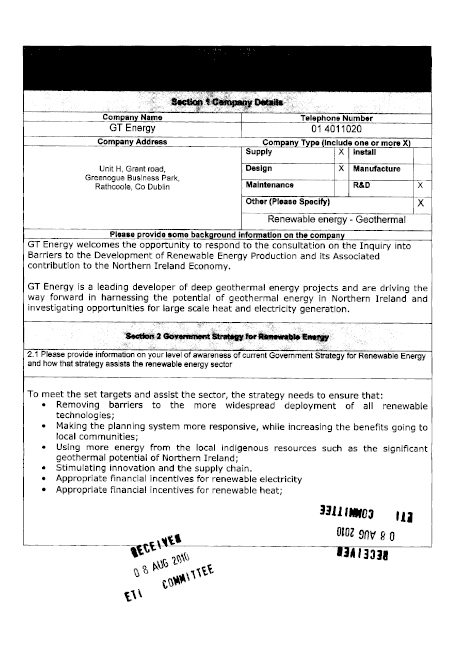
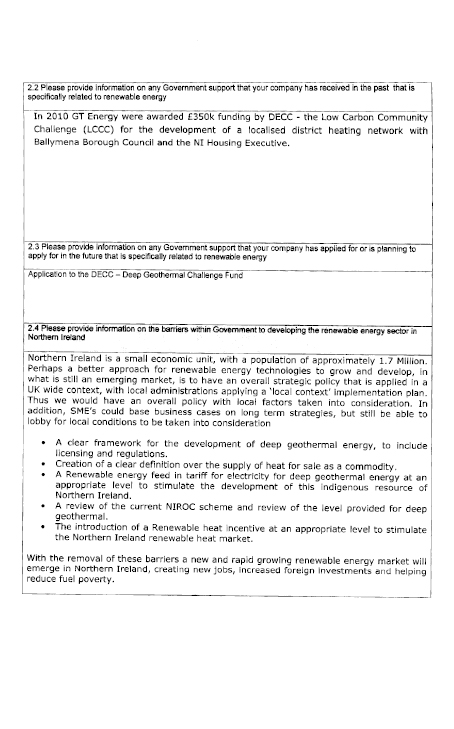
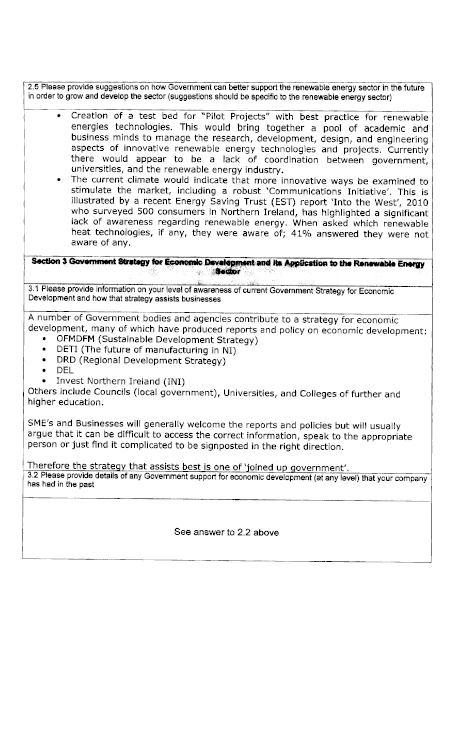
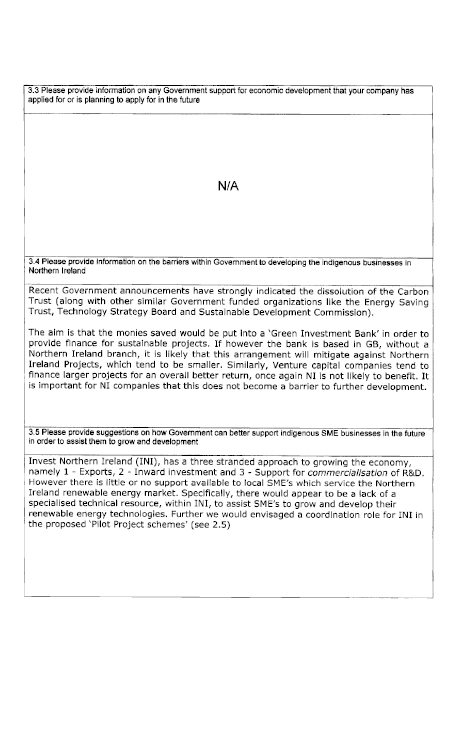

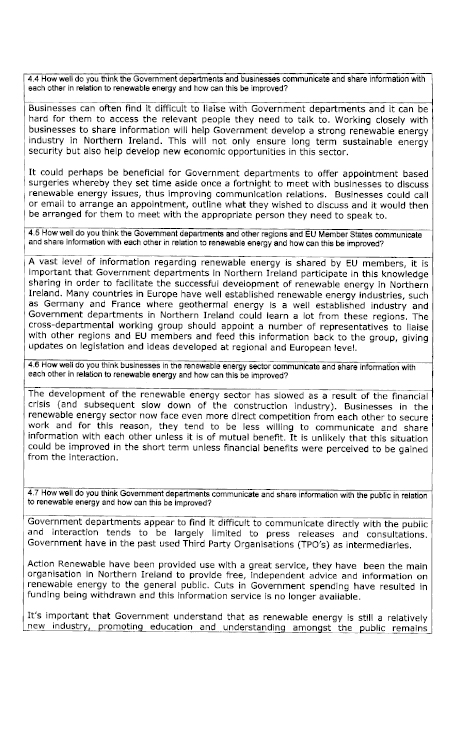
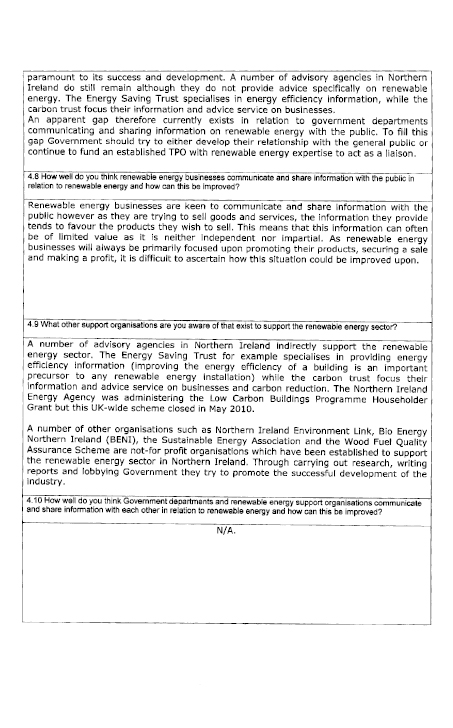
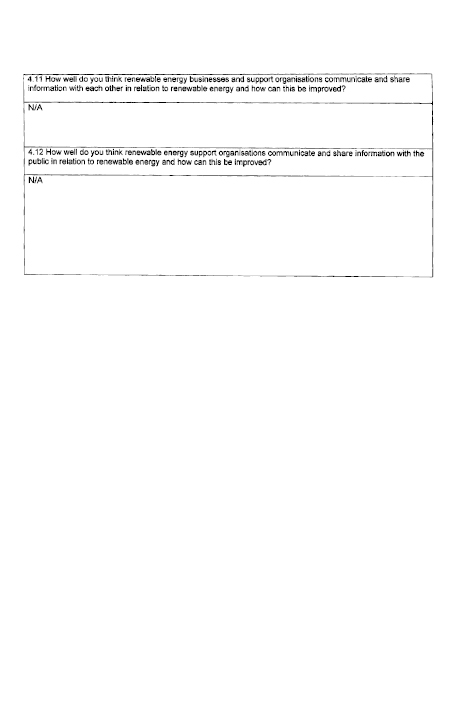
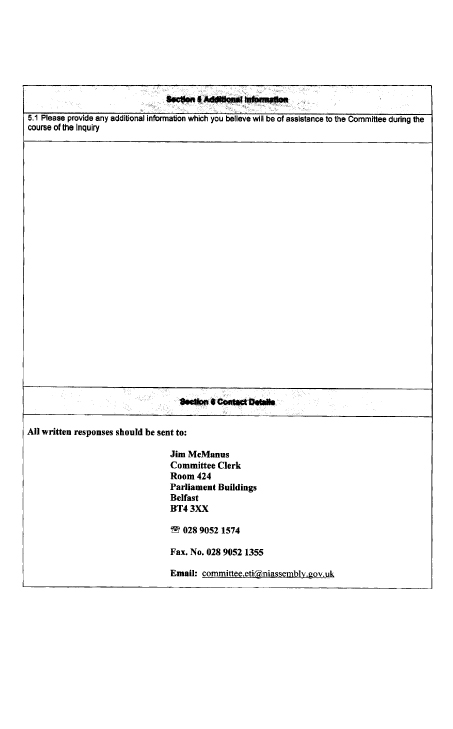
Response from IBEC - CBI Joint Business Council (JBC)
IBEC-CBI Joint Business Council (JBC) response to Committee on Enterprise, Trade and Investment Inquiry into Barriers to the Development of Renewable Energy Production and its Associated contribution to the Northern Ireland Economy.
11 August 2010
Section 1 Company Details
The IBEC-CBI Joint Business Council (JBC) is a partnership between the two business communities on the island of Ireland via the Confederation of British Industry (CBI) in Northern Ireland and the Irish Business and Employers' Confederation (IBEC) in Ireland. Formed in 1991, the Council's primary role is to promote economic growth and development on the island of Ireland so as to advance international competitiveness for the benefit of both jurisdictions. Working in collaboration with its member companies and strategic partners, JBC provides a single voice for business on the island of Ireland on issues where industry deems it appropriate to do so.
The CBI is the UK's leading business organisation, speaking for some 240,000 businesses that together employ around a third of the private sector workforce. With offices across the UK as well as representation in Brussels, Washington, Beijing and Delhi, the CBI communicates the British business voice around the world.
The JBC welcomes the opportunity to respond to this inquiry into the barriers to the development of renewable energy production in Northern Ireland.
Section 2-Government Strategy for Renewable Energy
In Section 2 we explore the level of awareness of Government strategy for renewable energy both nationally and locally among CBI members and key industry players. We outline the barriers within government to developing the renewable energy sector and provide recommendations on how this industry can be stimulated for the overall economic value of Northern Ireland.
2.1 Strategic Energy Framework
Members have articulated a clear understanding of the overall UK vision and renewable strategy. Members expressed a deeper understanding of the strategies of other regions such as Scotland; but a lack of awareness of local N.I. government strategy for renewable energy.
The DETI Strategic Energy Framework remains unpublished despite initial announcements that this would happen in early 2010. This lack of endorsed vision creates a void and does not inspire confidence amongst the investment community to consider pursuing opportunities in Northern Ireland.
Recommendation: The executive must urgently prioritise the release of the Strategic Energy Framework, with balanced objectives for renewable electricity and renewable heat and ensure that this is communicated to all stakeholders.
2.2 Joined up Government
Northern Ireland does not have an equivalent to the Department of Energy and Climate Change (DECC) or DECC's Office of Renewable Energy Deployment in UK, which often leads to a lack of accountability and can often conveys a message of lack of priority for government. Members suggest that the current N.I. structure creates a maze of bureaucracy given the fact that four separate government departments have direct/indirect influence in the renewable sector:
- Department of Enterprise, Trade & Investment-(energy policy)
- Department for Regional Development-(transport, water and regional development)
- Department of Environment – (planning service, waste and climate change)
- OFMDFM- (sustainability policy)
This structure creates confusion for new and existing market participants in the renewable sector.
Recommendation: A consistent cross-Government approach is needed: so cost effective opportunities to encourage renewable energy production through other policy areas are recognised. We recommend the establishment of a cross government working group focused on renewable targets with an appropriate "renewable champion" established.
2.3 Green Procurement
The NI Assembly is a major buyer in its own right of goods and services; the public procurement market on the island of Ireland is worth circa £15.2bn. This figure comprises an indicative annual spend of £2.24 bn in Northern Ireland (based on 2008-2009 data) and in the region of £13.6bn in Ireland (based on 2007-2008 data). These figures, if combined, would represent a sizable proportion of the economic activity on the island of Ireland, equating to circa 10.3 per cent of the current Gross Domestic Product of the island of Ireland. Public expenditure alone has the power and capability of stimulating renewable production locally.
Recommendation: the roll out of green procurement in the public service in NI can create significant opportunities for green enterprises. By taking environmental criteria into account in procurement procedures, NI can promote environmentally friendly production and stimulate employment in the emerging sector, while maintaining transparency and ensuring value for money. In September 2008, the European council adopted a target of 50% green public procurement to be reached by EU member states by the year 2010. Although this target has not been met there is an opportunity for Northern Ireland to lead by example and prepare local indigenous firms to compete within the Green Public Procurement in Europe.
2.4 Regional Disparities must be harmonised
The chart below depicts a bleak picture of renewable generation for Northern Ireland, despite our wealth of renewable resources. Members in particular believe that Scotland is an example of best practice for Northern Ireland. The Scottish government has articulated a vision for the area to become a centre of excellence for marine energy. The government has stimulated this production through a £13 million Wave and Tidal Energy Support Scheme and have announced a £10 million Saltire Prize for one marine power project. The Saltire prize is an innovation prize to accelerate the development of wave and tidal technologies in Scottish waters. The prize is open to anyone to apply but the project must be deployed in Scottish waters and an award is to be made in July 2017.
Recommendation: Northern Ireland should consider a similar innovation award to stimulate local production of renewable energy production.
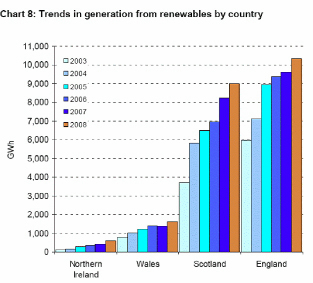
Members suggest that regional disparities create confusion and would suggest a more joined up regional approach, for example:
- Renewal's Obligation Certificates (ROCs) started in 2002 with support available to 2037 in Great Britain. In Northern Ireland it is only until 2033.
- Offshore wind receive1.5 ROCs per MWh and marine technologies will receive 2 ROCs per MWh in Northern Ireland. Compared to Scotland which currently offers 5 ROCs for wave and 3 ROCs for tidal generation because Scotland has the power to vary the ROC rates offered for offshore renewable electricity generation. In Northern Ireland, the power to issue ROCs in respect offshore generation currently lies with DECC, unlike Scotland where this power has been devolved to the Scottish government. We welcome the current consultation for Renewable Obligation (Amendment) Order (Northern Ireland) 2011 which proposes greater alignment with other UK regions and has raised the issue of control of offshore ROC's with DECC.
- DETI offers the highest regional rate of 1 ROC to encourage the deployment of landfill gas in NI in comparison to a recently reduced rate of 0.25 ROCs in GB.
- Feed-In-Tariffs scheme covers Great Britain only although Northern Ireland is considering introducing its own primary legislation to introduce a small scale feed-in-tariff, subject to further analysis of the costs of such a scheme which would be borne by consumers.
- The UK government is also implementing a Renewable Heat Incentive (RHI) as a policy measure to support the decarbonisation of the heat supply across all sectors. There appears to be a reluctance to adopt a national government measure such as this in Northern Ireland, creating confusion and uncertainty.
Recommendation: The Executive/Assembly must recognise that developers will only invest when they are confident that they will make an adequate return on a project and these regional differences are placing Northern Ireland in an uneven standing. The Assembly must ensure that Northern Ireland is competitively placed to attract and nurture a renewable industry in Northern Ireland, these regional differences should be harmonised wherever possible and in areas where policy is different a clear statement should be provided. The possibilities of developing incentives for Renewable Heat should be explored.
2.5 Tri-Partite Collaboration key to Competitive Advantage
Northern Ireland must leverage existing partnerships with the Republic of Ireland and Scotland through the work of the Isles Project and British Irish Council. Collectively these three regions can benefit from a tri-partite collaboration instead of individually competing with each other within the renewable sphere.
Recommendation: "All-Island Collaboration offers a unique and relatively unexploited source of competitive advantage for the island of Ireland" to attract inward investment, leverage existing expertise including the research capabilities within the universities within the island and exhaust available European funding for Renewable Energy. This collaboration will be vital in determining the resolution to the jurisdiction of seabed ownership in the border areas.
2.6 One-Stop Shop for Renewable Energy
Ad hoc government initiatives over the preceding decade have resulted in a large number of government funded quangos and funds backing low carbon innovation and commercialisation in the UK. While these efforts should be commended, the delivery of this support could be radically improved. (National Audit office, 2010, Government funding for developing energy technologies)
The lack of co-ordination and common branding has made it hard for businesses and investors to navigate the bureaucracy.
Recommendation: The creation of a unified point to advise and inform business how to access grants and participate in government supported schemes as well as other opportunities available to industry.
2.7 Diverse, Cost Effective Energy Mix
We see value in differentiating the level of subsidy by scale and technology in order to ensure that a range of technologies are brought to market in different sectors. The cost of abatement varies significantly between the different technologies and pump-priming support for a wide range of technologies should help to drive down costs more quickly. The levels of subsidy support for renewables should focus on a cost effective technologies.
Energy from waste should be encouraged. The Executive/Assembly is right to stress the importance of the potential for anaerobic digestion and biogas to both minimise landfilling and maximise recovered energy from largely untapped resources. This has the additional benefit of actively engaging the public in renewable energy policy, albeit less directly than micro generation, through segregating household waste. The Biomass Process Challenge Fund announced by DARD in June 2010 is a welcome addition to any farm businesses installing Anaerobic Digestion renewable energy facilities.
2.8 Energy Prices and Competitiveness must not be overlooked
UK energy markets have not been a comfortable environment for some business energy users, notably the energy intensive sector, in recent years. Wholesale prices in both electricity and gas markets have risen sharply, and have been much more volatile than in competitor economies[1]. While large users can often manage volatility through contractual arrangements, this in turn comes at a cost. Projections for future price increases are difficult to make, as they rest on assumptions about future input and technology costs. But most scenarios for future electricity mixes show consequent price increases.
Northern Ireland companies are particularly exposed with prices of electricity (and to some extent gas) remaining higher than n the rest of the UK. Protecting the competitiveness of Northern Ireland industrial base is clearly vital.
Given the upward future trend in prices, it is vital that policy encourages the competition between companies and technologies that is the only way to exert any countervailing downward price pressure. In terms of the policy proposals we make to support a 'balanced pathway' of a mix of renewable and other technologies, this has important implications.
Specifically, it reinforces the value of setting a lower indicative 'target' for the amount of renewable electricity generation by 2020. This will help the UK avoid getting locked into a high cost path if offshore wind does turn out to be as expensive as our modelling predicts it may. If, however, offshore wind becomes cheaper than alternative low carbon generation, perhaps through supply chain constraints easing, or technological innovation in turbine design and construction, then companies still have a commercial incentive to invest more in offshore wind.
No one likes paying more for energy, whether they are individuals or business managers. For most of us such price rises are likely to be an unavoidable consequence of renewing and decarbonising our energy system, (and will create an additional incentive to achieve energy efficiency). For most firms, competing primarily in UK markets or for whom energy costs are only a small proportion of total costs, the direct impact on their competitiveness should be manageable. But for other sectors, defined by the EU as 'carbon leakage' sectors, their competitiveness can be undermined as their costs rise more than their competitors. The threat of such trends makes Northern Ireland a less and less attractive place for industrial investment in those sectors is too great to ignore. At the very time when there is much enthusiasm for promoting the role of manufacturing in the economy, it makes no sense at all to accept an energy future which is working against that.
In time, an international agreement which ensures that installations in 'carbon leakage' sectors across the world face comparable carbon costs should be in place. But in the interim, a solution must be found. Energy efficiency will have some role to play but most energy-intensive sectors already have excellent records in this field, and diminishing returns are often setting in. The recession is also making it more difficult for firms to fund up-front investment to realise remaining gains. Other options include load following (where there may be scope for some large energy users to work with the system operator to develop better day ahead planning to manage the load curve and shut down during demand peaks when prices are highest), and increased on site generation for large industrials (e.g. industrial CHP/energy from waste).
It is striking how the CBI's modelling suggests that the projected increase in electricity prices comes from policy rather than fuel costs. Policy costs (e.g. the Renewable Heat Incentive) will also impact on gas prices.
Recommendation: Decisive action will still be needed to protect the competitiveness of energy-intensive sectors given likely price rises. The Government should aim for a balanced mix of renewable technologies and explore exemptions from new policy costs for the most exposed energy intensive sectors at risk of carbon leakage.
2.9 An effective, streamlined planning system is needed'
Reform of the planning system is vital to give investors more certainty. To achieve our renewable target requires a large amount of renewable installations of various sizes to be deployed across the Northern Ireland, both on land and offshore. If this deployment is undermined by the planning system to any degree, the target will not be met. Without fundamental reform of the planning and consent process, 40% renewables by 2020 will not be achieved.
Members have suggested that the planning process is discordant, often requiring duplicative effort, and the complexities of dealing with multiple agencies are a constraint on businesses receiving timely planning decisions. For example, the current offshore electricity licensing and consenting regime involves:
- A lease from the crown estate (as owners of the seabed).
- Food and Environment Protection Act (FEPA) licence from the Northern Ireland Environment Agency (NIEA) required for placing anything on or removing material from the seabed.
- Electricity generation consent from Department of Enterprise, Trade and Investment (DETI) under the Electricity Order 1992.
- Within their respective legislative frameworks, Northern Ireland Environment Agency; Department of Enterprise, Trade and Investment and Department of Environment Planning Service also require three separate Environmental Impact Assessment (EIA) regulations to be met.
Recommendation: It is imperative that we develop a more streamlined and timetabled procedural guide which would provide clarity for all parties and would help create a smooth development pathway for further offshore renewable energy projects coming forward. Inter-departmental collaboration between various agencies must be encouraged to reduce the planning costs and risk of project delays.
The 2009 Northern Ireland Audit Office report on Planning Service Performance highlighted that:
- The department consistently failed to meet self-set targets
- The audit office estimated the cost per planning application actually increased by 59% from 2004-2005 to 2008-2009
- The audit office estimated the number of decisions per planner has fallen by 19% during 2007-2009.
Clearly these findings underscore a serious problem which is a constraint on energy developers receiving timely planning decisions. Investor perception that project timescales will be unpredictably elongated by the planning system will also undermine investor appetite for the sector.
Recommendation: We must speed up the system and make it more predictable. Consider the establishment of an Infrastructure Planning Commission in Northern Ireland to take decisions on significant projects, providing clear guidance for planners that recognises the need for renewable, and streamlining the planning process.
Members also raised concern with the lack of appropriate expertise to deal with complex energy developments when they occur on such an infrequent basis.
Recommendation: One option might be to create teams of expert planners who can be 'parachuted in' to address resource or technical difficulties in examining renewable development proposals. Better education and informing the planning service of the benefits and advantages of renewable energy schemes is also required. For example the Welsh government has provided training to planning officers on renewable energy and also published a Renewable Energy Toolkit.
Some members have suggested that often delays are caused by public hostility to many forms of sustainable infrastructure such as energy from waste, where the public often misunderstand what is involved with the plants. This often causes a large number of objections and appeals.
Recommendation: The Government should continue in its efforts to help energy developers and local authorities agree affordable planning obligations or 'community benefits' that make energy development more acceptable to local people and businesses. Government must play a role in public education to dispel and challenge the many existing myths and falsehoods of renewable energy production. Our planning system must enable renewable deployment in appropriate places, at the right time, and in a way that gives business the confidence to invest.
2.10 Electricity Grid
The capacity of the electricity grid to incorporate renewables is cited as a significant obstacle to development[2]. EirGrid has stated:
"Capacity has remained largely unchanged in the last 20 years, a period that has seen a growth of 150% in the electricity demand being carried by the system. To facilitate the necessary increase in renewable generation and to adequately meet the demands of the electricity customer, the capacity of the bulk transmission system will need to be doubled by 2025.[3]"
The All Island Grid study in 2009 concluded that it was technically feasible for up to 42% of power generation to be from renewable resources. This would however, only be possible in the context of a significant grid strengthening programme. The grid study concluded that some 200km of new grid transmission and around 1500km of grid distribution network would be required to manage accommodating these higher levels. EirGrid in the Republic Of Ireland is planning some £4 billion Euros investment up until 2025 and across the Great Britain network upgrading to 2020 will cost over £4.5 billion.
Major investment in infrastructure is clearly required over the next decade. It is in all consumers' interests that this is done as efficiently and effectively as possible. The Executive has a major responsibility to provide the necessary political leadership to ensure the environment for such investment is attractive in order to help drive down the cost and the risk involved. The cost of having to construct underground transmission lines compared to overhead lines is estimated to be higher by a factor of six. The cost of capital will also have an important bearing on final consumer cost and needs to be minimised. It is also essential that we invest in the right infrastructure and to achieve this we need to have an excellent understanding of how demand is likely to change and can be managed more effectively through smart metering and the development of 'smart grid' technology. Where appropriate, the Regional Development Strategy should identify 'infrastructure corridors' to assist in overcoming the risk of planning delays and to minimise the cost of developing the grid. We have previously stressed that a strategic approach to the development of the necessary grid upgrading/extension is required to minimise the number of transmission lines required. Failure to deliver the necessary grid strengthening at the lowest cost will increase the level of fuel poverty.
In terms of the priorities CBI members wish to make the following comments:
- Further interconnection will help integrate the island with the British and continental European systems. This will aid renewable integration and help the island benefit from combined regional advantages. It will also tend to bring wholesale prices on the island in line with those across the region and therefore contribute to competitiveness. It will support security of supply, assist the achievement of our renewable targets and potentially enhance competition in the all-island electricity market.
- The Single Electricity Market requirement is a general one on Systems Operation Northern Ireland (SONI) and Northern Ireland Electricity (NIE) to develop the All Island system optimally. Constraints on both systems and the North-South interconnector affect the SEM by causing higher constraint payment and inhibiting competition. The assembly must ensure that closer working relationships with the grid owner and system operator in development of grid strengthening proposals to absorb higher levels of renewable generation on an all-island bases. Key to the delivery of new infrastructure will be the resolution of planning considerations, and timely consents to new infrastructure.
- Every effort must be made to reduce technical barriers to integration with the larger GB market and to encourage the entry of new suppliers – various technical issues associated with the Moyle Interconnector (including different 'gate closure' times need to be urgently resolved). The length of time required for renewable energy projects to connect to the grid has acted as a major impediment to market development. CBI advocate that large projects or those with a strategic contribution to the green economy or progress NI renewable targets at least cost, promote competition should be prioritised as they are likely to have the scale and expertise to be commercially successfully.
2.11 Renewable Obligation Certificates
The CBI believes that the Renewable Obligation is the best long-term policy instrument to support the deployment of renewable technologies Priority should be given to deploying lowest cost renewable technologies. The chart below shows the cost per MWh of different types of renewable technology at different scales (for example, the cost per MWh of renewable electricity reaching either 28% of total electricity or 32%). Electricity microgeneration stands out as one of the least cost-effective options.
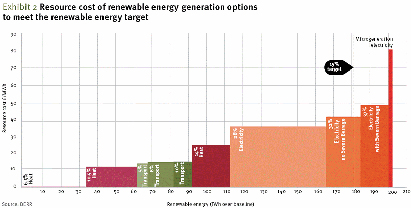
Recommendation: Any modifications to incentives (e.g. ROCs, feed-in tariffs, Renewable Heat Incentive, etc) should be signalled in advance and in a timely manner to allow for an orderly change in investment strategies when required. We would encourage the Executive/Assembly to build upon the ROCs regime and extend them to 2037, in order to be consistent with other parts of the UK.
Recommendation: Micro-generation has attractions in terms of engaging the public, but the CBI does not believe that a case has been made for it in terms of public subsidy. Electricity micro-generation should not be seen as a priority in terms of public subsidy for the Executive Assembly.
2.12 Stem & Research Capability
There are international opportunities for local enterprises to compete for the estimated $26 trillion that will need to be spent on global energy infrastructure to 2030. (International Energy Agency 2008.World Energy Outlook, Paris). According to Forfas, the global environmental goods and services sector is expected to be worth $800 billion by 2015 and energy goods and services are a major component. (Statement on Energy, October 2009, Forfás).
The NI assembly must address fundamental barriers to ensure that indigenous companies can seize these opportunities through:
- Increasing the supply of Science, Technology, Engineering and Mathematics (STEM) graduates.
- Improving the public research capability for the renewable industry.
The recent Programme for Government focus in Northern Ireland aims to increase by 25 % the number of students at graduate and postgraduate level studying Science, Technology, Engineering and Mathematics (STEM). To meet this target, government must encourage a strong partnership working between local education providers and businesses to ensure future supply of "low carbon skills" in Northern Ireland. This will require engagement with sector representatives to develop technical training courses and higher education programmes that anticipate low carbon technologies and reflect changes in industry.
Research Centres
The level of public spending for R&D does not match the scale of the challenge. The UK currently spends 1.78% GDP on R&D compared to 2.67 % in the USA and 3.17% in Japan. Public funding for energy related R&D as a share of GDP is the lowest in Europe about one third of the EU average of 0.17%. (Climate Change: Everyone's Business, CBI). IN Northern Ireland research and development spending is even lower.
Further investment in research is required to ensure developments are efficient enough and cost effective to deploy on a large scale. The Energy Technology Partnership (ETP) in Scotland is an exemplar model of best practice for the Executive/Assembly to consider, ETP is an alliance of Scottish universities engaged in world-class energy research, development and demonstration which involves 250 academics and 600 researchers. ETP leads in research programmes and investments valued at £300m and are funded through a variety of Scottish, European and international sources. ETP engages in UK and international partnerships with academia and industry. ETP has recently secured funding for a major
Scottish PhD program which will deliver 100 local Post Doctorates over a 5 year period in Renewable Energy Technologies.
Recommendation: Northern Ireland needs a 'Centre of Excellence' for renewable energy which would marry academia and business in the design and engineering aspects of innovative renewable energy technologies and projects. In some cases, difficulties in making theoretical technologies practical can be a barrier.
2.13 Investors Confidence
The renewable energy landscape is plagued by confidence gaps among investors given high technology risks, a shortage of skilled workforce, lack of transparency and uncertainty in government policy and high capital requirements for commercialisation. The scale of investment required to meet UK climate change and renewable energy targets is unprecedented, with estimates of investment required reaching £550 billion between now and 2020[4]. Given that much of the investment for the RES must come from private sector investment, investor uncertainty must be avoided wherever possible.
Renewable technologies often get caught in the "valley of death"[5], where investments are often considered too capital intensive for a venture capitalist.
Recommendation: The Assembly must urgently address investor confidence through the following mechanisms:
- ROCs should be continued and uprated to drive a sensible expansion in renewable electricity, given the urgent need to maintain investment levels and investor confidence. It will also be important to avoid reviewing the RO policy too often, as this may be equally disruptive to investment decisions.
- A long term, stable and attractive policy framework is necessary to encourage investment. Other measures include targeted incentives to facilitate inward investment by overseas companies into design, manufacturing, installation and operational capabilities and encourage existing Northern Ireland companies to diversify into RES markets.
- The adoption of a "Green Investment Bank" could help to remove barriers and rapidly increase investment in the low carbon infrastructure and technologies that Northern Ireland urgently needs.
- The aforementioned planning reform must be considered to restore investor confidence and minimise the potential for costly project delays.
- A consistent cross government department approach is needed so cost effective opportunities to encourage renewables through other policy areas are recognised such as in planning, skills and central procurement policies.
2.14 Financial Support
In the age of austerity there is limited opportunity for direct Government support and a shortage of available funding from traditional sources for the required level of renewable investment. Northern Ireland should exploit/consider the following funding avenues;
- Engagement with the European Investment Bank which is currently providing up to £700 million towards bringing forward onshore wind projects up to the value of £1.4 billion in the UK. EIB President Philippe Maystadt said: "This year we expect to lend more than 1 billion euro for energy efficiency-related projects throughout the European Union"[6].
- Cordis - EU Research Funding developed as part of the Seventh Framework Programme enables public and private bodies to apply for funding in a variety of areas. Eligible bodies include small to medium enterprises, university and local, national or regional government administrations. Energy falls under this funding program and fosters collaborative research across Europe and other partner countries.
- ELENA - on 15 December 2009, the European Commission announced the launch of a grant aid initiative to help local and regional authorities make investments in energy efficiency and renewable energy. The ELENA (European Local Energy Assistance) facility is designed to help cities and regions, (through the provision of technical assistance) to structure and implement projects in the most efficient way so they can attract outside finance. The ELENA facility aims to help cities and regions implement viable investment projects in the areas of energy efficiency, renewable energy sources and sustainable urban transport, replicating success stories from other parts of Europe. The technical assistance will be funded from the Intelligent Energy - Europe II (IEE) programme. A budget of 15 million euro is available for the first year of facility operation. Economic and Monetary Affairs Commissioner Joaquín Almunia added: "The ELENA facility, created in partnership between DG ECFIN, TREN and EIB, will ensure that public administrations in Europe have access to specialist financing and technical skills to deliver large scale investment programmes in energy efficiency and renewable technologies that will contribute to fighting climate change and to the creation of much-needed new jobs."[7].
- The LIFE+ Programme has available some €700 million for environmental projects in 2008-2013. SMEs are eligible to seek project funding through an annual, competitive process - the standard grant rate is 50%. The LIFE+ priorities for SMEs are:
- ETAP: Innovative or pilot projects for the demonstration and dissemination of innovative technologies and practices
- ECAP: Innovative or pilot projects for improving environmental performance (individually or at a network level)
- UK Marine Action Plan has investment of £60 million in UK marine energy infrastructure and technology including wave and tidal energy testing centre. NI companies should leverage these potential funding streams.
- Shell Springboard provides up to £40,000 to selected small businesses that have potential commercial ideas for products and services that contribute to tackling climate change.
Recommendation: The NI Executive/Assembly must ensure that indigenous businesses are equipped with the necessary information and access to support in order to ensure these funding opportunities are maximised and local applications are successful.
Section 3 Government Strategy for Economic Development and its Application to the Renewable Energy Sector
In section 3, we explore the barriers within government to developing indigenous business and provide suggestions on how government policy can better support SME businesses.
3.1 Access to Finance
Access to adequate and appropriate sources of finance is vital for the growth of SMEs. Without it, innovation and investment cannot take place. According to the Bank of England's most recent Trends in Lending report, overall lending to businesses contracted by £2.3bn in May - more than double the £1.1bn slide seen in April. Lending to private firms was down 4.4% year-on-year in June, in contrast with the pre-credit crunch era, when it was growing at an annual rate of almost 20%.
What is needed is a holistic review into funding of all types for growing businesses. The whole funding lifecycle needs to be reviewed to identify where the gaps exist and what policy options are required to create a coherent-unified funding system for growing SMEs.
Business and future policy makers must also now acknowledge that the cost of finance will be more expensive than it was before the crunch. Rates and prices prior to the recession were too low and unsustainable and so future business growth funding must be maintained for measures that encourage growth – and in particular, we need to facilitate an efficient supply of appropriate finance to SMEs.
The NI Executive/Assembly needs to encourage asset and equity finance, including business angel investment. This is a matter of stimulating demand as much as it is of encouraging supply – building the capacity for SMEs to understand these sources of finance and make themselves attractive as recipients of non-bank finance.
3.2 Energy Efficiency
Government action is needed to help SMEs realise the opportunities and long-term cost savings of implementing energy efficiency measures. Such as promoting low-interest loans through the Carbon Trust for investment in energy efficiency measures.
In the recent IBEC-CBI Joint Business Council (JBC) survey shows the biggest barrier to investment in energy efficiency are cost of technology and the lack of incentives. As part of the review of the Carbon Trust, we need to push for the retention of interest free loans.
3.3 Burden of Regulation
The level of regulation remains a key concern of UK employers, with many businesses struggling to cope with the relentless pace of new regulation. For business, and small firms in particular, this translates into time and money spent on complying with government imposed requirements rather than wealth and job creation.
New laws since 1998 have added £70bn to business costs - equivalent to employing 215,090 people in full time jobs at average earnings. The costs of new regulations are almost equal to a quarter of a million jobs.[8]
CBI SME members do not wish to be exempt from employment legislation because this would be a disincentive to growth. Instead, we want regulations, new and old, to conform to the principles of better regulation: proportionate, consistent, accountable, targeted and transparent.
3.4 Prompt payment code
Business – particularly SMEs – need certainty about when they will be paid to ensure effective cash flow management – late payment against an invoice date and contractual terms affects the survival of businesses. The NI assembly should actively promote the Prompt Payment Code which ensures firms pay their suppliers on time and do not attempt to change their payment terms retrospectively. The prompt payment code delivers a signal to the market of confidence and sound financial wellbeing that in turn promotes further business opportunities and growth.
3.5 Low carbon markets
There will be new business opportunities across the economy by developing new products and services that will help other businesses and consumers reduce their emissions through the shift to a low-carbon economy. A recent Government report estimates that the low-carbon and environment sector was worth £106.5 billion in 2007/8. This is expected to increase by 45% over the next 8 years. The most recent JBC Energy Survey highlighted that 35% of Northern Ireland businesses regard Climate Change as an opportunity to profit from new products and services.
The assembly must implement a credible policy framework to support and direct indigenous businesses of all sizes including SMEs to invest and exploit new markets in the low carbon economy.
3.6 EU Funding
In July 2010, the EU opened its latest round of FP7 financial support for research and innovation, announcing a massive €6.4 billion to be spent over the next 14 months. This represents a valuable opportunity for indigenous companies that are serious about using research to improve their competitiveness and grow their business. Access to FP7 funding also takes pressure off public funds as the likelihood of cutbacks will occur.
The assembly should encourage local companies to bid for FP7 support. A European funding information service should be offered to SMEs which would provide advice on appropriate European funds, offer a project proposal writing service and training for local businesses in writing professional and competitive proposals for the Framework 7 Programme.
3.7 Small business rate relief scheme
This is a blunt instrument with evidence suggesting such schemes are ineffective from an economic perspective with a substantial proportion of the relief ending up benefiting landlords through higher rents rather than small businesses. CBI has argued that the c £8m per annum cost could be more effectively targeted at growth orientated businesses/sectors. We have asked for an evaluation within three years.
3.8 Carbon Trust Standard (CTS)
A more effective policy intervention by the Executive which would reduce energy usage and stimulate the development of the renewable sector is through the introduction of a long-term rating discount incentive.
The CBI has recommended that organisations who achieve and maintain the Carbon Trust Standard should receive a discount on the regional rate of 10% per annum.
The Carbon Trust Standard (CTS) is a new rigorous benchmark awarded to organisations that are able to demonstrate actual carbon reductions and are committed to reducing future emissions – two companies in Northern Ireland have currently achieved this standard. The benefits of this proposal are:
- It incentivises and rewards investment in energy conservation, energy efficiency and the reduction in carbon emissions – it is only available to organisations which demonstrate that they are measuring, managing and reducing their carbon footprint
- it will directly contribute to achieving the Executive's target of reducing green house gases – in particularly it will create significant momentum in the industrial/commercial sectors
- It will be particularly beneficial to energy intensive users, helping to offset Northern Ireland's high energy costs
- It will encourage investment in energy conservation, energy efficiency, and renewables, helping to drive growth in the sustainable industries sector
- It will position Northern Ireland at the front of the drive to reduce carbon emissions in the industrial/commercial sectors and provide a valuable promotional tool for Northern Ireland
- It will improve the cost competitiveness of organisations which achieve the standard through reduced energy costs, rate costs and carbon costs within a trading scheme
The costs of this proposal are modest initially, and could potentially be offset over time when we expect take-up of the CTS to grow to over 1000 organisations by a small general increase (approximately 0.2% per annum) in the rates payable for non-domestic properties. The proposal is administratively simple to operate and will not be onerous on Land and Property Services. The organisation seeking to claim a rating discount will have to provide a valid Carbon Trust Standard Certificate – certification remains valid for two years.
Section 4 Communication, Sharing Information,
Raising Awareness
In 2010, the IBEC-CBI Joint Business Council (JBC), with the support of the Sustainable Energy Authority of Ireland (SEAI), commissioned an all-island survey of 600 companies (300 NI and 300 Republic of Ireland) to assess business attitudes to energy efficiency. The survey was first commissioned by JBC in 2008 and repeated this year to benchmark changes in attitudes and actions of companies around energy efficiency within their operations.
The survey asked respondents in Northern Ireland of their awareness of any organisations involved in the promotion of developing renewables or energy efficiency. The figures below highlight the level of awareness of the Carbon Trust:
- Spontaneous Awareness-Carbon Trust was 10% awareness in 2008 compared with 12% awareness in 2010
- Prompted Awareness-Carbon Trust was 61% awareness in 2008 compared with 66% awareness in 2010
Table 1 illustrates the level of knowledge which the NI businesses had of Carbon Trust, 66% of NI respondents had a working knowledge of the Carbon Trust.
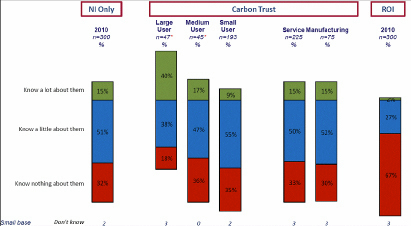
Table1 - Source: IBEC-CBI Joint Business Council, "All-Island Sustainable Survey 2010"
Table 2 indicates how respondents would rate the performance of each of the following mediums in promoting renewable energy/energy efficiency. Clearly traditional media performs well amongst business respondents regarding the promotion of renewable energy and energy efficiency. However, 12% of respondents believe that government departments are very poor at promoting renewable energy/energy efficiency along with local authorities at 13%.
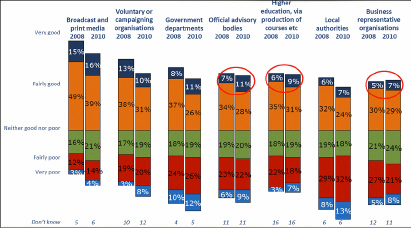
Table 2-Source: IBEC-CBI Joint Business Council, "All-Island Sustainable Survey 2010"
Section 5 Additional Information
The IBEC-CBI Joint Business Council Sustainable Energy Survey highlights some interesting findings regarding the primary motivator for business investing in renewable energy or energy efficiency. The top three motivators are cost savings, grants or financial assistance and added value to the business.
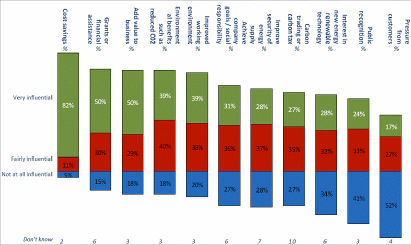
Table 3-Source: IBEC-CBI Joint Business Council, "All-Island Sustainable Survey 2010"
This table clearly illustrates the main motivating factor to investing in renewable energy and energy efficiency with cost savings being the single key influencer at 66%.
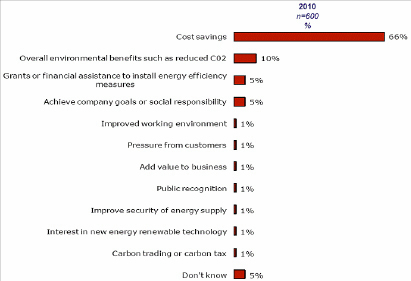
Table 4 - Source: IBEC-CBI Joint Business Council, "All-Island Sustainable Survey 2010"
Table 5 confirms the barriers that would prevent businesses from considering generating their own energy on-site due to initial setup, payback period and lack of financial incentives.
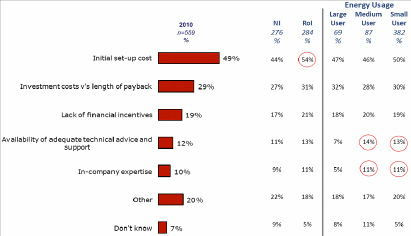
Table 5-Source: IBEC-CBI Joint Business Council, "All-Island Sustainable Survey 2010"
A copy of the full survey results are available at www.jointbusinesscouncil.com
[1]http://climatechange.cbi.org.uk/reports/00283/ page 27
[2] Rourke FO, et al. Renewable Energy resources and technologies applicable to Ireland, Renewable, Sustainable Energy Review (2009) doi;10.1016/j.ser.200901.014 p8)
[3] (EirGrid Grid 25 http;//www.eirgrid.com/EirgridPortal/uploads/Announcement/EirGrid_GRID25.pdf
[4] Helm, D, Wardlaw, J & Caldecott, B, 2009, Delivering a 21st Century Infrastructure for Britain, Policy Exchange; Holmes, I & Mabey, N 2010 Accelerating the Transition to a Low Carbon Economy; The case for a Green Infrastructure Bank, E3G.
[5] Commodities No, 23rd June 2009 "Valley of death for low carbon technologies is widening, http;//www.commodities-now.com/news/environmental-markets/190-valley-of-death-for-low-carbon-technologies-is-widening.html.
[6] http://www.eib.org/about/press/2009/2009-255-european-commission-and-european-investment-bank-launch-european-local-energy-assistance-elena-facility.htm
[7] http://www.eib.org/about/press/2009/2009-255-european-commission-and-european-investment-bank-launch-european-local-energy-assistance-elena-facility.htm
[8] CBI Siemens report, 2009
Response from Invest NI No.1
Committee for Enterprise, Trade & Investment
Inquiry into Barriers to the Development of Renewable Energy Production and its Associated Contribution to the Northern Ireland Economy
Invest NI Response
A. Introduction
1. Invest NI is part of the Department of Enterprise Trade and Investment (DETI) and is the body tasked with providing the effective and efficient delivery of Government's economic development strategies. Invest NI 's role is to grow the economy by helping new and existing businesses to compete internationally, and by attracting new investment to Northern Ireland. Invest NI's overarching aim is to increase business productivity, prioritising support to increase wealth and quality of employment.
2. In line with the Programme for Government (PfG), the Invest NI Corporate Plan (2008-11) aims to improve manufacturing and private services productivity and boost NI's gross value added (GVA) per employee.
Growth in sustainable development sectors such as clean technologies and renewable energy as well as reducing the inefficient use of resources, boosting business competitiveness and breaking the link between economic growth and resource consumption are Key Priorities for Invest NI.
Invest NI is, therefore, committed to providing support that encourages and incentivises the business case for resource efficiency to improve productivity and the development of renewable energy technology markets to increase exports
3. Invest NI is actively engaged in the development of a renewables sector and has designed a strategic framework and action plan to maximise the economic opportunities for Northern Ireland. In Jan 2009 as a result of a detailed scoping exercise and business consultation Invest NI published a report "Sustainable Energy – Maximising Business Opportunities". This report recommended that efforts to develop a renewables sector for Northern Ireland build on existing capabilities in business and academia covering the four areas of Bioenergy, Offshore Energy, Integrated Building Technologies and the emerging technologies associated with Energy Storage.
4. Invest NI activity in the renewables sector includes
- Providing support and assistance to companies to deliver resource efficiency savings
- Developing market opportunities emerging from the renewable sector
- Raising awareness of the benefits and opportunities of applying and developing renewable activities
- Positioning Northern Ireland as a key player in the renewable sector to attract relevant foreign direct investment
- Providing support and assistance to companies developing new products/services in the renewables sector.
5. In addition to direct support for business Invest NI also contributes to the development of the strategic and policy framework developed by DETI to support Renewable Energy and in particular the associated economic opportunities that will result. Invest NI has provided input to the development of the draft Strategic Energy Framework (SEF) and a number of DETI led actions plans and studies including: Renewable Heat Study; Bioenergy Action Plan; and Offshore Renewables Strategic Environmental Assessment.
B. Support to Develop Renewable Energy Technologies
1. The Invest NI Grant for R&D Programme provides assistance to SMEs in the renewable energy sector to develop innovative new products and processes. The support to businesses is in the form of revenue grants, to develop new innovative technology which will improve company competitiveness and benefit the NI economy. Invest NI has had widespread engagement with Northern Ireland companies operating within the renewables sector, and has supported a range of projects across technologies including wind energy, solar thermal, biomass, biogas and energy efficient processes. Since January 2009 23 offers have been made to companies in the renewables sector with grant awarded totalling approximately £1million and total projects costs of £2.95million. A further 6 projects from the renewables sector are currently being considered for grant of up to £850k and total project costs of £2.5 million. This support has primarily focused on developing renewable energy products to the point of commercialisation where the associated technology is already fairly well advanced.
2. The development of some of the more novel and emerging renewable technologies, such as marine energy devices, can be challenging for Invest NI to support under the Grant for R&D programme. The product development process for renewable technologies is generally long and complex, normally involving six or seven different stages of development, ranging from proof of concept thorough to full scale prototype deployment for demonstration. The development timescale for these technologies can often span five to ten years plus, and projects are often associated with a high level of technical and commercial risk and involve a significant level of funding.
3. The costs associated with early stage development, such as proof of concept, can be quite modest in scale (£50-200k). However as the project develops the costs associated with later stages of development, where prototypes and deployment are required, can escalate dramatically and often require multi million pound investments.
4. Projects of this nature create challenges for all economic development agencies including Invest NI when it comes to justifying funding. Emerging technologies require substantial funding and typically have long time lines before commercialisation is reached and therefore it is difficult for Invest NI to demonstrate positive value for money on the investment within an acceptable period of time. Invest NI's role as a regional economic development agency is to support projects that maximise economic benefits to the Northern Ireland economy. Operating with a limited R&D budget, Invest NI is therefore required to prioritise its support towards those projects that can demonstrate strong economic benefits, within an acceptable level of risk and timescale.
5. However support for emerging technologies can still be provided. The Carbon Trust, which is funded in NI by Invest NI, provides significant financial support to accelerate the development of successful new low carbon technologies and further details are provided below.
The Carbon Trust
3. Invest NI funds a number of programmes in Northern Ireland which support the identification and deployment of resource efficient measures in industry. These include the Carbon Trust which amongst other activities helps businesses to reduce energy consumption through the provision of advice, information, training and an interest free loan to install energy efficient processes and equipment.
4. Funding for activities in Northern Ireland is provided from the Invest NI baseline - some £13.4 million of support has been committed to fund a business plan over the period 2008/09 to 2010/11. Since its establishment in Northern Ireland in 2002 the Carbon Trust has identified potential energy savings of £188.3 million of which £67.6 million have been implemented.
5. Carbon Trust activities also accelerate the deployment of energy efficient and/or renewable energy technologies in industry through its provision of financial support and of the £13.4 million of funding from Invest NI £3.5 million has been committed to funding research and development activity. Some examples are summarised below:
Applied Research
6. In 08/09 Carbon Trust provided £0.1million in Applied Research grants to Northern Ireland companies seeking a clear route to market for their low carbon technologies. These companies subsequently secured over £0.8million in direct third party private sector investment thereby increasing jobs and helping Northern Ireland to stimulate private sector investment in the low carbon economy. 3 new applied research projects have just been approved for funding which will total over £1.1million in the next 3 years.
7. Carbon Trust Accelerator funding helps to bring new technologies to market more quickly. Through the interaction, participation and the provision of direct funding to Northern Ireland organisations, the Carbon Trust has delivered£700k worth of direct and quantifiable benefits to Northern Ireland in 2008/09. In terms of marine renewables, the Carbon Trust awarded over £480k to Northern Ireland companies in 2008/09 which represented nearly 50% of the total project spend in that year. Accelerators for Biomass Heat and Offshore Wind technologies are also available to local businesses.
Knowledge Transfer Partnerships
8. Knowledge Transfer Partnerships (KTP) is Europe's leading graduate placement programme, which aims to help businesses to improve their competitiveness and productivity through the better use of knowledge, technology and skills that reside within the UK Knowledge Base (KB), i.e. University or College. Invest NI contributes up to £1 million per annum to support project management and management delivery charges in relation to the KTP projects.
9. KTP enables new capability to be embedded into the business and has benefitted and continues to benefit a wider range of businesses across many sectors, including micro sized, small and large businesses, third sector organisations or public.
10. 7 of the 38 KTP projects approved in Northern Ireland since April 2009, have been in the development of renewable technologies with a further 3 currently under appraisal.
C. Growing the Renewable Energy Sector
1. Market Awareness
Invest NI has designated specific resources to identify opportunities in the renewable energy sector and to build awareness of these within local industry. In support of this work a range of initiatives have been undertaken that serve to reinforce the significant economic opportunity open to local companies that have the desire and hunger to grow their businesses in external markets. Through its mainstream support such as that described in earlier paragraphs Invest NI will continue to assist such companies to explore and take up appropriate development opportunities. The activities in which Invest NI is engaged include:
- Support for the Energy Research Forum established by Invest NI. Membership currently stands at 356, representing companies that have a range of capabilities to feed into the sustainable energy sector. On average the group meets six times per year to look at new business development, best practice, networking and promotion of Invest NI's client support programmes.
- Development of a database of current capability of Northern Ireland companies with membership of the Energy Research Forum (covering Wind & Marine, Bioenergy and Integrated Buildings and Energy Storage) and development of capability profiles for some of the companies listed on the database.
- Support for companies to attend and exhibit at a number of key events including the European Wind Energy Association conference and exhibition held in Stockholm in September 2009 to gain knowledge of the expanding market and access the main suppliers and developers; Energiesparmess Exhibition, Wels, Austria in March 2010; "All Energy" event, Aberdeen, May 2010; Wind Power Exhibition, Dallas, May 2010; the forthcoming Husum Wind Show, Husum, Germany September 2010 and Renewable UK, Glasgow, November 2010.
- Facilitation of the formation of a number of industry led groups including a Marine Energy Group with 25 member companies and 2 Biomass Groups with 10 member companies to help stimulate interest and investment in these sub-sectors.
- The production of a series of DVDs in 2009 to demonstrate local capability in the renewables sector and promote inward investment associated with wind energy technologies and supply chains.
- Hosting of the Northern Ireland Energy & Environment Conference in the Waterfront Hall on the 14th October 2009. This event was attended by around 650 local businesses. An Innovation Masterclass in the morning was followed by expert-led workshops examining specific aspects of renewable and environmental technologies. Approximately 175 meetings took place between businesses and Invest NI Business Advisors and a further 80 meetings to explore international supply chains were also organised between conference speakers, international businesses and local businesses that attended.
- Commissioning and publication of studies into supply chain opportunities – for example Invest NI launched a series of valuable reports ("Economic Study for Ocean Energy Development in Ireland", "Northern Ireland Renewable Energy Ports Prospectus" and "Wind Energy Supply Chain Opportunities" at an event on the 25 June 2010 having previously published "Sustainable Energy – Maximising Business Opportunities" in January 2009;
- Collaboration with the Crown Estate to ensure that local companies are aware of, and can take advantage of, the supply chain opportunities around UK waters that lie ahead – for example a major event, co-hosted by Invest NI and Crown Estate, was held in Belfast on 16 March 2010, at which more than 200 Northern Ireland companies heard directly from a wind farm developer and the Crown Estate about what goods and services will be required over the coming years.
- Membership of the UK Forum for Environmental Industries which includes the Renewable Sector within its remit. This Forum includes representation from all Regional Development Agencies within the UK and provides opportunities to share best practice and keep updated on developments within the sector.
- Representation (since February 2008) on the Department of Energy and Climate Change's (DECC's - previously BERR's) Renewable Energy Forum which comprises representatives from the UK's RDAs along with UK Trade and Industry and DECC. The purpose of this forum is to exchange views and devise strategies to maximise the UK's business opportunities in renewables – it has decided that the deployment of Wind and Heat offer the greatest opportunities for the UK and it will concentrate its efforts on these.
- Since April 2009, Invest NI clients within the renewables sector have received financial assistance amounting to £5.2 million against total investment costs of £25.6 million for a range of activities, including research and development, training, job creation and the development of Collaborative Networks.
2. Foreign Direct investment
- Analysis from independent sources such as FDI Market and Datamonitor suggests that the immediate opportunities for Foreign Direct Investment (FDI) in Renewables are in offshore wind, marine energy sectors and Smartgrid. The implementation of the strategy for FDI in Renewable Energy Technologies in Invest NI is relatively new and the bulk of FDI activities is in these areas.
- In 2009-2010, there were 43 interactions with 35 different companies and potential investors directly and indirectly through Invest NI's sales teams, UK Trade and Investment and DETI. Most enquiries were from small companies with an R&D focus and companies undertaking preliminary research into potential UK-based locations.
- Northern Ireland has a strong proposition in Renewables - as do other regions in the UK and Europe - so the challenge for Invest NI is how Northern Ireland can differentiate itself. Invest NI's FDI strategy highlights specific attributes including local port facilities, the engineering heritage, a highly skilled and qualified population and relatively low operating costs.
3. Collaboration and Clustering
In 2008 Invest NI commissioned and published a report, examining the establishment of energy technology & service sector business-led collaborative networks, entitled "Maximising Business Opportunities from Sustainable Energy".
The report identified four key areas of development opportunity:
- Off-shore Energy
- Bioenergy
- Integrated Building Energy
- Energy Storage
As a result of this and the subsequent industry engagement through a series of workshops, niche market sub-sectors were identified as:
- On-shore & Off-shore Wind Energy
- Biomass Energy
4. Renewable Energy Related Collaborative Networks
Five collaborative networks of companies (and other stakeholders) have formed to address these market opportunities:
| Collaborative Network | Market Focus | Company/Stakeholders |
| Global Wind Alliance (GWA) | Post warranty support of wind farms, initially on-shore, but longer term off-shore |
|
| Global Maritime Alliance (GMA) | Initially consultancy to the marine energy technology developers (wave & tidal) |
|
| Biomass O&M | Operation & Maintenance of Biomass energy plants in NI & beyond |
|
| Biomass Plant Manufacturing Consortium (BPMC) | Design, build, install & commission biomass energy plants in NI, ROI & UK |
|
| Biotecture Ireland | Identify market opportunities for zero-carbon, self-sustainable, 'total integrated systems' housing |
|
All these networks have received funding to conduct a scoping study, i.e. refine their proposal and ensure that all the necessary capabilities were available to the members. GWA & GMA networks have progressed to fully- fledged collaborative networks with full-time facilitation teams. The GMA has recently been launched as the first Industry-Led Innovation Community under the joint MATRIX/Invest NI banner.
In the first 15 months of trading the GWA companies have had sales of £800k directly attributable to the GWA network.
The Invest NI support offered is as follows:
- GWA: £15k (Scoping Study) & £249k for facilitated network
- GMA: £15k (Scoping Study) & £246k for facilitated network
- BPMC: £15k (Scoping Study)
- Biomass O&M: £15k (Scoping Study)
- Biotecture Ireland: £15k (Scoping Study)
D. Conclusion
In conclusion, Invest NI is undertaking significant activity, not only to provide support for SME's in the renewable energy sector to develop renewable energy technologies, but to provide those companies with a strategic framework of support to develop and grow their business. Moving forward Invest NI has identified four priority areas for development opportunity - Integrated Building Technology, Off-shore Energy, Bioenergy and Energy Storage and much of Invest NI future activity in renewables will be directed towards these priority areas. In addition to the continuation of many existing activities in support of indigenous business, future plans include further development of a NI sales proposition to attract FDI to the sector.
Invest NI recognises that it cannot deliver the full potential for development of the renewables sector on its own and that active participation and contribution from industry, academia and partner organisations is not only desirable but essential. For example, Invest NI has developed and will continue to develop strong partnerships with both Harland & Wolff and Belfast Harbour Commissioners to target and deliver propositions to some significant international players within the renewables sector. Invest NI will also seek to ensure that the opportunities the renewables sector presents for the NI economy are maximised.
Response from Invest NI No.2
Supplementary Questions and Answers
ETI Committee on Renewable Energy
Question1:
Invest NI has a focus to support companies that export. If Invest NI were to support emerging frontier companies in the Renewable Energy Sector, who would produce goods and services for the NI market, that this could potentially bring down the need for a reliance on imports?
Answer:
To become an Invest NI client, a manufacturing business must show a willingness to work with Invest NI and will need to demonstrate that now, or over the next three years, the business will have:
- total sales of over £100,000 per year; and
- sales outside Northern Ireland greater than 25 per cent of turnover, or greater than £250,000 a year.
These criteria do not preclude support being provided by Invest NI to local companies developing or providing goods or services for the Northern Ireland market whether in the renewable energy sector or not.
In fact the local market created by Northern Ireland renewable energy targets is considered by Invest NI to be an ideal opportunity for local technology providers to demonstrate their expertise to potential customers outside Northern Ireland.
Whilst the thrust of Invest NI's work accelerates export-driven growth in the local economy it continues to work with the broader business base – the business base beyond its client bank. Business with a desire to explore development opportunities within the industrial renewable energy technology supply chain have for example, the opportunity to take part in Invest NI's renewable energy technology focused trade missions, have access to technical advice and information as well as to development support through Invest NI's Innovation Voucher Scheme.
Of the 400 companies that have nominated themselves and expressed an interest in joining Invest NI's database of Northern Ireland's renewable energy supply chain capability, approximately one third are not Invest NI clients.
Question 2:
It has been stated that some NI companies are struggling to understand how to get into the renewable energy sector and take advantage of it. What is Invest NI doing to actively engage with SMEs to raise awareness on the sector?
Over a number of years Invest NI has hosted a series of major events to promote and raise awareness of opportunities for local companies to enter renewable energy technology supply chains. Details of these are provided in Invest NI's written evidence to the Committee at Part C "1. Market Awareness".
As a result of these events it has compiled a database of some 400 self-nominated local companies that have or have the prospect of, delivering goods/services into renewable energy supply chains. Invest NI is currently profiling the capability of these companies with a view to promoting them at every available opportunity and is proactively seeking out companies that might have join the database.
Invest NI's Energy & Environment conference in October 2009 attracted more than 650 attendees – and likewise an offshore wind supply chain event co-hosted with The Crown Estate in March 2010 attracted more than 250 attendees. As a result these and other initiatives including for example Invest NI's support of a number of networks of local and international businesses, the capacity and capability of local SMEs has been increased.
Invest NI has also hosted a series of regional events in conjunction with District Councils throughout Northern Ireland during 09/10 and 10/11 to raise awareness of Invest NI's work in resource efficiency and business development in renewable energy. Events have so far been held in the following locations: Craigavon, Londonderry, Enniskillen, Magherafelt, Newtownabbey, Ballymoney, Carrickfergus, Ballymena, Coleraine, Lisburn, Newtownards with further events planned in 2011 for Omagh, Newry and Banbridge.
Invest NI's client facing staff are available on a one to one basis to discuss how companies might enter industrial scale renewable energy supply chains through the supply of goods and services.
Question 3:
It has been suggested that Invest NI's strategy is too broad and international for the renewable energy sector in NI. What is Invest NI doing to help bring opportunities in the renewable energy sector to the local and NI level?
Invest NI's strategy in renewable energy is four fold:
a. To make local companies aware of supply chain opportunities to provide goods and services into the market created by Northern Ireland's Renewable Energy targets as set out in DETI's Strategic Energy Framework. Developing prospects locally will help extend and grow the level of skill, expertise and capability held within Northern Ireland businesses. (Northern Ireland's renewable energy targets are 40% electricity supply/generation and 10% renewable heat supply/generation by 2020)
b. To support companies wishing to deploy energy efficient or renewable energy technologies with a view to increasing business efficiencies and reduce operational costs (through the provision of advice and information and through the Carbon Trust Loan Scheme which is funded by Invest NI)
c. To raise the awareness of local companies with appropriate levels of knowledge and expertise of the opportunities to provide goods and services into the international supply chains for renewable energy technologies
d. To ensure that Northern Ireland is highlighted and considered by international energy utilities and energy developers as the location for mobile FDI projects.
As described in its written evidence and in this supplementary information Invest NI has undertaken and continues to undertake a wide range of awareness raising activities including hosting events, publication of reports and information and production of DVD's. Invest NI has driven up the capability of local business through the provision of financial assistance for, for example, research and development, training and the formation of a series of collaborative networks.
Question 4:
What kind of specialist, technical support is available to SMEs in the renewable energy sector?
Invest NI employs a range of Chartered Engineers and scientists who can provide technical advice and information on Renewable Energy technologies. Invest NI's Sustainable Development team is always happy to discuss particular technical issues relating to industrial scale renewable energy – if it is not able to answer questions directly this will signpost to the most appropriate source of technical support. This team should be the first port of call with for any company interested in the industrial renewable energy sector.
Specialist advice and information on for example, International Standards and Intellectual Property related to renewable energy, can be provided by Invest NI's Technical Advisory Unit and a range of funding mechanisms (Grant for R&D, Innovation Vouchers, Technology Development Incentive for example) are in place for clients or companies wishing to embark on specific projects in which technical issues can be addressed and resolved.
Question 5:
How is Invest NI and working with companies to grow and develop their technologies in order to export?
Part B of Invest NI's written evidence provides information on how Invest NI is working with businesses to grow and develop their technologies – whether for export or not.
In addition to specific development support Invest NI has also undertaken a range of technology transfer and trade visits for the renewable energy sector and has supported the formation of several renewable energy collaborative networks that make formidable offerings in the international marketplace.
Question 6:
What support and assistance is available to SMEs in the RE sector specifically relating to the development of RE technologies?
As mentioned in the answer to a previous question a range of development support is available to clients and the wider business base including for example a Grant for R&D, Innovation Vouchers and Technology Development Incentive.
Question 7:
What other support is available to RE sector businesses in the form of grants, loans, advice, etc?
A full range of financial and capability support for those companies developing, manufacturing or supplying goods and services into renewable energy technology supply chains. Any renewable energy technology company that meets Invest NI's client recruitment criteria (as described in the answer to Question 1.) can potentially access any of Invest NI's mainstream support including for example Selective Financial Assistance and grants towards training and R&D - in the same way as companies in any other sector.
Technical experts within Invest NI can provide advice on industrial scale manufacture or supply of renewable energy technologies to any company in Northern Ireland.
Within specific cost and carbon saving criteria loans of between £3,000 and £100,000 are available to any company in Northern Ireland wishing to increase its efficiency by installing more energy efficient or renewable energy technology, through the Carbon Trust's Energy efficiency Loan Scheme which is funded by Invest NI.
Response from John Simpson - Economist
NIA ETI Com
Northern Ireland Assembly
Committee for Enterprise, Trade and Investment Inquiry on the development of renewable energy
Response from John Simpson
Introduction
May I thank the committee for the opportunity to comment on aspects of the current enquiry into the development of renewable energy in Northern Ireland?
My recent experience in following the evolution of Northern Ireland energy policies has offered an insight into some parts of the topics under consideration.
During my period as a full-time academic and, briefly as a secondee to work in a Government department, my interest in economic development in general and, for a period, the restructuring of the energy sector, gave me some insight into the fluctuating economics of the electricity generation and supply businesses. Over the years, I had the opportunity to contribute to the debate about the building of new generating plant (at Kilroot), about the privatisation of (then) NIES and more recently to assess the influence of the Regulator, the potential of the Single Electricity Market, and the challenges of securing an improved all-island electricity grid.
More recently as a Visiting Professor in the University of Ulster, I have maintained my academic interests. In parallel, there has been the challenge to monitor energy policy developments as part of my contribution to writing for business readers in local publications.
May I, then, comment on some of the topics that form your agenda? My experience does not allow me to comment on all of the agenda topics.
Response
1. Current mechanisms to support and assist renewable energy production
Northern Ireland has significant potential to harness on-shore wind energy. There is also major potential for off-shore wind energy, energy from tidal sources and, to a smaller extent, gain energy from biomass and geothermal sources.
At present, none of these energy sources would be self-financing and attractive as profit making enterprises. A system of premia (Renewable Obligation Certificates) for renewable supplies has been developed and has attracted a range of investment proposals.
A feature of the investments in renewable energy is that, as increments to the supply capacity, they tend to be relatively low capacity units, requiring extensive space and need many connections to the electricity grid. Currently about 7% of local electricity capacity comes from renewables.
The professional assessments are that, subject to the ability either within the grid or from external links, to top up or spill supplies (not yet feasible on a large scale) when wind sources vary Northern Ireland has the potential to meet a large proportion of electricity needs from wind energy. The operational target set by DETI is that by 2020, 40% of electricity should be from renewables.
The operational implications of a 40% target have not been adequately assessed and have not been built into the required decision making.
The key deficiencies seem to be:
- inadequate appreciation of the problems caused by individual providers making incremental approaches to the planning system. The amended PPS18, together with its special addendums, is still criticised by applicants.
- excessive delay in agreeing plans for the strengthening of the electricity grid and further delay in their implementation. NIE have known of the deficiencies for several years and still no development plan has been proposed.
- a lack of an effective joined-up approach to policy making and decision making.
- these criticisms, in no particular order, fall on DETI (energy policy), the Regulator, NIE (t&d), the Planning Service and, less directly, the authorities controlling the Single Electricity Market.
The Committee may wish to consider the economics and technical implications of a large increase in the potential number of micro-generation plants in rural areas. The incentives to increase renewable generation, even in micro units, should be assessed to avoid risks to the stability of supply networks and undue monitoring costs.
The present Planning System prevents a broader appreciation of the need for economies of scale when responding to potential investors. The present grid planning mechanisms do not have adequate incentives to develop grid capacity ahead of demand.
The current mechanisms to support renewable energy production are too cumbersome and are currently frustrating a number of developers.
2 – 6 No direct comment
7. Recommendations for overcoming the barriers to development of renewable energy production
The main recommendation must be that the disparate stakeholders in the development of renewable energy must work in an integrated and effective way. It is not acceptable for different stakeholders each to maintain an independent stance. At its mildest, DETI needs to take a more executive role. A more appealing outcome would be a legal authority to command the job of integrating the elements of the package.
Response from Lisburn City Council
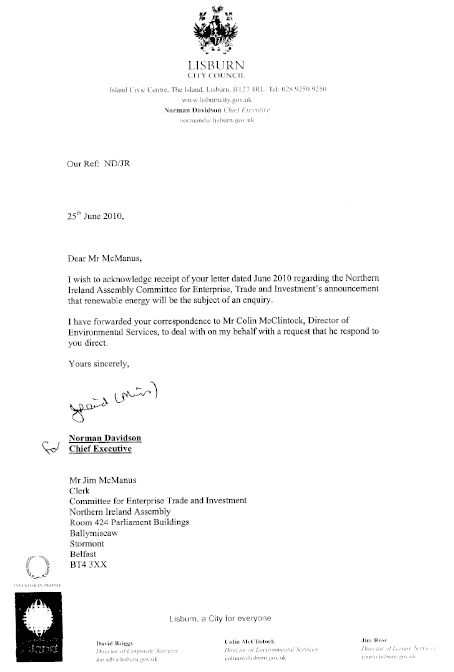
Response from Lisburn City Council
Department of Enterprise, Trade and Investment Inquiry into Renewable Energy
Background
The Northern Ireland Assembly Committee for Enterprise Trade & Investment has announced that renewable energy will be the subject of an inquiry. The Committee will examine the barriers to the development of renewable energy production and its associated contribution to the N. Ireland economy. The main areas for the Inquiry are set out below with associated responses from Lisburn City Council.
Current mechanisms at regional and local level to support and assist renewable energy production
The Council views the production and availability of a cost effective, and secure supply of energy as being central to economic growth. Because the supply of energy has been monopolised by a few key providers, for a long time businesses in N. Ireland have had historically higher energy costs than the rest of the UK which impacts upon their bottom line and ability to be competitive.
With the drain on fossil fuels from such countries as China and India, it is imperative that there is major investment in alternative and cleaner sources of energy, with diversity of supply, combined with security of supply.
Currently renewable energies are governed by DETI's Sustainable Energy Framework which covers geothermal power, biomass, hydroelectric, solar, wind and bioenergy, all well developed and competitive sectors, although there is not widespread usage across N.Ireland. There is also ongoing research into the widespread use of deep geothermal energy resources for N.Ireland, as a low carbon renewable for heat and lighting, with the potential to revolutionise how future generations generate and access energy.
The Northern Ireland Renewables Obligation (NIRO) was introduced on 1 April 2005 (amended in April 2010) as the main support mechanism for encouraging increased generation of electricity from renewable energy sources in Northern Ireland. As a fiscal driver this doubled the amount of electricity supplied to Northern Ireland consumers from renewable sources and had a massive impact upon the energy mix, demonstrating that with intervention the use of renewable energy could be adopted within a short timeframe.
The Council recognises that renewable energy has a massive contribution to make to reducing domestic and commercial energy costs, assisting industrial competitiveness and helping to reduce the high levels of fuel poverty across N. Ireland.
There is already a lot of work which has been done to promote renewable energy such as revising building standards in Northern Ireland, combined with the use of solar, geothermal and wood for energy in efficient modern heating systems. This has been achieved through initiatives such as the use of government grants, however there is a lot more investment required by the various Government departments with responsibility for promoting these technologies for the domestic and business markets.
There is scope for N. Ireland to really benefit from investment in these new energy supplies which will also create new job opportunities particularly in areas such as engineering, agricultural, farm diversification, innovation and technology transfer as well as new skills development.
There is a growing demand for renewable energy technologies across Europe and there is massive opportunities for local businesses to tap into these new growth markets with the proper support and assistance from local Councils and Invest NI to help them to maximise the opportunities. Invest NI is the main support mechanism for creating new jobs, supply chain development, overseas trade and R& D in the area of renewables. Currently Invest NI have in the region of 360 companies on their renewable energy database, employing 7,600 people and generating an annual turnover of £700 million. This is a relatively small number of companies and there is much scope for increasing the numbers of businesses with targeted support and funding from local authorities and agencies such as Invest NI.
N. Ireland's two Universities and other local organisations such as QUESTOR, and the Agri-Food and Biosciences Institute (AFBI) which is based within the Lisburn City Council area, are making massive contributions to progressing research and development in the area of renewable energy, however again more funding should be allocated to grow this important sector locally and to encourage more uptake in the domestic market e.g. solar panels, geothermal etc.
Lisburn City Council funds a local business development programme, Lisburn Innovation Networks, which can assist local businesses to explore the development of new products and services in this sector and to date has assisted a number of such projects. Local provision outside of this is low, and in the current funding climate there is a need to explore opportunities around European Funding sources such as the Sustainable Competitiveness Programme NI 2007-2013 for example could be accessed to progress new business development in this sector.
Examine the support and assistance available to SMEs in the Renewable Energy Sector to develop renewable energy technologies
Examine the support and assistance available to SMEs in the Renewable Energy Sector to grow and develop their businesses
Assess the appropriateness of current mechanism to develop and grow both local renewable energy markets and export markets
Lisburn City Council does not directly provide financial grants to SMEs in the Renewable Energy Sector. However, the Council offers support and assistance to SMEs in the Renewable Energy Sector that wish to develop renewable energy technologies by signposting them to the Council funded Innovation Networks Programme with the University of Ulster or to Invest NI for specialist support and advice.
The Agri-Food and Biosciences Institute (AFBI) is also based within the City undertaking research which underpins the agricultural and food industries so that they can maximise their contribution to the Northern Ireland economy. This research takes account of the needs of the wider community for high quality food, the conservation of the environment and the welfare of animals. Within this framework research programmes address the development of new opportunities for the agri-food industry, including a huge amount of research in the area of renewables including biomass boilers. To this end AFBI has developed a unique facility at their Hillsborough site to study renewable energies, which ultimately would have application to the wider economy and the development of this sector. The availability of funding will be critical in helping to progress this research.
The City of Lisburn is keen to grow the sustainable business sector locally, and given the levels of innovation and R&D which companies demonstrate, and a background of highly skilled engineers, steel fabrication businesses etc this is a sector which a large number of companies could comfortably operate in, or diversify into.
Invest NI is the main support mechanism for creating new jobs, supply chain development, overseas trade and R& D in the area of renewables, and are currently working hard to raise awareness amongst local businesses of opportunities in these sectors by hosting workshops and information seminars, linking businesses into renewable supply chains, and working with firms to diverse skills, products and services into renewables. There are also some local Council's who fund local initiatives designed to promote this sector, however there is a need for much more development, with the scope to utilise European Funding sources and best practice to develop new business opportunities in this sector. Local authorities could have a key role to play here in terms of setting standards and best practice in renewable energies locally, as well as helping to grow new businesses in this sector through economic development activities, and helping to develop networks and raise awareness.
Compare the mechanisms for support and assistance within NI with those in other EU member states
Assess which EU member states are considered to be in the forefront of renewable energy development both overall and for each type of renewable energy:
It is widely known that the EU is already a leading developer of technologies in efficient heating and cooling, combined heat and power and industrial processes, as well as in renewable energy fields, such as wind and
photovoltaic energy. In addition, solar thermal technologies, biofuels, energy efficient building applications and renewable powered or high-efficiency district heating applications are all gaining new markets. The EU, national governments and individual regions and cities across Europe are all focusing upon solutions which will generate and consume energy from cleaner, more sustainable sources, with renewables at the heart this activity.
There is a need to not only encourage the wider uptake of renewable energy systems in N. Ireland, but also to raise awareness locally of successful EU schemes which could be implemented in N.Ireland. Both businesses and consumers need to clearly see the benefits of investing in sustainable energy production and use.
In recent years there have been a raft of substantial EU initiatives designed to support the development of the main sustainable energy actors, both in the field of renewable energy sources and energy efficiency. There is much scope to develop new projects, implement best practice from the EU in N.Ireland, and to co operate with our EU counter parts in the dissemination of the results of cutting edge renewable projects and the transfer of knowledge.
There is a need for N.Ireland to engage and be represented effectively to leading EU bodies operating in these sectors such as the European Renewable Energy Council (EREC) which is the umbrella organisation for the European renewable energy industry, trade and research associations active in the sectors of photovoltaics, small hydropower, solar thermal, bioenergy, geothermal, ocean, concentrated solar power and wind energy. EREC represents an industry with an annual turnover of EUR 70 billion and providing over 550.000 jobs. The EU also has ongoing projects such as the Sustainable Energy Partners aimed at encouraging member states to sign up to a commitment to the development and use of renewable energy.
One good example of EU best practice is The Renewable Energy World Europe Conference & Exhibition, 'an event that brings the incredibly diverse and vibrant European renewables sector together under one roof to hear about the latest technology and policy developments. This event has quickly established itself as Europe's leading event covering the entire range of renewables technologies. This year the event took place from 8–10 June in Amsterdam, the Netherlands, a country which has been as the forefront of developing renewables capacity and a with a Capital city which had ambitions to become one of the world's pioneering 'Smart Cities'. It goes without saying that the interests of N. Ireland should be represented on such a European platform.
When figures are compared for the use of renewables across the EU, countries such as Iceland, Norway, Austria, Switzerland, Finland, and Sweden are leading the way in the use of hydropower and biomass in terms of contribution to primary energy consumption and electricity generation.
For example Denmark leads the way in the use of wind power currently with parts of the country obtaining 100% of its electricity from wind power, and up to 75% of heat from biomas and solar power.
The UK on the other hand (which would include N. Ireland) is one of the lowest users of this valuable (and readily available) source of renewable energy, so there is much scope to improve on this in order to reduce dependency upon fossil fuels, and ultimately reduce overall energy costs.
An excellent example of a city region which is now entirely a Self-sufficient Energy City, is the European Centre for Renewable Energy of Güssing - in Vienna. The City council have been able to not only become entirely self sufficient in terms of their city energy supply but also have helped develop a whole new local economy with new business development and new job creation in a region which was previously in decline.
As part of a trade development programme to Central & Eastern Europe, Lisburn Council was able to visit AquaCity in Slovakia. Aqua City is water park and spa that is virtually self-powered by the solar energy and geothermal energy from vast underground lakes beneath the plains of northern Slovakia. It has already been the first winner of World's Leading Green Resort in 2007 and won the award again in 2008, in the World Travel Awards, voted for by international travel agents. With minumum energiry costs despite the extensive number of pools and spas, Acqa City is now a globally recognised example of how to create sustainable tourism, one of the most pressing issues the travel industry faces today. Projects like this offer great ideas and great potential for N.Ireland, particularily in the tourism sector which is an important local growth sector.
It should also be mentioned that the City of Lisburn is home to an excellent example of EU best practice in renewable energies. The award winning Brokerstown Village is a new village, in excess of 2000 homes, which has been designed and built with the concept of sustainable communities. The development includes a £2million biomass district heating system fuelled by a carbon neutral energy source, and promotes the concept of green spaces, where the car is not the predominant form of transport. There was a commitment by the developers to delivering on sustainable communities and the nature of the project has enhanced the marketability of the development due to the non-dependence on oil or gas. The development also has had a key impact on the local economy as it has encouraged local farmers to diversify into the production of willow to power the boilers.
Report conclusions, and recommendations for overcoming the barriers to the development of renewable energy production and its associated contribution to both the energy mix and the N. Ireland economy
Lisburn City Council would make the following recommendations with regard to overcoming the barriers to the development of renewable energy production:
1. With the drain on fossil fuels from such countries as China and India, it is imperative that there is major investment in alternative and cleaner sources of energy, with diversity of supply, combined with security of supply.
2. Locally there are number of government bodies and agencies involved in the field of renewable energy production, however this can cause delays in obtaining the relevant permissions, and funding which may act as a barrier to new projects and investment coming through the private sector. One solution would be to task one body with responsibility for the co ordination and delivery of renewable energy projects in N. Ireland, and to simplify the administrative processes involved so that there was standardised administrative procedures.
3. The efficient use of renewable energy should be further promoted on an ongoing basis through government agencies to increase the uptake and usage throughout N. Ireland. This could be achieved through initiatives such as the introduction of new building standards, grant assistance, awareness campaigns to both local businesses and the general public etc.
4. The growth of the renewable sector should be taken into account and considered during the development of any new town, city or regional plans to ensure that these developments (e.g. renewable energy power plant) are integrated into all future planning.
5. There exists a general lack of knowledge surrounding the benefits of renewable energies, with many bodies, government departments and the general public for example focusing upon the negative impacts of such projects whilst not being properly informed of the environmental, social and economic benefits that such projects can realise.
6. Public opinion can also greatly influence decisions on whether these projects can take place, with wind turbines being a good example where everyone can acknowledge the benefits, however there is a lot of opinion upon where these should be located. The scale of public opinion is likely to vary depending upon the size of the project and where it will be located, so it is highly likely that a large scale power plant would receive opposition from both local authorities and the public. There is a need for a concerted focus on raising awareness and understanding of renewable energy projects and the long term benefits which can be realised for the local economy, and for consumers.
7. There should also be sufficient capacity in the local grid network, particularly for large scale renewable energy projects, with the costs of accessing and generating additional supply attractive to the private sector to invest in such projects.
8. The necessary finances need to be made available to fund new renewable energy projects, and the banking sector needs to be brought on board in order to help minimise the risk of financing such initiatives and to reduce the cost of borrowing against what is currently considered high risk projects.
9. Demand for renewable energies is increasing throughout the world and its imperative that N. Ireland businesses are in a position to maximise the opportunities which this presents. Clear economic objectives should be set which aim to:
- Ensure N. Ireland can compete effectively with other UK and EU regions in terms of renewable energy production and cost
- Overall reduce energy costs for both business and domestic markets using renewable energy
- Further develop the renewable energy sector in N.Ireland and exploit the many opportunities which exist for new business and job creation
- Ensure a clean and secure renewable energy supply, and mix.
In concluding it is clear to see that Europe is leading the way in the use of renewable energies and reaping the benefits that come with this. It is imperative that N. Ireland embraces renewable energies as a key part of all future economic strategies to ensure successful future economic growth.
With a reduction in public funding and cut backs pending across all government departments, there is an imperative that this sector is developed as quickly as possible locally to ensure local businesses can remain competitive, and that businesses and consumers do not continue to be at the mercy of high energy costs. This will take time, financial support and commitment and vision at all levels of Government, but if similar sized regions across the EU can be entirely self sufficient in terms of energy production, it is time for those with responsibility for our economy in N. Ireland to take up the gauntlet for the renewable energy sector and lead the way in the production of cost effective and reliable energy sources for local use.
Ultimately it is the Government's responsibility to provide leadership in the field of renewable energy, and with the correct vision, and people in place there is no reason why N. Ireland couldn't become a leader in the UK and Europe in the development, and use of renewable projects which are deemed as models of excellence.
Hazel King
Economic Development Manager
13th August 2010
Response from Michael Coyle
Response to public consultation
Barriers to the Development of Renewable Energy Production and its associated contribution to the Northern Ireland Economy.
This is a personal input from michael coyle, 122 Westland rd Sth, Cookstown. It is presented as an overview highlighting issues rather than a detailed technical submission.
michael coyle, cookstown,( michael.coyle5@btinternet.com) July 2010
1.0 Introduction.
It is not so long ago since economists used the annual growth in energy use as a measure of the industrial progress of the society.
Energy has now become a major target in a newly defined model of progress.
We must address our role locally as low intensity clean energy users and position ourselves in the global economy for energy related goods and services whether as a result of addressing CO2 emissions in the context of global warming or to improve energy security.
The commitment of the UK Government to an 80% reduction in carbon output by 2050 is challenging for all parties involved in its achievement.
The International Energy Agency (IEA) emphasises that nothing less than an energy technology revolution is required if we are to achieve the 50% reduction of global CO2 emissions by 2050 as set by the G8 group.
The IEA also considers that a smooth transition to the mass market integration of renewables requires that renewable energy policy design should reflect a set of fundamental principles in an integrated approach.
Energy has been a driving force in European cooperation since the foundation of the European Union in the 1950s. The first agreements between the original six member states, the Treaty on Coal and Steel and the Euratom Treaty on nuclear energy, had a clear energy emphasis.
Agreed common European policies in energy and environment continue to enable the energy market, to prioritise investments in the transnational electricity and gas grids and set requirements for reduction of CO2 emissions and the minimum uptake of renewables.
For the purposes of this document sources of renewable energy are considered to include energy derived from wind, solar, biomass, hydro and wave and tidal.
The use of energy is partitioned into heating, transport, and electricity for domestic and industrial usage.
2.0 The Context - our current Energy supplies
At present, in Northern Ireland, as elsewhere, most of our energy comes from conventional sources and is delivered through the electricity network, the gas pipeline network or directly as oil, coal or bottled gas.
As a result of the economic downturn and Government supported efforts to reduce energy intensity, it is suggested that the overall local demand for energy will not increase in the short term. This implies that any further uptake of renewables must displace existing sources of supply in the overall energy mix of the region.
The total share of UK energy sourced from renewables in 2005 was 1.5%, one of the lowest in EU. The UK Government is committed to a 15% renewable content by 2020, but the Governments further commitment to 80% reduction in carbon output by 2050 which, even including the deployment of nuclear capacity, is indeed challenging.
Across the EU heating alone is responsible for almost half of the overall energy consumption, transport almost a third and the remaining fifth is delivered as electricity.
(48% heating, 32% transport, 20% electricity)
Statistics from UK Central Government report that Northern Ireland used 1,369 thousand tonnes (translates to 17,500GWh under assumptions about the fuel) of road transport fuel in 2008 and the consumption of electricity was 8,063GWh in 2006.
Identifying a credible figure for heating proved more difficult but the available information supports the proposition that, in line with EU figures above, close to half of the total energy used here is producing industrial, office or domestic heat.
Our heating needs are supplied by imported piped gas, by oil (kerosene) or bottled gas (propane or butane) with some coal and a limited use of renewables including off grid wind, biomass, solar panels and heat pumps.
Phoenix has a monopoly on the supply of piped natural gas for home heating in Greater Belfast and Larne. Firmus have an exclusive licence for the supply in Derry, Antrim, Armagh, Banbridge, Craigavon, Newry, Ballymena, Ballymoney, Coleraine and Limavady.
However, oil heating remains the choice of home heating system for many consumers across the province.
The overall transport consumption includes aeroplanes, tractors and ships as well as the figure reported above for road consumption by cars and lorries.
The total amount of petroleum product imported to Northern Ireland was 2,037,149 tonnes in 2009. This figure includes the kerosene used as oil heating fuel.
The peak demand for grid supplied electricity in Northern Ireland is currently 1,626Mwatts. In 2006 the consumption of electricity in Northern Ireland was 8,063GWh against a total UK consumption of 328,299GWh.
Imported gas is now the major fuel powering local electricity generating capacity at Ballylumfords three plants delivering up to 1316MWatts and at Coolkeragh with a capacity of 400Mwatts. There were 483MWatts of locally sourced wind connected to the electricity network in 2008. (IWEA 2008)
However, identifying the local generating capacity is misleading. The interconnection of our electricity network across the border and with Scotland and Wales physically, and organisationally in the context of the single European energy market, enables electricity to be sourced from across the UK and Ireland and even from suppliers in mainland Europe.
It should be noted that the model would also allow our local suppliers to deliver electricity into the single market subject to constraints imposed by the capacity of the network.
A single electricity market on the island of Ireland, conforming with the rules agreed in the European Electricity Directive and regulated jointly between the UK and the Irish Government is now in operation.
The model of competition embedded in the Electricity Directive enables suppliers of electricity to compete to deliver their supply onto the grid and enables distributers to access their chosen source of supply from the grid and to compete for customers.
The operation of the grid itself remains a managed monopoly under the Grid Operator supervised by the Northern Ireland Authority for Utility Regulation. The grid is itself a highway for the mass transportation of electrical energy.
Parallel arrangements are in negotiation for gas under the European Gas Directive.
2.0 Drivers
Conformance with UK policy and its implementing legislation to reduce carbon output is considered to be the key driver for renewable energy supply. This legislation takes into consideration agreements made in the European Community, in G8 and at United Nations.
The UK has committed to its international partners that it will make an 80% reduction in its carbon output by 2050 and is currently debating with France and Germany raising its commitment of 20% by 2020 to 30%. It should be noted that the reduction in carbon output also includes energy from nuclear as well as from renewable sources.
Security of energy supply is a key consideration and a driver, particularly as supplies from North Sea resources dwindle.
The cost of the energy supplied remains a driving force where an open competitive marketplace for energy supply is the agreed means for its achievement. When grant aid and feed in tariffs are applied to encourage the integration of new renewable energy sources in the local energy mix, consideration needs to be given to the period of their application and to their overall impact on the wider energy market.
The objective of deriving locally created wealth and employment through the development of products and services in the renewable energy sector is an important goal which needs to be enabled through research, training, business development and investment.
Mechanisms for allocating and for trading units of carbon credit as a currency
to drive the green economy have been set up by Government in UK. The scheme is compatible with the European Emissions Trading Scheme (ETS) and with the global green economy conceived under the UN Kyoto protocol.
However, the renewable obligation credit units(ROCs) introduced under UK renewable obligation legislation do not fit into the wider schema and are only tradable in UK.
The carbon credit mechanism requires consistant application of clear rules in a predictable trading environment to be effective.
The Renewables Obligation in Northern Ireland is strongly focussed on generating electricity from renewable energy sources.
It is suggested, taking in account that approaching half our energy supply is used to make heat, perhaps more attention to the delivery of heat from renewable sources could have a significant impact on external fuel dependency. Of course such measure must take in account the priority to reduce overall energy intensity in buildings and in industrial processes. (note: DECC launched a consultation on renewable heat incentive early 2010)
At the local level policymakers need to develop and communicate a clear and focussed view setting out the local objectives for the energy sector. The framework of existing national and international commitments and legislation is so broad ranging and complex that it is too easy to end up just translating external policy bitpiece into this governance domain, rather than identifying realistic and opportune local policy that fits within the overall framework.
3.0 Opportunity
Since, at present, all our local energy needs for heating, transport and electricity are satisfied it is clear that any uptake of renewables must displace some existing source of supply.
The energy mix may change in response to new loads or as a result of Government intervention. For example, the introduction of electric cars would increase the demand for electricity and reduce petroleum imports but may require reinforcement of the electrical network.
Sources of electricity supply may also change as a result of improved interconnection and implementation of the single electricity market. It might be anticipated that the choice of electricity supply will be driven by cost, the competition being across Europe and between conventional fuel, nuclear or renewable powered electricity generation, when the network capacity permits.
The opportunity to adapt our approach to institutional and domestic heating and to satisfy many heating needs from locally sourced fuels such as woodchip or wood pellet is of continued interest.
As heating represents an important portion, perhaps half, of our overall energy consumption, progress in this sector could have an important impact on the overall use of energy from renewables.
However, renewable energy obligations imposed by Government and administered and resourced by the Electricity sector are unlikely to have the desired effect.
The interesting start made some time ago using locally sourced woodchip and pellets from forestry and willow as heating fuels appears to have stalled. One explanation might be that, as most of the user installations were institutionally supported, the user base was limited and volumes did not reach the critical mass for the fuel to gain commodity status.
It is suggested that the fuels lend themselves better to use in district heating systems taking in account the available boiler technology, the need for large storage capacity for the fuels and the requirement to store energy in a buffer to achieve best efficiency.
Unlike some countries where the technology is successfully deployed we do not have a tradition of using district heating.
Perhaps there is a need for further work to assess how this technology could impact the animation of the rural economy.
We have sufficient land to supply both food and fuel and local policy need not be driven by the food or fuel concerns that are driving discussion in other policy circles.
Our transport network, particularly city transport, offers a real opportunity for early electrification, with the extended possibility of using an electricity supply, either from the grid or as an off grid application from combined heat and energy plant, perhaps using woodchip or even wind turbines around Belfast Lough or Lough Foyle or Lough Erne!
The simple rubber wheeled tram of an earlier age supplied by an overhead rail can still be found, repainted, in some European cities and we also have an important local manufacturer of electric busses.
The electric car has now made its first appearance in some neighbouring cities with a start being made to build the charging infrastructure to enable its use.
Energy carried by hydrogen and delivering electricity from fuel cells in transport applications might appear to be a small further step along this route but some aspects of the technology, in particular, hydrogen storage, remain an obstacle, still in the research phase although there are pockets of hydrogen powered vehicles and filling systems across the globe. Advances in the capacity to store and transport energy, whether as hydrogen, or through another technology would have big impacts on all aspects of energy use.
The EU generously supports a research consortium, which includes major motor manufacturers, in an effort to get momentum in the hydrogen powered transport system.
Some rapeseed is being grown locally to supply transport fuel with a limited supply of biodiesel from this and from other sources like cooking oil. The local opportunity for ethanol, biodiesel and biogas as transport fuels seem to be underdeveloped.
However, perhaps the biggest opportunity of all is the export potential of renewable energy as electricity, taking in account the availability of wind, wave and tidal resources. This author considers that it is a question of whether we will, in the coming period, import nuclear produced electricity or export electricity from renewable sources.
The outcome will ultimately depend on the cost of the delivered energy but if we do not have the capacity to get the appropriate renewable infrastructure in place, the result is already clear. Now is the time to take on board this potential opportunity and make it work to our advantage.
Barriers to the effective exploitation of renewables
The UK has a clear policy commitment supported with national legislation to address Climate Change and to meet agreed EU targets for renewable energy.
The decision to invest in new nuclear capacity will reduce the level of carbon emissions but may also set the cost of energy as determined by the price of nuclear generated electricity. The new nuclear capacity is not expected to come on line for some years but it is suggested that it may already be constraining investment in renewables.
It is not clear that the local institutional framework is fully effective in creating the conditions for the exploitation of the potential for renewable energy and its associated products and services. There is a greater need for champions among local policymakers and for targeted cross Departmental cooperation including cooperation with local councils.
This writer has not seen any evaluation of the programme valued at £70m put in place by Mr Hain when he was Secretary of State for Northern Ireland but is concerned that there was an underexploitation of what was forward looking and well focussed opportunity.
The essential engagement of policymakers with academic, commercial and consumer representatives in a well informed debate seems sometimes to be replaced by institutional scrambling.
There is a long history of locally conceived energy technology ideas including wave energy systems like the Psalter duck and the Wells turbine.
In some cases useful demonstrators have been completed like the 500KW Limpet wave energy system desighed at QUB and currently operating on Islay. However the history of moving such systems on to a broader commercial exploitation has been less encouraging.
There are exceptions and, although the author is not clear about the business success of the Portadown Kingspan solar water heating business, it is certainly interesting to see how this example of locally developed technology is being handled in a professional marketing environment.
In the present economic circumstances finding finance for new projects is difficult. Additional professional financial expertise and more market expertise is needed in the renewable energy business. Proactive local councils have taken some of the renewable heating systems forward and partnerships involving public authorities appear to be favoured by some of the institutional lending organisations.
The anticipated move towards electric cars will, in the short term, create an increased demand on the electricity network whether the electricity is supplied from nuclear or from renewable sources. Such increased demand will require investment in reinforcing the electrical network.
In the longer term hydrogen powered fuel cells may power the transport system but even if the fuel cells are now commercially available further technology developments for storing and moving hydrogen are still at the research stages and the hydrogen economy remains some way in the future. There are instances of existing forecourt hydrogen facilities around the world but in most cases they derive the hydrogen from reforming natural gas or some other fuel.
4.0 Comparison with other EU member states
Between 2000-2005 Germany Sweden, Denmark and Portugal were the most effective in deploying new wind capacity to generate electricity supplied to the grid. This was achieved through the mechanism of high feed in tariffs.
Denmark have become leaders in wind technology and their large base of district heating systems gives them a strong position for developing and deploying renewable technology.
Netherlands, Sweden, Belgium and Denmark had most success in deploying solid biomass to produce electricity in 2000-2005 period.
A feed in tariff (FIT) of at least 8US cents/KWh was considered necessary to initiate the process. The resulting success is attributed to the availability of cheap, abundant fuel. In Sweden this is mainly wood residues and industrial wood waste, combined with the option of cofiring in existing suitable boilers. (ref: EREC)
As a counter example the Czec Government, which is in the process of tendering for new nuclear capacity with a view to consolidating its energy security, has recently indicated that it will not support more than 13% of renewables in the national energy mix by 2020. The Czec Republic has existing nuclear capacity and envisages the involvement of its its indiginous nuclear supplier, Skoda JS in the new nuclear building programmes.
Germany moved away from nuclear power following the the Chernobyl accident in 1986.
Germanys proximity to Ukraine and the more decentralised decision making in the Lander structure had a role in driving this move to green politics.
The move prompted a big investment in wind power and helped German industry in cooperation with others including Denmark to achieve leadership in a range of renewable technologies. Germany also has a large installed base of solar photovoltaic technology.
Of course this renewable success sits alongside the big wholesale gas deals between Germany and Russia implemented by Gasprom and Ruhrgas and the internationalisation of German electricity supply companies.
The more centralised decision making in France has maintained a commitment to nuclear power with more than 70% of Frances electricity coming from nuclear. France has also maintained its capacity to build nuclear reactors through AREVA and remains a strong proponent of research in nuclear technology as evidenced by the location of the international ITER fusion reactor project located at Cadarache, in southern France.
EDF(Electricite de France) remain the dominant French electricity utility. Their ongoing commitment to research puts them in a strong position across a wide range of technologies, including renewables. From exploiting the hydro capacity of the Rhone and building the first tidal generator at La Rance, Britanny in 1966 with a capacity of 240MWatts they took France into a nuclear powered age and they are now also a licenced supplier of gas and electricity in the UK.
At the Institutional level Sustainable Energy Ireland has led the push in Ireland for the rationalisation of energy use and the drive for renewable energy.
Spain has made significant progress in the deployment of wind energy and continues their exploitation of the abundant solar energy at their disposal.
Eurostat published summary figures on the renewable content of the energy mix for each European member state earlier this year. The reference below makes interesting reading and points out the low current level of renewable supply in UK and the challenge to meet 2020 commitments.
http://epp.eurostat.ec.europa.eu/cache/ITY_OFFPUB/KS-QA-10-030/EN/KS-QA-10-030-EN.PDF
Response from Northern Ireland Authority for Utility Regulation (the Utility Regulator) No.1
| Northern Ireland Assembly Committee for Enterprise, Trade & Investment Inquiry into Barriers to the Development of Renewable Energy Production and its Associated contribution to the Northern Ireland Economy | ||||
| Section 1 Company Details | ||||
| Company Name | Telephone Number | |||
| Northern Ireland Authority For Utility Regulation (the Utility Regulator) | 028 9031 1575 | |||
| Company Address | Company Type (Include one or more X) | |||
| Queens House 14 Queen Street Belfast BT1 6ER |
Supply | Install | ||
| Design | Manufacture | |||
| Maintenance | R&D | |||
| Other (Please Specify) | X | |||
| Utility Regulator | ||||
Please provide some background information on the company
1. The Utility Regulator is a non-ministerial government department responsible for regulating the electricity and gas industries and water and sewerage services in Northern Ireland, to promote the short and long-term interests of consumers. We make sure that the utility industries in Northern Ireland are regulated and developed within Ministerial policy framework as set out in our statutory duties.
2. We carry out our work in line with statutory duties set out in the Energy (Northern Ireland) Order 2003 and the Water and Sewerage Services (Northern Ireland) Order 2006. The Utility Regulator has three principal objectives:
- to protect the interests of electricity consumers with regard to price and quality of service, where appropriate by promoting competition in the generation and supply of electricity;
- to promote the development and maintenance of an economic and co-ordinated gas industry and to protect the interests of gas consumers with regard to price and quality of service;
- to protect the interests of water and sewerage consumers, where appropriate by promoting competition, by promoting a robust and efficient industry delivering high quality services.
3. We work to protect the interests of electricity, gas and water consumers in Northern Ireland by:
- issuing and maintaining licences for gas, electricity and water companies to operate in Northern Ireland;
- making sure that these companies meet relevant legislation and licence obligations;
- challenging companies to keep the prices they charge electricity, gas and water customers as low as possible;
- encouraging regulated companies to be more efficient and responsive to customers;
- working to encourage competition in the gas, electricity, water and sewerage services markets;
- setting the standards of service which regulated companies provide to customers in Northern Ireland;
- acting as an adjudicator on certain customer complaints, disputes and appeals.
4. In addition to our principal objectives we have a number of other objectives. Those most relevant to this enquiry include:
- securing a diverse and viable long term energy supply;
- promoting the efficient use of electricity;
- having due regard for the effect on the environment;
- having due regard for vulnerable customers.
5. We also have responsibility for the administration of the Northern Ireland Renewables Obligation, and the Climate Change Levy Exemption scheme. Although much of the day to day administration of the Northern Ireland Renewables Obligation is carried out by Ofgem on our behalf.
Section 2 Government Strategy for Renewable Energy
2.1 Please provide information on your level of awareness of current Government Strategy for Renewable Energy and how that strategy assists the renewable energy sector
6. The Utility Regulator has responsibility for the implementation of many aspects of government strategy in relation to renewable energy.
- we have overall administrative responsibility for the Northern Ireland Renewables Obligation.
- we administer the Climate Change Levy Exemption Scheme.
- through the price control process we agree cost effective, value for money capital investment and network development plans, ensure that only efficient costs are passed on to consumers and that the electricity grid is developed in a manner that will facilitate achievement of the government's renewable targets .
- through our duties under the Electricity (Single Wholesale Market) Northern Ireland Order 2003, we oversee, monitor and regulate the Single Electricity Market.
- We administer the NI Sustainable Energy Programme.
- we oversee the implementation of EU Directives through electricity and gas licences.
- we contribute our expertise in a number of fora (including the Sustainable Energy Interdepartmental Working Group) in relation to renewable energy.
2.2 Please provide information on any Government support that your company has received in the past that is specifically related to renewable energy
N/A
2.3 Please provide information on any Government support that your company has applied for or is planning to apply for in the future that is specifically related to renewable energy
N/A
2.4 Please provide information on the barriers within Government to developing the renewable energy sector in Northern Ireland
7. Northern Ireland has set itself challenging and ambitious targets in relation to renewable energy. This is because the potential benefits include increased security of energy supplies, lower exposure to world energy market volatility, in addition to other economic and environmental benefits. However the intermittent and unpredictable nature of many renewable energy sources means that (while over all they can contribute to security of supply) at a local level they can reduce security of supply. The three main challenges are planning, investment, and public acceptance.
- Planning and consents for the construction of the necessary power lines, electricity substations and other infrastructure will need to be obtained in a timely fashion if 2020 targets are to be met.
- Investment in infrastructure will need to be economic efficient and coordinated, to ensure value for money for Northern Ireland's energy customers. This is because customers cover the cost of investment through their energy tariffs.
- Investment in many renewable technologies will require additional support for generators, again paid for by customers through their energy tariffs. Therefore it is important for Northern Ireland's customers that support mechanisms aimed at promoting investment in renewable technologies can demonstrate best value for money. The current economic downturn and its inevitable consequence for Northern Ireland's business and household sectors cannot be over looked. Business and households are concerned about all costs, including energy costs. This is evidenced by the number of enquiries the Utility Regulator receives in relation to energy costs.
Northern Ireland has one of the highest rates for fuel poverty in the UK. As the cost associated with supporting renewable generators is passed on to all customers, fuel poverty groups are also likely to demand that the support mechanisms demonstrate best value for money.
Value for money of support mechanisms can be expressed in a number of ways, but perhaps the most transparent is MWhs of renewable energy generated per pound of support cost passed on to Northern Ireland's customers.
- Public acceptance for renewable technologies both through changing their habits and usage patterns and through accepting the appearance of infrastructure equipment in certain areas will also be essential.
Within government, one of the key barriers to progress is a lack of co-ordination and focus. The Sustainable Energy Inter-Departmental Working Group has mapped how many government departments have some level of responsibility for the topic, and some of the barriers to more joined-up government. We consider that there could be advantages to pooling responsibility for this topic within one department (as was done in Whitehall two years ago when the Department of Energy and Climate Change was created).
2.5 Please provide suggestions on how Government can better support the renewable energy sector in the future in order to grow and develop the sector (suggestions should be specific to the renewable energy sector)
8. Where possible seek to reduce planning timelines and simplify planning and other consent processes for essential energy infrastructure development and interconnection with other networks.
9. Implement support mechanisms that will provide the customer with best value for money and at the same time incentivise renewable energy generators to the degree required.
10. Through its own procurement practices demonstrate leadership in moving to low carbon technologies, both renewable energy and where available natural gas.
11. In addition to supporting the generation of electricity from renewable sources and in line with wider government economic policy focus on;
- research and development in renewable energy technologies;
- supply chains for parts and equipment and
- the development and manufacture of renewable technologies and equipment for export.
Section 3 Government Strategy for Economic Development and its Application to the Renewable Energy Sector
3.1 Please provide information on your level of awareness of current Government Strategy for Economic Development and how that strategy assists businesses
12. The Utility Regulator is aware that the Executive has made the economy its top priority in its Programme for Government. We have a high level of understanding of Government strategy and policy and are responsible for the implementation of policies relating to electricity, water and gas.
13. Through promoting efficient investment in our regulated utilities and where appropriate promoting competition. The Utility Regulator seeks to ensure secure, diverse and affordable electricity, gas and water supplies for businesses. This is our contribution to Government's goal of making Northern Ireland attractive to investors as a region, which translates to jobs and increased well being.
14. We communicate with Government mainly through the Department for Enterprise trade and investment and the Department of Regional Development. However we also have communications with the Department for Social Development (in relation to fuel poverty), the Department of the Environment (in relation to the environment) and other Departments including the Department of Finance and Personnel and the Office of the First Minister and Deputy First Minister.
3.2 Please provide details of any Government support for economic development (at any level) that your company has had in the past
N/A
3.3 Please provide information on any Government support for economic development that your company has applied for or is planning to apply for in the future
N/A
3.4 Please provide information on the barriers within Government to developing the indigenous businesses in Northern Ireland
We have no comment.
3.5 Please provide suggestions on how Government can better support indigenous SME businesses in the future in order to assist them to grow and development
We have no comment.
Section 4 Communication, Sharing Information, Raising Awareness
4.1 How well do you think Government departments communicate and share information with each other in relation to renewable energy and how can this be improved?
The Utility Regulator is a member of the Sustainable Energy Interdepartmental Working Group which is the means by which government Departments seek to share information on sustainability issues. The Working Group itself has mapped many of the barriers to faster progress which relate to co-ordination, and to a lack in some areas of vires.
4.2 How well do you think the Government departments and local Government communicate and share information with each other in relation to renewable energy and how can this be improved?
We have no comment.
4.3 How well do you think the Government departments and the EU communicate and share information with each other in relation to renewable energy and how can this be improved?
We have no comment.
4.4 How well do you think the Government departments and businesses communicate and share information with each other in relation to renewable energy and how can this be improved?
We believe that this question should be addressed through the Sustainable Energy Interdepartmental Working Group's communications strand.
4.5 How well do you think the Government departments and other regions and EU Member States communicate and share information with each other in relation to renewable energy and how can this be improved?
We have no comment.
4.6 How well do you think businesses in the renewable energy sector communicate and share information with each other in relation to renewable energy and how can this be improved?
We have no comment.
4.7 How well do you think Government departments communicate and share information with the public in relation to renewable energy and how can this be improved?
We believe that this question should be addressed through the Sustainable Energy Interdepartmental Working Group's communications strand. This working group has identified the fact that the wide variety of organisations communicating in this area has the potential to create confusion. The group which is chaired by the Department of Enterprise Trade and Investment has put forward plans to reduce the confusion through common messages.
4.8 How well do you think renewable energy businesses communicate and share information with the public in relation to renewable energy and how can this be improved?
We have no comment.
4.9 What other support organisations are you aware of that exist to support the renewable energy sector?
The Carbon Trust
Action Renewables
Energy Savings Trust
Northern Ireland Sustainable Development Commission.
There are a number of other organisations which, although they do not exist primarily to support the renewable energy sector, do provide a variety of support. This includes the energy businesses themselves.
4.10 How well do you think Government departments and renewable energy support organisations communicate and share information with each other in relation to renewable energy and how can this be improved?
We have no comment.
4.11 How well do you think renewable energy businesses and support organisations communicate and share information with each other in relation to renewable energy and how can this be improved?
We have no comment.
4.12 How well do you think renewable energy support organisations communicate and share information with the public in relation to renewable energy and how can this be improved?
We have no comment.
Section 5 Additional Information
5.1 Please provide any additional information which you believe will be of assistance to the Committee during the course of the Inquiry
The Utility Regulator can provide additional information in two main areas 1) support for renewable electricity generators and 2) the ability of Northern Ireland's electricity grid to deliver targets in relation to renewable energy.
The Utility Regulator has recently worked jointly with the Department for Enterprise Trade and Investment on a project aimed at assessing various options for supporting renewable electricity in Northern Ireland. The options looked at were assessed against two main criteria 1) ability to reach Northern Ireland's 40% target for renewable electricity 2) cost of the support mechanism to Northern Ireland's consumers. The report also looked at the qualitative benefits of renewable electricity.
In addition the Utility Regulator has ensured that relevant organisations have addressed issues associated with the ability of the Northern Ireland grid to deliver renewable electricity targets. This includes supporting the Transmission System Operators all Island studies and on going works in planning and designing infrastructure by NIE T&D.
Then Utility Regulator also aims to assist organisations promoting renewable energy through provisions of information and support. We have been active supporters of the Green New Deal, and our Chief Executive currently chairs the Green New Deal steering group.
Section 6 Contact Details
All written responses should be sent to:
Jim McManus
Committee Clerk
Room 424, Parliament Buildings, Belfast BT4 3XX
Tel: 028 9052 1574 · Fax. 028 9052 1355 · Email: committee.eti@niassembly.gov.uk
Response from Northern Ireland Authority for Utility Regulation (the Utility Regulator) No.2
Mr Jim McManus
Clerk
Committee for Enterprise, Trade and Investment
Room 424,
Parliament Buildings
Ballymiscaw
Belfast
BT4 3XX
10 January 2011
Dear Jim
The Enterprise, Trade and Investment Committee's Renewable Energy Inquiry
You wrote to the Utility Regulator on 16 December requesting views and comments in relation to specific issues raised during the inquiry.
Annex One to this letter provides the Utility Regulator's comment on the issues raised.
Yours sincerely
Greg Irwin
Board Secretary/ Communications Manager
Annex One: Issues raised and Utility Regulator comment
Some respondents to the inquiry informed the committee that, especially for smaller scale generation, FITs provide more security and are therefore preferable for banks lending to investors. In reality, what is the potential for ROCs to fall (or indeed rise) in price over the next twenty years or so (which may reflect the loan period which a developer may seek)?
UR comment:
The value of ROCs depends on the supply of ROCs (that is the number of ROCs issued in the UK as a whole) and the demand for ROCs (that is the total supplier obligation in the UK), recent changes in legislation mean that the supplier obligation will be set each year to ensure that the forecast demand for ROCs is a set amount higher than the forecast supply, this should ensure that the possibility of large swings in the price do not happen.
Feed in Tariffs depending on their design could offer certainty of revenue to renewable generators. However, the design of any such scheme would need to be carefully thought out and any impact on customers carefully considered. The small scale fit in GB is very generous and the changes DETI has made to the RO banding for small scale generators has already sought to increase funding for NI Small Scale generators. In our joint work with DETI we did look at the scenario of a small scale FIT and found that the cumulative cost to NI customers of a small scale fit is estimated at between £62m and £86m NPV 2020 depending on eligibility assumptions, with quite a low level of contribution from this sector resulting. The modelling suggests that a small scale fit similar to the current FIT in GB would not provide best value for money to Northern Ireland's customers. (See CEPA report provided to Committee by DETI for further detials.)
In addition those generators who are already part of the RO (who may like the RO and who have invested on the basis of the RO) will need to be considered. They would look to see their position protected under any new system so that they are not worse off.
What exactly is a smart gird and what is needed for a smart grid system? Will a "smart grid" concept to incorporated into the grid development and upgrading?
UR comment:
A smart grid is essentially one which allows greater interaction between the system operator and users of the grid. Because electricity cannot be stored the electricity supplied on to the grid and demanded from the grid must be balanced by the system operator on a second by second basis. Smart grids and smart meters would allow greater interaction permitting such things as Demand Side Response (DSR). This involves shifting demand patterns in order to facilitate better balancing of supply and demand. The Utility Regulator envisages an important role for DSR in the future as it has strong potential to assist in system balancing and reduce both costs and carbon.
How is NIAUR working with the relevant departments to ensure that the N/S interconnector goes ahead and is completed?
UR comment:
The Utility Regulator supports the N/S interconnector and has publicly stated this support. While planning enquires are outside the Utility Regulator's remit and the outcome of a planning Inquiry is outside our control we support the provision of information to the Inquiry.
What is NIAUR's views on the high cost of grid connection?
UR comment:
Except in the case of small connections below 1MW, connection charges are based on cost reflectivity – that is the person who requests the connection pays for materials and labour associated with the work. The cost of the materials and labour which NIE is allowed to charge is benchmarked to other areas and is comparable. Some countries may offer subsidised connections but in NI the position remains that the person who requires the work to be done should pay for the materials and labour. Any move to offer subsidised connections would require a source of funding to cover the subsidy and may require political or legislative cover.
What is NIAUR's view on the new distribution code? How does the code benefit the overall grid?
UR comment:
The distribution code is a document required under NIE's licence and when NIE deems modifications are necessary the Utility Regulators approval is required for the new document. The distribution code details the technical and material aspects relating to connections, operation and use of the distribution system. It is designed to permit development, maintenance and operation while neither preventing nor restricting competition and is there for the benefit of all stakeholders. The new code was approved by Utility regulator for implementation on 1st May 2010.
Is a grid infrastructure development policy being developed? If so, by whom? When will it be completed? What is NIAUR's input?
UR comment:
We plan to take grid development forward as part of our next price control cycle with NIE. We have asked NIE to submit their plans in January and we will intend to publish thereafter. We will then scrutinise as part of the normal price control process
Response from Northern Ireland Energy Agency
Committee for Enterprise, Trade and Investment
Room 424, Parliament Buildings
Ballymiscaw
Stormont
BELFAST
BT4 3XX 4th August 2010
Dear Committee
RE: Renewable energy inquiry
I am pleased to enclose the Northern Ireland Energy Agency response to the recent letter from the Committee for Enterprise, Trade and Investment.
While we have endeavoured to address the areas which are relevant to our audience some areas are outside the scope of our work therefore we have not commented.
Should you require any clarification or additional information on our response please do not hesitate to contact Ursula Toman, Renewables Manager,
Tel: 028 9026 5996, Email: utoman@nienergyagency.org
Yours faithfully,
Nigel Brady
Director
Northern Ireland Energy Agency
Background
The Northern Ireland Energy Agency replaced the three previous local energy agencies and was officially launched on Monday 22 October 2007. The Agency is a member of the Bryson Charitable Group and is operated in partnership with Fermanagh District Council & Derry City Council.
The objective is 'to secure the support and active engagement of Northern Ireland's energy users and in particular households, in implementing measures programmes and strategies to combat climate change'. Northern Ireland Energy Agency employs 60 staff across its three offices in Belfast, L'Derry and Enniskillen and has an estimated annual turnover for 2009/10 of £10 million.
The Agency plays a central role in changing attitudes and behaviours and promotes action by householders and not-for-profit organisations on:
- Energy efficiency
- Renewable energy
- Fuel Payment Methods
- Low carbon transport
- Water
- Waste
The Northern Ireland Energy Agency welcomes the opportunity to contribute to the Committee's Renewable Energy Inquiry.
Should you require any clarification or additional information please contact one of the following:
Nigel Brady Ursula Toman
Director Renewables Manager
Northern Ireland Energy Agency Northern Ireland Energy Agency
Tel: 028 9026 5999 Tel: 028 9026 5996
Email: nbrady@nienergyagency.org Email: utoman@nienergyagency.org
1.0 Barriers to deployment
The Northern Ireland Energy Agency views the barriers to the development of renewable energy production as:
- High capital costs
- Lack of coherent government policy
- Start/stop government support
- investor/ developer uncertainty
- uncertainty in the supply chain
- manufacturers, installers, growers, etc.
- Planning
- Building Control
- Grid connection
- Grid strengthening needed in N Ireland
- Greater grid interconnection needed with ROI, GB and with Europe to maximise integration of renewable electricity onto networks – e.g. European super grid
- More focus/support needed for renewable heat
- Lack of public awareness of the scale of the energy challenge
- Lack of public acceptance (NIMBYism)
- Public need advice, guidance, awareness raising, education
2.0 Current support mechanisms
2.1 Renewable electricity - NIRO
Northern Ireland Energy Agency comment
The NIRO is effective in supporting large scale electricity generation however planning policy, grid strengthening and interconnection issues need to be addressed if N Ireland is to realise the full potential of its indigenous renewables resources.
For small scale renewable electricity generation, N Ireland should follow GB's lead and introduce a Feed in Tariff (FIT). A FIT will stimulate the deployment of renewables and also provide job security for N Ireland's installer companies which are currently facing severe difficulties due to the withdrawal of grants.
2.2 Renewable heat - no support mechanism at present
Northern Ireland Energy Agency comment
DETI should prepare to introduce an NI Renewable Heat Incentive as soon as possible. N Ireland is heavily reliant on oil for home heating with around 70% of homes currently using oil, therefore there is significant opportunity to expand the use of indigenous biomass and to exploit available geothermal energy e.g. in and around Ballymena.
2.3 Grants
Northern Ireland Energy Agency comment
Given the sudden withdrawal of LCBP grants, DETI should act immediately to support the installation of renewable heat generating technologies in N Ireland in the interim, while preparing for a long term support mechanism such as an NI Renewable Heat Incentive.
Failure to act will negatively impact on the N Ireland installer base and is likely to lead to job losses in this emerging industry at a time when N Ireland needs to build its installer base in preparation for future expansion.
3.0 Support mechanisms in other EU member states
Northern Ireland Energy Agency comment
There are various support mechanisms as detailed in reports such as Framework Conditions and International Best Practices for Renewable Energy Support Mechanisms [OSCE, 2009] available at; http://www.osce.org/documents/ob/2009/12/42547_en.pdf
and the Ernst & Young report for DEFRA/BERR, Renewable Heat Support Mechanisms [DEFRA/BERR, 2007] available at; http://www.berr.gov.uk/files/file42043.pdf
the consensus being that a Feed in Tariff is the most effective support mechanism.
However, what is of paramount importance is the political will to position Northern Ireland as a leader in renewable energy.
Northern Ireland has the second best wind resource in Europe yet it has not fully exploited this potential. It also has significant tidal energy resources off the Antrim coast which should be harnessed.
There is potential to increase local production of wood pellets, to grow willow to supply biomass heating systems, and there are geothermal resources waiting to be exploited in Co Antrim.
Whichever support mechanism is chosen, the key is for Northern Ireland to set a goal to maximise its indigenous renewable energy resources and to develop a long term strategy to achieve this goal.
Response from NI Environment Link
| Northern Ireland Assembly Committee for Enterprise, Trade & Investment Inquiry into Barriers to the Development of Renewable Energy Production and its Associated contribution to the Northern Ireland Economy | ||||
| Section 1 Company Details | ||||
| Company Name | Telephone Number | |||
| Northern Ireland Environment Link | 028 9045 5770 | |||
| Company Address | Company Type (Include one or more X) | |||
| Queens House 14 Queen Street Belfast BT1 6ER |
Supply | Install | ||
| Design | Manufacture | |||
| Maintenance | R&D | |||
| Other (Please Specify) | X | |||
| Environmental charity | ||||
Please provide some background information on the company
NIEL is the networking and forum body for environmental non-governmental organisations in Northern Ireland. We promote environmental matters through policy, leadership, information and services to the member organisations. Our 58 Full Members represent over 90,000 individuals, 262 subsidiary groups, have an annual turnover of £70 million and manage over 314,000 acres of land. Members are involved in environmental issues of all types and at all levels from the local community to the global environment. NIEL brings together a wide range of knowledge, experience and expertise which can be used to help develop policy, practice and implementation across a wide range of environmental fields.
Section 2 Government Strategy for Renewable Energy
2.1 Please provide information on your level of awareness of current Government Strategy for Renewable Energy and how that strategy assists the renewable energy sector
Reasonable awareness of the role and targets of the Strategy and its fundamental purpose of helping Northern Ireland to meet climate change targets and transition to a lower carbon economy. Developing the private sector capacity to deliver renewable energy to a high level is fundamental to meeting the targets, and could form an important opportunity for local businesses to develop products and processes which can be sold locally or further afield.
The potential resources in Northern Ireland available for harvesting as renewable energy are large, and as the technology develops ever more of these potential resources are available if the support and appropriate promotion and encouragement are involved; sewage and slurries to produce biogas and biochar is just one area not yet being exploited nearly to the extent it could be with appropriate investment and encouragement which would also help address waste management issues.
Mechanisms to support renewable energy development need to drive investment in technologies and locations where maximum environmental net benefit can be assured. This means taking account of landscape and seascape impacts as well as the environmental impacts of infrastructure required for renewable energy development – in particular grid connections for offshore projects. We would urge the renewables industry and policymakers not to see these vital considerations as a barrier, but as an opportunity to come up with ways to deploy their innovative technology which are sympathetic to our special landscapes in Northern Ireland. Lessons learned here can then be sold abroad. It is important to avoid short term decisions on devices and infrastructure (based on initial costs or ease of deployment) that end up damaging the very places we are trying to protect from climate change.
2.2 Please provide information on any Government support that your company has received in the past that is specifically related to renewable energy
None – we receive core support from the NIEA of the DOE to deliver our role as above.
2.3 Please provide information on any Government support that your company has applied for or is planning to apply for in the future that is specifically related to renewable energy
None
2.4 Please provide information on the barriers within Government to developing the renewable energy sector in Northern Ireland
Lack of sufficient priority accorded to renewables, lack of financial support for research and development, lack of action relating to climate change and sustainable development, lack of coordination across the various departments and agencies with an interest, issues regarding planning (policy and delivery) for specific renewable installations, lack of public priority to renewables resulting in lower priority by MLAs. If Northern Ireland does not replicate (where necessary modified to local physical and fiscal conditions) UK wide policy there are severe dangers to both uptake of renewables and development of the renewables industry locally.
2.5 Please provide suggestions on how Government can better support the renewable energy sector in the future in order to grow and develop the sector (suggestions should be specific to the renewable energy sector)
- Support for renewables installations at home, farm, community, business (small and large) levels for a variety of technologies and energy sources, through appropriate measures including Feed in Tariffs, renewable heat tariffs, net metering and ROCS.
- Implementation of a major programme of renewables (aimed at achieving a carbon neutral government estate by 2020) for the government estate (central and local government, all agencies, schools, hospitals; full public sector)
- Provide support (financial and policy) for research and development of technologies and products.
- Clear planning policy with guidance to facilitate deployment in appropriate sites.
- Clear strategy for the promotion of micro-generation as part of the mix with appropriate financial incentives to encourage uptake
- Look at major waste streams and innovative technologies (anaerobic digestion, landfill gas and other means) to convert waste into energy to solve problems of waste disposal and pollution and help meet carbon reduction targets
- Ensure that all GB programmes are replicated here as soon as possible to avoid disadvantaging NI companies and people.
- Creation of a 'centre of excellence' for renewables at all levels from research to installation
- Clear and integrated communications about renewables in the context of sustainable development, climate change, energy saving, low carbon economy and addressing fuel poverty.
Section 3 Government Strategy for Economic Development and its Application to the Renewable Energy Sector
3.1 Please provide information on your level of awareness of current Government Strategy for Economic Development and how that strategy assists businesses
The transition to a lower carbon economy is vital and should be a strong driver for innovation and efficiency in NI business sectors. This should be particularly apparent in the renewables industry which in turn can assist the rest of NI business to meet local carbon targets, minimise ETS and CRC costs and increase energy efficiency. Multiple strategies from nearly as many different Departments or agencies need to be integrated 'horizontally' to deliver coherent messages and outcomes from the public and business.
3.2 Please provide details of any Government support for economic development (at any level) that your company has had in the past
None.
3.3 Please provide information on any Government support for economic development that your company has applied for or is planning to apply for in the future
None.
3.4 Please provide information on the barriers within Government to developing the indigenous businesses in Northern Ireland
Reliance on the public sector; this needs to be addressed for Northern Ireland to have a sustainable economic future. Lack of policies and financial support for low carbon technology, renewable energy and a sustainable approach to all resource use. Lack of political priority and awareness of the significant changes necessary to transition to a lower carbon economy and hence support for business to make that transition and crucially to take advantage of the opportunities it affords, particularly for businesses in the energy efficiency and renewables sectors. The lack of a stable and long term funding support mechanism to defer the strong 'front loading' of investment in renewables (FITS, ROCS, loans, etc) mitigates against uptake of renewables which in turn disadvantages local businesses; those who can expand into other markets, but many (especially smaller organisations, installers) which do not have that facility can fail or go out of the market. Finance is still the main barrier to uptake, and mechanisms which creatively and sensitively overcome the 'up front cost long term benefit' problem are necessary. Leading by Government throughout its estate could have huge benefits here in supporting the local market as the private market develops more slowly. The conditions applied to the new Green Investment Bank which is taking over the roles of some existing organisations (Carbon Trust, EST) could mitigate against NI Companies which tend to be smaller and may be 'below the threshold' for their programmes; action must be taken at government level to ensure that the conditions for the bank do not disadvantage NI companies.
3.5 Please provide suggestions on how Government can better support indigenous SME businesses in the future in order to assist them to grow and development
There is need for specialised support (advice and financial) to help NI SMEs to exploit the full potential market at home and abroad. Development of a RE Centre of Excellence would assist in this.
Section 4 Communication, Sharing Information, Raising Awareness
4.1 How well do you think Government departments communicate and share information with each other in relation to renewable energy and how can this be improved?
Not as good as it should be; 'joined up' government is an often quoted ideal but the practice often falls far short. The Sustainable Development Strategy and Implementation Plan should provide the basis for this communication but leaves much to be desired. Integrating the SD Strategy and Implementation Plan with climate change targets and stressing the role of renewables offers great opportunities. Developing a strong commitment to a 'carbon neutral government estate by 2020 could provide a huge driver for renewables, and be a major plank in the current drives for efficiency and cost reduction as wastage of energy could be severely reduced while raising awareness of the issues and solutions throughout the public service. The Cross Departmental Working Group on renewables should take a lead in devising a more integrated approach and in delivering this improved communication.
4.2 How well do you think the Government departments and local Government communicate and share information with each other in relation to renewable energy and how can this be improved?
Very poorly; some local authorities are highly active in renewable energy but this needs to be promoted and replicated across all councils through assistance in spreading best practice. The RPA needs to be implemented in some form as a matter of urgency as one way to encourage more sustainable operations in all areas, including energy conservation and a shift to renewable energy. The uncertainty around the future structures is causing reluctance to act among councils who do not know their future structures, funding, etc.
A wider Renewable Energy Working group involving central and local government, the voluntary sector and business could be very useful in taking this entire communication issue forward.
4.3 How well do you think the Government departments and the EU communicate and share information with each other in relation to renewable energy and how can this be improved?
EU legislation and targets should be a major driver to ensure carbon, recycling and renewables targets are taken seriously and the required priority and support granted to drive them. Northern Ireland needs to acknowledge and embrace the role of the EU in setting targets and driving investment.
4.4 How well do you think the Government departments and businesses communicate and share information with each other in relation to renewable energy and how can this be improved?
Groups such as Action Renewables, Carbon Trust and Energy Savings Trust have a major role in promoting renewables and driving their adoption, but these structures are changing and business knowledge and enthusiasm may suffer if this support is not available.
4.5 How well do you think the Government departments and other regions and EU Member States communicate and share information with each other in relation to renewable energy and how can this be improved?
A major information sharing exercise involving best practice could help Northern Ireland identify areas for future development in many technologies across the EU and beyond, plus potential funding mechanisms to drive renewables uptake, would be most advantageous. We do not need to invent the wheel, just look at the huge variety of 'wheels' already functioning in both the technology and funding arenas.
4.6 How well do you think businesses in the renewable energy sector communicate and share information with each other in relation to renewable energy and how can this be improved?
Encouragement of such information sharing is always useful; Action Renewables operates a scheme and Invest NI has some company support networks which can be used to encourage businesses to share information. Current economic slowdown is having a negative impact on renewables companies; cooperation amongst companies, facilitated by government (INI?) could be useful.
4.7 How well do you think Government departments communicate and share information with the public in relation to renewable energy and how can this be improved?
Much more needs to be done locally, demonstrating why and how renewables are vital to meeting carbon commitments and demonstrating why these commitments are essential. The importance of renewables is still not totally understood by many members of the public and a coordinated communications campaign, mixing sustainable development, climate change and renewable messages in an appropriate and creative manner would be useful. Financial support for the public to deliver microgeneration (FIT, loan schemes, etc.) is one part of this message.
Involvement of NGOs is highly useful in government communication; their methodology, experience and reputation can often improve the acceptability of the messages.
4.8 How well do you think renewable energy businesses communicate and share information with the public in relation to renewable energy and how can this be improved?
Moderate – needs to be improved as there is still widespread misunderstanding. Be clear and consistent in all messages and coordinate across all sectors and all technologies.
4.9 What other support organisations are you aware of that exist to support the renewable energy sector?
Action Renewables, Carbon Trust, British Wind Energy Association (which has a new name I cannot recall), Sustainable Energy Association
4.10 How well do you think Government departments and renewable energy support organisations communicate and share information with each other in relation to renewable energy and how can this be improved?
Talk to each other, develop coordinated programmes. Partnerships among NGOs and government can be extremely efficient and effective in delivering messages a general 'renewables are the way ahead' message could help all tech and companies and start to overcome public antipathy to particular technologies. Public awareness of many technologies and the full extent to which we must change our energy supply is not high and should be a top priority of a coordinated programme.
4.11 How well do you think renewable energy businesses and support organisations communicate and share information with each other in relation to renewable energy and how can this be improved?
Talk to each other, develop coordinated programmes. See 4.10
4.12 How well do you think renewable energy support organisations communicate and share information with the public in relation to renewable energy and how can this be improved?
Talk to each other, develop coordinated programmes. See 4.10
Section 5 Additional Information
5.1 Please provide any additional information which you believe will be of assistance to the Committee during the course of the Inquiry
Renewables require promotion and support, and it must be made clear that the first avenue for business, government and the public is to reduce energy consumption and wastage. Coordination across sectors, departments and technologies is vital to ensure that people 'get the message' of renewables as a vital aspect of the imperative to move to a lower carbon economy. It is essential for Northern Ireland's business and financial future that this message is delivered and accepted now; it is a vital part of dealing with the financial strictures of the recession and government cuts, not something which is seen as optional.
Section 6 Contact Details
All written responses should be sent to:
Jim McManus
Committee Clerk
Room 424, Parliament Buildings, Belfast BT4 3XX
Tel: 028 9052 1574 · Fax. 028 9052 1355 · Email: committee.eti@niassembly.gov.uk
Response from NI Renewables Industry Group
| Northern Ireland Assembly Committee for Enterprise, Trade & Investment Inquiry into Barriers to the Development of Renewable Energy Production and its Associated contribution to the Northern Ireland Economy | ||||
| Section 1 Company Details | ||||
| Company Name | Telephone Number | |||
| Northern Ireland Renewables Industry Group (NIRIG) | 00353 45 899341 | |||
| Company Address | Company Type (Include one or more X) | |||
| IWEA Sycamore House, Millenium Park, Osberstown, Naas, Co. Kildare, Ireland |
Supply | Install | ||
| Design | Manufacture | |||
| Maintenance | R&D | |||
| Other (Please Specify) | X | |||
| Industry Group | ||||
Please provide some background information on the company
The NIRIG is a joint venture between the Irish Wind Energy Association (IWEA) and Renewable UK to represent the renewables industry in Northern Ireland.
Section 2 Government Strategy for Renewable Energy
2.1 Please provide information on your level of awareness of current Government Strategy for Renewable Energy and how that strategy assists the renewable energy sector
Key points
- current policy e.g. "First Steps towards Sustainability – A sustainable development strategy for Northern Ireland" (2006)
- NIROCs
- draft Strategic Energy Framework
- Offshore Renewable SEA
- Onshore grid SEA
- Planning Policy 18
2.2 Please provide information on any Government support that your company has received in the past that is specifically related to renewable energy
N/A.
2.3 Please provide information on any Government support that your company has applied for or is planning to apply for in the future that is specifically related to renewable energy
N/A.
2.4 Please provide information on the barriers within Government to developing the renewable energy sector in Northern Ireland
- PPS18 and draft Supplementary Planning Guidelines. Uncertainty still exists around the final form of the Supplementary Planning Guidelines and when this document will finally be published. In relation to PPS 18 they are a number of topics contained within the document which without clarification could lead to delays in project passing through the planning system.
- Lack of published grid infrastructure development plan, and delays that will be caused by the fact that all new major grid infrastructure must be publically consulted on. This will delay planning submissions for new lines to connect wind farms.
- Delays in the cluster charging decision which was consulted on earlier in the year may significantly delayed the construction of consented wind farms as many developers will be unable to finance projects when they don't know how much their grid connection will cost.
- Growing investment risk due to uncertainty in SEM arrangements. Dispatch rules and the treatment of losses are currently under review.
2.5 Please provide suggestions on how Government can better support the renewable energy sector in the future in order to grow and develop the sector (suggestions should be specific to the renewable energy sector)
Onshore wind
- planning policy and guidance which facilitate the delivery of the draft SEF targets
- consistent application of planning policy by operational planners
- timely planning decisions
- grid development policy and roadmap
- public messaging regarding the importance of RE and the need to develop cost effective grid infrastructure
- development of generation on the public estate e.g. forestry land.
Marine Renewables
- grid development policy
- marine planning reform
- need for linkage with industry and investment for infrastructure
- viable levels of capital / operational support
Section 3 Government Strategy for Economic Development and its Application to the Renewable Energy Sector
3.1 Please provide information on your level of awareness of current Government Strategy for Economic Development and how that strategy assists businesses
N/A
3.2 Please provide details of any Government support for economic development (at any level) that your company has had in the past
N/A
3.3 Please provide information on any Government support for economic development that your company has applied for or is planning to apply for in the future
N/A
3.4 Please provide information on the barriers within Government to developing the indigenous businesses in Northern Ireland
N/A
3.5 Please provide suggestions on how Government can better support indigenous SME businesses in the future in order to assist them to grow and development
N/A
Section 4 Communication, Sharing Information, Raising Awareness
4.1 How well do you think Government departments communicate and share information with each other in relation to renewable energy and how can this be improved?
- Recognise that Renewable Energy is seen to be a cross cutting exercise and that Departments are working to improve co-ordination with regard to policy development and implementation.
- All Departments should have common objective of working to deliver SEF once finally published.
- Barriers to delivery need to be overcome e.g. policy interpretation.
- All Government departments must be realistic on how the targets set up in the draft SEF will be achieved i.e. onshore wind will deliver the most significant proportion of Renewable Energy by 2020.
4.2 How well do you think the Government departments and local Government communicate and share information with each other in relation to renewable energy and how can this be improved?
- Key issue going forward will be local government buy in to grid infrastructure development policy. It is not clear whether this type of issue is communicated between Government departments and local Government.
4.3 How well do you think the Government departments and the EU communicate and share information with each other in relation to renewable energy and how can this be improved?
No comment.
4.4 How well do you think the Government departments and businesses communicate and share information with each other in relation to renewable energy and how can this be improved?
No comment.
4.5 How well do you think the Government departments and other regions and EU Member States communicate and share information with each other in relation to renewable energy and how can this be improved?
No comment.
4.6 How well do you think businesses in the renewable energy sector communicate and share information with each other in relation to renewable energy and how can this be improved?
In recent times IWEA, Renewable UK and most of the key wind developers in Northern Ireland have formed a joint group called Northern Ireland Renewable Industry Group (NIRIG). This group represents the majority of wind energy developers in Northern Ireland.
4.7 How well do you think Government departments communicate and share information with the public in relation to renewable energy and how can this be improved?
- Government communication has focused on energy efficiency key messages that will be required going forward are:
- Renewable Energy will improve security of supply, economic competitiveness and will reduce carbon consumption.
- Grid infrastructure will be needed to maintain a stable electricity system (e.g. avoidance of power cuts) and to make most gain from a clean, indigenous resource.
- Overhead lines are the most cost effective method of developing transmission infrastructure.
4.8 How well do you think renewable energy businesses communicate and share information with the public in relation to renewable energy and how can this be improved?
No comment.
4.9 What other support organisations are you aware of that exist to support the renewable energy sector?
No comment.
4.10 How well do you think Government departments and renewable energy support organisations communicate and share information with each other in relation to renewable energy and how can this be improved?
No comment.
4.11 How well do you think renewable energy businesses and support organisations communicate and share information with each other in relation to renewable energy and how can this be improved?
No comment.
4.12 How well do you think renewable energy support organisations communicate and share information with the public in relation to renewable energy and how can this be improved?
No comment.
Section 5 Additional Information
5.1 Please provide any additional information which you believe will be of assistance to the Committee during the course of the Inquiry
Informal comments included in research paper NIAR248-10 indicate that this inquiry does not intend to focus on the importance of onshore wind however, it is the belief of NIRIG that Onshore wind is crucial to the delivery of SEF targets. NIRIG feels strongly that the Enquiry should include Onshore wind and other large scale renewables, and investigate fully the many challenges which threaten to prevent the continued deployment of onshore wind and other renewables within Northern Ireland.
Opportunity to repeat and reinforce message that onshore wind is central to the delivery of RE in NI.
Onshore wind and other large scale renewables will bring the following to Northern Ireland;
- security of supply
- reduced energy prices
- rates to both Government and local authorities
- economic competitiveness
- opportunity for export
- community benefit
- contribution to NI economy through construction and operation e.g. construction jobs, 30% of capital investment spent within NI
- carbon reduction
- potential contribution to sustainable transport (electric vehicles)
- Jobs and Investment in Irish Wind Energy study by Deloitte and IWEA identifies the potential creation of approximately 1200 jobs in NI
Section 6 Contact Details
All written responses should be sent to:
Jim McManus
Committee Clerk
Room 424, Parliament Buildings, Belfast BT4 3XX
Tel: 028 9052 1574 · Fax. 028 9052 1355 · Email: committee.eti@niassembly.gov.uk
Response from NIE Energy
Inquiry into Barriers to the Development of Renewable Energy Production and its Associated Contribution to the Northern Ireland Economy
Committee for Enterprise, Trade and Investment
NIE Energy Supply's Response
6 August 2010
Committee for Enterprise, Trade and Investment
Inquiry into barriers to the development of renewable energy production and its associated contribution to the Northern Ireland economy
NIE Energy
NIE Energy supplies electricity to around 780,000 homes and businesses in Northern Ireland. We aim to provide customers with value for money and the highest standards of customer service.
Contributions to renewable energy development by NIE Energy
- NIE Energy supplies more than 20,000 households with Eco Energy from renewable energy sources. The green tariff was one of the first of its type in the UK.
- The NIE SMART programme (Sustainable Management of Assets and Renewable Technologies) provides support to communities, businesses, housing providers, householders and a range of other organisations to install renewable energy technologies. A range of programmes are actively helping to make renewable energy more accessible, while also making a considerable reduction to carbon emissions. NIE Energy manages the SMART programme on behalf of NIE.
- NIE Energy works closely with local renewable energy installers to endeavour to ensure that appropriate market support programmes are available.
- To help customers to realise the value of the electricity generated by renewable sources, customer rewards are offered for both NI Renewable Obligation Certificates (NIROCs) and for electricity that is generated but isn't used on the premises (export). There are over 650 customers registered with NIE Energy equating to over 8MW of installed capacity across the range of small scale renewable energy technologies, with many of them taking advantage of NIE Energy's status as an Ofgem Agent.
- NIE Energy has been proactively removing barriers within the industry to facilitate the uptake of small scale renewables eg export metering, heat pumps, administration of ROCs.
Identified barriers
NIE Energy has been actively supporting the renewable energy market in Northern Ireland for a number of years and is familiar with many of the issues which are prohibiting the development of a vibrant small scale renewable energy sector. A brief synopsis of each of the main identified barriers will be given below.
Grid connection
- Connecting small/medium scale renewable energy generators to the grid continues to present challenges eg,
- the cost of connection
- communication challenges with the network operator (NIE)
- length of time taken to process applications
- length of time to physically connect generators.
- This is particularly concerning for some of the medium sized wind generators (over 200kW-250kW) which require significant private investment and are growing in numbers following the announcement of the increased ROCs from 1 April 2010. We recognise that the integrity of the network must be maintained however, would recommend that the grid connection process be reviewed as a matter of urgency.
Installer quality
- There are some installer companies in Northern Ireland who have inadequate after sales and long term maintenance support arrangements for their customers. Customers often struggle to get assistance when something goes wrong with their installation. The Microgeneration Certification Scheme is a good way of ensuring that installers have at least committed to a certification scheme. We would suggest that more needs to be done in terms of: quality inspections; follow up visits and consumer protection arrangements (eg CIGA scheme for cavity wall insulation).
Incentives
- Stop-start incentive mechanisms not only have resulted in uncertainty for installers and customers in Northern Ireland, but they have also introduced a 'false' renewable energy economy where prices are often inflated to reflect the grant level and then cannot be sustained when the grant programme closes. Incentives should be calibrated to lead to a sustainable market transformation.
Customer awareness
- Lack of awareness among customers about the range of renewable energy technologies and a lack of an independent and reliable advice service means that there is a risk that customers choose the wrong technology, have unrealistic expectations about technology performance, don't know what to expect in terms of a payback period and have an overall dissatisfaction with their investment.
Strategic direction
- The enhanced ROC banding has resulted in an increase in renewable energy installations but with the introduction of the FiT in Great Britain (and the coming RHI), there is a customer expectation that Northern Ireland should have a similar incentive.
- When considering the best approach for Northern Ireland, it should be remembered that renewable energy incentives should be introduced at least cost to customers who ultimately will have to pay for them either through taxes or through their electricity bills. Countries, such as Germany, who have had very successful FiT incentives also have among the highest electricity prices in Europe. With high levels of fuel poverty, any incentive arrangements need to ensure that vulnerable customers (who are less likely to benefit from small renewable incentives) would be protected.
Response from Northern Ireland Electricity
| Northern Ireland Assembly Committee for Enterprise, Trade & Investment Inquiry into Barriers to the Development of Renewable Energy Production and its Associated contribution to the Northern Ireland Economy | ||||
| Section 1 Company Details | ||||
| Company Name | Telephone Number | |||
| Response from NIE re Renewable Energy Inquiry | 02890 661100 | |||
| Company Address | Company Type (Include one or more X) | |||
| 120 Malone Road Belfast BT9 5HT |
Supply | Install | ||
| Design | Manufacture | |||
| Maintenance | R&D | |||
| Other (Please Specify) | X | |||
| Electricity Transmission & Distribution | ||||
Please provide some background information on the company
Northern Ireland Electricity is responsible for the planning, development, construction and maintenance of the electricity transmission and distribution networks, and also for the day to day operation of the distribution network.
The electricity network was developed to gather power from power stations (Ballylumford in Larne, Kilroot in Carrickfergus and Coolkeeragh in Derry) and distribute it across Northern Ireland. The network comprises a number of interconnected systems of overhead lines and underground cables, which are used for the transfer of electricity from power generation sources to customers via a number of substations. There are approximately 2,100km of transmission network, of which some 80km are underground, and approximately 42,900km of the distribution system, of which some 13,100km are underground. There are currently over 790,000 customers connected to the distribution system.
NIE T&D (Transmission & Distribution) is not an energy supplier – the company is paid by supply companies and generators to transfer and deliver electricity, via its network, from power generation sources to a wide variety of electricity consumers throughout Northern Ireland.
The development of renewable technologies, whilst extremely important in terms of energy security, has presented a number of challenges for NIE. Principally, these challenges arise from an influx of requests from developers to connect generators (e.g. wind farms) to the network. These wind farms are mainly located in the North and West of Northern Ireland where the networks have not been designed for generator input. The company has put in place a number of measures to facilitate the ongoing connection of renewable technology to the network, however, it has emphasised to DETI and the Utility Regulator that these are only short term measures. Should government choose to adopt a 40% renewable energy policy, this will have to be coupled with a major network reinforcement project. Please see the additional information provided in 5.1
Section 2 Government Strategy for Renewable Energy
2.1 Please provide information on your level of awareness of current Government Strategy for Renewable Energy and how that strategy assists the renewable energy sector
NIE is well aware of the Government's energy strategy and its relationship with both European Directives and global "climate change" objectives. The UK Government's 2007 Energy White Paper "Meeting the Energy Challenge" set out key energy policy goals – including specific objectives in relation to reduced CO2 emissions.
During 2005, the Governments of Northern Ireland and the Republic of Ireland initiated a joint study of the impact of increased levels of renewable energy sources on the electricity transmission network. The study was conducted in four phases by a range of specialist consultants. This 'All Island Grid Study' was completed in 2008 and showed that significant future investment would be required in the transmission network throughout the island. The study indicated that it is possible and economic for 42% of electrical energy needs on the island to be delivered from renewable energy sources (mostly wind) without significantly increasing dispatch costs. The result of this study enabled Governments in NI and RoI to frame their respective energy policies.
In July 2009, the Government of NI published its draft Strategic Energy Framework (SEF) in which it encouraged increased levels of renewable power generation and associated new infrastructure to improve security and diversity of energy supply. In addition, it set challenging renewables targets to guide market participants. It recognized that there will be cost implications in moving Northern Ireland into this new energy future and indicated the need to plan carefully to manage and minimize the cost impact on customers.
The draft SEF document proposes a target of 40% of electrical energy used in Northern Ireland to be produced from renewable sources by 2020, and it is expected that this target will be a central feature of the final strategy when this is published later this year. Having regard to the stage of development of technologies DETI expect that the target will be mostly achieved by wind power.
2.2 Please provide information on any Government support that your company has received in the past that is specifically related to renewable energy
NIE is a regulated utility business that operates within the terms of specific licences established and overseen by the Northern Ireland Authority for Utility Regulation (The Utility Regulator). Under the terms of these licences, there are a number of specific provisions that encourage and enable NIE to support the further development of renewable and efficient energy production.
During its current five year price control (2007-2012), NIE has provided £3 million through its Smart programme to encourage the development of renewable projects, this includes:
- £2 million to develop small scale renewable projects – grants for schools, homeowners and businesses to encourage the take up of solar panels, wind turbines, biomass and small scale hydro. For more information visit www.nieyourenergy.co.uk or www.switchedonschools.co.uk
- £1 million for more larger renewable projects such as the marine current turbines in Strangford Lough
The Smart programme is funded from monies recovered from customers through the 'use of system' charge on electricity bills. In the majority of cases where NIE has provided money for renewable projects, the grants have been used as a 'top-up' fund in conjunction with other agencies such as the Low Carbon Building Programme.
In addition, as part of the above price control, NIE has made available £1 million for research and development into projects to improve and develop the Northern Ireland network in order to make it more 'renewable-friendly'. For example it is currently carrying out a project in the Omagh area to see if the cooling affect of wind on power lines will also increase their capacity to carry wind generated energy when required.
2.3 Please provide information on any Government support that your company has applied for or is planning to apply for in the future that is specifically related to renewable energy
NIE is actively engaged in the development of major transmission reinforcement and extension projects that have been specifically defined in response to Government targets in relation to renewable energy. The company is also developing a wide range of initiatives and mechanisms to support and encourage the increased connection and operation of windfarms. The business and design processes associated with the ongoing development and expansion of these initiatives have been supported and enabled through a variety of funding and regulatory mechanisms managed by the Utility Regulator on behalf of Government
NIE has also benefitted from EU funding for its projects to further integrate the all island grid. Working in co-operation with Eirgrid in the Republic of Ireland, NIE is developing plans for an Interconnector that runs from Tyrone to Cavan and the Renewables Integration and Development Project (RIDP) which aims to strengthen the grid to facilitate the introduction of increased generation from renewable sources. Both of these projects have been in receipt of partial funding from the EU TENS programme.
NIE is also working closely with Smart Grid Ireland and other partners to develop projects that will seek EU funding to pilot smart meter and smart grid technologies.
2.4 Please provide information on the barriers within Government to developing the renewable energy sector in Northern Ireland
The relevant NI Government Department, DETI, acknowledges that achieving the 40% renewables target will require significant investment in electricity infrastructure. Both the draft Strategic Energy Framework and the Strategic Environmental Assessment associated with this framework, recognise that this required infrastructure will primarily consist of new overhead transmission lines. However, it is evident that the high level of public opposition to overhead transmission lines (as evidenced by current opposition to the 400kV North South Interconnector) and the time taken to bring such projects through the planning and consents process are a real threat to their timely implementation.
One example of the time taken for this process is the planned 400kV electricity transmission line between Beauly and Denny in Scotland. The publication of draft routes in January 2004 and in June 2004 was followed by 18 months of public consultations. A new consultation document was published in 2006 and on 30 August 2006 the Scottish Ministers announced that the proposed upgrade to the overhead electricity transmission line between Beauly and Denny would be referred to a public inquiry. The inquiry started in February 2007 and the determination ruled in favour of the proposal in Jan/Feb 2010, six years after the routes for the line where identified.
This example highlights the need to develop a radical new solution set around future planning policy for strategic infrastructure. Various countries have found it necessary to tackle the issue of infrastructure permissions at a central rather than a local level. The problem is that often separate permissions are required of different local authorities, some of whom may block or introduce extensive delays to a project. The Planning Act 2008 introduces a radically new system in GB for approving major infrastructure of national importance and replaces current regimes under several pieces of legislation. The Government's objective is to streamline these decisions, avoid long public inquires and give greater certainty to scheme developers. The GB legislation has UK application but with lesser effect on Scotland and Northern Ireland. It specifically cites electricity network and renewable energy under national policy statements. In this system decisions are made by an Infrastructure Planning Commission and heard by between one and three commissioners.
In the RoI the need for urgency of action is also recognised. Where there is a long history of public objection around a number of proposed 110kV lines, e.g. in Donegal and Cork, a Strategic Infrastructure Board (SIB) has been established at the centre of a more streamlined process (the SIB has 18 weeks to decide after all the information is available). In short, approval could be granted in less than 9 months from the application.
Unless a radical new solution is applied in Northern Ireland it will be impossible to have the necessary electricity infrastructure in place by 2020 to support Government's 40% target for renewable generation. We therefore welcome DETI's intention to commit itself to working with other Government departments and related bodies to ensure that there is an appropriate supportive policy environment which ensures that all consents processes for renewable energy infrastructure are clear, and proportionate, particularly in terms of planning. The solution set must have at its heart an integrated approach to planning that ensures that the planning and consents process for wind farms and the associated network infrastructure are co-ordinated. There would be little point in having a fast-track windfarm planning consent process if longer timescales for the associated network build delayed its coming into operation.
2.5 Please provide suggestions on how Government can better support the renewable energy sector in the future in order to grow and develop the sector (suggestions should be specific to the renewable energy sector)
DETI's proposed target of 40% of electricity generated from renewable sources by 2020 sets an aspirational framework for the expansion of renewable energy. NIE has no comment on the adequacy or otherwise of the various levels of incentive to developers, other than to note that there is a large queue of windfarms in the Planning Approvals process, which will lead to a large number of connection applications.
The "All Island Grid Study" indicated that the major barrier will be the capacity of the main electricity grid system.
There are three essential requirements to achieving this capacity:
- There must be a clear plan. The transmission licensees within the island have been developing such a plan as part of the Renewables Integration Development Project (RIDP).
- There needs to be an agreed way forward to fund the development. This is an economic matter for the licensee and the Utility Regulator, but satisfactory arrangements are crucial to achieving the target.
- The planning and wayleave barriers to development need to be overcome. Radical facilitating changes need to be made to the current planning and consents process, including the process applicable to the compulsory acquisition of wayleaves for the construction and operation of critical electricity infrastructure. Without these changes, it will be impossible to deliver the necessary network infrastructure within the above timeframe.
Whilst recognising that the technical design, development and construction of the electricity transmission and distribution networks is, and must remain, the responsibility of NIE, it is crucially important for those Government departments with an interest in the development of renewable energy to take direct and effective ownership of the need to deliver significant expansion in the electricity infrastructure required to enable the connection and operation of renewable power generation. It is important for Government to recognise the primary linkage between the setting of aspirational targets and economic support mechanisms for renewable investments, on the one hand, and the corresponding critical need for enabling infrastructure on the other. Unless both of these elements are adequately addressed then the aspirational targets will not be met
Section 3 Government Strategy for Economic Development and its Application to the Renewable Energy Sector
3.1 Please provide information on your level of awareness of current Government Strategy for Economic Development and how that strategy assists businesses
NIE is aware of, and is up to date on, the various elements of Government Strategy for Economic Development.
3.2 Please provide details of any Government support for economic development (at any level) that your company has had in the past
N/A
3.3 Please provide information on any Government support for economic development that your company has applied for or is planning to apply for in the future
N/A
3.4 Please provide information on the barriers within Government to developing the indigenous businesses in Northern Ireland
The comments made in Section 2.4 above in relation to the need for support of infrastructure investment are directly relevant to enabling the greater development of wind powered generation. Wind energy is a valuable indigenous resource for Northern Ireland, both in terms of its direct potential for replacement of fossil fuels and the reduction of carbon emissions in the local environment, but also in terms of the related economic opportunities to develop and market a very wide range of related technologies and support services in the context of a swiftly increasing worldwide demand for these over the forthcoming decades. The barriers presented against infrastructure projects by lengthy and convoluted planning processes appear to be exacerbated by Government departments that seem unwilling to take strategic responsibility for direct and positive action in favour of the evident imperatives for infrastructure expansion.
3.5 Please provide suggestions on how Government can better support indigenous SME businesses in the future in order to assist them to grow and development
It should be noted that the major network infrastructure expansion described in this response will entail the direct and indirect employment of significant numbers of people and will provide business opportunities for a wide range of local enterprises. In addition, the employment and local economic effects of the work will produce community economic benefits.
Section 4 Communication, Sharing Information, Raising Awareness
4.1 How well do you think Government departments communicate and share information with each other in relation to renewable energy and how can this be improved?
It is true that whilst European legislation somewhat constrains member state arrangements it is nonetheless evident that there are many conflicts and inefficiencies created by the fact that the renewable energy agenda needs substantially more co-ordination between individual Government departments in Northern Ireland. Whilst DETI have indicated its leading role in this important area, it remains the case that there seems little cohesion between the positions taken by the various departments. A key example of this is that given earlier – the need for planning policy and direction to enable and facilitate the infrastructural developments that must underpin the process of enabling energy strategy.
There should be strong attention given to the need for a more co-ordinated, integrated and focused approach to renewable energy and the realisation of its potential for the Northern Ireland economy.
4.2 How well do you think the Government departments and local Government communicate and share information with each other in relation to renewable energy and how can this be improved?
There is limited evidence of a structured approach here. For example, the Tyrone to Cavan Interconnector is a strategic piece of grid infrastructure required by Europe and supported by DETI and the Utility Regulator. However, it faces major opposition from local government and from some political parties.
4.3 How well do you think the Government departments and the EU communicate and share information with each other in relation to renewable energy and how can this be improved?
EU targets are in general set at overview levels and Member States need to consider how to implement their burden sharing targets. If EU legislation across the planning and energy boundaries was itself more co-ordinated this would undoubtedly lead to more co-ordination in Member State arrangements aimed at achievement of Member State energy targets. There is a sense in which Environmental legislation and associated detail is targeted at specific habitats whereas the energy policy is targeted at managing planetary environmental stability.
4.4 How well do you think the Government departments and businesses communicate and share information with each other in relation to renewable energy and how can this be improved?
There is limited evidence of a structured approach here.
4.5 How well do you think the Government departments and other regions and EU Member States communicate and share information with each other in relation to renewable energy and how can this be improved?
Whilst it is evident that there are very large amounts of information and reports exchanged throughout the EU on this subject, the direct consequences in terms of enabling activity are not being delivered quickly enough within Northern Ireland.
4.6 How well do you think businesses in the renewable energy sector communicate and share information with each other in relation to renewable energy and how can this be improved?
Over the past number of years communication within this business sector appears to have gathered some momentum, with participants such as the Irish Wind Energy Association acting to gather opinions from across the windfarm development sector. There is also evidence of a growing interaction and engagement within the relevant engineering institutions and within academia. The licensees convene and present regular updates to industry participants.
NIE is involved with a number of partners in the development of smart grid pilot projects.
4.7 How well do you think Government departments communicate and share information with the public in relation to renewable energy and how can this be improved?
There have been recent improvements in communicating the general message to the wider public. However, as with any major enterprise with multiple departments, improvements can always be made.
The Action Renewables Group plays a vital role in the promotion of renewable energy as an option for all consumers. This is particularly evident in the education sector where children are increasingly being encouraged to recognise the benefits of renewable technologies, and where local schools are rewarded for their efforts in demonstrating increased environmental responsibility.
Energy efficiency within the domestic sector (60% of which is mostly supplied from fossil fuels) is a major area and this will require changing the mindset of customers which will be a significant challenge. This will require a comprehensive strategy that will need to be strongly driven by Government.
All smart grid technologies (e.g. smart meters) will require an effective public education programme to make them effective. Smart meters provide homeowners with the information on how to reduce their energy bills however they still need to make active lifestyle changes in order to make them effective.
Again, NIE would encourage government to develop a multi-faceted communications strategy which informs and educates the general public on the impacts of an energy mix strongly based on renewable power and smart grid technology.
It will be critical, for example, that the key messages from the ongoing Strategic Environmental Assessment for Renewable Energy do not reside in closed halls but are effectively communicated to the public in NI.
4.8 How well do you think renewable energy businesses communicate and share information with the public in relation to renewable energy and how can this be improved?
The existing communication appears only to reach those already environmentally friendly customers and it seems difficult with the present campaigns to communicate successfully with the vast majority of other customers.
Better incentives and easy to understand processes are required to allow customers to consider and then switch to renewable technologies.
4.9 What other support organisations are you aware of that exist to support the renewable energy sector?
No comment.
4.10 How well do you think Government departments and renewable energy support organisations communicate and share information with each other in relation to renewable energy and how can this be improved?
No comment.
4.11 How well do you think renewable energy businesses and support organisations communicate and share information with each other in relation to renewable energy and how can this be improved?
No comment.
4.12 How well do you think renewable energy support organisations communicate and share information with the public in relation to renewable energy and how can this be improved?
No comment.
Section 5 Additional Information
5.1 Please provide any additional information which you believe will be of assistance to the Committee during the course of the Inquiry
NIE faces a major transmission development programme to connect new renewable generation. However, as the outlook for renewables across a number of emerging technologies is not yet clear, the optimal design and timing of new build is subject to considerable uncertainty.
Currently there are three fossil fuelled power stations located in Northern Ireland; they are Ballylumford power station close to Larne, Kilroot power station at Carrickfergus and Coolkeeragh power station in the North West. The existing transmission system is capable of handling the expected increases in overall electricity demand in the long term. However, the transmission system was primarily designed to connect large sources of generation to major centres of demand and is not capable of accepting large amounts of wind generation (which is widely distributed and highly intermittent by its nature) without the construction of many new circuits that must necessarily traverse large parts of Northern Ireland. The current level of renewable generation connected to the NIE network is relatively small and is mainly provided by onshore wind farms. The total amounts to 306MW (accounting for 7% of electricity usage). Some 240MW of this generation is located in the West of the province with the remainder in the North East. Further new windfarms with a capacity totalling 291MW have been promised connection to the grid; again this will be largely located in the West. To meet the target set within DETI's "Strategic Energy Framework" this will require more renewable sources to be connected to the network amounting to around 1,800MW in total. In the main, the target can theoretically be met by the proven mature technology of onshore wind powered generation. However, offshore wind, tidal and biomass may also contribute, especially in the longer term.
The transmission system's capability to absorb wind powered generation was initially assessed to cater for the first 250MW of additional generation in the West, and since mid 2009 (owing to performance restrictions caused by transmission constraints) connection offers for wind farms in the area have been subject to output constraints. The 110kV transmission network is heavily loaded and the loss of key 275kV circuits at times of high wind can cause this underlying network to overload very quickly. Network studies have shown that the need for further transmission capacity will become more apparent as greater levels of generation are connected, and it is therefore evident that the current capabilities of the transmission network are a barrier to the connection of further renewable energy.
NIE is currently in the process of preparing a transmission plan that will respond to the Government energy strategy by proposing a series of significant transmission network projects over the coming years with a view to enabling the 2020 target of 40% renewable energy. However, one of the key fundamentals of this plan – the construction of a second interconnector between NI and RoI – has encountered a high level of public opposition and ongoing delay associated with planning approval. This major critical project is a key "litmus test" of whether or not the public mechanisms within Northern Ireland are able to support and facilitate the degree of commitment to infrastructure expansion that must accompany the desire to expand the use of renewable energy. If this project, and those that follow, are presented with many years of delay and prohibitive development costs then it is evident that the Government targets will not be met.
Section 6 Contact Details
All written responses should be sent to:
Jim McManus
Committee Clerk
Room 424, Parliament Buildings, Belfast BT4 3XX
Tel: 028 9052 1574 · Fax. 028 9052 1355 · Email: committee.eti@niassembly.gov.uk
Response from NIM
Response by
Northern Ireland Manufacturing
to the
Northern Ireland Assembly
Committee for Enterprise Trade and Investment
Enquiry into Renewable Energy
Consider the current mechanisms at national, regional and local level to support and assist renewable energy production;
At present the main mechanism is the Northern Ireland Renewables Obligation which imposes a % target on electricity suppliers to produce from sustainable sources. In Northern Ireland the NIRO target lags the market (deliberately) to allow the over achievement to be rewarded by selling surplus into the GB market. A key point to note is that the NIRO is funded by consumers so RE generation is effectively subsidised i.e. it is more expensive than electricity generated from existing power stations. It could be argued that the NIRO should be set higher than market performance/projections however, this will have a cost impact and will increase electricity prices. It would also reduce the carbon intensity of the grid and hence reduce the carbon intensity of local industry which for some could be a positive outcome.
The absence of RE feed-in-tariffs (FITs) and a Renewable Heat Incentive (RHI) in Northern Ireland (compared to GB) disadvantages businesses that wish to deploy RE technologies. However the overall cost of such schemes and their impact on overall energy costs must be taken into consideration. The Executive could develop innovative policies to reward companies that deploy RE technologies through for example, a 'green rating' mechanism.
We consider it vital that Government policy must be amended as a matter of urgency to remove impediments to development. Prime examples of this are the need for amendment of planning policy allowing the timely development of test sites for both tidal and wind energy, together with the development of better infrastructure such as grid connections. Certainly there is an urgency in the introduction of new planning guidelines for microgeneration on industrial sites.
Existing legislation allowing the designation of enterprise zones which enjoy simplified planning procedures is not being utilised, as none are presently designated, while consideration must be given to the creation of a positive environment through the establishment of a Low Carbon Economic Zone here.
Compare the mechanisms for support and assistance in Northern Ireland with those in other EU member states considered to be in the forefront of renewable energy development;
Ultimately NIM believe that this comes down to 'political' will. If the Executive were to make RE development a key strategic and economic priority then smart support measures can be developed that encourage and reward innovation in this sector. However, technical development is a 'race' and other countries are working hard across all aspects of RE technologies. Some have indigenous
markets of scale that allow alignment of policy and technical development. The NI/RoI energy market is small and efforts should be focused on those technologies that allow wealth creation through export of skills, IP and RE devices.
Northern Ireland has some significant skills in 'wet renewables' such as off-shore wind, wave & tidal and is well placed to exploit biomass energy.
Major opportunities already exist for the delivery of tidal and wave energy projects in areas such as Belmullet in West of Ireland, Rathlin Sound, the Copeland Islands, Lough Foyle and Strangford all of which are identified in Assembly Papers but without O&M Investment now, we are in danger of allowing opportunities to pass us by.
While the Wind sector is much more mature than Tidal or Wave this should not take away from the opportunities that exist in this sector.
Examine the support and assistance available to SMEs in the renewable energy sector to develop renewable energy technologies;
Key opportunities are likely to be found in the supply chain to the deployment of existing technologies e.g. on/off-shore wind, marine. Whatever support & assistance the Executive put into this sector there should be accompanying SMART targets to track & report on impact (above BAU) e.g. targets for job/wealth creation.
We must ensure that Northern Ireland is seen to be open for opportunity. NIM consider that there is major opportunity for Northern Ireland to become a centre of excellence for green technologies, maximising the use of the excellent resources in our universities to develop specialisms in research and prototype testing. If this is to succeed, we believe incentives must be given to our academics and researchers to form partnerships with existing manufacturers, with a vision of the formation of spin out companies encompassing new specialisms, such as materials substitution or low carbon processes, based on the successful example of Andor Technologies.
The potential for job creation in this area is huge. The UK Low Carbon Transition Plan published by DECC identifies 1.2 million low carbon jobs in the UK by 2020.
What ambitions have the Northern Ireland Assembly for job creation in Northern Ireland in this space? Do we have a mechanism to measure the existing number of low carbon jobs or even a definition of what a low carbon job is? Certainly the question must be asked, if the future opportunity is not renewable, then what is it?
Examine the support and assistance available to SMEs in the renewable energy sector to grow and develop their businesses;
A key aspect to this is early identification of opportunities and effective mechanisms to 'plug-in' local companies into supply chains and contracts. We believe that a more targeted approach is vital to incentivise SMEs. At present there is a scatter gun effect which is confusing and having a negative effect, as the industry and the opportunities are so huge that our SMEs cannot focus on how they can capture any of the market. At a recent conference on renewables a senior official of Invest NI stated that the organisation was "starting to struggle with where we go next". SME's look to Invest NI to provide leadership and guidance on these new markets. We consider that the lack of a specific directorate within Invest NI dealing exclusively with the renewable sector is a major flaw in our approach to defining and capitalising on opportunities.
Other examples of impediments to growth include Invest NI's inability to support prototype companies. This fails to recognise that expertise developed on prototypes puts Northern Ireland companies in advantageous position to develop full scale manufacturing in the future
Assess the appropriateness of current mechanisms to develop and grow both local renewable energy markets and export markets;
By developing and articulating a vision for Northern Ireland regarding the move to a low carbon economy, the Northern Ireland Executive could catalyse significant policy innovation that could help local business secure a significant role in the RE sector. Look at the position the Scottish Government has taken driven by clear, focussed targets and recognition of the strategic importance to Scotland, characterised by a personal campaign by the Scottish First Minister to secure green jobs for Scotland, supported by the Scottish Assembly.
We believe that there is a lack of focus and leadership in identifying priority areas where Northern Ireland can compete most effectively from both a geographical and economic perspective.
While we have been briefed by OFMDFM on the emerging Sustainable Development Strategy and are encouraged to note that the key aims include achieving a sustainable economy and promoting opportunity and innovation, we are of the view that this comprehensive strategy, covering both public and private sectors, will not be delivered with the urgency necessary to meet the challenges facing the private sector. We believe that Northern Ireland's approach must be focused on realistic and achievable commercial outcomes and proactively directed research. It is vital that we identify, as a matter of urgency, tangible and deliverable priorities for Northern Ireland.
In particular we believe it is vital that the Northern Ireland content of all renewable projects located in and around the Province is not only maximised but aligned with our manufacturing development policy. Major renewable energy projects will derive revenue from the Northern Ireland economy for as long as 20-30 years. Much of that lost revenue can be recovered by maximising the delivery of solutions by Northern Ireland manufacturers.
The Draft Strategic Energy Framework indicates a likely spend of £5 billion this coming decade in Northern Ireland. We must develop a legacy plan for that investment which helps to offset the increased cost of renewable energy to Northern Ireland companies through increased levels of business in new and emerging renewable markets.
There are already examples of equipment built in Northern Ireland and with a significant local development content, such as the SeaGen project in Strangford, where the end product is likely to be built and located in Scotland. We note that there is a consultation at present on a Marine Bill for Northern Ireland, however once again we are concerned that this in unlikely to be in place before 2014.
Assess which EU member states are considered to be in the forefront of renewable energy development both overall and for each type of renewable energy;
NIM believe that focussing solely on the EU is too narrow: RE tech development & competition is global, however this should only be of passing interest in any case and only for the purposes of identifying tangible opportunities for local companies regarding supply chain/partnering opportunities.
Other Issues
NIM believe the Committee must also take account of the fact that RE is presently more expensive than traditionally generated energy – if we move too quick to deploy existing technologies with low a NI/UK content, businesses will face higher energy costs with no recovery to the economy through expanded markets. In view of this it is also vital that we take all necessary steps to prioritise and optimise and prioritised energy management and efficiency prior to the introduction of RE.
The Northern Ireland Executive must also take a lead in minimising the impact of the diverse range of responsibilities across numerous departments and agencies e.g. DETI (energy policy); DOE (climate change); Invest NI (job creation); DARD (energy crops); DRD (infrastructure); OFMDFM (sustainable development). A cumbersome and bureaucratic approach will simply lead to missed opportunities and increased costs.
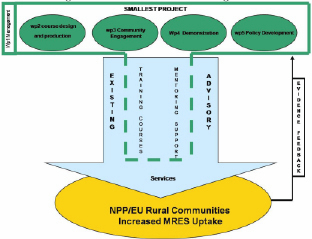
Response from NPP MicrE and NPP Smallest
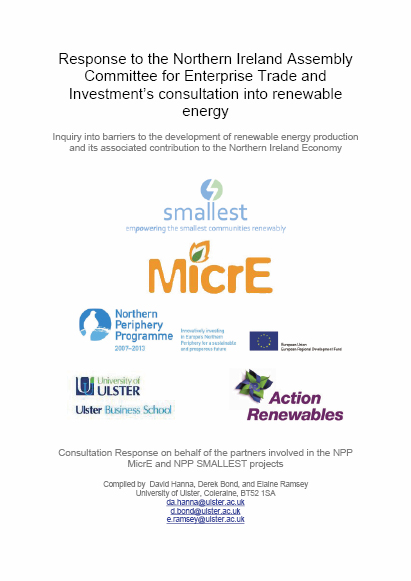
Response to the Northern Ireland Assembly Committee for Enterprise Trade and Investment's consultation into renewable energy
Inquiry into barriers to the development of renewable energy production and its associated contribution to the Northern Ireland Economy
1. Executive Summary
This short paper is a response to the renewable energy enquiry being conducted by the Committee for Enterprise Trade and Investment (ETI), entitled "Inquiry into barriers to the development of renewable energy production and its associated contribution to the Northern Ireland Economy". The paper has been prepared on behalf of two consortiums undertaking major European Union projects in the area of renewable energy in the northern periphery of Europe. The aim of this paper is to share the knowledge obtained from these projects in the hope of benefiting the inquiry.
The two European projects are:
- MicrE which is concerned with developing services to help SMEs transfer to renewable energy solutions from traditional sources; and
- SMALLEST which is concerned with establishing an innovative service to raise the scale and quality of training, mentoring and support for rural communities needed to develop micro renewable energy sources.
Both are funded by the INTEREG IVB (Transnational) Northern Periphery Programme (NPP), which aims to remove barriers to the participating countries development, by encouraging transnational co-operation between the regions of Europe in predetermined subject areas.
This report utilises the practical and theoretical expertise of the SMALLEST and MicrE partners and their respective business advisory groups in identifying the barriers to renewable energy adoption in Northern Ireland. From the resultant data a number of barriers were identified:
- Unstable incentives make financial planning difficult;
- Capital grants that are awarded to financially unsustainable projects are damaging the reputation of the industry;
- Overabundance of advisory bodies creating confusion amongst consumers;
- Ever increasing costs coupled with time delays in joining the grid make the initial start-up process capital intensive;
- There is a lack of cohesion between governmental departments; and
- Neighbours in the UK and Ireland are benefiting from financial incentives that are unavailable to organisations in Northern Ireland.
The report concludes by making a number of suggestions which may help to alleviate the perceived problems.
- Introduce comparable incentives to the UK and Ireland;
- Fewer advisory bodies and tighter regulation;
- The promotion of renewable energy management and innovation training;
- Utilise the experience of countries in the early stages of developing a renewable energy market in addition to industry leaders; and
- Increase the level of collaboration with bodies specialising in renewable energy. ·
2. Contents
1. Executive Summary
2. Contents
3. Tables
4. Images
5. Introduction
6. Background
7. Overview
8. Findings
8.1 Consider the current mechanisms at national, regional and local level
to support and assist renewable energy production.
8.1.1. Grants
8.1.2. Subsidies
8.1.3. Planning Office Advice/Fees
8.1.4. Future Policies
8.1.5. Advisory Bodies
8.1.6. Departmental Cohesion
8.1.7. Distribution Code
8.1.8. Grid Connection
8.2. Compare the mechanisms for support and assistance in Northern Ireland with those in other EU member states considered to be in the forefront of renewable energy development.
8.2.1. UK Overview
8.2.2. Scotland
8.2.3. Ireland
8.2.4. Finland
8.2.5. Sweden
8.2.6. Iceland
8.3. Examine the support and assistance available to SMEs in the renewable energy sector to develop renewable energy technologies and to grow and develop their business.
8.3.1. Carbon Trust
8.3.2. Invest NI
8.3.3. European Funding
8.4. Access which EU member states are considered to be at the forefront of renewable energy development both overall and for each type of renewable energy.
8.4.1. Sweden
8.4.2. Finland
8.4.3. Iceland
8.5. Assess the appropriateness of current mechanisms to develop and grow both local renewable energy markets and export markets.
9. Conclusion
10. References
11. Appendices
11.1. Appendix 1: MicrE Project Team
11.1.1. Introduction
11.1.2. Work Programme
11.1.3. Partners
11.2. Appendix 2: SMALLEST Project Team
11.2.1. Introduction
11.2.2. Work Programme
11.2.3. Partners
11.3. Appendix 3: World Bioenergy 2010, SMALLEST Conference Paper
11.4. Appendix 4: Funding in Scotland
11.5. Appendix 5: Renewable Energy Grants/Assistance Available
Within the West Region
3. Tables
Table 1: Barriers experienced by energy operators
Table 2: Need of support experienced by energy operators
Table 3: Percentage of overall energy in UK that comes from renewables
Table 4: Percentage of overall energy in the EU that comes from renewables in 2010
Table 5: Top 5 countries in regards to renewable output
Table 6: Top 5 countries in regards to expansion of renewable energy output
Table 7: Breakdown of the Finish Energy Market (English translation)
Table 8: EU Support Mechanisms Compared
4. Images
Image 1: Icelandic Power stations, and proposed sites
Image 2: SMALLEST Work Program
5. Introduction
Renewal energy provides Northern Ireland with many opportunities and many challenges. The importance of its role has been recognised by the European Regional Development Fund (ERDF) that has, through the INTERREG IV programme, funded cross border and transnational activities in the area. In this paper the experiences and expertise of two Northern Periphery Programme INTERREG consortiums, MicrE and SMALLEST, are utilised to provide evidence to the Northern Ireland Assembly's Committee for Enterprise Trade and Investment (ETI): "Inquiry into barriers to the development of renewable energy production and its associated contribution to the Northern Ireland Economy".
The two ERDF consortiums that have contributed to this paper are:
- MicrE which is concerned with developing services to help SMEs transfer to renewable energy solutions from traditional sources; and
- SMALLEST which is concerned with establishing an innovative service to raise the scale and quality of training, mentoring and support for rural communities needed to develop micro renewable energy sources.
Both are funded by the INTEREG IVB (Transnational) NPP. More details of the projects can be found in Appendix 1.
This paper is structured as follows: firstly the background to the response is given and the main points summarised. Then most of the inquiries main objectives will be addressed in turn; and finally the paper will conclude by tentatively suggesting some areas and ideas for future consideration.
6. Background
Northern Ireland organisations play a major role in both consortiums. In the SMALLEST consortium Action Renewables provide in-depth knowledge of the technical issues and the vocational training elements of renewable energies. The Ulster Business School provides practical business advice and training in both projects alongside more in-depth analysis of the management issues related to renewable energies. Their endeavours are supported by a steering group and a business advisory group (BAG). Both Northern Ireland partners work closely with their NPP colleges. When the Committees request for evidence on renewable energy was made, the other partners were approached for their comments and advice. This paper is based on their replies and that of the BAG.
7. Overview
In a recent paper, Jarmo Renvall from the North Karelia University of Applied Sciences partner, gave a presentation on the "Barriers of Implementing Renewable Energy and Energy Efficiency in Northern Periphery" at the biennial World Bioenergy, Jönköping, Sweden. As part of the conference paper (see Appendix 3) energy operators were surveyed on their installations and a table (see table 1) was constructed summarising the barriers that had been encountered by the participants in each region.
Taking into account the barriers encountered, the participants were then asked how they felt these matters could be addressed and the results are shown in table 2.
The rest of this paper address most of the Committee's main objectives in turn, expanding on the summary information in these tables.
Table 1: Barriers experienced by energy operators
| Faroe Islands | Level of commitment |
| Globalized financial policy | |
| Knowledge on legal and contractual questions | |
| Finland | Attitudes of some of the authorities and advisory organisations |
| Access to best practice examples | |
| Lack of similar cases in grant decisions | |
| Fluctuating level on subsidies | |
| Dependence on national policy (feed-in tariffs etc.) | |
| Iceland | Piloting the technology |
| No advisory organisations existing | |
| Cheaper ways to produce energy exists (geothermal, hydropower) | |
| Northern Ireland | Funding application bureaucracy |
| Grant money payment afterwards | |
| No flexibility in financing | |
| Lack of renewable energy awareness amongst staff members | |
| Scotland | Attitudinal approach, amount of ambition |
| Sweden | Access to best practice examples for, and knowledge of funding programmes in small and very small communities and villages. |
Table 2: Need of support experienced by energy operators
| Faroe Islands | Updated advisory services (legal and contractual questions) |
| Finland | Training in technology maintenance |
| Centralized advisory services | |
| Holistic and objective advisory on investment and technologies | |
| Iceland | Lack of development context for bioenergy |
| Northern Ireland | Holistic and objective advisory on investment and technologies |
| Training in technologies | |
| Scotland | Real life experiences of advisors (legislation, regulations) |
| Sweden | Increased proactive advisory services aimed at small and very small communities and villages. |
Over the course of this report, partners involved in the MicrE and SMALLEST projects will give their opinions on the heading specified by the consultation, giving more information on the barriers that have been summarised in table 1 and identifying new ones.
8. Findings
8.1 Consider the current mechanisms at national, regional and local level to support and assist renewable energy production.
There are numerous support mechanisms in place to enable renewable energy production in Northern Ireland. In order to assess effectiveness and overall satisfaction levels with these mechanisms, the BAG members were asked to consider the support mechanisms offered to assist renewable energy production. The main points from their discussion were:
8.1.1. Grants
- Grants can be misleading, encouraging organisations to make investments that are unsustainable;
- A large initial capital grant can hinder an organisations foresight and prevent them from analysing the long term financial benefits of an investment;
- Information should be made available on the financial evaluation of renewable energy installations, as advisory firms can often mislead consumers into thinking they will get a higher return on investment than feasibly possible; and
- Short sighted financial decisions can damage the overall reputation of renewable energy and financial incentives such as grants should only be awarded to investments that will prove sustainable in the long term.
8.1.2. Subsidies
- Short term or inconsistent subsidies make it difficult for organisations to make sound financial predictions;
- Renewables often require a significant capital investment and businesses need to produce accurate financial projections to ensure adequate profit; and
- At present the main financial incentive for the generation of renewable energy in Northern Ireland are Renewable Obligation Certificates (ROCs). However the price is set by auction making it unstable and difficult to plan for.
8.1.3. Planning Office Advice/Fees
- There have been cases where conflicting advice has been given from neighbouring planning offices in what is classed as permitted development and consequent planning fees;
- One BAG member went on to give a specific example of an installation where one office said that the area surrounding the wind turbine is the permitted area and therefore a fee of £250 would be applicable. Whereas a neighbouring office has stipulated that the access laneway approaching the turbine would be taken into consideration and a fee of £1,300 is being stated. These blurred policy guidelines or misinterpretation of guidelines are creating a discrepancy of £1000 for the organisation in question; and
- Planning offices must offer coordinated advice to prevent these discrepancies occurring and negatively effecting businesses.
8.1.4. Future Policies
- In Britain the Government have introduced feed in tariffs, providing a subsidy for each unit of renewable energy generated, and there is some expectation that this subsidy will be eventually introduced in Northern Ireland;
- This method of subsidising renewable energy has the potential to increase the uptake of renewable energy usage;
- The British Government decided to only fully subsidise new builds, effectively penalising early adapters;
- Having seen what has happened in Britain, organisations in Northern Ireland may be waiting for feed in tariffs to be properly introduced before implementing their own renewable energy strategies; and
- At present the level of uncertainty surrounding renewable energy subsidies is creating difficulties in financial planning, with the potential subsidies acting as a deterrent to early adopters.
8.1.5. Advisory Bodies
- There are a large number of publicly funded organisations offering help and advice on renewable energy;
- Reliable and affordable advice is greatly appreciated by organisations and can increase usage;
- Knowing who to seek advice from can be difficult, particularly when an organisation is new to the field;
- Too many organisations offering advice can cause confusion to businesses that are seeking help. Different organisations can also have their own agendas, meaning businesses have to be careful who to trust;
- One method of reducing this confusion is to amalgamate some of the organisations in an effort to create an independent "one stop shop", which can offer impartial advice without having an agenda to fulfil; and
- Reducing the number of renewable energy organisations will help increase the accessibility and consistency of information.
8.1.6. Departmental Cohesion
- Government departments lack cohesion and communication in regards to environmental policy;
- One member of the BAG gave the example of 2 hospitals in Northern Ireland that utilise coal fired generators in spite of Governmental pressure to reduce carbon emissions; and
- Communication and cooperation between departments is essential in order to meet targets set out during the Kyoto Protocol and the Copenhagen accord 2009.
8.1.7. Distribution Code
- On the 1st of May 2010 a new distribution code was introduced to the province which created additional costs for connecting a renewable energy installation to the grid;
- NIE have decreed that all privately owned generators must ensure that a telephone line is in place, to enable communication with the operator;
- The owner will be responsible for arranging and paying for installation as well as rental costs;
- The code also introduces the requirement for generators to provide a supervisory control and data acquisition (SCADA) system and control facilities to monitor the installation; and
- It is estimated by NIE the communication line and the SCADA will cost approximately £20K plus VAT. This is a significant up-front cost and is causing much concern from organisations that are worried about the capital investment required to generate renewable energy.
8.1.8. Grid Connection
- There was some concern over the length of time it takes for a renewable energy installation to be connected to the grid;
- One panel member complained that connections were talking between 3-12 months to arrange; and
- Long time delays cost firms revenue, effecting their cash flow and financial projections.
8.2. Compare the mechanisms for support and assistance in Northern Ireland with those in other EU member states considered to be in the forefront of renewable energy development.
8.2.1. UK Overview
The overall usage of renewable energy in the UK between 2005 and 2008 has been increasing. Scotland is leading the way with 18% of its domestic energy coming from renewable sources, in comparison to second placed Northern Irelands 6.4%. Although there are some similarities and overlap between the support mechanisms in Scotland and Northern Ireland, Scotland is leading the way in renewable energy production in the UK (see table 3).
Table 3: Percentage of overall energy in UK that comes from renewables

Source: Department of Energy & Climate Change 2009
Although Scotland is leading the way in the UK, it pales in comparison to some of our European neighbours (and European applicants) in regards to renewable energy generation. Table 4 shows that the UK lags behind 20 other countries, and taken individually, Wales, Northern Ireland and England look even worse by comparison. The Nordic countries, Latvia and Austria are paving the way, with Norway generating over 109% of its energy from renewable energy sources.
Table 4: Percentage of overall energy in the EU that comes from renewables in 2010
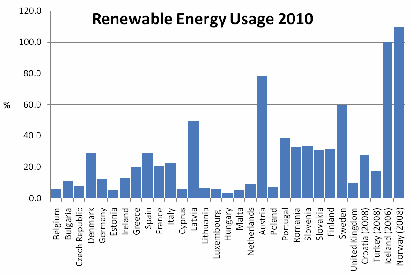
Source: adapted from Eurostat 2010
MicrE and SMALLEST encompass many members from across EU and are strongly represented in the Nordic regions (see appendix 1 and 2) where renewable energy usage is strong. Over the next few sub sections the members have tried to summarise the support mechanisms for renewable energy producers.
8.2.2. Scotland
In Scotland, communities looking to adopt renewable energy are supported through the CARES programme, http://www.communityenergyscotland.org.uk/cares.asp which is managed by Community Energy Scotland.
Community Energy Scotland, CARES offers grants to a range of community organisations to help with the installation of a variety of renewable energy technologies. Communities may apply for funding for technical assistance and capital grants for renewable energy equipment installation and associated costs. Under CARES there is no set grant funding. The amount of funding awarded is determined on a case by case basis.
Through the SMALLEST project, International Resources and Recycling Institute (IRRI) has been working with CES CARES to assist community groups in Scotland. CES have drawn up a database with sources of funding for communities in Scotland (see appendix 4, an electronic version is also available on-line in the CES Community Toolkit).
The Energy Savings Trust in Scotland assists communities with grants and small business loans for renewable energy http://www.energysavingtrust.org.uk/scotland/Scotland- Welcome-page/Communities-in-Scotland. The Energy Savings Trust also provides free advice to businesses, assists businesses in accessing funding and improving their energy efficiency.
Although CARES and the Energy Savings Trust have been successful in promoting renewable energy, the Scottish administration is making every effort to proceed with further policy changes that support the community sector. To aid their efforts, the Scottish Government have formed a number of advisory groups which sit under the heading of FREDS (Forum for Renewable Energy Development Scotland). One of these groups is called CRIG (Community Renewables Implementation Group) and it counts amongst its members Nick Lyth, who is a director at the IRRI. IRRI are Lead partners in SMALLEST and work package leaders in MicrE, and are collaborating with the Scottish Government help promote renewable energy.
8.2.3. Ireland
As illustrated in table 4, 13.2% of Ireland's energy comes from renewable sources. In order to increase the amount of renewable energy generated a number of different funding mechanisms are available to potential and existing investors. A list of funding providers in the West region is provided in Appendix 5.
8.2.4. Finland
On 20 April 2010, the Finnish Government's ministerial working group for climate and energy policy agreed on the contents of an extensive package of obligations concerning renewable energy. Finland aims to increase renewable energy production from 87TWh in 2005 to at least 124 TWh by 2020. This package will promote the use of forest chips and other wood-based energy in particular, alongside wind power, the use of transport bio-fuels, and the increasing utilisation of heat pumps. In doing so it will enable Finland to meet its obligations set by the European Union, to increase the share of renewable energy to 38 per cent of its total energy consumption by 2020.
According to the European Renewable Energy Council (2009), In order to achieve its goals of increasing the amount of renewable energy generated, the Government has a number of policies in place to encourage investment:
- The construction costs of renewable energy plants that generate electricity are co-financed by the Government with grants of up to 40% in the case of wind;
- The Government imposes a tax per kWh on all Finnish electricity suppliers which they pass on to their end consumers. The Government refunds this tax to suppliers of renewable electricity with the subsidies being biased towards wind energy. All technologies used for the generation of electricity from renewable energy sources are promoted with the following exceptions: solar power plants, large hydro power plants, geothermal power plants and plants generating electricity from peat;
- All electricity users and electricity-producing plants, including RES-electricity are guaranteed access to the electricity grid;
- The generation of electricity from peat5 is promoted through a price regulation in terms of a guaranteed feed-in compensation, whose amount is determined by law and which is to be paid per MWh of electricity. The amount of the feed-in compensation is calculated according to the production costs and the general market price for electricity. The grid operator adapts the amount of payment every month;
- The construction costs of renewable energy plant that generate heat are co-financed by the Government with grants of up to 30%. This applies to companies. Direct investment supports individual biomass heating installations.
In addition to the incentives already outlined, there are a number of specific enticements that are relevant to the renewable energy technologies:
Wood
- Three-step supporting package to increase the competitiveness of the forest energy:
- Energy subsidy for chipping the small-dimensioned wood;
- Subsidy for electricity production; and
- Feed-in tariff for new small-scale CHP plants.
Wind
- Wind energy will be sold using a market based price guaranteed pricing system, whereby subsidies will be offered on top of the market price. In addition a short-term bonus price will be offered until the end of 2015, which will guarantee 105,30 € per MWh for the first 3 years of production.
Renewable Transport Fuels
- In order to meet this aim capital investment for cereal-based bioethanol production, processing 120 000 – 150 000 tonnes, will be covered by business subsidies.
Others
- Biogas will be incentivised by the usage of a guaranteed pricing system;
- 1MW Hydro plants qualify for investment subsidies, and there are plans to extend subsidies for plants up to 10MW in size; and
- Recycled fuels are offered a taxation subsidy of 2.4 €/MWh.
8.2.5. Sweden
National level: In Sweden more than 40% of the energy comes from renewable sources. The goal fixed by Europe is to reach 49% in 2020. Sweden has fixed a goal to achieve 50%. The efforts have therefore been on the larger scale – to get a bigger cost-efficiency. The national strategy is currently not scheduled for review, but it is expected that there will be a review after the election which are due to take place in September 2010
Local level: In order to continue the growth in renewable energy usage, the municipality of Norsjö has set out its own "Local energy plan". This plan is reviewed every five years in order to stay relevant, with the next review due in 2010-11. In 2020, Norsjö's energy situation shall have the following features:
- The energy will be used in the form, quantity, and at the moment
where it has the greatest benefit to society after pros and cons have been weighed against each other; - The energy system is designed to be part of a sustainable society. It has been tailored to suit nature and is based on an intelligent use of resources. At the same time the energy shall be a part of the development of a living rural area and have a positive impact on local entrepreneurship and community structure;
- Renewable energy will be the foundation of the energy supply. Local forms of energy are rewarded and natural resources are used in the best way;
- The methods used for energy production within the municipality will not cause pollution or have a negative impact on air, water and land exceed from what nature can withstand in the long term. Nor will it cause harm to the human health, biodiversity and beauty of the landscape;
- The energy used in the municipality, but produced elsewhere, will fulfil the same requirements for environment and humans as the energy production within the municipality;
- Modern energy technologies are used and developed in a way that helps Norsjö to follow up with development;
- Norsjö residents will have a good knowledge in main areas concerning energy and environment. The individual man's role is central and will encourage own initiatives; and
- The municipality of Norsjö will have a high excellence in processing of biomass.
8.2.6. Iceland
Iceland has extensive resources of renewable hydro and geothermal energy and today more than 80% of the energy comes from renewable sources and the future aim is to reach 100%. In comparison the goal fixed by Europe is to reach 20% in 2020. Despite this Iceland haven't yet formed any comprehensive national energy policy and therefore a formal Community renewable energy policy is nonexistent. Each municipality can freely harness renewable energy sources but need to follow national policy with respect to environmental and planning issues.
The world economic crisis, rising cost of imported fuel and increased awareness of the benefits of renewable energy has put extra pressure on the Government that is now forming a new comprehensive policy that will help Iceland reach its goal.
This new policy is intended to help develop green business structure and overall framework to attract investors (e.g. through tax incentives) and determine:
- Clear ownership and domination of natural resources and clear setup of financing and implementation that maximises profit and minimises risk;
- Reconciliation about where and how to use the natural resources; and
- The objectives of using the energy and the ways to fulfil them.
The Master Plan for Hydro and Geothermal Energy Resources will be an influential factor in the development of the comprehensive energy policy. With only a portion of the renewable energy resources being harnessed (approx. 20–25%) the Government initiated a process in 1999 with the aim of developing a master plan comparing the economic feasibility and the environmental impact of the proposed power development projects. It is hoped that this comparison will aid in the selection of the most feasible projects to develop, considering both the economic and environmental impact of such decisions, such as which rivers or geothermal fields should not be harnessed due to their value as natural heritage and for recreation. Results are expected in 2010. For more information go to the Master Plan website (http://www.rammaaaetlun.is/english).
Part of the comprehensive policy development is Iceland's desire to become the world's first nation with a zero emission transport sector and the Government is committed to encourage the transition from imported fossil fuel to domestic and sustainable fuels, e.g. electricity, hydrogen, methane gas, biodiesel, and methanol or DiMethylEther.
The Ministry of Industry, together with key players in the energy market, is currently preparing to introduce a comprehensive strategy plan to facilitate a conversion project based on three main pillars:
- Incentives to buy and use vehicles utilizing sustainable energy or domestic fuels;
- Incentives and support to research and develop sustainable energy or domestic fuels; and
- Support to construct multi-purpose fuelling stations on strategic locations around the country to ensure that cars using alternative sources of energy can be used for travel.
This project will e.g. rely on tax incentives, customs, tariffs and emission cost to make sustainable driving a competitive choice for the consumer. The Government, municipalities and official institutions are encouraged to show an example by replacing their own fossil fuelled fleet with alternative cars.
8.3. Examine the support and assistance available to SMEs in the renewable energy sector to develop renewable energy technologies and to grow and develop their business.
8.3.1. Carbon Trust
The Carbon Trust is a not-for-profit company with the mission to accelerate the move to a low carbon economy. It provides specialist support to help business and the public sector cut carbon emissions, save energy and commercialise low carbon technologies. It is founded by the Government and is partially funded by the climate change levy, which is a tax on non domestic energy users.
- The Carbon trusts advice is held in high regard by the MicrE and SMALLEST BAGs;
- There is some concern over the cost of advice from the Carbon Trust, particularly from SMEs which have to closely monitor their expenditure; and
- There have been suggestions in the media that the Government will seek to combine the Carbon Trust with other quangos with the intention of creating a "green investment bank". The lack of clarity over the issue is causing concern from potential investors.
8.3.2. Invest NI
Invest Northern Ireland is Northern Ireland's economic development agency. Its overall goal is to help create wealth by supporting business development, helping to increase export levels, attracting high quality inward investment, and stimulating a culture of entrepreneurship and innovation.
- Research and development funding is available from Invest NI and since the start of the Grant for R&D Scheme (Jan 09), Invest NI has issued 23 (correct of the time of writing) offers in the renewable sector with others in the wings; and
- There is a tendency to fund research into the latest technology in preference to existing well developed technology. Whilst it is important to develop new technology, it often takes a long time to perfect. Early adopters that invest in the newest technology may suffer from unreliable products, short life spans, and expensive equipment amongst other teething problems associated with new technology. By investing in the refinement in existing, developed technologies these problems could be eliminated and end consumers would benefit from more reliable installations.
8.3.3. European Funding
There are a number of European funding opportunities for business and other organisations in the renewable energy industry, for example:
- Interreg is designed to stimulate cooperation between member states of the European Union on different levels by fostering the balanced development of the continent through cross-border, transnational and interregional cooperation; and
- Framework Programs (FPs) are financial tools through which the European Union supports research and development activities covering almost all scientific disciplines. FPs are proposed by the European Commission and adopted by Council and the European Parliament following a co-decision procedure.
MicrE and SMALLEST are both funded by Interreg and are aware of the good work that is achieved through the projects it has commissioned. However the consortiums feel that there are some limitations to these funding mechanisms:
- There is too much emphasis on research rather than the implementation of technology. In order to develop new technologies it is often necessary to build prototypes for trial purposes, and these funding mechanisms often offer insufficient capital for this purpose;
- Funding can be hard to obtain, limiting applications for funding to those with the time and resources to perform substantial research and planning with no guarantee of project approval; and
- Cross regional collaboration can be difficult when dealing with new technologies because organisations are protective of their intellectual property. Distrust in other organisations can hinder development and reduce the benefits that collaboration can potentially bring.
8.4. Access which EU member states are considered to be at the forefront of renewable energy development both overall and for each type of renewable energy.
There are a growing number of countries in the EU that are leading the way in the utilisation of renewable energy. Table 5 illustrates how European countries are fairing in comparison with the rest of the world.
Table 5: Top 5 countries in regards to renewable output
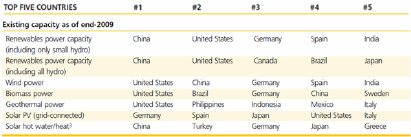
Source: REN 21, 2010
The table shows that Germany is the EU leader in renewable energy generation, however table 4 shows that this is a relatively low proportion of its overall energy supply at 12.5%. This is due to Germany's high population, large land mass and its high demand for energy.
Using the amount of renewable energy produced as an indicator of market leadership can be deceptive, and it is import to use other data such as the overall proportion energy that comes from renewable sources.
Another useful comparative tool is shown in table 6, which illustrates the countries that have expanded their renewable energy capacity at the fastest rate in 2009.
Table 6: Top 5 countries in regards to expansion of renewable energy output

Source: REN 21, 2010
The table shows that Germany expanding their capacity at the fastest rate, followed by Italy and Spain. Again this is not a fair comparative technique due to the spending power of the countries, and the implication that countries with a pre-existing large renewable energy capacity will not need to spend as much on new installations. In order to illustrate their core competencies, the MicrE and SMALLEST partners were asked to comment on their regions capacities.
8.4.1. Sweden
Sweden has evolved a comprehensive set of Governmental and non-Governmental frameworks to enable biogas-from-waste development and is rapidly moving towards advanced market development in this area with large commercial biogas-from-waste investment and an expanding fleet of gas-enabled vehicles, gas CHP plants and gas heating plants.
Sweden produced 1,359 GWh of biogas-from-waste in 2008 (per capita-145 kWh), of which 26% was used for transport. At present, only about 17% of Swedish digestible household waste is currently used to produce biogas. If Sweden were able to utilise the remaining 83% of digestible household waste not currently used, total biogas production would roughly double. If agricultural and industrial waste streams could be further developed it would be possible to more than double these figures again. These other streams can be quite rich in energy; some energy-rich waste streams include, for example, wood pulp wastes, food and fish processing and slaughterhouse waste.
At the end of 2009 there were more than 23,000 gas vehicles and 104 public vehicle gas stations in Sweden. More than 69 million m3 of vehicle gas was sold in 2009, an 18 % increase on 2008. The fossil fuels replaced by vehicle gas in 2009 reduced GHG emissions by 130,000 tonnes as well as improving air quality. Sweden continues to work diligently to reduce reliance on petroleum fuels, and is a European pioneer in the development and use of ethanol as a transport fuel with 140,000 E85 vehicles in operation as of 2008. In all, there were 202,693 clean vehicles running in Sweden at the end of 2009. Additional clean transport benefits come from fuel blending programmes with a 5% mix of ethanol in most gasoline supplies and about 5% FAME, (fatty acid methylester) blended into most diesel fuels.
The forecasted consumption of renewable transport fuels in Sweden for 2010 is about 5,500 GWh or the equivalent of 60,000 cars at 15,000km/car/year. Of this, about 450 GWh (8.2%) will come from biogas. The 2000 baseline for total renewable transport fuels, by comparison, is about 500 GWh. Overall, Sweden's use of renewable energy represented 46.3% of its total net energy consumption (includes transport energy) in 2009 based on preliminary data from Svebio. Sweden's 2020 EU goal is 49.9%. During 2009, Sweden's total net energy from bioenergy surpassed its total net energy from petroleum getting 31.7% of its energy from bioenergy and 30.8% from petroleum.
During 2008, North Sweden biogas-from-waste production was 196 GWh which is a 50% higher per capita output compared to Sweden as a whole. This includes a significant portion of biogas-from-waste production from industrial wastes. North Sweden is using less than 17% of household wastes at present to produce gas. It is estimated that the total value of biogas from household waste alone in North Sweden is more than 130GWh/year. 130GWh would be equal to 12,000 passenger cars driving an average of 15,000km per year and would equal 14,400 m3 of fossil transport fuels. The displacement of fossil fuels in this case would reduce GHG emissions by more than 38,100 tons/year.
In addition to the benefits provided to North Sweden through national initiatives and programmes aimed at increasing biogas-from-waste production, North Sweden has the most active regional biogas development network in Sweden – Biogas Norr (Biogas North). Biogas North is very active in bringing together regional, municipal and commercial interests towards advancing biogas-from-waste production and use in North Sweden, in particular, looking at biogas for transport.
8.4.2. Finland
Table 7 illustrates how the Finnish renewable energy market was composed in 2005.
Table 7: Breakdown of the Finish Energy Market (English translation)
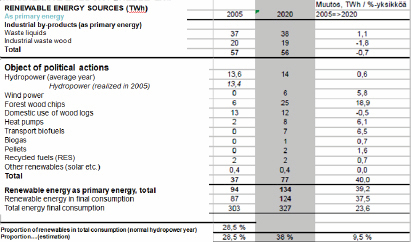
From the table it becomes clear that Finland specialises in the usage of wood, generating 19TWh of energy from wood chips and wood logs in 2005. The Government has agreed to increase the usage of wood to generate a total of 45TWh and has introduced a number of mechanisms to achieve these targets. As a consequence of these targets, Finland has ingrained knowledge of using wood to generate energy and Northern Ireland could benefit from its experience in implementing a wood focused energy strategy.
8.4.3. Iceland
As previously alluded to in section 8.2.6, Iceland generates the majority of its renewable energy using hydro and geothermal energy resources. The reason the Icelandic Government have chosen this energy strategy is because of the extensive natural resources that are inherent on the Island. Iceland aims to utilise even more of its natural resources with the overall intention of becoming a renewable energy exporter via the proposed interconnector to the UK. The Master Plan aims to increase renewable energy, with figure 1 illustrating the existing and proposed projects.
Image 1: Icelandic Power stations, and proposed sites
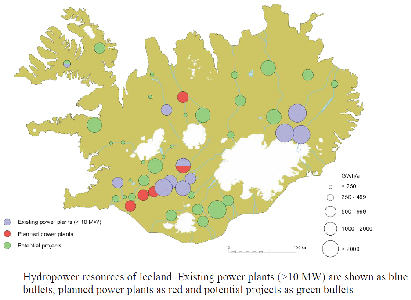
Source: Steingrímsson et al., 2007.
Due to the existing and proposed capacity for renewable energy production, Iceland believes itself to be a leader in hydro and geothermal technologies and feels Northern Ireland could learn from its experiences.
8.5. Assess the appropriateness of current mechanisms to develop and grow both local renewable energy markets and export markets.
As illustrated in table XX, Germany is the leading generator of renewable energy in the EU. Table 8 compares the mechanisms for encouraging renewable energy production in the EU and other developed nations.
Table 8: EU Support Mechanisms Compared
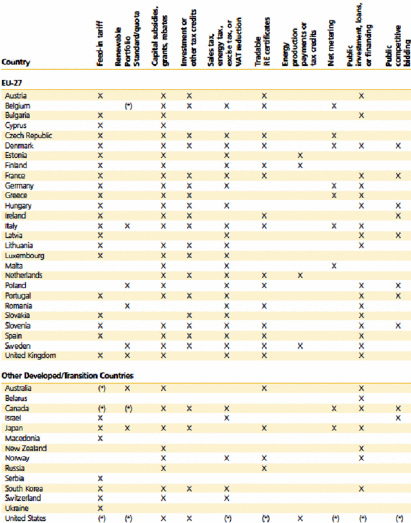
Source: REN 21, 2010
Table 8 shows that German organisations are benefiting from feed-in tariffs, tax credits and net metering, whereas Northern Ireland has no comparable benefits. In simplistic terms, an investor seeking to build a renewable energy plant, with no geographical limitations, would receive more benefits by locating in Germany than Northern Ireland. Perhaps even more worrying is that Northern Ireland suffers from the lack of feed-in-tariffs, which are offered by the rest of the UK and Ireland. Investors would receive more benefits by locating their renewable energy plants in Britain than Northern Ireland and would not have to make significant culture changes. The lack of comparative support mechanisms in Northern Ireland in comparison to the rest of the EU is detrimental to renewable energy investors, but failure to offer the same or better incentives as Ireland or the rest of the UK is an even bigger determent to the industry. In addition to the pre-existing policy discrepancy, in April 2010 the renewable heat incentive will be introduced to Britain, guaranteeing payment to heat generating technologies such as ground source heat pumps, biomass boilers and air source heat pumps. Northern Ireland will not get this incentive, or at least not straight away, which will act as a reason for potential investors to invest in Britain instead. Before trying to compete with the rest of the EU, Northern Ireland needs to catch up with the rest of the UK instead of effectively punishing investors for locating in the province.
9. Conclusion
Northern Ireland has substantial natural resources, such as wind, hydro, tidal, bio-mass. This could make Northern Ireland an ideal location to develop a world class renewable energy industry. As with many areas, such as research and development, the level of renewable energy activity is lower than in other parts of the British Isles. Renewable energy only made up 6% of the country's total energy consumption in 2008 in comparison to Scotland's 18% and Ireland's 13%. This is partly due to the lower level of incentives available in other regions of the British Isles, such as feed in tariffs and renewable heat incentives. Over the past few years the financial incentives that are available in Northern Ireland have been unstable and there are many examples of companies investing in unsustainable projects. To utilise its potential, Northern Ireland needs to provide a stable investment environment for renewable energy.
Knowledge transfer is extremely important and the present systems seem to lead to confusion. Whilst there is both much information and a number of organisations that offer help and advice available to businesses in Northern Ireland, potential users find it difficult to know who to approach for independent and trust worthy advice. Some form of regulation of advice and support needs to be considered.
Whilst vocational training in renewable technologies is available there is, as yet, no local available training for professionals in renewable energy innovation and management. The Ulster Business School is currently developing courses to address this short-coming. In addition, with SMALLEST and MicrE partners, they are considering the need for a new service that clearly advises on the business potential of renewable energy without the perceived conflicts of interest of current provision.
The Committee is interested in understanding best practice elsewhere. Ireland and Scotland have already attracted substantial investment and have a similar culture to Northern Ireland making them ideal examples to learn from. MicrE and SMALLEST have pre-existing links in Scotland and Ireland meaning they can help facilitate the transfer of knowledge to Northern Ireland.
Looking further afield, member states at the forefront of renewable energy implementation may not be the member states best placed to act as best practice exemplars for renewable energy policy development and training requirements in Northern Ireland. The degree to which a particular renewable energy technology has been implemented in a member state and the embedded nature of the technology, supply chains, training and public awareness will have an influence on the current requirements for policy development in that region. Importantly, it should be recognised that this will vary between technologies as well as regions. The countries in the NPP INTERREG region generally face opportunities and challenges similar to those in Northern Ireland and can provide suitable examples of best practice.
The Ulster Business School and Action Renewables will be happy to keep the Committee informed of activities within the NPP regions.
10. References
Department of Energy & Climate Change. 2009. Energy Trends (National Statistics) [Internet] Newport (Published December 2009) Available at: http://www.decc.gov.uk/assets/decc/statistics/publications/trends/1_20091222083326_e_@@_trendsdec09.pdf (accessed 29 July 2010)
European Renewable Energy Council. 2009. Renewable Energy Policy Review
Finland. [internet] EREC. Available at: http://www.erec.org/fileadmin/erec_docs/Projcet_Documents/RES2020/FINLAND_RES_Policy_Review__09_Final.pdf (accessed 2 August 2010).
Eurostat. 2010. Electricity generated from renewable sources. [Online] (Updated 17 June 2010) Available at: http://appsso.eurostat.ec.europa.eu/nui/show.do?dataset=nrg_ind_333a&lang=en [Accessed 25 July 2010].
REN21. 2010. Renewables 2010 Global Status Report. [internet] REN21. Available at:
http://ren21.net/globalstatusreport/REN21_GSR_2010_full.pdf (accessed 29 July 2010).
Steingrímsson, B., Björnsson, S., & Adalsteinsson, M. 2007. Master Plan For Geothermal And Hydropower Development In Iceland. Geothermal Development in Central America – Resource Assessment and Environmental Management. San Salvador, El Salvador 25 November – 1 December 2007. Reykjavík. Available at:
http://www.rammaaaetlun.is/media/virkjanakostir/2-afangi/Enska-timarit-fra-SIJ-25feb.pdf (accessed 25 July 2007).
11. Appendices
11.1. Appendix 1: MicrE Project Team
11.1.1. Introduction
The technologies for renewable energy generation are dominated by those which achieve economies of scale. Even those technologies which have been adapted for micro-generation are dominated by urban provision, because the suppliers, retailers and service companies of the micro-generation technology require volume sales in order to be economic, and the volume required can only be found in urban environments. The micro waste energy business: Micro Energy to rural enterprise (MicrE) project seeks to enhance the capacity for self-sustaining business and organisation life in rural NP regions. This will be achieved by developing a service that will make renewable energy solutions available to SMEs in rural NPP partner regions on a scale that is viable and economically feasible.
11.1.2. Work Programme
The MicrE service requires a blend of skills, with the capacity for a series of actions as follows:
- Technology identification - which are the most appropriate technologies for the MicrE service? They may be new, emerging or established technologies. They may exist within the NPP region, within the NPP Member States, within the EU, or outside the EU. What are they and how are they accessed? The MicrE service is establishing a network of Technology Partners, which will be formed into a Technology subcommittee. This network will act as a technology funnel, collecting a large number of different technologies, reviewing them, and acting as a filter to reduce the number to a small quantity of serious prospects. The MicrE project started with four identified candidates for development, sourced through Technology partners already engaged in the MicrE concept at the application stage. These four are:
1. Micro pyrolysis of wood based products to energy and fuel
2. Micro biomethane production and purification for vehicles
3. Anaerobic digestion with heat and power
4. Small scale gasification with heat and power
As the project has progressed, the MicrE project team have chosen to widen the criteria for technology utilisation based on regional feedback. Scotland, for example, recognised the ever increasing demand for wind powered technologies in the area, due to an ideal climate, available land and favourable Government policy.
- Experimental Development - the technologies identified for the MicrE service will need to be adapted and tested in order to demonstrate how they will work at a small scale in the conditions of the Northern Periphery. This stage will establish their technical viability and efficiency. The MicrE service will establish a Project Test Facility with the level of expertise required to perform the required tests.
- SME Engagement - the adapted and proven technologies will be embedded within SMEs and candidate organisations willing to pilot test their long-term viability. This requires project teams in each region with the capacity to identify the right candidate SMEs, help plan install and train their staff to run the necessary pilot tests, and then monitor the results. The Project Teams are established in each partner region as the MicrE service teams, demonstrating the demand for the MicrE service and the benefits it brings.
- Management - the MicrE service needs to be able to manage the development of the technologies in terms of the ongoing dissemination and promotion that will bring sustainable benefits of the small-scale RES solutions to the Northern Periphery Region. This function is being served by the Steering Group during the lifetime of the project, they also act as the MicrE management team, responsible for the progress of the project, and the long-term life of the service. In the long-term, this will be replaced by a management board, which will manage the long-term life of MicrE.
The Work Packages are as follows:
1. Management, coordination and communication
2. Technology Selection
3. Technology Development and Adaptation
4. Service Implementation
5. Dissemination
11.1.3. Partners
| Role | Partner | Country |
| Lead Partner | North Karelia University of Applied Sciences | Finland |
| Work Package Leaders | University of Oulu | Finland |
| International Resources and Recycling Institute | U.K. | |
| University of Ulster | U.K. | |
| Other Partners | WestBic Business and Innovation Centre | Ireland |
| West Regional Authority | Ireland | |
| Mayo County Council | Ireland | |
| Joensuu Regional Development Company JOSEK | Finland | |
| University of Umeøa | Sweden |
11.2. Appendix 2: SMALLEST Project Team
11.2.1. Introduction
The SMALLEST project is establishing an innovative service across all NPP partner regions to raise the scale and quality of training, mentoring and support for rural communities needed to develop micro renewable energy sources (MRES). The SMALLEST service is assisting rural communities to increase their awareness, planning and commercial capability, improve skills provision and capacity for MRES development. SMALLEST is adding value by customising and then integrating with existing advisory services filling gaps in community training and mentoring, providing knowledge transfer of economic development together with supporting business modelling solutions relating to MRES in communities, and through its organisational learning generated among the partners and communities involved in the project.
SMALLEST is delivering a transnational benefit by standardising the MRES support processes which enables pooled skills and shared knowledge across the region and potentially rural communities across the wider EU. The overall objective of the SMALLEST project is to enable rural communities throughout the NPP region to access MRES solutions more effectively, increasing and accelerating the uptake of MRES solutions. SMALLEST is providing an innovative training and mentoring service that will integrate with national advisory services and improve rural communities' ability to capture emerging economic and social opportunities from the development of MRES solutions.
The detailed objectives are:
- Raise the scale and quality of the advisory services for MRES solutions available to all rural communities in the NPP region
- To stimulate interest among rural communities in all parts of the NPP region in the benefits of MRES
- To help communities in all parts of the NPP region identify optimum MRES solutions
- To provide communities in all parts of the NPP region with a mentoring service that enables the communities to help themselves take advantage of the potential benefits of MRES
- To provide communities with access to trained and qualified professional and practical support for MRES implementation and maintenance
- To integrate all the innovations in SMALLEST with existing advisory services in each region
- To introduce innovative training and mentoring programmes to the existing advisory services
- To ensure complete coverage of all parts of the NPP region
- To ensure the achievement of a shared standard of excellence in the MRES advisory services available to all rural communities in the NPP region
- To create a common pool of MRES training skills and knowledge available through the service to all rural communities in the NPP region
- To create a common pool of MRES professional and practical skills and knowledge available through the service to all rural communities in the NPP region
- To encourage commercially sustainable MRES solutions and provide mentoring to enable them
- To ensure the sustainability of the SMALLEST service.
The SMALLEST project builds on existing knowledge and experience available from the existing advisory services in each region. It is essential for SMALLEST to integrate with existing advisory services and therefore will be customised according to local requirements as the project develops. This will also help ensure its long-term sustainability beyond the end of the NPP support.
Although the SMALLEST service is designed to apply specifically to rural communities in the NPP region, it also potentially benefits those communities that are hardest to reach generally, and have greatest difficulty in accessing the benefits offered by MRES solutions. SMALLEST is committed to equal opportunities, in that it is designed to provide these communities with equal access to MRES solutions.
11.2.2. Work Programme
Figure 1 gives an overview of the work programme for SMALLEST. The key stages of the SMALLEST service will be:
1. Work with the NAS to initiate community interest in micro renewable energy generation solutions
2. Teach the community to understand the technologies and business modelling process for each technology - educating the market.
3. Introduce the NAS and help each community understand the NAS 'tool kit'
4. Work with the community alongside the NAS to assist with identifying and facilitating appropriate MRES.
5. Develop appropriate community management/ownership model
6. Develop the training programmes for development of professional skills amongst architects, surveyors and engineers to design effective MRES solutions for communities to assist the management and maintenance of MRES
7. Develop the training programmes for plumbers, electricians and other trades for the development of practical skills to install and maintain effective MRES
8. Facilitate networking and partnerships between communities.
Image 2: SMALLEST Work Program
All the partners collaborate on each of the Work Packages and the project benefits from the presence of cutting edge course designers, who will spearhead the innovations in RES training and education planned for the SMALLEST programme. In particular UHI Inverness College is working on the development of new accredited courses. This is in particular in the area of professional and practical training courses. These courses are being developed simultaneously in all partner regions and made available in the appropriate language. Pure Energy, a private sector RES specialist with a track record in innovative training, also contributes to this process.
Each partner region aims to assist their respective national advisory service delivery vehicle using the knowledge acquired over the projects duration. For example in Scotland this is Community Energy Scotland (CES) which currently provides the service on behalf of Scottish Government. The intention is to integrate SMALLEST with existing advisory services in order to avoid creating confusion for communities with too many apparently competing services. Technology links are enabled by association with the Scottish Environmental Technologies Network, based in the University of Edinburgh.
11.2.3. Partners
| Role | Partner | Country |
| Lead Partner | International Resources and Recycling Institute | Scotland |
| Full Partners | University of Highlands and Islands Inverness | Inverness |
| North Karelia University of Applied Sciences | Finland | |
| Action Renewables | Northern Ireland | |
| University of Ulster | Northern Ireland | |
| Fuglafjørður Municipality | Faroe Islands | |
| Municipality of Norsjo | Sweden | |
| Development Centre of East Iceland | Iceland | |
| Pure Energy | Scotland | |
| Associate Partners | Qeqatta Municipality | Iceland |
| Runde Environmental Centre | Norway | |
| Upper Eskdale Development Group | Scotland | |
| Moffat CAN | Scotland | |
| Association of Faroese Muncipalities | Faroe Islands |
11.3. Appendix 3: World Bioenergy 2010, SMALLEST Conference Paper
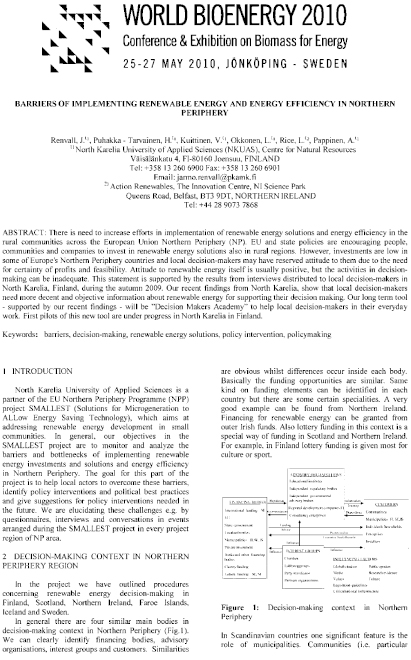
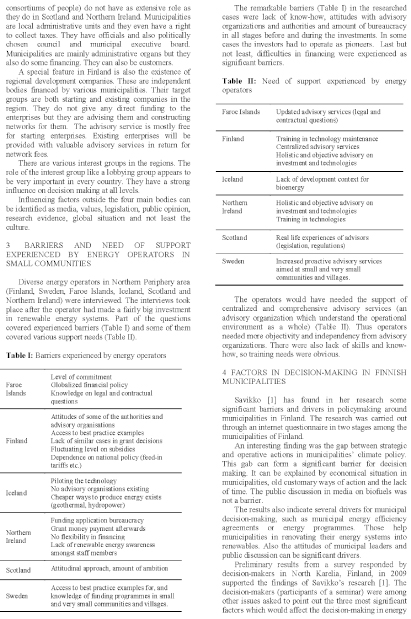
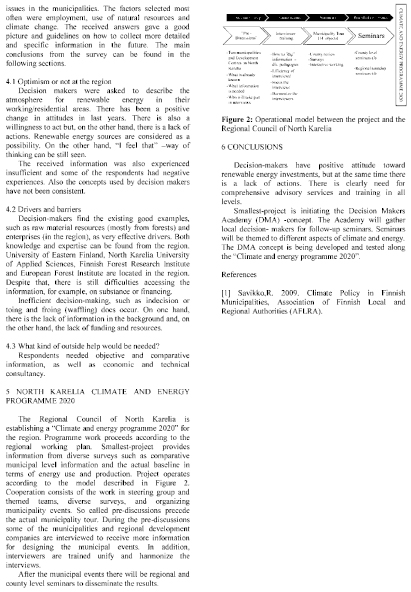
11.4. Appendix 4: Funding in Scotland
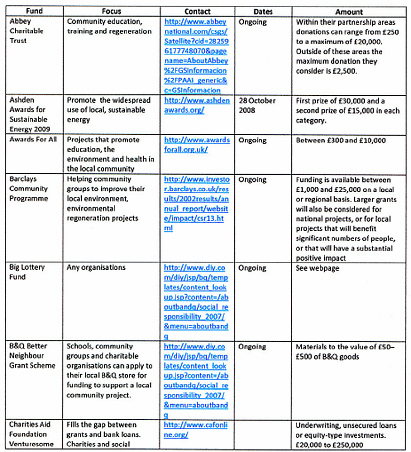
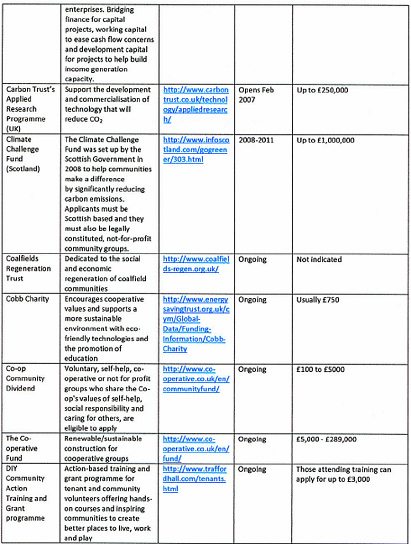
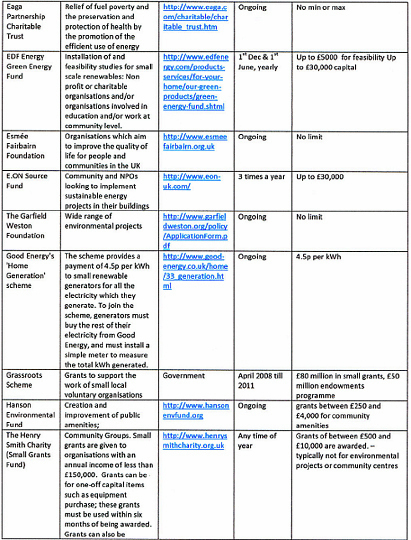
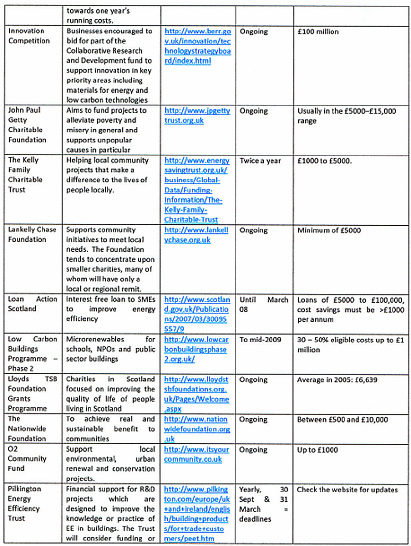
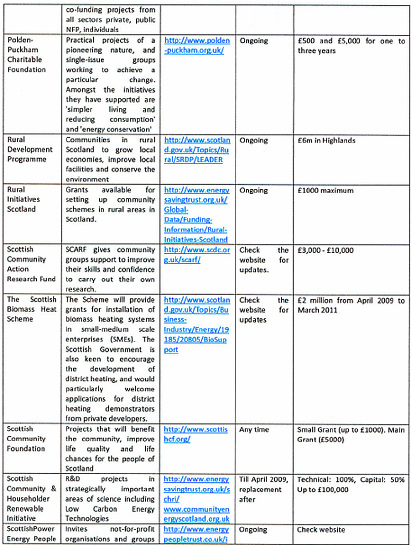
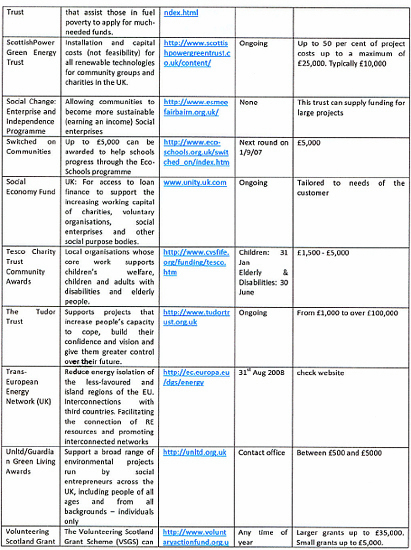

11.5. Appendix 5: Renewable Energy Grants/Assistance Available Within the West Region
The most up to date source of funding information is outlined in the SEAI website: http://www.seai.ie/Grants
Greener Homes Scheme
The Third phase of the Greener Homes Scheme is now available and provides assistance to homeowners who intend to purchase a new renewable energy heating system for existing homes.
You may download the form and guide from the SEI website http://www.sei.ie/greenerhomes
CHP
The SEAI CHP deployment program has ceased.
There is still some funding available for biomass CHP/ Anaerobic Digestion CHP.
http://www.sei.ie/Grants/Biomass_CHP_Anaerobic_Digestion_CHP_Call_for_Proposals/
Micro and Small Scale Generation Pilot
SEI is carrying out a pilot trial of around 50 micro and small scale generation installations throughout 2009. The pilot will provide support towards the installation costs of generators and will investigate a range of technical and regulatory issues surrounding the installation and operation of small and micro scale generation technologies. Finding from the pilot will provide information for parallel work in the micro and small scale generation programme.
ReHeat Deployment Programme
This SEAI funded programme provides assistance for the deployment of renewable heating systems in industrial, commercial, public and community premises in Ireland. The programme is an expansion of the previous Bioheat Boiler Deployment Programme which supported woodchip or pellet boilers but has now expanded to include solar panels and heat pumps under the newly launched scheme.
Further information from: www.seai.ie/grants/renewable_heat_deployment_programme/
Energy efficiency retrofit fund for public and business sector
SEAI currently have an open for project proposals for funding.
Further information from: www.seai.ie/grants/retrofit/
Ocean Energy Development Unit.
SEAI offers funding to stimulate the development and deployment of ocean energy devices and systems.
Further information from: www.seai.ie/grants/oceanenergy/
Forestry Assistance
The Afforestation Grant and Premium Scheme, the Forest Environment Protection Scheme (FEPS) and the Native Woodland (Establishment) Scheme are available from the Forest Service of the Department of Agriculture, Fisheries & Food. The grants available in these schemes generally covers all of the costs associated with the establishment and early management of a forest. The rate of afforestation grant and annual forest premium available under these schemes depends on the quality of the land, the type of tree species it can grow and the area of land planted. Download afforestation grant and premium rates (261 KB).
The First Instalment of the grant (75%) is payable after the planting stage and includes operations such as ground preparation, drainage, fencing and planting.
The Second Instalment (the remaining 25% of the grant) is paid four years after planting, once the trees have become fully established and are free-growing . This payment covers maintenance works that will often be required (e.g. vegetation management , the replacement of failures).
Annual forest premium payments are payable for a period of 20 years in the case of farmers, or 15 years for non-farmers.
Applications are submitted to the Forest Service (Department of Agriculture, Fisheries and Food), and approval is issued following assessment. The first instalment is then paid after planting, subject to adherence to scheme conditions and various environmental guidelines.
www.teagasc.ie/forestry/financial_info
Bio-Energy
Bio-Energy Scheme for Willow and Miscanthus
The objective of the Scheme is to provide establishment grants to farmers to grow willow and miscanthus to produce biomass suitable for use as a renewable source of energy.
The Scheme shall come into operation on 5th of February 2010 for a period to be determined by the Minister.
Aid Payable under the Scheme
The aid consists of a once off capital grant based on a percentage of approved establishment costs. Approved costs will be grant aided up to 50% subject to a maximum grant of €1,300 per hectare. The maximum grant per hectare may be subject to review at any stage over the period of the Scheme.
The grant available for ground preparation operations and vegetation management will be calculated in accordance with the following Standard Costings.
| Type of operation | Grant rate per hectare (Miscanthus) | Grant rate per hectare (Willow) |
| Plough | €75 | €75 |
| Cultivate | €74 | €74 |
| Rolling | €18 | €18 |
| Weed control | €120 | €138 |
| Control of insect pests | €40 | €40 |
Further details from www.agriculture.gov.ie
Memo from OFMDFM Clerk
Committee for the Office of First Minister and deputy First Minister
Room 404
Parliament Buildings
Tel: +44 (0)28 9052 1448
Fax: +44 (0)28 9052 1083
From: Cathie White
Clerk to the Committee for the
Office of the First Minister and deputy First Minister
Date: 28 July 2010
To: Jim McManus
Clerk to the Committee for Enterprise, Trade and Investment
Subject: Renewable Energy Inquiry
At its meeting on 27 July 2010, the Committee for the Office of the First Minister and deputy First Minister agreed to forward the attached response from the Department regarding the Renewable Energy Inquiry to the Committee for Enterprise, Trade and Investment for your information.
Cathie White
Committee Clerk
Response from OFMDFM No.1
Cathie White
Clerk
Committee for OFMDFM
Room 416, Parliament Buildings
Ballymiscaw, Stormont
BELFAST BT4 3XX 23 July 2010
Dear Cathie
Renewable Energy Inquiry
Thank you for your letter dated 1 July 2010.
The Committee for Enterprise, Trade and Investment's inquiry in to renewable energy is welcomed, it is a positive step towards addressing the barriers that inhibit the contribution of renewable energy to our economy.
In respect of current mechanisms at national, regional and local level to support and assist renewable energy production, we would suggest that there is a requirement that energy policy recognises the emergence of a sustainable development policy environment – expressed in the new Sustainable Development Strategy – which supports and promotes renewable energy as a valuable element of a wider energy mix and as a positive contributory factor in adapting and mitigating to the effects of climate change.
Within this context, the Executive has endorsed the objectives of increasing the proportion of energy derived from renewable sources and reducing greenhouse gas emissions. There is potential for actions to support the development of renewable energy to also help delivery of the broader social, environmental and economic objectives of the Sustainable Development Implementation Plan. DETI should consider the most effective means of multiplying the benefits to business and citizen as part of any renewable energy deployment plans.
In terms of assessing the appropriateness of current mechanisms to develop and grow both local renewable energy markets and export markets, it is essential to recognise the importance of developing robust supply chains that bring and enhance opportunities to develop the low-carbon economy here. Connectivity between raw material producers (such as biomass from state owned forests in Northern Ireland or animal waste products from food processors) and end users should be encouraged, streamlined and, if necessary, incentivised.
In examining the support and assistance available to SMEs, in the renewable energy sector, to grow and develop their businesses, the Committee should consider how incentivisation to use 'clean energy' can stimulate consumption and therefore increase market demand for goods and services from SMEs, in the renewable energy sector. Examples for consideration could include opportunities for 'clean energy cash-back' schemes for individuals and businesses who use renewables derived (or low carbon) sources to generate heat or electricity.
The importance of renewables, in contributing to the sustainability agenda, must be highlighted and we are supportive of this inquiry which will examine the barriers that restrict renewable energy development and production here. We look forward to seeing the resultant outcomes from this inquiry.
Yours sincerely
pp Peter McDowell
GAIL MCKIBBIN
Departmental Assembly Liaison Officer
Response from OFMDFM No.2
Mr Jim McManus
Clerk
Committee for Enterprise, Trade and Investment
Room 424
Parliament Buildings
Ballymiscaw
Stormont
Belfast BT4 3XX 23 December 2010
Dear Jim
Your letter of 16 December sought a response to two queries on prioritisation of public inquiries which has been raised during the Committee's Renewable Energy Inquiry.
The Planning Appeals Commission (PAC) is a Tribunal NDPB, which to preserve its independence, is sponsored by OFMDFM but operates at arms length from government. It exercises its functions independently and free from influence by the Department or any other body.
Operational responsibility for the PAC rests with the Chief Commissioner who is responsible for the deployment of resources to address the prevailing workload including the prioritisation of public inquiries. OFMDFM has no locus in relation to PAC's workload scheduling or decision-making. Your query should therefore be directed to the Chief Commissioner, Maire Campbell, at Planning Appeals Commission, Park House, 87 -91 Great Victoria Street, Belfast, BT2 7AG.
Yours sincerely
GAIL MCKIBBIN
Departmental Assembly Liaison Officer
Response from Omagh Council
Renewable Energy
Omagh District Council has considered your letter in respect of the forthcoming Renewable Energy Inquiry and the invitation to submit written evidence. The views/evidence of the members are summarised below. The Council is not in a position to express views in relation to many of the issues specified in the terms of reference and consequently it has not been possible to structure the submission addressing these in turn.
1. The security and affordability of energy supplies in Europe is of growing concern. Gas and oil supplies have been compromised by political unrest contributing to oil supplies peaking at $147 a barrel in June 2008 with a prediction by the International Energy Agency that the cost will rise to $200 per barrel by 2030.
2. National and international developments are increasingly moving the focus of energy policy worldwide towards tackling the threat of energy change.
3. Northern Ireland's reliance on fossil fuels means that we are particularly susceptible to price fluctuations and security of supply issues with 99% of our energy being imported.
4. The burning of coal, gas and oil accounts for 75% of Northern Ireland's greenhouse gas emissions giving a strong imperative for increased energy generation from low carbon renewables but despite having one of the best renewable energy resources in Europe only 6% of our electricity is currently produced from renewable sources.
5. Northern Ireland needs to think strategically about its energy policy in order to ensure continuity of supply at an affordable price and in a form which does minimal environmental damage. To do this energy and climate policies should be coupled with Northern Ireland adopting the targets within the EU Climate and Energy Package and the UK Climate Change Act at regional level.
6. A Northern Ireland Climate Bill with a target to reduce our emissions by 80% (compared to 1990 level) and a strategic energy frame work target of sourcing 15% of all of our energy from renewable sources by 2020 will act as the driving sources towards a low carbon society.
7. Not only do we need to alter out energy mix in favour of renewables, but we also need to ensure that we maximise energy conservation. It is important that existing housing stocks maximise their insulation levels, that new housing should be zero carbon from 2016 and micro generation should be actively encouraged with realistic financial incentives.
8. The potential for job creation within the renewables industry should be maximised (Action Renewables has estimated 6000 short term and 400 long term jobs could be created within NI).
9. Transport has been responsible for 30% of the region's CO2 emissions and to reduce this renewable energy must feature more heavily in all transport plans.
10. Renewable energy is available in many forms including wind, wave and solar emissions and includes three critical components:-
- the development of the technologies,
- the mechanisms for their use in society and
- cost at all stages.
These are key elements in attempting to increase the availability and uptake of renewables.
11. It is crucial that the support and assistance offered in Northern Ireland is at least equal to the best that the other EU member states can offer, particularly for small to medium enterprises both in the development and supply of renewable technologies. Financial incentives such as final purchaser grant aid must be available at a level to ensure that renewables are directly competitive with the fossil fuel technologies.
12. Wind turbine technology is an important element in renewable energy but to date its relative success over other technologies has meant that wind farms have reached saturation levels in some areas in the west of the province, requiring a reappraisal of planning policy.
Response from Phoenix
197 Airport Road West
Belfast BT3 9ED
Jim McManus, Committee Clerk
Committee for Enterprise, Trade and Investment
Room 424, Parliament Buildings
Ballymiscaw, Stormont
BELFAST
BT4 3XX 4th August 2010
Dear Jim
Inquiry into Renewable Energy for Northern Ireland
Thank you for providing the Phoenix group of companies with this opportunity to respond to the Committee's inquiry into the development of renewable energy production and its associated contribution to the Northern Ireland economy.
Phoenix was established in 1996 to bring natural gas to Northern Ireland, where there was previously no natural gas distribution network. Since 1996 local, national and international partnerships have delivered an investment of over £510 million into the Northern Ireland economy and the wider natural gas industry now provides employment to over 3,000 people. Phoenix continues to invest in infrastructure that currently has over 130,000 domestic and business customers connected, and continues to grow at around 8,000 new customers each year.
Phoenix has grown as the natural gas network has expanded and there are now four trading companies within the wider group:
1. Phoenix Natural Gas Ltd is the largest gas distribution business in Northern Ireland, being the owner and operator of the licence for the distribution network in the Greater Belfast Area and Larne. The distribution business is responsible for the development of the pipeline network and also for providing a 24/7 operational and transportation service platform to gas suppliers under the rules of the company's network code.
2. Phoenix Supply Ltd is the market leader in gas supply in Northern Ireland, providing natural gas to customers from the Phoenix Natural Gas distribution network. The Supply division competes directly with other gas suppliers in its licence area, which mirrors the Group's distribution business licence area in Greater Belfast and Larne. Currently Phoenix supplies around 130,000 domestic and business customers and provides bespoke natural gas purchasing solutions for industrial and commercial customers. In addition, Phoenix Supply trades around 110 million therms of natural gas on the wholesale market and provides billing services for its expanding customer base from its offices in Belfast. The business is regulated under licence by the Northern Ireland Authority for Utility Regulation.
3. During 2008, Phoenix Energy Ltd was incorporated in order to supply natural gas to customers within the Republic of Ireland, expanding the service offering of Phoenix Supply Ltd across the island of Ireland. Phoenix Energy was awarded a licence to supply natural gas in December 2008 and signed up its first customers during 2009. The company has been hugely successful and has penetrated sections of the Republic of Ireland gas market which have not benefited from competition to date. The business is regulated under licence by the Commission for Energy Regulation in Dublin.
4. Phoenix Energy Services Ltd is a specialist provider of downstream services into the Northern Ireland energy market, Energy Services' remit includes the provision of a 24/7 emergency response to the Group's distribution business, together with metering and meter reading services across the natural gas industry in Greater Belfast and Larne.
Over the last 14 years Phoenix has gained significant experience of establishing a new energy sector for Northern Ireland and a supporting market. I therefore hope that you will find our contribution to the call for evidence both informative and useful. Phoenix has successfully demonstrated how to introduce a new fuel and supporting technology to Northern Ireland and should the Committee consider the success of Phoenix relevant to its aspirations for the renewable sector, please do not hesitate to contact me if you require any further support or if you wish to discuss any of the issues further.
We eagerly await the outcome of this inquiry as we do the conclusions and recommendations of the Gas to the West Study undertaken by the Department. These findings will establish the way forward for energy industry development in Northern Ireland.
Yours sincerely,
Alastair
Alastair Pollock
Phoenix Natural Gas
Business Development Director
| Inquiry into Renewable Energy for Northern Ireland | |
| To: | The Northern Ireland Assembly Committee for Enterprise, Trade and Investment |
| From: | Phoenix |
| Date: | 4th August 2010 |
| Subject: | Written evidence submitted by Phoenix to the to the Committee's inquiry into the development of renewable energy production and its associated contribution to the Northern Ireland economy |
Summary
1. Many homes and businesses have been enjoying the benefits of a low carbon economy following the introduction of natural gas to Northern Ireland in 1996.
2. Northern Ireland should follow the example set by the natural gas industry and develop a low carbon economy outside the existing natural gas areas by allowing the renewable energy industry to flourish, like the natural gas industry, on the back of private investment and strict regulatory controls.
3. Taxpayers should not provide financial support to the renewable energy industry and if this option is taken then it should only be on the basis that it is strictly regulated to ensure transparency of costs and full accountability.
4. Invest Northern Ireland may wish to consider a scheme to support the most commercial proposals and if this option is considered, any campaign should be managed within its current budget.
5. The current cost of installing renewable technologies in existing homes is prohibitive.
6. The Committee needs to consider the appropriateness and reliability of each of the renewable technologies currently available by seeking evidence from other projects e.g. the Woodbrook Biomass Community Heating Scheme in Belfast built by The Carvill Group, or the Eco Homes within the Poundbury development inspired by the Prince of Wales along with evidence on the cost effectiveness of renewable technologies installed in Northern Ireland over the last decade.
Introduction
7. Before assessing the development of renewable energy in Northern Ireland, it is important to recognise the impact already made by the natural gas energy industry to help Northern Ireland towards its target of reducing carbon dioxide levels by 30% below 1990 levels by 2025[1].
8. We estimate that consumers in the Phoenix Natural Gas ("PNG") area have contributed to reductions in carbon dioxide (CO2) emissions of some 2.4 million tonnes to the end of 2009 and continue to contribute to CO2 reductions of around 250,000 tonnes each year. It could be argued that the introduction of natural gas to Northern Ireland delivered Northern Ireland's answer to a low carbon economy 14 years ago.
9. Natural gas produces around 25% less CO2 than oil[2] and we estimate that a typical household converting to a modern high efficiency central heating system from older oil central heating systems could reduce its carbon footprint by more than 50%[3].
10. Only 12% of homes in Northern Ireland[4] (but almost 50% in PNG's Greater Belfast licensed area where natural gas is available) are using natural gas compared to over 80% in England[5]. This suggests that a high conversion rate is possible as Northern Ireland's natural gas networks develop to ensure that CO2 savings are maximised.
11. Many of the renewable technologies still require an efficient heating system. Any additional grant funding should be targeted at homes where an efficient heating system has been installed.
12. As it stands therefore, Northern Ireland already has a proven and reliable mechanism to deliver a low carbon economy in existing natural gas areas. The question for the Committee is what should be done to replicate this in areas where natural gas is not available?
Development of the natural gas industry in Northern Ireland
13. The introduction of natural gas to Northern Ireland in 1996 was the result of private sector funding and has allowed the natural gas industry to flourish in a environment controlled by legislation such as the Gas (Northern Ireland) Order 1996 and the Energy (Northern Ireland) Order 2003 and supervised by the licensing regime set in place for natural gas utilities by the Northern Ireland Authority for Utility Regulation and the Department.
14. Phoenix does not believe that taxpayers should provide financial support to the renewable energy industry and if this option is taken then it should only be on the basis that it is strictly regulated to ensure full accountability.
15. Invest Northern Ireland may wish to consider a scheme to support the most commercial proposals and if this option is considered, any campaign should be managed within its current budget.
16. Phoenix believes that Northern Ireland should follow the example set by the natural gas industry and develop a low carbon economy outside the existing natural gas areas by allowing the renewable energy industry to flourish, like the natural gas industry, on the back of private investment and strict regulatory controls.
17. For example, current arrangements in the Phoenix Natural Gas area determined by the Utility Regulator for SMEs at the time of its last price control review enable the company to offer SMEs an allowance to help with the cost of connection to the natural gas network. Similar arrangements are in place in other natural gas areas in Northern Ireland.
18. Similarly arrangements in the Phoenix Natural Gas area determined by the Utility Regulator at the time of its last price control review allow the company to offer households an allowance to help with the cost of connection to the natural gas network and indeed incentivise customers to make the switch to a lower carbon fuel. Current incentives are around £200 and again similar, if not enhanced, arrangements are in place in other natural gas areas in Northern Ireland.
19. This proven model for natural gas should be replicated outside the existing natural gas areas and the Committee needs to consider similar levels of private funding to allow the renewable energy industry to develop in the same manner as the natural gas industry.
Conclusions
20. We believe that the question of developing renewable technologies for Northern Ireland depends on whether it is being considered on a macro or a micro level.
21. On a macro level, the Northern Ireland Executive Programme for Government sets challenging targets to reduce CO2 emissions by 30% below 1990 levels by 2025. Natural gas is making its contribution and on a strategic level, renewable technologies would reduce electricity consumption and further help Northern Ireland towards achieving this target.
22. It has been suggested that fuel poverty levels in Northern Ireland are currently considerably higher than the 34% quoted in the last House Condition Survey conducted in 2006.[6] On a micro level therefore the Committee needs to carefully consider cost effectiveness, appropriateness and reliability of the renewable technologies currently available as part of its inquiry.
23. The current cost of installing renewable technologies in existing homes is prohibitive. It is unclear at what point they may become economic to install without additional funding.
24. Advances have been made in the development of wind technologies, but many renewable technologies such as solar, biomass and tidal remain arguably relatively untested. In our opinion Northern Ireland does not have the scale to test some of these developing technologies and should await the findings of those investing heavily in such technologies and of sufficient scale to determine the reliability of the products before Northern Ireland makes a decision on their suitability for delivering a low carbon economy for those who do not have access to a natural gas network in Northern Ireland.
25. We recommend that the Committee considers evidence from other projects e.g. the Eco Homes within the Poundbury development inspired by the Prince of Wales.
26. The Committee should also consider obtaining evidence in relation to renewable energy technologies in Northern Ireland over the last decade, where a rich quantity of information, research, cost effectiveness analysis and rationale must already be available e.g.
- Renewable energy technologies considered by local councils and by local Education and Library Boards e.g. biomass heating
- Low carbon construction projects undertaken by Sky Developments
- Woodbrook Biomass Community Heating Scheme built by The Carvill Group etc.
27. We also recommend that the Committee considers evidence from the Energy Saving Trust in relation to case studies and information on the cost effectiveness of projects such as domestic CHP, solar PV panels, ground source heat pumps, solar water heating etc.
28. Extraction of gas from landfill sites is being utilised in Great Britain and here in Belfast and is another area which the Committee may consider as part of its inquiry.
[1] The first Sustainable Development Strategy for Northern Ireland
[2] DEFRA conversion factors for natural gas and oil
[3] Using energy savings calculated by the Energy Saving Trust based on data as modelled by the Building Research Establishment
[4] 2006 Northern Ireland House Condition Survey
[5] English House Condition Survey data for 2007
[6] UK FUEL POVERTY MONITOR, Energy Action Scotland , National Energy Action (NEA), NEA Cymru and NEA Northern Ireland, February 2010
Response from Renewable Energy Systems LTD
| Northern Ireland Assembly Committee for Enterprise, Trade & Investment Inquiry into Barriers to the Development of Renewable Energy Production and its Associated contribution to the Northern Ireland Economy | ||||
| Section 1 Company Details | ||||
| Company Name | Telephone Number | |||
| Renewable Energy Systems Ltd (RES) | 028 2826 3320 | |||
| Company Address | Company Type (Include one or more X) | |||
| Unit C1 & C2 Willowbank Business Park Wilowbank Road Millbrook Larne BT40 2SF |
Supply | Install | ||
| Design | Manufacture | |||
| Maintenance | R&D | |||
| Other (Please Specify) | ||||
Please provide some background information on the company
RES UK and Ireland Ltd is part of the RES group of companies. RES has been developing wind projects on the island of Ireland since the early 1990s, having developed 14 operating wind farms and 1 single turbine in Northern Ireland and 4 operating wind farms in the Republic of Ireland, totalling over 241MW. RES currently owns or operates over 134MW of wind capacity across Ireland. In addition RES has a further 35MW in construction or with planning consent in Northern Ireland.
Section 2 Government Strategy for Renewable Energy
2.1 Please provide information on your level of awareness of current Government Strategy for Renewable Energy and how that strategy assists the renewable energy sector
- NIROCs
- Strategic Energy Framework 2004 (Includes target of 12% electricity from renewable sources by 2010)
- draft Strategic Energy Framework 2010 (Proposes target of 40% electricity from renewables sources by 2020)
- Offshore renewable SEA
- Onshore grid SEA
- Planning Policy 18
- Other supporting policy e.g. "First Steps towards Sustainability – A sustainable development strategy for Northern Ireland" (2006)
2.2 Please provide information on any Government support that your company has received in the past that is specifically related to renewable energy
RES currently receives government support for a number of its operating wind farms under the NI NFFO and NIRO mechanisms.
2.3 Please provide information on any Government support that your company has applied for or is planning to apply for in the future that is specifically related to renewable energy
N/A
2.4 Please provide information on the barriers within Government to developing the renewable energy sector in Northern Ireland
- PPS18 and draft Supplementary Planning Guidelines. Uncertainty still exists around the final form of the Supplementary Planning Guidance and when this document will finally be published. In relation to PPS 18 they are a number of topics contained within the document which, without clarification, could lead to delays in project passing through the planning system.
- Lack of published grid infrastructure development plan, and delays that will be caused by the fact that all new major grid infrastructure must be publically consulted on. This will delay planning submissions for new lines to connect wind farms.
- Delays in the cluster charging decision which was consulted on earlier in the year may significantly delayed the construction of consented wind farms as many developers will be unable to finance projects when they do not know how much their grid connection will cost.
- Plans for a four-fold increase in business rates for wind farms.
2.5 Please provide suggestions on how Government can better support the renewable energy sector in the future in order to grow and develop the sector (suggestions should be specific to the renewable energy sector)
Onshore wind
- planning policy and guidance which facilitate the delivery of the draft SEF targets
- consistent application of planning policy by operational planners
- timely planning decisions
- grid development policy and roadmap
- public messaging regarding the importance of RE and the need to develop cost effective grid infrastructure
- development of generation on the public estate e.g. forestry land.
Marine Renewables
- grid development policy
- marine planning reform
- need for linkage with industry and investment for infrastructure
- viable levels of capital / operational support
Section 3 Government Strategy for Economic Development and its Application to the Renewable Energy Sector
3.1 Please provide information on your level of awareness of current Government Strategy for Economic Development and how that strategy assists businesses
N/A
3.2 Please provide details of any Government support for economic development (at any level) that your company has had in the past
N/A
3.3 Please provide information on any Government support for economic development that your company has applied for or is planning to apply for in the future
N/A
3.4 Please provide information on the barriers within Government to developing the indigenous businesses in Northern Ireland
No comment.
3.5 Please provide suggestions on how Government can better support indigenous SME businesses in the future in order to assist them to grow and development
No comment.
Section 4 Communication, Sharing Information, Raising Awareness
4.1 How well do you think Government departments communicate and share information with each other in relation to renewable energy and how can this be improved?
- Recognise that Renewable Energy is seen to be a cross cutting exercise and that Departments are working to improve co-ordination with regard to policy development and implementation.
- All Departments should have common objective of working to deliver SEF once finally published.
- Barriers to delivery need to be overcome e.g. policy interpretation.
- All Government departments must be realistic on how the targets set up in the draft SEF will be achieved i.e. onshore wind will deliver the most significant proportion of Renewable Energy by 2020.
4.2 How well do you think the Government departments and local Government communicate and share information with each other in relation to renewable energy and how can this be improved?
- Key issue going forward will be local government buy in to grid infrastructure development policy. It is not clear whether this type of issue is communicated between Government departments and local Government.
4.3 How well do you think the Government departments and the EU communicate and share information with each other in relation to renewable energy and how can this be improved?
No comment.
4.4 How well do you think the Government departments and businesses communicate and share information with each other in relation to renewable energy and how can this be improved?
No comment.
4.5 How well do you think the Government departments and other regions and EU Member States communicate and share information with each other in relation to renewable energy and how can this be improved?
No comment.
4.6 How well do you think businesses in the renewable energy sector communicate and share information with each other in relation to renewable energy and how can this be improved?
In recent times IWEA, Renewable UK and most of the key wind developers in Northern Ireland have formed a joint group called Northern Ireland Renewable Industry Group (NIRIG).
4.7 How well do you think Government departments communicate and share information with the public in relation to renewable energy and how can this be improved?
- Previous effective awareness raising campaigns (e.g. those delivered by Action Renewables) appear to have ceased and should be revived, in consultation with industry.
- Recent government funded communication appears to focus on energy efficiency
- Key messages that will be required going forward are:
- Renewable Energy will improve security of supply, economic competitiveness and will reduce carbon consumption.
- Grid infrastructure will be needed to maintain a stable electricity system (e.g. avoidance of power cuts) and to make the most from clean, indigenous resources.
- Overhead lines are the most cost effective method of developing transmission infrastructure and will be a necessary part of delivering these benefits.
4.8 How well do you think renewable energy businesses communicate and share information with the public in relation to renewable energy and how can this be improved?
No comment.
4.9 What other support organisations are you aware of that exist to support the renewable energy sector?
- Action Renewables
- Carbon Trust (although the focus tends to be largely on energy efficiency)
- Energy Saving Trust
- Northern Ireland Energy Agency
- Invest NI
- Some FE Colleges
4.10 How well do you think Government departments and renewable energy support organisations communicate and share information with each other in relation to renewable energy and how can this be improved?
No comment.
4.11 How well do you think renewable energy businesses and support organisations communicate and share information with each other in relation to renewable energy and how can this be improved?
No comment.
4.12 How well do you think renewable energy support organisations communicate and share information with the public in relation to renewable energy and how can this be improved?
No comment.
Section 5 Additional Information
5.1 Please provide any additional information which you believe will be of assistance to the Committee during the course of the Inquiry
Informal comments included in research paper NIAR248-10 indicate that this inquiry does not intend to focus on the importance of onshore wind however, it is the belief of RES that Onshore wind is crucial to the delivery of SEF targets. RES feel strongly that the Enquiry should include onshore wind and other large scale renewables, and investigate fully the many challenges which threaten to prevent the continued deployment of onshore wind and
other renewables within Northern Ireland.
Onshore wind and other large scale renewables will bring the following to Northern Ireland;
- security of supply
- reduced energy prices
- rates to both Government and local authorities
- economic competitiveness
- opportunity for export
- community benefit
- contribution to NI economy through construction and operation e.g. construction jobs, 30% of capital investment spent within NI
- carbon reduction
Section 6 Contact Details
All written responses should be sent to:
Jim McManus
Committee Clerk
Room 424, Parliament Buildings, Belfast BT4 3XX
Tel: 028 9052 1574 · Fax. 028 9052 1355 · Email: committee.eti@niassembly.gov.uk
Response from RSPB
ETI Committee inquiry: barriers to renewable energy development
RSPB Northern Ireland consultation response, August 2010
Summary
a. The RSPB, the largest wildlife charity in Europe, views climate change as the biggest long-term threat to global biodiversity.
b. The RSPB's aim is to support the deployment of renewable energy and to ensure that this is achieved with minimal impact on birds and wildlife. Renewable energy must not be at the price of unacceptable damage to biodiversity, especially those sites, habitats and species protected by the European Birds and Habitats Directives and by national legislation.
c. Renewable energy development must also comply with other Directives, such as the Water Framework Directive.
d. This report considered barriers and opportunities for different types of renewable energy: onshore wind, hydro-electric power, marine renewables (wave, tidal and offshore wind), bioenergy and micro-renewables (small scale generation).
e. We recommend that:
- A strategic approach to renewable energy is taken through the development and adoption of spatial plans for different renewable energy technologies that direct development towards where it is most environmentally suitable, reducing conflict and accelerating deployment.
- There should be clear responsibility for licensing to make it easier to understand how, when and by whom developments will be considered, consented and licensed.
- More research is needed into the environmental effects of some technologies, particularly wave and tidal technologies and bioenergy.
Introduction
1. The RSPB welcomes this opportunity to respond to the Northern Ireland Assembly Committee for Enterprise Trade and Investment (ETI) inquiry into renewable energy in Northern Ireland (NI).
2. The RSPB is the largest wildlife conservation organisation within Europe, with over a million members in the UK, 11,000 of whom live in Northern Ireland. As an organisation it stands not just for birdlife but for the conservation of the whole environment. The RSPB has a powerful presence across the UK, running nature reserves and people-focused projects in many places. Our professional staff engage in planning and wider development policy, strategy and delivery, at the international, UK, devolved administration, regional and national levels.
3. The RSPB is the UK partner of BirdLife International, a global partnership of national conservation organisations with partners in over 100 countries. Renewable energy deployment is becoming an ever bigger issue for our partners across the world, and particularly in Europe where we are working with our partners to adopt a common approach to renewable energy that is based on the principles of supporting its deployment and advocating a strategic, spatial approach that minimises conflict and directs development towards the most environmentally appropriate sites.
4. We consider that human-induced climate change poses the biggest long-term threat to global biodiversity. Up to one third of land-based species on earth could be committed to extinction by 2050 if we do not act to address this problem. To avoid catastrophe, the anthropogenic greenhouse gas emissions that cause climate change need to be cut hard and rapidly, to ensure that global emissions peak within the next ten years and then decline steeply. We therefore support policies and measures that achieve this end. This will require a massive reduction in energy use; action to curb the growth in aviation emissions; and a rapid switch from high to low carbon sources of energy.
5. It is important that we do not see cutting the carbon intensity of the production of energy in isolation. We need to reduce our carbon emissions and dependence on fossil fuels because of the dangers in the global environment in the future, yet some processes may reduce carbon emissions at the cost of unacceptable damage elsewhere.. We must evaluate schemes for their total impact, from carbon emissions to direct and indirect impacts on air, water and biodiversity.
6. RSPB NI has made these points, amongst others, in our responses to Department of Enterprise, Trade and Investment (DETI) consultations, for example:
- The All-island Energy Market Sustainability in Energy Supplies: A '2020 Vision' for Renewable Energy;
- The NI Renewables Obligation (NIRO) consultations (2004, 2008, current 2010);
- The Strategic Energy Framework 2009;
- The Bio-Energy Action Plan 2009; and
- The strategic action plans for off-shore and on-shore renewable energy and grid connections, with accompanying Strategic Environmental Assessments (SEA) 2010.
Structure of this response
7. Our response concentrates on two items from the ETI inquiry terms of reference:
- Consider the current mechanisms at national, regional and local level to support and assist renewable energy production
- Assess the appropriateness of current mechanisms to develop and grow both local renewable energy markets and export markets
8. We consider the barriers to renewable energy development in Northern Ireland by reporting on the mechanisms currently in place for different types of renewable energy, and offer our assessment of where there are gaps in provision and opportunities for change.
9. We do not hold particular expertise on SMEs, so we do not comment on those items. The RSPB does, however, work closely with other BirdLife partners around the world on climate change and energy issues. We provide some references to that work, including publications on examples from elsewhere in the EU, in the reference section at the end of our response.
Onshore wind
Background
10. Over the last eight years, RSPB NI has been consulted on over 150 proposed wind farm sites, either pre- or post-application. Not all of these progress through the planning system, depending on constraints which arise. For those that do, RSPB NI comments on the pre-application surveys and works with developers to ensure sustainable siting of wind farms, away from areas that will adversely affect protected sites, habitats and species. We have not objected to the vast majority of these applications as their potential impacts on birds and biodiversity were insignificant. We have, however, maintained outright objections in nine cases, primarily in relation to effects on breeding hen harriers, blanket bog or internationally or nationally designated wildlife sites. Of those, five were withdrawn, one refused, one approved with conditions and two are ongoing. The development of onshore wind has been driven by the industry, the availability of reliable technology, and incentives such as the NIRO. Location has been determined by grid connection, maximum wind speeds, landowner interest and avoiding Areas of Outstanding Natural Beauty (AONBs) where the presumption has been for no development.
Barriers and opportunities
11. RSPB NI was a member of the stakeholder group for Planning Policy Statement (PPS) 18, which sets out planning policy for renewable energy, and we support its adoption. Its application is currently limited by the lack of an accompanying supplementary planning guidance (SPG). There also remains a lack of spatial planning and strategic locational guidance, which we believe would provide certainty to the industry, planners and the public. We support the development of a Strategic Action Plan (SAP) for onshore renewable energy, including wind, subject to SEA and urge DETI to ensure this includes spatial planning. We believe it is possible to achieve onshore wind targets in Northern Ireland without resorting to development within our most important wildlife sites, designated under the European Birds and Habitats Directives (Natura 2000 sites). These remain subject to the strictest planning tests, and no wind farm has been permitted within a Special Protection Area (SPA) in the UK. The expense and time to progress wind farm proposals within SPAs, to date with no success, could be avoided with clear guidance from Government on acceptable and sustainable locations of wind farms.
12. Many wind farm developers are keen to 'put something back' and incorporate habitat management plans into their proposals. We advocate spatial planning as an opportunity for a strategic approach to renewables deployment as a means of building consensus and clarity over where wind developments would be most environmentally appropriate. This helps avoid conflict by directing developers towards these areas in the first place, and can accelerate deployment as a result.
13. This is an approach that has successfully been used in Germany, a country that is at the forefront of the European and Global renewable energy industry. The Federal Regional Planning Act, operating in parallel to the Federal Building Act, defines wind turbines as "privileged projects" in outlying areas, i.e. their development is generally permissible, where there are no conflicting public interests (including nature conservation). In order to avoid uncontrolled growth, however, Länder authorities have the opportunity to counter this general privilege by applying proactive locational planning. By delineating priority areas for wind farms in regional plans or delineating preference zones in land use plans, the authorities can define where it is and is not in the public interest to develop. Complementary areas, where wind farm development is to be restricted or excluded, are also determined by the Länder. They will judge, for example, whether a site protected for nature conservation should be defined as an exclusion or a restricted area. As a consequence, three distinct area classes are developed where onshore wind development is:
a. considered 'privileged' and proactively supported;
b. excluded; or
c. restricted.
14. Stakeholders considered this approach to have been fundamental in reducing conflicts between nature conservation and the development of wind energy projects in Germany, leading to a successful expansion of onshore wind.
15. Further information, including case studies of other spatial approaches to renewables, can be found in our report Positive planning for onshore wind[1].
Hydro-electric power (HEP)
16. RSPB NI is aware of an increasing number of proposals for low-head hydro-electric schemes. We do not object to the use of such schemes, but we want to ensure that projects do not have adverse environmental effects, for example by reducing flows in rivers, especially those afforded national or international protection as wildlife sites. We are concerned that there is currently inadequate communication between Water Management Unit and Natural Heritage within Northern Ireland Environment Agency (NIEA) to make sure that cumulative impacts on designated rivers are avoided. We are aware that the Ulster Angling Federation has made significant representation to both DETI and the Department of Environment (DOE) on this matter and we will continue to support their lobby through the Freshwater Task Force (FWTF). The Government must ensure that hydro-electric developments do not prejudice compliance with the Water Framework Directive (WFD), notably Article 4.7.
Marine renewables
Barriers
17. In this section we include tidal, wave and offshore wind technologies. This is an area for growth as technologies develop. Limitations have included the lack of information available for offshore sites (whether for engineering or environmental concerns), the lack of coordinated planning process (sites requiring a number of different licences), and uncertainty over seafloor jurisdictions (as for the Tunes Plateau offshore wind proposal).
Opportunities
18. We strongly support the offshore renewable energy SAP and associated SEA being developed by DETI, which will give greater security to industry, planners and the public. We were supportive of the SeaGen turbine installed in Strangford Lough, where work between statutory agencies, environmental non-government organisations (NGOs) and the developer resulted in a best practice example of liaison. The 'adaptive management' approach, of careful monitoring and contingency plans, allowed development to proceed in an environmentally sensitive area that could otherwise have been refused on the precautionary principle.
19. The lack of environmental data at sea is proving a hurdle for developers and planners. We advocate a coordinated approach. The amount of money currently spent by individual developers, statutory agencies, fishing interests, NGOs and so on, would be better combined to tackle together the joint problem. In a similar way, we have lobbied for a marine management organisation (MMO) under proposals for a Marine Bill in Northern Ireland, reflecting the position taken in Britain. A 'one-stop shop' for all marine licensing, with the relevant expertise available, would simplify application processes for industry and ensure that a holistic response to all development impacts was adopted.
Bioenergy
20. Significant inroads need to be made in the deployment of renewable heat if Northern Ireland is to meet its renewable energy target. Transport aside, 80% of total energy consumption is used in space heating, of which 60% is for domestic use[2]. At present over 70% of homes are heated by oil[3]. Bioenergy, particularly biomass, is a potential alternative to meet our heating requirements, for example through dedicated boilers and combined heat and power schemes (CHP).
21. As a principle, bioenergy from waste sources should be prioritised. Using waste wood and arboricultural arisings, as well as sewage sludge, animal and food wastes in anaerobic digestion is a win-win for the environment and climate change.
Barriers
22. One of the main barriers is well illustrated by the problems experienced with installation of biomass heat and power systems. For a developer to install such a system in a housing development, for example, would require a secure future source of suitably prepared fuel, typically wood chips. This needs a local farmer to have decided to grow a crop for this purpose and for someone to have installed the equipment to make and dry the pellets. Without a secure market for the product, it is unlikely that a farmer will grow the crop or install the processing equipment. Unless the crop is grown within c.25 miles of the plant it supplies, much of the advantage in carbon reduction is lost through increased emissions on transport. It takes careful, long-term management of all the processes to ensure an efficient outcome.
23. The concern with crops used for biomass schemes are those of management and the environment. Some schemes involve the growing of introduced crop species, e.g. Miscanthus or Eucalyptus, which do not provide good habitats for native species. Willow is preferred as a crop for these reasons, and because it grows best in the Northern Irish climate. However, it is vital that the expansion of the willow crop in Northern Ireland is not at the expense of environments already under threat, such as wet grassland or bogs.
24. Energy crops for bioenergy production will only be able to play a limited role in biomass supply in Northern Ireland given the limited land area available and the many needs we already have for that land. Energy crops can, if planted in the wrong place, have a detrimental impact on wildlife. If Government anticipates energy crops having anything other than a marginal role in the future we believe that a spatial review needs to take place to identify suitable areas for energy crop production. Furthermore, a policy of supporting a significant increase in energy crop plantations must be reviewed strategically to consider its impacts on other, competing uses of land, including food production, recreation and biodiversity.
25. As a result, if the NI Government intends to support a significant growth in bioenergy crop production in Northern Ireland, we need, as a minimum, a strategic, spatial strategy to identify environmentally suitable areas for growth, evidence of compatability with our wider needs from land, and considerably more Northern Ireland specific research into the positive and negative effects of novel bioenergy crops on biodiversity. Without this the RSPB could not support such a strategy.
Opportunities
26. DETI in its Bioenergy Plan for Northern Ireland (2009) outlined the main opportunities for the use of bioenergy. It made a valuable contribution by concentrating on agricultural waste, willow rotation crops and forestry waste as the best areas for development. Biomass schemes are best fitted to housing developments, small-scale industrial parks and larger units such as leisure centres. Solar and heat-pump schemes are very suitable for individual buildings, especially houses. The story of each of the smaller-scale technologies share common features. They present an opportunity to reduce dependence on fossil fuels, suitable for the de-centralisation appropriate to Northern Ireland's environment. They lie within the scope of SMEs but their use has expanded little or not at all over the last decade, hampered by problem of supply and demand. In addition, biomass schemes offer opportunities for farmers as producers, while the use of forestry waste would both help in the management of existing forests but also support the expansion of forestry land which is one of the Governments targets. There is significant potential for DETI to positively influence the new Forestry Act, which contains within the Clause 1 General Duty considerations towards the mitigation of climate change.
27. Given that space heating forms such a significant share of Northern Ireland's overall energy requirement, and that there are considerably more options for decarbonising electricity supply, we believe that the limited biomass resource available to North Ireland should be used in heat and combined heat and power schemes rather than solely for electricity generation. This will deliver considerably more greenhouse gas emission reductions as heat and CHP technologies have much higher energy conversion efficiencies than electricity, and will make it easier for NI to meet its renewable energy target[4]. This prioritisation should be reflected in all support mechanisms available to bioenergy schemes in Northern Ireland.
28. Bioenergy schemes are not carbon neutral and are associated with greenhouse gas emissions throughout their lifecycle. This includes, for example, biomass production, drying, processing and transport, as well as conversion into useful energy. The Environment Agency for England and Wales has developed a lifecycle greenhouse gas calculator, BEAT2, that is available freely[5]. This should be used by all bioenergy developers in Northern Ireland as a tool to minimise lifecycle emissions. Furthermore, we believe that larger generators should be required to meet a minimum lifecycle emission standard. The Department for Energy and Climate Change (DECC) is currently consulting on this for the UK, and we will be submitting detailed evidence.
Micro-renewables
29. RSPB NI has been supportive of the micro-generation permitted development rights (solar panels, biomass fuel storage, heat pump development and in-curtilage wind turbines). The consultation closed in January this year, and we await a revised General Development Order (GDO). It will be interesting to monitor how the permitted development changes impact the development, installation and use of small-scale renewable devices. Northern Ireland lags behind the rest of Europe in the use of solar power. In part this is probably because of a popular assumption that there is a lack of sunlight here; in fact, direct sunlight is not the basis for solar power, but solar radiation of which Northern Ireland has a good supply, although it will not be continuous. The suspension of the Reconnect scheme by DETI, which increased the installation of solar panels on a number of houses, sent the wrong message about the Government's regard for solar power as it did with wood-burning stoves.
Other incentives
30. The RSPB supports policies and measures that cut greenhouse gas emissions hard and rapidly and we have supported the NI Renewables Obligation since the idea was first mooted by the Northern Ireland administration.
31. We believe that an incentive scheme is also needed for renewable heat generation, including biomass heat, ground and air source heat pumps, and solar thermal. Large scale deployment of renewable heat technologies will be crucial to Northern Ireland delivering its fair share of the UK renewable energy target given the significance of space heating in terms of overall energy consumption in NI. The proposed UK Renewable Heat Incentive is therefore urgently needed and should not be delayed beyond April 2011.
32. However, we have long considered that Northern Ireland and the rest of the UK should deploy a wide range of renewable generation technologies, because a mix of technologies has benefits both in terms of the environment and of security and diversity of supply. Consequently, although we have consistently supported the NIRO, we were concerned that, as presently constituted, the NIRO will only bring on the nearest market technologies. We welcomed DETI's intention in 2008 to employ the NIRO to provide incentives for emerging technologies.
33. We agree with the UK Government that existing levels of support do not provide sufficient incentive for investors and potential developers. We also agree that, to bring on renewable energy technologies which are not currently cost-competitive, there needs to be a considerable degree of certainty about the availability of long-term support. We therefore welcomed DETI's proposal to technology band the NIRO, an approach that we have long advocated, although we differed in terms of how banding should be put into effect.
34. We are pleased to see another (current) consultation on the NIRO, to include emerging technologies such as anaerobic digestion, and will respond in due course.
Conclusions
35. There are common themes running through this report. It is clear that we need to tackle energy production to reduce carbon emissions, but we must whilst minimising the impact on biodiversity. We believe a strategic approach is needed: with a clear understanding of demand and targets, governments can use spatial planning to ensure that environmentally suitable land can be set aside for the different technologies. This is why we support the SAPs and associated SEAs for on- and offshore renewable energy.
36. Secondly, government must provide as much policy and market certainty to support new renewable technologies as possible. Current policies are not yet complete, and many different licensing and consenting authorities are involved, making a confusing picture for developers. Change would include, for example, agreed and coordinated licensing procedures at sea through an MMO, or completed supplementary planning guidance for windfarms.
37. Finally, further research is needed into environmental effects of some technologies, such as bioenergy and wave/tidal technologies, and there must be agreed and implemented monitoring protocols to assess impacts in the real world. This is where Northern Ireland must link up to research taking place elsewhere in the UK and Ireland, across Europe and elsewhere.
For further information contact: John Martin, Land Use Policy Officer john.martin@rspb.org.uk or Claire Ferry, Senior Conservation Officer claire.ferry@rspb.org.uk or telephone 028 9049 1547.
References and links
BirdLife Climate Change pages, including position statement http://www.birdlife.org/climate_change/
Environment Agency (2008) Carbon sink or carbon sinner? http://www.environment-agency.gov.uk/static/documents/Biomass__carbon_sink_or_carbon_sinner_summary_report.pdf
IEEP (2009) Positive planning for offshore wind. Report for the RSPB. http://www.rspb.org.uk/news/details.asp?id=tcm:9-213213
RSPB Climate Change pages http://www.rspb.org.uk/climate/
RSPB (2009) Power for the Planet - publication outlining how renewable energy technologies may affect wildlife and what measures can be taken to minimise impacts. http://www.rspb.org.uk/Images/Power_for_Planet_final111_tcm9-212789.pdf
RSPB, IPPR, WWF (2010) 80% Challenge – delivering a low-carbon UK - report showing that it is feasible to reduce the UK's emissions by 80% by 2050, and at costs that are not prohibitive. http://www.rspb.org.uk/Images/report_tcm9-176645.pdf
[1] IEEP (2009) http://www.rspb.org.uk/news/details.asp?id=tcm:9-213213
[2] A draft strategic energy framework for Northern Ireland, 2009, 3.7, 4.29
[3] A draft strategic energy framework for Northern Ireland, 2009, 1.2
[4] See Environment Agency (2008) Carbon sink or carbon sinner?
[5] Available from www.biomassenergycentre.org.uk/BEAT
Response from Rural Generation Ltd
| Northern Ireland Assembly Committee for Enterprise, Trade & Investment Inquiry into Barriers to the Development of Renewable Energy Production and its Associated contribution to the Northern Ireland Economy | ||||
| Section 1 Company Details | ||||
| Company Name | Telephone Number | |||
| Rural Generation Ltd | 028 7135 8215 | |||
| Company Address | Company Type (Include one or more X) | |||
| 63-65 Culmore Road Derry BT48 8JE |
Supply | X | Install | X |
| Design | X | Manufacture | ||
| Maintenance | X | R&D | X | |
| Other (Please Specify) | ||||
Please provide some background information on the company
Rural Generation Limited was established in 1996
It focuses on a range of products based on willow and other sources of biomass, such as bio-filtration of dirty water, bio-remediation of sewage sludge, marketing of chipped wood fuel and sales of biomass fuelled boilers.
Today, the Company operates in two separate but overlapping markets: renewable energy production and waste recycling.
Rural Generation has established a very strong reputation and profile in the market and operates commercially in the UK, Ireland, Europe and the US/Canada markets providing biomass renewable energy and environmental solutions.
The Company uses organic waste from our communities to grow a renewable fuel which in turn is used in turn to provide heat back to those communities. This business model is carbon negative, sustainable and economical against traditional fossil fuel solutions.
We are currently the islands biggest biomass fuel supplier with a provision of circa 10,000 tonnes of wood chip to the biomass fuel market both north and south.
In addition we have designed, installed and above all have working, over 120 biomass heat systems equating to 11MW of installed heat capacity.
Rural Generation is the only Company in Northern Ireland that has assigns renewable heat through energy service contracts.
The responses below are the ones that are most relevant to Rural Generation.
Section 2 Government Strategy for Renewable Energy
2.1 Please provide information on your level of awareness of current Government Strategy for Renewable Energy and how that strategy assists the renewable energy sector
We are very aware of the current Government strategy, working closely with DETI, Action Renewable, Carbon Trust and Invest Northern Ireland.
DETI is telling us they are committed to Renewable heat policy; however, they are still in consultation to decide on how best to support the sector. However, this delay is causing an adverse reaction from any potential consumer, as they are now waiting to see what the DETI program might be. This delay is having a negative effect on all commercial companies in the sector. This is worsened by the fact that the UK department of DETI have advanced their plan and gives a commitment that any system purchased after July 2009 in England Wales and Scotland will be eligible for any future support. It is inconceivable why DETI cannot do exactly the same thing rather than have such a negative effect on the NI sector by not making commitment publically.
Since the closure of LCBP Phase II program in May 2010, there is no support for renewable heat in Northern Ireland, and from April 2011 this support will be replaced in the UK by the RHI, however, we will have no support in NI.
2.2 Please provide information on any Government support that your company has received in the past that is specifically related to renewable energy
None.
2.3 Please provide information on any Government support that your company has applied for or is planning to apply for in the future that is specifically related to renewable energy
None.
2.4 Please provide information on the barriers within Government to developing the renewable energy sector in Northern Ireland
Northern Ireland is a small economic unit, with a population of approximately 1.7 Million. Perhaps a better approach for renewable energy technologies to grow and develop, in what is still an emerging market, is to have an overall strategic policy that is applied in a UK wide context, with local administrations applying a 'local context' implementation plan. Thus we would have an overall policy with local factors taken into consideration. In addition, SME's could base business cases on long term strategies, but still be able to lobby for local conditions to be taken into consideration.
2.5 Please provide suggestions on how Government can better support the renewable energy sector in the future in order to grow and develop the sector (suggestions should be specific to the renewable energy sector)
Develop a Renewable Heat Incentive type scheme to support growth of installations in the market place. This scheme should be long term and transparent and easy to operate for the end user. The RHI should follow the company/customer that owns the heat system.
Support for District Heating Networks needs to be addressed separately with an enhanced subsidy being provided for installing the once of capital cost of the district heating network (i.e. Insulated pipework & heat meters etc).
All schemes should very clearly operate with approved, quality kit & installers i.e. MCS acreddited.
RHI should be more favourable for ESCO Companies.
Section 3 Government Strategy for Economic Development and its Application to the Renewable Energy Sector
3.1 Please provide information on your level of awareness of current Government Strategy for Economic Development and how that strategy assists businesses
- OFMDFM (Sustainable Development Strategy)
- DETI (The future of manufacturing in NI)
- DRD (Regional Development Strategy)
- DEL
- Invest Northern Ireland (INI)
3.2 Please provide details of any Government support for economic development (at any level) that your company has had in the past
We are an Invest N.I. company.
3.3 Please provide information on any Government support for economic development that your company has applied for or is planning to apply for in the future
None.
3.4 Please provide information on the barriers within Government to developing the indigenous businesses in Northern Ireland
No joined up thinking (DARD give grants to grow energy crops, farmers struggle to find markets, Dept. education build schools under PPS schemes that heat the building using oil?,
Government are to slow in making decisions, a decision on the RHI is now outstanding for over 12 months.
Access to credit from banks (VC's) is restricted, they will not commit because government will not commit.
If RHI comes into U.K. and nothing is introduced in N.I. which mirrors this scheme, local businesses will look to the U.K. to grow there business, maybe even move there.
3.5 Please provide suggestions on how Government can better support indigenous SME businesses in the future in order to assist them to grow and development
See Above for suggestions.
Section 4 Communication, Sharing Information, Raising Awareness
4.1 How well do you think Government departments communicate and share information with each other in relation to renewable energy and how can this be improved?
Very poorly and inconsistently. All decisions are based on short term economics and depending where a particular department is reference to its budget, decisions are made. You often find that departments are struggling to spend, "must spend" budgets by April each year. It is unusual to see decisions taken strategically within departments never mind inter departmentally.
There does seem to be renewable energy depts. Within each of the main departments in government, i.e DETI, DARD & DFP. Maybe having one central department might make joined up thinking easier.
4.2 How well do you think the Government departments and local Government communicate and share information with each other in relation to renewable energy and how can this be improved?
See Above.
4.3 How well do you think the Government departments and the EU communicate and share information with each other in relation to renewable energy and how can this be improved?
Very badly. Currently within N.I. recycling of sludge to energy crops is controlled under waste legislation (i.e. energy crops are treated in the same way as a landfill site. Whilst sludge's with little governance can be entered into the food chain through land spreading. This anomaly arises because energy crops are not covered under the agricultural definition set by the EU. Local politicians, MEP's, MLA's are unable to correct this situation.
4.4 How well do you think the Government departments and businesses communicate and share information with each other in relation to renewable energy and how can this be improved?
No comment.
4.5 How well do you think the Government departments and other regions and EU Member States communicate and share information with each other in relation to renewable energy and how can this be improved?
No comment.
4.6 How well do you think businesses in the renewable energy sector communicate and share information with each other in relation to renewable energy and how can this be improved?
The development of the renewable energy sector has slowed as a result of the financial crisis (and subsequent slow down of the construction industry). Businesses in the renewable energy sector now face even more direct competition from each other to secure work and for this reason, they tend to be less willing to communicate and share information with each other unless it is of mutual benefit. It is unlikely that this situation could be improved in the short term unless financial benefits were perceived to be gained from the interaction.
4.7 How well do you think Government departments communicate and share information with the public in relation to renewable energy and how can this be improved?
Government departments appear to find it difficult to communicate directly with the public and interaction tends to be largely limited to press releases and consultations. Government have in the past used Third Party Organisations (TPO's) as intermediaries. Action Renewables was the main organisation in Northern Ireland to provide free, independent advice and information on renewable energy to the general public. Cuts in Government spending have resulted in funding being withdrawn and this information service is no longer available.
It's important that Government understand that as renewable energy is still a relatively new industry, promoting education and understanding amongst the public remains paramount to its success and development. A number of advisory agencies in Northern Ireland do still remain although they do not provide advice specifically on renewable energy. The Energy Saving Trust specialises in energy efficiency information, while the carbon trust focus their information and advice service on businesses.
An apparent gap therefore currently exists in relation to government departments communicating and sharing information on renewable energy with the public. To fill this gap Government should try to either develop their relationship with the general public or continue to fund an established TPO with renewable energy expertise to act as a liaison.
4.8 How well do you think renewable energy businesses communicate and share information with the public in relation to renewable energy and how can this be improved?
Renewable energy businesses are keen to communicate and share information with the public however as they are trying to sell goods and services, the information they provide tends to favour the products they wish to sell. This means that this information can often be of limited value as it is neither independent nor impartial. As renewable energy businesses will always be primarily focused upon promoting their products, securing a sale and making a profit, it is difficult to ascertain how this situation could be improved upon.
4.9 What other support organisations are you aware of that exist to support the renewable energy sector?
A number of advisory agencies in Northern Ireland indirectly support the renewable energy sector. The Energy Saving Trust for example specialises in providing energy efficiency information (improving the energy efficiency of a building is an important precursor to any renewable energy installation) while the carbon trust focus their information and advice service on businesses and carbon reduction. The Northern Ireland Energy Agency was administering the Low Carbon Buildings Programme Householder Grant but this UK-wide scheme closed in May 2010.
A number of other organisations such as Northern Ireland Environment Link, Bio Energy Northern Ireland (BENI), the Sustainable Energy Association and the Wood Fuel Quality Assurance Scheme are not-for profit organisations which have been established to support the renewable energy sector in Northern Ireland. Through carrying out research, writing reports and lobbying Government they try to promote the successful development of the industry.
4.10 How well do you think Government departments and renewable energy support organisations communicate and share information with each other in relation to renewable energy and how can this be improved?
No comment.
4.11 How well do you think renewable energy businesses and support organisations communicate and share information with each other in relation to renewable energy and how can this be improved?
No comment.
4.12 How well do you think renewable energy support organisations communicate and share information with the public in relation to renewable energy and how can this be improved?
No comment.
Section 5 Additional Information
5.1 Please provide any additional information which you believe will be of assistance to the Committee during the course of the Inquiry
None.
Section 6 Contact Details
All written responses should be sent to:
Jim McManus, Committee Clerk
Room 424, Parliament Buildings, Belfast BT4 3XX
Tel: 028 9052 1574 · Fax. 028 9052 1355 · Email: committee.eti@niassembly.gov.uk
Response from Smart Grid Ireland
Committee for Enterprise, Trade and Investment
Inquiry into barriers to the Development of Renewable Energy Production and its Associated Contribution to the Northern Ireland Economy
Submission by SmartGridIreland
SmartGridIreland (SGI) - is a network of organisations based in or operating out of Northern Ireland and the Republic of Ireland seeking to jointly exploit the benefits and new opportunities in the smart grid sector regionally, nationally and internationally. Member organisations are drawn from industry, research bodies, universities and government.
www.smartgridireland.org
The delegates have commented on the business opportunities in renewables sector although this is focused somewhat narrowly on this technological area. We feel that there is also opportunity in peripheral equipment for the measurement, management and control of the various energy sources. Additionally we would consider there to be potential for IT and Communications applications within these reporting and control system for the data capture, analysis and presentation.
We consider there to be opportunities around the integration of these distributed renewable generation sources into the main grid network as this is a costly and increasingly complicated process at present.
It is widely accepted that here in Northern Ireland we have a massive potential to harvest wind and marine ( wave and tidal) renewable energy.
There is a future requirement to utilise this benefit to meet the carbon reduction targets as well as for energy security and independence reasons. There are published targets eg 20:20:20, which is about to become 30:20:20.
And there is also an oft-quoted statistic that 50% of the power engineers available today will retire in the next 10 years. So we have an impending resource gap not only in volume of persons but also in the skill-set that is needed for 21st century energy sector which will be a completely different mix from that we left behind 10 years ago. Accordingly there is a need for a suitable co-ordinated programme encompassing the necessary practical and academic aspects and involving the universities, regional colleges and the industry. This should deliver a competent resource fit for purpose locally and also as a potential benefit for future inward and domestic investment. And the educational institutions would have a learning model that they can export directly or indirectly through learning.
We note the comments about the lack of a joined-up Government policy and implementation in the energy sector locally. As an example we quote that the recent submission for funding for infrastructure for electric vehicles was led by DRD as this was considered to be a roads matter. Yet the use of fossil fuels in transport is one of the biggest contributors to CO2 emissions, and thus one of the biggest potential reductions. Biomass and anaerobic digestion and other sources fall somewhere within DoE and DARD. And there are other examples of disparity within Government and energy.
Another example of disparity is in the important area of innovation and research in the energy and renewables sector. We have two universities who function independently and don't seem to have any co-ordinated strategic focus areas; and one would presume that there is within these competition for funding and clients which might have a more fruitful outcome with a joint attack. We feel that in the area of marine energy where there is now established recently a collaborative network, there should be a fast-track innovation policy involving the academic institutions as this locality has a significant advantage to exploit such resources. And as per earlier comments we suggest that this is not restricted to the pure generation mechanics and associated specialist technology but is extended to the wider business infrastructure and include then the related apparatus and processes for the deployment of the actual devices in this difficult environment, and the subsequent servicing and maintainance. This technology is in the early stages of global development, we are situated here close to various coastlines and we have local competence and facilities. And we also have expertise in assessment and mitigation of the environmental impacts associated with the placement of generation devices in marine habitat.
In the matter of funding we note the comments about the complexity and diversity particularly regarding monies from EU sources. There are several departments and agencies involved locally and nationally in the dissemination of information and guidance. For this we refer to the practices of the Sustainable Energy Authority of Ireland (SEAI)
http://www.seai.ie/Grants/EU_Programmes/
We echo also the comments that we hear often about the problems regarding planning permission for structures and particularly for the erection of connecting cabling from source to network. In addition to many comments about the lack of transparency and open competition for the cost for the actual construction there is also the matter of the progress of the planning for said construction remaining within remit of the network operator.
Summary
It would be difficult to dispute that the general views expressed in the document represent the perceptions of the industry delegates and although one may have a different weighting or emphasis on some individual topics, there was a general consensus as to the relevance and validity of these.
Willie Donaghy
Executive Director
SmartGridIreland
The Innovation Centre
NI Science Park
Queens Road
Belfast BT3 9DT
5th August 2010
Response from Ulster Farmers Union
Jim McManus
Clerk
Committee for Enterprise, Trade and Investment
Room 424
Parliament Buildings
Belfast
BT4 3XX 15 September 2010
Dear Jim,
Following our conversation at the Agenda NI event at Dunadry, I am sending you the Ulster Farmers' Union submission to the request for written evidence.
1. Role of land-based sector in renewable energy
The Ulster Farmers' Union is the principal representative of the farming community in Northern Ireland with a base of 11,500 members. Farming has a central role to play both in the provision of renewable crops (biomass crops), utilisation of renewable technologies on-farm in the generation of energy and heat, both for consumption on-farm and also potentially to be exported onto the grid. Farmers are seen as pioneers as far as Anaerobic Digestion is concerned, as the principle feedstocks are either directly produced or are available in the form of "waste".
Aside from biomass, the NI farming community is a key provider of wind energy, with 70% of land in Northern Ireland classed as LFA. By its very nature is ideal for the siting of wind turbines, hence the interest amongst our members. This interest has been enhanced by the current enhanced financial incentives in the form of 4 ROCs for wind energy up to 250kw.
2. Barriers to the development of renewable energy/heat production in Northern Ireland
The UFU will present their perceived barriers under 5 headings;
i. Legislation
ii. Existing Policies and operations
iii. Culture
iv. Finance
v. Maintenance
i. Legislation
- Northern Ireland lacks the relevant Primary legislation – DECC have successfully taken three Bills through Parliament in Westminster; Energy Act 2008, the Climate Change Act 2008 and the Energy Act 2010. The Climate Change Act 2008: Impact Assessment was updated in March 2009. Most recently, a new Energy Bill 2010 was announced in the Queen's Speech on 25 May 2010. The Bill implements some of the key measures required to deliver DECC's low carbon agenda, namely provisions on delivering a new financial incentive for carbon capture and storage, implementing mandatory social price support, and introducing a package of measures aimed at ensuring that the energy markets are working fairly for consumers and delivering secure and sustainable energy supplies.
NI does not have this primary legislation.
When raised at the end of 2009, the UFU were informed that it would take 3 years for this to go through the NI Assembly. Without this primary legislation, Feed In Tariffs (FITs) cannot be introduced in NI. Whilst the UFU are not saying FITs are better than NIROCs, they are more attractive to prospective creditor, as they are fixed in value, unlike the NIROCs which are determined by market forces.
UFU View – Legislation allowing the introduction of an Energy Act for NI will be need to be introduced as soon as possible, other wise our Renewables Sector will lag further behind and could stifle development.
- Cross-departmental co-ordination - there is a feeling that cross departmental co-ordination will be increasingly hard to achieve and co-ordinate with the possibility of far reaching cutbacks in the NI Civil Service.
UFU View - failure to achieve Cross-departmental co-ordination could further delay progress and crucial to the success of any renewable energy/heat sector in Northern Ireland.
ii. Existing policy and operations
- Planning
We will concentrate on Wind Power for this example. Planning Policy sets out what is permitted for the erection of a wind turbine. Whilst (correctly) some planning offices stipulate that permitted development would be judged on the square-metres surrounding the turbines, others are asking that the lane away is measured, taking what is usually a fee of £250 up to £1,300!
UFU View – the Planning policies and related rules and regulations must be rolled out to each regional office, ensuring that they are all in possession of the most up-to-date policies.
The UFU have been informed that planning permission for renewables projects will be given assessed as quickly as possible, yet we are hearing about significant time delays throughout the country. This is a concern because in many instances, applications are cost-sensitive in the sense that any delays could result in financial loss for applicants.
UFU View – in order to alleviate any log jam in the system, the UFU would urge planning to clear cases urgently and to prioritise accordingly.
- NIE operations
NIE Grid Connection Charges – The upfront set up and connection charges are substantial. Whilst these have been approved by the Utility Regulator, the concern is that there is currently no direct reference point to access these charges. So, a potential wind turbine owner would not know of the grid connection charges until such time that they have started the project and apply for a connection to the grid. This is not helpful when anticipating costs and drawing up budgets when a would-be generator is compiling a business case for financiers etc.
UFU View – the UFU are currently in discussions with NIE to get these problems resolved.
New Distribution Code – this was introduced on 1 May 2010 and is an additional charge to the grid connection. NIE have deemed it to be necessary that a telephone line is in place, to enable NIE to communicate with the operator. This will apply to privately owned generators (the majority of which will be on-farm wind turbines owned by our members). The owner will be responsible for arranging and pay for installation as well as rental costs. The main area for concern relates to the requirement for generators to provide SCADA and control facilities. SCADA stands for supervisory control and data acquisition and it is a computer system which monitors and controls a specific process.
It is estimated by NIE the communication line and the SCADA will cost between £20K plus VAT. This is a big up-front cost and is causing much concern on the ground.
UFU View – as stated above, we are currently in direct discussions with NIE and will keep a close eye on developments in relation to SCADA, seeking the best financial outcome for our members.
Grid Connection time delays – I have been receiving calls from UFU members complaining about the lengthy time delays in submitting an application for a connection, the slow administrative process (with members of NI in some instances allegedly not processing applications for 3 months). I am starting to hear of wind turbines still not connected 12 months after the initial application being submitted.
UFU View – the applicants will need to be aware of all requirements before embarking on any renewables project. In the case of Wind installations, should they have all the facts, it will ease and speed up the application procedure. The UFU are communicating with NIE on this.
iii. Culture
- Traditional farming ethos - The underlying problem as far as agriculture is concerned relates to the market forces which drive the price of farming. When times are good for a cereal farmer for example, they reap the benefits from good prices on the open market. However, when the market is subdued and a poor farmgate price is being returned, some farmers may seek an alternative use for their crops. In the case of the latter there could be a drive towards making grain available for renewable energy
- Food Security – it is anticipated that there will moves amongst member states on food security, with a growing global population and the belief that food security may become a crucial issue on account of this. Particular attention currently focusing on the rocketing grain prices.
Food security will be pitched against a desire/demand of making crops available for renewable purposes.
- Heating oil use in Northern Ireland – with the absence for so long of natural gas, NI established a reliance upon heating oil as source of heat. This culture will be hard to change as many people still view it as the best way to heat their homes. This is partly the case because the high capital cost of changing boiler etc is seen as an obstacle to switching to alternative/renewable sources of heat.
iv. Finance
Capital grants are not necessarily the answer to encourage uptake in the installation of renewable heat technologies or indeed to encourage the growing of biomass crops. There have been many examples where this has been a waste of time. In many cases the grants have been paid when there is no supply chain or working market place to encourage market development.
v. Maintenance
There are only a limited number of colleges offering course for training in the maintenance of renewable technologies, in particular wind turbines. We are currently experiencing a major economic downturn, with many potential installers being made redundant from their current jobs, in particular electricians. Several electricians have approached me about re-training in the maintenance of wind turbines, but there is a severe shortage in courses and which courses there are, they are often being held in remote places.
UFU View – the number of Renewables courses at local colleges should be widened to all of Northern Ireland. For example, currently these courses only seem to be held in the west of NI.
vi. Quality
- Wind – there are concerns being raised about the quality of some re-furbished and second hand wind turbines being sold in NI. The UFU has learnt that in some instances, the poor quality turbines cannot be connected
UFU View – Farmers should be aware of what they are buying and we considering the best way to address our members, however, statutory quality certificate affiliation might be one option.
3. Grid Concerns
The UFU have been quoted on the current state of the NI Electricity Grid Infrastructure in recent years. We have highlighted that the Northern Ireland energy market is unique within UK and Ireland. "Availability Charges" play a crucial role in NI, but they are largely irrelevant in GB. This is mainly due to the levels of flexibility in grid infrastructures which exist in GB compared to here.
When we responded to the Strategic Energy Framework (SEF) and Bio-energy Action Plan (BAP) consultations in September and October, we highlighted the need for expenditure on an alternative grid in order to transform our grid network to one of the most modern, efficient, cost effective green and open networks in the world. We urged the Government to investigate intelligent grid alternatives in order to overcome the inefficiencies which exist in the current system which maintain our over reliance upon imported fossil fuels.
Action – the UFU are calling for a review of the grid infrastructure, without this any further policies which are implemented will be simply "papering over the cracks". With the sale of NIE to ESB, the UFU will be lobbying for urgent investment be made on the Grid Infrastructure.
4. Impact of drive towards Wind
The UFU does not support one single form of renewable technology. On the same hand, we will not dismiss any technology without concrete evidence. We recognize that many of our members have been incentivized to install wind turbines on their land with the prospect of 4 NIROCs. However, we are conscious that this enthusiasm is matched by a multitude of companies wanting to offer assistance and managed services in the drive towards wind power. With this drive comes the prospect of unscrupulous companies who might want to make "a quick buck" out of this and provide poor quality advice and equipment.
UFU View – a possible insurance policy could be introduced to protect land owners from poor advice and equipment.
The Committee should also consider recent evidence which has raised doubts about the impact of Wind, both as a green source of energy and its effectiveness in meeting the Renewable targets. The UFU is keen to point out we are not dismissing wind, rather the debate has opened and wind is no longer seen the unquestionable way forward. For example, one recent study has found that in Germany actual CO2 savings from Wind Power are only 1%! Should wind turn out to be a "white elephant" as some reports indicate, there is a danger that our countryside could be littered with worthless steel constructions, impacting both landowners and the environment as a whole.
UFU View – the UFU will advice would-be wind enthusiasts would be to tread carefully and seek legal advice on any contract, with specific detail given to de-commissioning redundant or defunct wind turbines.
5. Going Forward
The UFU have seen calling for the presence of the NNFCC (National Non Food Crops Centre) in Northern Ireland. IN GB, the role of the NNFCC is to help to introduce renewable materials into the marketplace, providing independent information and advice to agriculture, academia, Government, industry, the media and the general public. The aim of the NNFCC is to build sustainable supply chains for products made from plants. So far, NI is lacking this presence.
Many of the barriers highlighted in this submission could be addressed and hopefully overcome if the NNFCC had a presence in NI. However, the UFU spoke to DARD on this matter and despite the support being there in theory, in reality, the finances are not, unless private equity was to be found. Should the NNFCC have been in NI at the time of the Limavady Hemp example (case study highlighted below), it would have not ended up the way it did. NNFCC would have provided help and support, in fact its track record in these type of projects is clearly demonstrated in GB.
The UFU do acknowledge that there has been contacted made between DARD and NNFCC. This has been through the ongoing implementation of the Departmental Renewable Energy Action Plan, DARD have established links with the NNFCC to include information specific to Northern Ireland agriculture on the web through the Official Anaerobic Digestion Portal. The website acts as a gateway to a wide range of publically available information on anaerobic digestion from a wide range of sources.
However, this does not go far enough. NI requires the NNFCC to have a full time presence in Northern Ireland to co-ordinate key activities and projects.
UFU View – we will continue to work closely with CAFRE and Supply Chain Development Programme. The latter is funded under Axis 1 of the RDP and aims to improve co-operation and collaboration in the agri-food and forestry sectors leading to more effective and sustainable supply chains. However, this covers many areas whereas the NNFCC would provide a dedicated Renewables service.
6. Conclusion to UFU submission
Despite there being many barriers as highlighted in this submission, it should not detract from the progress which has been made, in particular by Joyce Rutherford and her team at DARD and CAFRE. However, there would be a danger of standing still and to do could be critical for the sector. Therefore, it is imperative that we build upon the successes and address the barriers highlighted.
7. Actual Case Study Highlighting Barriers in NI - Limavady Hemp
A couple of years ago a grower group in the Limavady area started growing hemp, about 300 acres. Hemp has a multitude on uses and it is ideally suited to NI. It can been used for industrial purposes including paper, textiles, biodegradable plastics, construction, health food, fuel, and medical purposes and to date there has been modest commercial success in GB.
In the past three years, commercial success of hemp food has grown considerably. Hemp is one of the faster growing biomasses known, producing up to 25 tonnes of dry matter per hectare per year, and one of the earliest domesticated plants known. For a crop, hemp is very environmentally friendly, as it requires few pesticides and no herbicides.
Growers involved said that Hemp was a very easy crop to grow, with little or no chemical fertilliser requirement. The crop has the added advantage of being seen as an excellent "break-crop", which means that the ground is opened up and has added nutritional content for whatever crops is planted the following season. Oil seed rape is seen as the best "break-crop" but according to our members hemp is actually better. It has added environmental benefit as it "locks-out" carbon dioxide.
This project was driven by a firm of processors, who had no guidance on business plans, market engagement or support from government. Once the hemp was dried and baled it was stored, several thousand tonnes was produced. The hemp should have been worth £15 per bale, the processors had to sell the bale for £4 each as there was nowhere the hemp!
There was no support from government, no supply chain in place and a lack of guidance for what is an ideal crop to grow in NI. Had a supply chain/marketing route been available, the hemp could have add several thousand uses, and the shame is that it almost had to be given away in the end.
The Ulster Farmers Union would welcome the opportunity to provide evidence in front of the Committee for Enterprise, Trade and Investment, and if you have any further queries do not hesitate to contact me.
Yours sincerely,
Chris Osborne
UFU Policy Officer, Renewables
Response from University of Ulster
| Northern Ireland Assembly Committee for Enterprise, Trade & Investment Inquiry into Barriers to the Development of Renewable Energy Production and its Associated contribution to the Northern Ireland Economy | ||||
| Section 1 Company Details | ||||
| Company Name | Telephone Number | |||
| University of Ulster, Centre for Sustainable Technologies | 028 9036 8566 | |||
| Company Address | Company Type (Include one or more X) | |||
| University of Ulster Block 26 Shore Road Newtownabbey Co Antrim BT370QB |
Supply | Install | ||
| Design | Manufacture | |||
| Maintenance | R&D | X | ||
| Other (Please Specify) | ||||
Please provide some background information on the company
The Centre for Sustainable Technologies is a prestigious energy research centre within the University of Ulster specialising in the development of advanced glazing, biomass gasification and combustion, building energy assessments, carbon capture and clean coal technologies, energy storage (thermal, electrical, mechanical), heat pumps, solar thermal and solar photovoltaic systems, and, thermal comfort in buildings. It has over 40 staff and researchers and is funded primarily from International programs such as EU, National programs such as EPSRC as well as local funding from DEL and INI. It has strong links with local, national and international industries in the above areas as well as significant contacts with other leading academic institutions in the UK and beyond. It currently has a portfolio of >£5M of ongoing research in the above areas.
Director Prof NJ Hewitt
Section 2 Government Strategy for Renewable Energy
2.1 Please provide information on your level of awareness of current Government Strategy for Renewable Energy and how that strategy assists the renewable energy sector
It is believed that government strategy is generally supportive of renewable energy at an EC, UK and local level. Supporting enticements such as renewable obligation certificates and their subsequent banding has given financial incentives to a range of technologies. However the challenges of the longevity of these incentives still makes the necessary long-term investment case an interesting one, especially when coupled with the current banking situation. Also there are too many agencies not able to answer the questions i.e. no one stop shop. Further planning and other aspects of real project development seem to be out of tune with meeting the low carbon agenda. Thus there appears to be a disjoin with the many departments and agencies with "renewable energy" in their portfolio.
2.2 Please provide information on any Government support that your company has received in the past that is specifically related to renewable energy
The Centre for Sustainable Technologies has had a number of small research grants supported by Invest NI. However larger projects have mostly not be funded on what appear to be un-transparent issues. Infrastructure funding from DEL and other R&D projects has been supportive based on the recognised research excellence and its demonstration in for example the UK national Research Assessment Exercise (where in the Unit of Assessment that the Centre for Sustainable Technologies operates = Built Environment) a credible 4th place nationally was achieved with over 95% of its research being of international quality or higher. Greater success is achieved at a national and international level where significant funding ahs been attracted from EPSRC and EU for example.
2.3 Please provide information on any Government support that your company has applied for or is planning to apply for in the future that is specifically related to renewable energy
Ongoing projects include the necessary Competence Centre for Energy – "Open Energy". This must take encompass the broad spectrum of Northern Ireland Industry and not just be Belfast centred.
2.4 Please provide information on the barriers within Government to developing the renewable energy sector in Northern Ireland
The main barriers are the lack of an all-Northern Ireland vision. Eight government departments have energy in their portfolio. However this is not being translated into anything but a Belfast-centric vision. There is a lack of understanding of the scale of companies outside Greater Belfast and there is a lack of understanding of the local markets to which they can exploit opportunities. A logical extension of NI plc growth is into the UK but RDA agreements seem to preclude market information from other agencies. Further our level of bureaucracy seems to preclude rapid alignment to business opportunities. Foreign Direct Investment opportunities are lost by battles with planning service and other agencies and therefore a focussed approach is required. Our main competitor (ROI) appears to move more quickly in creating the necessary trade associations and funding the necessary underpinning research to sustain such a future industry.
2.5 Please provide suggestions on how Government can better support the renewable energy sector in the future in order to grow and develop the sector (suggestions should be specific to the renewable energy sector)
Renewable Energy Sector:
(i) One hymn sheet so that energy projects can find funding support, site support, staff support, training support, R&D support etc if we are serious about stimulating indigenous industries and attract FDI opportunities.
(ii) Agree long term ROCS and/or feed in tariffs to support new businesses
(iii) Encourage local indigenous start-ups or repositions to develop jobs in NI
(iv) Overcome the barriers of labour cost through quality products and leading edge innovations
(v) Allow NI to become a test bed for new technologies through integration onto the electricity network for example.
Section 3 Government Strategy for Economic Development and its Application to the Renewable Energy Sector
3.1 Please provide information on your level of awareness of current Government Strategy for Economic Development and how that strategy assists businesses
Economic development is only partially aligned to this sector as it has yet to prove itself. Many of the former RDA's in the UK also were pursuing this agenda and it is becoming a congested space. Specialising may be the key but in what? Scotland wants marine as does the North East of England. Ireland wants offshore wave so is tidal appropriate? However the investments will come too late as Germany through the port of Bremerhaven have took the lead with off-shore wind. Others will take up then opportunities while we dither.
3.2 Please provide details of any Government support for economic development (at any level) that your company has had in the past
Infrastructure funding from DEL has been very important to the Centre with new facilities arising from this crucial investment. This allows the Centre to maintain its international reputation and its national standing through research excellence and attraction of external funding but is as yet largely under utilised and recognised by by NI plc
3.3 Please provide information on any Government support for economic development that your company has applied for or is planning to apply for in the future
N/A
3.4 Please provide information on the barriers within Government to developing the indigenous businesses in Northern Ireland
(i) Speed of response
(ii) Lack of a policy
(iii) Lack of a direction
(iv) Lack of a transparent review of the decisions that should be made for points II and III
(v) Are we underselling the skills of our work force
(vi) Sites for FDI opportunities
(vii) Binding contracts for FDI opportunities to encourage long-term commitment plus alignment with university R&D
(viii) Indigenous company support
3.5 Please provide suggestions on how Government can better support indigenous SME businesses in the future in order to assist them to grow and development
SMEs need a local market. Thus a policy to develop that market, incentives to develop local products to meet that market demand
Section 4 Communication, Sharing Information, Raising Awareness
4.1 How well do you think Government departments communicate and share information with each other in relation to renewable energy and how can this be improved?
Creation of a department of energy and loss of energy from the portfolios from the eight departments currently with energy in their title.
4.2 How well do you think the Government departments and local Government communicate and share information with each other in relation to renewable energy and how can this be improved?
Devolution of planning and other services must need better communication to ensure rapid exploitation of any opportunities whilst maintaining standards etc
4.3 How well do you think the Government departments and the EU communicate and share information with each other in relation to renewable energy and how can this be improved?
Too slowly! To main offices filter the info through at least 4 agencies and 8 gov departments!
4.4 How well do you think the Government departments and businesses communicate and share information with each other in relation to renewable energy and how can this be improved?
Not enough as no one wants to give away their information!
4.5 How well do you think the Government departments and other regions and EU Member States communicate and share information with each other in relation to renewable energy and how can this be improved?
Again create one central agency/department
4.6 How well do you think businesses in the renewable energy sector communicate and share information with each other in relation to renewable energy and how can this be improved?
Needs industry forums and supply chain linkages to bring together sme's
4.7 How well do you think Government departments communicate and share information with the public in relation to renewable energy and how can this be improved?
Need to overcome NIMBY-ism so that advantages are continually spelt out
4.8 How well do you think renewable energy businesses communicate and share information with the public in relation to renewable energy and how can this be improved?
Some good examples
4.9 What other support organisations are you aware of that exist to support the renewable energy sector?
University research is under-represented given our wide industrial contacts
4.10 How well do you think Government departments and renewable energy support organisations communicate and share information with each other in relation to renewable energy and how can this be improved?
Again two many agencies!
4.11 How well do you think renewable energy businesses and support organisations communicate and share information with each other in relation to renewable energy and how can this be improved?
Poorly – Absolute confusion over who are the right people to talk to
4.12 How well do you think renewable energy support organisations communicate and share information with the public in relation to renewable energy and how can this be improved?
NI is lagging behind e.g. ROI in acceptance of new technologies and speed of reacting to FDI opportunities
Section 5 Additional Information
5.1 Please provide any additional information which you believe will be of assistance to the Committee during the course of the Inquiry
None.
Section 6 Contact Details
All written responses should be sent to:
Jim McManus
Committee Clerk
Room 424, Parliament Buildings, Belfast BT4 3XX
Tel: 028 9052 1574 · Fax. 028 9052 1355 · Email: committee.eti@niassembly.gov.uk
Response from WWF No.1
WWF Northern Ireland
2nd Floor, 7 Exchange Place
Belfast, Northern Ireland
BT1 2NA
tel: 028 9033 2869
fax: 028 9033 3401
northernireland@wwf.org.uk
wwf.org.uk/northernireland
Jim McManus,
Committee Clerk,
Enterprise Trade and Investment Committee
Room 424,
Parliament Buildings
Belfast
BT4 3XX 30th August 2010
Reference: WWF NI submission to ETI Committee inquiry into renewable energy
Dear Jim,
WWF Northern Ireland welcomes the Enterprise, Trade and Investment Committee's inquiry into renewable energy and appreciates the opportunity to comment on this very important issue.
WWF Northern Ireland understands that our briefing on the need for a long term energy strategy sent to the Committee in May 2010 is likely to be considered as part of this inquiry, which we welcome. While the points raised in that briefing still apply, we have tried to add to those points in this response.
WWF Northern Ireland is part of the world's largest independent conservation organisation in the world which operates in over 90 countries. WWF is a challenging, constructive, science-based organisation that addresses issues from the survival of species and habitats to climate change, sustainable business and environmental education. WWF has some five million supporters worldwide and approximately 90% of our income derives from voluntary sources such as people and the business community.
WWF works to
- conserve endangered species - such as tigers, great apes and whales;
- protect endangered spaces - such as forests, savannahs, wetlands and seas;
- address global threats to the planet - such as climate change and toxic chemicals for the benefit of people and nature.
If you have a further queries on this submission please do not hesitate to contact me.
Yours sincerely
Malachy Campbell
Policy Officer, WWF Northern Ireland
WWF Northern Ireland submission to the ETI Committee inquiry into renewable energy
WWF regards climate change as the most serious threat facing the planet and human development, and one which demands urgent global and national action. The EU and the UK have agreed that average global temperatures should not rise by more than 2°C above pre-industrial levels. According to the Intergovernmental Panel on Climate Change (IPCC) any temperature rise above this threshold will have dangerous and irreversible impacts on the planet. The IPCC also concluded that in order to stand a 50/50 chance of staying below this threshold, the world's emissions of greenhouse gases (GHGs) must be cut by 50% by 2050 relative to 1990 levels and this equates to cuts of 80-95% by 2050 for developed nations. However, there is likely to be severe, potentially catastrophic consequences, well below this threshold, for example an average temperature rise of 2oC could result in an additional, 228 million people at risk from malaria, 12 million people at risk from hunger as crop yields fall, 2,240 million people at risk from water shortages, particularly in the sub-tropics and 20 million people at risk from coastal flooding[1]. As a result, there is a developing school of thought that even a 2oC rise is too much and that temperatures should not increase by any more than 1.5oC above pre industrial levels, something that requires more urgent reductions in GHGs, closer to 95% by 2050 in industrialised countries. The problem is, temperatures have already increased by approximately 0.8oC in the 20th Century with recent warming growing at 0.2oC per decade(1) Given the residence time of GHGs in the atmosphere and the need for urgent action, even the 2oC target requires emissions to peak and fall steeply within the next 5-10 years[2].
While reducing our emissions to this degree will be challenging and will incur a cost, it is not only achievable, but affordable and will, in addition, generate many other benefits, for example, in terms of greater energy security, reducing our enormous fossil fuel bills, estimated to be over £2 billion annually in Northern Ireland, and the creation of many new jobs. For example, in relation to the greater security of supply, the UK Government, in a report by HM Treasury and DECC[3] has acknowledged
"Developing sources of low-carbon energy will help to diversify energy supply so as to strengthen the UK's resilience to any geopolitical instability or global price volatility"
Similarly, according to the Stern report[4] on the economics of climate change in relation to the economic implications of tackling climate change and moving down a low carbon path
'Tackling climate change is the pro-growth strategy; ignoring it will ultimately undermine economic growth'.
The move to a low carbon future also offers huge potential for job creation. At a European scale, a study by the European Trade Union Confederation[5] predicted a 1.5% increase in employment over the next 10 to 20 years resulting from Carbon Dioxide (CO2) emissions reductions policies, while a study by the European Foundation for the Improvement of Living and Working Conditions found that the adoption of best available energy conservation technologies could create 500,000 extra jobs in the EU[6]. At a national scale, a 2008 report by WWF France concluded that a 30% reduction in CO2 emissions by 2020 would create around 684,000 new net jobs in France[7]. At a regional scale, the Yorkshire Regional Economic Strategy[8] found that meeting the regions targets to reduce GHGs by at least 30% by 2020 and 80% by
"Climate Change and Employment – Impact on Employment in the European Union 25 of climate change and CO2 reduction measures by 2030"
2050 and have 22% renewable electricity by 2010 could generate 13,000 new jobs. At a Northern Ireland scale, research by the Carbon Trust[9] has shown how, if Northern Ireland was to match the UK target, under the EU Renewable Energy Directive of 2009 to generate 15% of its energy from renewable sources by 2020, even if only a relatively small percentage of the investment needed to meet this target was in inward investment in Northern Ireland based industries, there is enormous potential for job creation of approximately 33,123 jobs or more, in an industry that could be worth up to £989 million a year. The actual number of jobs created will depend upon the level of investment and the mix of renewable energy sources, as different technologies are likely to create different numbers of jobs, but it seems clear that there are very significant economic opportunities offered by a move down a low carbon path.
In short, making the switch from fossil fuels to a low carbon future offers a win-win opportunity on a number of fronts and is a move that needs to be made urgently and with clarity of purpose and determination.
As regards the costs involved, it is important to state that not only will tackling climate change be less expensive now than in the future, but that the costs of the impacts of climate change are also likely to increase significantly the longer the delay in tackling climate change. As highlighted by the Stern Review(3), tackling climate change could cost 1% GDP each year but
"if we don't act now the overall costs and risks of climate change will be equivalent to losing at least 5% of global GDP each year now and forever. If a wider range of risks and impacts is taken into account, the estimates of damage could rise to 20% of GDP or more."
This estimate of achieving an 80% reduction in greenhouse gas emissions by 2050 has been supported by a number of other groups including the Committee on Climate Change (CCC) and the UK Government[10] which estimated the cost of an 80% GHG reduction by 2050 at 0.85% of UK GDP in 2050.
This makes a very clear and persuasive argument in economic terms alone that climate change must be tackled urgently and the sooner the better. The increasing costs associated with a delay in addressing the issue were highlighted in an article in the Guardian[11] by Lord Stern in which he claimed that the costs of tackling climate change have already doubled since his 2006 report and estimated that £28bn may be need to tackle climate change. It is clear then that climate change must be tackled as soon as possible.
It appears likely that there will be additional costs from climate change across a range of sectors including, but not limited to, public health, biodiversity and loss of ecosystem goods and services, increased cost of extreme weather, including flooding and other associated insurance losses and impacts on agricultural production.
WWF Northern Ireland is not best placed to comment on the details of the support mechanisms available to SMEs to develop renewable energy technologies and so these specific questions are not addressed in this response. The issues surrounding the appropriateness of current mechanisms to develop and grow local renewable energy markets and export markets are covered in our response to the second question.
The current mechanisms at national, regional and local level to support and assist renewable energy production
Policy is one of the most important mechanisms to support and assist renewable energy development, because for example, setting a clear long(er) term path for the development and application of a particular technology or approach also helps provide the necessary level of reassurance for investors.
WWF Northern Ireland believes that Northern Ireland needs to set mandatory targets to reduce energy demand in absolute terms, reduce the overall contribution of fossil fuels, increase the contribution of renewables and reduce GHG emissions by 80% from 1990 levels by 2050, with an interim target of a 40% reduction by 2020, and to plan appropriately, with targets, for the investment necessary to meet those energy targets set. The above key principles overlap and so a long term integrated approach needs to be taken, preferably via a long term energy strategy.
WWF Northern Ireland was pleased to see the acknowledgement in Annex B, p37 of the 2009 Strategic Energy Framework (SEF) that
"Northern Ireland needs to plan for the long term and ahead of likely rises in fossil fuel prices".
WWF Northern Ireland's calls for a long term energy strategy are supported by the Consumer Council, NIAUR and the Institute of Civil Engineers[12] and were widely supported at a round table on energy policy organised by WWF Northern Ireland in September 2009. The report on this round table will be forwarded to all committee members for reference imminently and WWF Northern Ireland hopes that the ETI Committee will also support this call for a long term energy strategy to be developed.
Other countries are making longer term plans for energy including Brazil[13], which generates approximately 46.4% of it's energy from renewables, compared to approximately 2% in NI and UK and 5.2% in OECD countries, and Spain[14], as referred to in WWF Northern Ireland's previous briefing to the Committee on the need for a long term energy strategy. Significantly, the UK Low Carbon Transition plan of 2009 committed to producing by 2010, a longer term roadmap for the transition to a low carbon UK for the period 2020 to 2050, something which the Committee on Climate Change had also called for[15]. WWF Northern Ireland believes Northern Ireland could best contribute to this by with its own bespoke low carbon transition plan/energy strategy.
There are also existing policies, both national and international, principally the UK Climate Change Act of 2008 and the EU Renewable Energy Directive of 2009 which are likely to drive the greater development of renewable energy sources over the next ten years or more. According to the terms of the EU Renewable Energy Directive finalised in April 2009, one of the UK's legally binding targets is to achieve a 15% share of renewables in its final energy demand by 2020. A series of interim targets were also agreed by the EU on the following basis: member states must achieve 25% of their 2005-2020 renewables increase by 2012, 35% by 2014, 45% by 2016, and 65% by 2018. Together these targets would make up an "indicative trajectory" that each member states would be expected to follow. Northern Ireland at present generates approximately only 1.8% of its energy from renewables (a total of 0.74 TWh). WWF Northern Ireland believes that Northern Ireland should at least match the UK level target of consuming 15% of energy from renewable sources by 2015 and needs to develop the policy framework that will achieve this. On the basis that energy consumption does not increase beyond the current level of 40.7 TWh, in order to meet this EU target Northern Ireland energy production from renewables will need to increase by approximately by 731% by 2015 to approximately 6.16 TWh (15% of 40.7 TWh). This effort could of course be reduced if the amount of energy consumed was reduced, as the same amount of renewable energy would then generate a higher percentage of our overall energy demand. This is a very significant increase and will require significant investment.
Given the progress that has already been made and is likely to be made in terms of renewable electricity, it is anticipated that in order to meet this target of consuming 15% energy from renewable energy sources, at least 40% of electricity will have to come from renewable sources, with around 15% of heat and 10% of transport fuels also coming from renewable sources. However, the Committee on Climate Change (CCC) has recommended in 2008[16] that electricity supply be completely decarbonised by 2030 and a key role for the power sector in decarbonising heat and transport through electrification. The CCC recommended that emissions from the power sector need to be reduced by 50% by 2020, which will require the carbon-intensity of the electricity we use to fall from 540gCO2/kWh today to less than 300 gCO2/kWh in 2020 and to less than 50gCO2/kWh in 2050.
Significantly, in 2009 a new record for the amount of electricity generated by Ireland's wind farms was achieved, according to figures released by EirGrid[17]. The output of Ireland's wind farms peaked at 999 MW with enough to supply over 650,000 homes. At times, the amount of wind power met a record 39% of national electricity demand. This suggests that the 40% of electricity from renewables by 2020 target for Northern Ireland is more than achievable and that Northern Ireland should actually aim much higher than 40%, and ultimately for complete decarbonisation of our energy.
The nature of the system for supplying/transmitting energy is a key factor, as the centralized grid is highly inefficient with two thirds of the energy generated wasted before it even reaches the consumer. There is then even further wastage at this point (of approximately 13%) resulting in a total cumulative loss of approximately 78%. While WWF Northern Ireland recognises that the existing grid system will remain the primary vehicle for transmission and distribution of energy for much of Northern Ireland's energy needs for the foreseeable future and that further investment for amongst other things, reinforcement of the grid will be necessary, this shocking and avoidable waste of energy can be significantly reduced by greater use of distributed or decentralised energy generation, which already provides over 50% of electricity supplies in Denmark and over 40% in the Netherlands. WWF Northern Ireland sees decentralised energy as a key component of a lower carbon future for Northern Ireland.
Compare mechanisms for support and assistance in NI with those in other EU member states considered to be at the forefront of renewable energy development
WWF Northern Ireland believes that Northern Ireland, and DETI in particular, must take heed of energy policy development in both the Republic of Ireland and the UK, and further afield. For example, a major factor in the success of the renewable energy industry in Germany has been the policy of the German government in offering what are described as 'feed in tariffs' whereby energy (usually electricity) above and beyond what the producers consumes themselves, is purchased from the producer at a set rate, normally above the normal rate, on the basis of a long term contract. This approach has helped to increase the contribution from renewables in countries like Spain and Germany, which has become a leader in renewable energy in Europe and significantly, this option of feed in tariffs has also been adopted by the Republic of Ireland (RoI). In January 2008, the Republic of Ireland introduced a new renewable energy grant scheme totalling €11 million based on feed in tariffs and in 2009 additional FiTs were set for other options, including marine renewables. Given that both the RoI and Northern Ireland are part to the Single Electricity Market, it would be sensible for Northern Ireland to adopt similar support mechanisms to encourage the deployment of renewable energy infrastructure.
The UK plans to introduce FiTs as part of the Energy White paper of 2010, though this may only apply in England, Scotland and Wales. FiTs were one of the options consulted upon as part of the 2009 SEF and WWF NI understands that there was widespread for the introduction of FiTs in NI, although that would require a change in legislation because NI does not at present have the powers to introduce FiTs. Northern Ireland currently uses the Renewables Obligation, which is banded, so as to offer varying levels of support for different technologies However, this may not be the best option for supporting renewable energy generation and WWF Northern Ireland believes if such a system of feed-in tariffs were to be instigated in Northern Ireland it would greatly assist the development of renewable energy sources.
Studies by Cambridge Econometrics and the Carbon Trust have shown that the UK's RO scheme is a relatively expensive and inefficient way to drive new renewables.
The Stern report[18] highlighted the potential benefits of FiTs when it said
"Comparisons between deployment support through tradable quotas and feed-in tariff price support suggest that feed-in mechanisms achieve larger deployment at lower costs. Central to this is the assurance of long-term price guarantees."
A 2010 Deutsch Bank analysis of investment options[19] also highlighted the importance of FiTs, concluding
"within a consistent and durable integrated policy framework incentives such as feed-in-tariffs are a key driver of investability"
In the 2007 leaked 'Options Paper' BERR stated
"the Renewables Obligation (with banding) will only achieve around 15% renewable electricity by 2020"
as opposed to the 30-35% or more renewable electricity required in the UK by 2020 as laid out in the 2008 RES consultation paper and the 40% target by 2020 proposed for Northern Ireland in the 2009 SEF. WWF Northern Ireland believes that additional policies and support measures are urgently needed to bridge this gap in level of ambition.
Assess which EU member states are considered to be in the forefront of renewable energy development both overall and for each type of renewable energy
In the 1970's, Denmark was in a similar position to the one Northern Ireland is currently in, as it was reliant on imported fossil fuel from the Middle East for 99% of its energy supply. Following the oil crisis of the early 1970s Denmark moved to tackle this problem and as of 2008, 16.6% of the total energy consumption in Denmark comes from renewable sources, with 26.7% of its domestic electricity supply coming from renewables, with 18.3% from wind power alone[20]. Since 1993, the Danish government has provided over £1.3 billion in support to the wind industry, which is now one of its major industries. Danish wind industry companies now have more than a 50% share in the global market, with annual revenues from this sector of approximately £2.7 billion, the vast majority of which comes from export markets[21].
Germany has also realised the benefits of moving down a low carbon path. In Germany in 2009 more than 10% of all energy and more than 16% of electricity was generated from renewables[22]. In 2007 German renewables generated more electricity than the entire UK nuclear fleet[23]. Despite the recent economic crisis, the contribution from renewables increased, and as a result of rising investment, which reached a total of €17.7 billion, employment in the sector grew, with more than 300,000 people are employed in the renewable energy sector in Germany as of 2009[24]. The German government estimates the target to cut CO2 emissions by 40% against 1990 levels by 2020, will generate savings of €5bn in private households and industry by 2020, and that on average, every tonne of CO2 saved has a saving effect of €26[25].
When Germany adopted the second package implementing the integrated energy and climate programme, which included stricter energy-related requirements for buildings which will increase energy efficiency by an average of 39%, and the introduction of smart metering, Federal Environment Minister Sigmar Gabriel[26] said the package
"protects the climate, lowers energy costs for our citizens and will create more than 500,000 additional jobs by 2020".
There are many other studies which highlight the potential employment benefits from investing in renewable energy. For example, a recent report on offshore renewable energy, estimated the job creation potential for the UK as ranging from 70,000 (lowest scenario where offshore renewables meet 50% of UK electricity demand) to around 430,000 jobs (highest scenario where offshore renewables meet 50% of UK electricity demand and export an amount of electricity equivalent to 25% of the EU's electricity demand).
While the switch from fossil fuels to renewables will require a multi-faceted approach, it seems clear that when governments make a clear and firm commitment, backed by long term policies and financial assistance and investment, the transition to a more sustainable, lower carbon energy system can be achieved. Indeed, many of the methods of moving down a low carbon path are already known. WWF Northern Ireland believes that if Northern Ireland made a clear and firm commitment to the move down a low carbon path backed by long term policies and supported by financial commitments it too could transform its energy supply system, increase energy security, lower GHG emissions and create jobs just as other countries have done, but that this transition needs to be made as soon as possible.
In order to help achieve this transition, WWF Northern Ireland believes that our energy choices must be based on the three core principles previously advocated by Invest NI[27], namely
- Decreasing energy demand
- Diversity of energy sources, moving away from fossil fuels to more sustainable sources and
Decentralisation of production and supply
Reducing the overall demand for energy is far and away the quickest, cheapest, most cost effective way of reducing emissions and saving energy, as was clearly shown by an evaluation of the case for a 'green' stimulus co-authored by Nicholas Stern which concluded[28] that
"this is the right time to be spending on measures to promote energy efficiency and low-carbon technologies"
This report evaluated and ranked 23 specific proposals in terms of economic benefit and climate benefit
and energy efficiency measures were consistently the top performers across all sectors. Although the benefits were not taken into account in the formal scoring the authors acknowledged that energy
efficiency measures
"also enhance energy security and help the less well off with their fuel bills"
This is a very important point, given that Northern Ireland has a much higher level of fuel poverty than other parts of the UK. Figures from 2006[29] show that 34% of NI households were in fuel poverty. By comparison, in England[30] the figures for 2008 were around 13% of households, in Scotland[31] the figure was 27% in 2008 and in Wales[32] it was around 25% in 2008. WWF Northern Ireland understands that according to the most recent figure (from around 2008) more than 50% of Northern Ireland households are now in fuel poverty, though the official figures, though long overdue, have not yet been released.
Another significant consideration as regards the costs of moving to a more sustainable, low carbon future is highlighted by OFGEM's work on 'Project Discovery'[33] which evaluated various levels of development of renewable energy and the resulting likely cost implications. In the 'Green Stimulus' scenario, characterised by slow economic recovery and rapid environmental action, where the 2020 renewables targets are met and there is a fall in global energy demand, consumer energy bills rise by 14% by 2020, whereas in the 'Dash for energy' scenario characterised by rapid economic recovery and slow environmental action and where gas increases its share of the generation mix and 2020 renewables targets are not met, consumer bills increase by more than 60% by 2016. This strongly suggests that investing in renewables will also be in the interest of consumers.
Summary
In summary, WWF Northern Ireland's priorities for energy policy in Northern Ireland are as outlined in our previous submission to the Committee, namely
- There is a real need for long term (i.e. to 2050) energy strategy with clear, firm targets that dovetail with other relevant policies and plans, in Northern Ireland, the RoI and the rest of the UK
- A Northern Ireland Climate Change bill with targets that at least match those in the UK Climate Change Act (reducing GHG emissions by 34% by 2020 and at least 80% by 2050) is needed
- There is a need for a change in governance, with much greater integration of climate change and energy related responsibilities within Government, preferably within a single Government Department, based on the DECC model, with amended aims (removing the goal of reducing energy costs and replaced with a goal to reduce the impact of energy costs on consumers)
- Renewables should be given priority access to the grid
- WWF Northern Ireland supports the three principles previously advocated by Invest NI as the basis for managing future energy policy in Northern Ireland, namely
- Decreasing energy demand
- Diversity of energy sources, moving away from fossil fuels to more sustainable sources and
- Decentralisation of production and supply
- There must be greater use of CHP and AD, powered by renewable energy sources, in a more decentralised energy system
- DETI and other Government departments must, collaboratively, set minimum sustainability standards for any bioenergy produced or consumed in Northern Ireland. The priority for biomass use should be heating.
- There should be greater provision of renewable heat and targets for renewable heat should be firmly established and built upon, with a view to decarbonising the supply of heat.
- Government procurement must provide a market for renewable energy sources i.e. Government must purchase renewable energy for the Government estate, with a view to meeting the target in the Programme for Government of becoming carbon neutral by 2015.
- Building regulations need to be amended to ensure greater development and use of renewable energy sources with clear targets.
- There are potentially significant opportunities for the agricultural and rural sectors to make a greater contribution to the provision of renewable energy sources through the 2007-2013 Rural Development Programme and this should be further explored and appropriate opportunities taken.
-ENDS-
[1] PIK 2004 Potsdam Institute for Climate Research No. 93 How much warming are we committed to and how much can be avoided. Hare, B and Meinshausen, M.
[2] IPCC Fourth Assessment Report 2007
[3] HM Treasury and DECC Energy Market Assessment March 2010
[4] The Stern report: The economics of climate change 2006
[5] European Trade Union Confederation (ETUC), Instituto Sindical de Trabajo, Anbientte y Salud (ISTAS), Social Development Agency (SDA), Syndex and Wuppertal Institute, 2005.
[6] Ecotec (1994) The Potential for Employment Opportunities from Pursuing Sustainable Development, report to the European Foundation for the Improvement of Living and Working Conditions, Birmingham/Brussels: Ecotec.
[7] WWF France "-30% CO2 = + 684,000 emplois pour la France, l'equation gagnante pour la France" or "- 30% CO2 = + 684,000 jobs, France's wining formula". At the time of writing only the French version of this report was available via the WWF France website see http://www.wwf.fr/s_informer/nos_missions/changement_climatique but an English version is expected
[8] The Yorkshire Regional Economic Strategy 2006-2015
[9] Carbon Trust Renewable Energy Supply Chain 2008
[10] UK Government Low Carbon Transition Plan Analytical Annex
[11] http://www.guardian.co.uk/environment/2008/jun/26/climatechange.scienceofclimatechange
[12] ICE Challenging the priorities 2009
[13] Institute of Civil Engineers Challenging the priorities 2009
[14] A new energy model for Spain Recommendations for sustainable future. Fundacion ideas. Report available at www.fundacionideas.es
[15] Building a Low-Carbon Economy – the UK's innovation challenge (July 2010)
[16] Building a Low Carbon Economy – the UK's contribution to tackling climate change The first report of the Committee on Climate Change December 2008
[17] Eirgrid see http://www.eirgrid.com/aboutus/latestnews/
[18] Stern Report The Economics of Climate Change, Part IV: Policy Response for Mitigation, p366
[19] Deutsche Bank Group report Global Climate Change Policy Tracker:An Investor's Assessment October 2009 http://www.dbcca.com/dbcca/EN/_media/Global_Climate_Change_Policy_Tracker_Exec_Summary.pdf
[20] http://www.nordicenergysolutions.org/performance-policy/denmark/renewable-energy-in-denmark
[21] REF Building options for UK renewable energy Carbon Trust
[22]http://www.erneuerbare-energien.de/files/pdfs/allgemein/application/pdf/ee_in_deutschland_graf_tab_2009_en.pdf
[23] http://www.greenpeace.org.uk/climate/the-case-against-coal-frequently-asked-questions
[24] "Effects of the Expansion of Renewable Energies on the German Labour Market with Special Consideration of Foreign Trade" carried out 2004-2006 by Baden-Württemberg's Centre for Solar Energy and Hydrogen (ZSW, Stuttgart; project management), the German Institute for Economic Research (DIW, Berlin), the German Aerospace Center (DLR, Stuttgart) and the Institute of Economic Structures Research (GWS, Osnabrück).
[25] http://www.bmu.de/english/current_press_releases/pm/40276.php
[26] http://www.erneuerbar.info/inhalt/41914/42719/pdf/pdf/41914.pdf
[27] DETI and Invest NI "Sustainable Energy Maximising Business Opportunities from Sustainable Energy
[28] A. Bowen, S. Frankhauser, N. Stern and D Zenghelis An outline of the case for a 'green' stimulus Policy Brief February 2009, London School of Economics
[29] Northern Ireland Housing Executive, House Condition Survey 2006
[30] http://www.poverty.org.uk/80/index.shtml
[31] http://www.scotland.gov.uk/Topics/Statistics/Browse/Housing-Regeneration/TrendFuelPoverty
[32] http://www.fuelpovertycharterwales.org.uk/fuel-poverty-in-wales/
[33] OFGEM Project Discovery http://www.ofgem.gov.uk/markets/whlmkts/discovery/Pages/ProjectDiscovery.aspx
Response from WWF No.2
WWF Northern Ireland
2nd Floor, 7 Exchange Place
Belfast, Northern Ireland
BT1 2NA
tel: 028 9033 2869
fax: 028 9033 3401
northernireland@wwf.org.uk
wwf.org.uk/northernireland
WWF Northern Ireland briefing for the ETI Committee on the need for a long term energy strategy for Northern Ireland
Northern Ireland remains overly reliant on imported fossil fuels, with approximately 99% of our primary energy needs met from imported fossil fuels[1]. This also means that much of the tremendous potential that exists for renewable based energy generation and job creation in Northern Ireland is not being developed, while more progressive economies are already moving towards a low carbon future with the added benefit of large numbers of 'green' jobs created by the new and expanding renewables industries. In the 1970's Denmark was in a similar position to the one NI is currently in, as it was reliant on imported fossil fuel from the Middle East for 99% of its energy supply. Following the oil crisis of the early 1970s Denmark moved to tackle this problem and is now self sufficient in energy, with about 30% of all its energy supplied by renewables.
The potential economic opportunities offered by moving to a low carbon path were highlighted by the Carbon Trust[2], which found that with a high level of investment and development of renewables there is the potential to create more than half a million jobs (564,000) in the UK, with between 8,470 and 33,124 jobs, in a sector that could be worth almost £1 billion (£989M) in NI alone. Though wind power will continue to be the dominant renewable energy source, tackling climate change needs a multi faceted approach and other options such as bioenergy and marine renewables have a role to play. According to the Carbon Trust, the UK could generate up to £70 billion for the economy and almost 250,000 jobs in offshore wind and wave power[3]. A 2009 report by IWEA and Deloitte[4] found, in order to provide the 7,800 MW of wind power needed on the island to meet the current renewable energy targets, the Irish wind energy sector will involve approximately €14.75 billion of investment, of which €5.1 billion will be retained in the Irish economy by 2020 (€4.3 billion in RoI and €786 million in NI).The CBI have argued[5]
"We must not allow the global economic crisis become an excuse for inaction on climate change"[6]
Similarly a HSBC evaluation[7] of the various economic stimuli packages around the world highlighted
the benefits of tackling climate change and noted that amongst the arguments for a low carbon stimulus
"The low-carbon economy can also be a job rich economy at a time of soaring unemployment, particularly through enhancing building efficiency, either via retrofit or new construction, and improving mass transit."
There is also the issue of peak oil. According to the BP Statistical Review of World Energy 2008 there is only 41.6 years supply of oil left, at current rates of consumption[8], but global oil consumption rose 1.1% in 2007[9]. A report by Uppsala University[10] concluded global oil production has already peaked and that
"It is unlikely that future world crude oil production will ever return to the levels seen in 2008"
The volatility in oil price is also a major issue. In July 2008 oil reached an all time high of $147 a barrel before dropping back to under $40 a barrel by the end of the year. The impact of this volatility was highlighted by the Economist Dr. Shimon Awerbuch of the University of Sussex, UK who said [11]
"Oil price spikes between 2000 and 2005 cost the EU EUR 400-700 billion, which is more than the estimated total investment needed to meet the EU target of 20 per cent renewables by 2020"
Energy policy is also key to tackling climate change as more than 75% of all man made emissions of Carbon Dioxide (CO2), come from burning fossil fuels[12] - the remainder coming from deforestation and cement manufacture. The pressing need to find alternatives to the current system and in particular, to oil, was highlighted by the International Energy Agency in 2008[13] which said
"The world's energy system is at a crossroads. Current global trends in energy supply and consumption are patently unsustainable – environmentally, economically and socially. But that can – and must – be altered; there's still time to change the road were on"
Yet, despite all of this, and the challenges resulting from the 2008 EU Energy Package, which requires the UK to generate 15% of its energy from renewables, and the Assembly motion passed in June 2008[14]which, amongst other things, called on the Executive to give further priority to measures to promote energy efficiency and combat fuel poverty, drive a coordinated energy policy to diversify our energy supplies, reduce our reliance on fossil fuels and harness the full potential of renewable energy, more than ten years after energy policy was devolved, NI still lacks an integrated, strategic, long term energy policy.
In order to meet these, and other, challenges, WWF Northern Ireland believes Northern Ireland needs a long-term (i.e. at least 40 year long) energy strategy which sets clear mandatory targets to:
- reduce our over-dependence on fossil fuels and increase energy production from renewables
- improve energy efficiency, especially of homes and businesses, as this will help reduce our energy bills (at all scales) and increase our energy security
- take advantage of the significant opportunities for inward investment and job creation (of around 33,000 jobs) in those renewables for which this region has the greatest potential and
- reduce our emissions of greenhouse gases, especially CO2, that contribute to climate change
Some of the key issues that WWF Northern Ireland believes this energy strategy must address include:
Energy efficiency
Reducing demand would be the quickest, most cost effective means of reducing our emissions and bills, for example, one pound in every three spent on home heating in poorly insulated homes is lost. Reducing demand also makes achieving renewable energy targets easier (by increasing the % of energy supplied by renewables), and must be the top priority of any future energy strategies. According to DETI[15]
"Reducing overall energy demand offers the potential for the most social, environmental and economic gains"
Similarly, an evaluation of the case for a 'green' stimulus co-authored by Nicholas Stern concluded[16]
"this is the right time to be spending on measures to promote energy efficiency and low-carbon technologies"
This report evaluated 23 specific proposals in terms of economic benefit and climate benefit and energy efficiency measures were consistently the top performers across all sectors. Though the benefits were not taken into account in the formal scoring the authors acknowledged that energy efficiency measures
"also enhance energy security and help the less well off with their fuel bills"
Decentralised generation, Combined Heat and Power (CHP) and Anaerobic Digestion (AD)
The centralized grid is highly inefficient with two thirds of the energy generated wasted before it even reaches the consumer. WWF supports greater development of decentralised or distributed generation, which already provides over 50% of electricity supplies in Denmark and over 40% in the Netherlands. Decentralised energy was also one of the three principles previously highlighted by Invest NI[17] as the basis for managing our energy on a more sustainable basis, namely by ensuring
- Decreasing energy demand
- Diversity of energy sources, moving away from fossil fuels to more sustainable sources and
- Decentralisation of production and supply
Decentralised energy would also facilitate greater deployment of renewable heat e.g. through CHP plants, which because they also use the heat generated in the course of electricity production, operate at very high efficiencies of around 80% or more and can significantly reduce the amount of energy consumed and CO2 emitted. AD offers a means of generating energy, in the form of natural gas, from animal and vegetable waste. According to AFBI, the 9.7 million tonnes of manure generated annually by housed livestock has the potential to produce 73MW electricity (10% of NI demand) and 60 MW heat[18]. These principles also have wider support, e.g. from the Ulster Farmers Union[19]. The ARD Committee[20] also recommended the continued and, where necessary, enhanced support for research on farm scale AD trials. However, on the basis that the existing grid system will remain the primary means of transmitting and distributing much of our energy for the foreseeable future, WWF Northern Ireland wish to see mandatory priority access to the grid for renewables ahead of fossil fuel based power.
The role of marine based renewables such as marine current and wave power generators is still developing, but there is significant potential in the waters that surround us. The development of these technologies must be carefully considered in line with the requirements of the new system of marine spatial planning established as part of the UK Marine and Coastal Access Act of 2009.
Transport
While transport is not one of DETI's responsibilities, the provision of alternative fuels for transport, including hydrogen and electricity would be. Emissions from road transport represented 29.4% of NI's CO2 emissions in 2006, an increase of 49.5% since 1990, and second only to energy production (35%)[21]. Worldwide, fuels derived from crude oil provide 95% of the primary energy consumed in the transport sector[22]. As electric vehicles make use of up to 75% of electricity taken from the grid, they are up to 4 times more efficient than conventional vehicles where 18-23% of the energy in the fuel is converted into motion. The UK government want all new cars sold in Britain to be electric or hybrid vehicles producing less than 100g/km of CO2 by 2020. Given the push for electric vehicles in the UK and RoI, where the target is to have 10% of the road fleet electrified by 2020, and the huge potential for wind generated electricity, WWF NI believes NI should be one of the UK pilot locations for electric vehicles.
The need for sustainability criteria for bioenergy produced or consumed in NI
According to the SEF consultation (2009), DETI plan to ask for the statutory powers necessary to work on renewable heat. Given the significant energy demands resulting from heating demand, WWF Northern Ireland welcomes this and the potential target of generating 10% of heat from renewable sources by 2020. Sustainably produced and sourced biofuels offer another potential alternative means of tackling climate change, meeting energy and emissions reduction targets and providing opportunities for the rural and agricultural communities. While WWF recognises the potential for renewable bioenergy sources to be grown in NI, the broader impact of their production must be considered and acceptable levels of social and environmental performance factored in. For example, there is a risk, especially on a small island, that a biofuel processing plant would create a market demand that cannot be met locally, creating a demand for importing biofuels that may not have been produced sustainably. Any/all bioenergy produced or consumed in NI should as a minimum: (i) not damage high conservation value habitats and biodiversity, (ii) not degrade soil quality (iii) not adversely impact the quantity and quality of freshwater resources (iv) not lead to damaging release of toxic compounds into the environment and (v) not lead to substantially positive lifecycle GHG balances compared to fossil fuel equivalents.
DETI's core aim to reduce energy costs
One of DETI's four key goals (paragraph 1.4, page 5 of the 2009 SEF consultation) is to "Reduce energy costs relative to other UK/EU regions". However, energy costs are something over which DETI has no influence or control. WWF Northern Ireland believe this aim should be replaced with an aim to try to reduce the impact of energy costs on consumers, in the same way that the Rivers Agency aims to protect people from the impact of flooding rather than protect people from flooding, something over which the Rivers Agency would have no control. Changing this goal would most likely require a change to the Energy (Northern Ireland) Order 2003, but because it could also allow DETI to become involved in more energy efficiency related work to reduce overall demand, could produce better results overall.
Public sector procurement policy as a major driver for the renewables market
Public Sector procurement has a key role to play in meeting targets including the 2008-11 Programme for Government target for the government estate to be carbon neutral by 2015. The ARD Committee[23] said
"Public sector procurement should favour biomass heating solutions, helping to create the market demand to stimulate the industry. Such a commitment would be aligned with the Government's climate change and sustainable development objectives;"
WWF Northern Ireland believes each government department should investigate the opportunities and obstacles to carbon reductions within their competency areas and set appropriate budgets and targets.
Learning from others
The Welsh Assembly Government's Renewable Energy Route Map includes a target to generate 100% of Wales' electricity demand from renewable sources by 2025, that demand should not exceed the electricity consumption level of 2007 and supported the development of distributed generation. Scotland recently revised its renewables target for producing 40% of electricity from renewable sources by 2020 upwards to 50%. By the end of 2008 renewables accounted for 22% of Scotland's electricity[24]. According to the WWF Scotland[25], 50,000 new jobs could be created in sectors like wave and wind energy, recycling, public transport and organic farming, on top of the 80,000 'green' jobs the report said already existed.
The need for a long term energy strategy
WWF Northern Ireland was pleased to see the acknowledgement in Annex B, p37 of the 2009 SEF that "Northern Ireland needs to plan for the long term and ahead of likely rises in fossil fuel prices". WWF Northern Ireland's calls for a long term energy strategy are supported by the Consumer Council, NIAUR and the Institute of Civil Engineers[26] and hopes the ETI Committee will also support this. At a WWF NI round table on energy policy in September 2009, the need for longer term planning and for the move to a low carbon future, was widely accepted. Other countries have made this move, e.g. Brazil, which generates approximately 46.4% of its energy from renewables[27] (compared to roughly 2% in NI and UK and 5.2% in OECD countries.) has a National Energy Plan which looks as far as 2030. Concerned about its 90% reliance on imported fossil fuels, in May 2009 the Ideas Foundation in Spain[28]
"proposes a new energy model for Spain, free of CO2 emissions and of nuclear energy by 2050, with the capacity to satisfy 100% of energy demand through renewable sources"
Recent reports including those by PWC[29] and the European Climate Foundation (ECF)[30] have shown that achieving a 100% renewable energy future is achievable. The ECF report found that the costs of doing so are comparable to business as usual and that "Nuclear and/or coal – with-CCS plants are not essential to decarbonise power while safeguarding system reliability".
The UK Low Carbon Transition plan of 2009 committed to producing by 2010, a longer term roadmap for the transition to a low carbon UK for the period 2020 to 2050. WWF NI believes NI could best contribute to this by with its own bespoke low carbon transition plan/energy strategy.
The positive cost implication from greater renewable energy supply
The actual cost to consumers of electricity from renewable sources is currently the same as that from conventional fossil fuel sources, but is likely to be cheaper in the long run, as outlined by research by Ofgem[31] which has shown how, in their 'Green stimulus' scenario where energy demand falls and there is rapid decarbonisation of the generation sector, domestic customer bills were likely to increase by 14% by 2020. However, this compares favourably to the 'Dash for energy' scenario where gas increases its share of the generation mix and renewable targets are not met, where domestic consumer bills "rise with high and volatile commodity prices, increasing over 60% by 2016 before falling back"
It seems clear therefore that increasing the share of energy from renewable sources could dampen the effects of fossil fuel price volatility and should actually help cushion the blow from likely price rises.
Summary of WWF Northern Ireland recommendations for energy policy
- There is a real need for long term (i.e. to 2050) energy strategy with clear, firm targets that dovetail with other relevant policies and plans, in Northern Ireland, the RoI and the rest of the UK
- A Northern Ireland Climate Change bill/order with targets that at least match those in the UK Climate Change Act (reducing GHG emissions by 34% by 2020 and at least 80% by 2050) is needed
- Renewables should be given priority access to the grid
- WWF Northern Ireland supports the three principles previously advocated by Invest NI as the basis for managing future energy policy in Northern Ireland, namely
- Decreasing energy demand
- Diversity of energy sources, moving away from fossil fuels to more sustainable sources and
- Decentralisation of production and supply
- There must be greater use of CHP and AD, powered by renewable energy sources, in a more decentralised energy system
- DETI and other Government departments must, collaboratively, set minimum sustainability standards for any bioenergy produced or consumed in Northern Ireland, as outlined above. The priority for biomass use should be heating.
- There should be greater provision of renewable heat and targets for renewable heat should be firmly established and built upon, with a view to decarbonising the supply of heat.
- Government procurement must provide a market for renewable energy sources i.e. Government must purchase renewable energy for the Government estate, with a view to meeting the target in the Programme for Government of becoming carbon neutral by 2015.
- Building regulations need to be amended to ensure greater development and use of renewable energy sources with clear targets.
- There are potentially significant opportunities for the agricultural and rural sectors to make a greater contribution to the provision of renewable energy sources through the 2007-2013 Rural Development Programme and this should be further explored and appropriate opportunities taken up.
Malachy Campbell Policy Officer WWF Northern Ireland April 2010
[1] Executive summary of a report on the assessment of the potential for bioenergy development in Northern Ireland a report to DETI by AEA Technology October 2008
[2] NI Renewable Energy Supply Chain 2008, Carbon Trust report by Roger Tym and Partners. Figures also available in the Carbon Trust NI submission to the Environment Committee Inquiry into Climate Change February 2009, available at http://archive.niassembly.gov.uk/environment/2007mandate/envir_climateChangeSubmissions.htm
[3] Carbon Trust Focus for Success: A new approach to commercialising low carbon technologies see http://www.carbontrust.co.uk/publications/pages/home.aspx
[4] Jobs and Investment in Irish Wind Energy Powering Ireland's Economy Deloitte and IWEA 2009
[5] CBI Climate change tracker 2008 available at http://climatechange.cbi.org.uk/reports/00081/
[6] CBI Director-General Richard Lambert speaking at CBI's Climate Change Summit in London 2 December 2008, see http://climatechange.cbi.org.uk/press_release/00091/
[7] HSBC A Climate for Recovery Climate Change Global February 2009
[8] BP Statistical Review of World Energy 2008 page 6
[9] Ibid page 3
[10] The Peak of the Oil Age – Analyzing the world oil production Reference Scenario in World Energy Outlook 2008 published Energy Policy Volume 38, Issue 3 March 2010 pages 1398-1414
[11] http://www.vestas.com/en/media/win%5Bd%5D/article-display.aspx?action=3&NewsID=1823
[12] IPCC, (2007) Climate Change 2007: The Physical Science Basis. Contribution of Working Group I to the Fourth Assessment Report of the Intergovernmental Panel on Climate Change [Solomon, S., D. Qin, M. Manning, Z. Chen, M. Marquis, K.B. Averyt, M Tignor and H.L. Miller (eds.)] Cambridge University Press
[13] International Energy Agency World Energy Outlook 2008 (p37).
[14] Assembly motion 30 June 2008 http://archive.niassembly.gov.uk/record/reports2007/080630.htm#14
[15] DETI "Delivering Northern Ireland's 1% Energy Efficiency Target An Overview" available at http://www.detini.gov.uk/cgi-bin/moreutil?utilid=951&site=5&util=2&fold=&parent
[16] A. Bowen, S. Frankhauser, N. Stern and D Zenghelis An outline of the case for a 'green' stimulus Policy Brief February 2009, London School of Economics
[17] Invest NI Sustainable Energy Maximising Business Opportunities from Sustainable Energy
[18] Opportunities for AD CHP systems to treat municipal and farm wastes Frost 2005
[19] UFU Summary of submission to NI Assembly's Agriculture & Rural development Committee
[20] The ARD Committee's "Report into Renewable Energy and Alternative Land Use"
[21] AEA's Greenhouse Gas Inventories for England Scotland Wales and Northern Ireland 1990-2006
[22] Plugged in the end of Oil Gary Kendal WWF International
[23] ARD Committee Report into Renewable Energy and Alternative Land Use June 2008 Recommendation (g)
[24] DECC Energy Trends December 2009 http://www.decc.gov.uk/en/content/cms/statistics/publications/trends/trends.aspx
[25] A smart successful sustainable Scotland WWF Scotland
[26] The National Energy Balance report for Brazil produced by Empresa de Pesquisa Energética (EPE)
[27] Institute of Civil Engineers Challenging the priorities 2009
[28] A new energy model for Spain Recommendations for sustainable future. Fundacion ideas. Report available at www.fundacionideas.es
[29] PriceWaterhouseCooper 100% renewable electricity A roadmap to 2050 for Europe and North Africa
[30] European Climate Foundation Roadmap 2050:a practical guide to a prosperous low-carbon Europe, April 2010
[31] Ofgem Project Discovery available at http://www.ofgem.gov.uk/MARKETS/WHLMKTS/DISCOVERY/Pages/ProjectDiscovery.aspx
